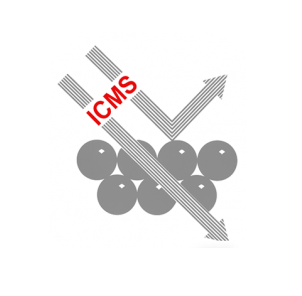Artículos SCI destacados
Direct Laser Writing: From Materials Synthesis and Conversion to Electronic Device Processing
Pinheiro, T; Morais, M; Silvestre, S; Carlos, E; Coelho, J; Almeida, HV; Barquinha, P; Fortunato, E; Martins, R
Advanced Materials, 36 (2024) 26 | DOI: 10.1002/adma.202402014
Direct Laser Writing (DLW) has been increasingly selected as a microfabrication route for efficient, cost-effective, high-resolution material synthesis and conversion. Concurrently, lasers participate in the patterning and assembly of functional geometries in several fields of application, of which electronics stand out. In this review, recent advances and strategies based on DLW for electronics microfabrication are surveyed and outlined, based on laser material growth strategies. First, the main DLW parameters influencing material synthesis and transformation mechanisms are summarized, aimed at selective, tailored writing of conductive and semiconducting materials. Additive and transformative DLW processing mechanisms are discussed, to open space to explore several categories of materials directly synthesized or transformed for electronics microfabrication. These include metallic conductors, metal oxides, transition metal chalcogenides and carbides, laser-induced graphene, and their mixtures. By accessing a wide range of material types, DLW-based electronic applications are explored, including processing components, energy harvesting and storage, sensing, and bioelectronics. The expanded capability of lasers to participate in multiple fabrication steps at different implementation levels, from material engineering to device processing, indicates their future applicability to next-generation electronics, where more accessible, green microfabrication approaches integrate lasers as comprehensive tools.
This review covers recent progress and breakthroughs in direct laser writing for multimaterial synthesis and conversion, toward processing and fabrication of electronics. Predominant laser-material processing mechanisms for the writing of conductive and semiconductive materials are discussed, alongside important considerations on laser operation and implementation for both rigid and flexible electronics, including microelectronics, energy harvesting and storage, sensors, and bioelectronics. image
Synergistic Integration of Nanogenerators and Solar Cells: Advanced Hybrid Structures and Applications
Hajra, S; Ali, A; Panda, S; Song, HW; Rajaitha, PM; Dubal, D; Borras, A; In-Na, P; Vittayakorn, N; Vivekananthan, V; Kim, HJ; Divya, S; Oh, TH
Advanced Energy Materials, (2024) 2400025 | DOI: 10.1002/aenm.202400025
The rapid growth of global energy consumption and the increasing demand for sustainable and renewable energy sources have urged vast research into harnessing energy from various sources. Among them, the most promising approaches are nanogenerators (NGs) and solar cells (SCs), which independently offer innovative solutions for energy harvesting. This review paper presents a comprehensive analysis of the integration of NGs and SCs, exploring advanced hybrid structures and their diverse applications. First, an overview of the principles and working mechanisms of NGs and SCs is provided for seamless hybrid integrations. Then, various design strategies are discussed, such as piezoelectric and triboelectric NGs with different types of SCs. Finally, a wide range of applications are explored that benefit from the synergistic integration of NGs and SCs, including self-powered electronics, wearable devices, environmental monitoring, and wireless sensor networks. The potential for these hybrid systems is highlighted to address real-world energy needs and contribute to developing sustainable and self-sufficient technologies. In conclusion, this review provides valuable insights into the state-of-the-art developments in NGs and SCs integration, shedding light on advanced hybrid structures and their diverse applications.
Effect of Connectivity on the Carrier Transport and Recombination Dynamics of Perovskite Quantum-Dot Networks
Tiede, DO; Romeo-Pérez, C; Koch, KA; Ucer, KB; Calvo, ME; Kandada, ARS; Galisteo-López, JF; Míguez, H
ACS Nano, 18(6) (2024) 2325-2334 | DOI: 10.1021/acsnano.3c10239
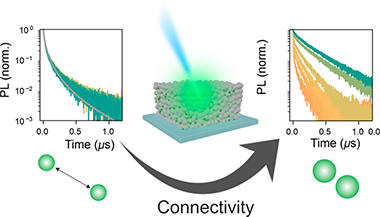
Quantum-dot (QD) solids are being widely exploited as a solution-processable technology to develop photovoltaic, light-emission, and photodetection devices. Charge transport in these materials is the result of a compromise between confinement at the individual QD level and electronic coupling among the different nanocrystals in the ensemble. While this is commonly achieved by ligand engineering in colloidal-based systems, ligand-free QD assemblies have recently emerged as an exciting alternative where nanostructures can be directly grown into porous matrices with optical quality as well as control over their connectivity and, hence, charge transport properties. In this context, we present a complete photophysical study comprising fluence- and temperature-dependent time-resolved spectroscopy to study carrier dynamics in ligand-free QD networks with gradually varying degrees of interconnectivity, which we achieve by changing the average distance between the QDs. Analysis of the photoluminescence and absorption properties of the QD assemblies, involving both static and time-resolved measurements, allows us to identify the weight of the different recombination mechanisms, both radiative and nonradiative, as a function of QD connectivity. We propose a picture where carrier diffusion, which is needed for any optoelectronic application and implies interparticle transport, gives rise to the exposure of carriers to a larger defect landscape than in the case of isolated QDs. The use of a broad range of fluences permits extracting valuable information for applications demanding either low- or high-carrier-injection levels and highlighting the relevance of a judicious design to balance recombination and diffusion.
Natural hydrogen in the energy transition: Fundamentals, promise, and enigmas
Blay-Roger, R; Bach, W; Bobadilla, LF; Reina, TR; Odriozola, JA; Amils, R; Blay, V
Renewable & Sustainable Energy Reviews, 189 (2024) 113888 | DOI: 10.1016/j.rser.2023.113888
Beyond its role as an energy vector, a growing number of natural hydrogen sources and reservoirs are being discovered all over the globe, which could represent a clean energy source. Although the hydrogen amounts in reservoirs are uncertain, they could be vast, and they could help decarbonize energy-intensive economic sectors and facilitate the energy transition. Natural hydrogen is mainly produced through a geochemical process known as serpentinization, which involves the reaction of water with low-silica, ferrous minerals. In favorable locations, the hydrogen produced can become trapped by impermeable rocks on its way to the atmosphere, forming a reservoir. The safe exploitation of numerous natural hydrogen reservoirs seems feasible with current technology, and several demonstration plants are being commissioned. Natural hydrogen may show variable composition and require custom separation, purification, storage, and distribution facilities, depending on the location and intended use. By investing in research, in the mid-term, more hydrogen sources could become exploitable and geochemical processes could be artificially stimulated in new locations. In the long term, it may be possible to leverage or engineer the interplay between microorganisms and geological substrates to obtain hydrogen and other chemicals in a sustainable manner.
Boosting Low-Temperature CO2 Hydrogenation over Ni-based Catalysts by Tuning Strong Metal-Support Interactions
Ye, RP; Ma, LX; Hong, XL; Reina, TR; Luo, WH; Kang, LQ; Feng, G; Zhang, RB; Fan, MH, Zhang, RG
Angewandte Chemie-International Edition, 63 (2024) e202317669 | DOI: 10.1002/anie.202317669
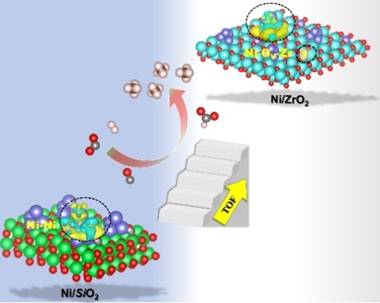
Rational design of low-cost and efficient transition-metal catalysts for low-temperature CO2 activation is significant and poses great challenges. Herein, a strategy via regulating the local electron density of active sites is developed to boost CO2 methanation that normally requires >350 °C for commercial Ni catalysts. An optimal Ni/ZrO2 catalyst affords an excellent low-temperature performance hitherto, with a CO2 conversion of 84.0 %, CH4 selectivity of 98.6 % even at 230 °C and GHSV of 12,000 mL g−1 h−1 for 106 h, reflecting one of the best CO2 methanation performance to date on Ni-based catalysts. Combined a series of in situ spectroscopic characterization studies reveal that re-constructing monoclinic-ZrO2 supported Ni species with abundant oxygen vacancies can facilitate CO2 activation, owing to the enhanced local electron density of Ni induced by the strong metal-support interactions. These findings might be of great aid for construction of robust catalysts with an enhanced performance for CO2 emission abatement and beyond.
Multifold Enhanced Photon Upconversion in a Composite Annihilator System Sensitized by Perovskite Nanocrystals
Chua, XW; Dai, LJ; Anaya, M; Salway, H; Ruggeri, E; Bi, PQ; Yang, ZH; Stranks, SD; Yang, L
ACS Nano, 18 (2024) 15229-15238 | DOI: 10.1021/acsnano.4c03753
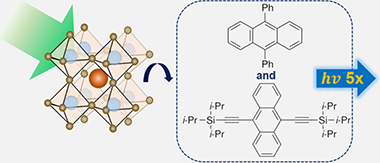
Photon upconversion via triplet-triplet annihilation (TTA-UC) provides a pathway to overcoming the thermodynamic efficiency limits in single-junction solar cells by allowing the harvesting of sub-bandgap photons. Here, we use mixed halide perovskite nanocrystals (CsPbX3, X = Br/I) as triplet sensitizers, with excitation transfer to 9,10-diphenylanthracene (DPA) and/or 9,10-bis[(triisopropylsilyl)ethynyl]anthracene (TIPS-An) which act as the triplet annihilators. We observe that the upconversion efficiency is five times higher with the combination of both annihilators in a composite system compared to the sum of the individual single-acceptor systems. Our work illustrates the importance of using a composite system of annihilators to enhance TTA upconversion, demonstrated in a perovskite-sensitized system, with promise for a range of potential applications in light-harvesting, biomedical imaging, biosensing, therapeutics, and photocatalysis.
Strong Light-Matter Coupling in Lead Halide Perovskite Quantum Dot Solids
Bujalance, C; Caliò, Dirin, DN; Tiede, DO; Gaisteo-López, JF; Feist, J; García-Vidal, FJ; Kovalenko, MV; Míguez, H
ACS Nano, 18(6) (2024) 4922-4931 | DOI: 10.1021/acsnano.3c10358
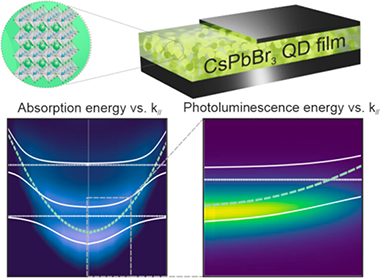
Strong coupling between lead halide perovskite materials and optical resonators enables both polaritonic control of the photophysical properties of these emerging semiconductors and the observation of fundamental physical phenomena. However, the difficulty in achieving optical-quality perovskite quantum dot (PQD) films showing well-defined excitonic transitions has prevented the study of strong light-matter coupling in these materials, central to the field of optoelectronics. Herein we demonstrate the formation at room temperature of multiple cavity exciton-polaritons in metallic resonators embedding highly transparent Cesium Lead Bromide quantum dot (CsPbBr3-QD) solids, revealed by a significant reconfiguration of the absorption and emission properties of the system. Our results indicate that the effects of biexciton interaction or large polaron formation, frequently invoked to explain the properties of PQDs, are seemingly absent or compensated by other more conspicuous effects in the CsPbBr3-QD optical cavity. We observe that strong coupling enables a significant reduction of the photoemission line width, as well as the ultrafast modulation of the optical absorption, controllable by means of the excitation fluence. We find that the interplay of the polariton states with the large dark state reservoir plays a decisive role in determining the dynamics of the emission and transient absorption properties of the hybridized light-quantum dot solid system. Our results should serve as the basis for future investigations of PQD solids as polaritonic materials.
Strong angular and spectral narrowing ofelectroluminescence in an integrated Tamm-plasmon-driven halide perovskite LED
Ying, Z; Jiménez-Solano, A; Gatkowski, K; Sun, Y; Ferrer Orri, J; Frohna, K; Salway, H; Kahmann, S; Nie, S; Vega, G; Kar, S; Novak, MP; Máckowski, S; Nyga, P; Ducati, C; Greenham, NC; Lotsch, BV; Anaya, M; Stranks, SD
Nature Commications, 15 (2024) 5802 | DOI: 10.1038/s41467-024-49838-1
Next-generation light-emitting applications such as displays and opticalcommunications require judicious control over emitted light, includingintensity and angular dispersion. To date, this remains a challenge as con-ventional methods require cumbersome optics. Here, we report highly direc-tional and enhanced electroluminescence from a solution-processed quasi-2-dimensional halide perovskite light-emitting diode by building a devicearchitecture to exploit hybrid plasmonic-photonic Tamm plasmon modes. Byexploiting the processing and bandgap tunability of the halide perovskitedevice layers, we construct the device stack to optimise both optical andcharge-injection properties, leading to narrow forward electroluminescencewith an angular full-width half-maximum of 36.6° compared with the con-ventional isotropic control device of 143.9°, and narrow electroluminescencespectral full-width half-maximum of 12.1 nm. The device design is versatile andtunable to work with emission lines covering the visible spectrum with desireddirectionality, thus providing a promising route to modular, inexpensive, anddirectional operating light-emitting devices.
Subnanometric Pt clusters dispersed over Cs-doped TiO2 for CO2 upgrading via low-temperature RWGS: operando mechanistic insights to guide an optimal catalyst design
Torres-Sempere, G; Blay-Roger, R; Luque-Alvarez, LA; Santos, JL; Bobadilla, LF; Pastor-Pérez, L; Centeno, MA; Hernández, WY; Yousef, I; Odriozola, JA; Reina, TR
Journal of Matertials Chemistry A, 12 (2024) 1779-1792 | DOI: 10.1039/D3TA05482A
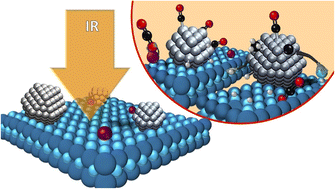
The RWGS reaction is gathering momentum as an effective route for CO2 valorisation and given its endothermic nature the challenge lies in the design of active low-temperature catalysts. Herein we have designed two catalysts based on subnanometric Pt clusters providing effective CO2 conversion and, more importantly, high CO selectivity in the low-temperature range. The impact of Cs as a dopant in the catalyst's formulation is crucial leading to full selectivity at 300 °C. The reaction mechanisms for the studied systems namely Pt/TiO2 and PtCs/TiO2 are significantly different due to the presence of the alkali promoter. The presence of Cs neutralises the hydroxide groups of the TiO2 surface, changing the reaction pathway. The Pt/TiO2 catalyst follows a redox mechanism where CO2 dissociates to CO in the oxygen vacancies, and then these vacancies are recovered by the migration of H2 by spill over phenomena. On the other hand, the Cs doped catalyst has two possible mechanism pathways: the (ii) formyl/acyl pathway, where –CHO species are formed and, depending on the reaction conditions, evolve to CO gas or oxygenated compounds, and (ii) frustrated Lewis pair (FLP) assisted CO2 reduction route, in which the FLP induces the heterolytic dissociation of H2 and the subsequent hydrogenation of CO2 to CO. The latter route enabled by Cs-doping combined with the subnanometric Pt domains seems to be responsible for the excellent catalytic behaviour leading to fully selective low-temperature RWGS systems and thus unlocking new possibilities for less energy demanding CO2 valorisation units based on RWGS.
Investigating the room- and cryo-milling impact in lignocellulosic biomass and its consequence over pyrolysis and oxidative treatments
Pérez, CR; González, MDA; Sarria, FR; López, MDH; Gallego, JMC
Journal of Cleaner Production, 437 (2024) 140761 | DOI: 10.1016/j.jclepro.2024.140761
The lignocellulosic biomass recalcitrance is the uppermost factor for the utilization of this renewable resource. The development of new pre -treatments, addressed to enhance performance in lignocellulosic biomass conversion into biofuels, fine chemicals, and as potential sources of building blocks for materials, must be focus in two main areas: effectiveness (cost-effective and chemical effective) and green chemistry. In this research, a set of different biomass sources (farmer, harvested wild trees and secondary products) were studied to evaluate the high efficiency of the non -liquid nitrogen (LN) and LN-treated biomass samples' planetary ball milling performance. The samples have been characterized by particle size distribution, thermogravimetric, FT-IR, statistical chemometric and chemical oxidation analysis. The results have shown a high level on the rupture of the crystallinity and depolymerization degrees of the cellulose and the lignin, for both, non-LN and LN-treated samples. The thermogravimetric analysis showed a clear diminishing in temperature degradation, and a larger amount of biomass degraded at lower temperature, as well as, a high chemical oxidation degree than not milled samples. Finally, the LN-treated samples even exhibited a lower degradation temperature, a larger amount of biomass degraded at lower temperature and a higher oxidation degree, than those non-LN milled.
Towards efficient strain engineering of 2D materials: A four-points bending approach for compressive strain
Li, H; Carrascoso, F; Borrás, A; Moreno, GP; Aparicio, FJ; Barranco, A; Gómez, AC
Nano Research, 17 (2024) 5317-5325 | DOI: 10.1007/s12274-023-6402-7
Strain engineering, as a powerful strategy to tune the optical and electrical properties of two-dimensional (2D) materials by deforming their crystal lattice, has attracted significant interest in recent years. 2D materials can sustain ultra-high strains, even up to 10%, due to the lack of dangling bonds on their surface, making them ideal brittle solids. This remarkable mechanical resilience, together with a strong strain-tunable band structure, endows 2D materials with a broad optical and electrical response upon strain. However, strain engineering based on 2D materials is restricted by their nanoscale and strain quantification troubles. In this study, we have modified a homebuilt three-points bending apparatus to transform it into a four-points bending apparatus that allows for the application of both compressive and tensile strains on 2D materials. This approach allows for the efficient and reproducible construction of a strain system and minimizes the buckling effect caused by the van der Waals interaction by adamantane encapsulation strategy. Our results demonstrate the feasibility of introducing compressive strain on 2D materials and the potential for tuning their optical and physical properties through this approach.
B-site deficient hexagonal perovskites: Structural stability, ionic order-disorder and electrical properties
Yang, X; Fernández-Carrión, AJ; Geng, X; Kuang, X
Progress in Solid State Chemistry, 74 (2024) 100459 | DOI: 10.1016/j.progsolidstchem.2024.100459
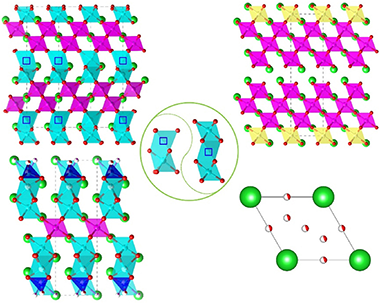
This review presents an overview on the structures and electrical properties of B-site deficient hexagonal perovskite oxides, which have been receiving increasing attention as key components as dielectric resonators in microwave telecommunications, as well as solid-state oxide ion and proton conductors in solid oxide fuel cells. The structural evolution and stability, order-disorder of cation and anions, and mechanisms underlying the dielectric and ionic conduction behaviors for the B-site deficient hexagonal perovskites are summarized and the roles of the B-site deficiency on the structural stability and option, ion order-disorder and electrical performance are highlighted. This provides useful guidance for design of new hexagonal perovskite oxide materials and structural control to enhance their electrical properties and discover new functionality as dielectric resonators and solid-state ionic conductors.
Sodium acetate-based thermochemical energy storage with low charging temperature and enhanced power density
Arcenegui-Troya, J; Lizana, J; Sánchez-Jiménez, PE; Perejón, A; Vañes-Vallejo, A; Pérez-Maqueda, LA
Journal of Energy Storage, 86 (2024) 111310 | DOI: 10.1016/j.est.2024.111310
The electrification of heat necessitates the development of innovative domestic heat batteries to effectively balance energy demand with renewable power supply. Thermochemical heat storage systems show great promise in supporting the electrification of heating, thanks to their high thermal energy storage density and minimal thermal losses. Among these systems, salt hydrate-based thermochemical systems are particularly appealing. However, they do suffer from slow hydration kinetics in the presence of steam, which limits the achievable power density. Additionally, their relatively high dehydration temperature hinders their application in supporting heating systems. Furthermore, there are still challenges regarding the appropriate thermodynamic, physical, kinetic, chemical, and economic requirements for implementing these systems in heating applications. This study analyzes a proposal for thermochemical energy storage based on the direct hydration of sodium acetate with liquid water. The proposed scheme satisfies numerous requirements for heating applications. By directly adding liquid water to the salt, an unprecedented power density of 5.96 W/g is achieved, nearly two orders of magnitude higher than previously reported for other salt-based systems that utilize steam. Albeit the reactivity drops as a consequence of deliquescence and particle aggregation, it has been shown that this deactivation can be effectively mitigated by incorporating 10 % silica, achieving lower but stable energy and power density values. Furthermore, unlike other salts studied previously, sodium acetate can be fully dehydrated at temperatures within the ideal range for electrified heating systems such as heat pumps (40 °C – 60 °C). The performance of the proposed scheme in terms of dehydration, hydration, and multicyclic behavior is determined through experimental analysis.
Optimising anode supported BaZr1-xYxO3-δ electrolytes for solid oxide fuel cells: Microstructure, phase evolution and residual stresses analysis
Fernández Muñoz, S; Chacartegui, R; Alba, MD; Ramírez Rico, J
Journal of Power Sources, 596 (2024) 234070 | DOI: 10.1016/j.jpowsour.2024.234070
Yttrium-doped BaZrO3 is a promising electrolyte for intermediate-temperature protonic ceramic fuel cells. In the anode-supported configuration, a slurry containing the electrolyte is deposited on the surface of a calcined porous anode and sintered. Differences in sintering behaviour and thermal expansion coefficients for the anode and electrolyte result in elastic residual stresses that can impact the long-term stability of the cell during cyclic operation. Half-cells using BaZr0.8Y0.2O3-δ as the electrolyte were fabricated using the solid-state reaction sintering method under various sintering conditions. Comprehensive microstructure and residual stress analyses as a function of processing parameters were performed using two-dimensional X-ray diffraction, Rietveld refinement, and scanning electron microscopy, before and after the half-cells were reduced under hydrogen, giving a complete picture of phase, microstructure, and stress evolution under thermal and reduction cycles like the actual operation of the cell. Our results reveal that a temperature of 1400 °C and shorter soaking times might be advantageous for obtaining phase-pure and thin yttrium-doped BaZrO3 electrolytes with improved microstructure and the presence of compressive residual stress. These findings offer valuable insights into optimising the fabrication process of BaZrO3-based electrolytes, leading to enhanced performance and long-term stability of anode-supported protonic ceramic fuel cells operating at intermediate temperatures.
CuO-TiO2 pilot-plant system performance for solar photocatalytic hydrogen production
Villachica-Llamosas, JG; Ruiz-Aguirre, A; Colón, G; Peral, J; Malato, S
International Journal of Hydrogen Energy, 51 (2024) 1069-1077 | DOI: 10.1016/j.ijhydene.2023.07.149
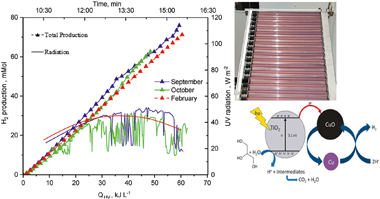
The main goal of the present study was to explore photocatalytic performance of the TiO2 -CuO mixture, for solar to hydrogen conversion at pilot plant scale under two different irradiation conditions (sunny and partly cloudy), focusing on high-temperature pretreat-ment of the catalyst mixture to try to improve TiO2 doping with copper. P25-TiO2 and commercial CuO were used with different amounts of Cu (2 wt% or 7 wt% Cu) calcined at 200-400 degrees C during several hours. Catalysts were tested at pilot plant scale using solar compound parabolic collectors, with glycerol as the sacrificial agent. The photocatalyst prepared after heating at 200 degrees C for 3 h and with 7 wt% Cu, resulted in higher hydrogen production than under the other heating conditions, and results were slightly better (5 -10%) than the reference values with the untreated catalysts. Photocatalytic efficiency was slightly lower at the higher calcination temperature (400 degrees C). CO2 production and formation of formate and glycolate clearly demonstrated glycerol photoreforming. The Cu from the calcined catalyst remaining on the solid was significantly less (2.5%) than on the non -calcined catalyst (4.2%), with an important fraction of lixiviated copper and copper deposition on the reactor walls. This is a critical drawback that must be considered for large-scale applications.
Green hydrogen production using doped Fe2O3 foams
Damizia, M; Lloreda-Jurado, PJ; De Filippis, P; de Caprariis, B; Chicardi, E; Sepúlveda, R
International Journal of Hydrogen Energy, 51 (2024) 834-845 | DOI: 10.1016/j.ijhydene.2023.09.008
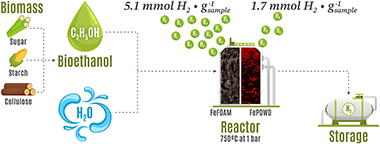
Hydrogen is the ideal energy vector to reduce our fossil-fuels dependency and diminish the climate change consequence. However, current production is still methane based. It is possible to produce hydrogen using bioethanol from the alcoholic fermentation of organic waste by chemical looping processes, but unfortunately current redox systems generate hydrogen with significant traces of CO. In the case of proton exchange membrane fuel cells (PEMFC), hydrogen must be highly purified to produce electricity. Here, high porosity inter-connected Fe2O3 foams doped with 2 wt% Al2O3 were manufactured by the freeze-casting method, obtaining around 5.1 mmol H2$g?1 sample of highly pure hydrogen (<10 ppm of CO) consuming only 3.42 mmol of ethanol on each redox cycles, with no deactivation. This result shows the possibility of using an abundant and inexpensive raw material as the iron oxide to scale-up the direct pure H2 production and facilitates its use in the automotive sector.
MoS2 2D materials induce spinal cord neuroinflammation and neurotoxicity affecting locomotor performance in zebrafish
Di Mauro, G; González, VJ; Bambini, F; Camarda, S; Prado, E; Holgado, JP, Vázquez, E; Ballerini, L; Cellot, G
Nanoscale Horizons, 9(5)(2024) 785-798 | DOI: 10.1039/d4nh00041b
MoS2 nanosheets belong to an emerging family of nanomaterials named bidimensional transition metal dichalcogenides (2D TMDCs). The use of such promising materials, featuring outstanding chemical and physical properties, is expected to increase in several fields of science and technology, with an enhanced risk of environmental dispersion and associated wildlife and human exposures. In this framework, the assessment of MoS2 nanosheets toxicity is instrumental to safe industrial developments. Currently, the impact of the nanomaterial on the nervous tissue is unexplored. In this work, we use as in vivo experimental model the early-stage zebrafish, to investigate whether mechano-chemically exfoliated MoS2 nanosheets reach and affect, when added in the behavioral ambient, the nervous system. By high throughput screening of zebrafish larvae locomotor behavioral changes upon exposure to MoS2 nanosheets and whole organism live imaging of spinal neuronal and glial cell calcium activity, we report that sub-acute and prolonged ambient exposures to MoS2 nanosheets elicit locomotor abnormalities, dependent on dose and observation time. While 25 μg mL−1 concentration treatments exerted transient effects, 50 μg mL−1 ones induced long-lasting changes, correlated to neuroinflammation-driven alterations in the spinal cord, such as astrogliosis, glial intracellular calcium dysregulation, neuronal hyperactivity and motor axons retraction. By combining integrated technological approaches to zebrafish, we described that MoS2 2D nanomaterials can reach, upon water (i.e. ambient) exposure, the nervous system of larvae, resulting in a direct neurological damage.
Scattering Spheres Boost Afterglow: A Mie Glass Approach to Go Beyond the Limits Set by Persistent Phosphor Composition
Castaing, V; Romero, M; Torres, J; Lozano, G; Míguez, H
Advanced Optical Materials, 12 (2024) 2301565 | DOI: 10.1002/adom.202301565
Persistent luminescence phosphor nanoparticles (PersLNPs) offer exciting opportunities for anticounterfeiting, data storage, imaging displays, or AC-driven lighting applications owing to the possibility to process them as shapable thin coatings. However, despite unique delayed and long-lasting luminescence, the relatively low storage capacity of persistent phosphor nanoparticles combined with the difficulty of harvesting photons from transparent thin layers drastically hinder the perceived afterglow. In order to enhance persistent luminescence (PersL) of thin coatings, herein a novel approach is proposed based on resonant optical nanostructures. In particular, it is demonstrated that the integration of TiO2 scattering spheres in films (with thickness comprised between 1 and 10 mu m) made of ZnGa2O4:Cr3+ PersLNPs enables a significant increase in afterglow intensity due to the combination of effective charging and enhanced outcoupling. As a result, a approximate to 3.5-fold enhancement of the PersL is observed in 2 mu m-thick films stuffed with scattering centers using low-light illumination conditions. Furthermore, inclusion of scattering centers leads to an unprecedented acceleration of the PersL charging speed. These results constitute the first example of photonic engineering applied to enhance the properties of PersL materials coatings.
Magnesium calcites for CO2 capture and thermochemical energy storage using the calcium-looping process
Perejón, A; Arcenegui-Troya, J; Sánchez-Jiménez, PE; Diánez, MJ; Pérez-Maqueda, LA
Environmental Research, 246 (2024) 118119 | DOI: 10.1016/j.envres.2024.118119
In this study, a precipitation-based synthesis method has been employed to prepare magnesium calcites with the general formula Ca1-xMgxCO3, with the objective of use them in the calcium looping (CaL) process for CO2 capture (CaL-CCS) and thermochemical energy storage (CaL-CSP). The structure and microstructure of the samples have been characterized. It has been found by X-ray diffraction that the samples with a Ca:Mg molar ratio of 0.5:0.5 and 0.55:0.45 are phase pure, while the samples with molar ratios of 0.7:0.3 and 0.8:0.2 are composed by two phases with different stoichiometry. In addition, the sample prepared with calcium alone shows the aragonite phase. The microstructure of the magnesium-containing samples is composed of nanocrystals, which are aggregated in spherical particles whereas the aragonite sample presents a typical rod-like morphology. The multicycle tests carried out under CaL-CCS conditions show that an increase on the MgO content in the calcined samples results in a reduced value of effective conversion when compared to aragonite. On the other hand, under CaL-CSP conditions, the samples with the higher MgO content exhibit nearly stable effective conversion values around 0.5 after 20 cycles, which improve the results obtained for aragonite and those reported for natural dolomite tested under the same conditions.
Transparent, plasticized cellulose-glycerol bioplastics for food packaging applications
Benítez, JJ; Florido-Moreno, P; Porras-Vazquez, JM; Tedeschi, G; Athanassiou, A; Heredia-Guerrero, JA; Guzman-Puyol, S
International Journal of Biological Macromolecules, 273 (2024) 132956 | DOI: 10.1016/j.ijbiomac.2024.132956
Free-standing films have been obtained by drop-casting cellulose-glycerol mixtures (up to 50 wt% glycerol) dissolved in trifluoroacetic acid and trifluoroacetic anhydride (TFA:TFAA, 2:1, v:v). A comprehensive examination of the optical, structural, mechanical, thermal, hydrodynamic, barrier, migration, greaseproof, and biodegradation characteristics of the films was conducted. The resulting cellulose-glycerol blends exhibited an amorphous molecular structure and a reinforced H-bond network, as evidenced by X-ray diffraction analysis and infrared spectroscopy, respectively. The inclusion of glycerol exerted a plasticizing influence on the mechanical properties of the films, while keeping their transparency. Hydrodynamic and barrier properties were assessed through water uptake and water vapor/oxygen transmission rates, respectively, and obtained values were consistent with those of other cellulose-based materials. Furthermore, overall migration levels were below European regulation limits, as stated by using Tenax as a dry food simulant. In addition, these bioplastics demonstrated good greaseproof performance, particularly at high glycerol content, and potential as packaging materials for bakery products. Biodegradability assessments were carried out by measuring the biological oxygen demand in seawater and high biodegradation rates induced by glycerol were observed.
Reforming of biomass-derived producer gas using toluene as model tar: Deactivation and regeneration studies in Ni and K-Ni catalysts
Azancot, L; González-Castaño, M; Bobadilla, LF; Centeno, MA; Odriozola, JA
Environmental Research, 247 (2024) 118210 | DOI: 10.1016/j.envres.2024.118210
Within the syngas production from biomass gasification, tar removal constitutes a chief issue to overcome for advanced catalytic systems. This work investigates the performance of Ni and Ni-K catalysts for reforming of derived-biomass producer gas using toluene as model tar. At 750 degrees C and 60Lg(-1)h(-1), the stability test (70 h) revealed stable performances (CO2, CH4 and C7H8 conversions of 60, 95 and 100%, correspondingly) uniquely for the Ni-K catalyst. Although the efficient protection towards coking let by K was demonstrated, TPO studies over the post-reacted systems still evidenced the presence of carbon deposits for both samples. Conducting three successive reaction/regeneration cycles with different gasifying agents (air, steam and CO2) at 800 C for 1h, the capability towards regeneration of both catalytic systems was assessed and the spent catalysts were characterized by XRD, SEM and TEM. While none of the regeneration treatments recovered the performance of the unpromoted catalyst, the Ni-K catalysts demonstrated the capability of being fully regenerated by air and CO2 and exhibited analogous catalytic performances after a series of reaction/regeneration cycles. Hence, it is proved that the addition of K into Ni catalysts not only enhances the resistance against deactivation but enables rather facile regenerative procedures under certain atmospheres (air and CO2).
A review on high-pressure heterogeneous catalytic processes for gas-phase CO2 valorization
Villora-Picó, J.J; González-Arias, J; Pastor-Pérez, L; Odriozola, JA; Reina, TR
Environmental Research, 240 (2024) 117520 | DOI: 10.1016/j.envres.2023.117520
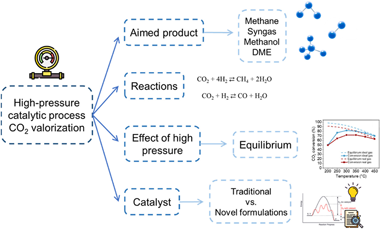
This review discusses the importance of mitigating CO2 emissions by valorizing CO2 through high-pressure catalytic processes. It focuses on various key processes, including CO2 methanation, reverse water-gas shift, methane dry reforming, methanol, and dimethyl ether synthesis, emphasizing pros and cons of high-pressure operation. CO2 methanation, methanol synthesis, and dimethyl ether synthesis reactions are thermodynami-cally favored under high-pressure conditions. However, in the case of methane dry reforming and reverse water -gas shift, applying high pressure, results in decreased selectivity toward desired products and an increase in coke production, which can be detrimental to both the catalyst and the reaction system. Nevertheless, high-pressure utilization proves industrially advantageous for cost reduction when these processes are integrated with Fischer-Tropsch or methanol synthesis units. This review also compiles recent advances in heterogeneous catalysts design for high-pressure applications. By examining the impact of pressure on CO2 valorization and the state of the art, this work contributes to improving scientific understanding and optimizing these processes for sustainable CO2 management, as well as addressing challenges in high-pressure CO2 valorization that are crucial for industrial scaling-up. This includes the development of cost-effective and robust reactor materials and the development of low-cost catalysts that yield improved selectivity and long-term stability under realistic working environments.
Optimizing biogas methanation over nickel supported on ceria-alumina catalyst: Towards CO2-rich biomass utilization for a negative emissions society
González-Arias, J; Torres-Sempere, G; Arroyo-Torralvo, F; Reina, TR; Odriozola, JA
Enrironmental Research, 242 (2024) 117735 | DOI: 10.1016/j.envres.2023.117735
Biogas methanation emerges as a prominent technology for converting biogas into biomethane in a single step. Furthermore, this technology can be implemented at biogas plant locations, supporting local economies and reducing dependence on large energy producers. However, there is a lack of comprehensive studies on biogas methanation, particularly regarding the technical optimization of operational parameters and the profitability analysis of the overall process. To address this gap, our study represents a seminal work on the technical optimization of biogas methanation obtaining an empirical model to predict the performance of biogas methanation. We investigate the influence of operational parameters, such as reaction temperature, H2/CO2 ratio, space velocity, and CO2 share in the biogas stream through an experimental design. Based on previous research we selected a nickel supported on ceria-alumina catalyst; being nickel a benchmark system for methanation process such selection permits a reliable data extrapolation to commercial units. We showcase the remarkable impact of studied key operation parameters, being the temperature, the most critical factor affecting the reaction performance (ca. 2 to 5 times higher than the second most influencing parameter). The impact of the H2/CO2 ratio is also noticeable. The response surfaces and contour maps suggest that a temperature between 350 and 450 degrees C and an H2/CO2 ratio between 2.5 and 3.2 optimize the reaction performance. Further experimental tests were performed for model validation and optimization leading to a reliable predictive model. Overall, this study provides validated equations for technology scaling-up and techno-economic analysis, thus representing a step ahead towards real-world applications for bio-methane production.
Highly Effective Non-Noble MnO2 Catalysts for 5-Hydroxymethylfurfural Oxidation to 2,5-Furandicarboxylic Acid
Alvarez-Hernández, D; Megías-Sayago, C; Penkova, A; Centeno, MA; Ivanova, S
Chemsuschem, 17 (2024) e202400115 | DOI: 10.1002/cssc.202400115
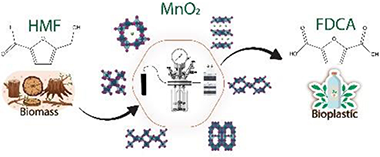
Noble metal-free catalyst or catalytic oxidation of 5-hydroxymethylfurfural into 2,5-furandicarboxylic acid are proposed in this study as a proposal to solve one of the great disadvantages of this reaction of using preferably noble metal-based catalysts. The catalytic activity of six MnO2 crystal structures is studied as alternative. The obtained results showed a strong connection between catalytic activity the type of MnO2 structure organization and redox behavior. Among all tested catalysts, epsilon-MnO2 showed the best performance with an excellent yield of 74 % of 2,5-furandicarboxylic acid at full -hydroxymethylfurfural conversion.
Synthetic natural gas production using CO2-rich waste stream from hydrothermal carbonization of biomass: Effect of impurities on the catalytic activity
González-Arias, J; Torres-Sempere, G; Villora-Picó, JJ; Reina, TR; Odriozola, JA
Journal of CO2 Utilization, 79 (2024) 102653 | DOI: 10.1016/j.jcou.2023.102653
The utilization of biomass and bio-waste, particularly through hydrothermal processes, has shown promise as a technology for converting these materials into valuable products. While most research has traditionally focused on the solid and liquid byproducts of these hydrothermal treatments, the gaseous phase has often been over-looked. This study specifically investigates the conversion of off-gases produced during hydrothermal carbonation (HTC) into synthetic natural gas, offering a readily marketable product with economic potential. Although the methanation of conventional flue gases has been extensively studied, dealing with non-standard off-gases from processes like HTC presents challenges due to the presence of minor impurities like CO and CH4. This novel research seeks to experimentally evaluate the methanation of HTC off-gases using nickel-based catalysts and analyze how these impurities affect the catalytic performance. The studied catalysts include nickel supported by ceria and alumina, as well as alumina supported nickel-cobalt systems. The results demonstrate that these catalysts exhibit high CO2 conversion and CH4 selectivity under ideal gas conditions. However, when real gas compositions with impurities are considered, CO2 conversion decreases at lower temperatures (ca. 20% lower conversion for real gas vs. ideal), probably due to side reactions such as CH4 cracking. This difference becomes less pronounced at higher temperatures. Nevertheless, the catalysts perform satisfactorily, especially at temperatures exceeding 350 degrees C. In conclusion, this study sheds light on the methanation of HTC off-gases and underscores the significance of understanding how impurities in real gases impact the process, providing potential directions for future research.
Switchable catalysis for methanol and synthetic natural gas synthesis from CO2: A techno-economic investigation
Merkouri, LP; Mathew, J; Jacob, J; Reina, TR; Duyar, MS
Journal of CO2 Utilization, 79 (2024) 102652 | DOI: 10.1016/j.jcou.2023.102652
The oil and gas sector produces a considerable volume of greenhouse gas emissions, mainly generated from flaring and venting natural gas. Herein, a techno-economic analysis has been performed of a switchable catalytic process to convert the CH4 and CO2 in flared/vented natural gas into syngas or methanol. Specifically, it was shown that depending on greenhouse gas composition, dry methane reforming (DRM), reverse water-gas shift (RWGS), and CO2 methanation could be chosen to valorise emissions in an overall profitable and flexible operation scenario. The switchable process produced methanol and synthetic natural gas as its products, resulting in an annual income of €687m and annual operating expenses of €452m. The pre-tax profit was calculated at €234m, and at the end of the project, the net present value was calculated as €1.9b with a profitability index of 4.7€/€. The expected payback time of this process was ca. 4 years, and with a 35% internal rate of return (IRR). Most importantly, this process consumed 42.8m tonnes of CO2 annually. The sensitivity analysis revealed that variations in operation time, green hydrogen price, and products' prices significantly impacted the profitability of the process. Overall, this techno-economic analysis demonstrated that switchable catalysis in greenhouse gas utilisation processes is profitable, and thus it could play an important role in achieving net zero emissions.
Synthesis and characterization of porous and photocatalytic geopolymers based on natural clay: Enhanced properties and efficient Rhodamine B decomposition
Ettahiri, Y; Bouna, L: Brahim, A; Benlhachemi, A; Bakiz, B; Sánchez-Soto, PJ; Eliche-Quesada, D; Pérez-Villarejo, L
Applied Materials Today, 36 (2024) 102048 | DOI: 10.1016/j.apmt.2023.102048
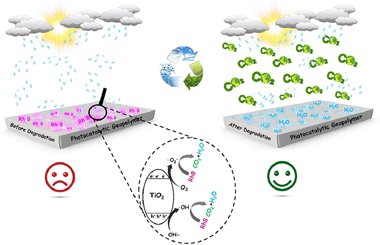
In this work, the incorporation of anatase TiO2 semiconductor in the geopolymer matrix as catalytic materials has been studied. The most noteworthy results obtained from the synthesis of a novel TiO2/geopolymer nanocomposite as an effective ecological catalyst with high thermal stability and significant porosity is presented. The porous and photocatalytic geopolymers based natural clay rich in pyrophyllite and kaolinite minerals were prepared by simple method, the geopolymerization reaction was able to successfully load TiO2 nanoparticles into the geopolymer surface. Furthermore, the results indicate that the prepared catalyst achieved the best performance to degrade Rhodamine B (RhB) molecules present in aqueous solution under UV light irradiation. The geopolymer matrix proved to be a reusable support for TiO2 nanoparticles during the photocatalytic process, efficiently facilitating the separation of photogenerated charges. Finally, the physicochemical and morphological properties of the samples was characterized by several techniques, namely X-ray Fluorescence (XRF), X-ray diffraction (XRD), Fourier Transform Infrared spectroscopy (FTIR), Thermogravimetric and Differential Thermal Analysis (TGA/DTA), N2 adsorption/desorption isotherm analysis (BET and BJH methods), UV–Vis Diffuse Reflectance Spectroscopy (DRS), Scanning Electron Microscopy (SEM) coupled to an Energy Dispersive X-ray Spectroscopy (EDS) analyzer and Transmission Electron Microscopy (TEM).
In situ XRD and operando XRD-XANES study of the regeneration of LaCo0.8Cu0.2O3 perovskite for preferential oxidation of CO
Pereñiguez, RP; Ferri, D
Materials Today Sustainability, 27 (2024) 100867 | DOI: 10.1016/j.mtsust.2024.100867
Combinations of perovskite-type oxides with transition and precious metals exhibit remarkable regenerating properties that can be exploited for catalytic applications. The objective of the present work was to study the structural changes experienced by LaCo0.8Cu0.2O3 under reducing/oxidizing atmosphere (redox) and Preferential Oxidation of CO (PrOx, with high H2 concentration) conditions and their reversibility. LaCo0.8Cu0.2O3 was prepared by ultrasonic spray combustion and was characterized by X-ray diffraction (XRD) and X-ray absorption spectroscopy (XAS). Structural changes were followed by operando XRD and XAS. Metallic Co and Cu were segregated under both sets of reducing conditions and re-dissolved into the perovskite upon oxidation at 500 °C. Simultaneously, the perovskite-type oxide disappeared under reducing conditions and formed again upon high-temperature oxidation. The effects of this reversible reduction/dissolution of B-site metals on catalyst structure and activity were studied concerning the catalytic process of PrOx. The active phases of cobalt and copper oxides suffer a reduction during the PrOx reaction due to the high H2 concentration; thus, the application of an intermediate oxidation treatment can regenerate the catalytic system and the perovskite can be used for several cycles of reaction and regeneration. In contrast, when this intermediate oxidation treatment is not applied, the catalytic performance decreases in successive activity cycles.
Evaluation of Pt/TiO2-Nb2O5 systems in the photocatalytic reforming of glucose for the generation of H2 from industrial effluents
Lara Sandoval, AE; Serafin, J; Murcia Mesa, JJ; Rojas Sarmiento, HA; Hernandez Niño, JS; Llorca, J; Navío Santos, JA; Hidalgo Lõpez; MC
Fuel, 363 (2024) 130932 | DOI: 10.1016/j.fuel.2024.130932
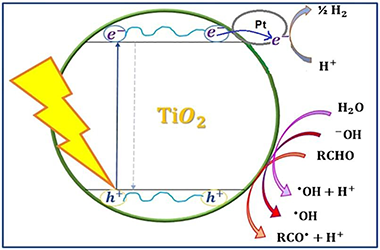
Different Pt-TiO2-Nb2O5 systems were synthesized and studied in the photocatalytic reforming of glucose for the generation of H2. The physicochemical properties of the synthesized photocatalysts were analyzed using different characterization techniques from which it was found that fluoridation and sulphation have different effects on the oxides under study such as a protective effect on the crystalline phase in anatase, and greater response in the visible region of the electromagnetic spectrum. The addition of fluorine or sulfates favors the reduction of platinum species on the surface of the semiconductor oxides and a better homogeneity of size and distribution of the particles of this metal. Studies were carried out in the gas phase that allowed the monitoring and quantification of the hydrogen produced from aqueous glucose solutions and it was determined that Pt-F-Nb2O5 and Pt-F-TiO2 are the most efficient materials for the production of hydrogen from this substrate. Similarly, liquid phase studies were carried out with a real sample from a confectionery industry where it was determined that with the material Pt-F-Nb2O5 the highest transformation of glucose is obtained, without the formation of any other sugar or intermediate compound, indicating the preferential production of hydrogen during the photocatalytic reaction. The foregoing demonstrates the potential of the evaluated process in obtaining this gas from the recovery of polluting residues derived from the samples under study.
A profitability study for catalytic ammonia production from renewable landfill biogas: Charting a route for the next generation of green ammonia
González-Arias, J; Nawaz, MA; Vidal-Barrero, F; Reina, TR
Fuel, 360 (2024) 130584 | DOI: 10.1016/j.fuel.2023.130584
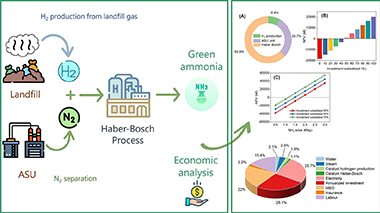
This study introduces a novel techno-economic approach to renewable ammonia production using landfill biogas. The proposed process involves bio-hydrogen generation from landfill biogas, nitrogen production via air separation, and the Haber-Bosch process. Building on our prior research, which demonstrated the economic competitiveness of renewable hydrogen production from landfill gas, we extend our investigation to analyze the feasibility of producing renewable ammonia from biogas-derived bio-hydrogen. However, the economic analysis for the baseline scenario reveals the current lack of profitability (net present value of −18.3 M€), with ammonia prices needing to quadruple to achieve profitability. Major costs, including investment, maintenance, overhead expenses, and electricity, collectively account for over 70%, suggesting the potential efficacy of investment subsidies as a political tool. Only cases with subsidies exceeding 50% of total investment costs, under current ammonia market prices, would render the green ammonia route profitable. Our findings underscore the significant techno-economic challenges in realizing renewable ammonia production, emphasizing the need for innovation in process engineering and catalytic technologies to enable competitive and scalable green ammonia production.
Enhanced low-temperature CO2 methanation over La-promoted NiMgAl LDH derived catalyst: Fine-tuning La loading for an optimal performance
Wang, ZL; Zhang, TY; Reina, TR; Huang, L; Xie, WF; Musyoka, NM; Oboirien, B; Wang, Q
Fuel, 366 (2024) 131383 | DOI: 10.1016/j.fuel.2024.131383
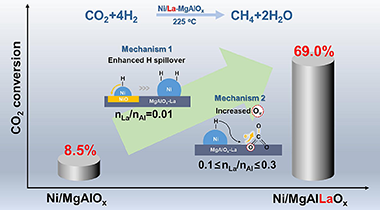
LDH-derived Ni-based catalysts are gathering momentum due to their excellent thermal stability but their lowtemperature CO2 methanation is limited. In this study, various concentrations of La were introduced into the LDH-derived Ni-based catalysts for CO2 methanation, and the underlying mechanisms were investigated. The optimal Ni/La-0.2-MgAlOx catalyst presented a CO(2)conversion level of 69.0 % at 225 C-degrees, which is over 7 times higher than that of conventional Ni/MgAlOx. The addition of small amounts of La could significantly enhance H spillover to promote the reduction of Ni species, but the oxygen vacancy concentration became the dominant factor causing changes in low -temperature activity as the La contents continue to increase. CO2 was found to be adsorbed at the oxygen vacancies in the form of bidentate carbonates, which are more reactive under an enhanced electron -rich environment. The research offers guidance to design effective and sustainable catalysts for low -temperature CO2 methanation.
Surface Defect Engineered Nano-Cu/TiO2 Photocatalysts for Hydrogen Production
Liccardo, L; Moras, P; Shewerdyaeva, PM; Vomiero, A; Caballero, A; Colón, G; Moretti, E
Advanced Sustainable Systems, 8(3) (2024) 2300418 | DOI: 10.1002/adsu.202300418
Surface defects engineered nano-Cu/TiO2 photocatalysts are synthesized through an easy and cost-effective microwave-assisted hydrothermal synthesis, mixing commercial P25 titania (TiO2) and oxalic acid (Ox), followed by 2.0 wt% Cu co-catalyst (labeled as Cu2.0) loading through in situ photodeposition during reaction. The hydrothermal treatment does not affect the catalyst crystalline structure, morphology, nor the surface area. However, depending on the Ox/TiO2 molar ratio used an influence on the optical properties and on the reactivity of the system is detected. The presence of surface defects leads to intraband states formation between valence band and conduction band of bare titania, inducing an important enhancement in the photoactivity. Thus, Cu2.0/gOx/P25 200 (where g is the weight of Ox and 200 the temperature in Celsius degrees used during the synthesis) have been successfully tested as efficient photocatalysts for hydrogen production through methanol (MeOH) reforming under UV light in a MeOH/ H2O solution (10% v/v) by fluxing the system with N2, showing an increased reactivity compared to the bare Cu2.0/P25 system.
Developing and understanding Leaching-Resistant cobalt nanoparticles via N/P incorporation for liquid phase hydroformylation
Galdeano-Ruano, C; Gutiérrez-Tarriño, S; Lopes, CW; Mazarío, J; Chinchilla, LE; Agostini, G; Calvino, JJ; Holgado, JP; Rodriguez-Castellón, E; Roldan, A; Oña-Burgos, P
Journal of Catalysis, 431 (2024) 115374 | DOI: 10.1016/j.jcat.2024.115374
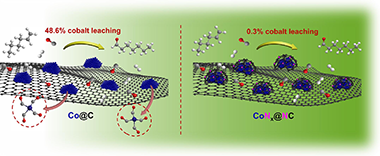
The ultimate target in heterogeneous catalysis is the achievement of robust, resilient and highly efficient materials capable of resisting industrial reaction conditions. Pursuing that goal in liquid -phase hydroformylation poses a unique challenge due to carbon monoxide -induced metal carbonyl species formation, which is directly related to the formation of active homogeneous catalysts by metal leaching. Herein, supported heteroatomincorporated (P and N) Co nanoparticles were developed to enhance the resistance compared with bare Co nanoparticles. The samples underwent characterization using operando XPS, XAS and HR electron microscopy. Overall, P- and N -doped catalysts increased reusability and suppressed leaching. Among the studied catalysts, the one with N as a dopant, CoNx@NC, presents excellent catalytic results for a Co -based catalyst, with a 94% conversion and a selectivity to aldehydes of 80% in only 7.5 h. Even under milder conditions, this catalyst outperformed existing benchmarks in Turnover Numbers (TON) and productivity. In addition, computational simulations provided atomistic insights, shedding light on the remarkable resistance of small Co clusters interacting with N -doped carbon patches.
Harnessing a Vibroacoustic Mode for Enabling Smart Functions on Surface Acoustic Wave Devices - Application to Icing Monitoring and Deicing
Karimzadeh, A; Weissker, U; del Moral, J; Winkler, A; Borrás, A; González-Elipe, AR; Jacob, S
Advanced Materials Technologies, (2024) 2301749 | DOI: 10.1002/admt.202301749
Microacoustic wave devices are essential components in the radio frequency (RF) electronics and microelectromechanical systems (MEMS) industry with increasing impact in various sensing and actuation applications. Reliable and smart operation of acoustic wave devices at low costs will cause a crucial advancement. Herein, this study presents the enablement of temperature and mechanical sensing capabilities in a Rayleigh-mode standing surface acoustic wave (sSAW) chip device by harnessing an acoustic shear-thickness dominant wave (SD) using the same set of electrodes. Most importantly, this mode is excited by switching the polarity of the sSAW transducer electrodes by simple electronics, allowing for direct and inexpensive compatibility with an existing setup. The method in the emergent topic of surface de-icing is validated by continuously monitoring temperature and liquid–solid water phase changes using the SD mode, and on-demand Rayleigh-wave deicing with a negligible energy cost. The flexibility for adapting the system to different scenarios, and loads and the potential for scalability opens the path to impact in lab-on-a-chip, internet of things (IoT) technology, and sectors requiring autonomous acoustic wave actuators.
Green Fabrication of Stackable Laser-Induced Graphene Micro-Supercapacitors under Ambient Conditions: Toward the Design of Truly Sustainable Technological Platforms
Silvestre, SL; Morais, M; Soares, RRA; Johnson, Z; Benson, E; Ainsley, E; Pham, V; Claussen, JC; Gomes, CL; Martins, R; Fortunato, E; Pereira, L; Coelho, J
Advanced Materials Technologies, (2024) 2365709X | DOI: 10.1002/admt.202400261
Extensive research into green technologies is driven by the worldwide push for eco-friendly materials and energy solutions. The focus is on synergies that prioritize sustainability and environmental benefits. This study explores the potential of abundant, non-toxic, and sustainable resources such as paper, lignin-enriched paper, and cork for producing laser-induced graphene (LIG) supercapacitor electrodes with improved capacitance. A single-step methodology using a CO2 laser system is developed for fabricating these electrodes under ambient conditions, providing an environmentally friendly alternative to conventional carbon sources. The resulting green micro-supercapacitors (MSCs) achieve impressive areal capacitance (≈7–10 mF cm−2) and power and energy densities (≈4 μW cm-2 and ≈0.77 µWh cm−2 at 0.01 mA cm−2). Stability tests conducted over 5000 charge–discharge cycles demonstrate a capacitance retention of ≈80–85%, highlighting the device durability. These LIG-based devices offer versatility, allowing voltage output adjustment through stacked and sandwich MSCs configurations (parallel or series), suitable for various large-scale applications. This study demonstrates that it is possible to create high-quality energy storage devices based on biodegradable materials. This development can lead to progress in renewable energy and off-grid technology, as well as a reduction in electronic waste.
Nucleation and growth of plasma sputtered silver nanoparticles under acoustic wave activation
Reichel, H; García-Valenzuela, A; Espino-Román, JA; Gil-Rostra, J; Regodón, GF; Rico-Gavira, V; Borrás, A; Gómez-Ramírez, A; Palmero, A; González-Elipe, AR; Oliva-Ramírez, M
Applied Surface Science, 669 (2024) 160566 | DOI: 10.1016/j.apsusc.2024.160566
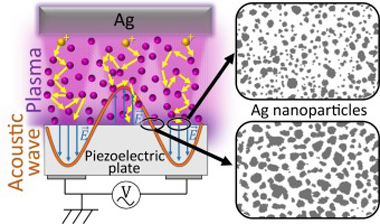
Early results on the plasma deposition of dielectric thin films on acoustic wave (AW) activated substrates revealed a densification pattern arisen from the focusing of plasma ions and their impact on specific areas of the piezoelectric substrate. Herein, we extend this methodology to tailor the plasma deposition of metals onto AW-activated LiNbO3 piezoelectric substrates. Our investigation reveals the tracking of the initial stages of nanoparticle (NP) formation and growth during the submonolayer deposition of silver. We elucidate the specific role of AW activation in reducing particle size, enhancing particle circularity, and retarding NP agglomeration and account for the physical phenomena making these processes differ from those occurring on non-activated substrates. We provide a comparative analysis of the results obtained under two representative plasma conditions: diode DC sputtering and magnetron sputtering. In the latter case, the AW activation gives rise to a 2D pattern of domains with different amounts of silver and a distinct size and circularity for the silver NPs. This difference was attributed to the specific characteristics of the plasma sheath formed onto the substrate in each case. The possibilities of tuning the plasmon resonance absorption of silver NPs by AW activation of the sputtering deposition process are discussed.
A novel membrane-based process to concentrate nutrients from sidestreams of an Urban Wastewater Treatment Plant through captured carbon dioxide from biogas
González-Arias, J; Baena-Moreno, FM; Rodríguez-Galán, M; Navarrete, B; Vilches-Arenas, LF
Science of the Total Environment, 931 (2024) 172884 | DOI: 10.1016/j.scitotenv.2024.172884
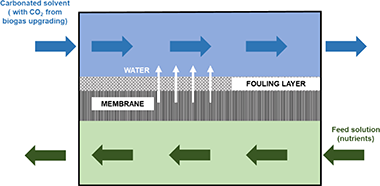
Among the challenges that wastewater treatment plants face in the path towards sustainability, reducing CO 2 emissions and decrease the amount of waste highlight. Within these wastes, those that can cause eutrophication, such as nutrients (nitrogen and phosphorous) are of great concern. Herein we study a novel process to concentrate nutrients via membrane technology. In particular, we propose the use of forward osmosis, applying the carbonated solvent which contains the CO 2 captured from the biogas stream as draw solution. This carbonated solvent has a high potential osmotic pressure, which can be used in forward osmosis to concentrate the nutrients stream. To this end, we present the results of an experimental plan specifically designed and performed to evaluate two main parameters: (1) nutrients concentration; and (2) water recovery. The process designed involves pH adjustment, membrane filtration to separate solids, pH reduction and forward osmosis concentration of nutrients. With this process, concentrations factor for nutrients in between 2 and 2.5 and water recovery of approximately 50 % with water flux of 7 to 8 L/(m 2 h) can be achieved.
Biomass gasification, catalytic technologies and energy integration for production of circular methanol: New horizons for industry decarbonisation
Bobadilla, Luis F; Azancot, Lola; González-Castaño, Miriam; Ruíz-López, Estela; Pastor-Pérez, Laura; Durán-Olivencia, Francisco J.; Ye, Runping; Chong, Katie; Blanco-Sánchez, Paula H; Wu, Zenthao; Reina, TR; Odriozola, JA
Journal of Environmental Sciences, 140 (2024) 306-318 | DOI: 10.1016/j.jes.2023.09.020
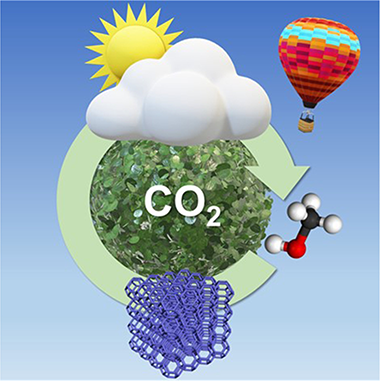
The Intergovernmental Panel on Climate Change (IPCC) recognises the pivotal role of renewable energies in the future energy system and the achievement of the zero-emission target. The implementation of renewables should provide major opportunities and enable a more secure and decentralised energy supply system. Renewable fuels provide long-term solutions for the transport sector, particularly for applications where fuels with high energy density are required. In addition, it helps reducing the carbon footprint of these sectors in the long-term. Information on biomass characteristics feedstock is essential for scaling-up gasification from the laboratory to industrial-scale. This review deals with the transformation biogenic residues into a valuable bioenergy carrier like biomethanol as the liquid sunshine based on the combination of modified mature technologies such as gasification with other innovative solutions such as membranes and microchannel reactors. Tar abatement is a critical process in product gas upgrading since tars compromise downstream processes and equipment, for this, membrane technology for upgrading syngas quality is discussed in this paper. Microchannel reactor technology with the design of state-of-the-art multifunctional catalysts provides a path to develop decentralised biomethanol synthesis from biogenic residues. Finally, the development of a process chain for the production of (i) methanol as an intermediate energy carrier, (ii) electricity and (iii) heat for decentralised applications based on biomass feedstock flexible gasification, gas upgrading and methanol synthesis is analysed.
Ca-based materials derived from calcined cigarette butts for CO2 capture and thermochemical energy storage
Amghar, N; Moreno, V; Sánchez-Jiménez, PE; Perejón, A; Pérez-Maqueda, LA
Journal of Environmental Sciences, 140 (2024) 230-241 | DOI: 10.1016/j.jes.2023.07.028
Cigarette butts (CBs) are one of the most common types of litter in the world. Due to the toxic substances they contain, the waste generated poses a harmful risk to the environment, and therefore there is an urgent need for alternative solutions to landfill storage. Thus, this work presents a possible revalorization of this waste material, which implies interesting environmental benefits. CBs were used as sacrificial templates for the preparation of CaO-based materials by impregnation with calcium and magnesium nitrates followed by flaming combustion. These materials presented enhanced porosity for their use in the Calcium Looping process applied either to thermochemical energy storage or CO2 capture applications. The influence of the concentration of Ca and Mg in the impregnating solutions on the multicycle reactivity of the samples was studied. An improved multicycle performance was obtained in terms of conversion for both applications.
Hydrochar and synthetic natural gas co-production for a full circular economy implementation via hydrothermal carbonization and methanation: An economic approach
Judith González-Arias, Guillermo Torres-Sempere, Miriam González-Castaño, Francisco M. Baena-Moreno, Tomás R. Reina
Journal of Environmental Sciences, 140 (2024) 69-78 | DOI: 10.1016/j.jes.2023.04.019
Herein we study the economic performance of hydrochar and synthetic natural gas co-production from olive tree pruning. The process entails a combination of hydrothermal carbonization and methanation. In a previous work, we evidenced that standalone hydrochar production via HTC results unprofitable. Hence, we propose a step forward on the process design by implementing a methanation, adding value to the gas effluent in an attempt to boost the overall process techno-economic aspects. Three different plant capacities were analyzed (312.5, 625 and 1250 kg/hr). The baseline scenarios showed that, under the current circumstances, our circular economy strategy in unprofitable. An analysis of the revenues shows that hydrochar selling price have a high impact on NPV and subsidies for renewable coal production could help to boost the profitability of the process. On the contrary, the analysis for natural gas prices reveals that prices 8 times higher than the current ones in Spain must be achieved to reach profitability. This seems unlikely even under the presence of a strong subsidy scheme. The costs analysis suggests that a remarkable electricity cost reduction or electricity consumption of the HTC stage could be a potential strategy to reach profitability scenarios. Furthermore, significant reduction of green hydrogen production costs is deemed instrumental to improve the economic performance of the process. These results show the formidable techno-economic challenge that our society faces in the path towards circular economy societies.
In situ study on enhanced plastic deformability of Lanthanum-doped Bismuth ferrite processed by flash sintering
Yang, B; Sánchez-Jiménez, PE; Niu, TJ; Sun, TY; Shang, ZX; Cho, J; Perejón, A; Shen, C; Pérez-Maqueda, LA; Tsakalakos, T; Wang, HY; Zhang, XH
Journal of the European Ceramic Society, 44 (2024) 3985-3994 | DOI: 10.1016/j.jeurceramsoc.2023.12.099
BiFeO3 is a promising multiferroic material for versatile device applications due to its co-existence of magnetic (i.e., antiferromagnetic) and ferroelectric ordering at room temperature. While its functional properties have been extensively investigated, the exploration of its mechanical behavior was limited mostly to the thin-film form of BiFeO3. In this work, we conducted in situ micropillar compression experiments to investigate the deformation behavior of La-doped BiFeO3 (La-BFO) samples processed by both conventional and flash sintering methods. The conventionally sintered La-BFO exhibited limited deformability at room temperature and 450 degrees C. In contrast, the deformability of the flash-sintered La-BFO specimens was substantially improved by nearly 100% at both testing temperatures. Detailed post-mortem studies suggest that preexisting dislocations and wide anti-phase boundaries introduced during flash sintering can toughen flash-sintered La-BFO by easing dislocation migration and ferroelastic domain switching. This study provides a fresh perspective to design an advanced multifunctional system with improved mechanical properties.
BN nanosheets reinforced zirconia composites: An in-depth microstructural and mechanical study
Muñoz-Ferreiro, C; Reveron, H; Rojas, TC; Reyes, DF; Cottrino, S; Moreno, P; Prada-Rodrigo, J; Morales-Rodriguez, A; Chevalier, J; Gallardo-López, A; Poyacto, R
Journal of the European Ceramic Society, 44(10) (2024) 5846-5860 | DOI: 10.1016/j.jeurceramsoc.2024.02.002
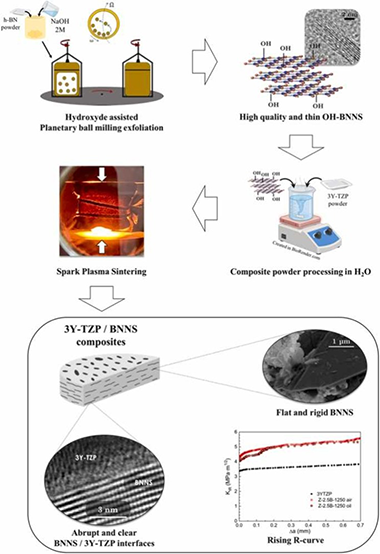
This paper deals with the effect of hydroxylated boron nitride nanosheets (BNNS) incorporation on the microstructural and mechanical features of zirconia ceramics. Few-layered BNNS were synthesized via a simple hydroxide-assisted planetary ball milling exfoliation technique. 3 mol% yttria tetragonal zirconia polycrystal (3Y-TZP) with 2.5 vol% BNNS powders were prepared by an environmentally friendly process in water, and spark-plasma sintered at three temperatures to explore the in-situ reduction of the functionalized BNNS. An exhaustive study by (S)TEM techniques was performed to elucidate the influence of the sintering temperature on the matrix and the 3Y-TZP/BNNS interfaces, revealing that BNNS were homogeneously distributed throughout the matrix with an abrupt transition at 3Y-TZP/BNNS interfaces. BNNS effectively hindered slow crack growth, thus increasing the composite's crack growth resistance by about 30 %. A 1 MPa·m1/2 rising R-curve was also induced by crack bridging.
Al2O3/Y3Al5O12 (YAG)/ZrO2 composites by single-step powder synthesis and spark plasma sintering
Vakhshouri, M; Najafzadehkhoee, A; Talimian, A; López-Pernia, C; Poyato, R; Gallardo-López, A; Gutiérrez-Mora, F; Prnova, A; Galusek, D
Journal of the European Ceramic Societ (2024) | DOI: 10.1016/j.jeurceramsoc.2024.05.004
Alumina-yttrium aluminum garnet (YAG)-zirconia composites are often produced by the melt solidification method. In the present study, we investigated the fabrication of α-Al2O3/Y3Al5O12 (YAG)/ZrO2 composite by Spark Plasma Sintering (SPS) of powders synthesized by Pechini’s sol-gel method. The ternary composites with homogenous microstructure and high density were produced by SPS at 1300 °C for 15 min. The addition of ZrO2 promoted the sintering of composites, resulting in a higher density and, in turn, higher hardness. A change in the indentation fracture behavior as the result of ZrO2 addition was observed.
On the athermal origin of flash sintering: Separating field-induced effects from Joule heating using a current ramp approach
Molina-Molina, S; Perejón, A; Pérez-Maqueda, LA; Sánchez-Jiménez, PE
Scripta Materialia, 247 (2024) 116086 | DOI: 10.1016/j.scriptamat.2024.116086
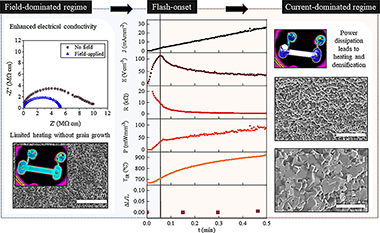
Joule heating is generally acknowledged as the main driving force behind Flash Sintering. However, this view is challenged by the presence of athermal phenomena and the similarities between the flash process and dielectric breakdown. This work offers new insights into flash as an electrical runaway. Using current ramps to perform flash experiments on zinc oxide, two distinct stages within the process were revealed by electrical, thermal and microstructural measurements: a field-dominated regime where the flash event is triggered and a subsequent current-dominated regime associated with power dissipation. The contribution of each regime to the whole flash process was found to be determined by the initial resistivity of the sample. Furthermore, impedance spectroscopy data confirmed field-induced enhancement of conductivity at the flash-onset without significant Joule heating.
Effects of ZrO2 crystalline phase on oxygen vacancy of GaZr oxides and their properties for CO2 hydrogenation to light olefins
Meng, F; Gong, Z; Wang, Q; Xing, M; Nawaz, MA; Qiao, Z; Jing, J; Li, W; Li, Z
Catalysis Today, 433 (2024) 114661 | DOI: 10.1016/j.cattod.2024.114661
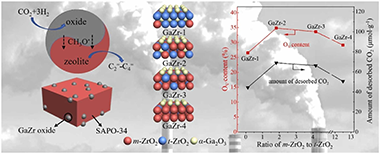
A bifunctional catalyst, comprising GaZr oxide and SAPO-34 zeolite, manifests enhanced catalytic activity in CO2 hydrogenation to light olefins; nonetheless, the comprehensive analysis of the pivotal role played by the underlying structure of ZrO2 in Ga-Zr oxide has not been investigated. Herein, different crystalline structures of ZrO2 were prepared by the co-precipitation method and adopted as a support to deposit Ga to obtain ZrO2 with different ratios of monoclinic ZrO2 (m-ZrO2) to tetragonal ZrO2 (t-ZrO2) in GaZr oxides for CO2 hydrogenation to light olefins. Various characterizations demonstrated that the interface between Ga and the mixed phase of (m-t) ZrO2 produces more oxygen vacancies which favors the adsorption and activation of CO2, and the larger specific surface area and stronger H2 adsorption and dissociation capacity promote CO2 conversion. Interestingly, the GaZr oxide with high m-ZrO2 content exhibits superior catalytic activity than the GaZr oxide with high content of t-ZrO2. The highest light olefins yield (9.0%) and selectivity (77.9%) (CO free) with 27.9% CO2 conversion was achieved. In-situ DRIFT spectra further elaborated that the GaZr oxides with different ZrO2 crystalline phases follow the same reaction pathway to hydrogenate CO2 first to HCOO* and then to CH3O* on GaZr oxide surface. While compared with sole ZrO2, the introduction of Ga significantly promotes the hydrogenation of HCOO* to CH3O*, acting as a crucial reaction intermediate that subsequently diffuses into SAPO-34 pores to enhance the desired light olefins selectivity.
H2 production based on a ternary mixture of commercial CuO-NiO-TiO2 in a solar pilot plant
Villachica-Llamosas, JG; Ruiz-Aguirre, A; Colón, G; Peral, J; Malato, S
Catalysis Today, 431 (2024) 114608 | DOI: 10.1016/j.cattod.2024.114608
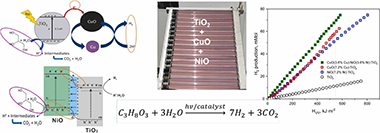
Glycerol is a by-product in biodiesel production (in the range of g·L−1), so its photoreforming by photocatalysis is a way of valorising it. TiO2 in photocatalysis has been widely studied, although its efficiency is limited by the high energy band gap, and the electron-hole recombination. Its combination with different semiconductors should improve charge separation, extending also the absorption from UV to visible light. Cu and Ni oxides are two of the most efficient low-cost transition metal oxide catalysts. Experiments were carried out in a 25 L pilot plant connected to a compound parabolic solar collector. Different combinations of the three semiconductors, based on the concentration of each metal on TiO2 (Me, 5%, 7.2% and 10%) were evaluated. Evonik P25-TiO2, CuO and NiO were combined by mechanical mixing. Hydrogen was quantified by a micro gas chromatograph, and copper and nickel leaching by ICP-MS. The best hydrogen production (0.060 mMol kJ−1) was attained with a proportion of 10:1 of TiO2:MeO, that corresponds to a total metal concentration of 7.2 wt%, being Cu and Ni in the same proportion. Metal content in solution increased as the reaction progressed, but Ni lixiviation of <0.012 mg L−1 was not significant. Significant Cu leaching (>1 mg L−1) was observed. This article presents novel results, in a solar pilot plant, for determining which ternary mixture can give better results, as well as metal leaching into water. Handling relevant volume of water in anoxic conditions can help to understand the application of this technology for the production of hydrogen.
Flash Joule Heating-Boro/Carbothermal Reduction (FJH-BCTR): An approach for the instantaneous synthesis of transition metal diborides
Taibi, A; Gil-González, E; Sánchez-Jiménez, PE; Perejón, A; Pérez-Maqueda, LA
Ceramics International (2024) | DOI: 10.1016/j.ceramint.2024.01.144
Transition metal diborides (TMB2), such as ZrB2 and HfB2, are a class of ultra-high-temperature ceramics (UHTCs) that have attracted considerable attention due to their performance in extreme environments. Their implementation is burdened by the high energetic requirement of traditional synthetic procedures. Here, we report a novel methodology, termed as Flash Joule Heating-Boro/Carbothermal Reduction (FJH-BCTR), for the instantaneous synthesis of phase-pure sub-micron powders of several TMB2 and composite within seconds and without any external source of heating. The immediate synthesis is attributed to the Joule heat generated by the current, enabling extremely fast heating and cooling rates and, therefore, avoiding excessive grain growth. The advantages of FJH-BCTR are thoroughly displayed and can be summarized as; highly efficient, it allows a dramatic drop in terms of energy and time; universal, several TMB2 and composite can be prepared; and flexible, different experimental parameters can be tuned to achieve the desired phase.
Photocatalytic activity enhancement by noble metal deposition on faceted F-TiO2 synthesised by microwave assisted method. A study of selective oxidation of gas-phase ethanol in a FBPR reactor
Hernández-Laverde, M; Murcia, JJ; Morante, N; Sannino, D; Vaiano, V; Navío, JA; Hidalgo, MC
Catalysis Today, 433 (2024) 114645 | DOI: 10.1016/j.cattod.2024.114645
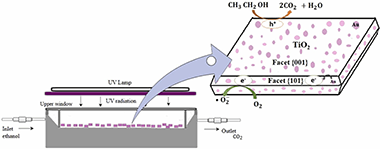
In the present work, fluorinated titanium dioxide (TiO2-F) with high exposition of facet {001} was prepared by following a facile and high yield hydrothermal method assisted by microwave. This faceted TiO2 was then modified by Au or Ag deposition at two different metal loadings (0.125 and 0.25 wt%). A wide physicochemical characterisation of the materials was performed. X-ray difractograms showed high {001} facet exposition in all materials. By X-ray fluorescence it was found that the different samples contained about 5% of fluor. All samples presented high surface area and high uniformity and homogeneity of particles, which highlights the good properties that can be achieved by the microwave synthesis method compared to conventional hydrothermal methods. Oxidation state of the noble metals was studied by XPS. On the other side, TiO2-F and the metallised titania powders were immobilised on polystyrene pellets (PS) for evaluating their gas photocatalytic activity in volatile organic compounds (VOCs) decontamination by following the reaction of photoxidation of ethanol in gas phase. It was found that activity was considerably improved by the addition of noble metals, obtaining high conversion and selectivity to CO2. It is remarkable that the selectivity to CO is almost zero. The highest efficiency was found for the faceted TiO2-F sample with the lowest Au loading (0.125 wt%) immobilised on PS where 91% ethanol conversion and 100% CO2 selectivity were achieved. Different reaction variables were also studied.
Expanding the scope of multiphase-flash sintering: Multi-dogbone configurations and reactive processes
Manchón-Gordón, AF; Molina-Molina, S; Perejón, A; Alcalde-Conejo, A; Sánchez-Jiménez, PE; Pérez-Maqueda, LA
Ceramics International, 50 (2024) 25210-25215 | DOI: 10.1016/j.ceramint.2024.04.250
In this work, we have expanded the possibilities of the multiphase-flash sintering (MPFS) technique by investigating several configurations that involve multiple dogbone specimens (ranging from 1 to 3) and multiple phases (also ranging from 1 to 3). Unlike the traditional MPFS approach using complex 3D or cylindrical samples, this new method allows for a direct comparison with the established conventional flash sintering technique. Our experimental results with dense 8-mol% Yttria-stabilized zirconia demonstrate a significant reduction in the onset temperature as the number of phases and dogbones increases. Building on these findings, we achieved the preparation of pure bulk specimens of SrFe12O19 for the first time through reactive multiphase-flash sintering.
Influence of graphene-based nanostructures processing routes and aspect ratio in flexural strength and fracture mechanisms of 3Y-TZP-matrix composites
Moriche, R; Guisado-Arenas, E; Muñoz-Ferreiro, C; López-Pernía, C; Morales-Rodríguez, A; Jiménez-Piqué, E; Gallardo-López, A; Poyato, R
Ceramics International, 50(11) (2024) 19217-19227 | DOI: 10.1016/j.ceramint.2024.03.021
In this work, the influence of the aspect ratio of graphene-based nanostructures (GBNs) and content on the mechanical properties of 3 mol% yttria tetragonal zirconia polycrystalline 3Y-TZP matrix composites was analysed. The influence of the dispersion method and sintering parameters on the flexural strength and elastic modulus of the composites was studied, and the fracture surfaces were characterized to determine the fracture mechanisms that occur. The results showed that small amounts of exfoliated graphene nanoplatelets, with reduced lateral size, and few layer graphene, up to 1.0 and 2.5 vol%, respectively, slightly increase the 3Y-TZP flexural strength. This has been attributed to the tortuosity of the crack propagation pathways and strengthening mechanisms. Higher contents cause a decrease in flexural strength and stiffness because of overlapped GBNs, which can promote the crack propagation. The pull-out of GBN was more significant in composites with non-exfoliated graphene nanoplatelets, where no increase on the flexural or biaxial strength was measured.
Optimized electrocatalytic degradation of ciprofloxacin using Co3O4 coated stainless steel electrodes
Saleem, MU; Jawad, M; Azad, F; Nawaz, MA; Zaman, WQ; Miran, W
Colloids and Surfaces A-Physicochemical and Engineering Aspects, 681 (2024) 132738 | DOI: 10.1016/j.colsurfa.2023.132738
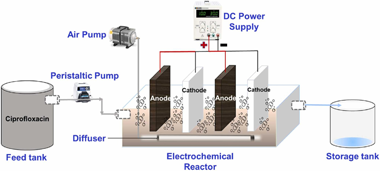
Ciprofloxacin (CIP) is a fluoroquinolone antibiotic that is widely used across the globe and its release is a serious concern due to its persistent nature, partial degradation, and simple transport through different environmental matrices. Pharmaceuticals have been degraded effectively by electrochemical oxidation. Exploring ways to in-crease the mineralization of these compounds while maintaining low power consumption is important. In this study, the treatability and degradation of CIP were investigated by using cobalt oxide-coated stainless steel (SS) electrodes in a lab-scale electrochemical (EC) reactor. The performance of the electrochemical reactor was determined under various operational conditions. The feed wastewater was synthetically prepared in the laboratory with varying concentrations of CIP ranging from 8 to 41 mg/L and the EC reactor was operated with an applied voltage and airflow rate of 2.6-9.3 volts and 1.6-3.5 L/min, respectively. A 3-factor central composite experimental design (CCD) was developed by using response surface methodology (RSM) in Design-Expert software. At a residence time of 27 min, initial concentration of 25 mg/L, airflow rate of 2.5 L/min, and applied voltage of 6 volts, the EC reactor achieved a removal efficiency of 70.8% for CIP with SS electrodes. On the contrary, the removal efficiency was increased to 91.5% at a reduced residence time of 21 min with cobalt oxide (Co3O4) coated over SS plates. The results indicated that Co3O4@SS electrodes resulted in better removal efficiency of CIP at a lower residence time. This system can be used as a robust benchmark for a single or consortium of antibiotics present in domestic and hospital wastewater.
Synergetic Near- and Far-Field Plasmonic Effects for Optimal All-Perovskite Tandem Solar Cells with Maximized Infrared Absorption
Bueno, J; Carretero Palacios, S; Anaya, M
Journal of Physical Chemistry Letters, 15(9) (2024) 2632-2638 | DOI: 10.1021/acs.jpclett.4c00194
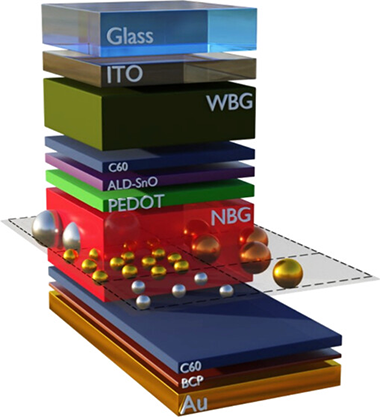
The efficiency and reliability of perovskite solar cells have rapidly increased in conjunction with the proposition of advanced single-junction and multi-junction designs that allow light harvesting to be maximized. However, Sn-based compositions required for optimized all-perovskite tandem devices have reduced absorption coefficients, as opposed to pure Pb perovskites. To overcome this, we investigate near- and far-field plasmonic effects to locally enhance the light absorption of infrared photons. Through optimization of the metal type, particle size, and volume concentration, we maximize effective light harvesting while minimizing parasitic absorption in all-perovskite tandem devices. Interestingly, incorporating 240 nm silver particles into the Pb-Sn perovskite layer with a volume concentration of 3.1% indicates an absolute power conversion efficiency enhancement of 2% in the tandem system. We present a promising avenue for experimentalists to realize ultrathin all-perovskite tandem devices with optimized charge carrier collection, diminishing the weight and the use of Pb.
Scalable synthesis of 2D Ti2CTx MXene and molybdenum disulfide composites with excellent microwave absorbing performance
Miao, BJ; Cao, YE; Zhu, QS; Nawaz, MA; Ordiozola, JA; Reina, TR; Bai, ZM; Ren, JN; Wei, FC
Advanced Composites and Hybrid Materials, 6 (2023) 61 | DOI: 10.1007/s42114-023-00643-2
The signal crosstalk and electromagnetic interference (EMI) problems direly need to be resolved in the rapid development of modern microwave communication technology for a better working frequency and transmission power of electronic systems. Where the new absorbing materials such as molybdenum disulfide (MoS2)/titania (TiO2)/Ti2CTx and MoS2/Ti2CTx composites could meet the requirement of "thin, strong, light weight, and wide band" for excellent absorbing performance. In this work, a lighter Ti2CTx material was selected as the matrix, and MoS2 was in-situ grown on Ti2CTx matrix by traditional hydrothermal method and microwave solvothermal method. The fabricated composite exhibited synergic effect of two-dimensional heterostructural interface and double dielectric elements, where a small amount of TiO2 and a certain proportion of MoS2 jointly improve the impedance matching of the composite material. In here, the extreme reflection loss (RLmin) can reach - 54.70 dB (with a frequency of 7.59 GHz, 3.39 mm thickness), and the maximum effective absorption bandwidth (EAB(max)) can reach 4 GHz. Polyethylene glycol 200 was used as the solvent instead of water to make Ti2CTx less oxidized during the composite process, where the microwave heating would attain fast speed, short time, high efficiency, and uniform product. Since, the MoS2/Ti2CTx composite without oxidizing possessed a wider effective absorption bandwidth (EAB) at a thinner thickness, thus resulting in the excellent microwave absorption performance and confirming the validity and rationality of new microwave absorption materials.
Alkane metathesis over immobilized pincer-ligated iridium complexes: Effect of support nature
Megías-Sayago, C; Centeno-Vega, I; Bobadilla, LF; Ivanova, S; Rendon, N; Suarez, A
Applied Catalysis B-Environmental, 338 (2023) 123002 | DOI: 10.1016/j.apcatb.2023.123002
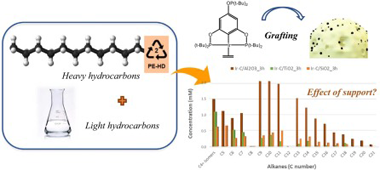
In this work, catalytic alkane metathesis has been evaluated as a suitable approach to upcycle hydrocarbons (polyolefins) at moderate temperatures. To this end, a pincer-ligated iridium complex (dehydrogenation catalyst) has been combined with a rhenium-based (metathesis) catalyst, being the effect of immobilizing the Ir complex over different supports deeply investigated. FTIR spectroscopy has been used to confirm the complex grafting and to elucidate the anchoring site to the support. Additionally, the supports have been dehydroxylated at different conditions to evaluate its possible impact in both the complex grafting and the catalytic activity. The influence of the support nature and its participation in the catalytic reaction have been clearly evidenced.
A Holistic Solution to Icing by Acoustic Waves: De-Icing, Active Anti-Icing, Sensing with Piezoelectric Crystals, and Synergy with Thin Film Passive Anti-Icing Solutions
Del Moral, J; Montes, L; Rico-Gavira, VJ; Lopez-Santos, C; Jacob, S; Oliva-Ramirez, M; Gil-Rostra, J; Fakhfouri, A; Pandey, S; Del Val, MG; Mora, J; García-Gallego, P; Ibanez-Ibanez, PF; Rodríguez Valverde, MA; Winkler, A; Borras, A; Gonzalez-Elipe, AR
Advanced Functional Materials, 33 (2023) 2209421 | DOI: 10.1002/adfm.202209421
Icing has become a hot topic both in academia and in the industry given its implications in transport, wind turbines, photovoltaics, and telecommunications. Recently proposed de-icing solutions involving the propagation of acoustic waves (AWs) at suitable substrates may open the path for a sustainable alternative to standard de-icing or anti-icing procedures. Herein, the fundamental interactions are unraveled that contribute to the de-icing and/or hinder the icing on AW-activated substrates. The response toward icing of a reliable model system consisting of a piezoelectric plate activated by extended electrodes is characterized at a laboratory scale and in an icing wind tunnel under realistic conditions. Experiments show that surface modification with anti-icing functionalities provides a synergistic response when activated with AWs. A thoughtful analysis of the resonance frequency dependence on experimental variables such as temperature, ice formation, or wind velocity demonstrates the application of AW devices for real-time monitoring of icing processes.
Inkjet-Printed and Nanopatterned Photonic Phosphor Motifs with Strongly Polarized and Directional Light-Emission
Cabello-Olmo, E; Romero, M; Kainz, M; Bernroitner, A; Kopp, S; Muhlberger, M; Lozano, G; Miguez, H
Advanced Functional Materials, (2023) 2305907 | DOI: 10.1002/adfm.202305907
Herein a versatile and scalable method to prepare periodically corrugated nanophosphor surface patterns displaying strongly polarized and directional visible light emission is demonstrated. A combination of inkjet printing and soft lithography techniques is employed to obtain arbitrarily shaped light emitting motifs. Such predesigned luminescent drawings, in which the polarization and angular properties of the emitted light are determined and finely tuned through the surface relief, can be used as anti-counterfeiting labels, as these two specific optical features provide additional means to identify any unauthorized or forged copy of the protected item. The potential of this approach is exemplified by processing a self-standing photoluminescent quick response code whose emission is both polarized and directionally beamed. Physical insight of the mechanism behind the directional out-coupled photoluminescence observed is provided by finite-difference time-domain calculations.
Highly Nonstoichiometric YAG Ceramics with Modified Luminescence Properties
Cao, WW; Becerro, AI; Castaing, V; Fang, X; Florian, P; Fayon, F; Zanghi, D; Veron, E; Zandona, A; Genevois, C; Pitcher, MJ; Allix, M
Advanced Functional Materials | DOI: 10.1002/adfm.202213418
Y3Al5O12 (YAG) is a widely used phosphor host. Its optical properties are controlled by chemical substitution at its YO8 or AlO6/AlO4 sublattices, with emission wavelengths defined by rare-earth and transition-metal dopants that have been explored extensively. Nonstoichiometric compositions Y3+xAl5-xO12 (x not equal 0) may offer a route to new emission wavelengths by distributing dopants over two or more sublattices simultaneously, producing new local coordination environments for the activator ions. However, YAG typically behaves as a line phase, and such compositions are therefore challenging to synthesize. Here, a series of highly nonstoichiometric Y3+xAl5-xO12 with 0 <= x <= 0.40 is reported, corresponding to <= 20% of the AlO6 sublattice substituted by Y3+, synthesized by advanced melt-quenching techniques. This impacts the up-conversion luminescence of Yb3+/Er3+-doped systems, whose yellow-green emission differs from the red-orange emission of their stoichiometric counterparts. In contrast, the YAG:Ce3+ system has a different structural response to nonstoichiometry and its down-conversion emission is only weakly affected. Analogous highly nonstoichiometric systems should be obtainable for a range of garnet materials, demonstrated here by the synthesis of Gd3.2Al4.8O12 and Gd3.2Ga4.8O12. This opens pathways to property tuning by control of host stoichiometry, and the prospect of improved performance or new applications for garnet-type materials.
Non-sticky interactions
Esteso, V
Nature Physics, 19 (2023) 161-162 | DOI: 10.1038/s41567-022-01935-y
Quantum mechanical fluctuations of the electromagnetic field in a vacuum between two close together objects result in an attractive force. Now, it has been experimentally shown that by exploiting a similar repulsive interaction, attraction between objects can be modulated simply by tuning temperature.
Paper-based ZnO self-powered sensors and nanogenerators by plasma technology
Garcia-Casas, X; Aparicio, FJ; Budagosky, J; Ghaffarinejad, A; Orozco-Corrales, N; Ostrikov, K; Sánchez-Valencia, JR; Barranco, A; Borras, A
Nano Energy, 114 (2023) 108686 | DOI: 10.1016/j.nanoen.2023.108686
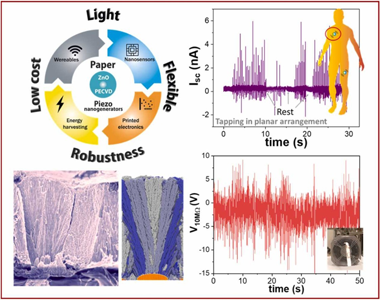
Nanogenerators and self-powered nanosensors have shown the potential to power low-consumption electronics and human-machine interfaces, but their practical implementation requires reliable, environmentally friendly and scalable processes for manufacturing and processing. Furthermore, the emerging flexible and wearable electronics technology demands direct fabrication onto innovative substrates such as paper and plastics typically incompatible with high process temperatures. This article presents a plasma synthesis approach for the fabri-cation of piezoelectric nanogenerators (PENGs) and self-powered sensors on paper substrates. Polycrystalline ZnO nanocolumnar thin films are deposited by plasma-enhanced chemical vapour deposition on common paper supports using a microwave electron cyclotron resonance reactor working at room temperature yielding high growth rates and low structural and interfacial stresses. Applying Kinetic Monte Carlo simulation, we elucidate the basic shadowing mechanism behind the characteristic microstructure and porosity of the ZnO thin films, relating them to an enhanced piezoelectric response to periodic and random inputs. The piezoelectric devices are assembled by embedding the ZnO films in polymethylmethacrylate (PMMA) and using Au thin layers as elec-trodes in two different configurations, namely laterally and vertically contacted devices. We present the response of the laterally connected devices as a force sensor for low-frequency events with different answers to the applied force depending on the impedance circuit, i.e. load values range, a behaviour that is theoretically analyzed. The characterization of the vertical devices in cantilever-like mode reaches instantaneous power densities of 80 nW/ cm2 with a mean power output of 20 nW/cm2. Besides, we analyze their actual-scenario performance by acti-vation with a fan and handwriting. Overall, this work demonstrates the advantages of implementing plasma deposition for piezoelectric films to develop robust, flexible, stretchable, and enhanced-performance nano-generators and self-powered piezoelectric sensors compatible with inexpensive and recyclable supports.
Process design and utilisation strategy for CO2 capture in flue gases. Technical assessment and preliminary economic approach for steel mills
Navarro, JC; Baena-Moreno, FM; Centeno, MA; Laguna, OH; Almagro, JF; Odriozola, JA
Renewable & Sustainable Energy Reviews, 184 (2023) 113537 | DOI: 10.1016/j.rser.2023.113537
The steel industry is the most relevant sector in emerging economies due to its application in numerous fields. However, steel manufacturing involves large energy investment and produces significant greenhouse gas emissions. The current world economic and environmental scenario therefore necessitates that improvements in the footprint of the steel industry be made without affecting its viability. Considering the present challenge, we report two possible processes for Carbon Capture and Utilization (CCU). The first process is the competitive capture of CO2-SO2, followed by CO2 valorisation to methane. However, the CO2 capture capacity and lifetime for the adsorbent after multiple cycles could be improved through preliminary desulphurization of the gas current. The improved system demonstrates net profitability in a typical stainless steel plant. Therefore, it can be implemented in an industrial setting without profitability loss to steelmaking operations, fulfilling bot the goal of reducing CO2 emissions while protecting the mainstay of the plant.
Negative emissions power plant based on flexible calcium-looping process integrated with renewables and methane production
Ortiz, C; García-Luna, S; Carro, A; Chacartegui, R; Pérez-Maqueda, L
Renewable & Sustainable Energy Reviews, 185 (2023) 113614 | DOI: 10.1016/j.rser.2023.113614
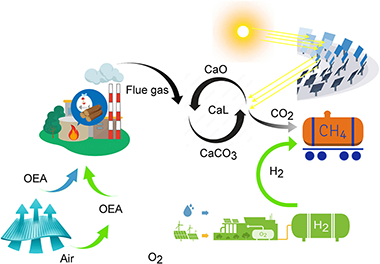
This paper provides a review of negative carbon capture technologies. Based on these technologies, here it is proposed an innovative negative emissions power plant combining the generation and storage of energy from biomass, photovoltaic, and concentrated solar power, capturing and recovering CO2 by producing H2 or CH4 as green energy carriers. The main features of the system are i) large-scale energy production system with negative CO2 emissions; ii) 100% renewable system based on biomass and solar energy with the possibility of integrating other renewables; iii) synergistic integration of processes and systems; iv) recovery of O2 generated by photovoltaic-driven electrolysis within the process of partial biomass oxycombustion and v) solar-driven limestone calcination. A detailed model of the entire plant is developed to evaluate the integration of the process. The model performance is assessed on an hourly basis throughout the whole year. The base case results show an energy consumption from 1 to 2.1 MJ/kg CO2 to capture 60–77% of CO2 emitted from the biomass plant and green methane production of more than 7500 tons/year. The negative emissions associated with the process are -612 kg CO2/MWh. It justifies the interest in the proposed negative emissions power plant.
Hydrogen production by catalytic aqueous-phase reforming of waste biomass: a review
González-Arias, J; Zhang, Z; Reina, TR; Odriozola, JA
Environmental Chemistry Letters, 21 (2023) 3089-3104 | DOI: 10.1007/s10311-023-01643-w
The rising adverse effects of climate change call for a rapid shift to low-carbon energy and reducing our dependence on fossil fuels. For that, biorefineries appear as promising alternatives to produce energy, chemicals, and fuels using biomass and waste as raw materials. Here, we review catalytic aqueous-phase reforming to convert biomass and organic waste carbohydrates into renewable hydrogen, with focus on reforming basics; catalyst design; reforming of model compounds, wastewater and biomass; economics and life cycle assessment. We found that platinum and palladium are technically highly effective, yet their high price may limit upscaling. Alternatively, addition of tin to nickel gives acceptable results and improves hydrogen selectivity from 35 to 90%. We observed that hydrogen production decreases from 14% for crude glycerol to 2% for pure glycerol, thus highlighting the need to do experiments with real wastewater. The rare experiments on real wastewater from brewery, juice, tuna, and cheese industries have given hydrogen production rates of up to 149.7 mg/L. Aqueous-phase reforming could be shortly competitive with prices around 3-6 USD per kg of hydrogen, which are nearing the current market prices of 2-3 USD per kg.
Low CO2 hydrogen streams production from formic acid through control of the reaction pH
Santos, JL; Lopez, ER; Ivanova, S; Monzon, A; Centeno, MA; Odriozola, JA
Chemical Engineering Journal, 455 (2023) 140645 | DOI: 10.1016/j.cej.2022.140645
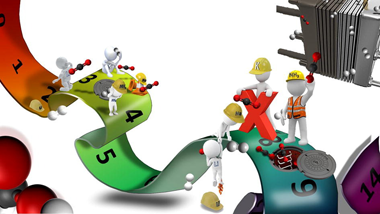
There are multiple factors that influence the catalyst performance in the reaction of formic acid dehydrogena-tion: the nature of catalyst and/or support, the used solvent and reaction variables such as temperature, time, formic acid concentration, presence/absence of formates and pH of the solution. This work evaluates a series of important parameters like the influence of the pH by itself, the influence of the nature of used alkali agents and the effect of direct formate addition as reactive on hydrogen production via formic acid dehydrogenation over a commercially available catalyst. The catalytic performance appears to depend on the ionic radius of the cations of the used base which reflects consequently on the hydrogen selectivity. The best base to be used must have lower hydrated cationic radii and a starting pH around 4 to achieve important hydrogen selectivity for medium term formic acid conversion.
Catalytic conversion of syngas to light hydrocarbons via simulated intermediates CO/CO2/DME/N2/H2 over the regulated acidity of SAPO-34
Meng, FH; Wang, LA; Nawaz, MA; Wang, Q; Gong, ZY; Li, Z
Chemical Engineering Journal, | DOI: 10.1016/j.cej.2023.145895
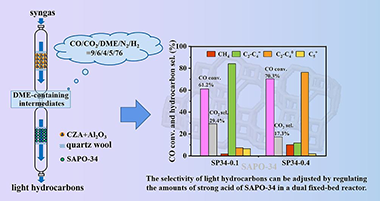
Direct conversion of syngas to light hydrocarbons has been intensively studied in recent years; however, the high selectivity of light hydrocarbons is still a challenging task to achieve a high CO conversion. Here, a bifunctional catalyst consisting of a methanol synthesis catalyst (CZA) and a methanol to dimethyl ether (DME) catalyst (Al2O3) was employed with a hydrocarbon synthesis catalyst (SAPO-34), for syngas conversion to light hydrocarbons in a dual fixed-bed reactor. The conversion of simulated intermediates CO/CO2/DME/N2/H2 with a molar ratio of 9/6/4/5/76, obtained from syngas conversion to DME over CZA and Al2O3, was studied over SAPO-34 zeolites. It was found that SP34-0.1 with Si/Al ratio of 0.1, exhibited low amount of strong acid (0.60 mmol/g) and high selectivity to light olefins (74.1%), while SP34-0.4 with Si/Al ratio of 0.4 exhibited high amount of strong acid (1.00 mmol/g) leading to high selectivity of light paraffins (88.4%). The in-situ DRIFTS analysis illustrated that DME can be rapidly adsorbed on the hydroxyl site of SAPO-34 and decomposed into the surface methyl species, where SP34-0.4 could produce more dimethylcyclopentenyl cationic species than SP340.1. It was suggested that the overall reaction route led to a high selectivity to light olefins (84.2%) with a CO conversion of 61.2% on (CZA + Al2O3) catalyst combined with SP34-0.1, while a high selectivity to light paraffins (76.3%) could be achieved by combining with SP34-0.4 at 70.3% CO conversion. Since, the current study interprets that the selectivity of hydrocarbons can be adjusted by regulating the acidity of SAPO-34 to achieve a high CO conversion in the dual fixed-bed reactor scheme.
Enroute to the Carbon-Neutrality Goals via the Targeted Development of Ammonia as a Potential Nitrogen-Based Energy Carrier
Nawaz, MA; Blay-Roger, R; Saif, M; Meng, FH; González-Arias, J; Miao, BJ; Bobadilla, LF; Ramírez-Reina, T; Odriozola, J.A.
ACS Catalysis, 13 (2023) 14415-14453 | DOI: 10.1021/acscatal.3c02410
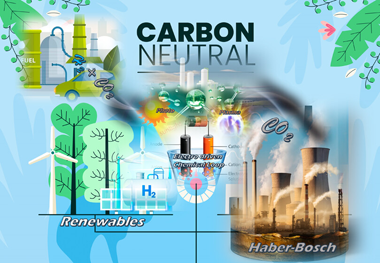
The reliance of a future carbon-free horizon is strongly aligned with the long-term energy storage avenues which are completely derived from renewable energy resources. Ammonia with its high energy content and density can perform as a decent candidate for buffering the short-term storage options. However, the current NH3 production majorly feeding the current huge desire for ammonia is dominated by the conventional nonrenewable Haber–Bosch (H–B) process route, thus continuously damaging the target of carbon neutrality goals. High-purity hydrogen (H2) gas is an essential precursor for the H–B process; however, it is a significant energy consumer (about 2% of the global energy supply) and contributes over 420 million tons of CO2/annum. Therefore, the research on the renewable synthesis of nitrogen-based energy carriers (such as ammonia) from the direct electrochemical, photocatalytic, or plasma catalytic processes; its conversion; and utilization to the potential derivatives has been a hot topic in the past few decades. A prospective analysis of the highly appealing processes has been summarized in this study, which could facilitate the adaption of renewable alternatives as an effective approach for zero carbon emission, paving the excellent pathways along the road to the development of nitrogen-based energy technologies, especially the targeted development of ammonia. Further, this Review covers the current and future impacts of the H–B process, the development of aspiring ammonia synthesis routes (via electro, photo, bio, chemical loop, or plasma catalysis), and its conversion and utilization to the renewable derivatives in terms of fabrication of model catalysts, advanced characterization technology, and efficient device design.
The Need for Flexible Chemical Synthesis and How Dual-Function Materials Can Pave the Way
Merkouri, LP; Paksoy, AI; Reina, TR; Duyar, MS
ACS Catalysis, 13 (2023) 7230-7242 | DOI: 10.1021/acscatal.3c00880
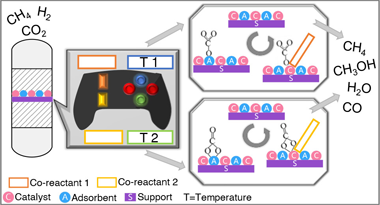
Since climate change keeps escalating, it is imperativethat theincreasing CO2 emissions be combated. Over recent years,research efforts have been aiming for the design and optimizationof materials for CO2 capture and conversion to enable acircular economy. The uncertainties in the energy sector and the variationsin supply and demand place an additional burden on the commercializationand implementation of these carbon capture and utilization technologies.Therefore, the scientific community needs to think out of the boxif it is to find solutions to mitigate the effects of climate change.Flexible chemical synthesis can pave the way for tackling market uncertainties.The materials for flexible chemical synthesis function under a dynamicoperation, and thus, they need to be studied as such. Dual-functionmaterials are an emerging group of dynamic catalytic materials thatintegrate the CO2 capture and conversion steps. Hence,they can be used to allow some flexibility in the production of chemicalsas a response to the changing energy sector. This Perspective highlightsthe necessity of flexible chemical synthesis by focusing on understandingthe catalytic characteristics under a dynamic operation and by discussingthe requirements for the optimization of materials at the nanoscale.
Plasticized, greaseproof chitin bioplastics with high transparency and biodegradability
Heredia-Guerrero, JA; Benitez, JJ; Porras-Vazquez, JM; Tedeschi, G; Morales, Y; Fernandez-Ortuno, D; Athanassiou, A; Guzman-Puyol, S
Food Hydrocolloids, 145 (2023) 109072 | DOI: 10.1016/j.foodhyd.2023.109072
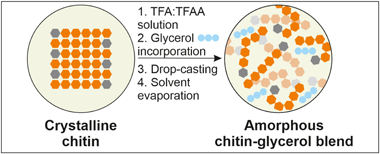
A mixture of trifluoroacetic acid:trifluoroacetic anhydride (TFA:TFAA) was used to dissolve chitin from shrimp shells. Free-standing films were prepared by blending the chitin solution and glycerol at different percentages, followed by drop-casting, and the complete evaporation of the solvents. After this process, the chitin matrix showed an amorphous molecular structure, as determined by X-ray diffraction. Optical, mechanical, thermal, and antioxidant properties were also thoroughly investigated. The incorporation of glycerol induced a plasticizing effect on the mechanical response of films and improved their transparency. In addition, hydrodynamic and barrier properties were determined by contact angle and water vapor/oxygen transmission rates, respectively, and revealed typical values of other polysaccharides. These bioplastics also presented an excellent greaseproof behavior with the highest degree of oil repellency as determined by the Kit test. Moreover, the overall migration was evaluated by using Tenax & REG; as a dry food simulant and levels were compliant with European regulations. Their antifungal properties were tested using Botrytis cinerea as a model. Biodegradability was also determined by measuring the biological oxygen demand in seawater. Degradation rates were high and similar to those of other fully-degradable materials.
Are Ni/ and Ni5Fe1/biochar catalysts suitable for synthetic natural gas production? A comparison with g-Al2O3 supported catalysts
González-Castaño, M; Morales, C; de Miguel, JCN; Boelte, JH; Klepel, O; Flege, JI; Arellano-Garcia, H
Green Energy & Environment, 8 (2023) 744-756 | DOI: 10.1016/j.gee.2021.05.007
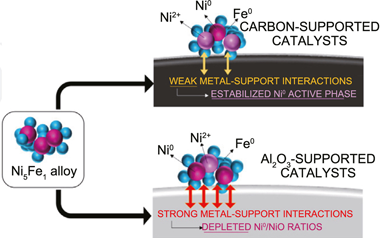
Among challenges implicit in the transition to the post-fossil fuel energetic model, the finite amount of resources available for the technological implementation of CO2 revalorizing processes arises as a central issue. The development of fully renewable catalytic systems with easier metal recovery strategies would promote the viability and sustainability of synthetic natural gas production circular routes. Taking Ni and NiFe catalysts supported over g-Al2O3 oxide as reference materials, this work evaluates the potentiality of Ni and NiFe supported biochar catalysts for CO2 methanation. The development of competitive biochar catalysts was found dependent on the creation of basic sites on the catalyst surface. Displaying lower Turn Over Frequencies than Ni/Al catalyst, the absence of basic sites achieved over Ni/C catalyst was related to the depleted catalyst performances. For NiFe catalysts, analogous Ni5Fe1 alloys were constituted over both alumina and biochar supports. The highest specific activity of the catalyst series, exhibited by the NiFe/C catalyst, was related to the development of surface basic sites along with weaker NiFe-C interactions, which resulted in increased Ni0:NiO surface populations under reaction conditions. In summary, the present work establishes biochar supports as a competitive material to consider within the future low-carbon energetic panorama.
Unravelling the CO2 capture and conversion mechanism of a NiRu-Na2O switchable dual-function material in various CO2 utilisation reactions
Merkouri, LP; Martin-Espejo, JL; Bobadilla, LF; Odriozola, JA; Penkova, A; Reina, T; Duyar, MS
Journal of Materials Chemistry A, 11 (2023) 13209-13216 | DOI: 10.1039/d3ta01892j
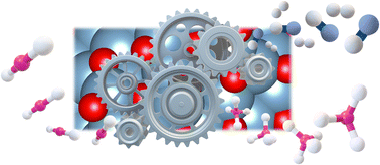
Time-resolved operando DRIFTS-MS was performed to elucidate the CO2 capture and conversion mechanisms of a NiRuNa/CeAl DFM in CO2 methanation, reverse water-gas shift, and dry reforming of methane. CO2 was captured mainly in the form of carbonyls and bidentate carbonates, and a spillover mechanism occurred to obtain the desired products.
Partial oxycombustion-calcium looping hybridisation for CO2 capture in waste-to-energy power plants
Ortiz, C; García-Luna, S; Chacartegui, R; Valverde, JM; Pérez-Maqueda, L
Journal of Cleaner Production, 403 (2023) 136776 | DOI: 10.1016/j.jclepro.2023.136776
Integrating bioenergy and carbon capture and storage (BECCS) presents a great opportunity for power produc-tion with negative global CO2 emissions. This work explores a novel synergetic system that integrates mem-branes, partial biomass oxycombustion and the calcium looping (CaL) process. Polymeric membranes generate oxygen-enriched air (OEA) with an O2 concentration of 39%v/v, which is used for partial oxycombustion of biomass waste. The CO2-enriched flue gas evolves from the waste-to-energy plant to the CaL unit, where CO2 concentration is increased up to 90-95%v/v, ready for purification and sequestration. Compared to only oxy-combustion systems, the proposed concept presents fewer technological challenges in retrofitting boilers to waste-to-energy plants. Moreover, this new approach is highly efficient as integrating membranes to produce OEA instead of cryogenic distillation systems significantly reduces energy consumption. A novel integration concept is modelled to evaluate the whole process efficiency and the effect of key parameters on the system performance, such as the temperature of the reactors, the membrane surface area, and the partial oxy-combustion degree. The results show that the so-called mOxy-CaL system has an energy consumption associ-ated with CO2 capture below 4 MJ/kg CO2 (a 31% lower than that for a conventional CaL process), with a higher CO2 capture efficiency than oxycombustion and the CaL process separately. On the other hand, the economic analysis shows a higher CO2 capture cost for the novel configuration than for the typical CaL configuration due to the additional investment cost of the membrane system. Improvements in membrane performance by increasing its permeance and diminishing the required surface area would significantly reduce the economic cost of this novel integration. Using membranes with permeance over 400 GPU would boost the system's competitiveness.
Bio-based lacquers from industrially processed tomato pomace for sustainable metal food packaging
Benitez, JJ; Ramirez-Pozo, MC; Duran-Barrantes, MM; Heredia, A; Tedeschi, G; Ceseracciu, L; Guzman-Puyol, S; Marrero-López, D; Becci, A; Amato, A; Heredia-Guerrero, JA
Journal of Cleaner Production, 386 (2023) 1356836 | DOI: 10.1016/j.jclepro.2022.135836

Bio-based lacquers prepared from an underutilized tomato processing residue such as pomace have been investigated as sustainable alternatives to bisphenol A (BPA)-based coatings for metal food packaging. The fabrication methodology consisted of a two-step process: spray-coating of a paste of the lipid fraction of tomato pomace with a mixture ethanol:H2O (3:1, v:v) on common metal substrates, used for food canning, such as aluminum (Al), chromium-coated tin-free steel (TFS), and electrochemically tin-plated steel (ETP), followed by the self melt-polycondensation of such lipid fraction. The polymerization reaction was conducted at 200 degrees C for different times (10, 20, 30, 40, 50, and 60 min) and was monitored by specular infrared spectroscopy, resulting in maximum degrees of esterification of-92% for Al and-85% for TFS and ETP substrates. The anticorrosion performance of the coatings was studied by electrochemical impedance spectroscopy at different immersion times (time intervals of 2-5 h during an overall stability test up to 170 h) in an aqueous solution of 1 wt% NaCl. The degree of polymerization and the physical properties of the coatings showed a strong dependence on the metal substrate used. In general, the best results were found for tomato pomace-based lacquers applied on aluminum, achieving higher mechanical strength (critical load of 1739 +/- 198 mN for Al, 1078 +/- 31 mN for ETP, and 852 +/- 206 mN for TFS), hydrophobicity (water contact angle-95 degrees for Al,-91 degrees for ETP, and-88 degrees for TFS), and improved anticorrosion performance (coating resistance of 0.7 M omega cm2 after 170 h of immersion for Al, 0.7 M omega cm2 after 70 h of immersion for TFS, and negligible coating resistance for ETP). In view of the technical innovation proposed in the present paper, the estimation of the environmental sustainability of the process has been considered relevant to fit the circular economy target. For this purpose, a life cycle analysis (LCA) was applied to the overall process, revealing multiple advantages for both the environment and human health.
Engineering morphologies of yttrium oxide supported nickel catalysts for hydrogen production
Zhang, RB; Tu, ZA; Meng, S; Feng, G; Lu, ZH; Yu, YZ; Reina, TR; Hu, FY; Chen, XH; Ye, RP
Rare Metals, 42 (2023) 176-188 | DOI: 10.1007/s12598-022-02136-5
The catalytic performance is highly related to the catalyst structure. Herein, a series of Ni nanoparticles supported on Y2O3 with different morphologies were successfully synthesized via hydrothermal process screening different pH environments. These Ni/Y2O3 catalysts were applied to efficiently produce COx-free H-2 through ammonia decomposition. We identify a significant impact of Y2O3 supports on nickel nanoclusters sizes and dispersion. The experimental results show that Ni/Y11 catalyst achieves 100% ammonia decomposition conversion under a gas hour space velocity (GHSV) of 12,000 ml.h(-1).g(cat)(-1) and temperature of 650 degrees C. Such a high level of activity over Ni/Y11 catalyst was attributed to a large specific surface area, appropriate alkalinity, and small Ni nanoparticles diameter with high dispersion.
Lanthanide vanadate-based trimodal probes for near-infrared luminescent bioimaging, high-field magnetic resonance imaging, and X-ray computed tomography
Gomez-Gonzalez, E; Gonzalez-Mancebo, D; Nunez, NO; Caro, C; Garcia-Martin, ML; Becerro, AI; Ocaña, M
Journal of Colloid and Interface Science, 646 (2023) 721-731 | DOI: 10.1016/j.jcis.2023.05.078
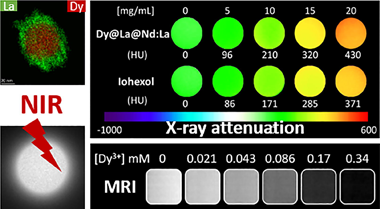
We have developed a trimodal bioimaging probe for near-infrared luminescent imaging, high-field magnetic resonance imaging, and X-ray computed tomography using Dy3+ as the paramagnetic component and Nd3+ as the luminescent cation, both of them incorporated in a vanadate matrix. Among different essayed architectures (single phase and core-shell nanoparticles) the one showing the best luminescent properties is that consisting of uniform DyVO4 nanoparticles coated with a first uniform layer of LaVO4 and a second layer of Nd3+-doped LaVO4. The magnetic relaxivity (r2) at high field (9.4 T) of these nanoparticles was among the highest values ever reported for this kind of probes and their X-ray attenuation properties, due to the presence of lanthanide cations, were also better than those of a commercial contrast agent (iohexol) commonly used for X-ray computed to-mography. In addition, they were chemically stable in a physiological medium in which they could be easily dispersed owing to their one-pot functionalization with polyacrylic acid, and, finally, they were non-toxic for human fibroblast cells. Such a probe is, therefore, an excellent multimodal contrast agent for near-infrared luminescent imaging, high-field magnetic resonance imaging, and X-ray computed tomography.
Carboxylate functionalized NaDy(MoO4)(2) nanoparticles with tunable size and shape as high magnetic field MRI contrast agents
Gomez-Gonzalez, E; Nuñez, NO; Caro, C; Garcia-Martin, ML; Ocaña, M
Journal of Colloid and Interface Science, 629 (2023) 310-321 | DOI: 10.1016/j.jcis.2022.08.130
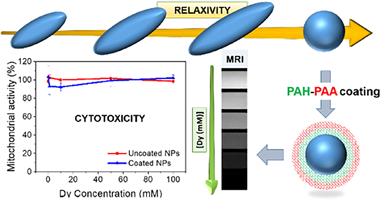
Uniform sodium-dysprosium double molybdate (NaDy(MoO4)(2)) nanoparticles having different morphologies (spheres and ellipsoids) and tunable size have been synthesized for the first time in literature. The procedure is based on a homogeneous precipitation process at moderated temperatures (<= 220 ?) from solutions containing appropriated precursors dissolved in ethylene glycol-water mixtures, in the absence (spheres) or the presence (ellipsoids) of tartrate anions. The effects of the morphological characteristics (size and shape) of the nanoparticles on the magnetic relaxivity at high field (9.4 T) have been evaluated finding that the latter magnitude was higher for the spheres than for the ellipsoids, indicating their better suitability as contrast agents for high-field magnetic resonance imaging. Such nanoparticles have been successfully coated with polymers bearing carboxylate functional groups through a layer-by -layer process, which improves the colloidal stability of the nanoparticles in physiological media. It has been also found that the coating layer had no significant effects on the nanoparticles relaxivity and that such coated nanoparticles exhibited a high biocompatibility and a high chemical stability. In summary, we have developed NaDy(MoO4)(2 )based bioprobes which meet the required criteria for their use as contrast agents for high-field magnetic resonance imaging.
Improved strain engineering of 2D materials by adamantane plasma polymer encapsulation
Carrascoso, F; Li, H; Obrero-Perez, JM; Aparicio, FJ; Borras, A; Island, JO; Barranco, A; Castellanos-Gómez, A
NPJ 2D Materials and Applications, 7 (2023) 24 | DOI: 10.1038/s41699-023-00393-1
Two-dimensional materials present exceptional crystal elasticity and provide an ideal platform to tune electrical and optical properties through the application of strain. Here we extend recent research on strain engineering in monolayer molybdenum disulfide using an adamantane plasma polymer pinning layer to achieve unprecedented crystal strains of 2.8%. Using micro-reflectance spectroscopy, we report maximum strain gauge factors of -99.5 meV/% and -63.5 meV/% for the A and B exciton of monolayer MoS2, respectively, with a 50 nm adamantane capping layer. These results are corroborated with photoluminescence and Raman measurements on the same samples. Taken together, our results indicate that adamantane polymer is an exceptional capping layer to transfer substrate-induced strain to a 2D layer and achieve higher levels of crystal strain.
Large-scale oxygen-enriched air (OEA) production from polymeric membranes for partial oxycombustion processes
Garcia-Luna, S; Ortiz, C; Chacartegui, R; Perez-Maqueda, LA
Energy, 268 (2023) 126697 | DOI: 10.1016/j.energy.2023.126697
Partial oxycombustion using Oxygen-Enriched Air (OEA), produced by air-gas separation with polymeric membranes, combined synergistically with CO2 capture technologies, can reduce the overall energy cost of CO2 capture, and it is a potential alternative to conventional CO2 capture technologies. An exhaustive review of polymeric membranes for this application is presented. The best membranes showed permeability values in the 450-25,100 barrer and selectivities higher than 3.6 for large-scale operations. These membranes can produce OEA with oxygen molar concentrations of up to 40% for retrofitting large-scale power plants (similar to 500 MWe) with partial oxycombustion. For OEA production, the polymeric membrane system is more efficient than cryogenic distillation since the specific power consumption of the former is 35.17 kWh/ton OEA. In comparison, that of the latter is 49.57 kWh/ton OEA. This work proposes that the OEA produced by the membranes feed a partial oxycombustion process integrated with calcium looping within a hybrid CO2 capture system. The power con-sumption of the hybrid CO2 capture system proposed here is 29.05% lower than in the case OEA is produced from cryogenic distillation, which justifies the potential interest in using polymeric membranes for OEA production.
Guaiacol hydrotreatment in an integrated APR-HDO process: Exploring the promoting effect of platinum on Ni-Pt catalysts and assessing methanol and glycerol as hydrogen sources
Jin, W; Gandara-Loe, J; Pastor-Perez, L; Villora-Pico, JJ; Sepulveda-Escribano, A; Rinaldi, R; Reina, TR
Renewable Energy, 215 (2023) 118907 | DOI: 10.1016/j.renene.2023.118907
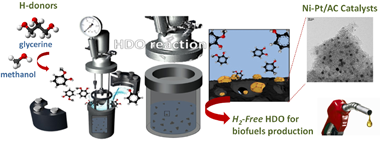
This study presents an integrated approach combining aqueous phase reforming (APR) and hydrodeoxygenation (HDO) for the hydrotreatment of guaiacol, a model compound representing lignin-derived phenols in pyrolysis bio-oils. The APR process enables in-situ H2 generation, eliminating the need for an external hydrogen source. We examine the interplay between metal species, the Pt-promoting effect on Ni-Pt catalyst supported on activated carbon (AC), and the choice of hydrogen source (methanol or glycerol). Amongst the monometallic catalysts, a 1% Pt/AC catalyst notably achieved over 96% guaiacol conversion at 300 degrees C with either hydrogen source. Interestingly, when 0.5-1% of the Ni loading is replaced with Pt, the resulting bimetallic Ni-Pt/AC catalysts demonstrate a significant improvement in guaiacol conversion, reaching 70% when methanol is employed as the hydrogen source. Surprisingly, no comparable enhancement in guaiacol conversion is observed when employing glycerol as the hydrogen source. This observation underlines one of the pivotal effects of the hydrogen source on catalyst performance. X-ray photoemission spectroscopy (XPS) pinpointed strong Ni-Pt interactions in the catalyst. It also revealed distinctive electronic features of Ni-Pt/AC, which are favourable for steering selectivity towards cyclohexanol rather than phenol when Pt loading is increased from 0.5 to 1%. Moreover, Pt enhanced catalyst stability by inhibiting the oxidation of Ni sites and mitigating Ni-Pt phase sintering. Overall, our findings offer important insights into integrating APR and HDO processes, the promotion effect of Pt, and the importance of hydrogen source selection in terms of guaiacol conversion and catalyst stability.
A national data-based energy modelling to identify optimal heat storage capacity to support heating electrification
Lizana, J; Halloran, CE; Wheeler, S; Amghar, N; Renaldi, R; Killendahl, M; Perez-Maqueda, LA; McCulloch, M; Chacartegui, R
Energy, 262 (2023) 125298 | DOI: 10.1016/j.energy.2022.125298
Heating decarbonisation through electrification is a difficult challenge due to the considerable increase in peak power demand. This research proposes a novel modelling approach that utilises easily accessible national-level data to identify the required heat storage volume in buildings to decrease peak power demand and maximises carbon reductions associated with electrified heating technologies through smart demand-side response. The approach assesses the optimal shifting of heat pump operation to meet thermal heating demand according to different heat storage capacities in buildings, which are defined in relation to the time (in hours) in which the heating demand can be provided directly from the heat battery, without heat pump operation. Ten scenarios (S) are analysed: two baselines (S1-S2) and eight load shifting strategies (S3-S10) based on hourly and daily demand-side responses. Moreover, they are compared with a reference scenario (S0), with heating currently based on fossil fuels. The approach was demonstrated in two different regions, Spain and the United Kingdom. The optimal heat storage capacity was found on the order of 12 and 24 h of heating demand in both countries, reducing additional power capacity by 30-37% and 40-46%, respectively. However, the environmental benefits of heat storage alternatives were similar to the baseline scenario due to higher energy consumption and marginal power generation based on fossil fuels. It was also found that load shifting capability below 4 h presents limited benefits, reducing additional power capacity by 10% at the national scale. The results highlight the importance of integrated heat storage technologies with the electrification of heat in highly gas-dependent regions. They can mitigate the need for an additional fossil-based dispatchable generation to meet high peak demand. The modelling approach provides a high-level strategy with regional specificity that, due to common datasets, can be easily replicated globally. For reproducibility, the code base and datasets are found on GitHub.
Integration of calcium looping and calcium hydroxide thermochemical systems for energy storage and power production in concentrating solar power plants
Carro, A; Chacartegui, R; Ortiz, C; Arcenegui-Troya, J; Perez-Maqueda, LA; Becerra, JA
Energy, 283 (2023) 128388 | DOI: 10.1016/j.energy.2023.128388
Energy storage is a key factor in the development of renewables-based electrical power systems. In recent years, the thermochemical energy storage system based on calcium-looping has emerged as an alternative to molten salts for energy storage in high-temperature concentrated solar power plants. This technology still presents some challenges that could be solved by integrating the thermochemical energy storage system based on calcium hydroxide. This work studies a novel concentrated solar power system integrating calcium-looping and calcium hydroxide thermochemical energy storage systems. The results show that the combined use of hydration -dehydration cycles in the calcination-carbonation processes of the calcium looping for energy storage could partially solve the issue related to the multicyclic deactivation of calcium oxide. The improvement in the con-version of calcium oxide during carbonation is demonstrated experimentally when hydration-dehydration cycles are combined. Numerical simulations demonstrate the technical feasibility of the integrated process, with effi-ciencies ranging between 38-46%, improved with the increase in calcium oxide conversion in the carbonator, showing the potential of the proposed integration.
Thermochemical energy storage using calcium magnesium acetates under low CO2 pressure conditions
Amghar, N; Jimenez, PES; Maqueda, LAP; Perejon, A
Journal of Energy Storage, 63 (2023) 106958 | DOI: 10.1016/j.est.2023.106958
The calcium looping multicycle performance of CaO-based materials, derived from calcium magnesium acetates with different Mg content were tested under experimental conditions compatible with thermochemical energy storage. In order to reduce the sintering-induced decay in performance, calcination at an absolute CO2 pressure of 0.1 bar and 0.01 bar is implemented. CaO carbonation is performed at standard 1 bar CO2 conditions. The samples can be fully calcined in short residence times. Samples with MgO present high cycling stability, even when the MgO content is as low as 5 mol%. The effective conversion values lie within the range 0.88-0.84 over ten calcination/carbonation cycles, which provides an accumulated energy storage density of 90.9 GJ/m3. This outstanding reactivity is related with the microstructure of the sample after calcination composed of CaO nanoparticles that are highly reactive for carbonation.
Incorporation of bioactive compounds from avocado by-products to ethyl cellulose-reinforced paper for food packaging applications
Acquavia, MA; Benitez, JEJ; Bianco, G; Crescenzi, MA; Hierrezuelo, J; Grife-Ruiz, M; Romero, D; Guzman-Puyol, S; Heredia-Guerrero, JA
Food Chemistry, 429 (2023) 136906 | DOI: 10.1016/j.foodchem.2023.136906
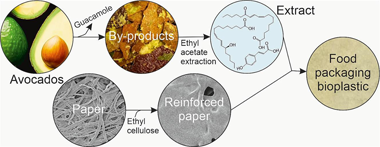
Reinforced films were fabricated by impregnating paper in ethyl cellulose solutions. After solvent evaporation, the infused ethyl cellulose acted as binder of the paper microfibres and occupied the pores and cavities, thus improving the mechanical and barrier properties. To prepare active films, avocado by-products from guacamole industrial production were extracted in ethyl acetate. Then, the extract (optimized to be rich in phenolic compounds and flavonoids and mainly composed by lipids) was incorporated to the paper reinforced with the highest content of ethyl cellulose. In general, the addition of the avocado by-products extract decreased the water uptake and permeability, improved the wettability, and increased the biodegradability in seawater and the antioxidant capacity. In addition, these films acted as barriers and retainers for Escherichia coli and Bacillus cereus. The potentiality of these materials for food packaging was demonstrated by low overall migrations and a similar food preservation to common low-density polyethylene.
Persistent Luminescence Zn2GeO4:Mn2+Nanoparticles Functionalized with Polyacrylic Acid: One-Pot Synthesis and Biosensing Applications
Calderon-Olvera, RM; Arroyo, E; Jankelow, AM; Bashir, R; Valera, E; Ocana, M; Becerro, AI
ACS Applied Materials & Interfaces, 15 (2023) 20613-20624 | DOI: 10.1021/acsami.2c21735
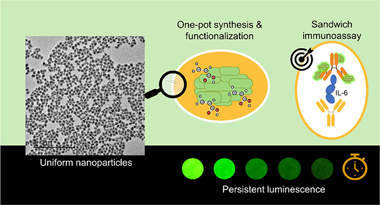
Zinc germanate doped with Mn2+ (Zn2GeO4:Mn2+) is known to be a persistent luminescence green phosphor with potential applications in biosensing and bioimaging. Such applications demand nanoparticulated phosphors with a uniform shape and size, good dispersibility in aqueous media, high chemical stability, and surfacefunctionalization. These characteristics could be major bottlenecks and hence limit their practical applications. This work describes a one-pot, microwave-assisted hydrothermal method to synthesize highly uniform Zn2GeO4:Mn2+ nanoparticles (NPs) using polyacrylic acid (PAA) as an additive. A thorough characterization of the NPs showed that the PAA molecules were essential to realizing uniform NPs as they were responsible for the ordered aggregation of their building blocks. In addition, PAA remained attached to the NPs surface, which conferred high colloidal stability to the NPs through electrostatic and steric interactions, and provided carboxylate groups that can act as anchor sites for the eventual conjugation of biomolecules to the surface. In addition, it was demonstrated that the as-synthesized NPs were chemically stable for, at least, 1 week in phosphate buffer saline (pH range = 6.0-7.4). The luminescence properties of Zn2GeO4 NPs doped with different contents of Mn2+ (0.25-3.00 mol %) were evaluated to find the optimum doping level for the highest photoluminescence (2.50% Mn) and the longest persistent luminescence (0.50% Mn). The NPs with the best persistent luminescence properties were photostable for at least 1 week. Finally, taking advantage of such properties and the presence of surface carboxylate groups, the Zn2GeO4:0.50%Mn2+ sample was successfully used to develop a persistent luminescence-based sandwich immunoassay for the autofluorescence-free detection of interleukin-6 in undiluted human serum and undiluted human plasma samples. This study demonstrates that our persistent Mndoped Zn2GeO4 nanophosphors are ideal candidates for biosensing applications.
Responsive Optical Materials Based on Ligand-Free Perovskite Quantum Dots Embedded in Mesoporous Scaffolds
Romero-Perez, C; Zanetta, A; Fernandez-Delgado, N; Herrera-Collado, M; Hernandez-Saz, J; Molina, SI; Calio, L; Calvo, ME; Miguez, H
ACS Applied Materials & Interfaces 15 (2023) 1808-1816 | DOI: 10.1021/acsami.2c16867
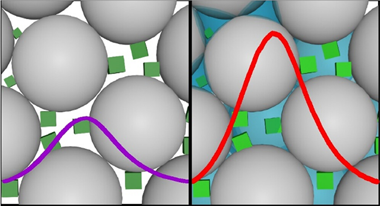
Herein we show that dispersing inorganic cesium lead bromide (CsPbBr3) perovskite quantum dots (QDs) in optical quality films, possessing an accessible and controlled pore size distribution, gives rise to fluorescent materials with a controlled and highly sensi t i v e response to ambient changes. A scaffold-based synthesis approach is employed to obtain ligand-free QDs, whose pristine surface endows them with high sensit i v i t y to the presence of different vapors in their vici n i t y . At the same time, the void network of the host offers a means to gradually expose the embedded QDs to such vapors. Under these conditions, the luminescent response of the QDs is mediated by the mesostructure of the matri x , which determines the rate at which vapor molecules will adsorb onto the pore walls and, eventually, condensate, filling the void space. With luminescence quantum yields as high as 60%, scaffold-supported ligand-free perovskite nanocrystals display intense photoemission signals over the whole process, as well as high photo-and chemical stabi l i t y , which allows illuminating them for long periods of time and recovering the original response upon desorption of the condensed phase. The results herein presented open a new route to explore the application of perovskite QD-based materials in sensing.
Plasmas and acoustic waves to pattern the nanostructure and chemistry of thin films
Rico, V; Regodon, GF; Garcia-Valenzuela, A; Alcaide, AM; Oliva-Ramirez, M; Rojas, TC; Alvarez, R; Palomares, FJ; Palmero, A; Gonzalez-Elipe, AR
Acta Materialia, 255 (2023) 119058 | DOI: 10.1016/j.actamat.2023.119058
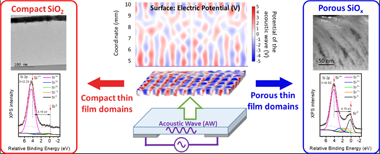
In this work, piezoelectric AWs and plasmas have been brought together during the growth of a thin film as a novel methodology of plasma-assisted thin film structuration. The ensuing effects have been investigated on a model system where SiO2 and SiOx (x<2) thin films have been deposited by magnetron sputtering at oblique angles (MS-OAD) on an electro-acoustically excited LiNbO3 piezoelectric substrate under resonant conditions. The microstructure of the resulting films was 2D patterned and depicted submillimeter size intermingled zones with different optical characteristics, compositions (SiO2 and SiOx) and porosity, from highly porous to dense and compact regions. The 2D nanostructural pattern mimics the AW distribution and has been accounted for by means of a specific simulation model. It is concluded that the morphological and chemical film pattern replicates the distribution of polarization potential on the surface of the AW activated substrate immersed in the plasma. Moreover, we show that the main mechanism responsible for the appearance of domains with different morphology and chemical composition is the focused impingement of Ar+plasma ions on certain regions of the substrate. The general character of this patterning process, the underlying physics and its possibilities to tailor the composition and microstructure of dielectric thin film materials are discussed.
Photoelectrochemical Water Splitting with ITO/WO3/BiVO4/CoPi Multishell Nanotubes Enabled by a Vacuum and Plasma Soft- Template Synthesis
Gil-Rostra, J; Castillo-Seoane, J; Guo, Q; Sobrido, ABJ; Gonzalez-Elipe, AR; Borras, A
ACS Applied Materials & Interfaces, 15 (2023) 9250-9262 | DOI: 10.1021/acsami.2c19868
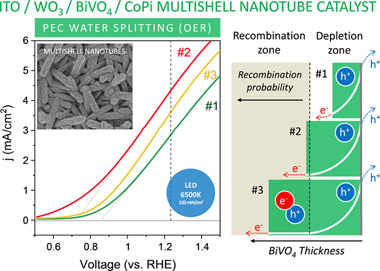
A common approach for the photoelectrochemical (PEC) splitting of water relies on the application of WO3 porous electrodes sensitized with BiVO4 acting as a visible photoanode semiconductor. In this work, we propose a new architecture of photoelectrodes consisting of supported multishell nanotubes (NTs) fabricated by a soft-template approach. These NTs are formed by a concentric layered structure of indium tin oxide (ITO), WO3, and BiVO4, together with a final thin layer of cobalt phosphate (CoPi) co-catalyst. The photoelectrode manufacturing procedure is easily implementable at a large scale and successively combines the thermal evaporation of single crystalline organic nanowires (ONWs), the magnetron sputtering deposition of ITO and WO3, and the solution dripping and electrochemical deposition of, respectively, BiVO4 and CoPi, plus the annealing in air under mild conditions. The obtained NT electrodes depict a large electrochemically active surface and outperform the efficiency of equivalent planar-layered electrodes by more than one order of magnitude. A thorough electrochemical analysis of the electrodes illuminated with blue and solar lights demonstrates that the characteristics of the WO3/BiVO4 Schottky barrier heterojunction control the NT electrode efficiency, which depended on the BiVO4 outer layer thickness and the incorporation of the CoPi electrocatalyst. These results support the high potential of the proposed soft-template methodology for the large-area fabrication of highly efficient multishell ITO/WO3/BiVO4/CoPi NT electrodes for the PEC splitting of water.
Is the RWGS a viable route for CO2 conversion to added value products? A techno-economic study to understand the optimal RWGS conditions
Portillo, E; Gandara-Loe, J; Reina, TR; Pastor-Perez, L
Science of the Total Environment, 857 (2023) 159394 | DOI: 10.1016/j.scitotenv.2022.159394
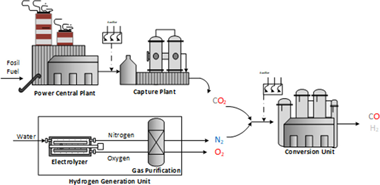
Understanding the viability of the RWGS from a thermodynamic and techno-economic angle opens new horizons within CO2 conversion technologies. Unfortunately, profitability studies of this technology are scarce in literature and mainly focused on overall conversion and selectivity trends with tangential remarks on energy demands and pro-cess costs. To address this research gap, herein we present a comprehensive techno-economic study of the RWGS reac-tion when coupling with Fischer-Tropsch synthesis is envisaged to produced fuels and chemicals using CO2 as building block. We showcase a remarkable impact of operating conditions in the final syngas product and both CAPEX and OPEX. From a capital investment perspective, optimal situations involve RWGS unit running at low temperatures and high pressures as evidenced by our results. However, from the running cost angle, operating at 4 bar is the most favorable alternative within the studied scenarios. Our findings showcase that, no matter the selected temperature the RWGS unit should be preferentially run at intermediate pressures. Ultimately, our work maps out multiple operat-ing scenarios in terms of energy demand and process cost serving as guideline to set optimal reaction conditions to un-lock the potential of the RWGS for chemical CO2 recycling.
Effect of noble metal addition over active Ru/TiO2 catalyst for CO selective methanation from H2 rich- streams
Bobadilla, LF; Muñoz-Murillo, A; Gandara-Loe, J; Perez, A; Laguna, OH; Martinez, TLM; Penkova, A; Centeno, MA; Odriozola, JA
International Journal of Hydrogen Energy, 48 (2023) 25065-25074 | DOI: 10.1016/j.ijhydene.2022.07.072
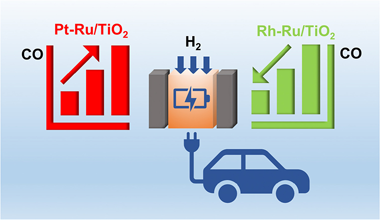
Selective CO methanation from H2-rich stream has been regarded as a promising route for deep removal of low CO concentration and catalytic hydrogen purification processes. This work is focused on the development of more efficient catalysts applied in practical conditions. For this purpose, we prepared a series of catalysts based on Ru supported over titania and promoted with small amounts of Rh and Pt. Characterization details revealed that Rh and Pt modify the electronic properties of Ru. The results of catalytic activity showed that Pt has a negative effect since it promotes the reverse water gas shift reaction decreasing the selectivity of methanation but Rh increases remarkably the activity and selectivity of CO methanation. The obtained results suggest that RuRh-based catalyst could become important for the treatment of industrial-volume streams.
H2-rich syngas production from biogas reforming: Overcoming coking and sintering using bimetallic Ni-based catalysts
Carrasco-Ruiz, S; Zhang, Q; Gándara-Loe, J; Pastor-Pérez, L; Odriozola, JA; Reina, TR; Bobadilla, LF
International Journal of Hydrogen Energy, 48 (2023) 72 | DOI: 10.1016/j.ijhydene.2023.03.301
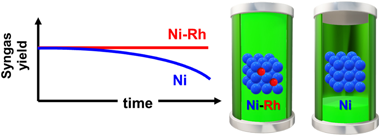
Dry reforming of methane is a very appealing catalytic route biogas (mainly composed by greenhouse gases: carbon dioxide and methane) conversion into added value syngas, which could be further upgraded to produce liquid fuels and added value chemicals. However, the major culprits of this reaction are coking and active phase sintering that result in catalysts deactivation. Herein we have developed a highly stable bimetallic Ni–Rh catalyst supported on mixed CeO2–Al2O3 oxide using low-noble metal loadings. The addition of small amounts of rhodium to nickel catalysts prevents coke formation and improves sintering resistance, achieving high conversions over extended reaction times hence resulting in promising catalysts for biogas upgrading.
Preparation, characterization and activation of Pd catalysts supported on CNx foam for the liquid phase decomposition of formic acid
Arzac, GM; Rojas, TC; Real, C; Fernández, A
International Journal of Hydrogen Energy, 48 (2023) 31899-31613 | DOI: 10.1016/j.ijhydene.2023.04.244
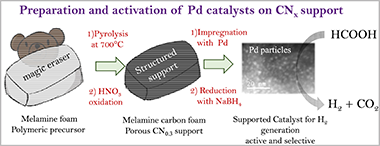
In this work, we have prepared a series of Pd catalysts on a CNx support for the liquid phase decomposition of formic acid. The structured CNx support was obtained through thermal pyrolysis of melamine foam and the pyrolysis conditions were optimized to achieve high surface area. The resulting support contains high amount of nitrogen with a contribution of pyridinic component. Several Pd catalysts were prepared and under optimized condi-tions, we were able to obtain small (2.7 +/- 0.9) nm Pd particles by using the oxidized support in powdery form. The activity of the optimized catalyst was studied under different con-ditions in the fresh and the used form. The fresh catalyst did not show significant activity. However, we found that the catalyst activated after use. Activation was understood in terms of the variation of surface Pd oxidation states under the effect of formic acid/sodium formate solutions. We found that the best activity is achieved under an optimal proportion of Pd0/PdII surface states according to previous reports. Under the best conditions, the activity of the best catalyst (8.6Pd/CN0.3) was as high as 9245 h-1, attributable to the small particle size, the Pd0/PdII ratio, the amount of pyridinic nitrogen, and the testing conditions, which included the preadsorption of sodium formate
A novel, green, cost-effective and fluidizable SiO2-decorated calcium-based adsorbent recovered from eggshell waste for the CO2 capture process
Imani, M; Tahmasebpoor, M; Sanchez-Jim, P; Valverde, J; Garcia, VM
Separation and Purification Technology, 305 (2023) 122523 | DOI: 10.1016/j.seppur.2022.122523
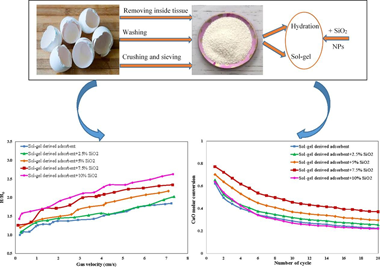
The reduction, storage, and reuse of greenhouse gas carbon dioxide (CO2) is a crucial concern in modern society. Bio-waste adsorbents have recently aroused the investigator's attention as auspicious materials for CO2 capture. However, the adsorption capacity decaying and poor fluidizability during carbonation/calcination cycles of all natural adsorbents used in the calcium-looping process (CaL) are important challenges. The current study ex-plores the performance of a novel SiO2-decorated calcium-based adsorbent recovered from eggshell waste in terms of both CO2 capture capacity and fluidity. Two preparation methods of hydration and sol-gel were used to obtain Ca-based adsorbents with different pore configurations and volumes. Modification of the adsorbents was applied by dry physically mixing with different weight percentages of hydrophobic SiO2 nanoparticles (NPs), in order to maintain stability and fluidity. The adsorbent prepared by the sol-gel method exhibited a fluffier structure with smaller grain sizes and higher porosity than that of prepared by the hydration method, leading to a 6.9 % increase in conversion at the end of the 20th cycle. Also, with the optimal amount of SiO2 nanoparticles, i. e. 7.5 wt%, the amount of CaO conversion obtained by sol-gel derived adsorbent was 27.59 % higher than that by pristine eggshell at the end of the 20th carbonation/calcination cycles. The fluidizability tests showed that the highest bed expansion ratio (2.29) was achieved for sol-gel derived adsorbent in the presence of 7.5 wt% silica nanoparticles which was considerably higher than the amount of 1.8 and 1.6 belonged to sol-gel derived adsorbent and pristine eggshell without silica at the gas velocity of approximate to 6.5 cm/s, respectively. The high adsorption capacity and proper fluidity of this novel and green calcium-based adsorbent promise its wide application.
Microstructure and activity of Pd catalysts prepared on commercial carbon support for the liquid phase decomposition of formic acid
Arzac, GM; Montes, O; Fernández, A
International Journal of Hydrogen Energy, 48 (2023) 2628-2639 | DOI: 10.1016/j.ijhydene.2022.10.149
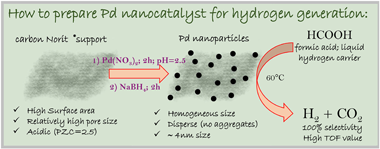
In this work, a series of Pd catalysts supported on commercially available activated carbon (Norit (R)) were prepared by employing different metal precursors (Pd(NO3)2 and Na2PdCl4) by the impregnation-reduction method at different pH. Catalysts were tested for the liquid phase decomposition of formic acid to generate hydrogen. The best results, in terms of small particle size and high catalytic activity were achieved for the Pd/C sample prepared by using Pd(NO3)2 salt impregnated at pH = 2.5, and reduced with sodium borohydride. The particle size of the best Pd/C catalyst is (4.1 +/- 1.4) nm with initial TOFs of 2929 and 683 h-1 at 60 and 30 degrees C respectively and an apparent activation energy of 40 kJ mol-1. Samples prepared by using Na2PdCl4 precursor, consisted of particles with higher size and thus lower activity than the ones prepared with Pd(NO3)2. Regardless the Pd precursor employed, the best results in terms of particle size and activity were achieved at the point of zero charge of the support when the Pd species and the carbon surface were both neutral. The impregnation pH not only determines the particle size, but also the nature of the reducing agent does. The catalytic activity was shown to be size-dependent and it was shown that a mixture of surface Pd0 and PdII oxidation states is beneficial for the activity. When comparing with literature catalysts with similar composition, we found that our best catalyst is competitive enough and that Norit (R) support could be promising for future studies on this reaction.
A technological approach based on engineered nanoclay composites for cesium and iodine retention
Osuna, FJ; Pavon, E; Alba, MD
Chesmosphere, 341 (2023) 140128 | DOI: 10.1016/j.chemosphere.2023.140128
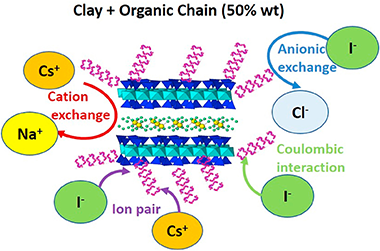
The development of effective and environmentally friendly methods for separating hazardous radionuclides from waste poses a significant technological challenge. 137Cs and 131I are among the most important radionuclides discharged into the environment by nuclear power plants. One of the best ways to eliminate them involves adsorption on clay minerals. In this regard, studies have demonstrated that organofunctionalized clay minerals are effective adsorbents. Thus, this study investigates the capability of organofunctionalized synthetic design clay minerals to jointly eliminate cesium and iodine. The adsorbents studied are a range of organofunctionalized clay minerals with alkylammonium cations of different alkyl chain lengths (2, 3 and 18) and some physical mixtures of raw clay minerals and octadecylammonium compounds. Organofunctionalized synthetic swelling highly charged micas are effective adsorbents for the simultaneous adsorption of cesium and iodine. In addition, the optimal system is a mixture of Na-M4 with octadecylammonium (50% w/w).
An overview of polymeric composite scaffolds with piezoelectric properties for improved bone regeneration
Donate, R; Paz, R; Moriche, R; Sayagués, MJ; Alemán-Domínguez, ME; Monzón, M
Materials & Design, 231 (2023) 112085 | DOI: 10.1016/j.matdes.2023.112085
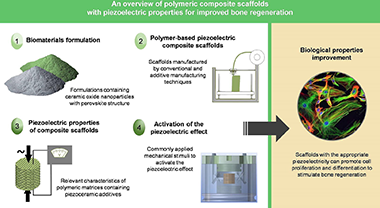
Despite the dramatic change that Tissue Engineering or stem cell therapies have brought to current therapeutic strategies, there is a lack of functionalities in the available biomaterials for manufacturing scaffolds to treat several highly prevalent osseous diseases (osteochondral defects, osteoporosis, etc.). One promising approach to fill this gap involves the development of innovative piezoelectric scaffolds for improved bone regeneration. Scaffolds with the appropriate piezoelectricity can positively influence the proliferation and differentiation of mesenchymal stem cells to regenerate bone tissue, since surface electrical charges play a key role in the mechanotransduction process. In this work, polymeric-based composite scaffolds with piezoelectric properties intended for bone tissue engineering are reviewed. Special attention is paid to biocompatible, piezoelectric polymers that show suitable properties to be pro-cessed by additive manufacturing techniques. Previous works on composite scaffolds based of these poly-meric matrices and containing piezoceramic additives are summarized. The use of piezoelectric nanostructured composite formulations containing lead-free ceramic oxide nanoparticles with per-ovskite structure is highlighted. Also, different commonly applied mechanical stimuli to activate the piezoelectric effect of the developed materials are presented. Finally, other applications of such scaffolds are mentioned, including their capabilities for real-time monitoring
Photoreforming of glycerol to produce hydrogen from natural water in a compound parabolic collector solar photoreactor
Villachica-Llamosas, JG; Sowik, J; Ruiz-Aguirre, A; Colón, G; Peral, J; Malato, S
Journal of Environmental Chemical Engineering, 11 (2023) 111216 | DOI: 10.1016/j.jece.2023.111216
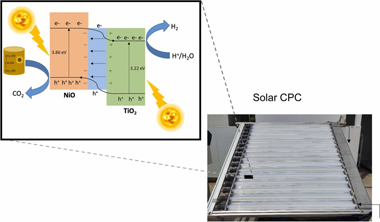
To improve TiO2 for H2 generation, one strategy for the separation of photogenerated charges is the formation of heterostructures with other materials. In particular, NiO is a photocatalyst known for its good stability and low cost. However, no studies at pilot scale using solar energy have been described. Consequently, an evaluation of a physical NiO:TiO2 mixture at pilot scale (25 L) with natural irradiation (2.10 m2 of sun-exposed surface) and with simultaneous glycerol photoreforming was explored. NiO:TiO2 50 mg & sdot;L- 1 resulted in the highest hydrogen production, showing an STH = 1.44%, considering only the UV fraction of the solar irradiation. H2 and CO2 production were analysed by on-line GC; Glycerol, dissolved organic carbon, carboxylic acids and nickel leaching were also evaluated. The NiO:TiO2 mixtures rendered a systematically lower H2 production in natural water than in high-purity water. The increase of ionic strength increased the mean size of particle clusters, promoting rapid sedimentation. All this indicates the importance of testing under real field conditions for attaining reliable solar to hydrogen (STH) efficiency.
Hydrothermal carbonization vs. anaerobic digestion to valorize fruit and vegetable waste: A comparative technical and energy assessment
Metyouy, K; Gonzalez, R; Gomez, X; Gonzalez-Arias, J; Martinez, EJ; Chafik, T; Sanchez, ME; Cara-Jiménez, J
Journal of Environmental Chemical Engineering, 11 (2023) 109925 | DOI: 10.1016/j.jece.2023.109925
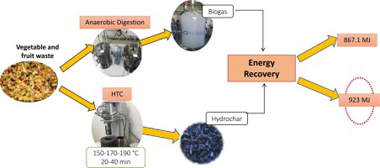
Herein, the valorization of vegetable and fruit waste was assessed via hydrothermal carbonization (HTC) and anaerobic digestion (AD) in terms of product characterization and energy requirements. HTC was conducted at reaction temperatures between 150 & DEG;C and 190 & DEG;C, and residence times between 20 min and 40 min. The increase in the process severity resulted in hydrochars with higher carbon contents and higher energy densification ratios. AD was performed in two different ways. i.e., batch and semi-continuous reactions. From the batch experiments a methane yield of 300 L CH4/kg VS was obtained, while for the semi-continuous, the average specific methane production estimated (for HRTs from 75 to 50 days) was 213 & PLUSMN; 32 L CH4/kg VS. To estimate the energy re-quirements, mass and energy balances were performed considering the basic stages of each process to obtain a suitable biofuel material. In this sense, it was concluded that for this specific waste, AD was a more suitable process with a positive energy net balance. On the contrary, HTC presented a negative energy net balance being required 1.29 MJ/kg of fresh food waste. A combined HTC-AD treatment may be an efficient method to take advantage of both technologies leading to higher energy efficiencies and other valuable products.
Metal- based eggshell particles prepared via successive incipient wetness impregnation method as a promoted sorbent for CO2 capturing in the calcium looping process
Imani, M; Tahmasebpoor, M; Sanchez-Jimenez, PE
Journal of Environmental Chemical Engineering, 11 (2023) 110584 | DOI: 10.1016/j.jece.2023.110584
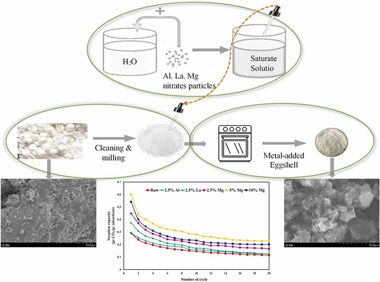
Cyclic adsorption by using of bio-waste eggshell particles as a cheap, accessible and environmentally friendly CaCO3 source has been considered as one of the important methods to decrease or remove CO2 from the flue gas. However, deactivation of eggshell particles and CO2 capture capacity decaying with increasing the cycle's number remained as an important challenge. Using metal nitrates as one of the modification methods has been proposed by the researchers to overcome this problem. Current study investigates the influence of three metal nitrates of Al, La and Mg added to the eggshell particles via successive incipient wetness impregnation (SIWI) method to improve their adsorption performance. The TGA results at the end of the 20th carbonation/calcination cycle revealed a meaningful relationship between CaO molar conversion of eggshell modified with metal nitrates and their crystallite size as well as the surface area of the sorbents, so that the smaller the crystal size and the larger the surface area, the higher the molar conversion of CaO could be achieved. Due to the highest conversion obtained for Mg-containing sample, the effect of different weight percentages of this additive was also investigated. Results showed that 5 wt% MgO contained eggshell particles could be reported as the most outstanding sample for its improved molar conversion, capture capacity at the end of 20th carbonation/calcination cycle and BET surface area, which were 30.18%, 0.23 gr CO2/gr adsorbent and 3.5 m2/g while the corresponding amounts for raw eggshell were 17.26%, 0.11 gr CO2/gr adsorbent and 1.63 m2/g, respectively.
Plasma assisted dry reforming of methane: Syngas and hydrocarbons formation mechanisms
Navascues, P; Cotrino, J; Gonzalez-Elipe, AR; Gomez-Ramirez, A
Fuel Processing Technology, 248 (2023) 107827 | DOI: 10.1016/j.fuproc.2023.107827
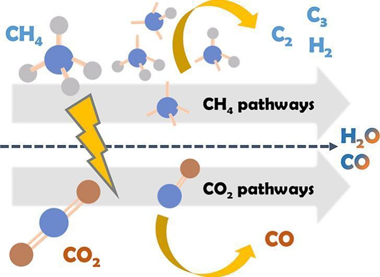
Plasma reactions of CO2 + CH4 mixtures have been proposed as a suitable process for the dry reforming of methane. Without specific catalysts, most studies report the formation of CO and H2 as main reaction products and arise the question whether CHx radicals coming from CH4 may interact with intermediate species formed by electron impact dissociation of CO2, a critical step for the formation of high added value oxygenated compounds. We have addressed this question studying the CO2 + CH4 plasma reaction in a ferroelectric-moderated packed -bed reactor varying the reactants ratio. Analysis of the reaction products by mass spectrometry and the plasma reaction intermediates by optical emission spectroscopy suggest that few direct cross-link interactions exist between intermediate plasma species issued from CH4 or CO2. This preliminary evidence is corroborated by experiments using 13CO2 instead 12CO2 as reactant. The isotope labeling procedure has proved that plasma re-action mechanisms of CO2 and CH4 molecules proceed almost independently, with the formation of small amounts of water and the removal of carbon deposits resulting CH4 plasma decomposition as sole evidences of cross reactions. These results highlight the need of using catalysts to promote specific surface reactions for a better control of the selectivity of the process.
Water-assisted HDO of biomass model compounds enabled by Ru-based catalysts
Carrasco-Ruiz, S; Parrilla-Lahoz, S; Santos, JL; Penkova, A; Odriozola, JA; Reina, TR; Pastor-Pérez, L
Fuel Processing Technology, 249 (2023) 107860 | DOI: 10.1016/j.fuproc.2023.107860
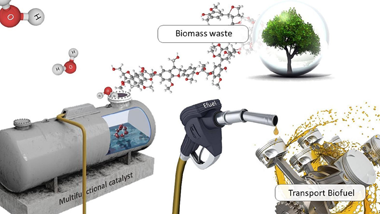
Biofuels upgrading gathering momentum in view of the gradual depletion of fossil fuels and the pursuit of renewable energy sources to mitigate global warming. Hydrodeoxygenation (HDO) is a key reaction in the upgrading of bio-oil to produce hydrocarbon fuels or high-value chemicals. Oxygen removal in bio-oil increases its calorific value, improve thermal and chemical stability, reduce corrosiveness, etc., making the upgraded biooil suitable as a fuel or blending fuel. However, the dependence on high-pressure hydrogen is a serious disadvantage, as it is an expensive resource whose use also poses safety concerns. In this scenario, we propose a pioneering route for model biomass compounds upgrading via H2-free HDO. Herein we have developed multifunctional catalysts based on Ru and ceria supported on carbon able conduct the hydrodeoxygenation reaction using water as hydrogen source. We found that cerium oxide improves ruthenium metallic dispersion and the overall redox properties of the multicomponent system leading to enhanced catalytic performance. Along with the successful catalytic formulation we identify 300 degrees C as an optimal temperature validating the H2-free HDO route for bio-compounds upgrading.
Ultrapure Green High Photoluminescence Quantum Yield from FAPbBr3 Nanocrystals Embedded in Transparent Porous Films
Romero-Pérez, C; Delgado, NF; Herrera-Collado, M; Calvo, ME; Míguez, H (Mig
Chemistry of Materials, 35 (2023) 5541-5549 | DOI: 10.1021/acs.chemmater.3c00934
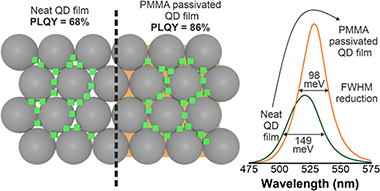
Achieving highly transparent and emissive films based on perovskite quantum dots (PQDs) is a challenging task since their photoluminescence quantum yield (PLQY) typically drops abruptly when they are used as building blocks to make a solid. In this work, we obtain highly transparent films containing FAPbBr(3) quantum dots that display a narrow green emission (lambda = 530 nm, full width at half-maximum (FWHM) = 23 nm) with a PLQY as high as 86%. The method employed makes use of porous matrices that act as arrays of nanoreactors to synthesize the targeted quantum dots within their void space, providing both a means to keep them dispersed and a protective environment. Further infiltration with poly(methyl methacrylate) (PMMA) increases the mechanical and chemical stability of the ensemble and serves to passivate surface defects, boosting the emission of the embedded PQD and significantly reducing the width of the emission peak, which fulfills the requirements established by the Commission Internationale de l'E ' clairage (CIE) to be considered an ultrapure green emitter. The versatility of this approach is demonstrated by fabricating a color-converting layer that can be easily transferred onto a light-emitting device surface to modify the spectral properties of the outgoing radiation.
Spinel ferrite catalysts for CO2 reduction via reverse water gas shift reaction
Navarro, JC; Hurtado, C; Gonzalez-Castano, M; Bobadilla, LF; Ivanova, S; Cumbrera, FL; Centeno, MA; Odriozola, JA
Journal of CO2 Utilization, 68 (2023) 102356 | DOI: 10.1016/j.jcou.2022.102356
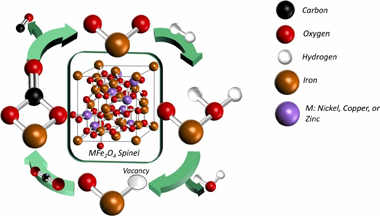
The production of CO via Reverse Water Gas Shift (RWGS) reaction is a suitable route for CO2 valorization. In this study a series of modified spinels AB2O4 (A site symbolscript Ni, Zn and Cu and B symbolscript are investigated as RWGS catalysts and their structure-to-function relationships derived from the changes on the A-site cation are ratio-nalized. For all ferrite systems, the RWGS reaction the process main activity and selectivity is governed by the B -site cation, but the variations on the A-site metals determines catalysts' structural features and stability in the reaction. Among the catalyst series, superior RWGS performance displayed the ferrites modified with Cu and Ni associated to the greater oxygen vacancy population for those spinels enabled by the partial allocation on symbolscript cations into the tetrahedral sites.
Incorporation of a Metal Catalyst for the Ammonia Synthesis in a Ferroelectric Packed-Bed Plasma Reactor: Does It Really Matter?
Navascues, P; Garrido-Garcia, J; Cotrino, J; Gonzalez-Elipe, AR; Gomez-Ramirez, A
ACS Sustainable Chemistry & Engineering, 11 (2023) 3621-3632 | DOI: 10.1021/acssuschemeng.2c05877
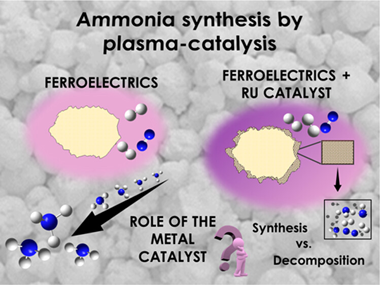
Plasma-catalysis has been proposed as a potential alternative for the synthesis of ammonia. Studies in this area focus on the reaction mechanisms and the apparent synergy existing between processes occurring in the plasma phase and on the surface of the catalytic material. In the present study, we approach this problem using a parallel-plate packed-bed reactor with the gap between the electrodes filled with pellets of lead zirconate titanate (PZT), with this ferroelectric material modified with a coating layer of alumina (i.e., Al2O3/PZT) and the same alumina layer incorporating ruthenium nanoparticles (i.e., Ru-Al2O3/PZT). At ambient temperature, the electrical behavior of the ferroelectric packed-bed reactor differed for these three types of barriers, with the plasma current reaching a maximum when using Ru-Al2O3/PZT pellets. A systematic analysis of the reaction yield and energy efficiency for the ammonia synthesis reaction, at ambient temperature and at 190 °C and various electrical operating conditions, has demonstrated that the yield and the energy efficiency for the ammonia synthesis do not significantly improve when including ruthenium particles, even at temperatures at which an incipient catalytic activity could be inferred. Besides disregarding a net plasma-catalysis effect, reaction results highlight the positive role of the ferroelectric PZT as moderator of the discharge, that of Ru particles as plasma hot points, and that of the Al2O3 coating as a plasma cooling dielectric layer.
Catalytic performance of cobalt supported onto APTES functionalized TiO2 for Fischer-Tropsch reaction
Platero, F; Caballero, A; Colon, G
Fuel, 340 (2023) 127528 | DOI: 10.1016/j.fuel.2023.127528
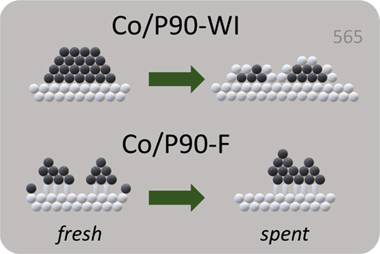
Cobalt supported TiO2 catalysts have been prepared by wet-impregnation and by immobilization over APTES (3-aminopropyl triethoxysilane) grafted TiO2. Impregnated system showed better catalytic performance after reduction at 260 degrees C but significant deactivation is observed. On the contrary, functionalized catalyst showed better catalytic performance after reduction at 400 degrees C with notable stability. We have stated from CO-DRIFT operando analysis that impregnated system is strongly affected by negative SMSI (strong metal-support inter-action) upon reduction at higher temperature. While immobilization on APTES hinders the loss of metal active sites. The study of spent catalysts denotes that Co is redispersed in the impregnated catalyst while functionalized trends to form agglomerates.
In-situ DRIFTS steady-state study of CO2 and CO methanation over Ni-promoted catalysts
González-Castaño, M; González-Arias, J; Bobadilla, LF; Ruíz-López, E; Odriozola, JA; Arellano-García, H
Fuel, 338 (2023) 127241 | DOI: 10.1016/j.fuel.2022.127241
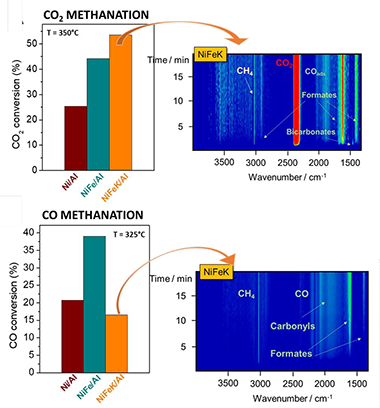
Promoting the performance of catalytic systems by incorporating small amount of alkali has been proved effective for several reactions whilst controversial outcomes are reported for the synthetic natural gas production. This work studies a series of Ni catalysts for CO2 and CO methanation reactions. In-situ DRIFTS spectroscopy evidenced similar reaction intermediates for all evaluated systems and it is proposed a reaction mechanism based on: i) formate decomposition and ii) hydrogenation of lineal carbonyl species to methane. Compared to bare Ni, the enhanced CO2 methanation rates attained by NiFe/Al and NiFeK/Al systems are associated to promoted formates decomposition into lineal carbonyl species. Also for CO methanation, the differences in the catalysts' performances were associated to the relative concentration of lineal carbonyl species. Under CO methanation conditions and opposing the CO2 methanation results where the incorporation of K delivered promoted catalytic behaviours, worsened CO methanation rates were discerned for the NiFeK/Al system.
Surface Acoustic Waves Equip Materials with Active De-Icing Functionality: Unraveled Glaze Ice De-Icing Mechanisms and Application to Centimeter-Scale Transparent Surfaces
Jacob, S; Pandey, S; Del Moral, J; Karimzadeh, A; Gil-Rostra, J; Gonzalez-Elipe, AR; Borras, A; Winkler, A
Advanced Materials Technologies | DOI: 10.1002/admt.202300263
Enabling active de-icing functionality on low heat conductive and transparent materials is a requirement for several seminal industries in critical economic sectors. However, developing efficient and environmentally friendly de-icing methods still fails because of compatibility problems with large-scale devices and real-world conditions. In this paper, de-icing several square centimeters covered with thick layers of glaze ice is approached through nanoscale activation by surface acoustic waves (SAWs). De-icing functionality is demonstrated with a self-supported piezoelectric material (LiNbO3) and a piezoelectric film (ZnO) deposited on fused silica, the latter system proving the compatibility of the method with materials of practical relevance. Its applicability to large and transparent substrates is demonstrated by placing the interdigitated electrodes (IDTs) required for activation close to the substrate's edges, leaving most of the surface unaltered. The de-icing mechanism of glaze ice by SAW activation is revealed by simulating the SAW propagation on ice-covered surfaces and by experimental analysis of the ice melting process. This involves a combination of ice mechanical stress activation and heating through the initially formed water/ice front. Possible Joule effects due to ohmic losses in the IDTs have been discarded, monitoring local temperature variations during SAW activation at and out of resonance conditions.
Exalted dual-scale surface roughening in laser ablated aluminum capped with a transparent thin film: Wetting and anti-icing behavior
Ghemras, I; Montes, L; Lopez-Santos, C; Gonzalez-Elipe, AR; Rico, V
Applied Surface Science, 630 (2023) 157357 | DOI: 10.1016/j.apsusc.2023.157357
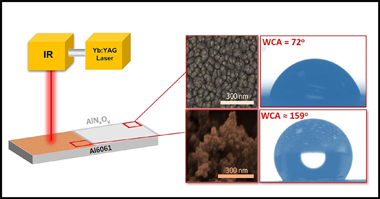
Near infrared laser ablation of metals, specifically aluminum, has been systematically applied to generate surface roughness. Very high laser fluences may even lead to a so called "explosive" ablation regime where roughness becomes dramatically enhanced. In the present work we have developed an alternative methodology that, uti-lizing milder laser irradiation conditions (i.e. laser fluences from 0.37 to 0.72 J/cm2), renders aluminum surfaces with a dual-scale roughness character and Sp parameter values twice or even trice the value found in reference samples. This has been possible for aluminum substrates coated with a highly transparent aluminum oxynitride capping layer. The resulting surfaces, consisting of very rough partially oxidized aluminum with negligible amounts of nitrogen species, resulted highly hydrophobic and depicted long icing delay times as required for anti-icing applications. A correlation has been found between the wetting and anti-icing behaviors, the use of a capping layer and the laser irradiation conditions. To account for this exalted roughening phenomenon, we propose that the transparent capping layer confines the laser energy within the aluminum shallow zones, delays the formation of the plasma plume and produces an enhancement in the aluminum ablation, even at relatively low laser fluences.
Strontium/zinc phytate-based self-assembled monolayers on titanium surfaces enhance osteogenesis and antibacterial performance in vitro
Asensio, G; Hernández-Arriaga, AM; Martin-del-Campo, M; Prieto, MA; González-Elipe, AR; Rojo, L; Vázquez-Lasa, B
Applied Surface Science, 620 (2023) 156818 | DOI: 10.1016/j.apsusc.2023.156818
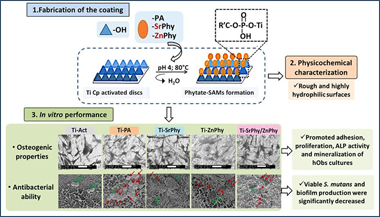
The accumulation of bacteria over implant surfaces is still the first cause of failure, and the development of antimicrobial surfaces constitutes a first line in implant research. Besides, the durability and mechanical performance of implants, in special in the dental area, are mainly determined by their osseointegration capacity into the maxillofacial bone and the appearance of infections. Consequently, implant osseointegration and infection prophylaxis remain as big challenges to attain so a huge investigation is being developed on the production of bioactive surfaces to achieve improvements in these aspects. In this work we propose the functionalization of titanium surfaces (Ti Cp) with self-assembled monolayers (SAMs) of bioactive organophosphate compounds: phytic acid (Ti-PA) and its metallic phytate de- rivatives bearing Sr2+ and/or Zn2+ (Ti-SrPhy, Ti-ZnPhy and Ti-SrPhy/ZnPhy) which exhibited tunable in vitro osteogenic, antimicrobial and antioxidant properties in a previous work. Thus, phytate compounds are chemically anchored onto Ti discs through a simple procedure consisting of a condensation reaction promoted by heat treatment. EDS and XPS spectroscopies confirm the obtaining of the modified surfaces and the topographic properties and wettability analysed by SEM, AFM, profilometry and contact angle measurements, respectively, are explored. Additionally, phytate-SAMs do not release any cytotoxic compound after 14 days and stimulate in vitro adhesion and proliferation of human osteoblast cells after 14 days of culture. The osteogenic ability of the modified surfaces evaluated by the quantification of ALP activity and matrix mineralization degree shows a significant improvement with respect to unmodified surfaces. Furthermore, the antimicrobial activity of phytate-SAMs against Streptococcus mutans cultures is evaluated. The count of viable cells and the quantification of produced biofilm are significantly reduced by all phytate-SAMs groups (p < 0.001). Cell membrane integrity studies by LIVE/DEAD staining and SEM imaging confirm a decreased viability of adhered bacteria when phytate-based surfaces are tested, due to a disruption in the function and permeability of the cell membrane. Therefore, phytate-SAMs exhibit suitable in vitro features suggesting their promising potential as bioactive coatings of dental implants.
Limits of powder metallurgy to fabricate porous Ti35Nb7Zr5Ta samples for cortical bone replacements
Rodriguez-Albelo, LM; Navarro, P; Gotor, FJ; de la Rosa, JE; Mena, D; Garcia-Garcia, FJ; Beltran, AM; Alcudia, A; Torres, Y
Journal of Materials Research and Technology-JMR&T, 24 (2023) 6212-6226 | DOI: 10.1016/j.jmrt.2023.04.212
The use of 13-Titanium alloys to fabricate metal implants with Young's modulus that re-sembles bone tissues is presented as an alternative to commercially pure titanium or a- Titanium alloys, although it is still necessary to introduce proper implant porosity to reach the Young's modulus of cortical bones. In this work, porous samples were fabricated by loose sintering (0 MPa) and compared to samples manufactured at 1000 MPa, both sintered under the same conditions. Raw powders and sintered samples of the 13-Titanium alloy, Ti35Nb7Zr5Ta, were characterized in detail in terms of both physicochemical and micro-structural properties. Moreover, the tribo-mechanical behavior of sintered samples was evaluated by performing ultrasound technique, instrumented micro-indentation (P-h curves), and scratch tests. The bio-functional behavior was studied by impedance spec-troscopy and contact angle measurements. The results allowed the evaluation of the limits of conventional powder metallurgy (percentage of porosity, size, and morphology of pores), as well as the influence of the porosity and chemical composition to achieve a better biomechanical and bio-functional behavior that would guarantee bone requirements. The Ti35Nb7Zr5Ta alloy showed relatively high electrical impedance values compared to commercially pure titanium, indicating an improved bio-corrosion behavior. Furthermore, wettability measurements indicated that porous disks fabricated by loose sintering exhibit higher hydrophilicity, often associated with a better antibacterial response
Efficient SrO-based thermochemical energy storage using a closed-loop pressure swing
Amghar, N; Sánchez-Jiménez, PE; Ortiz, C; Pérez-Maqueda, LA; Perejón, A
Applied Thermal Engineering, 235 (2023) 121411 | DOI: 10.1016/j.applthermaleng.2023.121411
The SrCO3/SrO system has recently attracted interest for thermochemical energy storage due to the high energy densities potentially attainable. However, the high temperatures needed to promote calcination involve a sintering-induced deactivation of SrO to carbonation. In this work, SrO-based samples have been tested using a closed-loop pressure swing approach involving calcinations and carbonations at absolute pressures of 0.01 bar and 1 bar CO2, respectively. Using low CO2 absolute pressure for calcination decreases the reaction temperature to 900 degrees C, thus reducing the deactivation of SrO. Moreover, the use of additives further improves the reactivity of the samples. The addition of ZrO2 and MgO by mechanical mixing and acetic acid treatment, respectively, results in samples with very high multicycle performance, yielding material energy storage densities after twenty cycles above 5.0 GJ/m3. These results significantly improve those obtained for similar samples in which calcinations and carbonations were carried out at an absolute pressure of 1 bar CO2. Regarding the integration of the thermochemical energy storage into concentrating solar power plants, calcining SrO-based materials at low pressure increases the net thermal-to-electric efficiencies by up to 6 % points compared to CaO-based materials calcined at the same conditions. The importance of experimental conditions and precursors in the multicycle behaviour of SrO-based materials for thermochemical energy storage is emphasized.
Europium doped-double sodium bismuth molybdate nanoparticles as contrast agents for luminescence bioimaging and X-ray computed tomography
Calderon-Olvera, RM; Nunez, NO; Gonzalez-Mancebo, D; Monje-Moreno, JM; Munoz-Rui, MJ; Gomez-Gonzalez, E; Arroyo, E; Torres-Herrero, B; De la Fuente, JM; Ocaña, M
Inorganic Chemistry Frontiers, 10(11) (2023) 3202 | DOI: 10.1039/D2QI02664C
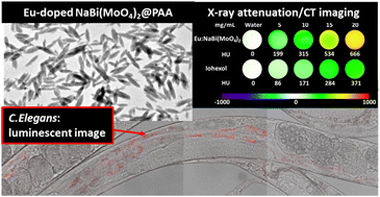
A one-pot method for the synthesis of uniform Eu3+-doped NaBi(MoO4)2 nanoparticles with an ellipsoidal shape and tetragonal crystal structure functionalized with polyacrylic acid is reported for the first time in the literature. The method is based on a homogeneous precipitation reaction from solutions in an ethylene glycol/water medium containing appropriate bismuth, sodium, and molybdate precursors and polyacrylic acid. The luminescence properties (excitation and emission spectra and luminescence lifetime) of such nanoparticles are evaluated for different Eu3+ doping levels, finding an intense red emission for all synthesized samples. The X-ray attenuation properties of the nanoparticles have been also analyzed, which were found to be better than those of a commercially computed tomography contrast agent (iohexol). The dispersibility of the nanoparticles in a physiological medium was also analyzed, finding that they could be well dispersed in a 2-N-morpholinoethanesulfonic acid monohydrate medium (pH = 6.5). Finally, the cell viability of such a phosphor has been analyzed using MIA-PaCa-2 cells and its in vivo toxicity has been evaluated using the nematode Caenorhabditis elegans model finding no significant toxicity in both cases up to a nanoparticle concentration of 100 μg mL−1, which is within the range required for most in vivo applications. The developed Eu3+-doped NaBi(MoO4)2 nanoparticles are, therefore, excellent candidates for their use as bimodal probes for luminescence imaging and X-ray computed tomography.
Reversibility and thermal dependence of the martensitic transformation in a melt-spun Ni55Fe17Ga26Co2 Heusler alloy
Manchon-Gordon, AF; Vidal-Crespo, A; Blazquez, JS; Kowalczyk, M; Ipus, JJ; Kulik, T; Conde, CF
Journal of Alloys and Compounds, 946 (2023) 169484 | DOI: 10.1016/j.jallcom.2023.169484
An almost single phase 14 M modulated martensite is obtained in melt spun ribbon of Ni55Fe17Ga26Co2 Heusler alloy. The effect of thermal treatments on the stability of the reverse martensitic transformation from 14 M modulated martensite to austenite phase in this system has been investigated by both non -isothermal and isothermal treatments. Heating above martensitic transformation promotes a continuous reduction of the martensitic transformation temperature, which stabilizes the austenite phase at room temperature and induces the precipitation of the gamma phase. However, thermal treatments at tem-peratures between the austenite start and finish temperatures induce the decoupling of the austenite formation in a subsequent heating. The two successive reverse martensitic transformations could be as-cribed to the untransformed martensite in the previous interrupted heating and to the new martensite formed during cooling.
Ti6Al4V coatings on titanium samples by sputtering techniques: Microstructural and mechanical characterization
Sanchez-Lopez, JC; Rodriguez-Albelo, M; Sanchez-Perez, M; Godinho, V; Lopez-Santos, C; Torres, Y
Journal of Alloys and Compounds, 952 (2023) 170018 | DOI: 10.1016/j.jallcom.2023.170018
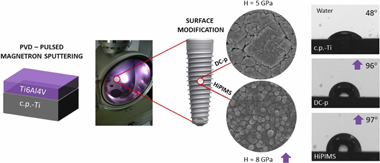
Although titanium is widely used as biomaterial, the control of the interface properties between its surface and the surrounding physiological environment (like bone, other tissues or biofluids) results crucial to achieve a successful osseointegration and good biomechanical and functional performance. In this work, commercially pure titanium (Grade IV) discs obtained by conventional powder metallurgy were coated with 1-3 mu m of Ti6Al4V (Grade V) alloy using DC-pulsed or high-power impulse magnetron sputtering (HiPIMS) technique with the aim of improving their biomedical performance. SEM, confocal microscopy, X-ray dif-fraction, nanoindentation and wetting measurements are used to evaluate the bio-interface role of the titanium-coated implants. Conformal Ti6Al4V coatings with controlled nano-roughness can be deposited with enhanced mechanical (H = 5-8 GPa; E = 140-160 GPa) and hydrophobic properties thanks to a dense columnar structure. The increased Ti-O bonding at the interface helps to prevent the corrosion due to the formation of a surface passivation layer. Particularly in the case of the HiPIMS process, the surface mod-ification of titanium implants (chemistry, morphology and structure) appears as an effective strategy for satisfying the biomedical requirements and functionality, with enhanced mechanical properties and na-nostructuration for prevention of bacteria colonization.
R-curve evaluation of 3YTZP/graphene composites by indirect compliance method
Lopez-Pernia, C; Munoz-Ferreiro, C; Prada-Rodrigo, J; Moreno, P; Reveron, H; Chevalier, J; Morales-Rodriguez, A; Poyato, R; Gallardo-Lopez, A
Journal of the European Ceramic Society, 43 (2022) 3486-3497 | DOI: 10.1016/j.jeurceramsoc.2023.02.002
This work addresses the crack growth resistance of 3 mol% Yttria-doped Tetragonal Zirconia Polycrystalline (3YTZP) spark-plasma sintered (SPS) composites containing two types of graphene-based nanomaterials (GBN): exfoliated graphene nanoplatelets (e-GNP) and reduced graphene oxide (rGO). The crack growth resistance of the composites is assessed by means of their R-Curve behavior determined by three-point bending tests on single edge "V" notched beams (SEVNB), in two different orientations of the samples: with the crack path perpendicular or parallel to the pressure axis during the SPS sintering. The sharp edge notches were machined by ultrashort laser pulsed ablation (UPLA). The compliance and optical-based methods for evaluating the crack length are compared on the basis of the experimental R-Curve results in composites with 2.5 vol% rGO tested in the perpendicular orientation. Moreover, the activation of reinforcement mechanisms is evaluated by both the fracture surface inspection by Scanning Electron Microscopy and a compliance analysis. It is shown that the indirect compliance method is relevant and reliable for calculating the R-Curve of 3YTZP/GBN composites. The effect of the type and content of GBN on the crack growth resistance of the composites is also discussed.
Effect of the effective refractive index on the radiative decay rate in nanoparticle thin films
Romero, M; Sánchez-Valencia, JR; Lozano, G; Míguez, H
Nanoscale, 15 (2023) 15279-15287 | DOI: 10.1039/d3nr03348a
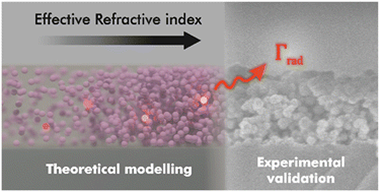
In this work, we theoretically and experimentally study the influence of the optical environment on the radiative decay rate of rare-earth transitions in luminescent nanoparticles forming a thin film. We use electric dipole sources in finite-difference time-domain simulations to analyze the effect of modifying the effective refractive index of transparent layers made of phosphor nanocrystals doped with rare earth cations, and propose a correction to previously reported analytical models for calculating the radiative decay rate. Our predictions are tested against an experimental realization of such luminescent films, in which we manage to vary the effective refractive index in a gradual and controllable manner. Our model accurately accounts for the measurements attained, allows us to discriminate the radiative and non-radiative contributions to the time-resolved photoluminescence, and provides a way to rationally tune the spontaneous decay rate and hence the photoluminescence quantum yield in an ensemble of luminescent nanoparticles.
Electrical performance of orthotropic and isotropic 3YTZP composites with graphene fillers
Lopez-Pernia, C; Muñoz-Ferreiro, C; Moriche, R; Morales-Rodriguez, A; Gallardo-Lopez, A; Poyato, R
Journal of The European Ceramic Society, 43 (2023) 1605-1612 | DOI: 10.1016/j.jeurceramsoc.2022.11.068
3 mol% yttria tetragonal zirconia polycrystal (3YTZP) composites with orthotropic or isotropic microstructures were obtained incorporating few layer graphene (FLG) or exfoliated graphene nanoplatelets (e-GNP) as fillers. Electrical conductivity was studied in a wide range of contents in two configurations: perpendicular (sigma(perpendicular to)) and parallel (sigma(//)) to the pressing axis during spark plasma sintering (SPS). Isotropic e-GNP composites presented excellent electrical conductivity for high e-GNP contents (sigma(perpendicular to)similar to 3200 S/m and sigma(//) similar to 1900 S/m for 20 vol% e-GNP), consequence of their misoriented distribution throughout the matrix. Optimum electrical performance was achieved in the highly anisotropic FLG composites, with high electrical conductivity for low contents (sigma(perpendicular to) similar to 680 S/m for 5 vol%), percolation threshold below 2.5 vol% FLG and outstanding electrical conductivity for high contents (sigma(perpendicular to) similar to 4000 S/m for 20 vol%), result of the high aspect ratio and low thickness of FLG.
Ruthenium nanoparticles stabilized by 1,2,3-triazolylidene ligands in the hydrogen isotope exchange of E-H bonds (E = B, Si, Ge, Sn) using deuterium gas
Molinillo, P; Puyo, M; Vattier, F; Lacroix, B; Rendon, N; Lara, P; Suarez, A
Nanoscale | DOI: 10.1039/d3nr02637j
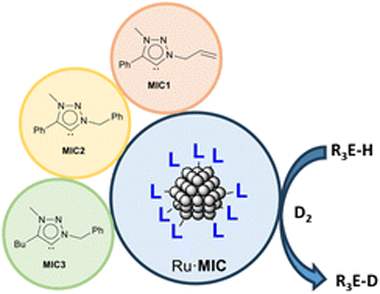
A series of ruthenium nanoparticles (Ru & BULL;MIC) stabilized with different mesoionic 1,2,3-triazolylidene (MIC) ligands were prepared by decomposition of the Ru(COD)(COT) (COD = 1,5-cyclooctadiene; COT = 1,3,5-cyclooctatriene) precursor with H-2 (3 bar) in the presence of substoichiometric amounts of the stabilizer (0.1-0.2 equiv.). Small and monodisperse nanoparticles exhibiting mean sizes between 1.1 and 1.2 nm were obtained, whose characterization was carried out by means of transmission electron microscopy (TEM), including high resolution TEM (HRTEM), inductively coupled plasma (ICP) analysis and X-ray photoelectron spectroscopy (XPS). In particular, XPS measurements confirmed the presence of MIC ligands on the surfaces of the nanoparticles. The Ru & BULL;MIC nanoparticles were used in the isotopic H/D exchange of different hydrosilanes, hydroboranes, hydrogermananes and hydrostannanes using deuterium gas under mild conditions (1.0 mol% Ru, 1 bar D-2, 55 & DEG;C). Selective labelling of the E-H (E = B, Si, Ge, Sn) bond in these derivatives, with high levels of deuterium incorporation, was observed.
Determination of the optical constants of ligand-free organic lead halide perovskite quantum dots
Rubino, A; Lozano, G; Calvo, ME; Miguez, H
Nanoscale, 15 (2023) 2553-2560 | DOI: 10.1039/d2nr05109e
Precise knowledge of the optical constants of perovskite lead halide quantum dots (QDs) is required to both understand their interaction with light and to rationally design and optimize the devices based on them. However, their determination from colloidal nanocrystal suspensions, or films made out of them, remains elusive, as a result of the difficulty in disentangling the optical constants of the organic capping ligands and those of the semiconductor itself. In this work, we extract the refractive index and extinction coefficient of ligand-free methylammonium lead iodide (MAPbI(3)) and bromide (MAPbBr(3)) nanocrystals. In order to prevent the use of organic ligands in the preparation, we follow a scaffold assisted synthetic procedure, which yields a composite film of high optical quality that can be independently and precisely characterized and modelled. In this way, the contribution of the guest nanocrystals can be successfully discriminated from that of the host matrix. Using a Kramers-Kronig consistent dispersion model along with an effective medium approximation, it is possible to derive the optical constants of the QDs by fitting the spectral dependence of light transmitted and reflected at different angles and polarizations. Our results indicate a strong dependence of the optical constants on the QD size. Small nanocrystals show remarkably large values of the extinction coefficient compared to their bulk counterparts. This analysis opens the door to the rigorous modelling of solar cells and light-emitting diodes with active layers based on perovskite QDs.
High-Performance Photocatalytic H2 Production Using a Binary Cu/ TiO2/SrTiO3 Heterojunction
Gonzalez-Tejero, M; Villachica-Llamosas, JG; Ruiz-Aguirre, A; Colon, G
ACS Applied Energy Materials, 6 (2023) 4007-4015 | DOI: 10.1021/acsaem.3c00219
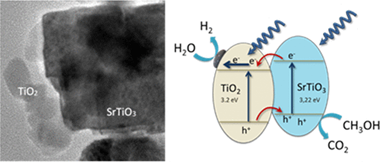
Cu/TiO2/SrTiO3 hybrid structures have been synthesized by the simple impregnation method from Cu/TiO2 and SrTiO3 systems. The structural and surface characterization stated that Cu/TiO2/SrTiO3 composites form an effective covering of SrTiO3 by Cu/TiO2. The heterostructured catalysts lead to an outstanding improved photoactivity for hydrogen production from methanol photoreforming that would be related with the efficient separation of charge pairs favored by the Cu/ TiO2/SrTiO3 heterojunction. The best photoproduction is attained for the 30 wt % SrTiO3 heterojunction showing 81.7 mmol/g H2 after 6 h (leading to an apparent quantum yield of ca 1%), 1.7 times higher than that of bare Cu/TiO2.
Cobalt Stabilization through Mesopore Confinement on TiO2 Support for Fischer-Tropsch Reaction
Platero, F; Todorova, S; Aoudjera, L; Michelin, L; Lebeau, B; Blin, JL; Holgado, JP; Caballero, A; Colón, G
ACS Applied Energy Materials, 6 (2023) 9475-9486 | DOI: 10.1021/acsaem.3c01432

Cobalt supported on mesostructured TiO2 catalysts has been prepared by a wet-impregnation method. The Co/TiO2 catalytic system showed better catalytic performance after support calcination at 380 °C. Co nanoparticles appeared well distributed along the mesopore channels of TiO2. After reduction pretreatment and reaction, a drastic structural change leads to mesopore structure collapse and the dispersion of the Co nanoparticles on the external surface. Along this complex process, Co species first form discrete nanoparticles inside the pore and then diffuse out as the pore collapses. Through this confinement, a strong metal–support interaction effect is hindered, and highly stable metal active sites lead to better performance for Fischer–Tropsch synthesis reaction toward C5+ products.
Setting a comprehensive strategy to face the runback icing phenomena
Mora, J et al.
Surface & Coatings Technology, 465 (2023) 129585 | DOI: 10.1016/j.surfcoat.2023.129585
The development of anti-icing robust surfaces is a hot topic nowadays and particularly crucial in the aeronautics or wind energy sectors as ice accretion can compromise safety and power generation efficiency. However, the current performance of most anti-icing strategies has been proven insufficient for such demanding applications, particularly in large unprotected zones, which located downstream from thermally protected areas, may undergo secondary icing. Herein, a new testing methodology is proposed to evaluate accretion mechanisms and secondary icing phenomena through, respectively, direct impact and running-wet processes and systematically applied to anti-icing materials including commercial solutions and the latest trends in the state-of-the-art. Five categories of materials (hard, elastomeric, polymeric matrix, SLIPS and superhydrophobic) with up to fifteen formulations have been tested. This Round-Robin approach provides a deeper understanding of anti-icing mechanisms revealing the strengths and weaknesses of each material. The conclusion is that there is no single passive solution for anti-ice protection. Thus, to effectively protect a given real component, different tailored materials fitted for each particular zone of the system are required. For this selection, shape analysis of such a component and the impact characteristics of water droplets under real conditions are needed as schematically illustrated for aeronautic turbines.
Surfactant-Dependent Bulk Scale Mechanochemical Synthesis of CsPbBr3 Nanocrystals for Plastic Scintillator-Based X-ray Imaging
Ghosh, J; O'Neill, J; Masteghin, MG; Braddock, I; Crean, C; Dorey, R; Salway, H; Anaya, M; Reiss, J; Wolfe, D; Sellin, P
ACS Applied Nano Materials, | DOI: 10.1021/acsanm.3c02531
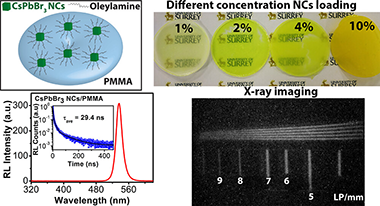
We report a facile, solvent-free surfactant-dependentmechanochemicalsynthesis of highly luminescent CsPbBr3 nanocrystals (NCs)and study their scintillation properties. A small amount of surfactantoleylamine (OAM) plays an important role in the two-step ball millingmethod to control the size and emission properties of the NCs. Thesolid-state synthesized perovskite NCs exhibit a high photoluminescencequantum yield (PLQY) of up to 88% with excellent stability. CsPbBr3 NCs capped with different amounts of surfactant were dispersedin toluene and mixed with polymethyl methacrylate (PMMA) polymer andcast into scintillator discs. With increasing concentration of OAMduring synthesis, the PL yield of CsPbBr3/PMMA nanocompositewas increased, which is attributed to reduced NC aggregation and PLquenching. We also varied the perovskite loading concentration inthe nanocomposite and studied the resulting emission properties. Themost intense PL emission was observed from the 2% perovskite-loadeddisc, while the 10% loaded disc exhibited the highest radioluminescence(RL) emission from 50 kV X-rays. The strong RL yield may be attributedto the deep penetration of X-rays into the composite, combined withthe large interaction cross-section of the X-rays with the high-Zatoms within the NCs. The nanocomposite disc shows an intense RL emissionpeak centered at 536 nm and a fast RL decay time of 29.4 ns. Further,we have demonstrated the X-ray imaging performance of a 10% CsPbBr3 NC-loaded nanocomposite disc.
Multicomponent graphene based catalysts for guaiacol upgrading in hydrothermal conditions: Exploring "H2-free" alternatives for bio-compounds hydrodeoxygenation
Parrilla-Lahoz, S; Jin, W; Pastor-Perez, L; Duyar, MS; Martinez-Quintana, L; Dongil, AB; Reina, TR
Catalysis Today, 422 (2023) 114235 | DOI: 10.1016/j.cattod.2023.01.027

Catalytic hydrodeoxygenation (HDO) is a critical technique for upgrading biomass derivatives to deoxygenated fuels or other high-value compounds. Phenol, guaiacol, anisole, p-cresol, m-cresol and vanillin are all monomeric phenolics produced from lignin. Guaiacol is often utilised as a model lignin compound to deduce mechanistic information about the bio-oil upgrading process. Typically, a source of H2 is supplied as reactant for the HDO reaction. However, the H2 supply, due to the high cost of production and additional safety precautions needed for storage and transportation, imposes significant economic infeasibilities on the HDO process's scaling up. We investigated a novel H2-free hydrodeoxygenation (HDO) reaction of guaiacol at low temperatures and pressures, using water as both a reaction medium and hydrogen source. A variety of Ni catalysts supported on zirconia/ graphene/with/without nitrogen doping were synthesised and evaluated at 250 degrees C and 300 degrees C in a batch reactor, with the goal of performing a multi-step tandem reaction including water splitting followed by HDO. The catalysts were characterised using H2-TPR, XRD, TEM and XPS to better understand the physicochemical properties and their correlation with catalytic performance of the samples in the HDO process. Indeed, our NiZr2O/Gr-n present the best activity/selectivity balance and it is deemed as a promising catalyst to conduct the H2-free HDO reaction. The catalyst reached commendable conversion levels and selectivity to mono-oxygenated compounds considering the very challenging reaction conditions. This innovative HDO approach provides a new avenue for cost-effective biomass upgrading.
Review and Perspectives of CO2 Absorption by Water- and Amine-Based Nanofluids
Yuan, CT; Wang, Y; Baena-Moreno, FM; Pan, Z; Zhang, R; Zhou, H; Zhang, Z
Energy & Fuels, 37 (2023) 8883-8901 | DOI: 10.1021/acs.energyfuels.3c00874
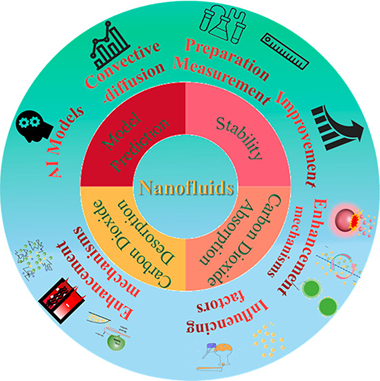
The emission of greenhouse gases, especially CO2, hasbecome a major cause of environmental degradation, and carbon capture,utilization, and storage (CCUS) is a proposed solution to mitigateits impact. Nanofluids, a relatively new method for CO2 absorption, have gained attention in recent years. This review focuseson conventional methods for preparing nanofluids along with techniquesto improve their stability and enhance the CO2 absorptionand desorption mechanisms. Additionally, the influences of factors,i.e., nanoparticle and base solution types as well as nanoparticleconcentration, on the CO2 absorption process are summarized.Furthermore, models that can predict the absorption of CO2 accurately are outlined. It is found that the types of both baseliquids and nanoparticles have an important impact on the absorptionby nanofluids. In-depth studies on the predictive capabilities ofartificial intelligence (AI) models hold immense potential in thisregard. This review also puts forth effective strategies to addressprevailing challenges. This will provide a solid theoretical basisfor this field and underscore the promising potential of nanofluidsas CO2 solvents. There are still many unexplored aspectsto be considered, such as the economic viability and energy consumptionof this technology.
Low-temperature reverse water gas-shift reaction over highly efficient Cu-hydrotalcites: Mechanistic insights on the role of malachite phase
Alvarez-Hernandez, D; Marin-Sanchez, M; Lobo-Andrades, L; Azancot, L; Bobadilla, LF; Ivanova, S; Centeno, MA
Catalysis Today, 422 (2023) 114235 | DOI: 10.1016/j.cattod.2023.114235
Carbon dioxide (CO2) transformation into valuable fuels and chemicals is in most cases a challenge far from readiness nowadays. One possible route for its conversion is the reverse water gas shift reaction (rWGS), crucial for syngas generation and required for the chemical conversion of CO2 to fuels and platform chemicals. In this paper, well organized Cu/Zn/Al structures were proposed as efficient catalysts for rWGS reaction at low tem-peratures. The results of in situ XRD revealed the formation of layered structures such malachite and hydro-talcite. The operando DRIFTS-MS studies of those structure suggests a participation of Cu2+/Cu+ pair in the reaction, promoting the redox mechanism and enhancing the activity at lower temperature. This work also provides a new strategy to design Cu-based rWGS catalysts able to prevent the sintering of active phase.
Glucose dehydration reaction over metal halides supported on activated charcoal catalysts
Martin, Gabriel Delgado; Lara, Beatriz; Bounoukta, Charf Eddine; Domínguez, María Isabel; Ammari, Fatima; Ivanova, Svetlana; Centeno, Miguel Ángel
Catalysis Today, 423 (2023) 114012 | DOI: 10.1016/j.cattod.2023.01.019
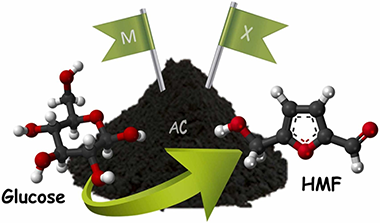
Different metal halide catalysts supported on a commercial active charcoal have been synthesized, activated, characterized and tested in glucose dehydration to 5-hydroxymethylfurfural using a biphasic water/methyl isobutyl ketone media. The influence of the cation nature (K+, Ca2+, Sr2+, Mg2+) and anion nature (F-, Cl-, Br-) on the catalytic performance of the solid is discussed in terms of glucose conversion, HMF yield and products selectivity. The activation of the impregnated catalysts results in a great diversity of active sites, such as Bronsted sites (carboxylic groups), basic sites (metal oxide), and Lewis acid site (Mn+). Their distribution within the samples determinates the resulting products and the final HMF yield.
Coal Chemistry Industry: From Production of Liquid Fuels to Fine Chemicals to Carbon Materials
Zhang, YY; Li, HT; Reina, TR; Liu, J
Energy & Fuels, (2023) | DOI: 10.1021/acs.energyfuels.3c02661
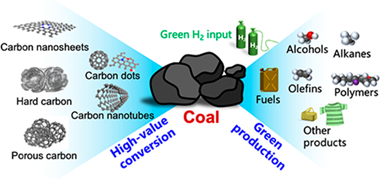
Coal resources are one of the key energy sources and essential for modern economic development. Despite the traditional coal industries having made considerable contributions to chemical production and energy storage, the accompanying environmental pollution and high energy consumption have also arisen that cause significant influence of the ecological balance. Hence, there is an urgent need to exploit feasible approaches to the sustainable utilization of coal resources. This review begins with a comprehensive summary of the representative coal chemistry technologies with critical discussions. Subsequently, a novel strategy coupled with green hydrogen is discussed for sustainable conversion of coal and highly efficient manufacture of downstream products. Moreover, the unique role of coal in terms of high-value-added carbon material production is highlighted as a low-cost resource for distinct applications. Finally, we propose several future directions for advanced coal chemistry development.
Influence of Long-Term CaO Storage Conditions on the Calcium Looping Thermochemical Reactivity
Amghar, N; Perejón, A; Ortiz, C; Maqueda, LAP; Sánchez-Jiménez, PE
Energy & Fuels, 37 (2023) 16904-16914 | DOI: 10.1021/acs.energyfuels.3c02652
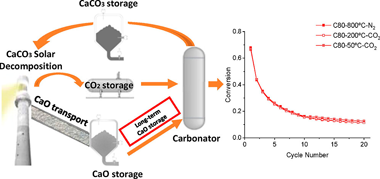
Long-term storage capability is often claimed as one of the distinct advantages of the calcium looping process as a potential thermochemical energy storage system for integration into solar power plants. However, the influence of storage conditions on the looping performance has seldom been evaluated experimentally. The storage conditions must be carefully considered as any potential carbonation at the CaO storage tank would reduce the energy released during the subsequent carbonation, thereby penalizing the round-trip efficiency. From lab-scale to conceptual process engineering, this work considers the effects of storing solids at low temperatures (50–200 °C) in a CO2 atmosphere or at high temperatures (800 °C) in N2. Experimental results show that carbonation at temperatures below 200 °C is limited; thus, the solids could be stored during long times even in CO2. It is also demonstrated at the lab scale that the multicycle performance is not substantially altered by storing the solids at low temperatures (under CO2) or high temperatures (N2 atmosphere). From an overall process perspective, keeping solids at high temperatures leads to easier heat integration, a better plant efficiency (+2–4%), and a significantly higher energy density (+40–62%) than considering low-temperature storage. The smooth difference in the overall plant efficiency with the temperature suggests a proper long-term energy storage performance if adequate energy integration is carried out.
Influence of AC fields and electrical conduction mechanisms on the flash-onset temperature: Electronic (BiFeO3) vs. ionic conductors (8YSZ)
Molina-Molina, S; Perejón, A; Pérez-Maqueda, LA; Sánchez-Jiménez, PE
Ceramics International, 49 (2023) 14834-14843 | DOI: 10.1016/j.ceramint.2022.06.242
This work aims to clarify the influence of AC (up to 50 kHz) vs DC fields on the flash-onset temperature, emphasizing the role of the electrical conduction mechanism. BiFeO3 (BFO) is used as an example of electronic conductor while 8-mol % Yttria-stabilized zirconia (8YSZ) is used as an example of ionic conductor. For 8YSZ, a frequency dependence of the flash-onset temperature and flash-induced heating is observed. This is consistent with the different contributions found in the total electrical response of 8YSZ as characterized by impedance spectroscopy measurements. Estimations based on the blackbody radiation model suggest that 8YSZ samples attain higher temperatures under AC fields due to a more efficient heating. Moreover, a noticeable decrease in the activation energy for the electrical conduction after the flash is triggered is attributed to electronic conduction. Meanwhile, the lack of frequency response and insensitiveness to the type of electrical field found in the case of BFO can be attributed to its mainly electronic bulk conduction.
Characterization, thermal and ceramic properties of clays from Alhabia (Almeria, Spain)
Rat, E; Martinez-Martinez, S; Sanchez-Garrido, JA; Perez-Vilargejo, L; Garzon, E; Sanchez-Soto, PJ
Ceramics International, 49 (2023) 14814-14825 | DOI: 10.1016/j.ceramint.2022.05.328
Clays from Alhabia (Almeria, Spain) have been investigated in this work using several analytical techniques: X-Ray Diffraction (XRD), X-Ray Fluorescence (XRF), thermal analysis (Thermogravimetry, TG, and its first deriv-ative, DTG), Scanning Electron Microscopy (SEM) and Energy Dispersive X-Ray Spectroscopy (EDS). Texture characteristics (granulometry) and plasticity have been examined. The main ceramic properties (firing shrinkage, water absorption, bulk density, open porosity, flexural strength and thermal conductivity) have been determined using pressed and fired clay samples. Thus, the mineralogical, chemical, textural and ceramic features of these clays have been evidenced for the first time. The mineralogical analysis by XRD indicated that the clay samples are constituted by a mixture of chlorite and illite, as main clay minerals, being quartz and other minerals in lower relative proportion (calcite, gypsum and hematite). This finding is important because the investigations on chlorite-illite-calcitic clays are very scarce. The chemical analysis by XRF showed that silica and alumina are predominant, as expected by the mineralogy, with medium contents of calcium oxide, from calcite, and alkalis, from illite, being-8 and-5%, respectively, besides iron and titanium oxides (-8%). The particle size analysis showed 71.76% of "clay fraction" (<2 mu m) and 21.66% of silt fraction (2-50 mu m). The plasticity index (Atterberg) was 14.3%, with acceptable moulding and extrusion properties. Thermal analysis by TG/DTG indicated a weight loss associated to dehydroxylation of structural water of the clay minerals and decarbonation of calcite by progressive heating. After the characterization of raw clays, the next step was the determination of ceramic properties of mixed and ground clays after firing using pressed bodies. For this purpose, two firing temperatures were selected (900 and 1100 degrees C) for 1 h. The examination of the resultant fired bodies indicated that porous ceramic materials (-36% open porosity and-22% of water absorption capacity) can be obtained by firing at 900 degrees C, with small variations in dimensions (<0.8% at 1100 degrees C). The porosity changed at relatively lower values by firing at 1100 degrees C (-34-35%), being associated to the presence of decomposed calcite. Bulk density was found almost constant from 900 to 1100 degrees C, with a maximum value of-1.67 g/cm3 at 1100 degrees C. Flexural strength reached a maximum value of 34.47 MPa at 1100 degrees C for the ground sample. Finally, thermal conductivity after firing the clay bodies was found almost constant at 900 and 1100 degrees C (0.457 and 0.479 W/mK, respectively). Taking into account these results, the main applications of the Alhabia clays have been evaluated. These clays can be used for the fabrication of porous ceramic supports and tiles by firing at 900 degrees C. Firing the clays at higher temperature (1100 degrees C) is of great interest for the fabrication of ceramic tiles and ceramic bricks of higher flexural strength with variable porosity and practically constant in dimensions. It is economically important although at higher processing costs. Finally, it can be emphasized that this work is a contribution of a better scientific knowledge of chlorite-illite-calcitic clays as ceramic raw materials.
Influence of firing temperature on the ceramic properties of illite-chlorite-calcitic clays
Martinez-Martinez, S; Perez-Vilarejo, L; Garzon, E; Sanchez-Soto, PJ
Ceramics International, 49 (2023) 24541-24557 | DOI: 10.1016/j.ceramint.2022.11.077
The influence of firing temperature on the ceramic properties of illite-chlorite-calcitic clays has been investigated. Three samples of the same clay deposit have been selected. Weight loss, dimensional changes, water absorption, bulk density, open porosity, flexural and compressive strengths, initial capillary water absorption rate and thermal conductivity have been determined as a function of firing temperature in the range 900-1200 degrees C with 1 h of soaking time. The microstructures of the fired samples have been examined by SEM and the phase evolution studied by XRD. The water absorption capacity decreased from similar to 22% at 900 degrees C/1 h to a maximum of 12% at 1200 degrees C/1 h with a maximum linear shrinkage of similar to 2.7%. The open porosities decreased from similar to 22% at 900 degrees C/1 h up to similar to 20% at 1200 degrees C/1 h as an effect of progressive sintering with higher densification degree of the ceramic bodies. The flexural strength reached a maximum value of similar to 34 MPa at 1200 degrees C/1 h. In contrast, the compressive strengths increased by firing up to a maximum of similar to 114 MPa at 1200 degrees C/1 h. The thermal conductivity increased slightly as increasing firing temperature with a maximum value of 0.582 W/m.K in samples fired at 1200 degrees C/1 h. The Ryshkevitch-Duckworth equation was applied and the results indicated that compressive strength is related linearly with open porosity. A linear correlation was found between thermal conductivity and open porosity. The microstructural evolution by SEM indicated that there is a change of the fired samples at 1100 degrees C as compared to SEM observations at 900 and 1000 degrees C. There is an increase of contacts between particles and layered structures associated to dehydroxylated clay minerals (illite and chlorite), quartz particles and pores developed by firing. At 1200 degrees C/1 h, the microstructures have changed associated to the higher degree of vitrification in the fired sample, with consolidation of the material, interparticle and neck contacts with formation of vitrified bridges. The formation of closed and large open pores of several sizes has been achieved by firing. Small particles were observed as a fine precipitation of crystals in the vitrified structures associated to anorthite, hematite and quartz relicts. This change in microstructure allowed deduce that the compressive strength increased upon firing, with maximum values of this ceramic property at 1200 degrees C. The ceramic bodies were more sintered by firing and the open porosity decreased progressively. Brickmaking is the main application of these fired illite-chlorite calcitic clays. These clays fired at 900-1100 degrees C, with 1 h of soaking time, could be applied in the fabrication of clay roofing tiles, tiles and even porous ceramic supports with small variations on shrinkage and porosity, good flexural strengths and high compressive strengths. Samples fired at higher temperatures, 1100 degrees C/1 h, could be applied as ceramic bricks showing a medium porosity (similar to 20%). They show almost the same bulk density when they are fired at lower temperatures (900 degrees C). Samples fired at higher temperatures (1150-1200 degrees C/1 h) could be applied as dark ceramic products. This investigation was interesting because a better knowledge of illite-chlorite-calcitic clays applied as ceramic raw materials has been achieved.
Mn2+-doped MgGeO3 nanophosphors with controlled shape and optimized persistent luminescence
González-Mancebo, D; Arroyo, E; Becerro, AI; Ocaña, M
Ceramics International, 49 (2023) 36791-36799 | DOI: 10.1016/j.ceramint.2023.09.008
Mn2+-doped MgGeO3 (MgGeO3:Mn2+) is an efficient persistent phosphor that emits red luminescence for long time after stopping excitation with UV light. For optical and biotechnological uses a precise control of particle size and shape is highly desired since these parameters may have a strong influence on the properties and suitability of phosphor materials for the intended applications. To the best of our knowledge, MgGeO3:Mn2+ has been synthesized by conventional solid-state-reaction, which yields particles of heterogeneous size and shape. Here, we report for the first time in the literature a salt-assisted method for the synthesis of MgGeO3:Mn2+ nanoparticles with uniform shape (nanorods) and a mean size of 350 nm x 99 nm. The rigorous study of the luminescence properties of the MgGeO3:Mn2+ nanorods revealed that whereas the optimum doping level for photoluminescence was 2.0 mol% Mn2+, the best persistent luminescence was attained with just 0.5 mol% Mn2+, which is ascribed to the different mechanisms of both luminescence processes. The optimum persistent nano-phosphor showed an intense red emission, which persisted at least 17 h after stopping the excitation. Such excellent properties make the developed nanophosphor an attractive candidate for use in optical and biotech-nological applications.
Improved stability of design clay minerals at high temperature: A comparison study with natural ones
Osuna, FJ; Chaparro, JR; Pavon, E; Alba, MD
Ceramics International, 49 (2023) 5279-5291 | DOI: 10.1016/j.ceramint.2022.10.046
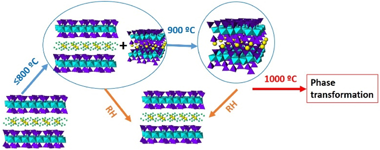
Clay minerals are ceramics materials that are involved in a wide range of economic uses. But, their structure and composition are modified by heating and, consequently, compromise their final applications. The actual tem-peratures at which changes occur vary greatly from one group to another group and even for different specimens within a given group. The aim of this research has been to evaluate the thermal behaviour of a set of design swelling micas, Na-Mica -n (Mn) and compare them with a set of natural smectites. All samples were heated in the range 200 degrees C to 1000 degrees C; afterwards, they were rehydrated thorough water suspension (0.4% wt). The results have shown that swelling micas have better property of hydration/dehydration than natural clay minerals and those with higher layer charge exhibited higher rehydration ability and dehydration temperature.
Effect of zeolite topological structure in bifunctional catalyst on direct conversion of syngas to light olefins
Meng, FH; Gong, ZY; Yang, LL; Wang, Q; Xing, MQ; Nawaz, MA; Li, Z
Microporous and Mesoporous Materials, 362 (2023) 112792 | DOI: 10.1016/j.micromeso.2023.112792
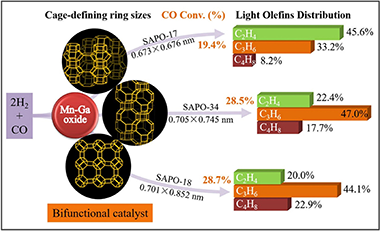
Bifunctional catalyst composed of metal oxide and zeolite (OX-ZEO) is a promising strategy for the direct conversion of syngas to light olefins (STO), where the structure of zeolite plays a vital role in determining the selectivity of product. Herein, three kinds of silicoaluminophosphate zeolites with different topological structures, i.e., the ERI(SP17), AEI(SP18) and CHA(SP34), were hydrothermally synthesized, after the combination with Mn-Ga oxide, the prepared OX-ZEO was applied for STO reaction. The variation in the crystallization time for SP17 synthesis has a great impact on the generation of impurity phase of SAPO-5, where a crystallization time of 48-96 h is found to be beneficial in synthesizing SP17 zeolite with pure phase. SP17 zeolite with a crystallization time of 96 h, possesses the micropores and columnar morphology, where the small cage-defining 8-ring size of SP17 shows the olefins selectivity of 87.0% at a low CO conversion of 19.4%, significantly deviating towards the major fraction of ethylene (45.6%) than that of butene (8.2%). In a contrast, SP18 and SP34 zeolites with the same and large cage-defining 8-ring size, are richer in propylene and butene fractions than that of ethylene in overall similar olefins selectivity of 87.0% and 87.1% at CO conversion of 28.7% and 28.5%, respectively. Interestingly, it is further interpreted that the SP17 sample generated more carbon species during the reaction due to the small 8-ring size, while those amounts of carbon species were restricted in the hierarchical pore structure and plate-like morphology in SP18 and SP34 samples.
Flexible NiRu Systems for CO2 Methanation: From Efficient Catalysts to Advanced Dual-Function Materials
Merkouri, LP; Martin-Espejo, JL; Bobadilla, LF; Odriozola, JA; Duyar, MS; Reina, TR
Nanomaterials, 13 (2023) 506 | DOI: 10.3390/nano13030506
CO2 emissions in the atmosphere have been increasing rapidly in recent years, causing global warming. CO2 methanation reaction is deemed to be a way to combat these emissions by converting CO2 into synthetic natural gas, i.e., CH4. NiRu/CeAl and NiRu/CeZr both demonstrated favourable activity for CO2 methanation, with NiRu/CeAl approaching equilibrium conversion at 350 degrees C with 100% CH4 selectivity. Its stability under high space velocity (400 L center dot g(-1)center dot h(-1)) was also commendable. By adding an adsorbent, potassium, the CO2 adsorption capability of NiRu/CeAl was boosted, allowing it to function as a dual-function material (DFM) for integrated CO2 capture and utilisation, producing 0.264 mol of CH4/kg of sample from captured CO2. Furthermore, time-resolved operando DRIFTS-MS measurements were performed to gain insights into the process mechanism. The obtained results demonstrate that CO2 was captured on basic sites and was also dissociated on metallic sites in such a way that during the reduction step, methane was produced by two different pathways. This study reveals that by adding an adsorbent to the formulation of an effective NiRu methanation catalyst, advanced dual-function materials can be designed.
Facile Synthesis of Heterogeneous Indium Nanoparticles for Formate Production via CO2 Electroreduction
Perez-Sequera, AC; Diaz-Perez, MA; Angulo, MAL; Holgado, JP; Serrano-Ruiz, JC
Nanomaterials, 13 (2023) 3052 | DOI: 10.3390/nano13081304
In this study, a simple and scalable method to obtain heterogeneous indium nanoparticles and carbon-supported indium nanoparticles under mild conditions is described. Physicochemical characterization by X-ray diffraction (XRD), X-ray photoelectron microscopy (XPS), scanning electron microscopy (SEM) and transmission electron microscopy (TEM) revealed heterogeneous morphologies for the In nanoparticles in all cases. Apart from In-0, XPS revealed the presence of oxidized In species on the carbon-supported samples, whereas these species were not observed for the unsupported samples. The best-in-class catalyst (In-50/C-50) exhibited a high formate Faradaic efficiency (FE) near the unit (above 97%) at -1.6 V vs. Ag/AgCl, achieving a stable current density around -10 mA center dot cm(geo)(-2), in a common H-cell. While In-0 sites are the main active sites for the reaction, the presence of oxidized In species could play a role in the improved performance of the supported samples.
Advanced Cellulose-Nanocarbon Composite Films for High-Performance Triboelectric and Piezoelectric Nanogenerators
Gonzalez, J; Ghaffarinejad, A; Ivanov, M; Ferreira, P; Vilarinho, PM; Borras, A; Amorin, H; Wicklein, B
Nanomaterials, 13 (2023) 1206 | DOI: 10.3390/nano13071206
Natural polymers such as cellulose have interesting tribo- and piezoelectric properties for paper-based energy harvesters, but their low performance in providing sufficient output power is still an impediment to a wider deployment for IoT and other low-power applications. In this study, different types of celluloses were combined with nanosized carbon fillers to investigate their effect on the enhancement of the electrical properties in the final nanogenerator devices. Cellulose pulp (CP), microcrystalline cellulose (MCC) and cellulose nanofibers (CNFs) were blended with carbon black (CB), carbon nanotubes (CNTs) and graphene nanoplatelets (GNPs). The microstructure of the nanocomposite films was characterized by scanning electron and probe microscopies, and the electrical properties were measured macroscopically and at the local scale by piezoresponse force microscopy. The highest generated output voltage in triboelectric mode was obtained from MCC films with CNTs and CB, while the highest piezoelectric voltage was produced in CNF-CNT films. The obtained electrical responses were discussed in relation to the material properties. Analysis of the microscopic response shows that pulp has a higher local piezoelectric d(33) coefficient (145 pC/N) than CNF (14 pC/N), while the macroscopic response is greatly influenced by the excitation mode and the effective orientation of the crystals relative to the mechanical stress. The increased electricity produced from cellulose nanocomposites may lead to more efficient and biodegradable nanogenerators.
Functionalized Biochars as Supports for Ru/C Catalysts: Tunable and Efficient Materials for γ-Valerolactone Production
Bounoukta, CE; Megias-Sayago, C; Navarro, JC; Ammari, F; Ivanova, S; Centeno, MA
Nanomaterials, 13 (2023) 1129 | DOI: 10.3390/nano13061129
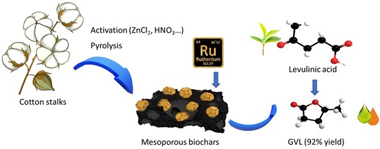
Cotton stalks-based biochars were prepared and used to synthetize Ru-supported catalysts for selective production of gamma-valerolactone from levulinic acid in aqueous media. Different biochars' pre-treatments (HNO3, ZnCl2, CO2 or a combination of them) were carried out to activate the final carbonaceous support. Nitric acid treatment resulted in microporous biochars with high surface area, whereas the chemical activation with ZnCl2 substantially increases the mesoporous surface. The combination of both treatments led to a support with exceptional textural properties allowing the preparation of Ru/C catalyst with 1422 m(2)/g surface area, 1210 m(2)/g of it being a mesoporous surface. The impact of the biochars' pre-treatments on the catalytic performance of Ru-based catalysts is fully discussed.
Highly dispersed Rh single atoms over graphitic carbon nitride as a robust catalyst for the hydroformylation reaction
Jurado, L; Esvan, J; Luque-Alvarez, LA; Bobadilla, LF; Odriozola, JA; Posada-Perez, S; Poater, A; Comas-Vives, A; Axet, MR
Catalysis Science & Tecnology, 13 (2022) 1425-1436 | DOI: 10.1039/d2cy02094g
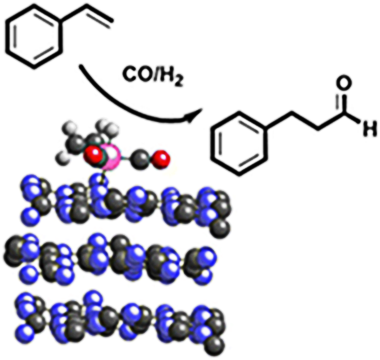
Rhodium-catalysed hydroformylation, effective tool in bulk and fine-chemical synthesis, predominantly uses soluble metal complexes. For that reason, the metal leaching and the catalyst recycling are still the major drawbacks of this process. Single-atom catalysts have emerged as a powerful tool to combine the advantages of both homogeneous and heterogeneous catalysts. Since using an appropriate support material is key to create stable, finely dispersed, single-atom catalysts, here we show that Rh atoms anchored on graphitic carbon nitride are robust catalysts for the hydroformylation reaction of styrene.
Collective plasmonic resonances enhance the photoluminescence of rare-earth nanocrystal films processed by ultrafast annealing
Cabello-Olmo, E; Higashino, M; Murai, S; Tanaka, K; Lozano, G; Miguez, H
Chemical Communications, 59 (2023) 1289-1292 | DOI: 10.1039/d2cc04779a
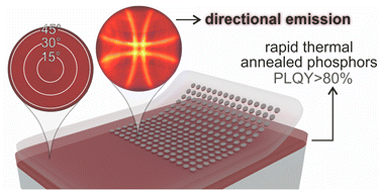
Herein, we demonstrate that rapid thermal annealing allows achieving close-to-one photoluminescence quantum yield while preserving the transparency of rare-earth nanocrystal films, which further enables their integration with nanophotonics. The combination with periodic arrays of aluminum nanodisks that support collective plasmonic resonances leads to enhanced directional emission.
Analysis of Dry Reforming as direct route for gas phase CO2 conversion. The past, the present and future of catalytic DRM technologies
le Sache, E; Reina, TR
Progress in Energy and Combustion Science, 89 (2022) 100970 | DOI: 10.1016/j.pecs.2021.100970
Transition to low carbon societies requires advanced catalysis and reaction engineering to pursue green routes for fuels and chemicals production as well as CO2 conversion. This comprehensive review provides a fresh perspective on the dry reforming of methane reaction (DRM) which constitutes a straightforward approach for effective CO2 conversion to added value syngas. The bottleneck for the implementation of this process at industrial scale is the development of highly active and robust heterogeneous catalysts able to overcome the CO2 activation barrier and deliver sufficient amount of the upgrading products at the desired operation conditions. Also, its high energy demand due to the endothermic nature of the reaction imposes extra difficulties. This review critically discusses the recent progresses on catalysts design ranging from traditional metal-supported catalysts to advanced structured and nanostructured systems with promising performance. The main advantages and culprits of the different catalytic systems are introduced aiming to inspire the catalysis community to further refine these formulations towards the development of "supercatalysts" for DRM. Besides the design of increasingly complex catalyst morphologies as well as other promising alternatives aiming at reducing the energy consumption of the process or tackle deactivation through reactor design are introduced.
Highly Anisotropic Organometal Halide Perovskite Nanowalls Grown by Glancing-Angle Deposition
Castillo-Seoane, J; Contreras-Bernal, L; Obrero-Perez, JM; Garcia-Casas, X; Lorenzo-Lazaro, F; Aparicio, FJ; Lopez-Santos, C; Rojas, TC; Anta, JA; Borras, A; Barranco, A; Sanchez-Valencia, JR
Advanced Materials (2022) 2107739 | DOI: 10.1002/adma.202107739
Polarizers are ubiquitous components in current optoelectronic devices as displays or photographic cameras. Yet, control over light polarization is an unsolved challenge, since the main drawback of the existing display technologies is the significant optical losses. In such a context, organometal halide perovskites (OMHP) can play a decisive role given their flexible synthesis with tunable optical properties such as bandgap and photoluminescence, and excellent light emission with a low non-radiative recombination rate. Therefore, along with their outstanding electrical properties have elevated hybrid perovskites as the material of choice in photovoltaics and optoelectronics. Among the different OMHP nanostructures, nanowires and nanorods have lately arisen as key players in the control of light polarization for lighting or detector applications. Herein, the fabrication of highly aligned and anisotropic methylammonium lead iodide perovskite nanowalls by glancing-angle deposition, which is compatible with most substrates, is presented. Their high alignment degree provides the samples with anisotropic optical properties such as light absorption and photoluminescence. Furthermore, their implementation in photovoltaic devices provides them with a polarization-sensitive response. This facile vacuum-based approach embodies a milestone in the development of last-generation polarization-sensitive perovskite-based optoelectronic devices such as lighting appliances or self-powered photodetectors.
Ultrathin Plasma Polymer Passivation of Perovskite Solar Cells for Improved Stability and Reproducibility
Obrero-Perez, JM; Contreras-Bernal, L; Nuñez-Galvez, F; Castillo-Seoane, J; Valadez-Villalobos, K; Aparicio, FJ; Anta, JA; Borras, A; Sanchez-Valencia, JR; Barranco, A
Advanced Energy Materials, (2022) 2200812 | DOI: 10.1002/aenm.202200812
Despite the youthfulness of hybrid halide perovskite solar cells, their efficiencies are currently comparable to commercial silicon and have surpassed quantum-dots solar cells. Yet, the scalability of these devices is a challenge due to their low reproducibility and stability under environmental conditions. However, the techniques reported to date to tackle such issues recurrently involve the use of solvent methods that would further complicate their transfer to industry. Herein a reliable alternative relaying in the implementation of an ultrathin plasma polymer as a passivation interface between the electron transport layer and the hybrid perovskite layer is presented. Such a nanoengineered interface provides solar devices with increased long-term stability under ambient conditions. Thus, without involving any additional encapsulation step, the cells retain more than 80% of their efficiency after being exposed to the ambient atmosphere for more than 1000 h. Moreover, this plasma polymer passivation strategy significantly improves the coverage of the mesoporous scaffold by the perovskite layer, providing the solar cells with enhanced performance, with a champion efficiency of 19.2%, a remarkable value for Li-free standard mesoporous n-i-p architectures, as well as significantly improved reproducibility.
Characterization of Re-Mo/ZSM-5 catalysts: How Re improves the performance of Mo in the methane dehydroaromatization reaction
Lopez-Martin, A; Sini, MF; Cutrufello, MG; Caballero, A; Colon, G
Applied Catalysis B-Environmental, 304 (2022) 120960 | DOI: 10.1016/j.apcatb.2021.120960
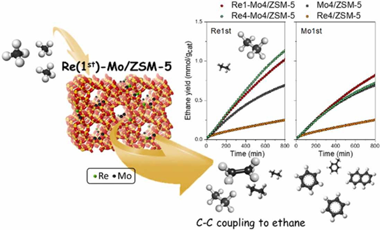
In this study, the promoting effect of rhenium addition as a co-dopant on Mo/ZSM-5 catalysts system has been analysed. Hence, bimetallic (Re-Mo/ZSM-5) catalysts have been synthesized using a sequential impregnation methodology. The catalytic performance for direct aromatization of methane reaction has been determined and correlated with their physical and chemical state combining multiple characterization techniques. An important synergy between Mo and Re, affected by the sequential impregnation, has been observed. Thus, Re1-Mo4/ZSM-5 in which Re has been incorporated first shows notably higher aromatic yields and stability against deactivation. Characterization results suggest that catalytic enhancement is due to the important effect of Re presence in close interaction with Mo. Improved evolution of ethane through C-C coupling would be correlated to this catalytic performance. As we discuss, Mo nature and location in the bimetallic systems are strongly conditioned by Re and the impregnation sequence and favours such intermediate step.
Evidence of new Ni-O-K catalytic sites with superior stability for methane dry reforming
Azancot, L; Blay, V; Blay-Roger, R; Bobadilla, LF; Penkova, A; Centeno, MA; Odriozola, JA
Applied Catalysis B-Environmental, 307 (2022) 121148 | DOI: 10.1016/j.apcatb.2022.121148
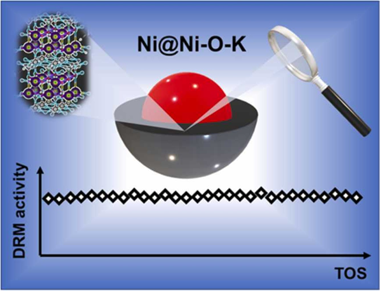
Liquid fuels produced via Fischer-Tropsch synthesis from biomass-derived syngas constitute an attractive and sustainable energy vector for the transportation sector. This study focuses on the role of potassium as a promoter in Ni-based catalysts for reducing coke deposition during catalytic dry reforming. The study provides a new structural link between catalytic performance and physicochemical properties. We identify new Ni-O-K chemical states associated with high stability in the reforming process, evidenced by different characterization techniques. The nickel particles form a core surrounded by a Ni-O-K phase layer (Ni@Ni-O-K) during the reduction of the catalyst. This phase likely presents an alkali-nickelate-type structure, in which nickel is stabilized in oxidation state + 3. The Ni-O-K formation induces essential changes in the electronic, physical, structural, and morphological properties of the catalysts, notably enhancing their long-term stability in dry reforming. This work thus provides new directions for designing more efficient catalysts for sustainable gas-to-liquids processes.
Unraveling the Mo/HZSM-5 reduction pre-treatment effect on methane dehydroaromatization reaction
Lopez-Martin, A; Caballero, A; Colon, G
Applied Catalysis B-Environmental, 312 (2022) 121382 | DOI: 10.1016/j.apcatb.2022.121382
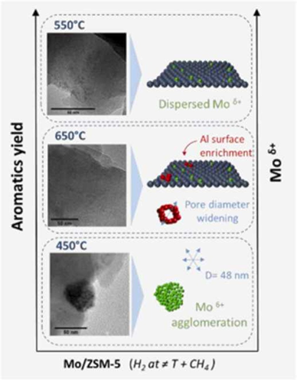
Reduction pre-treatment at different temperatures were performed over Mo/HZSM-5 system before methane dehydroaromatiztion reaction. We have shown the crucial effect of reduction temperature on the final catalytic performance. Outstanding improvement in the aromatics conversion has been attained. Thus, H-2 formation form methane cracking reaction seems to be hindered for pre-treated catalysts. As a consequence, the deposition of coke in these samples appeared also notably suppressed. The optimum performance has been achieved for reduction pre-treatment at 550 degrees C. For this temperature, we have observed that the fraction of reduced Mo species is higher.
Plasma engineering of microstructured piezo-Triboelectric hybrid nanogenerators for wide bandwidth vibration energy harvesting
Garcia-Casas, X; Ghaffarinehad, A; Aparicio, FJ; Castillo-Seoane, J; Lopez-Santos, C; Espinos, JP; Cotrino, J; Sanchez-Valencia, JR; Barranco, A; Borras, A
Nano Energy, 91 (2022) 106673 | DOI: 10.1016/j.nanoen.2021.106673
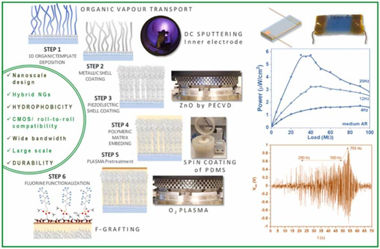
We introduce herein the advanced application of low-pressure plasma procedures for the development of piezo and triboelectric mode I hybrid nanogenerators. Thus, plasma assisted deposition and functionalization methods are presented as key enabling technologies for the nanoscale design of ZnO polycrystalline shells, the formation of conducting metallic cores in core@shell nanowires, and for the solventless surface modification of polymeric coatings and matrixes. We show how the perfluorinated chains grafting of polydimethylsiloxane (PDMS) provides a reliable approach to increase the hydrophobicity and surface charges at the same time that keeping the PDMS mechanical properties. In this way, we produce efficient Ag/ZnO convoluted piezoelectric nanogenerators supported on flexible substrates and embedded in PDMS compatible with a contact-separation triboelectric architecture. Factors like crystalline texture, ZnO thickness, nanowires aspect ratio, and surface chemical modification of the PDMS are explored to optimize the power output of the nanogenerators aimed for harvesting from low-frequency vibrations. Just by manual triggering, the hybrid device can charge a capacitor to switch on an array of color LEDs. Outstandingly, this simple three-layer architecture allows for harvesting vibration energy in a wide bandwidth, thus, we show the performance characteristics for frequencies between 1 Hz and 50 Hz and demonstrate the successful activation of the system up to ca. 800 Hz.
Electrocatalytic CO2 conversion to C-2 products: Catalysts design, market perspectives and techno-economic aspects
Ruiz-López, E; Gandara-Loe, J; Baena-Moreno, F; Reina, TR; Odriozola, JA
Renewable & Sustainable Energy Reviews, 161 (2022) 112329 | DOI: 10.1016/j.rser.2022.112329
The energy crisis caused by the incessant growth in global energy demand joint to its associated greenhouse emissions motivates the urgent need to control and mitigate atmospheric CO2 levels. Leveraging CO2 as carbon pool to produce value-added products represents a cornerstone of the circular economy. Among the CO2 utilization strategies, electrochemical reduction of CO2 conversion to produce fuels and chemicals is booming due to its versatility and end-product flexibility. Herein most of the studies focused on C-1 products although C-2 and C2+ compounds are chemically and economically more appealing targets requiring advanced catalytic materials. Still, despite the complex pathways for C2+ products formation, their multiple and assorted applications have motivated the search of suitable electrocatalysts. In this review, we gather and analyse in a comprehensive manner the progress made regarding C2+ products considering not only the catalyst design and the electrochemistry features but also techno-economic aspects in order to envisage the most profitable scenarios. This state-of-the-art analysis showcases that electrochemical reduction of CO2 to C-2 products will play a key role in the decarbonisation of the chemical industry paving the way towards a low-carbon future.
Albero: An alternative natural material for solar energy storage by the calcium-looping process
Moreno, V; Arcenegui-Troya, J; Sanchez-Jimenez, P; Perejon, A; Chacartegui, R; Valverde, JM; Perez-Maqueda, LA
Chemical Engineering Journal, 440 (2022) 135707 | DOI: 10.1016/j.cej.2022.135707
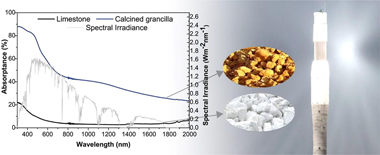
Large-scale thermochemical energy storage (TCES) is gaining relevance as an alternative to current thermal energy storage systems in Concentrated Solar Power plants. Among the different systems, the reversible reaction between CaO and CO2 stands out due to the wide availability and low cost of the raw material: limestone. Direct solar absorption of the storage media would improve the efficiency of solar-to-thermal energy storage due to reduced thermal transfer barriers, but the solar optical absorption of CaCO3 is poor. In this work, we propose the use of a Ca-rich calcarenite sedimentary rock so-called albem as an alternative to limestone. We demonstrate that this reddish material exhibits an average solar absorptance that is approximately ten times larger than limestone. Moreover, the multicycle carbonation/calcination performance under different experimental conditions has been studied by thermogravimetry, and similar values to those exhibited for limestone have been obtained. Besides, the material is cheap (6 Elton), and simulations showed that the use of this material would significantly improve the overall CaL-CSP efficiency at the industrial level.
Ionomer-Free Nickel-Iron bimetallic electrodes for efficient anion exchange membrane water electrolysis
Lopez-Fernandez, E; Gomez-Sacedon, C; Gil-Rostra, J; Espinos, JP; Gonzalez-Elipe, AR; Yubero, F; De Lucas-Consuegra, A
Chemical Engineering Journal, 433 (2022) 133774 | DOI: 10.1016/j.cej.2021.133774
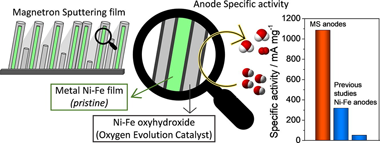
A bottleneck for the deployment of the Anion Exchange Membrane Water Electrolysis (AEMWE) is the manufacturing of efficient and long lasting anodes and cathodes for the cells. Highly performant bimetallic Ni/Fe catalyst films with various atomic ratios have been prepared by magnetron sputtering in an oblique angle configuration (MS-OAD) and used as anodes for AEMWE. Electrocatalytic experiments in a small three-electrode cell and a thorough analysis of the electrode properties with various physico-chemical characterization tech-niques have been used to select the nanostructured anode catalyst which, depicting an optimized Ni/Fe ratio, presents the maximum activity for the oxygen evolution reaction. These anode layers are then scale-up for their integration in an AEMWE cell where the influence of assembly conditions and the effect of adding an ionomer to the anodes have been studied. The obtained results have demonstrated the outstanding properties of the fabri-cated bimetallic films in terms of activity, stability, and operation under ionomer-free conditions. Current density values around 400 and 600 mA cm(-2) at 40??& nbsp;and 60 C (2.0 V), respectively, much higher than those obtained with pure Ni, were obtained with an optimized membrane electrode assembly. The high yield obtained with these electrodes gains further relevance when considering that the current yield per unit mass of the anodic active phase catalyst (i.e., 1086 mA mg(-1) at 2.0 V and 40??) is the highest among equivalent values reported in literature. The possibilities and prospects of the use of bimetallic catalyst films prepared by MS-OAD for AEMWE are discussed.
Shepherding reaction intermediates to optimize H-2 yield using composite-doped TiO2-based photocatalysts
Barba-Nieto, I.; Colon, G; Fernández-García, M; Kubacka, A
Chemical Engineering Journal, 442 (2022) 136333 | DOI: 10.1016/j.cej.2022.136333
Optimization of Pt-promoted TiO2-based is key to promote the photocatalytic production of hydrogen using sacrificial alcohol molecules. Combination of doping and surface decoration of the mentioned base photoactive material is here exploited to maximize hydrogen yield. Using the quantum efficiency parameter, it is shown that the resulting composite system can boost activity up to 7.3 times within the whole methanol:water mixture ratio, yielding quantum efficiencies in the ca. 13-16 % range. The key role of the different components in generating charge carrier species and their use to trigger the sacrificial molecule evolution and control reaction kinetics are examined through an in-situ spectroscopic study. The study unveils the complex reaction mechanism, with generation of C1 to C3 molecules from different carbon-containing radicals, and interprets the physical origin of the huge H2 production enhancement occurring in doped-composite titania-based catalysts.
Plasma assisted CO2 dissociation in pure and gas mixture streams with a ferroelectric packed-bed reactor in ambient conditions
Navascues, P; Cotrino, J; Gonzalez-Elipe, AR; Gomez-Ramirez, A
Chemical Engineering Journal, 430 (2022) 133066 | DOI: 10.1016/j.cej.2021.133066
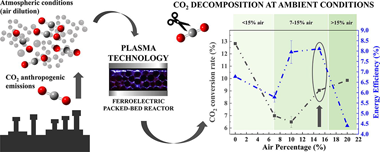
Carbon dioxide decomposition is a challenging target to combat climate change. Nonthermal plasmas are advantageous for this purpose because they operate at ambient conditions and can be easily scaled-up. In this study, we attempt the CO2 splitting into CO and O-2 in a parallel plate packed-bed plasma reactor moderated with Lead Zirconate Titanate (PZT) as fermelectric component, achieving conversion rates and energy efficiencies higher than those obtained with BaTiO3 in our experimental device. The analysis of the reaction mechanisms with optical emission spectroscopy under various operating conditions has shown a direct correlation between energy efficiency and intensity of CO* emission bands. These results and those obtained with a LiNbO3 plate placed onto the active electrode suggest that high temperature electrons contribute to the splitting of CO2 through an enhancement in the formation of CO2+ intermediate species. Results obtained for CO2 + O-2 mixtures confirm this view and suggest that back recombination processes involving CO and O-2 may reduce the overall splitting efficiency. The study of mixtures of CO2 and dry air has proved the capacity of fermelectric packed-bed reactors to efficiently decompose CO2 with no formation of harmful NxOy subproducts in conditions close to those in real facilities. The found enhancement in energy efficiency with respect to that found for the pure gas decomposition supports that new reaction pathways involving nitrogen molecules are contributing to the dissociation reaction. We conclude that PZT moderated packed-bed plasma reactors is an optimum alternative for the decompositon of CO2 in real gas flows and ambient conditions.
Au and Pt Remain Unoxidized on a CeO2-Based Catalyst during the Water-Gas Shift Reaction
Reina, TR; Gonzalez-Castano, M; Lopez-Flores, V; Martinez, LMT; Zitolo, A; Ivanova, S; Xu, WQ; Centeno, MA; Rodriguez, JA; Odriozola, JA
Journal of the American Chemical Society, 144 (2022) 446-453 | DOI: 10.1021/jacs.1c10481
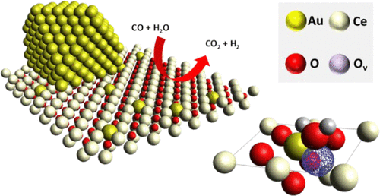
The active forms of Au and Pt in CeO2-based catalysts for the water-gas shift (WGS) reaction are an issue that remains unclear, although it has been widely studied. On one hand, ionic species might be responsible for weakening the Ce-O bonds, thus increasing the oxygen mobility and WGS activity. On the other hand, the close contact of Au or Pt atoms with CeO2 oxygen vacancies at the metal-CeO2 interface might provide the active sites for an efficient reaction. In this work, using in situ X-ray absorption spectroscopy, we demonstrate that both Au and Pt remain unoxidized during the reaction. Remarkable differences involving the dynamics established by both species under WGS atmospheres were recognized. For the prereduced Pt catalyst, the increase of the conversion coincided with a restructuration of the Pt atoms into cuboctahedrical metallic particles without significant variations on the overall particle size. Contrary to the relatively static behavior of Pt-0, Au-0 nanoparticles exhibited a sequence of particle splitting and agglomeration while maintaining a zero oxidation state despite not being located in a metallic environment during the process. High WGS activity was obtained when Au atoms were surrounded by oxygen. The fact that Au preserves its unoxidized state indicates that the chemical interaction between Au and oxygen must be necessarily electrostatic and that such an electrostatic interaction is fundamental for a top performance in the WGS process.
Photocatalytic oxidation of pollutants in gas-phase via Ag3PO4-based semiconductor photocatalysts: Recent progress, new trends, and future perspectives
Y. Naciri; A. Hsini; A. Bouziani; R. Djellabi; Z. Ajmal; M. Laabd; J.A. Navío; A. Mills; C.L. Bianchi; H.Li; B. Bakiz; A. Albourine
Critical Reviews in Environmental Science and Technology, 52 (2022) 2339-2382 | DOI: 10.1080/10643389.2021.1877977
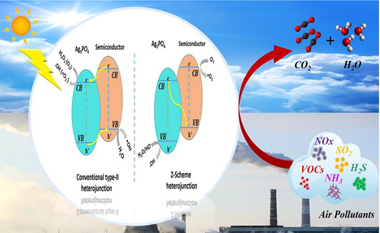
Air pollution has become a significant challenge for both developing and developed nations. due to its close association with numerous fatal diseases such as cancer, respiratory, heart attack, and brain stroke. Over recent years, heterogeneous semiconductor photocatalysis has emerged as an effective approach to air remediation due to the ease of scale-up, ready application in the field, use of solar light and ready availability of a number of different effective photocatalysts. To date, most work in this area has been conducted using UV-absorbing photocatalysts, such as TiO2 and ZnO; However, recent studies have revealed Ag3PO4 as an attractive, visible-light-absorbing alternative, with a bandgap of 2.43 eV. In particular, this material has been shown to be an excellent photocatalyst for the removal of many types of pollutants in the gas phase. However, the widespread application of Ag3PO4 is restricted due to its tendency to undergo photoanodic corrosion and the poor reducing power of its photogenerated conductance band electrons, which are unable to reduce O2 to superoxide •O2 −. These limitations are critically evaluated in this review. In addition, recent studies on the modification of Ag3PO4 via combination with the conventional heterojunctions or Z-scheme junctions, as well as the photocatalytic mechanistic pathways for enhanced gas-pollutants removal, are summarized and discussed. Finally, an overview is given on the future developments that are required in order to overcome these challenges and so stimulate further research into this promising field.
Iron-catalyzed graphitization for the synthesis of nanostructured graphitic carbons
Hunter, RD; Ramirez-Rico, J; Schnepp, Z
Journal of Materials Chemistry A, 10 (2022) 4489-4516 | DOI: 10.1039/d1ta09654k
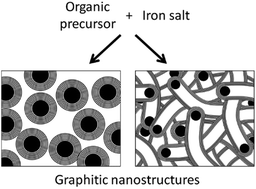
Carbons are versatile and diverse materials that have numerous applications across energy and environmental sciences. Carbons with a graphitic structure are particularly appealing due to their high chemical stability, large surface areas and high thermal and electronic conductivity. Numerous methods exist to produce nanostructured graphitic carbons but some of these can be energy-intensive and/or have problems with scalability. One option that is being increasingly explored is the process of iron-catalyzed graphitization. This simply involves the pyrolysis of carbon-rich precursors in the presence of an iron catalyst and has been used to produce carbons with a wide range of structures and properties. This review will examine the current field of iron-catalyzed graphitization, with a focus on molecular organic or biomass precursors. Bio-derived precursors are particularly attractive as a potential option for sustainable production of graphitic carbons. We start with a brief introduction to some key carbon structures, the current applications in which they are employed and some of the key methods that have been developed to produce nanostructured graphitic carbons. We will then review the history of catalytic graphitization before evaluating the wide range of conditions and precursors that have been employed in catalytic graphitization. Finally, this review will investigate the current challenges facing iron-catalyzed graphitization, looking particularly at the limitations of the current understanding of the mechanistic aspects of graphitization, with a view to outlining where research in this field might progress.
Low-pressure calcination to enhance the calcium looping process for thermochemical energy storage
Ortiz, C; Carro, A; Chacartegui, R; Valverde, JM; Perejon, A; Sánchez-Jiménez, PE; Pérez-Maqueda, LA
Journal of Cleaner Production, 363 (2022) 132295 | DOI: 10.1016/j.jclepro.2022.132295
The Calcium-Looping (CaL) process, based on the multicyclic calcination-carbonation of CaCO3/CaO, is considered a promising Thermochemical Energy Storage (TCES) technology to be integrated into Concentrating Solar Power (CSP) plants. This work proposes a novel CaL integration that operates at low-pressure calcination under pure CO2 and a moderated temperature. Low-pressure calcination (0.01 bar) provides a suitable solution to mitigate CaO sintering and its consequent loss of reactivity in the carbonation stage. Since the temperature for quick calcination in a pure CO2 atmosphere is decreased (from around 950 °C at 1 bar to 765 °C at 0.01 bar), the energy losses at the receiver are minimised. In addition, a reduced calcination temperature allows for the use of metallic receivers already tested at the MW-scale, which significantly increases the CSP-CaL integration reliability. Moreover, multicycle CaO reactivity is promoted in short residence times, allowing the use of a simpler reactor design. Furthermore, there is an increase of 85% in the energy storage density of the system. The proposed plant proposes a smooth integration of the CaL process in CSP plants, with a moderate storage level and supported by a natural gas backup system (solar share higher than 50%). The results show that the solar thermal-to electric efficiency is above 30%.
Greaseproof, hydrophobic, and biodegradable food packaging bioplastics from C6-fluorinated cellulose esters
Guzman-Puyol, S; Tedeschi, G; Goldoni, L; Benitez, JJ; Ceseracciu, L; Koschella, A; Heinze, T; Athanassiou, A; Heredia-Guerrera, JA
Food Hydrocolloids, 128 (2022) 107562 | DOI: 10.1016/j.foodhyd.2022.107562
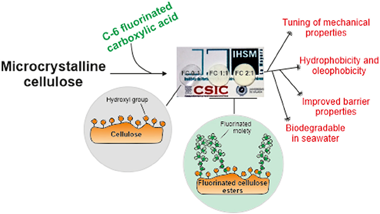
Tridecafluorononanoic acid (TFNA), a C6-fluorinated carboxylic acid, was esterified with cellulose at different molar ratios (0:1, 1:1, 2:1, and 3:1) in a trifluoroacetic acid (TFA):trifluoroacetic anhydride (TFAA):CHCl3 (2:1:1, v:v:v) solvent mixture. Free-standing films were obtained for all formulations and are presented as alternatives to composites and blends of paper with fluorinated molecules. Mechanical properties were investigated by tensile tests, and a plasticizer effect of fluorinated chains was observed. Interestingly, the wettability of these new cellulose derivatives was similar or even better than other common cellulose derivatives and fluorinated poly-mers employed in food packaging. Hydrodynamic properties were also improved by addition of TFNA, resulting in materials with water vapor permeability values comparable to other cellulose-based food packaging materials. In addition, films with the higher amounts of TFNA showed the required oil resistance for papers used in food packaging applications, as determined by the Kit Test. Finally, the biodegradation of these C6-fluorinated cel-lulose esters, assessed by biological oxygen demand (BOD) in seawater, was higher than typical bio-based polymers used in food packaging. The bioplastic synthesized at a molar ratio 1:1 (TFNA:cellulose) showed excellent performances in terms of greaseproof, hydrophobicity, ductility, and biodegradability, representing a sustainable alternative to typical plastics used in food packaging.
3D-printed structured catalysts for CO2 methanation reaction: Advancing of gyroid-based geometries
Gonzalez-Castano, M; Baena-Moreno, F; De Miguel, JCN; Miah, KUM; Arroyo-Torralvo, F; Ossenbrink, R; Odriozola, JA; Benzinger, W; Hensel, A; Wenka, A; Arellano-García, H
Energy Conversion and Management, 258 (2022) 115464 | DOI: 10.1016/j.enconman.2022.115464
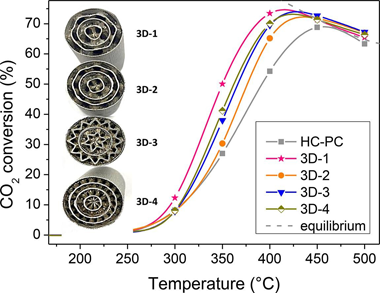
This work investigates the CO2 methanation rate of structured catalysts by tuning the geometr y of 3D-printed metal Fluid Guiding Elements (FGEs) structures based on periodically variable pseudo-gyroid geometries. The enhanced performance showed by the structured catalytic systems is mostly associated with the capability of the FGEs substrate geometries for efficient heat usages. Thus, variations on the channels diameter resulted in ca. 25% greater CO2 conversions values at intermediate temperature ranges. The highest void fraction evidenced in the best performing catalyst (3D-1) favored the radial heat transfer and resulted in significantly enhanced catalytic activity, achieving close to equilibrium (75%) conversions at 400 ? and 120 mL/min. For the 3D-1 catalyst, a mathematical model based on an experimental design was developed thus enabling the estimation of its behavior as a function of temperature, spatial velocity, hydrogen to carbon dioxide (H-2/CO2) ratio, and inlet CO2 concentration. Its optimal operating conditions were established under 3 different scenarios: 1) no restrictions, 2) minimum H-2:CO2 ratios, and 3) minimum temperatures and H-2/CO2 ratio. For instance, for the lattest scenario, the best CO2 methanation conditions require operating at 431 ?, 200 mL/min, H-2/CO2 = 3 M ratio, and inlet CO2 concentration = 10 %.
Flame confinement in biomass combustion systems for particles abatement
Ciria, D; Orihuela, MP; Moreno-Naranjo, P; Chacartegui, R; Ramirez-Rico, J; Becerra, JA
Energy Conversion and Management, 264 (2022) 115706 | DOI: 10.1016/j.enconman.2022.115706
This work explores the use of open-pore, inert ceramic foams with different pore sizes as particle abatement systems in small biomass combustion systems. Porous foams made of silicon carbide with pore sizes 10 to 60 pores-per-inch were installed in an in-house designed combustion unit operated with wood pellets. Their effects on the temperature distribution inside the chamber, particulate and gases emissions were studied using different airflow rates in the reaction-limited regime (low equivalence ratio) to minimise stoichiometric factors. The influence of pore size, foam position with respect to the flame and space velocity were assessed. The confinement of the flame with inert foams was found to substantially modify the temperature distribution in the combustion chamber, improve the air-fuel mixture, and favour the thermal decomposition of the pellet, leading to a reduction in particulate emissions when compared to free-flame combustion at the same experimental conditions. In general, the amount of particulate matter was found to decrease by up to one order of magnitude as the pore size of the foam was reduced, while the temperature gradient in the combustion chamber was increased. Nitrogen oxides and carbon dioxide emissions were essentially unchanged, irrespectively of the pore size of the foam. It is expected that these values will be improved with longer residence times, as happens in operations with reduced excess air ratios. These results suggest that it is possible to control pollutants derived from domestic heating within the most restrictive current regulations on particulate emissions by integrating flame confinement designs with better operating practices and efficient abatement systems.
Sustainable routes for acetic acid production: Traditional processes vs a low-carbon, biogas-based strategy
Martin-Espejo, JL; Gandara-Loe, J; Odriozola, JA; Reima, TR; Pastor-Pérez, L
Science of the Total Environment, 840 (2022) 156663 | DOI: 10.1016/j.scitotenv.2022.156663

The conversion of biogas, mainly formed of CO2 and CH4, into high-value platform chemicals is increasing attention in a context of low-carbon societies. In this new paradigm, acetic acid (AA) is deemed as an interesting product for the chemical industry. Herein we present a fresh overview of the current manufacturing approaches, compared to potential low-carbon alternatives. The use of biogas as primary feedstock to produce acetic acid is an auspicious alternative, representing a step-ahead on carbon-neutral industrial processes. Within the spirit of a circular economy, we propose and analyse a new BIO-strategy with two noteworthy pathways to potentially lower the environmental impact. The generation of syngas via dry reforming (DRM) combined with CO2 utilisation offers a way to produce acetic acid in a two-step approach (BIO-Indirect route), replacing the conventional, petroleum-derived steam reforming process. The most recent advances on catalyst design and technology are discussed. On the other hand, the BIO-Direct route offers a ground-breaking, atom-efficient way to directly generate acetic acid from biogas. Nevertheless, due to thermodynamic restrictions, the use of plasma technology is needed to directly produce acetic acid. This very promising approach is still in an early stage. Particularly, progress in catalyst design is mandatory to enable low-carbon routes for acetic acid production.
Supercooled sodium acetate aqueous solution for long-term heat storage to support heating decarbonisation
Lizana, J; Sanchez-Jimenez, PE; Chacartegui, R; Becerra, JA; Perez-Maqueda, LA
Journal of Energy Storage, 55 (2022) 105584 | DOI: 10.1016/j.est.2022.105584
Heating decarbonisation through electrification requires the development of novel heat batteries. They should be suitable for the specific application and match the operation conditions of domestic renewable energy sources. Supercooled liquids, often considered a drawback of phase change materials, are among the most promising technologies supporting heating decarbonisation. Although some studies have shed light on stable supercooling, the fundamentals and stability remain open problems not always accompanied by relevant experimental in-vestigations. This research critically analyses the physic and chemistry of sodium acetate (SA, NaCH3COO) aqueous solution, a low-cost, non-toxic, and abundant compound with stable supercooling for long-term heat storage. It has an appropriate phase change temperature for high-density heat storage using heat pumps or solar thermal technologies in residential applications. The existing discrepancies in literature are critically discussed through a systematic experimental evaluation, providing novel insights into efficient material design and appropriate boundary conditions for reliable material use in long-term heat batteries. Despite previous studies showing that the thermal reliability and stability of sodium acetate aqueous solution as a supercooled liquid for heat storage cannot be guaranteed, this study demonstrates that through an appropriate encapsulation and sealing method, the peritectic composition of sodium acetate solution (p-SA 58 wt%) can be used as a super-cooled liquid for long-term heat storage with a stable melting temperature of 57 degrees C, appropriate for domestic heat technologies. It is demonstrated that energy storage efficiency can be maintained under cycling, with a constant latent heat storage capacity of 245 kJ/kg and a volumetric storage density of 314 MJ/m3. It was confirmed that the material should achieve a fully-melted state for stable supercooling. Finally, local cooling and retaining seed crystals through high pressure were highlighted as the most suitable basic principles for successful crystallization and heat release. This promising material can store energy for long periods without latent heat losses due to its stable subcooling. Latent heat can be released when required at any selected time and tem-perature just by a simple activation process.
Steam-enhanced calcium-looping performance of limestone for thermochemical energy storage: The role of particle size
Arcenegui-Troya, J.; Sánchez-Jiménez, PE; Perejon, A; Valverde, JM; Pérez-Maqueda, LA
Journal of Energy Storage, 51 (2022) 104305 | DOI: 10.1016/j.est.2022.104305
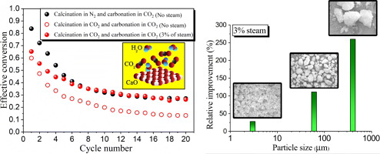
Steam injection has been proposed to attenuate the decay of CaO reactivity during calcium looping (CaL) under operating conditions compatible with carbon capture and storage. However, it is yet unknown whether the perceived advantages granted by steam hold under the distinct operating conditions required for the integration of the CaL process as a thermochemical energy storage system in Concentrating Solar Power Plants (CaL-CSP). Here, we study the influence of steam in conditions compatible with a CaL-CSP scheme and assess its impact when injected only during one stage; either calcination or carbonation, and also when it is present throughout the entire loop. The results presented here demonstrate that steam boosts the CaO multicycle performance in a CO2 closed loop to attain residual conversion values similar to those achieved at moderate temperatures under inert gas. Moreover, it is found that the enhancement in multicycle activity is more pronounced for larger particles.
Recent advances on gas-phase CO2 conversion: Catalysis design and chemical processes to close the carbon cycle
Torres-Sempere, G; Pastor-Perez, L; Odriozola, JA; Yu, J; Duran-Olivencia, FJ; Bobadilla, LF; Reina, TR
Current Opinion in Green andd Sustainable Chemistry, 36 (2022) 100647 | DOI: 10.1016/j.cogsc.2022.100647
Chemical CO2 recycling in the gas phase constitutes a straightforward approach for effective CO2 conversion to added-value products like syngas or synthetic methane. In this scenario, some traditional processes such as the dry and bi-reforming of methane, the CO2 methanation and the reverse water-gas shift have gained a renewed interest from the CO2 utilisation perspective. Indeed, these reactions represent flexible routes to upgrade CO2 and their application at an industrial scale could substantially reduce CO2 emissions. The bottleneck for the implementation of these processes at the commercial level is the development of highly active and robust heterogeneous catalysts able to overcome CO2 activation and deliver sufficient amounts of the upgrading products (i.e. syngas or synthetic natural gas) at the desired operating conditions. This review paper gathers the most recent advances in the design of new catalytic formulations for chemical CO2 recycling in the gas phase and constitutes an overview for experts and newcomers in the field to get fundamental insights into this emerging branch of low-carbon technologies.
One-Dimensional Photonic Crystal for Surface Mode Polarization Control
Mogni, E; Pellegrini, G; Gil-Rostra, J; Yubero, F; Simone, G; Fossati, S; Dostalek, J; Vazquez, RM; Osellame, R; Celebrano, M; Finazzi, M; Biagioni, P
Advanced Optical Materials, (2022) 2200759 | DOI: 10.1002/adom.202200759
Bloch surface waves sustained by truncated 1D photonic crystals (1DPCs) are well known tools for surface-enhanced spectroscopy. They provide strongly confined fields with uniform distribution over a large surface area, a characteristic exploited in standard refractometric sensing. However, their application to polarization-sensitive investigations is not straightforward because the transverse electric (TE) and magnetic (TM) surface modes possess distinct dispersion relations, therefore their relative phase is not conserved along propagation and the polarization state of any wave obtained by combining these modes is ill-defined. In this work, a novel design of a 1DPC is realized in which the TE and TM modes exhibit the same phase velocity over a broadband spectral range and thus their dispersion relations overlap. The capability to simultaneously excite TE and TM modes with a well-defined phase relation allows the generation of surface waves with a controlled polarization state. This paves the way to polarization-resolved surface-enhanced analysis, including, for example, linear and circular dichroism spectroscopy of grafted molecular layers at the photonic crystal surface.
Oxygen production routes assessment for oxy-fuel combustion
Garcia-Luna, S; Ortiz, C; Carro, A; Chacartegui, R; Perez-Maqueda, LA
Energy, 254 (2022) 124303 | DOI: 10.1016/j.energy.2022.124303
Oxyfuel combustion is a promising alternative to decarbonize the power sector. However, the main barrier to commercial deployment of the technology is the high energy consumption associated with oxygen production (-200-300 kWh per ton of O-2), which penalizes the thermal-to-electric efficiency of 8.5-12% compared to traditional air combustion plants. Typically, oxygen is obtained from a cryogenic air separation process. However, other technologies have been gaining momentum in recent years, such as membrane technologies, chemical looping air separation, and renewable-driven electrolysis. The present work evaluates all these options for O-2 production to retrofit a 550 MWe coal-fired power plant with oxyfuel combustion. A techno-economic assessment is carried out to estimate the energy penalty, the O-2 production cost (V/ton) and the Levelized Cost of Electricity. The best results are obtained by combining oxygen transport membranes and electrolysis since the energy consumption has been reduced to 98.56 kWh/ton of O(2, )decreasing by 59.31% the cryogenic distillation energy consumption (242.24 kWh/ ton O2), reducing the overall energy penalty compared to cryogenic air separation from 8.88% points to 7.56%points. The oxygen transport membrane presents the lowest cost of electricity in retrofitting cases, 51.48 $/MWh, while cryogenic distillation estimated cost is 52.7 $/MWh. Their costs of avoided CO2 are 31.79 $/ton CO2 and 34.15 $/ton CO2 respectively.
Optoelectronic Devices Based on Scaffold Stabilized Black-Phase CsPbI3 Nanocrystals
Romero-Perez, C; Rubino, A; Calio, L; Calvo, ME; Miguez, H
Advanced Optical Materials (2022) 2102112 | DOI: 10.1002/adom.202102112
The optoelectronic properties of lead halide perovskites are intimately related to their crystalline phase. For the case of cesium lead iodide (CsPbI3) several polymorphs meet the Goldschmidt tolerance factor, which determines their stability, and form broad band absorber and luminescent phases. However, at room temperature none of them are stable, which prevents their use in optoelectronics. In this work, bare CsPbI3 nanocrystals are synthesized in the sub-10 nm range in the "black", light emitting, crystalline phase, using a pore controlled SiO2 matrix that limits crystal size and confers a certain degree of strain that favors their stability. Quantum confinement effects allow the tuning of the optical properties of the CsPbI3 nanocrystals by means of the crystal size. Their suitability as optoelectronic materials is demonstrated by building scaffold supported CsPbI3 quantum dot based photovoltaic and light emitting devices.
Assessment of pilot-plant scale solar photocatalytic hydrogen generation with multiple approaches: Valorization, water decontamination and disinfection
Ruiz-Aguirre, A; Villachica-Llamosas, JG; Polo-Lopez, MI; Cabrera-Reina, A; Colon, G; Peral, J; Malato, S
Energy, 260 (2022) e10272 | DOI: 10.1016/j.energy.2022.125199
The main goal of the present study was to explore pilot-scale combination of H-2 generation with simultaneous water disinfection or decontamination. Performance of a TiO2-CuO mixture for solar-to-hydrogen (STH) con-version was studied, focusing on treatment optimization (catalyst dose, proportion of semiconductors in the mixture and concentration of the sacrificial agent). Experiments were performed in a 25-L compound parabolic collector (2 m(2)) solar pilot plant specifically designed for photocatalytic hydrogen generation. The best operating conditions were 100 mg L-1 TiO2-CuO (10:1) with 0.075 M glycerol as the sacrificial agent. The best STH conversion attained was 0.9%. 25 mg L-1 imidacloprid was completely degraded (over 99%). The synergetic effect of anoxic conditions, TiO2:CuO and solar radiation caused a significant reduction (> 5 Log) in concen-tration of E. coli, used as a model waterborne pathogen, in less than 10 min.
Z-scheme WO3/PANI heterojunctions with enhanced photocatalytic activity under visible light: A depth experimental and DFT studies
Y. Naciri; A.Hsini; A.Bouziani; K.Tanji; B.El Ibrahimi; M.N.Ghazza; B. Bakiz; A.Albourine; A.Benlhachemi; J.A. Navío
Chemosphere, 292 (2022) 133468 | DOI: 10.1016/j.chemosphere.2021.133468
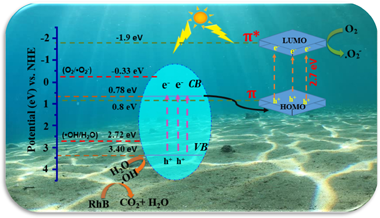
A WO3@PANI heterojunction photocatalyst with a various mass ratio of polyaniline to WO3 was obtained via the in situ oxidative deposition polymerization of aniline monomer in the presence of WO3 powder. The characterization of WO3@PANI composites was carried via X-ray diffraction (XRD), scanning electron microscopy (SEM-EDS), transmission electron microscopy (TEM), Fourier transform infrared spectroscopy (FT-IR), ultraviolet–visible diffuse reflection spectroscopy (DRS), X-ray photoelectron spectroscopy (XPS) and photoluminescence spectroscopy (PL). The photocatalytic efficiency of WO3@PANI photocatalysts was assessed by following the decomposition of the Rhodamine B (RhB) dye under visible light irradiation (λ >420 nm). The results evidenced the high efficiency of the WO3@PANI (0.5 wt %) nanocomposite in the photocatalytic degradation of RhB (90% within 120 min) under visible light irradiation 3.6 times compared to pure WO3. The synergistic effect between PANI and WO3 is the reason for the increased photogenerated carrier separation. The superior photocatalytic performance of the WO3@PANI catalyst was ascribed to the increased visible light in the visible range and the efficient charge carrier separation. Furthermore, the Density Functional Theory study (DFT) of WO3@PANI was performed at the molecular level, to find its internal nature for the tuning of photocatalytic efficiency. The DFT results indicated that the chemical bonds connected the solid-solid contact interfaces between WO3 and PANI. Finally, a plausible photocatalytic mechanism of WO3@PANI (0.5 wt %) performance under visible light illumination is suggested to guide additional photocatalytic activity development.
Insight into the role of temperature, time and pH in the effective zirconium retention using clay minerals
Pavon, E; Alba, MD
Journal of Environmental Chemical Engineering, 308 (2022) 114635 | DOI: 10.1016/j.jenvman.2022.114635
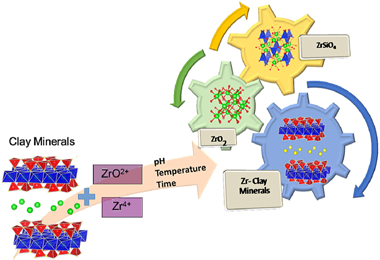
The use of zirconium in chemical industries generates a potential risk of Zr contamination in the environment, with particular concern for the decommissioning of uranium-graphite reactors. Among the natural adsorbents employed for the treatment of nuclear waste, clay minerals showed a very high affinity adsorption for radionuclides, but the influence of the chemical composition, pressure, temperature and time reaction have not yet been analysed on deep. Thus, the objective of this research is to explore several experimental conditions for an actual prediction of the behaviour of zirconium immobilization by clay minerals. The results have shown that factors such as zirconium cation nature (Zr4+ or ZrO2+), temperature, time and pH influence the extent of zirconium immobilization by clay minerals and the zirconium phases generated. At moderate conditions, zirconium tectosilicates are formed and evolve to zircon at high temperature and a longer time reaction.
Optimization of anion exchange membrane water electrolyzers using ionomer-free electrodes
Lopez-Fernandez, E; Gomez-Sacedon, C; Gil-Rostra, J; Espinos, JP; Brey, JJ; Gonzalez-Elipe, AR; de Lucas-Consuegra, A.; Yubero, F
Renewable Energy, 197 (2022) 1183-1191 | DOI: 10.1016/j.renene.2022.08.013
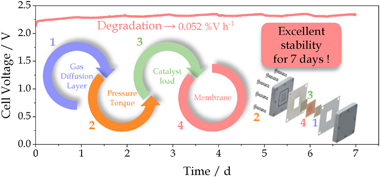
This work is carried out in the context of the anion exchange membrane water electrolysis (AEMWE) and pursuits to determine the influence of different cell components on the global electrochemical performance. Ionomer-free electrodes consisting of anodic Ni-Fe and cathodic Ni electrocatalysts deposited by magnetron sputtering in an oblique angle deposition configuration were utilized for this study. In addition to the characteristics and equivalent thickness of the electrocatalysts, other factors affecting the efficiency that have been considered in this study encompass the type of gas diffusion layer (GDLs), including carbon paper and stainless-steel fiber paper supports, and several commercial anion exchange membranes. The electrocatalytic performances in both a threeelectrode and complete single cell AEMWE set-ups, together with the physico-chemical characterization of the electrodes before and after operation, have served to select the optimum components for the utilized cell configuration. Thus, current densities of 670 mA cm-2, at polarization voltage of 2.2 V, 1.0 M KOH electrolyte and 40 degrees C were obtained in a membrane electrode assembly. A seven days chronopotentiometry experiment at a fixed current of 400 mA cm-2 demonstrated a noticeable stability of this type of AEMWE cells incorporating ionomer-free electrodes.
Effect of Steam Injection during Carbonation on the Multicyclic Performance of Limestone (CaCO3) under Different Calcium Looping Conditions: A Comparative Study
Troya, JJA; Moreno, V; Sánchez-Jiménez, PE; Perejon, A; Valverde, JM; Perez-Maqueda, LA
ACS Sustanaible Chemistry & Engineering, 10 (2022) 850-859 | DOI: 10.1021/acssuschemeng.1c06314
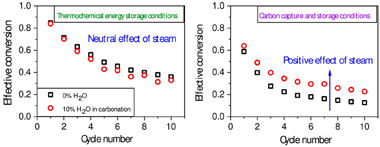
This study explores the effect of steam addition during carbonation on the multicyclic performance of limestone under calcium looping conditions compatible with (i) CO2 capture from postcombustion gases (CCS) and with (ii) thermochemical energy storage (TCES). Steam injection has been proposed to improve the CO2 uptake capacity of CaO-based sorbents when the calcination and carbonation loops are carried out in CCS conditions: at moderate carbonation temperatures (similar to 650 degrees C) under low CO2 concentration (typically similar to 15% at atmospheric pressure). However, the recent proposal of calcium-looping as a TCES system for integration into concentrated solar power (CSP) plants has aroused interest in higher carbonation temperatures (similar to 800-850 degrees C) in pure CO2. Here, we show that steam benefits the multicyclic behavior in the milder conditions required for CCS. However, at the more aggressive conditions required in TCES, steam essentially has a neutral net effect as the CO2 uptake promoted by the reduced CO2 partial pressure but also is offset by the substantial steam-promoted mineralization in the high temperature range. Finally, we also demonstrate that the carbonation rate depends exclusively on the partial pressure of CO2, regardless of the diluting gas employed.
A novel Multi-Phase Flash Sintering (MPFS) technique for 3D complex-shaped ceramics
Molina-Molina, S; Gil-Gonzalez, E; Duran-Olivencia, FJ; Valverde, JM; Perejon, A; Sanchez-Jimenez, PE; Pérez-Maqueda, LA
Applied Materials Today, 26 (2022) 101274 | DOI: 10.1016/j.apmt.2021.101274
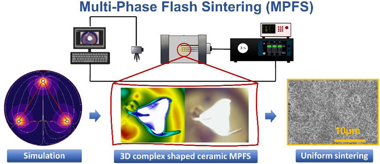
This work demonstrates the first proof-of-concept of Multi-Phase Flash Sintering (MPFS). This novel technique essentially consists of applying a rotating electric field to the sample by means of a multi-phase voltage source as furnace temperature increases. Several ceramic materials with different types of electrical conductivities are sintered within seconds at furnace temperatures much lower than those used for traditional DC flash sintering due to the higher power densities administered by a multi-phase power supply. Thus, ceramic materials are flashed at relatively lower applied voltages which minimizes undesired phenomena such as localization and preferential current pathways. Furthermore, MPFS allows diverse electrode configurations to promote a more uniform electric field distribution, enhancing the sintering of 3D complex-shaped specimens. MPFS could be a true breakthrough in materials processing, as 3D complex-shaped specimens are homogeneously sintered at reduced temperatures, while keeping all the advantages of conventional flash sintering.
CO2 methanation on Ni/YMn1-xAlxO3 perovskite catalysts
Safdar, M; Gonzalez-Castano, M; Penkova, A; Centeno, MA; Odriozola, JA; Arellano-Garcia, H
Applied Materials Today, 29 (2022) 101577 | DOI: 10.1016/j.apmt.2022.101577
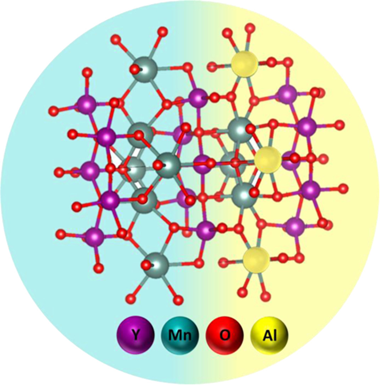
Seeking for advanced catalytic systems for the CO2 methanation reaction, the use of Ni supported catalysts over redox materials is often proposed. Profiting the superior redox properties described for layered perovskite systems, this work has investigated a series Ni supported YMn1-xAlxO3 (x = 0, 0.2, 0.5, 0.8, 1) perovskite catalysts. The obtained results evidenced the impact of the support nature on the systems redox properties and Ni-support interactions. Within the catalysts series, the greater methanation rates displayed by Ni/YMn0.5Al0.5O3 catalyst (0.748 mmol(CO2,conv.)s(-1) g(Ni)(-1) at 400 ? and 60 L/gh) were associated to the interplay between the support redox properties and superior Ni dispersion. The improved redox behavior attained through the Al-incorporation (up to x = 0.5) was associated to the layered perovskite structures which, being distorted and constituted by smaller crystal sizes, facilitated the behavior of Mn redox couples as surface species readily interconverted. Exhibiting catalytic performances comparable to precious metals based catalysts, this work proposes the Ni/YMn0.5Al0.5O3 catalyst as an effective system for the CO2 methanation reaction.
Transparent, UV-blocking, and high barrier cellulose-based bioplastics with naringin as active food packaging materials
Guzman-Puyol, S; Hierrezuelo, J; Benitez, JJ; Tedeschi, G; Porras-Vazquez, JM; Heredia, A; Athanassiou, A; Romero, D; Heredia-Guerrero, JA
International Journal of Biological Macromolecules, 209 (2022) 1985-1994 | DOI: 10.1016/j.ijbiomac.2022.04.177
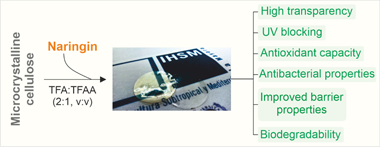
Free-standing, robust, and transparent bioplastics were obtained by blending cellulose and naringin at different proportions. Optical, thermal, mechanical, antioxidant, and antimicrobial properties were systematically investigated. In general, the incorporation of naringin produced important UV blocking and plasticizer effects and good antioxidant and antibacterial properties. Moreover, the barrier properties were characterized by determination of their water and oxygen transmission rates, finding that both parameters decreased by increasing the naringin content and reaching values similar to other petroleum-based plastics and cellulose derivatives used for food packaging applications. Finally, the biodegradability of these films was determined by measurement of the biological oxygen demand (BOD) in seawater, demonstrating an excellent decomposition in such conditions.
Transparency of polymeric food packaging materials
Guzman-Puyol, Susana; Benitez, Jose J; Heredia-Guerrero, Jose A
Food Research International, 161 (2022) 111792 | DOI: 10.1016/j.foodres.2022.111792
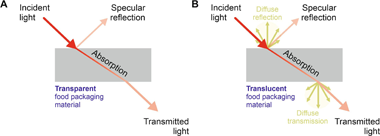
Transparency is a very important technical parameter to evaluate and validate certain food packaging materials. In the recent scientific literature, several methods (i.e. transmittance, opacity, haze, and absorbance) have been used and such variety hinders a direct comparison of results from different authors. In this Review, we describe and discuss the most widely employed methods to measure transparency, with special emphasis on two main parameters: transmittance and opacity. Moreover, a comparison of the different techniques is addressed and the typical values of transmittance and opacity of common transparent food packaging materials are provided. Our current opinion is that transparency should be expressed as transmittance in the visible range due to both the quickness and easiness of the measurement and the standardization of data. This information should be accompanied by the thickness value and a graphical image of the analysed samples for a useful and complete characterization.
Molecular Interface Engineering via Triazatruxene-Based Moieties/NiOx as Hole-Selective Bilayers in Perovskite Solar Cells for Reliability
Hemasiri, NH; Calio, L; Pegu, M; Kazim, S; Ahmad, S
Solar RRL (2022) 2100793 | DOI: 10.1002/solr.202100793
Interface engineering is an effective approach to decrease nonradiative recombination and the energy barrier at the perovskite/hole transporting layer (HTL) interfaces. To overcome such limitations, an organic semiconductor (DTT-EHDI2) is proposed, which is, composed of dithienothiophene (DTT) as the core and a planar triazatruxene incorporating an alkyl chain as the side group. This is noted to be an effective interfacial layer for inverted planar perovskite solar cells (PSCs). The altered interface effectively minimizes the detrimental charge recombination and tailors the photoinduced charge transfer dynamics at the interface of the inorganic HTL/perovskite. The pi-conjugation in DTT-EHDI2 induces high hole mobility and electrical conductivity via electron-donating properties and strong pi-pi intermolecular interaction. The synergetic approach leads to a substantial performance enhancement in dopant-free DTT-EHDI2-based inverted planar PSCs, achieving 18.15% power conversion efficiency with negligible hysteresis effect. The present approach provides an effective direction of the cost-effective thiophene derivative as an interfacial agent to escalate the optoelectronic performances in photovoltaics.
Morphologically diverse CaCO3 microparticles and their incorporation into recycled cellulose for circular economy
Guerra-Garces, J; Garcia-Negrete, CA; Pastor-Sierra, K; Arteaga, GC; Barrera-Vargas, M; de Haro, MJ; Fernandez, A
Materials Today Sustainability, 19 (2022) 100166 | DOI: 10.1016/j.mtsust.2022.100166
The main raw material for manufacture of paper is cellulose fibers that can be virgin or recycled. Globally, 70% of the Tetra Pak packages sold are not recycled and remain as unused wastes. Therefore, the development of alternatives to promote greater recycling and sustainable use of these packages is of great interest. In this study, the formation of precipitated calcium carbonates (PCC) in the presence of carboxymethyl cellulose (CMC) is studied at different temperatures, and the morphologically diverse particles obtained are explored as filler for composites based on cellulosic fibers recovered from Tetra Pak containers. It was found that the addition of filler does not lead to deterioration of either tensile strength or thermal and stability of the obtained composite samples. Results also suggest that the morphological diversity of the filler contributes to a more efficient filling of the interfibrillar spaces of cellulosic fibers and, in turn, to the fiber and filler compatibility.
Materials challenges and opportunities to address growing micro/ nanoplastics pollution: a review of thermochemical upcycling
Parrilla-Lahoz, S; Mahebadevan, S; Kauta, M; Zambrano, MC; Pawlak, JJ; Venditti, RA; Reina, TR; Duyar, MS
Materials Today Sustainability, 20 (2022) 100200 | DOI: 10.1016/j.mtsust.2022.100200
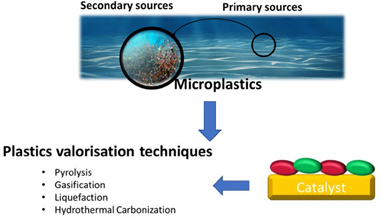
Micro/nanoplastics have sparked attention in recent years due to their widespread presence in the environment. Currently, several waste valorization approaches are under development in order to upcycle micro/nanoplastics. Thermal conversion technologies such as pyrolysis, gasification, liquefaction, or hydrothermal carbonization can yield high-value solid products, oil, and gases from plastics waste. The common thermal conversion technologies investigated focus on maximizing the production of oil and gases (such as H2 and CH4) for use as fuel. Except for hydrogen, when these products are used to generate energy, the carbon emissions generated are comparable to those produced by traditional fossil fuels. Herein, we present a review of the current efforts to capture and convert plastic waste into valuable products with an emphasis on identifying the need to develop processes specifically for micro/nano-plastics while also preventing the release of CO2 emissions. We identify the development of efficient catalytic materials as a critical research need for achieving economically viable thermochemical con-version of micro/nanoplastics.
Nanostructured nickel based electrocatalysts for hybrid ethanol-water anion exchange membrane electrolysis
Lopez-Fernandez, E; Gomez-Sacedon, C; Gil-Rostra, J; Espinos, JP; Gonzalez-Elipe, AR; Yubero, F
Journal of Environmental Chemical Engineering, 10 (2022) 107994 | DOI: 10.1016/j.jece.2022.107994
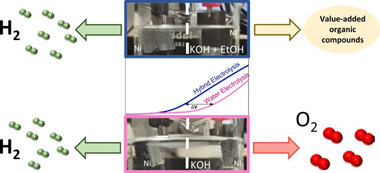
Ni and Ni-Fe nanostructured layers prepared by magnetron sputtering in an oblique angle deposition configuration (MS-OAD) have been used as anode and cathode catalysts for hybrid ethanol-water electrolysis in an anion exchange membrane (AEM) electrolyser. Physico-chemical and electrochemical characterization in a threeelectrode cell has been carried out to determine the optimal characteristics of the anodic films. Current densities up to 434 mA cm-2 at 2.0 V in a 1.5 M EtOH and 2.0 M KOH fuel solution were achieved with excellent operational stability for 3 days. These experiments show that the oxygen evolution reaction taking place at the anode is completely replaced by the ethanol oxidation reaction under our explored reaction conditions. The obtained results evidence the interest of this kind of organic vs. pure water electrolysis to decrease the overall electrical energy consumption for the production of hydrogen.
Improvement in cyclic CO2 capture performance and fluidization behavior of eggshell-derived CaCO3 particles modified with acetic acid used in calcium looping process
Imani, M; Tahmasebpoor, M; Sanchez-Jimenez, PE; Valverde, JM; Moreno, V
Journal of CO2 Utilization, 65 (2022) 102207 | DOI: 10.1016/j.jcou.2022.102207
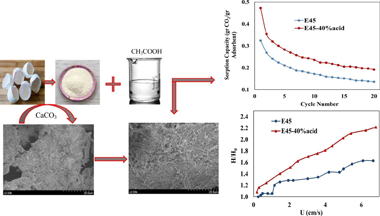
Although calcium-based materials are the most promising adsorbents used in calcium looping process for carbon dioxide removing, their CO2 capture capacity decaying besides poor fluidization, still are the important challenges. In the present investigation, eggshell as a cheap, easily available and unpolluted source of calcium carbonate was used for CO2 capturing in calcium looping process. Eggshell particles were treated with various volume concentrations of acetic acid to improve its sorption capacity. According to the TGA results after 20 carbonation/calcination cycles, the effective carbonation conversion of modified eggshell with 5%, 20%, 30% and 40%. v/v acetic acid was 21.33%, 24.26%, 25.97% and 28.97%, respectively, which is considerable compared to 20.54% for untreated eggshell. The effect of initial eggshell particle size on the adsorption behavior of final adsorbent was also investigated by using two different sizes including dp < 45 mu m and dp > 320 mu m. The results showed that the effective conversion of the adsorbent containing 40%. v/v acetic acid derived from small particle size eggshells was 9.32% higher than that from larger particle size eggshells. In terms of fluidization behavior, surprisingly the addition of acetic acid to the eggshell particles also increased the bed expansion ratio as 8% and 36.2% at gas velocities of 0.27 and 6.67 cm/s, respectively. Further improvement in the fluidity of eggshell modified with 40% acid was performed by manually mixing of SiO2 nanoparticles at different weight percentages. According to the results, adding 7.5 wt% SiO2 leaded to the homogeneous and agglomerate particulate fluidization.
Ni-Phosphide catalysts as versatile systems for gas-phase CO2 conversion: Impact of the support and evidences of structure-sensitivity
Zhang, Q; Pastor-Perez, L; Villora-Pico, JJ; Joyce, M; Sepulveda-Escribano, A; Duyar, MS; Reina, TR
Fuel, 323 (2022) 124301 | DOI: 10.1016/j.fuel.2022.124301
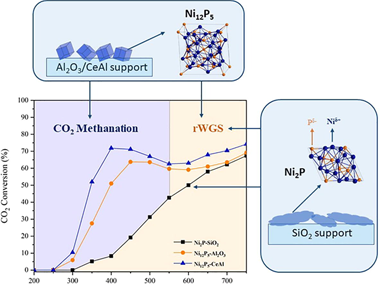
We report for the first time the support dependent activity and selectivity of Ni-rich nickel phosphide catalysts for CO2 hydrogenation. New catalysts for CO2 hydrogenation are needed to commercialise the reverse water-gas shift reaction (RWGS) which can feed captured carbon as feedstock for traditionally fossil fuel-based processes, as well as to develop flexible power-to-gas schemes that can synthesise chemicals on demand using surplus renewable energy and captured CO2. Here we show that Ni2P/SiO2 is a highly selective catalyst for RWGS, producing over 80% CO in the full temperature range of 350-750 degrees C. This indicates a high degree of suppression of the methanation reaction by phosphide formation, as Ni catalysts are known for their high methanation activity. This is shown to not simply be a site blocking effect, but to arise from the formation of a new more active site for RWGS. When supported on Al2O3 or CeAl, the dominant phase of as synthesized catalysts is Ni12P5. These Ni12P5 catalysts behave very differently compared to Ni2P/SiO2, and show activity for methanation at low temperatures with a switchover to RWGS at higher temperatures (reaching or approaching thermodynamic equilibrium behaviour). This switchable activity is interesting for applications where flexibility in distributed chemicals production from captured CO2 can be desirable. Both Ni12P5/Al2O3 and Ni12P5/CeAl show excellent stability over 100 h on stream, where they switch between methanation and RWGS reactions at 50-70% conversion. Catalysts are characterized before and after reactions via X-ray Diffraction (XRD), X-ray Photoelectron Spectroscopy (XPS), temperature-programmed reduction and oxidation (TPR, TPO), Transmission Electron Microscopy (TEM), and BET surface area measurement. After reaction, Ni2P/SiO(2 )shows the emergence of a crystalline Ni12P5 phase while Ni12P5/Al2O3 and Ni12P5/CeAl both show the crystalline Ni3P phase. While stable activity of the latter catalysts is demonstrated via extended testing, this Ni enrichment in all phosphide catalysts shows the dynamic nature of the catalysts during operation. Moreover, it demonstrates that both the support and the phosphide phase play a key role in determining selectivity towards CO or CH4.
Pursuing efficient systems for glucose transformation to levulinic acid: Homogeneous vs. heterogeneous catalysts and the effect of their co-action
Bounoukta, CE; Megias-Sayago, C; Ivanova, S; Ammari, F; Centeno, MA; Odriozola, JA
FUEL, 318 (2022) 123712 | DOI: 10.1016/j.fuel.2022.123712
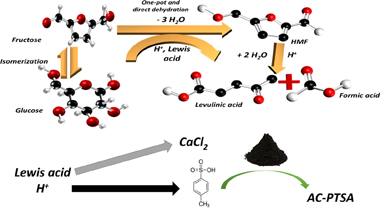
Exploring available catalytic systems to understand their behavior is a must to properly design efficient catalysts aiming to definitively drive biomass from laboratory to industrial scale. Glucose transformation to levulinic acid involves cascade reactions with specific requirements, different active sites in each case and secondary reactions hard to avoid which are intrinsically linked to the catalyst's nature and reaction conditions. In the present work, homogeneous, heterogeneous and heterogeneous/homogeneous catalysts are considered with the unique goal of improving levulinic acid yield while understanding the catalytic behaviour of cost-effective catalysts. The choice of the catalytic systems and the effect of the main reaction parameters on activity and selectivity is studied and discussed.
Hydrogen production from landfill biogas: Profitability analysis of a real case study
Vidal-Barrero, F; Baena-Moreno, FM; Preciado-Cardenas, C; Villanueva-Perales, A; Reina, TR
Fuel, 324 (2022) 124438 | DOI: 10.1016/j.fuel.2022.124438
Hydrogen is not only considered as a cornerstone within renewable energy portfolio but it is also a key enabler for CO2 valorisation being a central resource for industrial decarbonization. This work evaluates the profitability of hydrogen production via combined biogas reforming and water-gas shift reaction, based on a real case scenario for landfill biogas plant in Seville (Spain). A techno-economic model was developed based on a process model and the discounted cash-flow method. A biogas flow of 700 m(3)/h (input given by the landfill biogas plant) was used as plant size and the analysis was carried out for two different cases: (1) use of already available energy sources at the industrial plant, and (2) solar energy generation to power the process. The economic outputs obtained showed that under the current circumstances, this hydrogen production route is not profitable. The main reason is the relatively low current hydrogen prices which comes from fossil fuels. A revenues analysis indicates that hydrogen from biogas selling prices between 2.9 and 5.7 euro/kg would be needed to reach profitability, which are considerably higher than the current hydrogen cost (1.7 euro/kg). A subsidy scheme is suggested to improve the competitiveness of this hydrogen production process in the short-medium term. A cost analysis is also performed, revealing that electricity prices and investment costs have a high impact on the total share (23-40% and 8-22%, respectively). Other potential costs reduction such as catalyst, labour and manteinance & overhead are also evaluated, showing that cutting-down production costs is mandatory to unlock the potential of hydrogen generation from biogas. Our work showcases the techno-economic challenge that green energy policies face in the path toward sustainable societies.
Catalytic reforming of model biomass-derived producer gas
Azancot, L; Bobadilla, LF; Centeno, MA; Odriozola, JA
Fuel, 320 (2022) 123843 | DOI: 10.1016/j.fuel.2022.123843
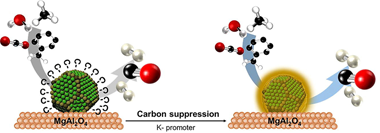
This work includes a complete study of the reaction of reforming a simulated producer gas stream comparing a Ni-based catalyst with another one promoted with potassium to enhance the resistance to coke formation. Although coke deposition is unavoidable in the presence of tars in the stream, the analysis of different reaction parameters revealed that operating at 750 degrees C, weight hourly space velocity (WHSV) of 60 L-1 g(-1) h(-1) and 10-20 vol% of steam is possible to minimize the accumulation of carbon deposits. Moreover, it was demonstrated that the addition of potassium helps to mitigate carbon formation, but a high concentration of steam leads to nickel sintering and/or partial oxidation of metallic nickel. On this basis, it was successfully evidenced that the Ni-K catalyst is an excellent candidate for obtaining clean syngas from producer gas reforming.
Versatile Ni-Ru catalysts for gas phase CO2 conversion: Bringing closer dry reforming, reverse water gas shift and methanation to enable end-products flexibility
Merkouri, LP; le Sache, E; Pastor-Perez, L; Duyar, MS; Reina, TR
Fuel, 315 (2022) 123097 | DOI: 10.1016/j.fuel.2021.123097
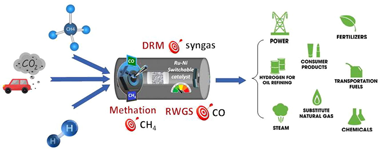
Advanced catalytic materials able to catalyse more than one reaction efficiently are needed within the CO2 utilisation schemes to benefit from end-products flexibility. In this study, the combination of Ni and Ru (15 and 1 wt%, respectively) was tested in three reactions, i.e. dry reforming of methane (DRM), reverse water-gas shift (RWGS) and CO2 methanation. A stability experiment with one cycle of CO2 methanation-RWGS-DRM was carried out. Outstanding stability was revealed for the CO2 hydrogenation reactions and as regards the DRM, coke formation started after 10 h on stream. Overall, this research showcases that a multicomponent Ni-Ru/CeO2 -Al2O3 catalyst is an unprecedent versatile system for gas phase CO2 recycling. Beyond its excellent performance, our switchable catalyst allows a fine control of end-products selectivity.
Understanding the promotional effect of Pt/CeO2 in cobalt-catalyzed Fischer-Tropsch synthesis using operando infrared spectroscopy at moderated pressures
Bobadilla, LF; Egana, A; Castillo, R.; Romero-Sarria, F.; Centeno, M.A.; Sanz, O.; Montes, M.; Odriozola, J.A.
FUEL, 312 (2022) 122964 | DOI: 10.1016/j.fuel.2021.122964
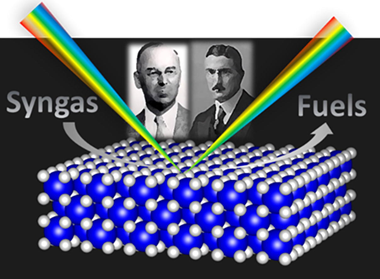
Fischer-Tropsch (FTS) reaction is a well-known catalytic process for the conversion of synthesis gas into liquid fuels. The addition of a water gas shift (WGS) catalyst to the FTS one has been postulate to notably increase the efficiency of the process. In order to investigate this issue, we conducted the FTS reaction over a Co-Re/Al2O3 catalyst combined with an optimal WGS Pt/CeO2 catalyst. We observed a notable increase of CO conversion in presence of the Pt/CeO2 catalyst that a priori could be attributed to the WGS reaction. However, the WGS reaction is unfavourable at pressures higher than 1 bar and CO/CO2 hydrogenation over Pt/CeO2 could be more favoured under FTS reaction conditions. In order to gain insights on this fact and elucidate the role of Pt/CeO2 in the FTS reaction we have performed an operando DRIFTS-MS study under close FTS reaction conditions at 4 bar over the Pt/CeO2 catalyst.
Highly uniform Y3Al2Ga3O12-based nanophosphors for persistent luminescence bioimaging in the visible and NIR regions
Arroyo, E; Herrero, BT; De la Fuente, JM; Ocaña, M; Becerro, AI
Inorganic Chemistry Frontiers, 9 (2022) 2454-2461 | DOI: 10.1039/d2qi00480a
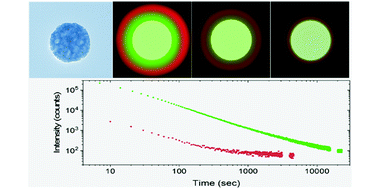
In the last few years, persistent phosphors with a garnet crystal structure have attracted a great deal of interest for a plethora of applications ranging from bioimaging to anti-counterfeiting technologies. However, the development of synthesis methods to fabricate uniform garnet-based micro and nanoparticles, that are needed for such applications, is not mature at all. This study reports the synthesis of highly uniform yttrium aluminum gallium garnet nanospheres. The method is based on homogeneous precipitation in a polyol medium followed by silica coating and calcination. The nanoparticles resulting after silica removal were also uniform and were easily functionalized with polyacrylic acid. The colloidal stability of the latter in physiological media and their biocompatibility were analyzed. The luminescence of the particles, doped with Ce3+, Cr3+, and Nd3+, was studied by recording emission and excitation spectra and persistent luminescence decay curves. Due to their uniform morphology, high colloidal stability, absence of toxicity, and persistent emission in the visible and near-infrared regions, the reported nanospheres show great potential as persistent luminescent bioimaging probes. In addition, the synthesis method paves the way for future use of this persistent material in other applications that require the phosphor to be in the form of highly uniform nanoparticles.
The SrCO3/SrO system for thermochemical energy storage at ultra-high temperature
Amghar, N; Ortiz, C; Perejon, A; Valverde, JM; Maqueda, LP; Jimenez, PES
Solar Energy Materials and Solar Cells, 238 (2022) 111632 | DOI: 10.1016/j.solmat.2022.111632
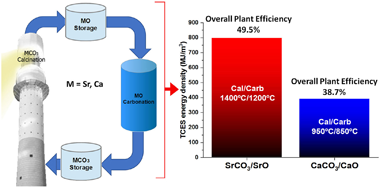
Thermochemical energy storage (TCES) has attracted interest in the last years due to the possibility of attaining high energy densities, seasonal storage capacity and greater efficiencies than currently commercial thermal energy storage systems using molten salts. This work analyses the potential of an ultra-high temperature TCES system based on the SrCO3/SrO system. The process relies upon the reversible decomposition of SrCO3 into SrO and CO2. As proposed in previous works for the integration of the Ca-Looping process to store energy in CSP plants, both the calcination (endothermic) and carbonation (exothermic) reactions are carried out in a closed CO2 loop. At these conditions, the required temperature to attain full calcination in short residence times is around 1400 degrees C whereas carbonation takes place at about 1200 degrees C. Using this process, the energy density potentially achievable by the storage material is very high (around 2000 MJ/m(3)) while the ultra-high carbonation temperature would improve thermoelectric efficiency. The enhancement of the multicycle performance of the SrCO3/SrO system using refractory additives is also explored. Even though current commercial CSP plants with tower technology cannot yet operate at these ultra-high temperatures, recent advances in the development of high-temperature solar receivers could allow operation at 1400 degrees C in the medium term. Finally, a conceptual model of the integration of the SrCO3/SrO system in a CSP plant supports higher overall efficiency and energy density, but lower solar-to-electric efficiency due to thermal losses.
Overlooked pitfalls in CaO carbonation kinetics studies nearby equilibrium: Instrumental effects on calculated kinetic rate constants
Arcenegui-Troya, J; Duran-Martin, JD; Perejon, A; Valverde, JM; Maqueda, LAP; Jimenez, PES
Alexandria Engineering Journal, 61 (2022) 6129-6138 | DOI: 10.1016/j.aej.2021.11.043
Due to its technological applications, such as CO2 capture, CaO carbonation kinetics has been extensively studied using a wide array of methods and experimental conditions. A complete understanding of carbonation kinetics is key to optimizing the operating conditions as well as to correctly design the carbonation reactor. However, there is yet no consensus on the reaction model and kinetic parameters that can best describe the CaO carbonation reaction. For instance, the value of the activation energy proposed in different works can vary up to 300%. In this work, we demonstrate that the strong influence of the thermodynamic equilibrium on CaO carbonation kinetics demands careful control of the experimental conditions to obtain meaningful kinetic parameters. Specifically, we explore the influence of three experimental parameters on carbonation kinetics: the gas flow rate, the CO2 partial pressure and the time required to fill the reactor after a gas change. We demonstrate that disregarding these aspects may lead to bogus conclusions on reaction kinetics, which could partly explain the considerable discrepancies found in the literature. The conclusions of this work are not only applicable to the process and experimental setup studied here but also to any study that involves the use of gas flow to drive a reaction.
Insights into the structural and physicochemical properties of Zn-Bi-O composites for efficient photodegradation of caffeic acid, rhodamine B and methyl orange
F.Puga; J.A.Navío; J.M.Córdoba; F.Romero-Sarria; M.C.Hidalgo
Applied Surface Science, 581 (2022) 152351 | DOI: 10.1016/j.apsusc.2021.152351
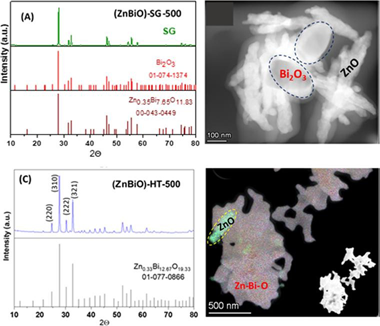
Different Zn-Bi-O composites were synthesized following the starting chemical molar composition of ZnBi2O4 spinels by a sol–gel method, (ZnBiO)-SG, and its subsequent hydrothermal treatment, (ZnBiO)-HT. The acquired X-ray diffractograms after sequential thermal treatments at a programmed rate indicate that both precursors evolved, after calcination at 500 °C, to materials (ZnBiO) with different stoichiometry. The use of different characterization techniques (both FT-IR and TEM), allowed us to establish that, with the sol–gel process a mixed ZnO/Bi2O3 oxide is generated, while after hydrothermal process a ternary Zn-Bi-O oxide is formed, with small amounts of residual ZnO. The photocatalytic properties of the synthesized samples were evaluated using Caffeic acid, Rhodamine B and Methyl Orange as model substrates. It can be concluded that both catalysts showed excellent photocatalytic activity for the degradation of trans-caffeic acid under both UV and visible illumination. The leaching process (in particular of zinc), which is produced with the illumination time (in particular under UV illumination) in the presence of oxygen, raises the hypothesis of a foreseeable formation of complexes (photochemically stable or unstable) of caffeic acid with Zn2+ and Bi3+ ions. The plausible donor/acceptor interactions between the toxic molecules studied and the Zn2+ and Bi3+ ions, could condition the degradation processes, by means of a photoassisted process that would take place both, in the heterogeneous (photocatalytic) and homogeneous (photoassisted) phases. For the degradation processes of Rhodamine B and Methyl Orange, additional experimental conditions are studied that significantly improved their photocatalytic degradation.
Feasibility of switchable dual function materials as a flexible technology for CO2 capture and utilisation and evidence of passive direct air capture
Merkouri, LP; Reina, TR; Duyar, MS
Nanoscale, 14 (2022) 12620-12637 | DOI: 10.1039/d2nr02688k
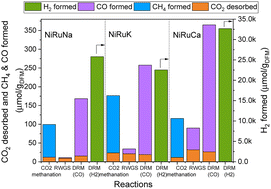
The feasibility of a Dual Function Material (DFM) with a versatile catalyst offering switchable chemical synthesis from carbon dioxide (CO2) was demonstrated for the first time, showing evidence of the ability of these DFMs to passively capture CO2 directly from the air as well. These DFMs open up possibilities in flexible chemical production from dilute sources of CO2, through a combination of CO2 adsorption and subsequent chemical transformation (methanation, reverse water gas shift or dry reforming of methane). Combinations of Ni Ru bimetallic catalyst with Na2O, K2O or CaO adsorbent were supported on CeO2-Al2O3 to develop flexible DFMs. The designed multicomponent materials were shown to reversibly adsorb CO2 between the 350 and 650 degrees C temperature range and were easily regenerated by an inert gas purge stream. The components of the flexible DFMs showed a high degree of interaction with each other, which evidently enhanced their CO2 capture performance ranging from 0.14 to 0.49 mol kg(-1). It was shown that captured CO2 could be converted into useful products through either CO2 methanation, reverse water-gas shift (RWGS) or dry reforming of methane (DRM), which provides flexibility in terms of co-reactant (hydrogen vs. methane) and end product (synthetic natural gas, syngas or CO) by adjusting reaction conditions. The best DFM was the one containing CaO, producing 104 mu mol of CH4 per kg(DFM) in CO2 methanation, 58 mu mol of CO per kg(DFM) in RWGS and 338 mu mol of CO per kg(DFM) in DRM.
Outstanding MRI contrast with dysprosium phosphate nanoparticles of tuneable size
Gómez-González, E.; Caro, C.; García-Martín, ML; Becerro, AI; Ocaña, M.
Nanoscale, 14 (2022) 11461-11470 | DOI: 10.1039/d2nr02630a
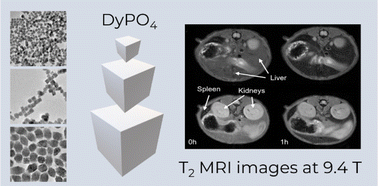
The use of high-field magnets for magnetic resonance imaging (MRI) is expected to experience the fastest growth rate during the present decade. Although several CAs for MRI scanners using high magnetic fields have been reported, they are mostly based on fluoride matrices, which are known for their low chemical stability in aqueous suspensions. Chemically stable MRI CAs for high-field magnets are therefore needed to enable the advances in MRI technique. Herein, we synthesized uniform DyPO4 nanoparticles (NPs) with tuneable sizes between 23 and 57 nm using homogeneous precipitation in butanol. The NPs were successfully functionalized with polyacrylic acid (PAA) and showed good colloidal stability in aqueous suspensions. Chemical stability was also assessed in PBS, showing negligible solubility. The effect of particle size on the transversal relaxivity value (r(2)) was further explored at 9.4 T, finding a clear increase in r(2) with particle size. The r(2) value found for the largest NPs was 516 mM(-1) s(-1), which is, to the best of our knowledge, the highest r(2) value ever reported at 9.4 T for any Dy-based nanometric particles in the literature. Finally, the latter NPs were submitted to biosafety studies after polyethylene glycol (PEG) functionalization. Cell morphology, induction of necrotic/late apoptotic cells, and mitochondrial activity were thoroughly analyzed. The results clearly indicated negligible toxicity effects under the assayed conditions. Short- and long-term in vivo pharmacokinetics of the intravenously injected NPs were assessed by dynamic T-2-weighted MRI and quantitative T-2 mapping, revealing faster liver than spleen uptake, while no accumulation was observed in the kidneys. Finally, no histopathological changes were observed in any of the studied organs, including the liver, kidney, spleen, and lung, which provide further evidence of the biocompatibility of DyPO4 NPs and, therefore, their suitability as bioimaging probes.
Multiscale ultrafast laser texturing of marble for reduced surface wetting
Ariza, R; Alvarez-Alegria, M; Costas, G; Tribaldo, L; Gonzalez-Elipe, AR; Siegel, J; Solis, J
Applied Surface Science, 577 (2022) 152850 | DOI: 10.1016/j.apsusc.2021.151850
The modification of the wetting properties of marble surfaces upon multi-scale texturing induced by ultrafast laser processing (340 fs pulse duration, 1030 nm wavelength) has been investigated with the aim of evaluating its potential for surface protection. The contact angle (CA) of a water drop placed on the surface was used to assess the wettability of the processed areas. Although the surfaces are initially hydrophilic upon laser treatment, after a few days they develop a strong hydrophobic behavior. Marble surfaces have been irradiated with different scan line separations to elucidate the relative roles of multi-scale roughness (nano-and micro-texture) and chemical changes at the surface. The time evolution of the contact angle has been then monitored up to 11 months after treatment. A short and a long-term evolution, associated to the combined effect of multi-scale roughness and the attachment of chemical species at the surface over the time, have been observed. XPS and ATR measurements are consistent with the progressive hydroxylation of the laser treated surfaces although the additional contribution of hydrocarbon adsorbates to the wettability evolution cannot be ruled-out. The robustness of the results has been tested by CA measurements after cleaning in different conditions with very positive results.
Rhodamine 6G and 800 intermolecular heteroaggregates embedded in PMMA for near-infrared wavelength shifting
Castillo-Seoane, J; Gonzalez-García, L; Obrero-Pérez, JM; Aparicio, FJ; Borras, A; Gonzalez-Elipe, AR; Barranco, A; Sanchez-Valencia, JR
Journal of Materials Chemistry C, 10 (2022) 7119-7131 | DOI: 10.1039/d1tc06167d
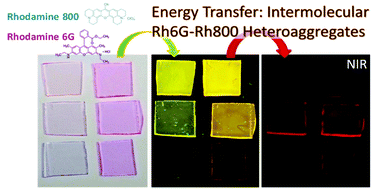
The opto-electronic properties of small-molecules and functional dyes usually differ when incorporated into solid matrices with respect to their isolated form due to an aggregation phenomenon that alters their optical and fluorescent properties. These spectroscopic modifications are studied in the framework of the exciton theory of aggregates, which has been extensively applied in the literature for the study of molecular aggregates of the same type of molecules (homoaggregation). Despite the demonstrated potential of the control of the heteroaggregation process (aggregation of different types of molecules), most of the reported works are devoted to intramolecular aggregates, complex molecules formed by several chromophores attached by organic linkers. The intramolecular aggregates are specifically designed to hold a certain molecular structure that, on the basis of the exciton theory, modifies their optical and fluorescent properties with respect to the isolated chromophores that form the molecule. The present article describes in detail the incorporation of Rhodamine 6G (Rh6G) and 800 (Rh800) into polymeric matrices of poly-(methyl methacrylate), PMMA. The simultaneous incorporation of both dyes results in an enhanced fluorescent emission in the near-infrared (NIR), originating from the formation of ground-state Rh6G-Rh800 intermolecular heteroaggregates. The systematic control of the concentration of both rhodamines provides a model system for the elucidation of the heteroaggregate formation. The efficient energy transfer between Rh6G and Rh800 molecules can be used as wavelength shifters to convert effectively the light from visible to NIR, a very convenient wavelength range for many practical applications which make use of inexpensive commercial detectors and systems.
Exploring the local environment of the engineered nanoclay Mica-4 under hydrothermal conditions using Eu(3+)as a luminescent probe
Martin-Rodriguez, R; Aguado, F; Alba, MD; Valiente, R; Pavon, E; Perdigon, AC
Journal of Alloys and Compounds, 921 (2022) 166086 | DOI: 10.1016/j.jallcom.2022.166086
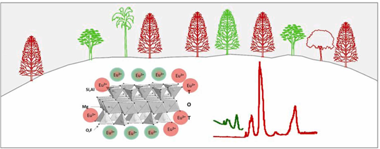
High charge mica Na4Al4Si4Mg6O20F4 , Mica-4, is a promising candidate as a filling material to immobilize high-level radioactive waste in deep geological repositories due to its extraordinary adsorption capacity. In contrast to traditional clay materials, the structural composition of this mica, with a high content of alu-minum in the tetrahedral sheet, enhances its chemical reactivity, favoring the formation of new crystalline phases under mild hydrothermal conditions, and thus providing a definitive isolation of the radionuclides in the engineered barrier. Moreover, this synthetic clay has some features that allow its use as an optical sensor by doping with luminescent rare earth cations such as Eu3+. In this paper we discuss the local structure of the nanoclay Mica-4 using Eu3+ as a local probe to track the physical and chemical modifica-tions under hydrothermal conditions. For that purpose, a set of hydrothermal experiments has been carried out heating Mica-4 and an aqueous Eu(NO3)(3) solution in a stainless steel reactor at different temperatures and times. Optical properties of the as-treated samples were characterized by spectroscopic measurements. The fine peak structure of emission and the relative intensity of different Eu3+ transitions as well as the luminescence lifetime have been correlated with the structure and composition of this nanoclay, and the interaction mechanisms between the lanthanide ions and the clay mineral at different temperatures and times. Special attention has been paid to understanding the role of the aluminum content, which may act as either an aggregating or dispersing agent, in the optical features and reactivity of the system.
Effect of sintering under CO+N-2/H-2 and CO2+air atmospheres on the physicochemical features of a commercial nano-YSZ
Colomer, M.T.; Simenas, M.; Banys, J.; Vattier, F.; Gagor, A.; Maczka, M.
Journal of Alloys and Compounds, 904 (2022) 163976 | DOI: 10.1016/j.jallcom.2022.163976
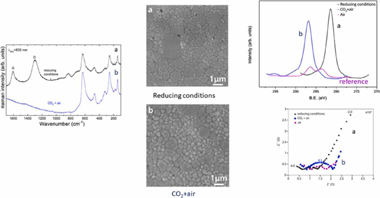
Given the need to process anodes and composites based on nano-YSZ in reducing or in air containing additional CO2 atmospheres for the fabrication of solid oxide fuel cells (SOFCs), and solid oxide electrolysis cells (SOECs), we have studied the effect of the exposure to CO+N2/H2 or CO2+air mixtures during sintering of YSZ green pellets, prepared from commercial nanopowders, on their structure, microstructure, chemical composition and their electrical properties. The reduced sample shows Raman bands at 1298 and 1605 cm−1 that are assigned to the D and G bands of carbon, respectively. The bands intensity ratio ID/IG indicates a larger content of disordered carbon. X-ray photoelectron spectroscopy (XPS) shows that C is present in the reduced samples as reduced carbon. However, the samples sintered in CO2+air present C as carbonate-type. Impedance spectroscopy reveals that the highest total conductivity is for the reduced samples in the whole range of studied temperatures. In addition, sintering in CO2+air causes a detrimental effect on the grain boundary conductivity and therefore, on the total electrical conductivity of YSZ. It can be due to the presence of impurities such as carbonates and oxidised or even, polymerised carbonaceous species located at those areas.
Reactive flash sintering of SrFe12O19 ceramic permanent magnets
Manchon-Gordon, AF; Sanchez-Jimenez, PE; Blazquez, JS; Perejon, A; Perez-Maqueda, LA
Journal of Alloys and Compounds, 922 (2022) 166203 | DOI: 10.1016/j.jallcom.2022.166203
Reactive flash-sintering technique has been used in order to obtain strontium ferrite magnets from a mixture of SrCO3 and Fe2O3 commercial powders. This technique allows preparing sintered SrFe12O19 at a furnace temperature of just 973 K during just 2 min by applying a modest field of 40 V cm(-1), instead of the conventional sintering process employed in ferrite magnet manufacturing that demands high temperature and long dwell times. Analysis of structural and magnetic properties were performed as a function of time in which the flash event was held. Mossbauer spectra show the existence of five different kinds of local environments, confirming the formation of strontium hexaferrite. The resulting samples exhibit comparable magnetic properties to the state-of-the-art ferrite magnets. In particular, produced samples reach a coercivity of 0.4 T and a specific saturation magnetization of 70 Am-2 kg(-1).
Comparative study of alkali activated cements based on metallurgical slags, in terms of technological properties developed
Gomez-Casero, MA; Perez-Villarejo, L; Sanchez-Soto, PJ; Eliche-Quesada, D
Sustainable Chemistry and Pharmacy, 29 (2022) 100746 | DOI: 10.1016/j.scp.2022.100746
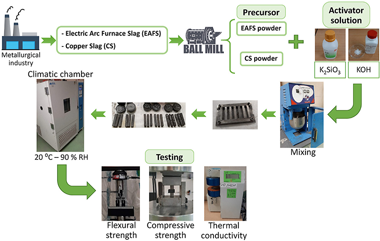
In this work, an investigation on the use of two slags from different origins (electric arc furnace slag (EAFS) and copper slag (CS)) as raw materials in the manufacture of alkali-activated cements has been carried out. A comparison of the different mechanical properties developed by the alkaline activation of each raw material has been studied. Combination of 35 wt% potassium hydroxide (KOH) solution with different concentration (5, 8, 12 and 15 M) and 65 wt% potassium silicate (K2SiO3) solution was used as activating solution to manufacture alkali activated cements. The pastes were cured 24 h in a climatic chamber at 20 ºC at 90% of relative humidity, subsequently demoulded and cured at same condition during 1, 7, 28 and 90 days. Alkali activated materials have been characterized using Fourier transform infrared spectroscopy (FTIR), X-ray diffraction (XRD) and scanning electron microscopy (SEM). The physical properties: bulk density, water absorption and apparent porosity, mechanical properties, flexural strength and compressive strength and thermal properties: thermal conductivity have been determined. The results indicate that two types of slags studied are a suitable source of aluminosilicates that can be activated for the manufacture of alkali-activated materials. These precursors are capable of developing high values of flexural and compressive strength and low values of thermal conductivity when optimal concentration of KOH was used. The optimal composition was developed when CS was utilized. Binders with CS and 12 M M ratio achieved compressive strength values up to 70 MPa.
Structure effect of modified biochar in Ru/C catalysts for sugar mixture hydrogenation
Santos, JL; Sanz-Moral, LM; Aho, A; Ivanova, S; Murzin, DY; Centeno, MA
Biomass & Bioenergy, 163 (2022) 106504 | DOI: 10.1016/j.biombioe.2022.106504
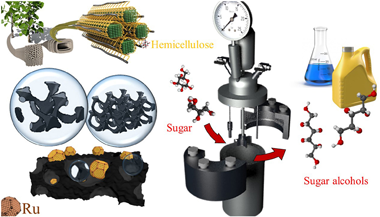
This study deals with the production and activation of biochars and their use as supports for a series of ruthenium catalysts for hydrogenation of L-arabinose/D-galactose sugar mixture. The synthesized biochars differ in physicochemical properties and surface chemistry influencing ruthenium metal uptake and dispersion and as a consequence its catalytic behaviour. Selectivity exceeding 95% was observed for both hexitols. The catalytic performance of the prepared Ru supported catalysts is also compared to the already known Ru/activated carbon commercial catalyst.
Titania Enhanced Photocatalysis and Dye Giant Absorption in Nanoporous 1D Bragg Microcavities
Rico, VJ; Turk, H; Yubero, F; González-Elipe, AR
ACS Applied Nano Materials, 5 (2022) 5487-5497 | DOI: 10.1021/acsanm.2c00477
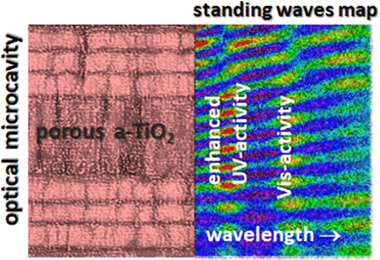
Light trapping effects are known to boost the photocatalytic degradation of organic molecules in 3D photonic structures of anatase titania (a-TiO2) with an inverse opal configuration. In the present work, we show that photocatalytic activity can also be enhanced in a-TiO2 thin films if they are incorporated within a nanoporous 1D optical resonant microcavity. We have designed and manufactured multilayer systems that, presenting a high open porosity to enable a straightforward diffusion of photodegradable molecules, provide light confinement effects at wavelengths around the absorption edge of photoactive a-TiO2. In brief, we have observed that a nanoporous 1D Bragg microcavity prepared by electron beam evaporation at oblique angles comprising a central defect layer of nanoporous a-TiO2 boosts the photocatalytic degradation of nitrobenzene and methyl orange dye solutions. The multilayer structure of the microcavity was designed to ensure the appearance of optical resonances at the a-TiO2 layer location and wavelengths around the absorption onset of this semiconductor. In this porous 1D Bragg microcavity, the diffusion constraints of molecules through the capping layers covering the a-TiO2 are effectively compensated by an increase in the photocatalytic activity due to the light confinement phenomena. We also report that the absorption coefficient of methyl orange dye solution infiltrated within the pore structure of the microcavity is exalted at the wavelengths of the corresponding optical resonances. This effect gives rise to a small but non-negligible visible light photodegradation of dye molecules. The possibilities of tailoring the design of 1D photonic systems to boost the photocatalytic activity of a-TiO2 are discussed.
Nanoantennas Patterned by Colloidal Lithography for Enhanced Nanophosphor Light Emission
Viana, JM; Romero, M; Lozano, G; Míguez, H
ACS Applied Nano Materials, 5(11) (2022) 16242-16249 | DOI: 10.1021/acsanm.2c03258
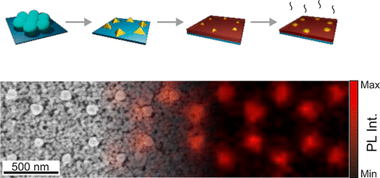
Transparent coatings made of rare-earth doped nanocrystals, also known as nanophosphors, feature efficient photoluminescence and excellent thermal and optical stabi l i t y . Herein, we demonstrate that the optical antennas prepared by colloidal lithography render thin nanophosphor films with a brighter emission. In particular, we fabricate gold nanostructures in the proximity of GdVO4:Eu3+ nanophosphors by metal evaporation using a mask made of a monolayer of polymer beads arranged in a triangular lattice. Optical modes supported by the antennas can be controlled by tuning the diameter of the polymer spheres in the colloidal mask, which determines the shape of the gold nanostructure, as confirmed by numerical simulations. Confocal microscopy reveals that metallic antennas induce brighter photoluminescence at specific spatial regions of the nanophosphor film at targeted frequencies as a result of the coupling between gold nanostructures and nanophosphors. Patterning of nanophosphor thin layers with arrays of metallic antennas offers an inexpensive nanophotonic solution to develop bright emitting coatings of interest for color conversion, labeling , or anti-counterfeiting.
Effect of Spatial Inhomogeneity on Quantum Trapping
Esteso, V; Carretero-Palacios, S; Miguez, H
Journal of Physical Chemistry Letters, 13 (2022) 4513-4519 | DOI: 10.1021/acs.jpclett.2c00807
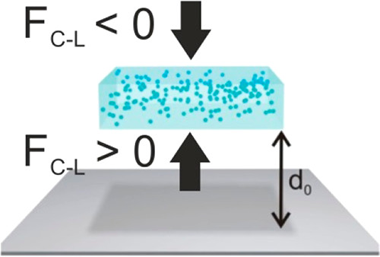
An object that is immersed in afluid and approaching a substrate mayfind apotential energy minimum at a certain distance due to the balance between attractive and repulsiveCasimir-Lifshitz forces, a phenomenon referred to as quantum trapping. This equilibriumdepends on the relative values of the dielectric functions of the materials involved. Herein, westudy quantum trapping effects in planar nanocomposite materials and demonstrate that they arestrongly dependent on the characteristics of the spatial inhomogeneity. As a model case, weconsider spherical particles embedded in an otherwise homogeneous material. We propose aneffective medium approximation that accounts for the effect of inclusions andfind that anunprecedented and counterintuitive intense repulsive Casimir-Lifshitz force arises as a result ofthe strong optical scattering and absorption size-dependent resonances caused by their presence. Our results imply that the properanalysis of quantum trapping effects requires comprehensive knowledge and a detailed description of the potential inhomogeneity(caused by imperfections, pores, inclusions, and density variations) present in the materials involved
Highly efficient electrical discharge machining of yttria-stabilized zirconia ceramics with graphene nanostructures as fillers
Muñoz-Ferreiro, C; Lopez-Pernia, C; Moriche, R; Gommeringer, A; Kern, F; Poyato, R; Gallardo-Lopez, A
Journal of the European Ceramic Society, 42 (2022) 5943-5952 | DOI: 10.1016/j.jeurceramsoc.2022.06.037
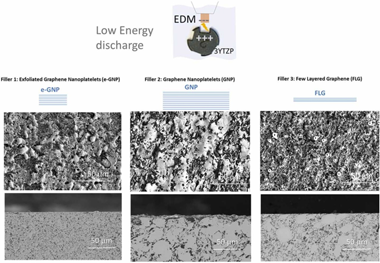
Electrical-discharge machining (EDM) of advanced ceramics allows the miniaturization of parts with complex shapes. Since electrical conductivity is required, non-conductive ceramics need a conductive second phase. This work assesses the feasibility of industrial EDM in advanced yttria-stabilized tetragonal zirconia (3YTZP) composites with 20 vol% graphene nanostructures with different morphology using different EDM energies. The structural integrity of the graphene nanostructures, the roughness of the machined surfaces and the geometrical tolerances have been evaluated by Raman spectroscopy, confocal microscopy and scanning electron microscopy, showing that it is possible to obtain a stable and efficient EDM process in these composites using low electrode energies. The use of the largest and thickest graphene nanostructures led to the best performance in terms of EDM machinability, the smallest nanostructures produced the best surface finish for low electrode energy and the thinnest nanostructures allowed the highest material removal rate at medium energy in the composites.
Ageing-resistant zirconia/graphene-based nanostructures composites for use as biomaterials
Morales-Rodriguez, A; Gonzalez-Orellana, C; Perez-Garcia, AA; Lopez-Pernia, C; Munoz-Ferreiro, C; Poyato, R; Gallardo-Lopez, A
Journal of the European Ceramic Society, 42 (2022) 1784-1795 | DOI: 10.1016/j.jeurceramsoc.2021.11.060
This work explores the incorporation of graphene-based two-dimensional nanostructures as moisture barriers to delay hydrothermal ageing of yttria-stabilized zirconia and strengthen its use in biomedical applications. Two sets of highly dense zirconia composites incorporating multilayered graphene with very different lateral dimensions, few layer graphene and exfoliated graphene nanoplatelets, were prepared. The effect of the addition of graphene nanostructures on zirconia ageing was investigated by conducting accelerated hydrothermal degradation experiments in an autoclave. An improved resistance to low-temperature degradation and a high tolerance to damage were achieved in the composites compared to those of monolithic zirconia. The incorporation of 1 vol% multilayered graphene was very effective in restricting the hydrothermal degradation. In particular, the composite incorporating exfoliated graphene nanosheets exhibited outstanding resistance to ageing because of their fine dispersion throughout the matrix, which effectively seemed to restrict grain growth and slow the propagation of the transformation front to the ceramic bulk.
Theoretical Analysis of Polynuclear Zinc Complexes Isolobally Related to Hydrocarbons
Ayala, R; Galindo, A
International Journal of Molecular Sciences, 23 (2022) 14858 | DOI: 10.3390/ijms232314858
Based on the isolobal analogy of ZnCp (Cp = eta(5)-C5H5) and ZnR (R = alkyl or aryl group) fragments with hydrogen atom and fragment [Zn(CO)(2)] with a CH2 carbene, the following complexes [(ZnCp)(2){mu-Zn(CO)(2)}], 1, [(ZnPh)(2){mu-Zn(CO)(2)}], 2, [(ZnPh){mu-Zn(CO)(2)}(ZnCp)], 3, [(ZnCp)(2){mu-Zn-2(CO)(4)}], 4, [(ZnPh)(2){mu-Zn-2(CO)(4)}], 5, [(ZnPh){mu-Zn(CO)(2)}(2)(ZnCp)], 6, [Zn-3(CO)(6)], 7 and [Zn-5(CO)(10)], 8, were built. These polynuclear zinc compounds are isolobally related to simple hydrocarbons (methane, ethane, cyclopropane and cyclopentane). They have been studied by density functional theory (DFT) and quantum theory of atoms in molecules (QTAIM) to compare the nature and topology of the Zn-Zn bond with previous studies. There are bond critical points (BCPs) between each pair of adjacent Zn centers in complexes 1-8 with Zn-Zn distances within the range 2.37-2.50 angstrom. The nature of the Zn-Zn bond in these complexes can be described as polar rather than pure covalent bonds. Although in a subtle way, the presence of different ligands and zinc oxidation states introduces asymmetry and polarity in the Zn-Zn bond. In addition, the Zn-Zn bond is delocalized in nature in complex 7 whereas it can be described as a localized bond for the remaining zinc complexes here studied.
The Response of Tomato Fruit Cuticle Membranes Against Heat and Light
Benitez, JJ; Moreno, AG; Guzman-Puyol, S; Heredia-Guerrero, JA; Heredia, A; Dominguez, E
Frontiers in Plant Science, 12 (2022) 807723 | DOI: 10.3389/fpls.2021.807723
Two important biophysical properties, the thermal and UV-Vis screening capacity, of isolated tomato fruit cuticle membranes (CM) have been studied by differential scanning calorimetry (DSC) and UV-Vis spectrometry, respectively. A first order melting, corresponding to waxes, and a second order glass transition (T-g) thermal events have been observed. The glass transition was less defined and displaced toward higher temperatures along the fruit ripening. In immature and mature green fruits, the CM was always in the viscous and more fluid state but, in ripe fruits, daily and seasonal temperature fluctuations may cause the transition between the glassy and viscous states altering the mass transfer between the epidermal plant cells and the environment. CM dewaxing reduced the T-g value, as derived from the role of waxes as fillers. T-g reduction was more intense after polysaccharide removal due to their highly interwoven distribution within the cutin matrix that restricts the chain mobility. Such effect was amplified by the presence of phenolic compounds in ripe cuticle membranes. The structural rigidity induced by phenolics in tomato CMs was directly reflected in their mechanical elastic modulus. The heat capacity (Cp-rev) of cuticle membranes was found to depend on the developmental stage of the fruits and was higher in immature and green stages. The average Cp-rev value was above the one of air, which confers heat regulation capacity to CM. Cuticle membranes screened the UV-B light by 99% irrespectively the developmental stage of the fruit. As intra and epicuticular waxes contributed very little to the UV screening, this protection capacity is attributed to the absorption by cinnamic acid derivatives. However, the blocking capacity toward UV-A is mainly due to the CM thickness increment during growth and to the absorption by flavone chalconaringenin accumulated during ripening. The build-up of phenolic compounds was found to be an efficient mechanism to regulate both the thermal and UV screening properties of cuticle membranes.
Monitoring the Simultaneous Implantation of Ti and Tb Cations to a Sacrificial Template and the Sol-Gel Synthesis of Tb-Doped TiO2 (Anatase) Hollow Spheres and Their Transition to Rutile Phase
Colomer, MT; Vattier, F
International Journal of Molecular Sciences, 23 (2022) 13162 | DOI: 10.3390/ijms232113162
Tb-doped TiO2 (anatase) micro-hollow spheres (HSs) with nano-shells, in the range 0.00-3.00 at.% Tb, were successfully synthesized by a simultaneous chemical implantation route of both Ti and Tb cations from chlorides to a poly-styrene (PST)-co-poly-divinyl benzene (PDVB) sacrificial template, followed by controlled hydrolysis and polycondensation reactions. After water addition to the mixture of the precursors with the template, a decrease in the intensity and a shift to lower wavenumbers of the C=O absorption band in the IR spectra can indicate not only the anchoring of Ti and Tb ions to the carbonyl group of the template but also the hydrolysis of the implanted precursors. This latter process can involve a proton attack on the Ti-Cl, Tb-Cl and C=O bonds, the occupation of a vacant site by a water molecule, and then the dissociation of the dangling Ti-Cl, Tb-Cl ligands and C=O bonds. It gives rise to Ti1-xTbx[(OH)(4-u)Cl-v]@PST-PDVB and Ti1-xTbx[(OH)(4-y)]@PST-PDVB complexes (x = 0.00, 0.0012, 0.0170 and 0.030). Finally, polycondensation of these species leads to Ti1-xTbxO2-w'@PST-PDVB compounds. After subsequent thermal removal at 550 degrees C of the template, the IR bands of the core (template) totally vanished and new bands were observed in the 400-900 cm(-1) region which can be attributed to the metalloxane bondings (M-O, M'-O, M-O-M, M-O-M' and/or M'-O-M', being M and M' = Ti and Tb, respectively, i.e., mainly vibration modes of anatase). Then, micron-sized HSs of TiO2 and Tb-doped-TiO2 (anatase) were obtained with nano-shells according to field emission gun scanning electron microscopy (FEG-SEM) and transmission electron microscopy (TEM) observations. Furthermore, X-ray photoelectron spectroscopy (XPS) measurements confirmed the presence of Tb4+ (38.5 and 41.2% for 1.70 and 3.00 at.% Tb, respectively) in addition to Tb3+ in the resulting HSs, with increasing Tb4+ content with both Tb doping and higher calcination temperatures. Then, these HSs can be considered as rare earth (RE) co-doped systems, at least for 1.70 and 3.00 at.% Tb contents being the transition to rutile phase favored by Tb doping for those compositions. Finally, diffusion of Tb from the inner parts to the surface of the HSs with the calcination treatments was also observed by XPS.
The effect of support surface hydroxyls on selective CO methanation with Ru based catalysts
Martínez, LMT; Muñoza, A; Pérez, A; Laguna, OH; Bobadilla, LF; Centeno, MA; Odriozola, JA
Applied Catalysis A: General, 641 (2022) 118678 | DOI: 10.1016/j.apcata.2022.118678
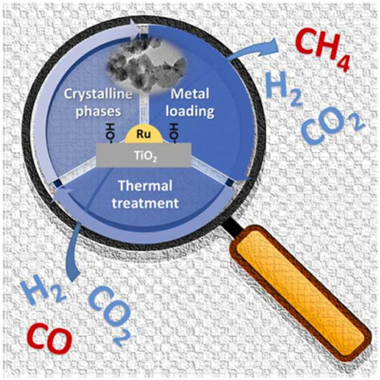
The aim of this work was to clarify the effect of the support on CO selective methanation with Ru/TiO2 catalysts. TPR, XRD and TEM measurements confirmed that the changes in the activity and selectivity should be ascribed to anatase:rutile ratio, RuO2 +TiO2 solid solution formation, as well as the metal content and the thermal treatment used. All these characteristics result in active and selective catalysts in which the suppression of the reverse water gas shift reaction was observed. The catalytic performance must be explained by both the formation of more active Ru species as a result of support influence and the higher Ru dispersion. The study allows to conclude that for CO activation the role of support surface hydroxyls seems to be determinant for both the activity and selectivity of Ru/TiO2 catalysts.
Emerging natural and tailored perovskite-type mixed oxides-based catalysts for CO2 conversions
Wu, J; Ye, RP; Xu, DJ; Wan, LZ; Reina, TR; Sun, H; Ni, Y; Zhou, ZF; Deng, XA
Frontiers in Chemistry, 10 (2022) 961355 | DOI: 10.3389/fchem.2022.961355
The rapid economic and societal development have led to unprecedented energy demand and consumption resulting in the harmful emission of pollutants. Hence, the conversion of greenhouse gases into valuable chemicals and fuels has become an urgent challenge for the scientific community. In recent decades, perovskite-type mixed oxide-based catalysts have attracted significant attention as efficient CO2 conversion catalysts due to the characteristics of both reversible oxygen storage capacity and stable structure compared to traditional oxide-supported catalysts. In this review, we hand over a comprehensive overview of the research for CO2 conversion by these emerging perovskite-type mixed oxide-based catalysts. Three main CO2 conversions, namely reverse water gas shift reaction, CO2 methanation, and CO2 reforming of methane have been introduced over perovskite-type mixed oxide-based catalysts and their reaction mechanisms. Different approaches for promoting activity and resisting carbon deposition have also been discussed, involving increased oxygen vacancies, enhanced dispersion of active metal, and fine-tuning strong metal-support interactions. Finally, the current challenges are mooted, and we have proposed future research prospects in this field to inspire more sensational breakthroughs in the material and environment fields.
Insights on Guerbet Reaction: Production of Biobutanol From Bioethanol Over a Mg-Al Spinel Catalyst
Crespo, MAP; Vidal-Barrero, F; Azancot, L; Reina, TR; Campoy, M
Frontiers in Chemistry, 10 (2022) 945596 | DOI: 10.3389/fchem.2022.945596
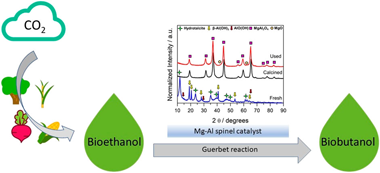
The production of biobutanol from bioethanol by the Guerbet reaction is an alternative pathway to renewable sources. The commercial viability of this green route requires improvements in the process development. This study experimentally examines the influence of operating conditions on the performance of a Mg-Al spinel catalyst prepared from hydrotalcite precursors. This catalyst demonstrates an exceptional performance in the Guerbet reaction with a promising activity/butanol selectivity balance, excellent long-term stability, and very-low-carbon footprint (CO2 generation as by-products is minimal). This study showcases a systematic strategy to optimize the reaction parameters in the Guerbet reaction for biobutanol production using an advanced spinel catalyst. Upon carefully adjusting temperature, pressure, space velocity, and reactants co-feeding, very promising conversion (35%) and butanol selectivity values (48%) were obtained.
Tuning the co-catalyst loading for the optimization of thermo-photocatalytic hydrogen production over Cu/TiO2
Platero, F; Caballero, A; Colon, G
Applied Catalysis A-General, 643 (2022) 118804 | DOI: 10.1016/j.apcata.2022.118804
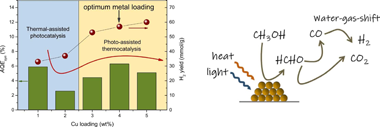
We have optimized the H-2 production by methanol thermo-photocatalytic reforming in the gas phase using Cu/TiO2 catalyst by tuning metal loading. Metal co-catalyst has been deposited by means of chemical reduction deposition. We have stated that thermo- and thermo-photocatalytic process leads to a notable H-2 production at 200 C. By in-situ FTIR studies we evidenced that formate formation follows a different evolution depending on the reforming experiment. These surface formate would lead to CO formation through dehydration reaction. At higher Cu content the low CO selectivity denote that water-gas-shift reaction would predominate and exalt H-2 yield. Thus, different optimum Cu content is found for each reforming experiment. While for the photocatalytic reforming Cu/TiO2 (2 wt%) is the best catalyst of the series, we should increase the Cu content to Cu/TiO2 (5 wt%) to achieve the optimum performance for thermo-photocatalytic reforming of methanol.
Performance of AISI 316L-stainless steel foams towards the formation of graphene related nanomaterials by catalytic decomposition of methane at high temperature
Cazana, F; Latorre, N; Tarifa, P; Royo, CJ; Sebastian, V; Romeo, E; Centeno, MA; Monzon, A
Catalysis Today, 383 (2022) 236-246 | DOI: 10.1016/j.cattod.2020.12.003
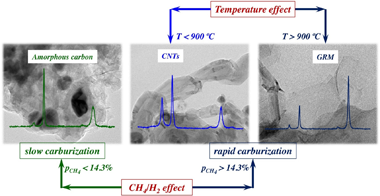
This work explores the preparation of graphene-related materials (GRMs) grown on stainless steel foams via catalytic decomposition of methane (CDM). The main active phases for the reaction are the Fe nanoparticles segregated from the stainless-steel after the activation stage of the foam. The effect of the feed composition and reaction temperature has been studied in order to maximize the productivity, stability and selectivity to GRMs. The maximum productivity attained was 0.116 g(C)/g(foam) h operating at 950 degrees C with a feed ratio of CH4/H-2 = 3 (42.9 %CH4:14.3 %H-2). The carbonaceous nanomaterials (CNMs) obtained were characterized by X-Ray diffraction, Raman spectroscopy and by transmission and scanning electron microscopy. The parameters of the kinetic model developed are directly related to the relevant stages of the process, including carburization, diffusion-precipitation and deactivation-regeneration. The balance among these sequential stages determines the overall performance of the activated foam. In conditions of rapid carburization of the Fe NPs (p(CH4) > 14 %), the productivity to CNMs is favoured, avoiding an initial deactivation of the active sites by fouling with amorphous carbon. After a rapid carburization, the selectivity to the different CNMs is governed by the ratio CH4/H-2, and mainly by the temperature. Thus, the formation of GRMs, mainly Few Layer Graphene (FLG) and even graphene, is favoured at temperatures above 900 degrees C. At lower temperatures, carbon nanotubes are formed.
Boosting water activation determining-step in WGS reaction on structured catalyst by Mo-doping
Garcia-Moncada, N; Jurado, L; Martinez-Tejada, LM; Romero-Sarria, F; Odriozola, JA
Catalysis Today, 383 (2022) 193-204 | DOI: 10.1016/j.cattod.2020.06.003
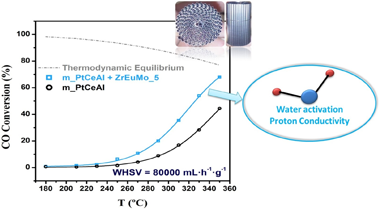
Proton conductors Mo-Eu-Zr mixed oxide systems were synthesized and further mixed with a conventional Pt/CeO2/Al2O3 catalyst to develop a highly efficient water-gas-shift (WGS) catalyst. The designed catalyst, once structured, allows reach the equilibrium conversion at medium temperatures (similar to 350 degrees C) at 80 L.g(-1) h(-1) space velocity. The ability of the proton conductor to maintain an elevated water concentration at the metal-support interface by Grotthuss' mechanism boosts the catalytic activity in WGS reaction.
The Mo-containing proton conductor is extensively characterized allowing to establish the formation of molybdenum oxide phases nucleating on top of the Eu sites in Eu-Zr oxide solid solution. [MoO4](2-) to [Mo7O24](6-) clusters nucleates at low Mo contents resulting in a alpha-MoO3 layer on increasing its content. In presence of H-2, Mobronzes are formed from similar to 200 degrees C enhancing water concentration at the surfaces and boosting the catalytic activity in the WGS reaction. These results pave the way for developing lower volume WGS reactors.
Fast photodegradation of rhodamine B and caffeine using ZnO-hydroxyapatite composites under UV-light illumination
KarimTanji, J.A.Navio, Abdellah Chaqroune, Jamal Naja, F.Puga, M.C.Hidalgo, AbdelhakKherbeche
Catalysis Today, 388 (2022) 176-186 | DOI: 10.1016/j.cattod.2020.07.044
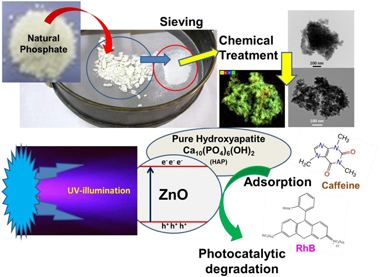
Zinc oxide-hydroxyapatite composites were prepared using wet impregnation method. Firstly, a natural phosphate ore rich in silica and calcium phosphate was sieved to separate silica phase from phosphate phase. Then, through a chemical precipitation method, a pure hydroxyapatite (HAP) was obtained, which was used as a support for ZnO immobilization and applied for the photodegradation of two toxic contaminants: a transparent molecule (caffeine) and dye molecule (rhodamine B). During the present work two weight ratio percentages of zinc oxide were used: 25 wt.% and 50 wt.% of ZnO relative to HAP. The samples were characterized by X-ray diffraction (XRD), Fourier Transform Infrared (FTIR), X-ray Fluorescence (XRF), BET surface area (SBET), Scanning Electron Microscopy (SEM-EDS) and by Transmission Electron Microscopy (TEM-STEM). The immobilization of ZnO on HAP surface followed by thermal treatment at 400 °C for 2 h to get a homogenous dispersion of ZnO on the hydroxyapatite support. At high ZnO impregnation percentage, photodegradation performances of ZnO-HAP under UV illumination were fast and superior than the ZnO photocatalyst alone. The results showed that due to the presence of HAP, the conversion of both molecules became faster and greater, since it promotes the synergic phenomena of adsorption and photocatalysis. The toxicity of the treated substrate solutions obtained in the corn kernels germination test indicated a low toxicity after the photodegradation processes, probably due to a high mineralization degree.
Metal micromonoliths for the cleaning of H-2 by means of methanation reactions
Laguna, OH; Munoz-Murillo, A; Bobadilla, LF; Martinez, LM; Montes, M; Centeno, MA; Odriozola, JA
Catalysis Today, 383 (2022) 216-225 | DOI: 10.1016/j.cattod.2021.04.026
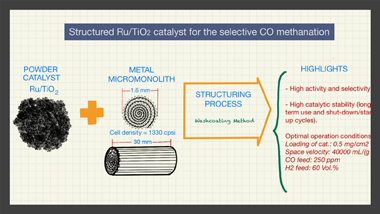
The present manuscript presents for the first time the structuring of a Ru/TiO2 catalyst that was achieved by means of the washcoating procedure using homemade metal micromonoliths (Fecralloy (R)) of 1330 cpsi. For this, an optimized formulation of the slurried catalyst as well as a reproducible protocol for the coating of the micromonoliths were successfully achieved. The obtained structured systems were tested in the selective CO methanation reaction and the effect of different variables over the catalytic performance were analyzed such as the amount of loaded catalyst in the micromonoliths, the temperature of reaction, the space velocity, and the amount of CO and H-2 within the feed-stream. The study of all of these parameters allowed to establish optimal conditions to maximize the performance of the structured Ru/TiO2 catalyst and subsequently, this was tested under those cited conditions in long-term tests (similar to 375 h), including shut-down/start-up cycles, aiming to evaluate its catalytic stability. The system presented a considerable stability along the different test without loss of catalytic activity, being specially remarkable its resistance to the inclusion of shut-down/start-up cycles. Therefore, this study lays the foundations for future development of more sophisticated structured systems for the selective CO methanation based on the structuring strategy proposed.
Multiscale Kinetic Monte Carlo Simulation of Self-Organized Growth of GaN/AlN Quantum Dots
Budagosky, JA; García-Cristobal, A
Nanomaterials, 12 (2022) 3052 | DOI: 10.3390/nano12173052
A three-dimensional kinetic Monte Carlo methodology is developed to study the strained epitaxial growth of wurtzite GaN/AlN quantum dots. It describes the kinetics of effective GaN adatoms on an hexagonal lattice. The elastic strain energy is evaluated by a purposely devised procedure: first, we take advantage of the fact that the deformation in a lattice-mismatched heterostructure is equivalent to that obtained by assuming that one of the regions of the system is subjected to a properly chosen uniform stress (Eshelby inclusion concept), and then the strain is obtained by applying the Green's function method. The standard Monte Carlo method has been modified to implement a multiscale algorithm that allows the isolated adatoms to perform long diffusion jumps. With these state-of-the art modifications, it is possible to perform efficiently simulations over large areas and long elapsed times. We have taylored the model to the conditions of molecular beam epitaxy under N-rich conditions. The corresponding simulations reproduce the different stages of the Stranski-Krastanov transition, showing quantitative agreement with the experimental findings concerning the critical deposition, and island size and density. The influence of growth parameters, such as the relative fluxes of Ga and N and the substrate temperature, is also studied and found to be consistent with the experimental observations. In addition, the growth of stacked layers of quantum dots is also simulated and the conditions for their vertical alignment and homogenization are illustrated. In summary, the developed methodology allows one to reproduce the main features of the self-organized quantum dot growth and to understand the microscopic mechanisms at play.
Design of Full-Temperature-Range RWGS Catalysts: Impact of Alkali Promoters on Ni/CeO2
Gandara-Loe, J; Zhang, Q; Villora-Pico, JJ; Sepulveda-Escribano, A; Pastor-Perez, L; Reina, TR
Energy & Fuels, 36 (2022) 6362-6373 | DOI: 10.1021/acs.energyfuels.2c00784
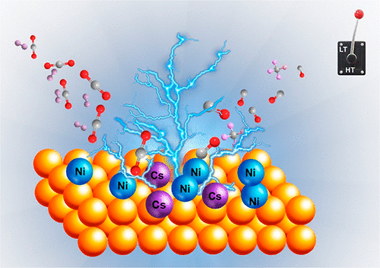
Reverse water gas shift (RWGS) competes with methanation as a direct pathway in the CO2 recycling route, with methanation being a dominant process in the low-temperature window and RWGS at higher temperatures. This work showcases the design of multi-component catalysts for a full-temperature-range RWGS behavior by suppressing the methanation reaction at low temperatures. The addition of alkali promoters (Na, K, and Cs) to the reference Ni/CeO2 catalyst allows identifying a clear trend in RWGS activation promotion in both low- and high-temperature ranges. Our characterization data evidence changes in the electronic, structural, and textural properties of the reference catalyst when promoted with selected dopants. Such modifications are crucial to displaying an advanced RWGS performance. Among the studied promoters, Cs leads to a more substantial impact on the catalytic activity. Beyond the improved CO selectivity, our best performing catalyst maintains high conversion levels for long-term runs in cyclable temperature ranges, showcasing the versatility of this catalyst for different operating conditions. All in all, this work provides an illustrative example of the impact of promoters on fine-tuning the selectivity of a CO2 conversion process, opening new opportunities for CO2 utilization strategies enabled by multi-component catalysts.
Enhanced catalytic activity and stability of nanoshaped Ni/CeO2 for CO2 methanation in micro-monoliths
Garcia-Moncada, N; Navarro, JC; Odriozola, JA; Lefferts, L; Faria, JA
Catalysis Today, 383 (2022) 205-215 | DOI: 10.1016/j.cattod.2021.02.014
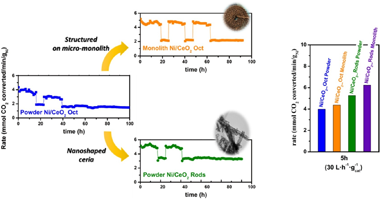
Coupling inherently fluctuating renewable feedstocks to highly exothermic catalytic processes, such as CO2 methanation, is a major challenge as large thermal swings occurring during ON- and OFF- cycles can irreversible deactivate the catalyst via metal sintering and pore collapsing. Here, we report a highly stable and active Ni catalyst supported on CeO2 nanorods that can outperform the commercial CeO2 (octahedral) counterpart during CO2 methanation at variable reaction conditions in both powdered and mu-monolith configurations. The long-term stability tests were carried out in the kinetic regime, at the temperature of maximal rate (300 degrees C) using fluctuating gas hourly space velocities that varied between 6 and 30 L h- 1.gcat- 1. Detailed catalyst characterization by mu-XRF revealed that similar Ni loadings were achieved on nanorods and octahedral CeO2 (c.a. 2.7 and 3.3 wt. %, respectively). Notably, XRD, SEM, and HR-TEM-EDX analysis indicated that on CeO2 nanorods smaller NiClusters with a narrow particle size distribution were obtained (- 7 +/- 4 nm) when compared to octahedral CeO2 (- 16 +/- 13 nm). The fast deactivation observed on Ni loaded on commercial CeO2 (octahedral) was prevented by structuring the reactor bed on mu-monoliths and supporting the Ni catalyst on CeO2 nanorods. FeCrAlloy (R) sheets were used to manufacture a multichannel mu-monolith of 2 cm in length and 1.58 cm in diameter, with a cell density of 2004 cpsi. Detailed catalyst testing revealed that powdered and structured Ni/ CeO2 nanorods achieved the highest reaction rates, c.a. 5.5 and 6.2 mmol CO2 min- 1.gNi - 1 at 30 L h- 1.gcat- 1 and 300 degrees C, respectively, with negligible deactivation even after 90 h of fluctuating operation.
High-Quality SiO2/O-Terminated Diamond Interface: Band-Gap, Band-Offset and Interfacial Chemistry
Canas, J; Reyes, DF; Zakhtser, A; Dussarrat, C; Teramoto, T; Gutierrez, M; Gheeraert, E
Nanomaterials, 12 (2022) 4125 | DOI: 10.3390/nano12234125
Silicon oxide atomic layer deposition synthesis development over the last few years has open the route to its use as a dielectric within diamond electronics. Its great band-gap makes it a promising material for the fabrication of diamond-metal-oxide field effects transistor gates. Having a sufficiently high barrier both for holes and electrons is mandatory to work in accumulation and inversion regimes without leakage currents, and no other oxide can fulfil this requisite due to the wide diamond band-gap. In this work, the heterojunction of atomic-layer-deposited silicon oxide and (100)-oriented p-type oxygen-terminated diamond is studied using scanning transmission electron microscopy in its energy loss spectroscopy mode and X-ray photoelectron spectroscopy. The amorphous phase of silicon oxide was successfully synthesized with a homogeneous band-gap of 9.4 eV. The interface between the oxide and diamond consisted mainly of single- and double-carbon-oxygen bonds with a low density of interface states and a straddling band setting with a 2.0 eV valence band-offset and 1.9 eV conduction band-offset.
Catalytic Upgrading of Biomass-Gasification Mixtures Using Ni-Fe/ MgAl2O4 as a Bifunctional Catalyst
Tarifa, P; Reina, TR; González-Castaño, M; Arellano-Garcia, H
Energy & Fuels, 36 (2022) 8267-8273 | DOI: 10.1021/acs.energyfuels.2c01452

Biomass gasification streams typically contain a mixture of CO, H-2, CH4, and CO(2 )as the majority components and frequently require conditioning for downstream processes. Herein, we investigate the catalytic upgrading of surrogate biomass gasifiers through the generation of syngas. Seeking a bifunctional system capable of converting CO2 and CH4 to CO, a reverse water gas shift (RWGS) catalyst based on Fe/MgAl(2)O(4 )was decorated with an increasing content of Ni metal and evaluated for producing syngas using different feedstock compositions. This approach proved efficient for gas upgrading, and the incorporation of adequate Ni content increased the CO content by promoting the RWGS and dry reforming of methane (DRM) reactions. The larger CO productivity attained at high temperatures was intimately associated with the generation of FeNi3 alloys. Among the catalysts' series, Ni-rich catalysts favored the CO productivity in the presence of CH4, but important carbon deposition processes were noticed. On the contrary, 2Ni-Fe/MgAl2O4 resulted in a competitive and cost-effective system delivering large amounts of CO with almost no coke deposits. Overall, the incorporation of a suitable realistic application for valorization of variable composition of biomass-gasification derived mixtures obtaining a syngas-rich stream thus opens new routes for biosyngas production and upgrading.
Analysis of the effect of cationic ratio Bi3+/Fe3+ on the magnetic and multiferroic properties of BiFeO3 nanoparticles synthesized using a sonochemical-assisted method
Palomino-Resendiz, RL; Bolarin-Miro, AM; Pedro-Garcia, F; Sanchez-De Jesus, F; Espinos-Manzorro, JP; Cortes-Escobes-Escobedo, CA
Ceramics International, 48 (2022) 14746-14753 | DOI: 10.1016/j.ceramint.2022.02.011
This study examined the effects of the cationic ratio of Bi3+/Fe3+ via X-ray photoelectron spectroscopy (XPS) on the magnetic and multiferroic properties of BiFeO3 nanoparticles synthesized using a sonochemical-assisted method. X-ray diffraction revealed the successful synthesis of single-phase BiFeO3 powder after annealing the sonicated material at 723 K. The powder was composed of agglomerates of rounded particles with a mean particle size of 35 nm. XPS was performed to determine the Bi3+/Fe3+ ratio as a function of the heat treatment process and its relationship with secondary phases, which can modulate the magnetic properties of the nano powders. The cationic ratio obtained by XPS confirmed that the powders obtained at 623 and 923 K have excess Bi3+ and Fe3+, respectively, which induces the formation of Bi24Fe2O39 and Bi2Fe4O9 as the majority phases. Powder annealing at 723 K revealed a ferromagnetic order with specific magnetization of 1.8 Am-2/kg. This ferromagnetic behavior was preserved after applying spark plasma sintering (SPS) at 923 K. By contrast, conventional sintering at 1023 K promotes antiferromagnetic order. In addition, the dielectric properties of the ceramic material of the sintered powders showed a behavior related to a typical ferroelectric material.
Vitrification rate and estimation of the optimum firing conditions of ceramic materials from raw clays: A review
Garzon, E; Perez-Villarejo, L; Eliche-Quesada, D; Martinez-Martinez, S; Sanchez-Soto, PJ
Ceramics International, 48 (2022) 15889-15898 | DOI: 10.1016/j.ceramint.2022.02.129
The present work is a review concerning the previous investigations on the vitrification behaviour of clays containing kaolinite, feldspars, muscovite (illite/sericite) and pyrophyllite. These clays are silico-aluminous and have interesting properties as raw materials for structural ceramics. The mineralogical and chemical composition were determined. Then, the vitrification in these clay samples using pressed bodies was investigated by few researchers in the temperature range 800-1350 degrees C with 0.5-5.5 h of soaking times. The effect of heat treatments on the degree of vitrification in these clays was characterized by bulk densities of the ceramic bodies at the fired stage. It was found some variations of bulk density values for all these clays fired in the range 1000-1150 degrees C, with marked decreases of the values obtained at 1200 degrees C and 1300 degrees C. A first order reaction kinetics was applied to the analysis of vitrification of the ceramic bodies under isothermal heating. The method is based on experi-mental data of bulk densities, being proposed for the estimation of the relative degree of vitrification resulting from different firing schedules. The analysis considered the temperature dependence of the rate of vitrification following Arrhenius behaviour. Thus, the vitrification activation energy can be obtained. The activation energies for the physical process of vitrification in these clays ranged from 45 to 151 kJ/mol. The relative rates of vitrification or degree of vitrification attained during heating and soaking were calculated. The results suggested that the contribution of vitrification due to heating in all these clays was relatively small compared to the vitrification during soaking. However, it was evidenced that the influence of the particle sizes in the thermal behaviour of these clays cannot be neglected. The vitrification rate equations, as deduced in these previous studies, can be useful tools to estimate the optimum firing conditions of these clays, allowing the extension of this method to other clay types.
Pd supported on defective TiO2 polymorphic mixtures: Effect of metal-support interactions upon glycerol selective oxidation
Rinaudo, MG; Beltran, AM; Fernandez, A; Cadus, LE; Morales, MR
Results in Engineering, 16 (2022) 100737 | DOI: 10.1016/j.rineng.2022.100737
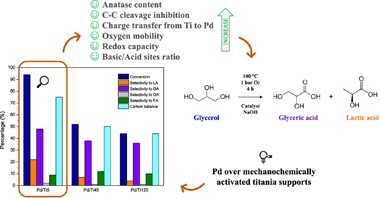
Palladium catalysts supported on defective mixes of anatase, TiO2 (II) and rutile crystalline phases, previously obtained by high-energy ball milling, were synthesized and tested for glycerol selective oxidation. A deep characterization of these unusual materials was carried out to elucidate catalytic and physicochemical features. Electron density transfer from support to metal or vice versa, depending on the polymorphs present, could not only alter palladium particle sizes and its surface oxidation state but also reducibility and oxygen mobility of catalysts. Furthermore, acid-base properties achieved also influenced catalytic activity under mild conditions of liquid-phase glycerol oxidation. A conversion of 94% and a selectivity to glyceric and lactic acids of 48% and 22% respectively were obtained for the Pd catalyst supported on mechanochemically activated anatase. The presence of several polymorphs in a metal oxide support could therefore benefit or handicap catalytic cycle for a particular reaction. Metal-support interactions play a key role in heterogenous catalysts and thus the rational design of supports comes on the scene.
Biopolymer-Based Films Reinforced with FexOy-Nanoparticles
Abdullah, JAA; Jimenez-Rosado, M; Benitez, JJ; Guerrero, A; Romero, A
Polymers, 14 (2022) 4487 | DOI: 10.3390/polym14214487
Nowadays, natural polymer-based films are considered potentially environmentally friendly alternatives to conventional plastic films, due to many advantageous properties, including their easy processability, high flexibility, non-toxicity, low cost, high availability, and environmental safety. However, they are limited in their application by a number of shortcomings, including their high water solubility and vapor permeability as well as their poor opacity and low mechanical resistance. Thus, nanoparticles, such as green FexOy-NPs, can be used to overcome the drawbacks associated with these materials. Therefore, the aim of this study was to develop three different polymer-based films (gelatin-based, cellulose acetate-based and chitosan-based films) containing green synthesized FexOy-NPs (1.0% w/w of the initial polymer weight) as an additive to improve film properties. This was accomplished by preparing the different films using the casting method and examining their physicochemical, mechanical, microstructural, and functional characteristics. The results show that the incorporation of FexOy-NPs into the different films significantly enhanced their physicochemical, mechanical, and morphological properties as well as their antioxidant characteristics. Consequently, it was possible to produce suitable natural polymer-based films with potential applications across a wide range of industries, including functional packaging for food, antioxidants, and antimicrobial additives for pharmaceutical and biomedical materials as well as pesticides for agriculture.
Unravelling the role of Fe in trimetallic Fe-Cu-Pt/Al2O3 catalysts for CO-PROX reaction
Palma, S; Gonzalez-Castano, M; Romero-Sarria, F; Odriozola, JA
Molecular Catalysis, 517 (2022) 112015 | DOI: 10.1016/j.mcat.2021.112015
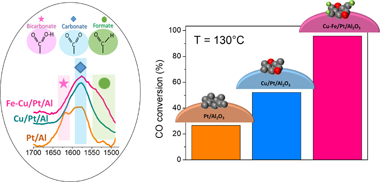
This work proposes a trimetallic Fe-Cu/Pt/Al2O3 catalyst as an appealing system for preferential oxidation of CO (CO-PROX) reaction. The excellent conversion rates achieved by the Fe-Cu/Pt/Al2O3 catalysts under realistic reforming-surrogated feed streams along with the catalyst stability, reproducibility, and scalability showcase a very competitive system for CO-PROX reaction units. Furthermore, the systematic analysis conducted for Pt/Al2O3, Cu/Pt Al2O3, and Fe-Cu/Pt/Al2O3 catalysts enabled establishing meaningful relationships between catalytic behaviour and the catalyst surface to reactants interactions. Thus, the enhanced CO oxidation performances attained by the incorporation of Fe species into bimetallic Cu/Pt/Al2O3 catalysts were associated to superior surface electron densities and inhibited CO adsorption process over Pt surfaces. Remarkably, operando-DRIFTS spectroscopy evidenced significantly larger H-containing surface species developed over the trimetallic system. The enhanced abilities for developing thermally instable intermediates favoured by small amounts of Fe should indeed determine the enhanced catalysts behaviours displayed by the trimetallic Fe-Cu/Pt/Al2O3 catalyst.
Functionalized biochars as supports for Pd/C catalysts for efficient hydrogen production from formic acid
Santos, JL; Megias-Sayago, C; Ivanova, S; Centeno, MA; Odriozola, JA
Applied Catalysis B-Environmental, 282 (2021) 119615 | DOI: 10.1016/j.apcatb.2020.119615
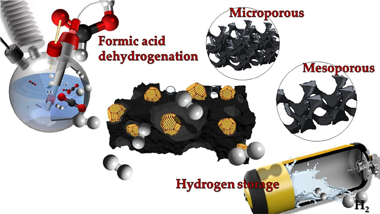
Biomass waste product was used to generate biochars as catalytic supports for selective hydrogen production from formic acid. The supports were obtained after pyrolysis in CO2 atmosphere of non-pretreated and che-mically ZnCl2 activated raw materials (vine shoot and crystalline cellulose). The support series includes materials with different textural properties and surface chemistry. The support nature and especially textural properties firstly affects significantly Pd size and dispersion and its interaction with the support and secondly influence in a great extent the catalytic behavior of the final material. The presence of prevailing mesoporous character appeared to be the most important parameter influencing formic acid dehydrogenation and overall hydrogen production.
Dehydration of glucose to 5-Hydroxymethlyfurfural on bifunctional carbon catalysts
Bounoukta, CE; Megias-Sayago, C; Ammari, F; Ivanova, S; Monzon, A; Centeno, MA; Odriozola, JA
Applied Catalysis B-Environmental, 286 (2021) 119938 | DOI: 10.1016/j.apcatb.2021.119938
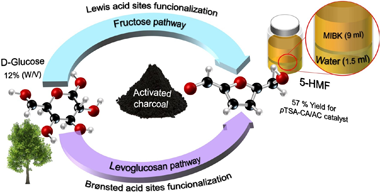
The proposed study tries to reply on one important question concerning glucose dehydration: What is the role of bare or tandem Lewis/Bronsted acid sites in the reaction and which are better? A series of mono and bifunctional catalyst are designed and screened for the glucose dehydration reaction. The results clearly reveal that catalyst activity is a function of catalyst composition. The presence of Lewis sites the reaction toward first step isomerization, while the Brunsted acid dehydrate directly glucose to HMF via levoglucosane intermediate. This study proposed also a kinetic modelling of the included reactions and their contrast with the empirical observations.
IR spectroscopic insights into the coking-resistance effect of potassium on nickel-based catalyst during dry reforming of methane
Azancot, L; Bobadilla, LF; Centeno, MA; Odriozola, JA
Applied Catalysis B-Environmental, 285 (2021) 119822 | DOI: 10.1016/j.apcatb.2020.119822
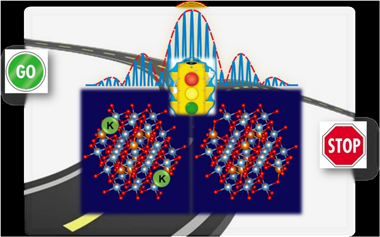
Dry reforming of methane (DRM) is an effective catalytic route for transforming CO2 and CH4 into valuable syngas and thus potentially attractive for mitigating the emission of environmental harmful gases. Therefore, it is crucial to develop rationally Ni-based catalysts highly resistant to coking and sintering. In this scenario, the addition of small amounts of potassium to nickel catalyst increases their resistance to coking during dry reforming of methane. Nonetheless, the specific role of potassium in these catalysts not have been fully understood and there are still important discrepancies between the different reported studies. This work provides a new approach on the anticoking nature of a K-promoted Ni catalyst by means of a combined IR spectroscopic study of in situ characterization by CO adsorption under static conditions and operando DRIFTS measurements under dynamic conditions of DRM reaction. The involved surface species formed during the reaction were elucidated by transient and steady-state operando DRIFTS studies. It was revealed that the existence of Ni-K interfacial sites favours the gasification of carbonaceous deposits towards reverse Boudouard reaction and reduces the sticking probability of CO2 dissociative adsorption. Moreover, the presence of strongly Mg-O-K basic sites leads to the formation of carbonate intermediates that are subsequently reduced into CO gaseous towards the associative mechanism by RWGS reaction. These results provide a fundamental understanding of the relevant anticoking effect of potassium on Ni-based catalysts.
Kinetics and cyclability of limestone (CaCO3) in presence of steam during calcination in the CaL scheme for thermochemical energy storage
Arcenegui-Troya, J; Sanchez-Jimenez, PE; Perejon, A; Moreno, V; Valverde, JM; Perez-Maqueda, LA
Chemical Engineering Journal, 417 (2021) 129194 | DOI: 10.1016/j.cej.2021.129194
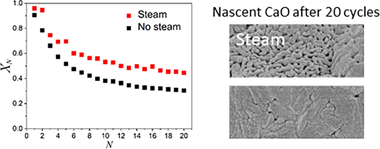
In the present work, we explore the use of steam in the CaCO3 calcination step of the Calcium Looping process devised for thermochemical energy storage (CaL-TCES). Steam produces a double benefit: firstly, it fastens calcination, allowing a reduction of the temperature needed to attain full calcination in short residence times, as those required in practice, resulting in energy savings. This behaviour is justified on the basis of a kinetics study results obtained from a non-parametric kinetic analysis, which demonstrate that the presence of steam during calcination can reduce the apparent activation energy from 175 kJ/mol to 142 kJ/mol with a steam's partial pressure of 29%. In addition, the results obtained for multicycle CaL-TCES tests show that steam alleviates the deactivation of the sorbent, which is one of the main limiting factors of this technology. This behaviour is explained in terms of the effect of steam on the microstructure of the regenerated CaO. Importantly, the values of residual conversion attained by calcining in steam are higher than those without steam.
Calcination under low CO2 pressure enhances the calcium Looping performance of limestone for thermochemical energy storage
Sarrion, B; Perejon, A; Sanchez-Jimenez, PE; Amghar, N; Chacartegui, R; Valverde, JM; Perez-Maqueda, LA
Chemical Engineering Journal, 417 (2021) 127922 | DOI: 10.1016/j.cej.2020.127922
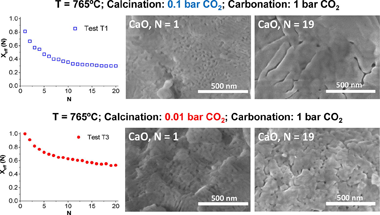
The Calcium Looping performance of limestone for thermochemical energy storage has been investigated under novel favorable conditions, which involve calcination at moderate temperatures under CO2 at low pressure (0.01 and 0.1 bar) and carbonation at high temperature under CO2 at atmospheric pressure. Calcining at low CO2 pressures allows to substantially reduce the temperature to achieve full calcination in short residence times. Moreover, it notably enhances CaO multicycle conversion. The highest values of conversion are obtained for limestone samples calcined under 0.01 bar CO2 at 765 degrees C. Under these conditions, the residual conversion is increased by a factor of 10 as compared to conditions involving calcination under CO2 at atmospheric pressure. The enhancement of CaO conversion is correlated to the microstructure of the CaO samples obtained after calcination. As seen from SEM, BET surface and XRD analysis, calcination under low CO2 pressure leads to a remarkable decrease of pore volume and CaO crystallite size. Consequently, CaO surface area available for carbonation in the fast reaction-controlled regime and therefore reactivity in short residence times is promoted.
Structure-sensitivity of formic acid dehydrogenation reaction over additive-free Pd NPs supported on activated carbon
Santos, J.L.; Megías-Sayago, C.; Ivanova, S.; Centeno, M.A.; Odriozola, J.A.
Chemical Engineering Journal, 420 (2021) 127641 | DOI: 10.1016/j.cej.2020.127641
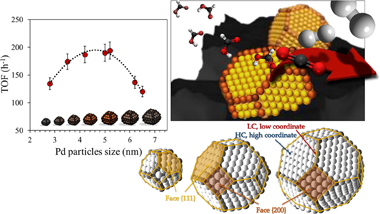
In this study the size-activity dependence of palladium based catalysts in formic acid dehydrogenation reaction was investigated and evaluated. A wide range of particle sizes was considered and the catalyst series were prepared upon variation of some synthetic parameters, precursor and solvent nature in particular. Synthesis method variations affect significantly Pd particle size and results in diverse activity toward hydrogen production. An optimal size was observed and explained by the diverse proportion of low and high coordinated Pd states available for different samples within the series. The evaluation of particles much bigger than 6 nm changes importantly the fraction of high and low coordination atoms and allows the clear confirmation of the importance of the presence of low coordination atoms on the surface of catalyst.
Patterning and control of the nanostructure in plasma thin films with acoustic waves: mechanical vs. electrical polarization effects
García-Valenzuela, A.; Fakhouri, A.; Oliva-Ramírez, M.; Rico-Gavira, V.; Rojas, T.C.; Alvarez, R.; Menzel, S.B.; Palmero, A.; Winkler, A.; González-Elipe, A.R.
Materials Horizons, 8 (2021) 515-524 | DOI: 10.1039/D0MH01540G
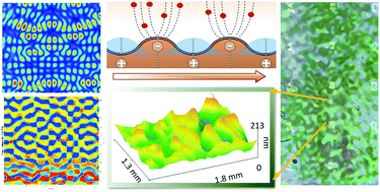
Nanostructuration and 2D patterning of thin films are common strategies to fabricate biomimetic surfaces and components for microfluidic, microelectronic or photonic applications. This work presents the fundamentals of a surface nanotechnology procedure for laterally tailoring the nanostructure and crystalline structure of thin films that are plasma deposited onto acoustically excited piezoelectric substrates. Using magnetron sputtering as plasma technique and TiO2 as case example, it is demonstrated that the deposited films depict a sub-millimetre 2D pattern that, characterized by large lateral differences in nanostructure, density (up to 50%), thickness, and physical properties between porous and dense zones, reproduces the wave features distribution of the generated acoustic waves (AW). Simulation modelling of the AW propagation and deposition experiments carried out without plasma and under alternative experimental conditions reveal that patterning is not driven by the collision of ad-species with mechanically excited lattice atoms of the substrate, but emerges from their interaction with plasma sheath ions locally accelerated by the AW-induced electrical polarization field developed at the substrate surface and growing film. The possibilities of the AW activation as a general approach for the tailored control of nanostructure, pattern size, and properties of thin films are demonstrated through the systematic variation of deposition conditions and the adjustment of AW operating parameters.
Synergizing carbon capture and utilization in a biogas upgrading plant based on calcium chloride: Scaling-up and profitability analysis
Baena-Moreno, FM; Reina, TR; Rodriguez-Galan, M; Navarrete, B; Vilches, LF
Science of The Total Environment, 758 (2021) 143645 | DOI: 10.1016/j.scitotenv.2020.143645
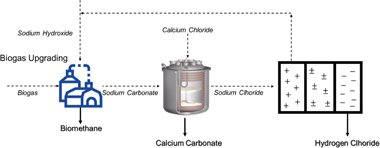
Herein we analyze the profitability of a novel regenerative process to synergize biogas upgrading and carbon dioxide utilization. Our proposal is a promising alternative which allows to obtain calcium carbonate as added value product while going beyond traditional biogas upgrading methods with high thermal energy consumption. Recently we have demonstrated the experimental viability of this route. In this work, both the scale-up and the profitability of the process are presented. Furthermore, we analyze three representative scenarios to undertake a techno-economic study of the proposed circular economy process. The scale-up results demonstrate the technical viability of our proposal. The precipitation efficiency and the product quality are still remarkable with the increase of the reactor size. The techno-economic analysis reveals that the implementation of this circular economy strategy is unprofitable without subsidies. Nonetheless, the results are somehow encouraging as the subsides needed to reach profitability are lower than in other biogas upgrading and carbon dioxide utilization proposals. Indeed, for the best-case scenario, a feed-in tariff incentive of 4.3 (sic)/MWh makes the approach profitable. A sensitivity study through tornado analysis is also presented, revealing the importance of reducing bipolar membrane electrodialysis energy consumption. Overall our study envisages the big challenge that the EU faces during the forthcoming years. The evolution towards bio-based and circular economies requires the availability of economic resources and progress on engineering technologies.
Pb2+, Cd2+ and Hg2+ removal by designed functionalized swelling high-charged micas
Osuna, FJ; Pavon, E; Alba, MD
Science of The Total Environment, 764 (2021) 142811 | DOI: 10.1016/j.scitotenv.2020.142811
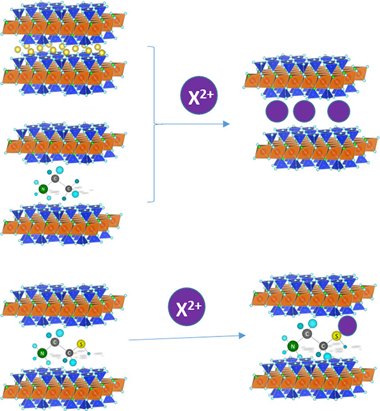
The increasing accumulation of toxic heavy metals in the environment has generated the need of efficient removal systems, being the adsorption method the most popular one applied in aqueous solutions. Of particular concern is the case of Pb2+, Cd2+ and Hg2+ due to their high potential hazard. In this paper, we describe the feasibility of a new family of nanomaterials, swelling high charge micas, in the removal of these cations from aqueous solutions. Batch adsorption experiments were carried out in the as-made micas, NaMn, and after functionalization with ethylammonium, EA-Mn, and mercaptoethylammonium, MEA-Mn. The results have demonstrated that all of them are efficient heavy metal adsorbents, being Na-M2 the best adsorbent for Pb2+ and Cd2+, and, MEA-M2 for Hg2+.
Waterproof-breathable films from multi-branched fluorinated cellulose esters
Tedeschi, G; Guzman-Puyol, S; Ceseracciu, L; Benitez, JJ; Goldoni, L; Koschella, A; Heinze, T; Cavallo, G; Dichiarante, V; Terraneo, G; Athanassiou, A; Metrangolo, P; Heredia-Guerrero, JA
Carbohydrate Polymers, 271 (2021) 118031 | DOI: 10.1016/j.carbpol.2021.118031
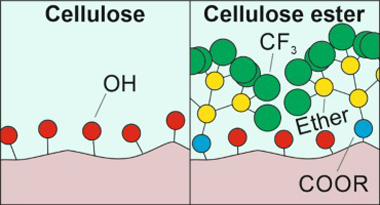
Cellulose ester films were prepared by esterification of cellulose with a multibranched fluorinated carboxylic acid, "BRFA" (BRanched Fluorinated Acid), at different anhydroglucose unit:BRFA molar ratios (i.e., 1:0, 10:1, 5:1, and 1:1). Morphological and optical analyses showed that cellulose-BRFA materials at molar ratios 10:1 and 5:1 formed flat and transparent films, while the one at 1:1 M ratio formed rough and translucent films. Degrees of substitution (DS) of 0.06, 0.09, and 0.23 were calculated by NMR for the samples at molar ratios 10:1, 5:1, and 1:1, respectively. ATR-FTIR spectroscopy confirmed the esterification. DSC thermograms showed a single glass transition, typical of amorphous polymers, at -11 degrees C. The presence of BRFA groups shifted the mechanical behavior from rigid to ductile and soft with increasing DS. Wettability was similar to standard fluoropolymers such as PTFE and PVDF. Finally, breathability and water uptake were characterized and found comparable to materials typically used in textiles.
Structural Evolution in Iron-Catalyzed Graphitization of Hard Carbons
Gomez-Martin, A; Schnepp, Z; Ramirez-Rico, J
Chemistry of Materials, 33 (2021) 3087-3097 | DOI: 10.1021/acs.chemmater.0c04385
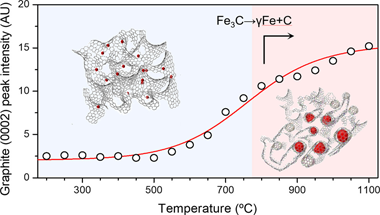
Despite the recent interest in catalytic graphitization to obtain graphite-like materials from hard-carbon sources, many aspects of its mechanism are still poorly unknown. We performed a series of in situ experiments to study phase transformations during graphitization of a hard-carbon precursor using an iron catalyst at temperatures up to 1100 degrees C and ex situ total scattering experiments up to 2000 degrees C to study the structural evolution of the resulting graphitized carbon. Our results show that upon heating and cooling, iron undergoes a series of reductions to form hematite, magnetite, and wustite before forming a carbide that later decomposes into metallic iron and additional graphite and that the graphitization fraction increases with increasing peak temperature. Structural development with temperature results in decreasing sheet curvature and increased stacking, along with a decrease in turbostratic disorder up to 1600 degrees C. Higher graphitization temperatures result in larger graphitic domains without further ordering of the graphene sheets. Our results have implications for the synthesis of novel biomass-derived carbon materials with enhanced crystallinity.
Solid-State Dewetting of Gold on Stochastically Periodic SiO2 Nanocolumns Prepared by Oblique Angle Deposition
Oliva-Ramirez, M; Wang, D; Flock, D; Rico, V; Gonzalez-Elipe, AR; Schaaf, P
ACS Applied Materials & Interfaces, 13 (2021) 11385-11395 | DOI: 10.1021/acsami.0c19327
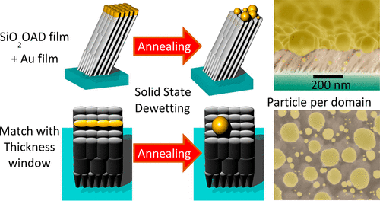
Solid-state dewetting (SSD) on patterned substrates is a straightforward method for fabricating ordered arrays of metallic nanoparticles on surfaces. However, a drawback of this procedure is that the patterning of substrates usually requires time-consuming and expensive two-dimensional (2D) fabrication methods. Nanostructured thin films deposited by oblique angle deposition (OAD) present at the surface a form of stochastically arranged periodic bundles of nanocolumns that might act as a patterned template for fabricating arrays of nanoparticles by SSD. In this work, we explore this concept and investigate the effect of three different types of OAD SiO2 thin films on the SSD of Au deposited on their surface. We demonstrate that the size and spatial distribution of the particles can be tailored through the surface morphology of these OAD film substrates. It has been found that the SSD of the evaporated Au layer gives rise to a bimodal size distribution of particles. A majority of them appeared as mesoparticles with sizes.100 nm and the rest as nanoparticles with similar to 10 nm, respectively, located either on top of the nanocolumns following their lateral distribution (i.e., resulting from a patterning effect) or incorporated inside the open mesopores existing among them. Moreover, on the SiO2-OAD thin films where interconnected nanocolumnar bundles arrange in the form of discrete motifs, the patterning effect gave rise to the formation of approximately one Au mesoparticle per motif, which is one of the assets of patterned SSD. The morphological, optical (i.e., plasmon resonance), and crystalline structural characteristics of Au mesoparticles suggest that the interplay between a discontinuous nanocolumnar surface acting as a template and the poor adhesion of Au onto SiO2 are key factors for the observed template effect controlling the SSD on the surface of OAD thin films.
Highly Versatile Upconverting Oxyfluoride-Based Nanophosphor Films
Ngo, TT; Cabello-Olmo, E; Arroyo, E; Becerro, AI; Ocana, M; Lozano, G; Miguez, H
ACS Applied Materials & Interfaces, 13 (2021) 30051-30060 | DOI: 10.1021/acsami.1c07012
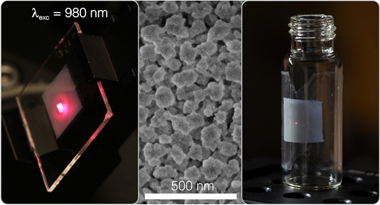
Fluoride-based compounds doped with rare-earth cations are the preferred choice of materials to achieve efficient upconversion, of interest for a plethora of applications ranging from bioimaging to energy harvesting. Herein, we demonstrate a simple route to fabricate bright upconverting films that are transparent, self-standing, flexible, and emit different colors. Starting from the solvothermal synthesis of uniform and colloidally stable yttrium fluoride nanoparticles doped with Yb3+ and Er3+, Ho3+, or Tm3+, we find the experimental conditions to process the nanophosphors as optical quality films of controlled thickness between few hundreds of nanometers and several micrometers. A thorough analysis of both structural and photophysical properties of films annealed at different temperatures reveals a tradeoff between the oxidation of the matrix, which transitions through an oxyfluoride crystal phase, and the efficiency of the upconversion photoluminescence process. It represents a significant step forward in the understanding of the fundamental properties of upconverting materials and can be leveraged for the optimization of upconversion systems in general. We prove bright multicolor upconversion photoluminescence in oxyfluoride-based phosphor transparent films upon excitation with a 980 nm laser for both rigid and flexible versions of the layers, being possible to use the latter to coat surfaces of arbitrary shape. Our results pave the way toward the development of upconverting coatings that can be conveniently integrated in applications that demand a large degree of versatility.
Form Birefringence in Resonant Transducers for the Selective Monitoring of VOCs under Ambient Conditions
Oliva-Ramirez, Manuel; Lopez-Santos, Carmen; Berthon, Hermine; Goven, Mathilde; Portoles, Jose; Gil-Rostra, Jorge; Gonzalez-Elipe, Agustin R.; Yubero, Francisco
ACS Applied Materials & Interfaces, 13 (2021) 19148-19158 | DOI: 10.1021/acsami.1c02499
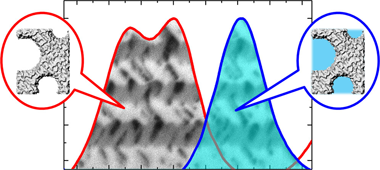
In this work, we have developed a new kind of nanocolumnar birefringent Bragg microcavity (BBM) that, tailored by oblique angle deposition, behaves as a selective transducer of volatile organic compounds (VOCs). Unlike the atomic lattice origin of birefringence in anisotropic single crystals, in the BBM, it stems from an anisotropic self-organization at the nanoscale of the voids and structural elements of the layers. The optical adsorption isotherms recorded upon exposure of these nanostructured systems to water vapor and VOCs have revealed a rich yet unexplored phenomenology linked to their optical activity that provides both capacity for vapor identification and partial pressure determination. This photonic response has been reproduced with a theoretical model accounting for the evolution of the form birefringence of the individual layers upon vapor condensation in nanopores and internanocolumnar voids. BBMs that repel water vapor but are accessible to VOCs have been also developed through grafting of their internal surfaces with perfluorooctyltriethoxysilane molecules. These nanostructured photonic systems are proposed for the development of transducers that, operating under environmental conditions, may respond specifically to VOCs without any influence by the degree of humidity of the medium.
The Role of the Atmosphere on the Photophysics of Ligand-Free Lead-Halide Perovskite Nanocrystals
Moran-Pedroso, M; Rubino, A; Calvo, ME; Espinos, JP; Galisteo-Lopez, JF; Miguez, H
Advanced Optical Materials, (2021) 2100605 | DOI: 10.1002/adom.202100605
Lead halide perovskite (LHP) nanocrystals (NCs) have gained attention over the past decade due to their outstanding optoelectronic properties, making them a suitable material for efficient photovoltaic and light emitting devices. Due to its soft nature, these nanostructures undergo strong structural changes upon irradiation, where these light-induced processes are strongly influenced by the environment. Since most processing routes for LHP NCs are based on colloidal approaches, the role of factors such as stabilizing ligands or solvents is usually hard to disentangle from the interaction of external radiation with the perovskite material. Employing a recently proposed synthetic approach, where ligand-free NCs can be grown within metal-oxide-based insulating nanoporous matrices, it has been feasible to perform a clean study of the effect of the surrounding atmosphere on the photophysical properties of perovskite NCs, avoiding the interference of protective capping layers or solvents. Simultaneous light-induced photo-activation and darkening processes are monitored and disentangled, and their relation with bulk and surface processes, respectively, demonstrated.
The Complex Interplay of Lead Halide Perovskites with Their Surroundings
Galisteo-Lopez, JF; Calvo, ME; Miguez, H
Advanced Optical Materials, (2021) 2100133 | DOI: 10.1002/adom.202100133
Photoexcitation of lead halide perovskites induces a restructuration of the material that simultaneously enhances its emission properties and triggers its degradation. These concomitant processes are strongly dependent on the surroundings of the perovskite, both while and after being processed, underlining the relevance the environment and the interfacial design have in the stability and performance of these materials and the devices based on them. This shocking observation reveals that when subjected to external illumination, lead halide perovskites undergo a number of photophysical processes that strongly modify their structure and thus their optoelectronic properties. Such photoinduced instability stems from a defective structure directly linked to the low-temperature and solution-processed fabrication routes generally employed to build perovskite solar cells with efficiencies comparable to state-of-the-art values. On the other hand, these same inexpensive and unsophisticated procedures make this material a promising component in energy conversion devices. Here, an analysis is provided regarding the different impact on the perovskite structure, hence on its optoelectronic performance, that the interaction with its surroundings has, providing specific examples that highlight this interplay, describing the kind of modification it induces, and listing the related effects on the optoelectronic properties that should be accounted for when characterizing them.
Enhanced Directional Light Extraction from Patterned Rare-Earth Phosphor Films
Cabello-Olmo, E; Molet, P; Mihi, A; Lozano, G; Miguez, H
Advanced Optical Materials, 9 (2021) 2001611 | DOI: 10.1002/adom.202001611
The combination of light‐emitting diodes (LEDs) and rare earth (RE) phosphors as color‐converting layers comprises the basis of solid‐state lighting. Indeed, most LED lamps include a photoluminescent coating made of phosphor material, i.e., crystalline matrix suitably doped with RE elements, to produce white light from a blue or ultraviolet LED chip. Transparent phosphor‐based films constitute starting materials for new refined emitters that allow different photonic designs to be implemented. Among the different photonic strategies typically employed to tune or enhance emission, surface texturing has proved its versatility and feasibility in a wide range of materials and devices. However, most of the nanofabrication techniques cannot be applied to RE phosphors directly because of their chemical stability or because of their cost. The first monolithic patterned structure of down‐shifting nanophosphors with square arrays of nanoholes with different lattice parameters is reported in this study. It is shown that a low‐cost soft‐nanolithography procedure can be applied to red‐emitting nanophosphors (GdVO4:Eu3+ nanocrystals) to tune their emission properties, attaining a twofold directional enhancement of the emitted light at predesigned emission wavelengths in specific directions.
Anisotropic Resistivity Surfaces Produced in ITO Films by Laser-Induced Nanoscale Self-organization
Lopez-Santos, C; Puerto, D; Siegel, J; Macias-Montero, M; Florian, C; Gil-Rostra, J; Lopez-Flores, V; Borras, A; Gonzalez-Elipe, AR; Solis, J
Advanced Optical Materials, 9 (2021) 2001086 | DOI: 10.1002/adom.202001086
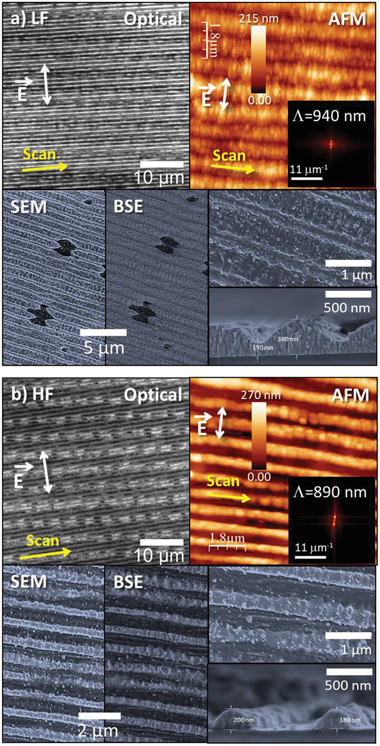
Highly anisotropic resistivity surfaces are produced in indium tin oxide (ITO) films by nanoscale self-organization upon irradiation with a fs-laser beam operating at 1030 nm. Anisotropy is caused by the formation of laser-induced periodic surface structures (LIPSS) extended over cm-sized regions. Two types of optimized structures are observed. At high fluence, nearly complete ablation at the valleys of the LIPSS and strong ablation at their ridges lead to an insulating structure in the direction transverse to the LIPSS and conductive in the longitudinal one. A strong diminution of In content in the remaining material is then observed, leading to a longitudinal resistivity rho(L) approximate to 1.0 omega center dot cm. At a lower fluence, the material at the LIPSS ridges remains essentially unmodified while partial ablation is observed at the valleys. The structures show a longitudinal conductivity two times higher than the transverse one, and a resistivity similar to that of the pristine ITO film (rho approximate to 5 x 10(-4) omega center dot cm). A thorough characterization of these transparent structures is presented and discussed. The compositional changes induced as laser pulses accumulate, condition the LIPSS evolution and thus the result of the structuring process. Strategies to further improve the achieved anisotropic resistivity results are also provided.
Facile synthesis and characterization of a novel 1,2,4,5-benzene tetracarboxylic acid doped polyaniline@zinc phosphate nanocomposite for highly efficient removal of hazardous hexavalent chromium ions from water
Abdelghani Hsini, Yassine Naciri, Mohamed Benafqir, Zeeshan Ajmal, Nouh Aarab, Mohamed Laabd, J.A. Navío, F. Puga, Rabah Boukherroub, Bahcine Bakiz, Abdallah Albourine
Journal of Colloid and Interface Science, 585 (2021) 560-573 | DOI: 10.1016/j.jcis.2020.10.036
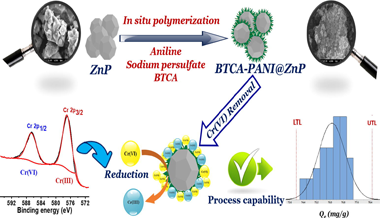
The present study describes the preparation of a novel 1,2,4,5-benzene tetracarboxylic acid doped polyaniline@zinc phosphate (BTCA-PANI@ZnP) nanocomposite via a facile two-step procedure. Thereafter, the as-prepared composite material adsorption characteristics for Cr(VI) ions removal were evaluated under batch adsorption. Kinetic approach studies for Cr(VI) removal, clearly demonstrated that the results of the adsorption process followed the pseudo second order and Langmuir models. The thermodynamic study indicated a spontaneous and endothermic process. Furthermore, higher monolayer adsorption was determined to be 933.88 mg g1 . In addition, the capability study regarding Cr(VI) ions adsorption over BTCA-PANI@ZnP nanocomposite clearly revealed that our method is suitable for large scale application. X-ray photoelectron spectroscopy (XPS) analysis confirmed Cr(VI) adsorption on the BTCA-PANI@ZnP surface, followed by its subsequent reduction to Cr(III). Thus, the occurrence of external mass transfer, electrostatic attraction and reduction phenomenon were considered as main mechanistic pathways of Cr(VI) ions removal. The superior adsorption performance of the material, the multidimensional characteristics of the surface and the involvement of multiple removal mechanisms clearly demonstrated the potential applicability of the BTCA-PANI@ZnP material as an effective alternative for the removal of Cr(VI) ions from wastewater.
Holmium phosphate nanoparticles as negative contrast agents for high-field magnetic resonance imaging: Synthesis, magnetic relaxivity study and in vivo evaluation
Gomez-Gonzalez, E; Caro, C; Martinez-Gutierrez, D; Garcia-Martin, ML; Ocana, M; Becerro, AI
Journal of Colloid and Interface Science, 587 (2021) 131-140 | DOI: 10.1016/j.jcis.2020.11.119
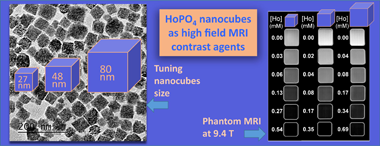
The increasing use of high magnetic fields in magnetic resonance imaging (MRI) scanners demands new contrast agents, since those used in low field instruments are not effective at high fields. In this paper, we report the synthesis of a negative MRI contrast agent consisting of HoPO4 nanoparticles (NPs). Three different sizes (27 nm, 48 nm and 80 nm) of cube-shaped NPs were obtained by homogeneous precipitation in polyol medium and then coated with poly(acrylic) acid (PAA) to obtain stable colloidal suspensions of HoPO4@PAA NPs in physiological medium (PBS). The transverse relaxivity (r2) of aqueous suspensions of the resulting NPs was evaluated at both 1.44 T and 9.4 T. A positive correlation between r2 values and field strength as well as between r2 values and particle size at both magnetic field strengths was found although this correlation failed for the biggest NPs at 9.4 T, likely due to certain particles aggregation inside the magnet. The highest r2 value (489.91 mM-1s−1) was found for the 48 nm NPs at 9.4 T. Toxicity studies demonstrated that the latter NPs exhibited low toxicity to living systems. Finally, in vivo studies demonstrated that HoPO4@PAA NPs could be a great platform for next-generation T2-weighted MRI contrast agents at high magnetic field.
Active sites and optimization of mixed copper-cobalt oxide anodes for anion exchange membrane water electrolysis
Lopez-Fernandez, E; Gil-Rostra, J; Escudero, C; Villar-Garcia, IJ; Yubero, F; Consuegra, AD; Gonzalez-Elipe, AR
Journal of Power Sources, 485 (2021) 229217 | DOI: 10.1016/j.jpowsour.2020.229217
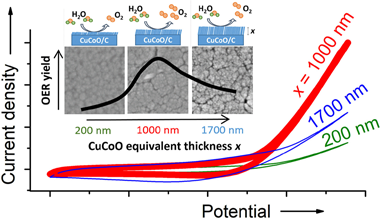
The optimization of the catalysts incorporated to the electrodes for anion exchange membrane water electmlysers is a key issue to maximize their performance through the improvement of the oxygen evolution reaction (OER) yield. In this work, we show that the modification of the microstructure and the chemical properties of a mixed copper-cobalt oxide anode may contribute to increase the activity of this reaction. For this purpose, the OER has been systematically studied, either in a half cell or in a membrane electrode assembly configuration, as a function of the load and agglomeration degree of the catalysts used as electrodes, as prepared on a carbon paper support by magnetron sputtering deposition in an oblique angle configuration. Chemical analysis by X-ray absorption spectroscopy and electrochemical analysis by cyclic voltammetry and impedance spectroscopy have shown that cobalt-copper mixed oxide catalysts with a 1.8 Co/Cu atomic ratio and about one micron equivalent thickness maximizes the cell performance. The chemical, structural and microstructural factors controlling the final behaviour of these anodes and accounting for this maximization of the reaction yield are discussed on the basis of these characterization results and as a function of preparation variables of the electrodes and operating conditions of the cell.
Swelling layered minerals applications: A solid state NMR overview
Pavon, E; Alba, MD
Progress in Nuclear Magnetic Resonance Spectroscopy, 124 (2021) 99-128 | DOI: 10.1016/j.pnmrs.2021.04.001
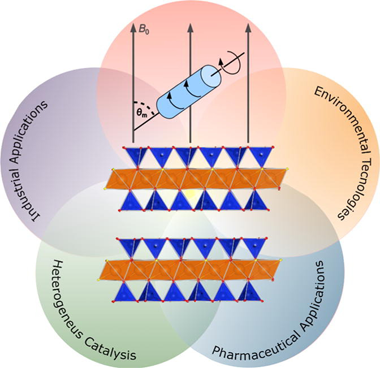
Swelling layered clay minerals form an important sub-group of the phyllosilicate family. They are characterized by their ability to expand or contract in the presence or absence of water. This property makes them useful for a variety of applications, ranging from environmental technologies to heteroge-neous catalysis, and including pharmaceutical and industrial applications. Solid State Nuclear Magnetic Resonance (SS-NMR) has been extensively applied in the characterization of these materials, providing useful information on their dynamics and structure that is inaccessible using other characterization methods such as X-ray diffraction. In this review, we present the key contributions of SS-NMR to the understanding of the mechanisms that govern some of the main applications associated to swelling clay minerals. The article is divided in two parts. The first part presents SS-NMR conventional applications to layered clay minerals, while the second part comprises an in-depth review of the information that SS-NMR can provide about the different properties of swelling layered clay minerals.
Zinc Polyaleuritate Ionomer Coatings as a Sustainable, Alternative Technology for Bisphenol A-Free Metal Packaging
Morselli, D; Cataldi, P; Paul, UC; Ceseracciu, L; Benitez, JJ; Scarpellini, A; Guzman-Puyol, S; Heredia, A; Valentini, P; Pompa, PP; Marrero-López, D; Athanassiou, A; Heredia-Guerrero, A
ACS Sustainable Chemistry & Engineering, 9 (2021) 15484-15495 | DOI: 10.1021/acssuschemeng.1c04815
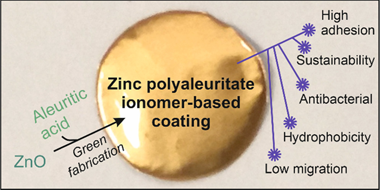
Sustainable coatings for metal food packaging were prepared from ZnO nanoparticles (obtained by the thermal decomposition of zinc acetate) and a naturally occurring polyhydroxylated fatty acid named aleuritic (or 9,10,16-trihydroxy-hexadecanoic) acid. Both components reacted, originating under specific conditions zinc polyaleuritate ionomers. The polymerization of aleuritic acid into polyaleuritate by a solvent-free, melt polycondensation reaction was investigated at different times (15, 30, 45, and 60 min), temperatures (140, 160, 180, and 200 degrees C), and proportions of zinc oxide and aleuritic acid (0:100, 5:95, 10:90, and 50:50, w/w). Kinetic rate constants calculated by infrared spectroscopy decreased with the amount of Zn due to the consumption of reactive carboxyl groups, while the activation energy of the polymerization decreased as a consequence of the catalyst effect of the metal. The adhesion and hardness of coatings were determined from scratch tests, obtaining values similar to robust polymers with high adherence. Water contact angles were typical of hydrophobic materials with values >= 94 degrees. Both mechanical properties and wettability were better than those of bisphenol A (BPA)-based resins and most likely are related to the low migration values determined using a hydrophilic food simulant. The presence of zinc provided a certain degree of antibacterial properties. The performance of the coatings against corrosion was studied by electrochemical impedance spectroscopy at different immersion times in an aqueous solution of NaCl. Considering the features of these biobased lacquers, they can be potential materials for bisphenol A-free metal packaging.
Stepping toward Efficient Microreactors for CO2 Methanation: 3D-Printed Gyroid Geometry
Baena-Moreno, FM; Gonzalez-Castano, M; de Miguel, JCN; Miah, KUM; Ossenbrink, R; Odriozola, J.A.
ACS Sustainable Chemistry & Engineering, 9 (2021) 8198-8206 | DOI: 10.1021/acssuschemeng.1c01980
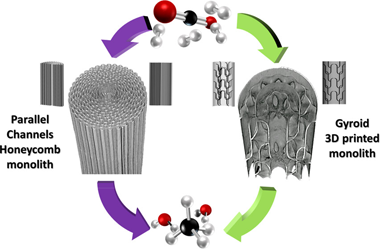
This work presents a comparative study toward the development of efficient microreactors based on three-dimensional (3D)-printed structures. Thus, the study evaluates the influence of the metal substrate geometry on the performance of structured catalysts for the CO2 methanation reaction. For this purpose, the 0.5%Ru-15%Ni/MgAl2O4 catalyst is washcoated over two different micromonolithic metal substrates: a conventional parallel channel honeycomb structure and a novel 3D-printed structure with a complex gyroid geometry. The effect of metal substrate geometry is analyzed for several CO2 sources including ideal flue gas atmospheres and the presence of residual CH4 and CO in the flue gas, as well as simulated biogas sources. The advantages of the gyroid 3D complex geometries over the honeycomb structures are shown for all evaluated conditions, providing in the best-case scenario a 14% improvement in CO2 conversion. Moreover, this contribution shows that systematically tailoring geometrical features of structured catalysts becomes an effective strategy to achieve improved catalyst performances independent of the flue gas composition. By enhancing the transport processes and the gas-catalyst interactions, the employed gyroid 3D metal substrates enable boosted CO2 conversions and greater CH4 selectivity within diffusion-controlled regimes.
Photonic sensor systems for the identification of hydrocarbons and crude oils in static and flow conditions
Gil-Rostra, J; Quintero-Moreno, S; Rico, VJ; Yubero, F; Sanza, FJ; Casquel, R; Gallo-Valverde, E; Jara-Galan, ME; Sanz-Sanz, P; Holgado, M; Gonzalez-Elipe, AR
Sensors and Actuators B-Chemical, 344 (2021) 130265 | DOI: 10.1016/j.snb.2021.130265
Identification of hydrocarbons and crude oils is typically carried out with samples that, taken from natural sources or refineries, must be brought to the laboratory for their analysis with rather sophisticated instruments. Alternatively, "in situ" procedures have been also developed for this purpose. In this work, we propose the use of a series of several sensor systems based on photonic transducers in the form of chips for the identification and classification of crude oils and hydrocarbons through the determination of their refractive index in the visible and absorption in the near infrared regions of the electromagnetic spectrum. Two of the photonic transducers rely on modifications of a Bragg microcavity and they monitor the changes in visible light interference phenomena that occur in response to the variation of the refractive index of oils. The third one, in the form of a dielectric mirror, monitors the near infrared absorption of crude oils and hydrocarbons through the recording of a transflectance spectrum. The capacity of these transducers for crude oil identification is proved by the analysis of a series of oils and distilled fractions that have been properly identified and classified as a function of their density and partition of long hydrocarbon chains. The three photonic transducers are operated with optical fibers and can be used in static and dynamic modes, this latter under conditions that are especially well-suited for "insitu" analysis of oil streams in real facilities. The proved resistance of the chips to high pressure and temperature conditions supports their suitability to withstand harsh working environments as those existing in extraction wells.
Light-Harvesting Properties of a Subphthalocyanine Solar Absorber Coupled to an Optical Cavity
Esteso, V; Calio, L; Espinos, H; Lavarda, G; Torres, T; Feist, J; Garcia-Vidal, FJ; Bottari, G; Míguez, H
SOLAR RRL, (2021) 2100308 | DOI: 10.1002/solr.202100308
Herein, both from the experimental and theoretical point of view, the optical absorption properties of a subphthalocyanine (SubPc), an organic macrocycle commonly used as a sunlight harvester, coupled to metallic optical cavities are analyzed. How different electronic transitions characteristic of this compound and specifically those that give rise to excitonic (Q band) and charge transfer (CT band) transitions couple to optical cavity modes is investigated. It is observed that whereas the CT band couples weakly to the cavity, the Q band transitions show evidence of hybridization with the photon eigenstates of the resonator, a distinctive trait of the strong coupling regime. As a result of the different coupling regimes of the two electronic transitions, very different spectral and directional light-harvesting features are observed, which for the weakly coupled CT transitions are mainly determined by the highly dispersive cavity modes and for the strongly coupled Q band by the less angle-dependent exciton-polariton bands. Modeling also allows discriminating parasitic from productive absorption in each case, enabling the estimation of the expected losses in a solar cell acting as an optical resonator.
Ligand-Free MAPbI(3) Quantum Dot Solar Cells Based on Nanostructured Insulating Matrices
Rubino, A; Calio, L; Calvo, ME; Miguez, H
SOLAR RRL (2021) 2100204 | DOI: 10.1002/solr.202100204
The stability, either chemical or thermal, and performance of colloidal quantum dot (CQD) devices are typically limited by the presence of surface-bonded organic ligands required to stabilize the nanocrystals. In addition, optimization of charge transport implies lengthy ligand exchange processing. Herein, evidence of efficient charge transport through a network of ligand-free perovskite quantum dots (PQDs) embedded in an insulating porous matrix made of monodisperse SiO2 nanoparticles is shown. Methylammonium lead iodide (CH3NH3PbI3 or MAPbI(3)) QDs are prepared in situ by infiltration of precursors within the matrix pores, which act both as nanoreactors for the synthetic reaction and as supporting scaffolds, hence reducing the number of synthetic and postprocessing steps usually required in CQD solar cells. Above a certain nanocrystal load, charge percolation is reached and dot-to-dot transport achieved without compromising quantum confinement effects. Solar cells based on MAPbI(3) QDs prepared in this way present a 9.3% efficiency, the highest reported for a scaffold-supported PQD solar cell, and significantly improved stability under solar illumination with respect to their bulk counterparts. Therefore, adequately designed networks of ligand-free PQDs can be used as both light harvesters and photocarrier conductors, in an alternative configuration to that used in previously developed QD solar cells.
Enhanced UV and visible light photocatalytic properties of synthesized AgBr/SnO2 composites
Puga, F.; Navío, J.A.; Hidalgo, M.C.
Separation and Purification Tecnology, 257 (2021) 117948 | DOI: 10.1016/j.seppur.2020.117948
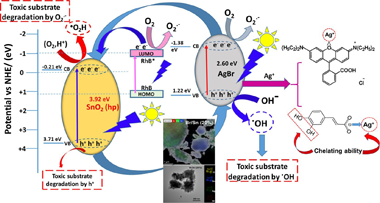
Composites (AgBr/SnO2) comprised of AgBr and SnO2 with different molar % of bare SnO2, have been synthesized by simple precipitation methods; the bare SnO2 used, was synthesized by hydrothermal procedure. Samples have been characterized by X-ray diffraction (XRD), N2-adsorption, UV–vis diffuse reflectance spectroscopy (DRS), scanning electron microscopy (SEM), Transmission electron microscopy (TEM) and X-ray photoelectron spectroscopy (XPS). Photocatalytic activity of the as-prepared photocatalysts was evaluated through photocatalytic degradation of rhodamine B (RhB) and caffeic acid (CAFA) under UV and Visible illumination. In photocatalytic degradation studies, for both substrates, conversion rates of around 95% were found in 45 min of both UV-illumination and 85% under visible lighting. These conversion rates were superior than the conversion rates of pure parental components, AgBr and SnO2 under the same experimental conditions. At least, for RhB no loss of photocatalytic activity has been observed after five recycles although the mineralization degree progressively diminished along the recycles. The enhanced photocatalytic degradation of AgBr/SnO2 compounds was attributed, in part, to a synergistic increase in adsorption viability, as well as to the effective separation of photoinduced load carriers that resulted from the formation of a heterojunction according to the type II junction. Radical scavengers’ experiments indicated that active oxidant species as O2.−, ·OH and h+ all are involved in this photocatalytic system, although it seems that O2.− played the major role in the photocatalytic degrading of RhB by AgBr/SnO2 composites. In summary, coupling AgBr with SnO2 remarkably improves the photocatalytic activity under both UV and visible-illumination with respect to the parental components. These features open the route to future applications of this material in the field of environmental remediation.
Zirconium retention for minimizing environmental risk: Role of counterion and clay mineral
Montes, L; Pavon, E; Cota, A; Alba
Chemosphere, 267 (2021) 128914 | DOI: 10.1016/j.chemosphere.2020.128914
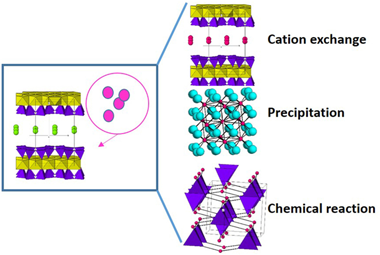
Zr(IV) together with U(IV) are the major components of high-level radionuclide waste (HLRW) and spent nuclear fuel (SNF) from nuclear power plants. Thus, their retention in the waste disposal is of great importance for the environmental risk control. Here, the influence of clay minerals on the retention of Zr(IV), as component of the nuclear waste and as chemical analogues of U(IV), has been evaluated. Three clay minerals, two bentonites and one saponite, were hydrothermally treated with three zirconium salts. A structural study at long-range order by X-ray diffraction and short-range order by NMR was performed to evaluate the generation of new zirconium phases and degradation of the clay minerals. Three immobilization mechanisms were observed: i) cation exchange of ZrO2+ or Zr4+ by clay minerals, ii) the precipitation/crystallization of ZrO2, and, iii) the chemical interaction of zirconium with the clay minerals, with the formation of zirconium silicates.
Advanced parametrisation of phase change materials through kinetic approach
Lizana, J; Perejon, A; Sanchez-Jimenez, PE; Perez-Maqueda, LA
Journal of Energy Storage, 44 (2021) 103441 | DOI: 10.1016/j.est.2021.103441
Phase change materials (PCM) have been widely investigated for heat storage and transfer applications. Numerous numerical simulation approaches have been proposed for modelling their behaviour and predicting their performance in thermal applications. However, simulation approaches do not consider the kinetics of the phase transition processes, compromising the accuracy of their predictions. The phase change is a kinetically driven process in which both the reaction rate and the reaction progress depend on the heating schedule. This work evaluates and parametrises the influence of kinetics in the melting and crystallisation behaviour of a well-known PCM, PEG1500, and compares potential discrepancies with common phase change parametrisation alternatives. The kinetic dependence was experimentally evaluated through differential scanning calorimetry (DSC). The kinetic parameters required for modelling the kinetics of the processes were determined by both model-free and model-fitting procedures following ICTAC (International Confederation for Thermal Analysis and Calorimetry) recommendations. Then, the phase transition was parametrised through a kinetic model and compared with three conventional phase transition models: linear without hysteresis, non-linear without hysteresis, and non-linear with hysteresis. The statistical comparison between models demonstrates the higher accuracy of the kinetic approach to correctly represent the partial enthalpy distribution of latent heat storage materials during alternative phase change rates, obtaining a coefficient of determination (R-2) of 0.80. On the other hand, the accuracy of kinetic-independent models is limited to the range from 0.40 to 0.61. The results highlight the high discrepancies of conventional models compared to the kinetic approach and provide criteria and guidelines for efficient kinetic modelling of phase change in heat transfer evaluations.
Ni/YMnO3 perovskite catalyst for CO2 methanation
Gonzalez-Castano, M; de Miguel, JCN; Penkova, A; Centeno, MA; Odriozola, JA; Arellano-Garcia, H
Applied Materials Today, 23 (2021) 101055 | DOI: 10.1016/j.apmt.2021.101055
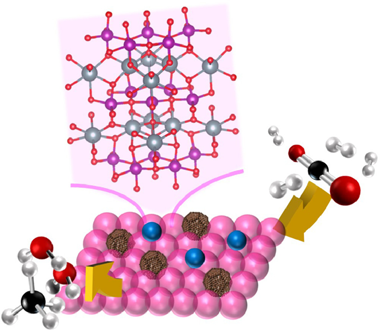
This work proposes an innovative Ni catalyst supported over YMnO3 perovskite as a promising catalytic system for CO2 methanation reaction. Under reductive conditions, the attendance of Mn redox couples within the layered perovskite structure promotes the constitution of sub-stoichiometric YMnO3-x units which, by means of the flexible YMnO3-x reorganization capacity, results in boosted anionic mobility's. The competitive turnover frequencies (20.1 and 17.0 s(-1) at 400 degrees C under dry- and steamed- CO2 methanation conditions) displayed by Ni/YMnO3 system were related to the synergism between strongly interacting Ni particles with partially reduced YMnO3-x perovskites. The optimal Ni dispersions, for which no relevant signs of sintering issues were discerned, combined to effective role of oxygen vacancies towards the dissociative activation of CO2 molecules enabled highly active and stable catalytic behaviours with no evidence of cooking phenomena. On evaluating the water presence within CO2 methanation feedstock's, the deprived catalytic behaviour was fundamentally associated to depleted oxygen vacancies concentrations and promoted WGS side reactions.
Sponge-like processed D-periodic self-assembled atelocollagen supports bone formation in vivo
Borrego-Gonzalez, S; Rico-Llanos, G; Becerra, J; Diaz-Cuenca, A; Visser, R
Materials Science & Engineering C-Materials for Biological Applications, 120 (2021) art.111679 | DOI: 10.1016/j.msec.2020.111679
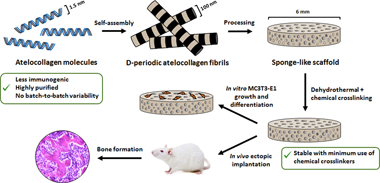
Fibrous biopolymeric collagen extracted from animal tissues has been widely used for fabricating matrices for bone tissue engineering (BTE). However, animal extracted collagens can trigger immune reactions when implanted in vivo and the presence of native crosslinks leads to batch-to-batch variability. Atelocollagen, a monomeric form of collagen, is free of telopeptides, which are mainly responsible for the immunogenicity of collagen, and can self-assemble in vitro to obtain fibrils with the characteristic D-periodic staining pattern of native collagen. However, atelocollagen-based biomaterials have not extensively been studied and, hence, their suitability for BTE remains relatively unexplored. Besides, to stabilize collagen biomaterials, chemical and physical crosslinking are used, although chemical agents are cytotoxic while the physical methods yield a less effective crosslinking. A combination of physical and chemical crosslinking is a suitable alternative that has rarely been tested in BTE programs. In this work, a sponge-like biomaterial (DCol-S) was processed from D-periodic self-assembled atelocollagen and its stabilization was studied using the combination of a dehydrothermal treatment (DHT) and minimal glutaraldehyde (GTA) exposition crosslinking, to increase the resistance to degradation of the scaffold without a major effect on the biomaterial structure. The microstructural features of the final sponges were characterised and compared to a commercial biomaterial processed from native bovine collagen (Helistat (R), Integra Lifesciences, NJ, USA), demonstrating that a D-periodic nanostructure was obtained and maintained after processing of the sponges. MC3T3-E1 preosteoblast adhesion, proliferation and differentiation assays in vitro showed that DCol-S is biocompatible. Furthermore, intramuscular implantation of the biomaterials loaded with rhBMP-2 revealed that the double-crosslinked sponges were able to support ectopic bone formation, while sponges stabilised only with the DHT treatment were not. Altogether, these findings show that atelocollagen-based sponges stabilised with a DHT treatment followed by a mild GTA crosslinking are a suitable alternative to polymeric extracted collagen for BTE applications.
Cu supported Fe-SiO2 nanocomposites for reverse water gas shift reaction
Gonzalez-Castano, M; de Miguel, JCN; Sinha, F; Wabo, SG; Klepel, O; Arellano-Garcia, H
Journal of CO2 Utilization, 46 (2021) 101493 | DOI: 10.1016/j.jcou.2021.101493
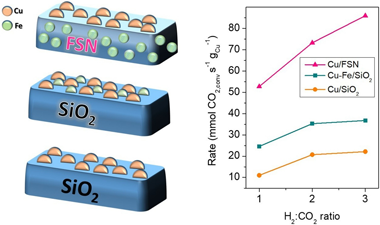
This work analyses the catalytic activity displayed by Cu/SiO2, Cu-Fe/SiO2 and Cu/FSN (Fe-SiO2 nanocomposite) catalysts for the Reverse Water Gas Shift reaction. Compared to Cu/SiO2 catalyst, the presence of Fe resulted on higher CO?s selectivity and boosted resistances against the constitution of the deactivation carbonaceous species. Regarding the catalytic performance however, the extent of improvement attained through incorporation Fe species strongly relied on the catalysts' configuration. At 30 L/gh and H-2:CO2 ratios = 3, the performance of the catalysts? series increased according to the sequence: Cu/SiO2 < Cu-Fe/SiO2 << Cu/FSN. The remarkable catalytic enhancements provided by Fe-SiO2 nanocomposites under different RWGS reaction atmospheres were associated to enhanced catalyst surface basicity's and stronger Cu-support interactions. The catalytic promotion achieved by Fe-SiO2 nanocomposites argue an optimistic prospective for nanocomposite catalysts within future CO2-valorising technologies.
Effect of potassium loading on basic properties of Ni/MgAl2O4 catalyst for CO2 reforming of methane
Azancot, L; Bobadilla, LF; Centeno, MA; Odriozola, JA
Journal of CO2 Utilization, 52 (2021) 101681 | DOI: 10.1016/j.jcou.2021.101681
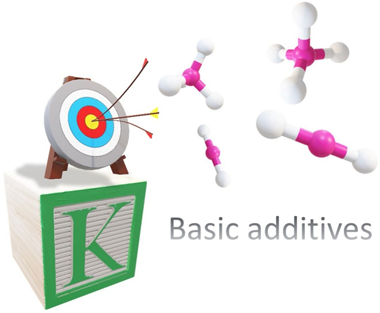
Coke deposition is one of the key issues in the dry reforming of methane on Ni catalysts. In the present work, we investigate the effect of potassium addition for suppressing carbon deposition in the Dry Reforming of Methane. The results obtained demonstrated that potassium contents above 3 wt% promote carbon gasification, favouring both Reverse Water Gas Shift and Boudouard reaction. Strong basic Mg-O-K sites are responsible for these reactions allowing the suppression of carbon deposits and allowing the stability of the catalyst.
One-reactor vacuum and plasma synthesis of transparent conducting oxide nanotubes and nanotrees: from single wire conductivity to ultra-broadband perfect absorbers in the NIR
Castillo-Seoane, J; Gil-Rostra, J; Lopez-Flores, V; Lozano, G; Ferrer, FJ; Espinos, JP; Ostrikov, K; Yubero, F; Gonzalez-Elipe, AR; Barranco, A; Sanchez-Valencia, JR; Borras, A
Nanoscale, 13 (2021) 13882-13895 | DOI: 10.1039/d1nr01937f
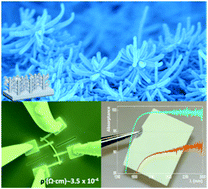
The eventual exploitation of one-dimensional nanomaterials needs the development of scalable, high yield, homogeneous and environmentally friendly methods capable of meeting the requirements for fabrication of functional nanomaterials with properties on demand. In this article, we demonstrate a vacuum and plasma one-reactor approach for the synthesis of fundamental common elements in solar energy and optoelectronics, i.e. the transparent conducting electrode but in the form of nanotube and nanotree architectures. Although the process is generic and can be used for a variety of TCOs and wide-bandgap semiconductors, we focus herein on indium doped tin oxide (ITO) as the most previously researched in previous applications. This protocol combines widely applied deposition techniques such as thermal evaporation for the formation of organic nanowires serving as 1D and 3D soft templates, deposition of polycrystalline layers by magnetron sputtering, and removal of the templates by simply annealing under mild vacuum conditions. The process variables are tuned to control the stoichiometry, morphology, and alignment of the ITO nanotubes and nanotrees. Four-probe characterization reveals the improved lateral connectivity of the ITO nanotrees and applied on individual nanotubes shows resistivities as low as 3.5 +/- 0.9 x 10(-4) omega cm, a value comparable to that of single-crystalline counterparts. The assessment of diffuse reflectance and transmittance in the UV-Vis range confirms the viability of the supported ITO nanotubes as random optical media working as strong scattering layers. Their further ability to form ITO nanotrees opens a path for practical applications as ultra-broadband absorbers in the NIR. The demonstrated low resistivity and optical properties of these ITO nanostructures open a way for their use in LEDs, IR shields, energy harvesting, nanosensors, and photoelectrochemical applications.
Persistent luminescence of transparent ZnGa2O4:Cr3+ thin films from colloidal nanoparticles of tunable size
Arroyo, E; Medran, B; Castaing, V; Lozano, G; Ocana, M; Becerro, AI
Journal of Materials Chemistry C, 9 (2021) 4474-4485 | DOI: 10.1039/d1tc00258a
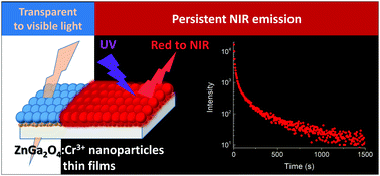
We report on the fabrication of ZnGa2O4:Cr3+ transparent thin films and the evaluation, for the first time in the literature, of their persistent red to NIR emission. For this purpose, we have used a simple and economic global strategy based on wet processing methods from colloidal nanospheres with uniform size. A microwave-assisted hydrothermal method was first developed for the synthesis of precursor particles, which allows size tuning from 300 nm to 30 nm through simple modification of the Zn2+ precursor and the Cr3+ content of the starting solutions. ZnGa2O4:Cr3+ transparent thin films over quartz substrates were then easily fabricated by spin coating, and their structural and optical characteristics were analyzed in detail after annealing at high temperature to elucidate the effect of processing temperature and particle size on the properties of the films. Indeed, our results indicate that high temperature annealing does not compromise the transparency of the films but improves their photoluminescence. In addition, the analysis reveals that persistence luminescence in our films is rather independent of the size of the precursor nanoparticles. Due to their transparency and persistent emission properties, films fabricated from colloidal suspensions of ZnGa2O4:Cr3+ nanoparticles show great potential for application in the fields of chemical sensing, information storage, labelling, and anti-counterfeiting technology.
Impact of flame confinement with inert ceramic foams on the particulate emissions of domestic heating systems
Ciria, D; Orihuela, MP; Becerra, JA; Chacartegui, R.; Ramirez-Rico, J.
Fuel, 304 (2021) 121264 | DOI: 10.1016/j.fuel.2021.121264
Small solid biomass combustion systems are among the main contributors to the global particulate emissions share, and cheap, efficient abatement systems are not yet available for them. The placement of inert porous material to confine the combustion region is being recently explored as a possible mitigation system for this kind of pollution. However, given the complexity of biomass thermochemical decomposition processes, it is challenging to justify the performance of these systems on the basis of a physicochemical understanding. A foundational experiment-based study is carried out in this work to understand how combustion confinement affects the particulate emissions production mechanisms. A combustion unit was designed and built to systematically test ceramic foams with different porosities: keeping constant airflow and fuel feed rates. A comprehensive characterisation study was carried out on the solid biomass fuel, the temperature profile, the particulate emissions, and the remaining solid residue. The results evidenced that the use of foams has a substantial impact on the temperature distribution in the combustion chamber. The higher the cell density of the foam, the higher and more homogeneous are the temperatures reached in the combustion bed. This fact improved the thermal decomposition process of the pellets due to a better air-fuel mixture, leading to a reduction of the solid particulate matter emissions by more than 70%. These findings suggest that the use of an inert porous material above the combustion region might be a feasible solution for particulate emission control in small-size biomass combustion technology.
Pectin-cellulose nanocrystal biocomposites: Tuning of physical properties and biodegradability
Moreno, Ana Gonzalez; Guzman-Puyol, Susana; Dominguez, Eva; Benitez, Jose J.; Segado, Patricia; Lauciello, Simone; Ceseracciu, Luca; Porras-Vazquez, Jose M.; Leon-Reina, Laura; Heredia, Antonio; Heredia-Guerrero, Jose A.
International Journal of Biological Macromolecules, 180 (2021) 709-717 | DOI: 10.1016/j.ijbiomac.2021.03.126
The fabrication of pectin-cellulose nanocrystal (CNC) biocomposites has been systematically investigated by blend-ing both polysaccharides at different relative concentrations. Circular free-standing films with a diameter of 9 cm were prepared by simple solution of these carbohydrates in water followed by drop-casting and solvent evaporation. The addition of pectin allows to finely tune the properties of the biocomposites. Textural characterization by AFM showed fibrous morphology and an increase in fiber diameter with pectin content. XRD analysis demonstrated that pectin incorporation also reduced the degree of crystallinity though no specific interaction between both poly-saccharides was detected, by ATR-FTIR spectroscopy. The optical properties of these biocomposites were character-ized for the first time and it was found that pectin in the blend reduced the reflectance of visible light and increased UV absorbance. Thermal stability, analyzed by TGA, was improved with the incorporation of pectin. Finally, pectin-cellulose nanocrystal biocomposites showed a good biodegradability in seawater, comparable to other common bioplastics such as cellulose and low-molecular weight polylactide, among others.
Designed organomicaceous materials for efficient adsorption of iodine
Osuna, FJ; Pavon, E; Pazos, MC; Alba, MD
Journal of Environmental Chemical Engineering, 9 (2021) 106577 | DOI: 10.1016/j.jece.2021.106577
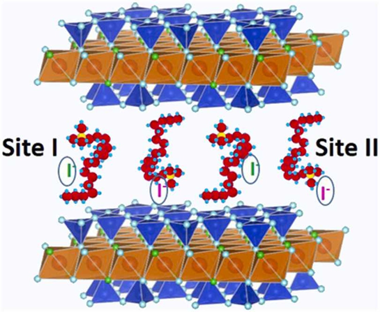
The anionic iodine I-129 has a significant contribution to overall long-term dose resulting from the nuclear waste storage and its immobilization by clay barrier is crucial. Organoclays have been tested as ideal adsorption materials, being the clay layer charge and the length and type of organic molecules the most relevant parameters affecting the adsorption. In this work, a family of designed organomicas are explored in term of iodine adsorption capacity. Their adsorption capacities were always higher than that of the traditional clays and organoclays. C-18-M4 shows a maximum monolayer adsorption capacity one order of magnitude higher than natural organoclays, with a free energy typical of physical adsorption and adsorption sites of high affinity. However, its surface is not homogeneous in terms of stability constant according to the Scatchard adsorption parameters. Hence, this study can provide a guidance for the design and construction of ultrahigh-capacity iodine adsorbents.
Novel procedure for studying laser-surface material interactions during scanning laser ablation cleaning processes on Cu-based alloys
Di Francia, E; Lahoz, R; Neff, D; Rico, V; Nuns, N; Angelini, E; Grassini, S
Applied Surface Science, 544 (2021) art. 178820 | DOI: 10.1016/j.apsusc.2020.148820

Laser ablation is an effective method to clean Cu-based alloys. A novel procedure of characterisation was developed involving O-18 isotopes evaluated by ToF-SIMS spectroscopy to assess the driving mechanisms of laser-surface interactions. The presence of re-oxidised compounds was detected, discerning between the oxygen from the corrosion layer and the one introduced by the interaction with the laser (that was generated in a controlled atmosphere of O-18 diluted in N-2). A set of samples treated with different laser conditions were characterised by FESEM and mu Raman. The results have shown that re-oxidation phenomenon can occur and its selectivity depends on the laser conditions.
Laser-induced scanning transfer deposition of silver electrodes on glass surfaces: A green and scalable technology
Molina, R; Ertugrul, M; Larrea, A; Navarro, R; Rico, V; Yubero, F; Gonzalez-Elipe, AR: De la Fuente, GF; Angurel, LA
Applied Surface Science, 556 (2021) 149673 | DOI: 10.1016/j.apsusc.2021.149673
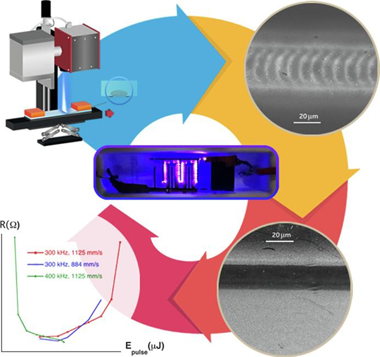
A pulsed laser ablation backwriting technique with high repetitive rates is implemented for the fabrication of silver coatings on glass surfaces. This method enables geometrical constraint-free deposition of metallic coatings. These exhibit sufficiently low electrical resistance to be used as electrodes in dielectric barrier discharge (DBD) plasma elements. Ambient air deposition of metallic silver electrodes on standard glass slides is explored using a sub-ns UV laser source, combined with hybrid beam scanning methods. The green nature of the overall deposition process includes a preliminary irradiation scan to homogenise the target surface before the subsequent backwriting step. Metal transfer is achieved by combining two phenomena within a simple beam scanning process: LIRT (laserinduced reverse transfer) of silver from the target to the glass, with a partial and secondary LIFT (Laser-Induced Forward Transfer) of silver from the glass to the target. Appropriate selection of pulse energy and pulse repetition rates, beam scanning velocities and target motion enable the growth of sufficiently thick Ag deposits on glass with the required low electrical resistivity and nearly 2D constraint-free geometry. This method avoids the use of vacuum and liquids, resulting in a cheap, facile and green methodology for the deposition of silver electrodes onto transparent substrate surfaces.
Organophilization of acid and thermal treated sepiolite for its application in BTEX adsorption from aqueous solutions
Varela, CF; Pazos, MC; Alba, MD
Journal of Water Process Engineering, 40 (2021) 101949 | DOI: 10.1016/j.jwpe.2021.101949
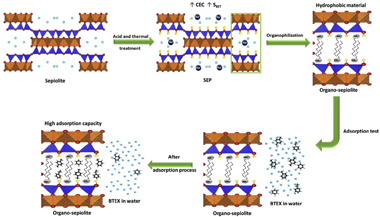
Acid and thermal treated sepiolite was organophilized by cationic exchange with several alkylammonium cations (octylammonium, hexadecylammonium, tetradecyltrimethylammonium, and hexadecyltrimethylammonium). The adsorption capacity of BTEX from aqueous solutions was evaluated through the adsorption isotherms performed in batch. The results were analysed using three isotherm models: Freundlich, Langmuir and Dubinin-Radushkevich (D-R model). The behaviour of adsorption isotherm suggested the multilayer coverage on a heterogeneous surface, which is according to the Freundlich isotherm model. The thermodynamic analyse using the D-R model show that physical mechanisms govern the process. The maximum adsorption capacity of BTEX on the obtained materials was in the range values of 81.19 mg g(-1) - 1448.42 mg g(-)(1), which are higher than those reported up to now. The organo-sepiolite materials exhibit a high potential in the adsorption of BTEX compounds from aqueous solutions.
Electrochromic response and porous structure of WO3 cathode layers
Louloudakis, D; Mouratis, K; Gil-Rostra, J; Koudoumas, E; Alvarez, R; Palmero, A; Gonzalez-Elipe, AR
Electrochimica Acta, 376 (2021) 138049 | DOI: 10.1016/j.electacta.2021.138049
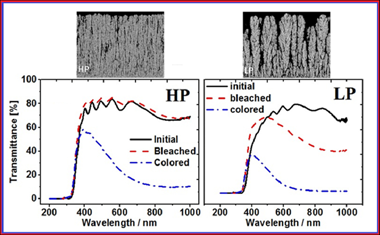
Maximizing the electrochromic response of tungsten oxide-based systems demands highly porous electrode layers that facilitate the incorporation of electrolyte cations during the reduction process. In this work, amorphous and porous WO3 thin films were grown on indium tin dioxide glass substrates by magnetron sputtering at oblique angles at two different plasma gas pressures. Remarkably, the film that showed higher porosity presented a worse electrochromic response in terms of durability, time response and charge density capacity. This result is analyzed and explained on the basis of the features of the porous structure of the films: While the typical nanostructure developed at low pressures possesses large and connected pore voids with few ramifications, the nanostructure generated at a higher pressure presents a rather sponge-like porous structure with numerous and small well-connected voids. A general discussion on the role of the porous structure and, particularly, on the accessible pore volume and area is carried out. It is concluded that not only the accessible pore volume, defining the volume of electrolyte that stays inside the layer, but also the accessible pore area, which defines the efficiency of the incorporation/release of Li+ cations within the electrode material, determine the efficiency and reversibility of the electrochromic response.
High-temperature solar-selective coatings based on Cr(Al)N. Part 1: Microstructure and optical properties of CrNy and Cr1-xAlxNy films prepared by DC/HiPIMS
Rojas, TC; Caro, A; Lozano, G.; Sanchez-Lopez, JC
Solar Energy Materials and Solar Cells, 223 (2021) 110951 | DOI: 10.1016/j.solmat.2020.110951
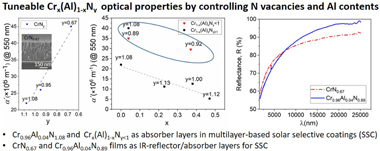
In order to explore the potentialities of Cr1-x(Al)xNy materials in multilayer-based solar selective coatings (SSC) for high temperature applications (T > 500 °C), the optical behavior of Cr1-x(Al)xNy films is studied in this work. Two sets of layers (CrNy and Cr1-xAlxNy) were prepared by direct current (DC) and high-power impulse magnetron sputtering (HiPIMS) technology. The deposition parameters: N2 flux, HiPIMS frequency and aluminum sputtering power, were modified to get a wide variety of stoichiometries. The composition, morphology, phases and electronic structure of the films were characterized in depth. The optical behavior was determined by UV–Vis–NIR and FTIR spectroscopies, and the optical constants were obtained from the measured transmittance and reflectance spectra based on appropriate dielectric function models. Our results indicate that small changes in the layer composition influence the optical constants. In particular, a metallic-like behavior was obtained for CrNy layers with N vacancies (CrN0.95 and CrN0.67 films) while a semiconductor-like behavior was observed for CrN1.08. Thus, the CrNy films can be used as effective absorber layer in multilayer-based SSC, and namely, the CrN0.67 film as an IR reflector/absorber layer too. Likewise, the optical properties of Cr1-xAlxNy layers can also be tuned from metallic to semiconductor-like behavior depending on the chemical composition. Indeed, the absorption coefficients of Cr1-xAlxNy films with optimized Al content and N-vacancies are comparable to those reported for state-of-the-art materials such as TiAlN or TiAlCrN. In addition, a Cr0.96Al0.04N0.89 film was found to be a suitable IR reflector/absorber layer.
Geopolymers made from metakaolin sources, partially replaced by Spanish clays and biomass bottom ash
Eliche-Quesada, D; Calero-Rodriguez, A; Bonet-Martinez, E;Perez-Villarejo, L; Sanchez-Soto, PJ
Journal of Building Engineering, 40 (2021) 102761 | DOI: 10.1016/j.jobe.2021.102761
The main objective of this investigation is to study the effect of the substitution of metakaolin (MK) (from calcined industrial kaolin) by four different calcined natural Southern Spain clays traditionally used in the brick and tile sector, as well as by the biomass bottom ash residue (BBA) from the combustion of a mix of olive and pine pruning on the synthesis of geopolymer with physical, mechanical and thermal properties comparable to those of classic construction materials. As alkaline activator, a 8 M solution of sodium hydroxide and sodium silicate have been used. Raw materials, metakaolin; Spanish clays: black clay (BC), yellow clay (YC), white clay (WC), red clay (RC) and BBA were characterized by chemical analysis (XRF), mineralogical analysis (XRD), and particle size analysis. Control geopolymers containing only metakaolin, and batch of geopolymers were formulated containing equal proportions of metakaolin, BBA and each of the four types of clay. After the curing period, at 60 degrees C for 1 day geopolymers were demolded and stored 27 days at room temperature. Geopolymers were characterized using Scanning Electron Microscopy coupled with Energy Dispersive Spectroscopy (SEM-EDS), XRD and Attenuated Total Reflectance-Fourier Transform Infrared Spec troscopy (ATR-FTIR). Their physical, mechanical and thermal properties have also been studied. The addition of BBA and different types of calcined clays to metakaolin gives rise to geopolymers with higher mechanical properties increasing the compressive strength of the control geopolymer containing only MK (24.9 MPa) by more than 50% for the GMK-BBA-WC geopolymers (38.5 MP a). The clays act as fillers and/or promote the precipitation of calcium-rich phases (Ca)-A-S-H-G gel that coexists with the (Na)-A-S-H gel type. The relevant results of physical, mechanical and thermal properties obtained in this research demonstrate the potential of Spanish clays and BBA as binders and substitutes for metakaolin.
Photocatalytic production of hydrogen and methane from glycerol reforming over Pt/TiO2–Nb2O5
Iervolino, G; Vaiano, V; Murcia, JJ; Lara, AE; Hernández, JS; Rojas, H; Navío, JA; Hidalgo, MC
International Journal of Hydrogen Energy | DOI: 10.1016/j.ijhydene.2021.09.111
In this study, platinized mixed oxides (TiO2–Nb2O5) were tested on photocatalytic hydrogen production from a glycerol solution under UV light. Different samples with different Ti:Nb ratios were prepared by using a simple method that simultaneously combined a physical mixture and a platinum photochemical reduction. This method led to improved physicochemical properties such as low band gap, better Pt nanoparticle distribution on the surface, and the formation of different Pt species. Niobia content was also found to be an important factor in determining the overall efficiency of the Pt–TiO2–Nb2O5 photocatalyst in the glycerol reforming reaction. The photocatalytic results showed that Pt on TiO2–Nb2O5 enhanced hydrogen production from the aqueous glycerol solution at a 5 wt% initial glycerol concentration. The influence of different operating conditions such as the catalyst dosage and initial glycerol concentration was also evaluated. The results indicated that the best hydrogen and methane production was equal to 6657 μmol/L and 194 μmol/L, respectively after 4 h of UV radiation using Pt/Ti:Nb (1:2) sample and with 3 g/L of catalyst dosage. Moreover, the role of water in photocatalytic hydrogen production was studied through photocatalytic activity tests in the presence of D2O. The obtained results confirmed the role of water molecules on the photocatalytic production of hydrogen in an aqueous glycerol solution.
Paving the Way to Establish Protocols: Modeling and Predicting Mechanochemical Reactions
Gil-Gonzalez, E; Perez-Maqueda, LA; Sanchez-Jimenez, PE; Perejon, A
Journal of Physical Chemistry Letters, 12 (2021) 5540-5546 | DOI: 10.1021/acs.jpclett.1c01472
Parametrization of mechanochemical reactions, or relating the evolution of the reaction progress to the supplied input power, is required both to establish protocols and to gain insight into mechanochemical reactions. Thus, results could be compared, replicated, or scaled up even under different milling conditions, enlarging the domains of application of mechanochemistry. Here, we propose a procedure that allows the parametrization of mechanochemical reactions as a function of the supplied input power from the direct analysis of the milling experiments in a model-free approach, where neither the kinetic model function nor the rate constant equation are previously assumed. This procedure has been successfully tested with the mechanochemical reaction of CH3NH3PbCl3, enabling the possibility to make predictions regardless of the milling device as well as gaining insight into the reaction dynamic. This methodology can work for any other mechanical reaction and definitely paves the way to establish mechanochemistry as a standard synthetic procedure.
Ultrastrong Exciton-Photon Coupling in Broadband Solar Absorbers
Bujalance, C; Esteso, V; Calio, L; Lavarda, G; Torres, T; Feist, J; Garcia-Vidal, FJ; Bottari, G; Miguez, H
Journal of Physical Chemistry Letters, 12 (2021) 10706-10712 | DOI: 10.1021/acs.jpclett.1c02898
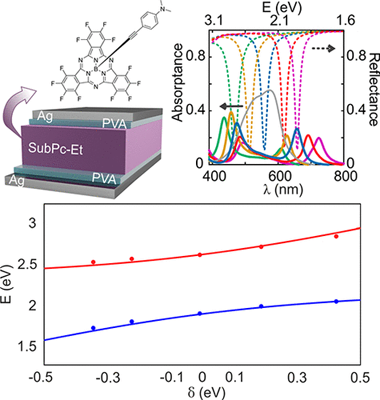
The recent development of organic polaritonic solar cells, in which sunlight absorbers and photon modes of a resonator are hybridized as a result of their strong coupling, has revealed the potential this interaction offers to control and enhance the performance of these devices. In this approach, the photovoltaic cell is built in such a way that it also behaves as an optical cavity supporting spectrally well-defined resonances, which match the broad absorption bands of the dyes employed. Herein we focus on the experimental and theoretical analysis of the specific spectral and angular optical absorption characteristics of a broadband light harvester, namely a subphthalocyanine, when operating in the ultrastrong coupling regime. We discuss the implications of having a broad distribution of oscillator strengths and demonstrate that rational design of the layered structure is needed to optimize both the spectral and the angular response of the sunlight harvester dye.
Disentangling Electron–Phonon Coupling and Thermal Expansion Effects in the Band Gap Renormalization of Perovskite Nanocrystals
Rubino, A; Francisco-Lóprez, A.; Baker, A.J., Petrozza, A.; Calvo, M.E.; Goñi, A.R.; Míguez, H.
Journal of Physical Chemistry Letters, 12 (2021) 569-575 | DOI: 10.1021/acs.jpclett.0c03042
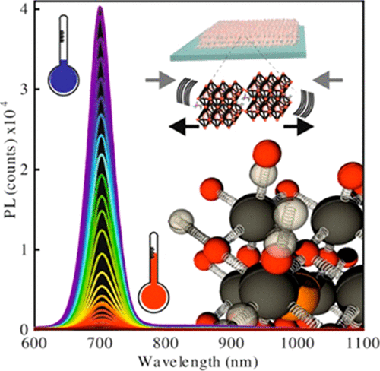
The complex electron–phonon interaction occurring in bulk lead halide perovskites gives rise to anomalous temperature dependences, like the widening of the electronic band gap as temperature increases. However, possible confinement effects on the electron–phonon coupling in the nanocrystalline version of these materials remain unexplored. Herein, we study the temperature (ranging from 80 K to ambient) and hydrostatic pressure (from atmospheric to 0.6 GPa) dependence of the photoluminescence of ligand-free methylammonium lead triiodide nanocrystals with controlled sizes embedded in a porous silica matrix. This analysis allowed us to disentangle the effects of thermal expansion and electron–phonon interaction. As the crystallite size decreases, the electron–phonon contribution to the gap renormalization gains in importance. We provide a plausible explanation for this observation in terms of quantum confinement effects, showing that neither thermal expansion nor electron–phonon coupling effects may be disregarded when analyzing the temperature dependence of the optoelectronic properties of perovskite lead halide nanocrystals.
Mechanical Performances of Isolated Cuticles Along Tomato Fruit Growth and Ripening
Benitez, JJ; Guzman-Puyol, S; Vilaplana, F; Heredia-Guerrero, JA; Dominguez, E; Heredia, A
Frontiers in Chemistry, 12 (2021) 787839 | DOI: 10.3389/fpls.2021.787839
The cuticle is the most external layer that protects fruits from the environment and constitutes the first shield against physical impacts. The preservation of its mechanical integrity is essential to avoid the access to epidermal cell walls and to prevent mass loss and damage that affect the commercial quality of fruits. The rheology of the cuticle is also very important to respond to the size modification along fruit growth and to regulate the diffusion of molecules from and toward the atmosphere. The mechanical performance of cuticles is regulated by the amount and assembly of its components (mainly cutin, polysaccharides, and waxes). In tomato fruit cuticles, phenolics, a minor cuticle component, have been found to have a strong influence on their mechanical behavior. To fully characterize the biomechanics of tomato fruit cuticle, transient creep, uniaxial tests, and multi strain dynamic mechanical analysis (DMA) measurements have been carried out. Two well-differentiated stages have been identified. At early stages of growth, characterized by a low phenolic content, the cuticle displays a soft elastic behavior. Upon increased phenolic accumulation during ripening, a progressive stiffening is observed. The increment of viscoelasticity in ripe fruit cuticles has also been associated with the presence of these compounds. The transition from the soft elastic to the more rigid viscoelastic regime can be explained by the cooperative association of phenolics with both the cutin and the polysaccharide fractions.
Fructose dehydration reaction over functionalized nanographitic catalysts in MIBK/H2O biphasic system
Martin, GD; Bounoukta, CE; Ammari, F; Dominguez, MI; Monzon, A; Ivanova, S; Centeno, MA
Catalysis Today, 366 (2021) 68-76 | DOI: 10.1016/j.cattod.2020.03.016
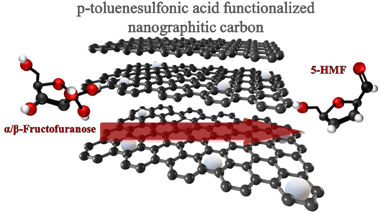
A series of functionalized nanographitic carbons is prepared, characterized and tested in fructose dehydration reaction to 5-hydroxymethylfurfural. The functionalization treatment was selected to introduce various Bro?nsted acid sites and to modify the textural and catalytic properties of the initial carbon material. Within the series, the sulfonated carbons present the most interesting catalytic behavior resulting in important selectivity to the desired product once the reaction variables were properly adjusted.
Plasma-Assisted Deposition of TiO2 3D Nanomembranes: Selective Wetting, Superomniphobicity, and Self-Cleaning
Montes, L; Roman, JM; Garcia-Casas, X; Castillo-Seoane, J; Sanchez-Valencia, JR; Barranco, A; Lopez-Santos, C; Borras, A
Advanced Materials Interfaces (2021) 2100767 | DOI: 10.1002/admi.202100767
Fabrication of tunable wetting surfaces is sought for the last years given its importance on energy, biomaterials and antimicrobials, water purification, microfluidics, and smart surfaces. Liquid management on surfaces mainly depends on the control at the micro- and nanoscale of both roughness and chemical composition. Herein, the combination of a soft-template method and plasma-enhanced chemical vapor deposition is presented for the synthesis of TiO2 nanofibers on porous substrates such as cellulose and stainless-steel membranes. The protocol, carried out under mild conditions, produces 3D nanomembranes with superhydrophobicity and oleophilicity that are tested as microliter water/oil filters. Photoactivation of TiO2 by UV illumination provides a straightforward approach for wetting tunability that converts the surface into amphiphilic. A final chemical modification of the TiO2 nanofibers by embedding them in an elastomeric polymeric shell and by fluorine-based grafting opens the path toward the formation of superomniphobic and self-cleaning surfaces with long-lasting lifetimes. Thus, a reliable procedure is demonstrated for the fabrication of TiO2 nanofibers, which allows the modification of porous supports and provides an innovative route for the development of 3D nanomembranes with under design wetting. This protocol is extendable to alternative metal oxides, metals, and core@shell nanoarchitectures with potential multifunctionalities.
Features of coupled AgBr/WO3 materials as potential photocatalysts
Puga, F.; Navío, J.A.; Hidalgo, M.C.
Journal of Alloys and Compounds, 867 (2021) 159191 | DOI: 10.1016/j.jallcom.2021.159191
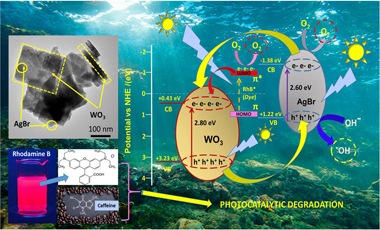
AgBr/WO3 composite photocatalysts with different selected molar AgBr/WO3 ratios were prepared and widely characterized by XRD, N2-adsorption, SEM, TEM, UV–visible/DRS and XPS techniques. The samples were tested using rhodamine B (RhB) or caffeine, under two illumination conditions (UV and visible light). Although AgBr and WO3 pristine materials have relatively low band gap values (2.6 eV and 2.8 eV, respectively), they exhibit low or no photocatalytic activity under visible light, at least for caffeine degradation. This fact may be mainly related to a high recombination rate of photogenerated charge carriers in these samples. However, the coupling of both leads to a substantial improvement in the degradation of caffeine and RhB under both UV and visible lighting conditions. The increased photocatalytic activity found in the coupled systems with respect to the pristine materials can be attributed to the formation of a type II heterostructure in the coupled AgBr/WO3 samples. Our results show that for AgBr/WO3 coupled systems, kinetic degradation profiles have clear dependence on the molar percentages of the coupled pristine materials, as well as on the nature (sensitizing or not sensitizing effect) of the substrate. For caffeine photodegradation, the best performance was obtained when AgBr/WO3(10–15%) catalysts were used. The AgBr/WO3(20%) sample showed the best photocatalytic activity for rhodamine B degradation, exhibiting also excellent dark adsorption capacity (40–45%). Additionally, studies of activity in five consecutive tests showed a good RhB degradation during the successive reuses being involving a N-de-ethylation mechanism with the main O2•− radicals participation; relatively low mineralization percentages were observed, both under UV and visible light conditions. In these successive runs, no silver leaching to the medium was observed but a change from AgBr towards Ag2CO3 and/or AgxO was produced at the catalyst surface. These features should be known in the use of these systems as potential photocatalysts for practical applications.
Impact of Tb4+ and morphology on the thermal evolution of Tb-doped TiO2 nanostructured hollow spheres and nanoparticles
Colomer, MT; Rodriguez, E; Moran-Pedroso, M; Vattier, F; de Andres, A
Journal of Alloys and Compounds, 853 (2021) 156973 | DOI: 10.1016/j.jallcom.2020.156973
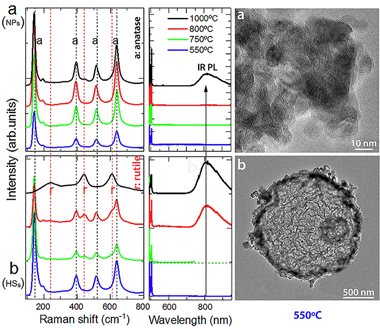
Tb-doped TiO2 hollow spheres (HSs) in the range 0.0-2.0 at.% have been synthesized by the first time to the best of our knowledge. The HSs are compared with nanoparticles (NPs) to evaluate the impact of morphology on their physicochemical and photoluminescence (PL) behavior upon increasing calcination temperature. After calcination at 550 degrees C, the particles are anatase with a primary average size of 10.0 +/- 0.2 nm for the NPs and 12.0 +/- 0.2 nm for those that form the micron sized hollow spheres of 1.8 +/- 0.2 mu m diameter and ca. 64 nm shell thickness. The temperature of the anataseerutile transition is found to be strongly dependent on the presence of Tb as well as on morphology. Contrarily to the usual stabilization of anatase when doping with trivalent rare-earth ions, the transition temperature is reduced when doping with Tb. The rutile phase is further favored for the HSs compared to the NPs probably related to the low density of the HSs and/or a more efficient packing density and/or a bigger crystal size of the nanoparticles that form those spheres with respect to the packing and the size of the NPs and/or the crystal size of the nanoparticles of the HSs with respect to the size of the NPs. Only a slight unit-cell volume increase for the anatase structure is observed upon Tb doping, in both the NPs and in the HSs, contrary to the expected increment due to the larger ionic radius of Tb3+ compared to Ti4+. In addition, the intensity of the characteristic f-f Tb3+ emission bands is extremely weak both in the anatase and rutile phases. The transition is accompanied with the emergence of an infrared emission band centered at 810 nm related to the formation of defects during the structural transformation providing deep levels in the gap that partly quench the f-f emissions in the rutile phase. The results are consistent with the presence of Tb in both +3 and +4 valence states. XPS measurements confirmed the presence of Tb3+ as well as of Tb4+ in both HSs and NPs. The large fraction of Tb4+ present in the samples originates the weak f-f emission intensity, an only slight increase of the cell parameters and the destabilization of the anatase phase.
Unveiling mechanochemistry: Kinematic-kinetic approach for the prediction of mechanically induced reactions
Gil-González, E.; Rodríguez-Laguna, M.d.R.; Sánchez-Jiménez, P.E.; Perejón, A.; Pérez-Maqueda, L.A.
Journal of Alloys and Compounds, 866 (2021) 158925 | DOI: 10.1016/j.jallcom.2021.158925
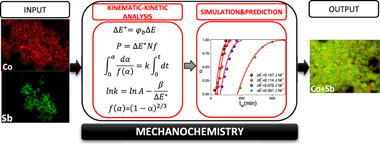
Mechanochemistry has attracted a lot of attention over the last few decades with a rapid growth in the number of publications due to its unique features. However, very little is known about how mechanical energy is converted into chemical energy. Most of the published works using mechanochemistry neglect the required attention to the experimental parameters and their effect over the resulting products, what makes extremely difficult to reproduce the results from lab to lab. Moreover, if it is taken into consideration the broad range of experimental conditions used in different studies, it is quite difficult to compare results and set optimum conditions. As a result, mechanochemistry is generally viewed as a "black box". The aim of this work is to provide some insight into mechanochemistry. Thus, a simple kinematic-kinetic approach that allows the full parametrization of mechanically induced reactions is proposed. In an analogous way to thermally activated process, it is shown that kinetic modeling can serve to parametrize and model mechanically induced reactions as a function of the milling parameters with great reliability, thereby gaining prediction capability. As a way of example, this methodology has been applied for the first time to the mechanochemical reaction of Co and Sb to form CoSb3, a skutterudite-type thermoelectric material. Moreover, the universality of this methodology has also been validated with data from the literature. A key feature of the proposed kinematic-kinetic approach is that it can be extrapolated to other mechanically induced reactions, either inorganic or organic.
Unravelling the optimization of few-layer graphene crystallinity and electrical conductivity in ceramic composites by Raman spectroscopy
Muñoz-Ferreiro, C; Lopez-Pernia, C; Gallardo-Lopez, A; Poyato, R
Journal of the European Ceramic Society, 41 (2021) 290-298 | DOI: 10.1016/j.jeurceramsoc.2021.09.025
Zirconia composites with few-layer graphene (FLG) were prepared by two powder processing routines-ultrasonic agitation or planetary ball milling-and spark plasma sintered at 1250 and 1300 degrees C. An in-depth study of the crystallinity of FLG, in terms of presence and nature of defects, was performed by Raman spectroscopy, revealing enhanced FLG crystallinity after sintering. This enhancement was more noticeable in the composites sintered at the highest temperature, with lower amount of structural defects and amorphous carbon. However, remaining amorphous carbon was detected in the composites prepared by planetary ball milling even after sintering at the highest temperature, resulting in lower electrical conductivities. Optimum results in terms of electrical conductivity were achieved for the composites prepared by ultrasonic agitation and sintered at 1300 degrees C, with electrical percolation limit below 2.5 vol% FLG and high electrical conductivity (678 S/m for 5 vol% FLG), as result of the enhanced FLG crystallinity after sintering.
HfB2 ceramic polycrystals: A low-temperature metal-like ceramic at high temperatures?
Zapata-Solvas, E; Moshtaghioun, BM; Gomez-Garcia, D; Dominguez-Rodriguez, A; Lee, WE
Scripta Materialia, 203 (2021) 114037 | DOI: 10.1016/j.scriptamat.2021.114037
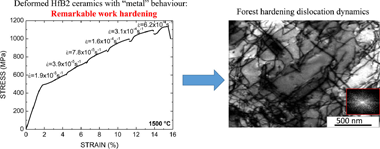
Hafnium diboride (HfB2) is a highly refractory (melting above 3000 degrees C) ceramic with many potential applications at high temperatures. To enable its use at temperature for extended periods its high-temperature plasticity must be known. This paper examines the mechanical response at temperatures between 900 degrees C and 2000 degrees C in air and in a reducing atmosphere, interpreting the data in the frame of classical models for the plasticity of compact-packed metals at low temperatures. In particular, the Friedel law and the principle of similitude for dislocation patterning are assessed. This reveals that HfB2 is a singular example of a ceramic material with "metal" mechanical behaviour.
Synthesis of clay geopolymers using olive pomace fly ash as an alternative activator. Influence of the additional commercial alkaline activator used
Gomez-Casero, MA; Moral-Moral, FJ; Perez-Villarejo, L; Sanchez-Soto, PJ; Eliche-Quesada, D
Journal of Materials Research and Technology-JMR&T 12 (2021) 1762-1776 | DOI: 10.1016/j.jmrt.2021.03.102
In this research, the use of olive pomace fly ash (OPFA) as an alkaline source for the activation of calcined clays (CC) from Bailen (Jaen, Spain) was studied. The optimal composition was obtained for 70 wt % CC and 30 wt % OPFA. The physical, mechanical and thermal properties of control geopolymers that use water as a liquid medium have been studied and compared with geopolymers that use additional activating solutions as sodium or potassium hydroxide solutions (8 M), or a mixture of alkaline hydroxide and alkaline silicate solution (NaOH-Na2SiO3 or KOH-K2SiO3). The results showed that OPFA can be used as an alkaline activator, showing mechanical properties slightly lower than those obtained when additional alkaline hydroxide activating solutions were used. The best compressive strength was obtained for geopolymers that use alkaline silicates as an activating solution. However, the best thermal insulation properties were obtained for control geopolymers. The microstructural characteristics of the geopolymers were evaluated by means of X-ray diffraction (XRD), Fourier transform infrared (FTIR) spectroscopy and Scanning Electron Microscopy (SEM-EDS) that corroborate the formation of geopolymeric gel in all the specimens, being the amount of gel formed greater in samples using commercial potassium activating solutions. These results demonstrate the feasibility of using this type of waste, OPFA, as activating reagents in the manufacture of geopolymers or alkaline activated materials. The manufactured geopolymers can be used as compressed earth blocks for walls and partitions, since the specimens pursue mechanical properties that comply with current regulations, presenting better thermal insulation properties.
Self-preserving ice layers on CO2 clathrate particles: Implications for Enceladus, Pluto, and similar ocean worlds
Bostrom, M; Esteso, V; Fiedler, J; Brevik, I; Buhmann, SY; Persson, C; Carretero-Palacios, S; Parsons, DF; Corkey, RW
Astronomy & Astrophysics, 650 (2021) A54 | DOI: 10.1051/0004-6361/202040181
Context. Gas hydrates can be stabilised outside their window of thermodynamic stability by the formation of an ice layer - a phenomenon termed self-preservation. This can lead to a positive buoyancy for clathrate particles containing CO2 that would otherwise sink in the oceans of Enceladus, Pluto, and similar oceanic worlds.Aims. Here we investigate the implications of Lifshitz forces and low occupancy surface regions on type I clathrate structures for their self-preservation through ice layer formation, presenting a plausible model based on multi-layer interactions through dispersion forces.Methods. We used optical data and theoretical models for the dielectric response for water, ice, and gas hydrates with a different occupancy. Taking this together with the thermodynamic Lifshitz free energy, we modelled the energy minima essential for the formation of ice layers at the interface between gas hydrate and liquid water.Results. We predict the growth of an ice layer between 0.01 and 0.2 mu m thick on CO, CH4, and CO2 hydrate surfaces, depending on the presence of surface regions depleted in gas molecules. Effective hydrate particle density is estimated, delimiting a range of particle size and compositions that would be buoyant in different oceans. Over geological time, the deposition of floating hydrate particles could result in the accumulation of kilometre-thick gas hydrate layers above liquid water reservoirs and below the water ice crusts of their respective ocean worlds. On Enceladus, the destabilisation of near-surface hydrate deposits could lead to increased gas pressures that both drive plumes and entrain stabilised hydrate particles. Furthermore, on ocean worlds, such as Enceladus and particularly Pluto, the accumulation of thick CO2 or mixed gas hydrate deposits could insulate its ocean against freezing. In preventing freezing of liquid water reservoirs in ocean worlds, the presence of CO2-containing hydrate layers could enhance the habitability of ocean worlds in our Solar System and on the exoplanets and exomoons beyond.
Overcoming Pd-TiO2 Deactivation during H-2 Production from Photoreforming Using Cu@Pd Nanoparticles Supported on TiO2
Platero, F; Lopez-Martin, A; Caballero, A; Rojas, TC; Nolan, M; Colon, G
ACS Applied Nano Materials, 4 (2021) 3204-3219 | DOI: 10.1021/acsanm.1c00345
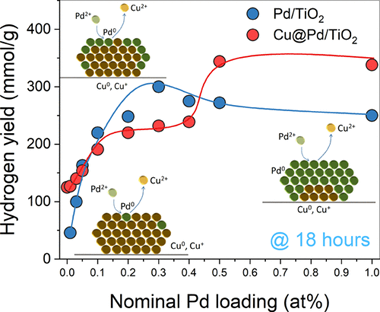
Different Cu@Pd-TiO2 systems have been prepared by a two-step synthesis to obtain a bimetallic co-catalyst for the H-2 photoreforming reaction. We find that the tailored deposition of Pd covering the Cu nanoclusters by a galvanic replacement process results in the formation of a core@shell structure. The photocatalytic H-2 production after 18 h is 350 mmol/g on the Cu@Pd-1.0-TiO2 bimetallic system, which is higher than that on the monometallic ones with a H-2 production of 250 mmol/g on Pd-supported TiO2. Surface characterization by highangle annular dark-field scanning transmission electron microscopy, H-2-temperatureprogramed reduction, CO-FTIR spectroscopy, and XPS gives clear evidence of the formation of a core@shell structure. With a Pd loading of 0.2-0.3 at. %, we propose a full coverage of the Cu nanoparticles with Pd. Long-time photoreforming runs show the enhanced performance of supported Cu@Pd with respect to bare palladium leading to a more stable catalyst and ultimately higher H-2 production.
By-products revaluation in the production of design micaceous materials
Mouchet, A; Raffin, F; Cota, A; Osuna, FJ; Pavon, E; Alba, MD
Aplied Clay Science, 214 (2021) 106292 | DOI: 10.1016/j.clay.2021.106292
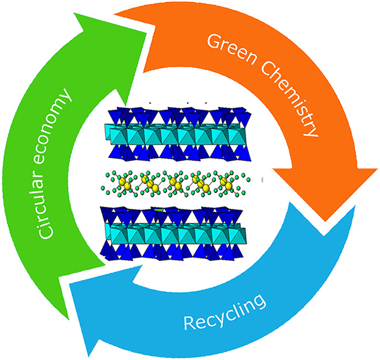
One of the main objectives of a sustainable development and circular economy is the recycling of by-products generated in industrial and agricultural production processes. One of the possible solution is the use of such by-product materials in the synthesis of environmental adsorbents. In the current research, we present the synthesis of a high charge swelling mica with enhance adsorbent properties from blast furnace slag and rice husk ash. Moreover, to ensure the sustainable synthesis a natural bentoniteis used as Si and Al source. Thus, the current study investigated the fabrication of swelling high charged micas, Na-Mn (n (layer charge) = 2 or 4), from FEBEX bentonite, blast furnace slag and rice husk ash thorough the NaCl melt method. The reaction yield, cation framework distribution and structural characteristic of micas have been studied thorough X-ray Diffraction and Solid State Nuclear Magnetic Resonance. The yields of Na-Mn synthesis and degree of purity of the mica depends on the nature of these precursors. Thus, a sustainable, non-expensive and environmental friendly process has been evaluated.
Assessing the impact of textural properties in Ni-Fe catalysts for CO2 methanation performance
Gonzalez-Castano, M; de Miguel, JCN; Boelte, JH; Centeno, MA; Klepel, O; Arellano-Garcia, H
Microporous and Mesoporous Materials, 327 (2021) 111405 | DOI: 10.1016/j.micromeso.2021.111405
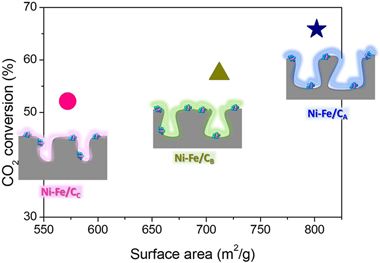
In heterogeneous catalysis, the benefits of employing adequate textural properties on the catalytic performances are usually stated. Nevertheless, the quantification of the extent of improvement is not an easy task since variations on the catalysts' specific areas and pore structures might involve modifications on a number of other surface catalytic features. This study establishes the impact of the catalyst textural properties on the CO2 methanation performance by investigating bimetallic Ni–Fe catalysts supported over carbon supports with different textural properties regarding surface area and pore structure. The comparable metal loading and dispersions attained for all systems enabled establishing forthright relationships between the catalyst textural properties and CO2 methanation rate. Once the influence of the external mass diffusions on the catalysts’ performance was experimentally discarded, the estimated Thiele modulus and internal effectiveness (φ and ηEff) values showed that the catalyst performance was majorly governed by the surface reaction rate whilst the pore size affected in no significant manner within the examined range (Dpore = 10.2 to 5.8 nm). Therefore, the rapport between the catalyst performance and surface area was quantified for the CO2 methanation reaction over Ni–Fe catalysts: increasing the surface area from 572 to 802 m2/g permit obtaining ca. 10% higher CO2 conversions.
Effect of the sulphonating agent on the catalytic behavior of activated carbons in the dehydration reaction of fructose in DMSO
Bounoukta, CE; Megias-Sayago, C; Ivanova, S; Penkova, A; Ammari, F; Centeno, MA; Odriozola, JA
Applied Catalysis A-General, 617 (2021) 118108 | DOI: 10.1016/j.apcata.2021.118108
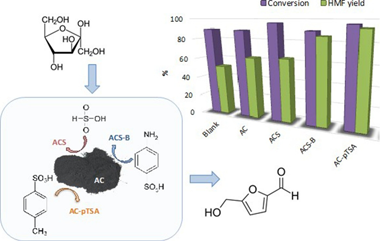
A series of -SO3R functionalized activated carbons (R=H, O, aryl) were prepared and applied in fructose dehydration reaction to 5-hydroxymethylfurfural. Different sulphonating methods introduce groups on catalyst surface with distinct donor-acceptor and hydrophilic properties. Their nature influences significantly not only activated carbon?s textural and chemical properties but also the product yields and selectivity in fructose dehydration reaction. The viability of the solvent free reaction was also investigated and compared to the performance of the catalyst series in presence of DMSO, where the best catalytic results were obtained.
In-situ HDO of guaiacol over nitrogen-doped activated carbon supported nickel nanoparticles
Jin, Wei; Pastor-Perez, Laura; Villora-Pico, Juan J.; Mercedes Pastor-Blas, M.; Odriozola, Jose A.; Sepulveda-Escribano, Antonio; Ramirez Reina, Tomas
Applied Catalysis A-General, 620 (2021) 118033 | DOI: 10.1016/j.apcata.2021.118033
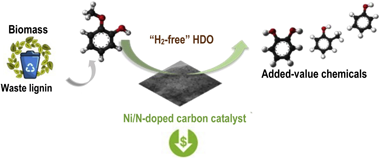
In-situ hydrodeoxygenation of guaiacol over Ni-based nitrogen-doped activated carbon supported catalysts is presented in this paper as an economically viable route for bio-resources upgrading. The overriding concept of this paper is to use water as hydrogen donor for the HDO reaction, suppressing the input of external highpressure hydrogen. The effect of nitrogen sources, including polypyrrole (PPy), polyaniline (PANI) and melamine (Mel) on the structural, electronic and ultimately of catalytic features of the designed materials have been addressed. Nitrogen-doped samples are more active than the undoped counterparts in the "H2-free" HDO process. For instance, the conversion of guaiacol increased by 8 % for Ni/PANI-AC compared to that of Ni/AC catalysts. The superior performance of Ni/NC can be attributed to the acid-base properties and modified electronic properties, which favours the C-O cleavage and water activation as well as enhances dispersion of Ni particles on the catalysts' surface.
Guaiacol hydrodeoxygenation in hydrothermal conditions using N-doped reduced graphene oxide (RGO) supported Pt and Ni catalysts: Seeking for economically viable biomass upgrading alternatives
Parrilla-Lahoz, S; Jin, W; Pastor-Perez, L; Carrales-Alvarado, D; Odriozola, JA; Dongil, AB; Reina, TR
Applied Catalysis A-General, 611 (2021) 117977 | DOI: 10.1016/j.apcata.2020.117977
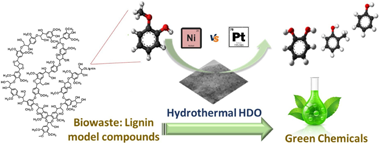
Herein we present an innovative route for model biomass compounds upgrading via “H2-free” hydrodeoxygenation (HDO) reactions. The underlaying idea is to implement a multifunctional catalyst able to activate water and subsequently use in-situ generated hydrogen for the HDO process. In this sense we have developed a series of effective Ni and Pt based catalysts supported on N-promoted graphene decorated with ceria. The catalyst reached commendable conversion levels and selectivity to mono-oxygenated compounds considering the very challenging reaction conditions. Pt outperforms Ni when the samples are tested as-prepared. However, Ni performance is remarkably boosted upon applying a pre-conditioning reductive treatment. Indeed, our NiCeO2/GOr-N present the best activity/selectivity balance and it is deemed as a promising catalyst to conduct the H2-free HDO reaction. Overall, this “proof-concept” showcases an economically appealing route for bio-compounds upgrading evidencing the key role of advanced catalysts for a low carbon future.
A Novel, Simple and Highly Efficient Route to Obtain PrBaMn2O5+δ Double Perovskite: Mechanochemical Synthesis
Garcia-Garcia, FJ; Sayagues, MJ; Gotor, FJ
Nanomaterials, 11 (2021) 380 | DOI: 10.3390/nano11020380
In this work, a mechanochemical route was proposed for the synthesis of the PrBaMn2O5+δ (PMBO) double layered perovskite phase. The mechanochemical reaction between Pr6O11, BaO2, and MnO powders with cationic stoichiometric ratios of 1/1/2 for Pr/Ba/Mn was performed using high-energy milling conditions in air. After 150 min of milling, a new phase with perovskite structure and cubic symmetry consistent with the A-site disordered Pr0.5Ba0.5MnO3 phase was formed. When this new phase was subsequently annealed at a high temperature in an inert Ar atmosphere, the layered PrBaMn2O5+δ phase was obtained without needing to use a reducing atmosphere. At 1100 °C, the fully reduced layered PrBaMn2O5 phase was achieved. A weight gain was observed in the 200–300 °C temperature range when this fully reduced phase was annealed in air, which was consistent with the transformation into the fully oxidized PrBaMn2O6 phase. The microstructural characterization by SEM, TEM, and HRTEM ascertained the formation of the intended PrBaMn2O5+δ phase. Electrical characterization shows very high electrical conductivity of layered PBMO in a reducing atmosphere and suitable in an oxidizing atmosphere, becoming, therefore, excellent candidates as solid oxide fuel cell (SOFC electrodes).
Pd-C Catalytic Thin Films Prepared by Magnetron Sputtering for the Decomposition of Formic Acid
Arzac, GM; Fernandez, A; Godinho, V; Hufschmidt, D; de Haro, MCJ; Medran, B; Montes, O
Nanomaterials, 11 (2021) 2326 | DOI: 10.3390/nano11092326
Formic acid is an advantageous liquid organic hydrogen carrier. It is relatively nontoxic and can be synthesized by the reaction of CO2 with sustainable hydrogen or by biomass decomposition. As an alternative to more widely studied powdery catalysts, supported Pd-C catalytic thin films with controlled nanostructure and compositions were newly prepared in this work by magnetron sputtering on structured supports and tested for the formic acid decomposition reaction. A two-magnetron configuration (carbon and tailored Pd-C targets) was used to achieve a reduction in Pd consumption and high catalyst surface roughness and dispersion by increasing the carbon content. Activity and durability tests were carried out for the gas phase formic acid decomposition reaction on SiC foam monoliths coated with the Pd-C films and the effects of column width, surface roughness and thermal pre-reduction time were investigated. Activity of 5.04 mol(H2)center dot g(Pd)(-1)center dot h(-1) and 92% selectivity to the dehydrogenation reaction were achieved at 300 degrees C for the catalyst with a lower column width and higher carbon content and surface roughness. It was also found that deactivation occurs when Pd is sintered due to the elimination of carbon and/or the segregation and agglomeration of Pd upon cycling. Magnetron sputtering deposition appears as a promising and scalable route for the one-step preparation of Pd-C catalytic films by overcoming the different deposition characteristics of Pd and C with an appropriate experimental design.
In Situ DRIFTS-MS Methanol Adsorption Study onto Supported NiSn Nanoparticles: Mechanistic Implications in Methanol Steam Reforming
Bobadilla, LF; Azancot, L; Ivanova, S; Delgado, JJ; Romero-Sarria, F; Centeno, MA; Roger, AC
Nanomaterials, 11 (2021) 3234 | DOI: 10.3390/nano11123234
Methanol adsorption over both supported NiSn Nps and analogous NiSn catalyst prepared by impregnation was studied by in situ diffuse reflectance infrared Fourier transform spectroscopy (DRIFTS) to gain insights into the basis of hydrogen production from methanol steam reforming. Different intermediate species such as methoxides with different geometry (bridge and monodentate) and formate species were identified after methanol adsorption and thermal desorption. It is proposed that these species are the most involved in the methanol steam reforming reaction and the major presence of metal-support interface sites in supported NiSn Nps leads to higher production of hydrogen. On the basis of these results, a plausible reaction mechanism was elucidated through the correlation between the thermal stability of these species and the evolution of the effluent gas released. In addition, it was demonstrated that DME is a secondary product generated by condensation of methoxides over the acid sites of alumina support in an acid-catalyzed reaction.
Mechanically Switchable Wetting Petal Effect in Self-Patterned Nanocolumnar Films on Poly(dimethylsiloxane)
Parra-Barranco, J; Lopez-Santos, C; Sanchez-Valencia, JR; Borras, A; Gonzalez-Elipe, AR; Barranco, A
Nanomaterials, 11 (2021) 2566 | DOI: 10.3390/nano11102566
Switchable mechanically induced changes in the wetting behavior of surfaces are of paramount importance for advanced microfluidic, self-cleaning and biomedical applications. In this work we show that the well-known polydimethylsiloxane (PDMS) elastomer develops self-patterning when it is coated with nanostructured TiO2 films prepared by physical vapor deposition at glancing angles and subsequently subjected to a mechanical deformation. Thus, unlike the disordered wrinkled surfaces typically created by deformation of the bare elastomer, well-ordered and aligned micro-scaled grooves form on TiO2/PDMS after the first post-deposition bending or stretching event. These regularly patterned surfaces can be reversibly modified by mechanical deformation, thereby inducing a switchable and reversible wetting petal effect and the sliding of liquid droplets. When performed in a dynamic way, this mechanical actuation produces a unique capacity of liquid droplets (water and diiodomethane) transport and tweezing, this latter through their selective capture and release depending on their volume and chemical characteristics. Scanning electron and atomic force microscopy studies of the strained samples showed that a dual-scale roughness, a parallel alignment of patterned grooves and their reversible widening upon deformation, are critical factors controlling this singular sliding behavior and the possibility to tailor their response by the appropriate manufacturing of surface structures.
New Insights on the Conversion Reaction Mechanism in Metal Oxide Electrodes for Sodium-Ion Batteries
Mosa, J; Garcia-Garcia, FJ; Gonzalez-Elipe, AR; Aparicio, M
Nanomaterials, 11 (2021) 966 | DOI: 10.3390/nano11040966
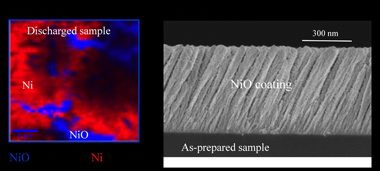
Due to the abundance and low cost of exchanged metal, sodium-ion batteries have attracted increasing research attention for the massive energy storage associated with renewable energy sources. Nickel oxide (NiO) thin films have been prepared by magnetron sputtering (MS) deposition under an oblique angle configuration (OAD) and used as electrodes for Na-ion batteries. A systematic chemical, structural and electrochemical analysis of this electrode has been carried out. The electrochemical characterization by galvanostatic charge-discharge cycling and cyclic voltammetry has revealed a certain loss of performance after the initial cycling of the battery. The conversion reaction of NiO with sodium ions during the discharge process to generate sodium oxide and Ni metal has been confirmed by X-ray photoelectron spectra (XPS) and micro-Raman analysis. Likewise, it has been determined that the charging process is not totally reversible, causing a reduction in battery capacity.
LED-driven controlled deposition of Ni onto TiO2 for visible-light expanded conversion of carbon dioxide into C-1-C-2 alkanes
Sanz-Marco, A; Hueso, JL; Sebastian, V; Nielsen, D; Mossin, S; Holgado, JP; Bueno-Alejo, CJ; Balas, F; Santamaria, J
Nanoscale Advances | DOI: 10.1039/d1na00021g
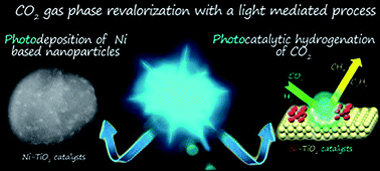
Photocatalytic gas-phase hydrogenation of CO2 into alkanes was achieved over TiO2-supported Ni nanoparticles under LED irradiation at 365 nm, 460 nm and white light. The photocatalysts were prepared using photo-assisted deposition of Ni salts under LED irradiation at 365 nm onto TiO2 P25 nanoparticles in methanol as a hole scavenger. This procedure yielded 2 nm Ni particles decorating the surface of TiO2 with a nickel mass content of about 2%. Before the photocatalytic runs, Ni/TiO2 was submitted to thermal reduction at 400 °C in a 10% H2 atmosphere which induced O-defective TiO2−x substrates. The formation of oxygen vacancies, Ti3+ centers and metallic Ni sites upon photocatalytic CO2 hydrogenation was confirmed by operando EPR analysis. In situ XPS under reaction conditions suggested a strong metal–support interaction and the co-existence of zero and divalent Ni states. These photoactive species enhanced the photo-assisted reduction of CO2 below 300 °C to yield CO, CH4 and C2H6 as final products.
K-Promoted Ni-Based Catalysts for Gas-Phase CO2 Conversion: Catalysts Design and Process Modelling Validation
Gandara-Loe, J; Portillo, E; Odriozola, JA; Reina, TR; Pastor-Perez, L
Frontiers in Chemistry, 9 (2021) 785571 | DOI: 10.3389/fchem.2021.785571
The exponential growth of greenhouse gas emissions and their associated climate change problems have motivated the development of strategies to reduce CO2 levels via CO2 capture and conversion. Reverse water gas shift (RWGS) reaction has been targeted as a promising pathway to convert CO2 into syngas which is the primary reactive in several reactions to obtain high-value chemicals. Among the different catalysts reported for RWGS, the nickel-based catalyst has been proposed as an alternative to the expensive noble metal catalyst. However, Ni-based catalysts tend to be less active in RWGS reaction conditions due to preference to CO2 methanation reaction and to the sintering and coke formation. Due to this, the aim of this work is to study the effect of the potassium (K) in Ni/CeO2 catalyst seeking the optimal catalyst for low-temperature RWGS reaction. We synthesised Ni-based catalyst with different amounts of K:Ni ratio (0.5:10, 1:10, and 2:10) and fully characterised using different physicochemical techniques where was observed the modification on the surface characteristics as a function of the amount of K. Furthermore, it was observed an improvement in the CO selectivity at a lower temperature as a result of the K-Ni-support interactions but also a decrease on the CO2 conversion. The 1K catalyst presented the best compromise between CO2 conversion, suppression of CO2 methanation and enhancing CO selectivity. Finally, the experimental results were contrasted with the trends obtained from the thermodynamics process modelling observing that the result follows in good agreement with the modelling trends giving evidence of the promising behaviour of the designed catalysts in CO2 high-scale units.
Bimetallic Ni-Ru and Ni-Re Catalysts for Dry Reforming of Methane: Understanding the Synergies of the Selected Promoters
Moreno, AA; Ramirez-Reina, T; Ivanova, S; Roger, AC; Centeno, MA; Odriozola, JA
Frontiers in Chemistry, 9 (2021) 694976 | DOI: 10.3389/fchem.2021.694976
Designing an economically viable catalyst that maintains high catalytic activity and stability is the key to unlock dry reforming of methane (DRM) as a primary strategy for biogas valorization. Ni/Al2O3 catalysts have been widely used for this purpose; however, several modifications have been reported in the last years in order to prevent coke deposition and deactivation of the samples. Modification of the acidity of the support and the addition of noble metal promoters are between the most reported strategies. Nevertheless, in the task of designing an active and stable catalyst for DRM, the selection of an appropriate noble metal promoter is turning more challenging owing to the lack of homogeneity of the different studies. Therefore, this research aims to compare Ru (0.50 and 2.0%) and Re (0.50 and 2.0%) as noble metal promoters for a Ni/MgAl2O4 catalyst under the same synthesis and reaction conditions. Catalysts were characterized by XRF, BET, XRD, TPR, hydrogen chemisorption (H2-TPD), and dry reforming reaction tests. Results show that both promoters increase Ni reducibility and dispersion. However, Ru seems a better promoter for DRM since 0.50% of Ru increases the catalytic activity in 10% and leads to less coke deposition.
Elucidating the Promotional Effect of Cerium in the Dry Reforming of Methane
Rodriguez-Gomez, A; Lopez-Martin, A; Ramirez, A; Gascon, J; Caballero, A
Chemcatchem, 13 (2021) 553-563 | DOI: 10.1002/cctc.202001527
A series of Ni-Ce catalysts supported on SBA-15 has been prepared by co-impregnation, extensively characterized and evaluated in the carbon dioxide reforming of methane (DRM). The characterization by TEM, XRD and TPR has allowed us to determine the effect of metal loading on metal dispersion. Cerium was found to improve nickel location inside the mesopores of SBA-15 and to suppress coke formation during the DRM reaction. The analysis by XPS allowed us to associate the high cerium dispersion with the presence of low-coordinated Ce3+ sites, being main responsible for its promotional effect. A combination of XAS and XPS has permitted us to determine the physicochemical properties of metals under reduction conditions. The low nickel coordination number determined by XAS in N-Ce doped systems after reduction suggests the generation of very small nickel particles which showed greater catalytic activity and stability in the reaction, and a remarkable resistance to coke formation.
Mechanistic Considerations on the H-2 Production by Methanol Thermal-assisted Photocatalytic Reforming over Cu/TiO2 Catalyst
Platero, F; Lopez-Martin, A; Caballero, A; Colon, G
CHEMCATCHEM, 13 (2021) 3878-3888 | DOI: 10.1002/cctc.202100680
We have studied the gas phase H-2 production by methanol thermo-photoreforming using Cu-modified TiO2. Metal co-catalyst has been deposited by means of photodeposition method. The concentration of methanol in the steam was also considered. It appears that H-2 production is notably higher as temperature increases. Moreover, the optimum H-2 yield is achieved using methanol concentration of 10 % v/v. CO and CO2 were monitored as side products of the overall reaction. It has been stated that CO evolution is significant at lower temperatures. As temperature increases, CO evolution is hindered and H-2 appeared boosted. We have demonstrated that other reactions such water-gas-shift or formate dehydration would participate in the overall process. On this basis, optimal operational condition for H-2 production is attained for thermo-photocatalytic reforming of methanol solution 10 % v/v at 200 degrees C.
Dysprosium and Holmium Vanadate Nanoprobes as High-Performance Contrast Agents for High-Field Magnetic Resonance and Computed Tomography Imaging
Gomez-Gonzalez, E; Nunez, NO; Caro, C; Garcia-Martin, ML; Fernandez-Afonso, Y; de la Fuente, JM; Balcerzyk, M; Ocana, M
Inorganic Chemistry, 60 (2021) 152-160 | DOI: 10.1021/acs.inorgchem.0c02601
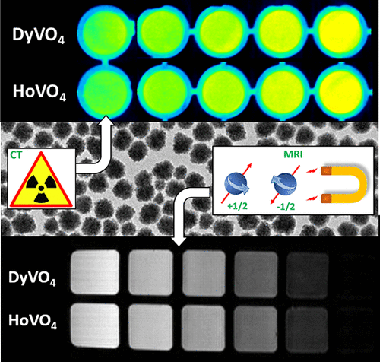
We describe a wet chemical method for the synthesis of uniform and well-dispersed dysprosium vanadate (DyVO4) and holmium vanadate (HoVO4) nanoparticles with an almost spherical shape and a mean size of ∼60 nm and their functionalization with poly(acrylic acid). The transverse magnetic relaxivity of both systems at 9.4 T is analyzed on the basis of magnetic susceptibility and magnetization measurements in order to evaluate their potential for application as high-field MRI contrast agents. In addition, the X-ray attenuation properties of these systems are also studied to determine their capabilities as computed tomography contrast agent. Finally, the colloidal stability under physiological pH conditions and the cytotoxicity of the functionalized NPs are also addressed to assess their suitability for bioimaging applications.
Kinetic study of complex processes composed of non-independent stages: pyrolysis of natural rubber
Perejon, A; Sánchez-Jiménez, PE; García-Garrido, C; Pérez-Maqueda, LA
Polymer Degradation and Stability, 188 (2021) 109590 | DOI: 10.1016/j.polymdegradstab.2021.109590
In this work, it is proposed a method for studying kinetics of complex processes composed of non-independent stages. In this method, the variable contribution of the different stages as a function of the heating schedule is taken into account. The method involves the simultaneous kinetic analysis of a set of experimental data registered under linear heating rate conditions, without any previous assumptions regarding the kinetic models followed by the stages or their corresponding activation energies.
The method has been tested with the kinetic analysis of the pyrolysis of natural rubber, since the kinetics of this process is complex and depends on temperature and heating schedule. It is demonstrated that the behavior of the experimental curves can be accurately predicted with the kinetic parameters calculated by the proposed methodology.
The kinetic analysis presented here could be applied to other complex processes as those found in pyrolysis, without the need of using oversimplified kinetic models that could yield significant errors when used in real applications.
Zr and Fe on Pt/CeO2-MOx/Al2O3 catalysts for WGS reaction
Gonzalez-Castano, M; Ivanova, S; Centeno, MA; Ioanides, T; Arellano-Garcia, H; Odriozola, JA
International Journal of Hydrogen Energy, (2021) | DOI: 10.1002/er.6646
By evaluating the functional modifications induced by Zr and Fe as dopants in Pt/CeO2‐MOx/Al2O3 catalysts (M = Fe and Zr), the key features for improving water gas shift (WGS) performance for these systems have been addressed. Pt/ceria intrinsic WGS activity is often related to improved H2 surface dynamics, H2O absorption, retentions and dissociation capacities which are influenced greatly by the support nature. Two metals, iron and zirconia, were chosen as ceria dopants in this work, either in separate manner or combined. Iron incorporation resulted in CO‐redox properties and oxygen storage capacities (OSC) improvement but the formation of Ce‐Fe solid solutions did not offer any catalytic benefit, while the Zr incorporation influenced in a great manner surface electron densities and shows higher catalytic activity. When combined both metals showed an important synergy evidenced by 30% higher CO conversions and attributed to greater surface electron densities population and therefore absorption and activity. This work demonstrates that for Pt/ceria catalysts OSC enhancement does not necessarily imply a catalytic promotion.
Enhanced Stability of Perovskite Solar Cells Incorporating Dopant-Free Crystalline Spiro-OMeTAD Layers by Vacuum Sublimation
Barranco, A; Lopez-Santos, MC; Idigoras, J; Aparicio, FJ; Obrero-Perez, J; Lopez-Flores, V; Contreras-Bernal, L; Rico, V; Ferrer, J; Espinos, JP; Borras, A; Anta, JA; Sanchez-Valencia, JR
Advanced Energy Materials, (2020) 1901524 | DOI: 10.1002/aenm.201901524
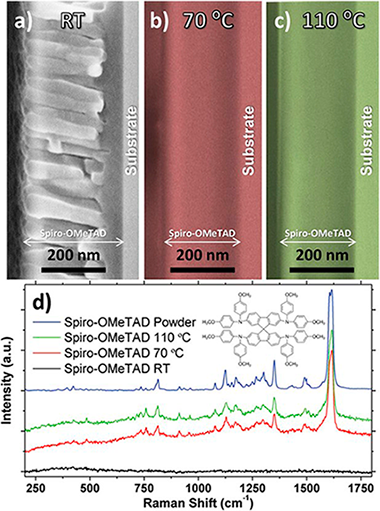
The main handicap still hindering the eventual exploitation of organometal halide perovskite-based solar cells is their poor stability under prolonged illumination, ambient conditions, and increased temperatures. This article shows for the first time the vacuum processing of the most widely used solid-state hole conductor (SSHC), i.e., the Spiro-OMeTAD [2,2 ',7,7 '-tetrakis (N,N-di-p-methoxyphenyl-amine) 9,9 '-spirobifluorene], and how its dopant-free crystalline formation unprecedently improves perovskite solar cell (PSC) stability under continuous illumination by about two orders of magnitude with respect to the solution-processed reference and after annealing in air up to 200 degrees C. It is demonstrated that the control over the temperature of the samples during the vacuum deposition enhances the crystallinity of the SSHC, obtaining a preferential orientation along the pi-pi stacking direction. These results may represent a milestone toward the full vacuum processing of hybrid organic halide PSCs as well as light-emitting diodes, with promising impacts on the development of durable devices. The microstructure, purity, and crystallinity of the vacuum sublimated Spiro-OMeTAD layers are fully elucidated by applying an unparalleled set of complementary characterization techniques, including scanning electron microscopy, X-ray diffraction, grazing-incidence small-angle X-ray scattering and grazing-incidence wide-angle X-ray scattering, X-ray photoelectron spectroscopy, and Rutherford backscattering spectroscopy.
Hydrodeoxygenation of vanillin over noble metal catalyst supported on biochars: Part II: Catalytic behaviour
Santos, JL; Maki-Arvela, P; Warna, J; Monzon, A; Centeno, MA; Murzin, DY
Applied Catalysis B-Environmental, 268 (2020) 118425 | DOI: 10.1016/j.apcatb.2019.118425
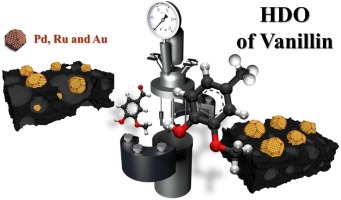
Vanillin hydrodeoxygenation was investigated using noble metal (Pd, Au, Ru) supported on active carbon prepared from waste derived biochars, which were produced via pyrolysis in CO2 atmosphere. Chemical activation with ZnCl2 and HNO3 was also used in the preparation of active carbon to enhance the specific surface area and demineralize material, respectively. Both fresh and spent catalysts were characterized with X-ray diffraction, DRIFTS, zeta potential measurement and HR-TEM. The highest selectivity to p-creosol, 92 % selectivity at complete vanillin conversion after 3 h was obtained in vanillin hydrodeoxygenation at 100 degrees C under 30 bar in hydrogen in water with Pd/C catalyst prepared via pyrolysis under CO2 from wine waste and using ZnCl2 as a chemical activation agent. Hydrodeoxygenation activity increased with increasing metal dispersion. A kinetic model including adsorption of vanillin described well the experimental data.
(NH4)4[NiMo6O24H6].5H2O / g-C3N4 materials for selective photo-oxidation of Csingle bondO and Cdouble bondC bonds
Caudillo-Flores, U; Ansari, F; Bachiller-Baeza, B; Colon, G; Fernandez-Garcia, M; Kubacka, A
Applied Catalysis B-Environmental, 278 (2020) 119299 | DOI: 10.1016/j.apcatb.2020.119299
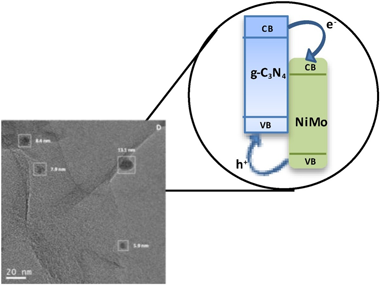
Novel composite photo-catalysts having (NH4)(4)[NiMo6O24H6]center dot 5H(2)O Polyoxometalate (POM) species deposited over g-C3N4 are synthesized. Materials were characterized through a multitechnique approach showing the stability of the carbon nitride component both through the synthesis process and under reaction. Contrarily, the POM component evolves under reaction conditions to maximize the interaction with the support. Such a behavior renders, as measured by the quantum efficiency, highly active photo-catalysts in the photo-oxidation of 2-propanol and styrene both under UV and sunlight illumination, setting up the basis for a green catalytic process. The material having a 4 wt. % POM showed improved activity with respect to both parent constituents but also higher selectivity to the partial oxidation of the alcohol and the aromatic hydrocarbon to generate added value chemical compounds. A multitechnique approach investigating charge carrier fate demonstrates the key role played by the interaction between components to promote activity and selectivity in selective oxidation reactions.
Experimental evidence of HCO species as intermediate in the fischer tropsch reaction using operando techniques
Diaz-Sanchez, RM; de-Paz-Carrion, A; Serrera-Figallo, MA; Torres-Lagares, D; Barranco, A; Leon-Ramos, JR; Gutierrez-Perez, JL
Applied Catalysis B-Environmental, 272 (2020) 119032 | DOI: 10.1016/j.apcatb.2020.119032
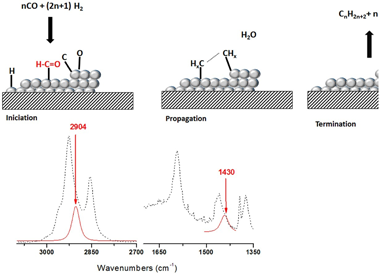
Fischer Tropsch's reaction, known from 1925, receives special attention nowadays due to its key role in the CO2 or biomass valorization to liquid fuels and chemicals. Several aspects on the exact mechanism or the role of water in this reaction are not yet completely clear. Formyl species, HCO, have been proposed as the most probable reaction intermediate, but they have never been observed under operation conditions closed to the real ones. In this work, using DRIFTS-MS operando techniques, HCO intermediates are detected under a H2/CO flow and 200 °C. IR bands at 2900 cm−1 and 1440 cm−1 attributed to ν(C–H) and δ(HCO) vibrations modes characterize these species. Evolution of these bands with the reaction time evidences its high reactivity with OH groups, which explains the positive effect of water on the CO conversion previously observed.
Metal catalysts supported on biochars: Part I synthesis and characterization
Santos, JL; Maki-Arvela, P; Monzon, A; Murzin, DY; Centeno, MA
Applied Catalysis B-Environmental, 268 (2020) 118423 | DOI: 10.1016/j.apcatb.2019.118423
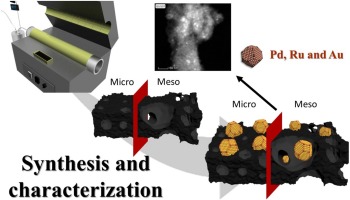
In the current study, synthesis and detailed characterization of cellulose biochars as a waste biomass model component and vine shoot biochars as a real waste biomass catalyst was performed. Although initially biochars exhibit poor textural properties, a simple activation process can make them much more suitable as a catalyst supports. A combination of physical (CO2) and chemical activation (ZnCl2) was evaluated. The characterization results indicated that the surface area and pore volume of the biochars have increased significantly by chemical activation treatment with ZnCl2. A series of metal catalysts (Pd, Au and Ru) supported on biochars was prepared and characterized. The prepared materials represent a set of noble metal catalysts supported on biochars with different textural and surface properties, which can be used to evaluate the catalytic role of the active phase and carbon support nature in catalytic reactions of interest, such as hydrodeoxygenation, described in the part II.
Chemistry and Electrocatalytic Activity of Nanostructured Nickel Electrodes for Water Electrolysis
Lopez-Fernandez, E; Gil-Rostra, J; Espinos, JP; Gonzalez-Elipe, AR; Consuegra, AD; Yubero, F
ACS Catalysis, 10 (2020) 6159-6170 | DOI: 10.1021/acscatal.0c00856
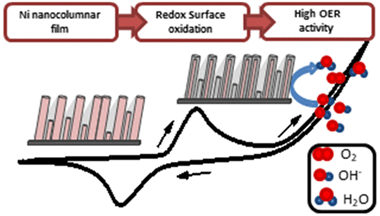
Herein we have developed nanostructured nickel-based electrode films for anion exchange membrane water electrolysis (AEMWE). The electrodes were prepared by magnetron sputtering (MS) in an oblique angle configuration and under various conditions aimed at preparing metallic, oxide, or oxyhydroxide films. Their electrochemical analysis has been complemented with a thorough physicochemical characterization to determine the effect of microstructure, chemical state, bilayer structure, and film thickness on the oxygen evolution reaction (OER). The maximum electrocatalytic activity was found for the metallic electrode, where analysis by X-ray photoelectron spectroscopy (XPS) and X-ray absorption spectroscopy (XAS) demonstrated that the active catalytic phase at the surface after its electrochemical conditioning is a kind of oxidized nickel oxide/hydroxide layer with the thickness of a few nanometers. Electrochemical impedance spectroscopy analysis of these steady-state working electrodes supports that the enhanced performance of the metallic nickel anode vs other chemical states resides in the easier electron transfer through the electrode films and the various interlayers built up during their fabrication and activation. The long-term steady-state operation of the anodes and their efficiency for water splitting was proved in a full-cell AEMWE setup incorporating magnetron-sputtered metallic nickel as the cathode. This work proves that MS is a suitable technique to prepare active, stable, and low-cost electrodes for AEMWE and the capacity of this technique to control the chemical state of the electrocatalytically active layers involved in the OER.
Recent progress on the enhancement of photocatalytic properties of BiPO4 using π–conjugated materials
Naciri, Y., Hsini, A., Ajmal, Z., Navio, J.A., Bakiz, B., Albourine, A., Ezahri, M., Benlhachemi, A.
Advances in Colloid and Interface Science, 280 (2020) 102160 | DOI: 10.1016/j.cis.2020.102160
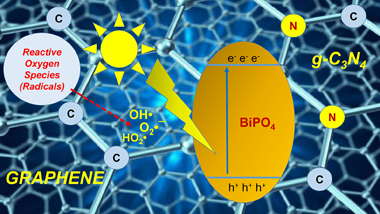
Semiconductor photocatalysis is regarded as most privileged solution for energy conversion and environmental application. Recently, photocatalysis methods using bismuth-based photocatalysts, such as BiPO4, have been extensively investigated owing to their superior efficacy regarding organic pollutant degradation and their further mineralization into CO2 and H2O. It is well known that BiPO4 monoclinic phase exhibited better photocatalytic performance compared to Degussa (Evonik) P25 TiO2 in term of ultraviolet light driven organic pollutants degradation. However, its wide band gap, poor adsorptive performance and large size make BiPO4 less active under visible light irradiation. However, extensive research works have been conducted in the past with the aim of improving visible light driven BiPO4 activity by constructing a series of heterostructures, mainly coupled with π-conjugated architecture (e.g., conductive polymer, dye sensitization and carbonaceous materials). However, a critical review of modified BiPO4 systems using π-conjugated materials has not been published to date. Therefore, this current review article was designed with the aim of presenting a brief current state-of-the-art towards synthesis methods of BiPO4 in the first section, with an especial focuses onto its crystal-microstructure, optical and photocatalytic properties. Moreover, the most relevant strategies that have been employed to improve its photocatalytic activities are then addressed as the main part of this review. Finally, the last section presents ongoing challenges and perspectives for modified BiPO4 systems using π–conjugated materials
Role of particle size on the multicycle calcium looping activity of limestone for thermochemical energy storage
Duran-Martin, JD; Jimenez, PES; Valverde, JM; Perejon, A; Arcenegui-Troya, J; Trinanes, PG; Maqueda, LAP
Journal of Advanced Research, 22 (2020) 67-76 | DOI: 10.1016/j.jare.2019.10.008
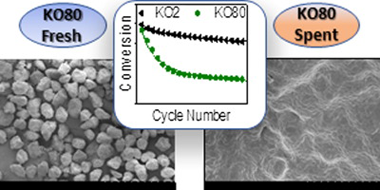
The calcium looping process, based on the reversible reaction between CaCO3 and CaO, is recently attracting a great deal of interest as a promising thermochemical energy storage system to be integrated in Concentrated Solar Power plants (CaL-CSP). The main drawbacks of the system are the incomplete conversion of CaO and its sintering-induced deactivation. In this work, the influence of particle size in these deactivation mechanisms has been assessed by performing experimental multicycle tests using standard limestone particles of well-defined and narrow particle size distributions. The results indicate that CaO multicycle conversion benefits from the use of small particles mainly when the calcination is carried out in helium at low temperature. Yet, the enhancement is only significant for particles below 15 μm. On the other hand, the strong sintering induced by calcining in CO2 at high temperatures makes particle size much less relevant for the multicycle performance. Finally, SEM imaging reveals that the mechanism responsible for the loss of activity is mainly pore-plugging when calcination is performed in helium, whereas extensive loss of surface area due to sintering is responsible for the deactivation when calcination is carried out in CO2 at high temperature.
Mesoporous Matrices as Hosts for Metal Halide Perovskite Nanocrystals
Rubino, A; Calio, L; Garcia-Bennett, A; Calvo, ME; Miguez, H
Advanced Optical Materials, (2020) 201901868 | DOI: 10.1002/adom.201901868
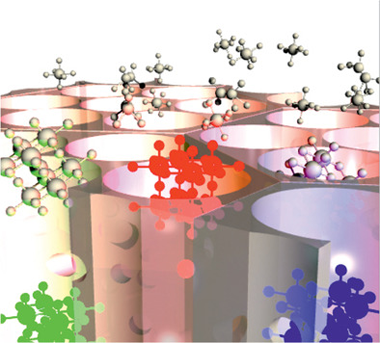
Several works have recently demonstrated that perovskite nanocrystals can be controllably formed within a variety of porous matrices employing diverse synthetic strategies. By means of the fine tuning of the pore size distribution, the thickness and composition of the walls, the geometry of the void network and its topology, strict control over the structural and morphological parameters of the hosted semiconductor can be achieved, determining its optical absorption and emission properties. Furthermore, porous hosts provide the guest semiconductor with enhanced stability and versatility in terms of processing, which favors its integration in devices. This article provides a comprehensive review of the different approaches proposed, as well as a discussion on the relevance they may have for the development of nanostructured perovskite-based optoelectronics. A critical assessment of the optical quality of the hybrid perovskite nanomaterials so obtained is presented, as well as an analysis of the fundamental and applied aspects of the nanocrystal-matrix interaction and a projected prospect of their impact in the fields of artificial lighting and renewable energy.
An electrochemical evaluation of nitrogen-doped carbons as anodes for lithium ion batteries
Gomez-Martin, A; Martinez-Fernandez, J; Ruttert, M; Winter, M; Placke, T; Ramirez-Rico, J
Carbon, 164 (2020) 261-271 | DOI: 10.1016/j.carbon.2020.04.003

New anode materials beyond graphite are needed to improve the performance of lithium ion batteries (LIBs). Chemical doping with nitrogen has emerged as a simple strategy for enhancing lithium storage in carbon-based anodes. While specific capacity and rate capability are improved by doping, little is known about other key electrochemical properties relevant to practical applications. This work presents a systematic evaluation of electrochemical characteristics of nitrogen-doped carbons derived from a biomass source and urea powder as anodes in LIB half- and full-cells. Results show that doped carbons suffer from a continuous loss in capacity upon cycling that is more severe for higher nitrogen contents. Nitrogen negatively impacts the voltage and energy efficiencies at low charge/discharge current densities. However, as the charge/discharge rate increases, the voltage and energy efficiencies of the doped carbons outperform the non-doped ones. We provide insights towards a fundamental understanding of the requirements needed for practical applications and reveal drawbacks to be overcome by novel doped carbon-based anode materials in LIB applications. With this work, we also want to encourage other researchers to evaluate electrochemical characteristics besides capacity and cycling stability which are mandatory to assess the practicality of novel materials.
Performance trends in wall-flow diesel particulate filters: Comparative analysis of their filtration efficiency and pressure drop
Orihuela, MP; Chacartegui, R; Gomez-Martin, A; Ramirez-Rico, J; Villanueva, JAB
Journal of Cleaner Production, 60 (2020) 12063 | DOI: 10.1016/j.jclepro.2020.120863
Soot and particulate emissions from the transport sector are a major concern worldwide, given their harmful effects on public health and the environment. On-road vehicles are the main contributing source to this kind of pollution. They are strictly regulated in many countries, with limitations on the number and concentration of released particles, and they must be equipped with particle abatement systems. Wall-flow particulate filters are the most popular and effective devices to reduce particulate emissions from diesel and gasoline vehicles. Diesel Particulate Filters (DPFs) have been a recurrent research topic since the last century. There are different research studies analysing different aspects of these systems, at different levels, using different methodologies and different approaches. Their results are not always comparable. This work analyses the latest advances and trends in this technology by comparing two relevant performance parameters: their filtration efficiency and pressure drop. The findings of this study suggest that, in order to be competitive, upcoming DPFs should have filtration efficiencies above 80%, and pressure drops below 10 kPa, for space velocities of 1.5.10(5) h(-1) or more at the clean state. They should reach similar to 100% efficiency after a short operation period, before the soot load reaches 0.2 g/L. Later, they should keep a low pressure drop for a longer time, with a reference of no more than 13 kPa for 6 g/L of soot load. Based on this analysis, this work proposes some test criteria and suggestions for the main parameters.
Plasma-Enabled Amorphous TiO2 Nanotubes as Hydrophobic Support for Molecular Sensing by SERS
Filippin, N; Castillo-Seoane, J; Lopez-Santos, MC; Rojas, CT; Ostrikov, K; Barranco, A; Sanchez-Valencia, JR; Borras, A
ACS Applied Materials & Interfaces, 12 (2020) 50721-50733 | DOI: 10.1021/acsami.0c14087
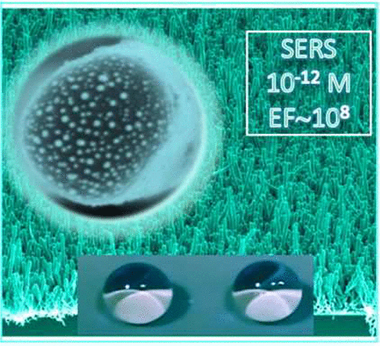
We devise a unique heteronanostructure array to overcome a persistent issue of simultaneously utilizing the surface-enhanced Raman scattering, inexpensive, Earth-abundant materials, large surface areas, and multifunctionality to demonstrate near single-molecule detection. Room-temperature plasma-enhanced chemical vapor deposition and thermal evaporation provide high-density arrays of vertical TiO2 nanotubes decorated with Ag nanoparticles. The role of the TiO2 nanotubes is 3-fold: (i) providing a high surface area for the homogeneous distribution of supported Ag nanoparticles, (ii) increasing the water contact angle to achieve superhydrophobic limits, and (iii) enhancing the Raman signal by synergizing the localized electromagnetic field enhancement (Ag plasmons) and charge transfer chemical enhancement mechanisms (amorphous TiO2) and by increasing the light scattering because of the formation of vertically aligned nanoarchitectures. As a result, we reach a Raman enhancement factor of up to 9.4 × 107, satisfying the key practical device requirements. The enhancement mechanism is optimized through the interplay of the optimum microstructure, nanotube/shell thickness, Ag nanoparticles size distribution, and density. Vertically aligned amorphous TiO2 nanotubes decorated with Ag nanoparticles with a mean diameter of 10–12 nm provide enough sensitivity for near-instant concentration analysis with an ultralow few-molecule detection limit of 10–12 M (Rh6G in water) and the possibility to scale up device fabrication.
Tailoring materials by high-energy ball milling: TiO2 mixtures for catalyst support application
Rinaudo, MG; Beltran, AM; Fernandez, MA; Cadus, LE; Morales, MR
Materials Today Chemistry, 17 (2020) 100340 | DOI: 10.1016/j.mtchem.2020.100340
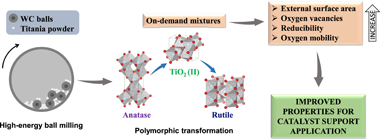
We carried out a rational design of catalyst supports by high-energy ball milling. Tailored mixtures of TiO2 crystalline phases were obtained using rotational speed and milling time as variable parameters. Polymorphic transformation from anatase to rutile through high-pressure TiO2 (II) as intermediate was confirmed by X-ray Diffraction (XRD), Raman Spectroscopy and Transmission Electron Microscopy (TEM). Also, starting material doubled its specific surface area due to particle fragmentation, as confirmed by surface area of Brunauer-Emmet-Teller (S-BET) and Scanning Electron Microscopy (SEM). Defects introduced during milling process generated oxygen vacancies in the surface and bulk of supports, as evidenced by X-ray Photoelectron Spectroscopy (XPS) and Electron Paramagnetic Resonance (EPR). Furthermore, longer milling time increased reducibility and oxygen mobility of supports, as observed by H-2 Temperature Programmed Reduction (H-2-TPR) and O-2 Temperature Programmed Desorption (O-2-TPD). Phase composition remained unchanged even under extreme conditions, highlighting the stability of unusual TiO2 (II) phase. Properties achieved in present materials could benefit metal-support interactions and play a major role in supported catalysts.
Finite Size Effects on Light Propagation throughout Random Media: Relation between Optical Properties and Scattering Event Statistics
Miranda-Munoz, JM; Esteso, V; Jimenez-Solano, A; Lozano, G; Miguez, H
Advanced Optical Materials, 8 (2020) 1901196 | DOI: 10.1002/adom.201901196
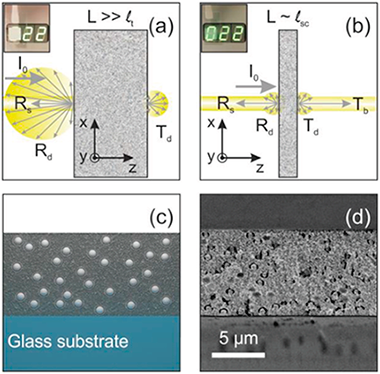
This work introduces a thorough analysis of light transport in thin optically disordered media. The diffusive properties of a turbid material are generally dictated by the transport mean free path, lt. For depths larger than this characteristic length, light propagation can be considered fully randomized. There is however a range of thicknesses for which light becomes only partly randomized, as it only undergoes a single or very few scattering events. The effects of such finitude are experimentally and theoretically studied on the optical properties of the material, such as the angular distribution of scattered light. Simulations provide insight into the phenomena that occur within the optically disordered slab, like the number of scattering events that photons undergo during propagation throughout the material, as a function of the built‐in wavelength dependent scattering mean free path, lsc. This approach provides fundamental information about photon transport in finite optically random media, which can be put into practice to design diffusers with specific requirements in terms of the spectral and angular properties of the scattered light.
Sustainable, High-Barrier Polyaleuritate/Nanocellulose Biocomposites
Tedeschi, G; Guzman-Puyol, S; Ceseracciu, L; Benitez, JJ; Cataldi, P; Bissett, M; Heredia, A; Athanassiou, A; Heredia-Guerrero, JA
ACS Sistainable Chemistry & Engineering, 8 (2020) 10682-10690 | DOI: 10.1021/acssuschemeng.0c00909
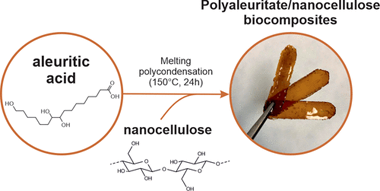
Free-standing and flexible biocomposite films formed by a polyaleuritate matrix and nanocellulose fillers (i.e., cellulose nanofibrils) have been fabricated by a sustainable process. For this, 9,10,16-trihydroxyhexadecanoic (aleuritic) acid from shellac and nanocellulose were blended at different ratios in water through a sonication process. Polymerization of the polyhydroxylated fatty acid into polyaleuritate was induced by a solvent-free, melting polycondensation reaction in the oven. These biocomposites were characterized to evaluate their chemical (by ATR-FTIR spectroscopy) and physical (e.g., density, thermal stability, rigidity, gas permeability, surface energy, etc.) properties. The compatibility between the polyester matrix and the polysaccharide fillers was excellent due to the interaction by H bonds of the polar groups of both components. The addition of nanocellulose increased all determined mechanical parameters as well as the wettability and the barrier properties, while the thermal stability and the water uptake were determined by the polyaleuritate matrix. The physical properties of these biocomposites were compared to those of petroleum-based plastics and bio-based polymers, indicating that the developed materials can represent a sustainable alternative for different applications such as packaging.
Unraveling Discharge and Surface Mechanisms in Plasma-Assisted Ammonia Reactions
Navascues, P; Obrero-Perez, JM; Cotrino, J; Gonzalez-Elipe, AR; Gomez-Ramirez, A
ACS Sustainable Chemistry & Engineering, 8 (2020) 14855-14866 | DOI: 10.1021/acssuschemeng.0c04461
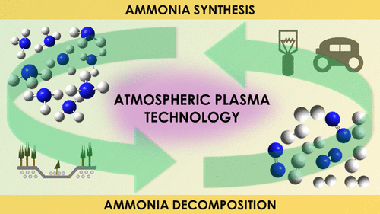
Current studies on ammonia synthesis by means of atmospheric pressure plasmas respond to the urgent need of developing less environmentally aggressive processes than the conventional Haber-Bosch catalytic reaction. Herein, we systematically study the plasma synthesis of ammonia and the much less investigated reverse reaction (decomposition of ammonia into nitrogen and hydrogen). Besides analyzing the efficiency of both processes in a packed-bed plasma reactor, we apply an isotope-exchange approach (using D-2 instead of H-2) to study the reaction mechanisms. Isotope labeling has been rarely applied to investigate atmospheric plasma reactions, and we demonstrate that this methodology may provide unique information about intermediate reactions that, consuming energy and diminishing the process efficiency, do not effectively contribute to the overall synthesis/decomposition of ammonia. In addition, the same methodology has demonstrated the active participation of the interelectrode material surface in the plasma-activated synthesis/decomposition of ammonia. These results about the involvement of surface reactions in packed-bed plasma processes, complemented with data obtained by optical emission spectroscopy analysis of the plasma phase, have evidenced the occurrence of inefficient intermediate reaction mechanisms that limit the efficiency and shown that the rate-limiting step for the ammonia synthesis and decomposition reactions are the formation of NH* species in the plasma phase and the electron impact dissociation of the molecule, respectively.
An insight on the design of mercapto functionalized swelling brittle micas
Osuna, FJ; Pavon, E; Alba, MD
Journal of Colloid and Interface Science, 561 (2020) 533-541 | DOI: 10.1016/j.jcis.2019.11.028
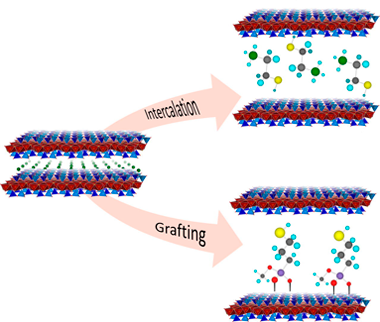
Surface modification of natural clay minerals with reagents containing metal chelating groups has great environmental value. The functionalization by adsorption or grafting guarantees a durable immobilization of the reactive organic groups, preventing their leaching when they are used in liquid media. The aim of this research was the designed mercapto functionalization of swelling brittle micas, Na-Mn, thorough both chemical and physical mechanisms. Na-Mn were functionalized with 2-mercaptoethylammonium (MEA), 2,3-dimercapto-1-propanol (BAL) and (3-mercaptopropyl)trimethoxysilane (MPTMS). The thiol concentration on swelling brittle micas is higher than the observed value for others adsorbents. The cation exchange reaction with MEA and one-step grafting with MPTMS in acid medium are the most efficient mercapto functionalization mechanism.
Design of a nanoprobe for high field magnetic resonance imaging, dual energy X-ray computed tomography and luminescent imaging
Gonzalez-Mancebo, D; Becerro, AI; Corral, A; Garcia-Embid, S; Balcerzyk, M; Garcia-Martin, ML; de la Fuente, JM; Ocana, M
Journal of Colloid and Interface Science, 573 (2020) 278-286 | DOI: 10.1016/j.jcis.2020.03.101
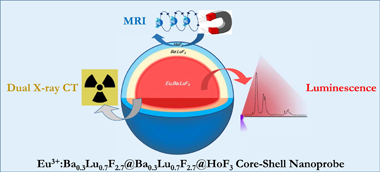
The combination of different bioimaging techniques, mainly in the field of oncology, allows circumventing the defects associated with the individual imaging modalities, thus providing a more reliable diagnosis. The development of multimodal endogenous probes that are simultaneously suitable for various imaging modalities, such as magnetic resonance imaging (MRI), X-ray computed tomography (CT) and luminescent imaging (LI) is, therefore, highly recommended. Such probes should operate in the conditions imposed by the newest imaging equipment, such as MRI operating at high magnetic fields and dual-energy CT. They should show, as well, high photoluminescence emission intensity for their use in optical imaging and present good biocompatibility. In this context, we have designed a single nanoprobe, based on a core-shell architecture, composed of a luminescent Eu3+:Ba0.3Lu0.7F2.7 core surrounded by an external HoF3 shell that confers the probe with very high magnetic transverse relaxivity at high field. An intermediate, optically inert Ba0.3Lu0.7F2.7 layer was interposed between the core and the shell to hinder Eu3+-Ho3+ cross-relaxation and avoid luminescence quenching. The presence of Ba and Lu, with different K-edges, allows for good X-ray attenuation at high and low voltages. The core-shell nanoparticles synthesized are good potential candidates as trimodal bioprobes for MRI at high field, dual-energy CT and luminescent imaging.
Influence of Sr-doping on structural, optical and photocatalytic properties of synthesized Ca3(PO4)2
Y.Naciri; A.Hsini; Z.Ajmal; A.Bouddouch; B.Bakiz; J.A.Navío; A.Albourine; J-C.Valmalette; M.Ezahri; A.Benlhachemi
Journal of Colloid and Interface Science, 572 (2020) 269-280 | DOI: 10.1016/j.jcis.2020.03.105
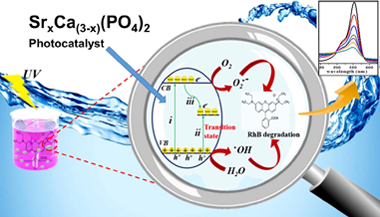
Well-crystallized Ca3(PO4)2 doped and un-doped nano-particles with the maximum strontium content (40 wt% Sr) followed by calcination at 800 °C for 3 h were synthesized via facile co-precipitation method. DTA/TGA, X-ray diffraction (XRD), energy dispersive scanning electron microscopy (SEM/EDX), UV–vis diffuse reflectance spectrum (UV–vis DRS), Raman spectroscopy and photoluminescence (PL) techniques were used for material characterization. The (XRD) patterns of as-synthesized Sr-doped Ca3(PO4)2 solid solution samples exhibited a systematic shift toward lower angles by possessing a single rhombohedral crystal structure without any secondary phases. The UV light driven photocatalytic activity was assessed for rhodamine B (RhB) degradation. As a result, ultrafast photodegradation activity was observed after Sr doping. Moreover, the 30 wt% Sr-Ca3(PO4)2 sample showed the highest photocatalytic degradation among the Sr-doped Ca3(PO4)2 samples toward RhB. It was further suggested that as-synthesized 30 wt% Sr-Ca3(PO4)2 superior photocatalytic performance is ascribed to the more proficient partition of photogenerated electron-hole pairs. Furthermore, the involved mechanism of superior photocatalytic performance of the 30 wt% Sr-Ca3(PO4)2 solid solution was also investigated. In addition, regeneration cycles indicated the higher stability of the photocatalyst to be effectively recycled up to four times without any considerable reduction in photocatalytic performance. Thus, these informations further provides us a scalable pathway to fabricate Sr doped Ca3(PO4)2 and its consequent use as an efficient photocatalyst for rhodamine B (RhB) contaminated wastewater treatment.
Ru-Ni/MgAl2O4 structured catalyst for CO2 methanation
Navarro, Juan C.; Centeno, Miguel A.; Laguna, Oscar H.; Odriozola, Jose A.
Renewabel Energy, 161 (2020) 120-132 | DOI: 10.1016/j.renene.2020.07.055
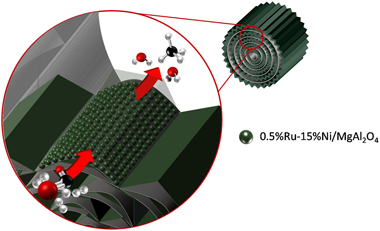
Novel catalytic systems should be tested for the valorization of CO2 through the Sabatier reaction, since this process is gaining great importance within strategic sectors of the chemical industry. Therefore, this work explores the feasibility of structuring a catalyst (0.5%Ru-15%Ni/MgAl2O4) for CO2 methanation using metal micromonoliths. The coating of the catalyst over the surface of the micromonoliths is carried out by means of the washcoating procedure and different characterization techniques are applied to establish possible changes in the catalyst during structuring.
Regarding the performance in the Sabatier reaction, the structured systems are tested as well as the powder catalyst in order to establish the possible effects of the structuring processes. For this, variables such as catalyst loading, space velocity, inclusion of water in the feed-stream and the pressurization of the process were studied.
In general, the structuring of the proposed catalyst by the reported procedure is absolutely feasible. There are no substantial changes in the main features of the catalyst and this means that its catalytic performance is not altered after the structuring process either. Furthermore, the structured system exhibits high stability in a long-term test and is comparable with other CO2 methanation catalysts reported in research to date.
Low gas consumption fabrication of He-3 solid targets for nuclear reactions
Fernandez, A; Hufschmidt, D; Colaux, JL; Valiente-Dobon, JJ; Godinho, V; de Haro, MCJ; Feria, D; Gadea, A; Lucas, S
Materials & Design, 186 (2020) 108337 | DOI: 10.1016/j.matdes.2019.108337
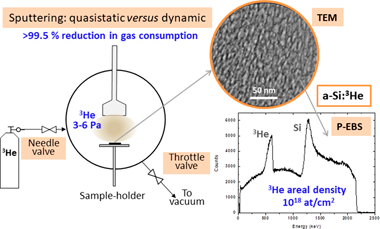
Nanoporous solids that stabilize trapped gas nanobubbles open new possibilities to fabricate solid targets for nuclear reactions. A methodology is described based on the magnetron sputtering (MS) technique operated under quasistatic flux conditions to produce such nanocomposites films with He-3 contents of up to 16 at.% in an amorphous-silicon matrix. In addition to the characteristic low pressure (3-6 Pa) needed for the gas discharge, the method ensures almost complete reduction of the process gas flow during film fabrication. The method could produce similar materials to those obtained under classical dynamic flux conditions for MS. The drastic reduction (>99.5%) of the gas consumption is fundamental for the fabrication of targets with scarce and expensive gases. Si:He-3 and W:He-3 targets are presented together with their microstructural (scanning and transmission electron microscopy, SEM and TEM respectively) and compositional (Ion Beam Analysis, IBA) characterization. The He-3 content achieved was over 1 x 10(18) at/cm(2) for film thicknesses between 1.5 and 3 mu m for both Si and W matrices. First experiments to probe the stability of the targets for nuclear reaction studies in inverse kinematics configurations are presented.
Platinum nanoparticles stabilized by N-heterocyclic thiones. Synthesis and catalytic activity in mono- and di-hydroboration of alkynes
Moraes, LCC; Figueiredo, RCC; Espinos, JPP; Vattier, F; Franconetti, A; Jaime, C; Lacroix, B; Rojo, J; Lara, P; Conejero, S
Nanoscale, 12 (2020) 6821-6831 | DOI: 10.1039/d0nr00251h
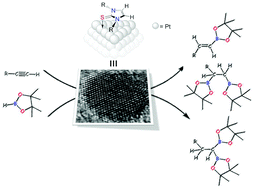
N-Heterocyclic Thiones (NHT) proved to be efficient ligands for the stabilization of small platinum nanoparticles (1.3-1.7 nm), synthesized by decomposition of [Pt(dba)(2)], under a H-2 atmosphere, in the presence of variable sub-stoichiometric amounts of the NHT. Full characterization by means of TEM, HR-TEM, NMR, ICP, TGA and XPS have been carried out, providing information about the nature of the metal nanoparticles and the interaction of the NHT ligands to the metal surface. Importantly, DFT calculations indicate that some NHT ligands interact with the metal through the C & xe001;C double bond of the imidazole fragment in addition to the sulfur atom, thus providing additional stabilization to the nanoparticles. According to XPS, TGA and ICP techniques, the surface coverage by the ligand increases by decreasing the size of the substituents on the nitrogen atom. The platinum nanoparticles have been used as catalyst in the hydroboration of alkynes. The most active system is that with a less covered surface area lacking an interaction of the ligand by means of the C & xe001;C double bond. This catalyst hydroborates alkynes with excellent selectivities towards the monoborylated anti-Markovnikov product (vinyl-boronate) when one equiv. of borane is used. Very interestingly, aliphatic alkynes undergo a second hydroborylation process leading to the corresponding 1,1- and 1,2-diboroylated species with good selectivities towards the former.
Robust label-free CuxCoyOz electrochemical sensors for hexose detection during fermentation process monitoring
Lopez-Fernandez, E; Gil-Rostra, J; Espinos, JP; Gonzalez, R; Yubero, F; de Lucas-Consuegra, A; Gonzalez-Elipe, AR
Sensors and Actuators B-Chemical, 304 (2020) 127360 | DOI: 10.1016/j.snb.2019.127360
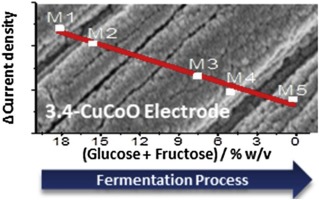
Label free electrochemical sensors of glucose are used whenever long-term operation and stable response are required. For this purpose, various metals and oxides of the first transition series have been proposed as alternative to more expensive noble metal electrochemical sensors. In this work we propose a new formulation consisting of copper-cobalt mixed oxides which, in the form of porous and nanostructured thin films with well controlled Co/Cu ratio, are prepared at room temperature in one step by a modification of the magnetron sputtering oblique angle deposition procedure. Films with various compositions were electrochemically characterized by cyclic voltammetry to determine their amperometric response to glucose as a function of voltage and NaOH electrolyte concentration. This analysis showed that films with a Co/Cu atomic ratio equal 3.4 presented a maximum sensitivity (0.710 A M−1 cm−2), a small limit of detection (0.105 μM) and a resilient behaviour upon cycling operation and long storage periods that clearly overpassed the performance of copper and cobalt single oxides. The CuxCoyO electrocatalysts also presented a good selectivity towards glucose and fructose in the presence of common interference compounds found in biological fluids (e.g., ascorbic acid, acetaminophen and uric acid), sucrose and ethanol, this latter present in many agrofood liquids. The possibilities of this sensor electrocatalyst have been tested for the analysis of a wine synthetic fermentation process. The comparison of the electrochemical results with conventional analytical methods showed a lineal amperometric response with respect hexose contents in a must at different stages of its transformation into wine.
Localized surface plasmon effects on the photophysics of perovskite thin films embedding metal nanoparticles
Bayles, A; Carretero-Palacios, S; Calio, L; Lozano, G; Calvo, ME; Miguez, H
Journal of Materials Chemistry C, 8 (2020) 916-921 | DOI: 10.1039/c9tc05785d
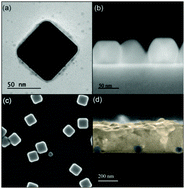
Herein we provide direct experimental evidence that proves that the photophysical properties of thin methylammonium lead iodide perovskite films are significantly enhanced by localized surface plasmon resonances (SPRs). Observations are well supported by rigorous calculations that prove that improved light harvesting can be unequivocally attributed to plasmonic scattering and near field reinforcement effects around silver nanoparticles embedded within the semiconductor layer. Adequate design of the localized SPR allows raising the absorptance of a 300 nm thick film at well-defined spectral regions while minimizing the parasitic absorption from the metallic inclusions. Measured enhancements can be as large as 80% at specific wavelengths and 20% when integrated over the whole range at which SPR occurs, in agreement with theoretical estimations. Simultaneously, the characteristic quenching effect that the vicinity of metals has on the photoluminescence of semiconductors is largely compensated for by the combined effect of the enhanced photoexcitation and the higher local density of photon states occurring at SPR frequencies, with a two fold increase of the perovskite photoemission efficiency being measured.
High-temperature solar-selective coatings based on Cr(Al)N. Part 2: Design, spectral properties and thermal stability of multilayer stacks
Rojas, TC; Caro, A; Escobar-Galindo, R; Sanchez-Lopez, JC
Solar Energy Materials and Solar Cells, 218 (2020) 110812 | DOI: 10.1016/j.solmat.2020.110812
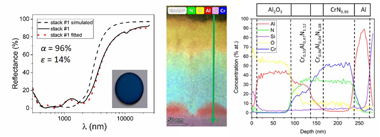
Two multilayer solar selective absorber coatings [Al/CrN0.95/Cr0.96Al0.04N1.08/Cr0.53Al0.47N1.12/Al2O3 (stack #1) and Cr0.96Al0.04N0.89/Cr0.62Al0.38N1.00/Cr0.53Al0.47N1.12/Al2O3 (stack #2)] were deposited on 316L steel by combining direct current (DC) and high power impulse magnetron sputtering (HiPIMS) technologies with the aim of increasing the working limit temperature. The composition and thickness of the constituent layers were optimized using CODE software to achieve a high solar absorptance (alpha) and low values of thermal emittance (epsilon) in the infrared region. The deposited multilayered stacks were heated during 2 h in air at 600, 700 and 800 degrees C to study their thermal stability and optical performance. Compositional, structural and optical characterization of the stacks (as-prepared and after thermal treatment) was performed. Both stacks presented a good solar selectivity with alpha > 95% and epsilon < 15%, were stable up to 600 degrees C and fulfilled the performance criterion PC < 5% after 600 and 700 degrees C treatments. Despite the stacks suffered chemical transformations above 600 degrees C, partial oxidation (stack #1) and Cr2N formation (stack #1 and #2), the optical properties were optimum up to 700 degrees C for stack #1 (alpha = 94%, epsilon((25 degrees C)) = 12%) and 600 degrees C for stack #2 (alpha = 93%, epsilon((25 degrees C)) = 13%). The solar-to-mechanical energy conversion efficiencies (eta) of the as-deposited and annealed (600 and 700 degrees C) samples were up to 20% points higher than the absorber paint commercially used (Pyromark). At 800 degrees C, they underwent a further structural transformation, provoked by the oxidation of the inner layers, and they consequently lost their solar selectivity.
New biomorphic filters to face upcoming particulate emissions policies: A review of the FIL-BIO-DIESEL project
Orihuela, MP; Chacartegui, R; Martinez-Fernandez, J
Energy, 201 (2020) 117577 | DOI: 10.1016/j.energy.2020.117577
With a high number of diesel vehicles worldwide, particulate emission control is an urgent issue with a global impact, from the health of citizens to commercial future of this technology in some transport segments. Particulate filters are widely used in automotive engines to comply emissions regulations, but current technologies have room for improvement as they add additional backpressure in the exhaust system, and efficient on-board regeneration process is challenging.
The Fil-Bio-Diesel Project is a R&D initiative to improve current particle filtration systems, based on the development of novel biomorphic substrates. By replicating the biologic tissue of a wood precursor, a biomorphic silicon carbide with hierarchic orthotropic microstructure can be produced. The porosity, the pore size, and pore orientation of this bioceramic material can be tailored through the selection of a suitable precursor, widening the initially narrow relationship between filtration efficiency and pressure drop that characterizes granular ceramic materials. In this paper the methodology and main results of the Fil-Bio-Diesel Project are presented. This work shows the peculiar advantages of biomorphic silicon carbide through several experimental studies. The results show the potential of this novel filter substrate to be used in future particulate abatement systems.
Role of Fe(III) in aqueous solution or deposited on ZnO surface in the photoassisted degradation of rhodamine B and caffeine
Tanji, Karim; Navio, J A; Martin-Gomez, A N; Hidalgo, M C; Jaramillo-Paez, C; Naja, Jamal; Hassoune, Hicham; Kherbeche, Abdelhak
Chemosphere, 241 (2020) 125009 | DOI: 10.1016/j.chemosphere.2019.125009
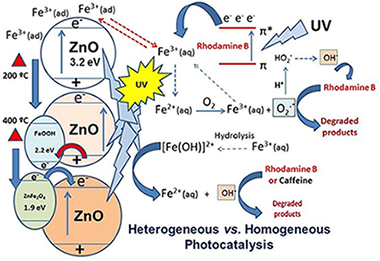
Iron (III) was incorporated, to the surface of a synthesized ZnO, using two nominal molar percentages of Fe (III): 1% and 5% Fe relative to ZnO. Samples dried and calcined at 200 °C and 400 °C for 2 h, were characterized by XRD, XPS, XRF, N2-adsorption-BET and (UV–vis)-DRS. Photocatalytic activities of the catalysts were assessed based on the degradation of rhodamine B (RhB) and caffeine (CAF) in aqueous solution under two irradiation conditions: UV and visible light illumination. Prior to the photocatalytic tests, the interaction of each one of the substrates with either Fe(III) or Fe(II) was studied in homogeneous medium under UV-illumination and oxygenated environment. It was found that Fe (III) can play an important role in homogeneous media in the photoassisted degradation, both of rhodamine B and caffeine, while Fe (II) does not exert a relevant role in the photoassisted degradation of the referred substrates. Fe–ZnO samples display similar or poorer performance than pure ZnO in the presence of UV light for both studied substrates. The phenomenon can be attributed to the formation of either goethite or ZnFe2O4 at the ZnO surface where the coupled Fe3+/Fe2+ can act as recombination centers for the photogenerated charges. On the contrary, all Fe–ZnO samples showed enhanced photocatalytic activity under visible illumination which seems to be independent of the iron content. In this context, the mechanisms for photoassisted degradation of both the substrates in homogeneous medium and photocatalytic degradation are discussed, as well as the role of Fe in the photodegradation processes.
Binder-free supercapacitor electrodes: Optimization of monolithic graphitized carbons by reflux acid treatment
Gomez-Martin, A; Gutierrez-Pardo, A; Martinez-Fernandez, J; Ramirez-Rico, J
Fuel Processing Technology, 199 (2020) 106279 | DOI: 10.1016/j.fuproc.2019.106279
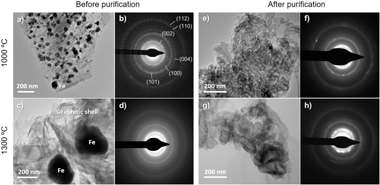
The rational design of electrodes mimicking the cellular structure of natural bio-resources has been a matter of increasing interest for applications in energy storage. Due to their anisotropic and hierarchical porosity, monolithic carbon materials from natural wood precursors are appealing as electrodes for supercapacitor applications due to their interconnected channels, relatively low cost and environmentally friendly synthesis process. In this work, a liquid-phase oxidative treatment with refluxing nitric acid at 100 degrees C for 8 h was performed to enhance the surface properties of beech-derived graphitized carbons treated with an iron catalyst. Microstructural, textural and surface investigations revealed that this strategy was successful in removing amorphous carbon and in functionalizing their surfaces. The crystallinity, accessible surface area, micropore volume and surface functionality of beech-derived carbons were increased upon the reflux treatment. The resulting porous carbon materials were evaluated as binderless monolithic electrodes for supercapacitors applications in aqueous KOH electrolyte. A maximum specific capacitance of 179 F.g(-1) and a volumetric capacitance of 89 Fcm(-3) in galvanostatic charge/discharge experiments were reached. Monolithic electrodes exhibited good cycling stability, with a capacitance retention over 95% after 10,000 cycles.
Upgrading the PtCu intermetallic compounds: The role of Pt and Cu in the alloy
Castillo, R; Garcia, ED; Santos, JL; Centeno, MA; Sarria, FR; Daturi, M; Odriozola, JA
Catalysis Today, 356 (2020) 390-398 | DOI: 10.1016/j.cattod.2019.11.026
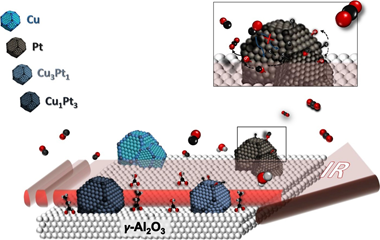
This work is devoted to the study of the role of both metals in the intermetallic PtxCuy/ γ Al2O3 catalysts commonly employed in CO-PROX reaction. Therefore, monometallic Pt and Cu based catalysts and PtCu intermetallic compound with different molar ratios (Pt3Cu1 and Pt1Cu3) supported catalysts were carefully synthesized and deeply characterized. Room temperature CO adsorptions by FTIR spectroscopy were carried out on the mono- and intermetallic catalysts being the monometallic catalyst determinant for the study. From the analysis of the nature of the platinum surface in Pt/ γ Al2O3, we have demonstrated that the role of Pt sites is based in the CO dissociation for the CO2 formation and also how the platinum surface is partially blocked by leftovers from the synthesis. Moreover, the study of the Cu/ γ Al2O3 and the bimetallic catalysts PtxCuy/ γ Al2O3 allowed elucidating the effect of the copper in the metallic site and support interphase as well as the role of copper in the hydrocarbon oxidation.
Flexible syngas production using a La2Zr2-xNixO7-delta pyrochlore-double perovskite catalyst: Towards a direct route for gas phase CO2 recycling
le Sache, E; Pastor-Perez, L; Garcilaso, V; Watson, DJ; Centeno, MA; Odriozola, JA; Reina, TR
Catalysis Today, 357 (2020) 583-589 | DOI: 10.1016/j.cattod.2019.05.039
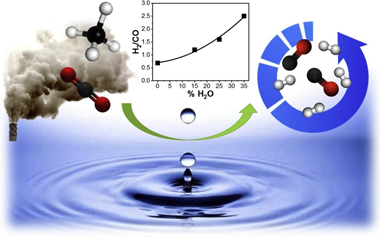
The bi-reforming of methane (BRM) has the advantage of utilising greenhouse gases and producing H2 rich syngas. In this work Ni stabilised in a pyrochlore-double perovskite structure is reported as a viable catalyst for both Dry Reforming of Methane (DRM) and BRM. A 10 wt.% Ni-doped La2Zr2O7 pyrochlore catalyst was synthesised, characterised and tested under both reaction conditions and its performance was compared to a supported Ni/La2Zr2O7. In particular the effect of steam addition is investigated revealing that steam increases the H2 content in the syngas but limits reactants conversions. The effect of temperature, space velocity and time on stream was studied under BRM conditions and brought out the performance of the material in terms of activity and stability. No deactivation was observed, in fact the addition of steam helped to mitigate carbon deposition. Small and well dispersed Ni clusters, possibly resulting from the progressive exsolution of Ni from the mixed oxide structure could explain the enhanced performance of the catalyst.
Local Rearrangement of the Iodide Defect Structure Determines the Phase Segregation Effect in Mixed-Halide Perovskites
Tiede, DO; Calvo, ME; Galisteo-Lopez, JF; Miguez, H
Journal of Physical Chemistry Letters, 11 (2020) 4911-4916 | DOI: 10.1021/acs.jpclett.0c01127
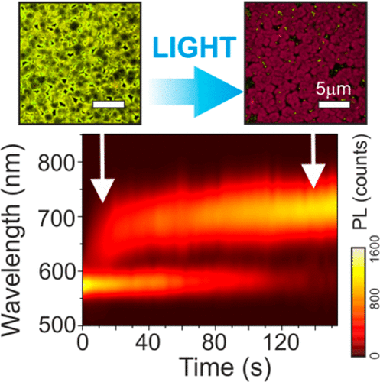
Mixed-halide perovskites represent a particularly relevant case within the family of lead-halide perovskites. Beyond their technological relevance for a variety of optoelectronic devices, photoinduced structural changes characteristic of this type of material lead to extreme photophysical changes that are currently the subject of intense debate. Herein we show that the conspicuous photoinduced phase segregation characteristic of these materials is primarily the result of the local and metastable rearrangement of the iodide sublattice. A local photophysical study comprising spectrally resolved laser scanning confocal microscopy is employed to find a correlation between the defect density and the dynamics of photoinduced changes, which extend far from the illuminated region. We observe that iodide-rich regions evolve much faster from highly defective regions. Also, by altering the material composition, we find evidence for the interplay between the iodide-related defect distribution and the intra- and interdomain migration dynamics giving rise to the complexity of this process.
Cost-effective routes for catalytic biomass upgrading
Jin, W; Pastor-Perez, L; Yu, J; Odriozola, JA; Gu, S; Reina, TR
Current Opinion in Green and Sustainable Chemistry, 23 (2020) 1-9 | DOI: 10.1016/j.cogsc.2019.12.008
Catalytic hydrodeoxygenation (HDO) is a fundamental and promising route for bio-oil upgrading to produce petroleum-like hydrocarbon fuels or chemical building blocks. One of the main challenges of this technology is the demand of high-pressure H-2, which poses high costs and safety concerns. Accordingly, developing cost-effective routes for biomass or bio-oil upgrading without the supply of commercial H-2 is essential to implement the HDO at commercial scale. This article critically reviewed the very recent studies relating to the novel strategies for upgrading the biofeedstocks with 'green' H-2 generated from renewable sources. More precisely, catalytic transfer hydro-genation/hydrogenolysis, combined reforming and HDO, combined metal hydrolysis and HDO, water-assisted in-situ HDO and nonthermal plasma technology and self-supported hydrogenolysis are reviewed herein. Current challenges and research trends of each strategy are also proposed aiming to motivate further improvement of these novel routes to become competitive alternatives to conventional HDO technology.
Bimetallic PdAu catalysts for formic acid dehydrogenation
Santos, JL; Leon, C; Monnier, G; Ivanova, S; Centeno, MA; Odriozola, JA
International Journal of Hydrogen Energy, 45 (2020) 23056-23068 | DOI: 10.1016/j.ijhydene.2020.06.076
A series of monometallic and bimetallic palladium gold catalyst were prepared and studied for the formic acid dehydrogenation reaction. Different Pd/Au compositions were employed (PdxAu100-x, where x = 25; 50 and 75) and their impact on alloy structure, particle size and dispersion was evaluated. Active phase composition and reaction parameters such as temperature, formic acid concentration or formate/formic acid ratio were adjusted to obtain active and selective catalyst for hydrogen production. An important particle size effect was observed and related to Pd/Au composition for all bimetallic catalysts.
Advances in the implementation of PVD-based techniques for the preparation of metal catalysts for the hydrolysis of sodium borohydride
Arzac, GM; Fernandez, A
International Journal of Hydrogen Energy, 58 (2020) 33288-33309 | DOI: 10.1016/j.ijhydene.2020.09.041
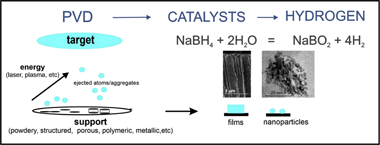
Sodium borohydride constitutes a safe alternative for the storage of hydrogen with a high gravimetric content. Catalytic hydrolysis of sodium borohydride permits on-demand hydrogen generation for multiple applications. In this field, the rational design of efficient metal catalysts deposited on structured supports is highly desirable. For most reactions, chemical methods are the most commonly used methods for the preparation of supported metal catalysts. Physical vapour deposition techniques are emerging as an alternative for the preparation of catalytic materials because of their multiple advantages. They permit the one-step deposition of catalysts on structured supports with controlled microstructure and composition, avoiding the multi-step procedures and the generation of hazardous by-products associated with chemical routes.
In this short review, we will describe the available literature on the application of physical vapour deposition techniques for the preparation of supported metal catalysts for the hydrolysis of sodium borohydride. The effects of the deposition parameters on the properties of the catalytic materials will be discussed, and strategies for further improvement will be proposed. Here, we also present our new results on the study of nanoporous Pt catalysts that are prepared through the chemical dealloying of magnetron sputtered Pt-Cu thin films for the hydrolysis of sodium borohydride. We discuss the capabilities of the technique to tune the microstructure from columnar to closed porous microstructures, which, coupled with dealloying, produces more active supported catalysts with lower noble metal loading. At the end, we briefly mention the application of PVD for the preparation of supported catalysts for the hydrolysis of ammonia borane, another hydrogen generating reaction of high interest nowadays.
Effect of Gold Particles Size over Au/C Catalyst Selectivity in HMF Oxidation Reaction
Megias-Sayago, C; Lolli, A; Bonincontro, D; Penkova, A; Albonetti, S; Cavani, F; Odriozola, JA; Ivanova, S
Chemcatchem, 12 (2020) 1177-1183 | DOI: 10.1002/cctc.201901742
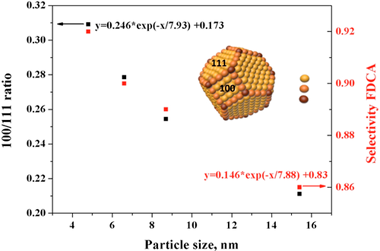
A series of gold nanoparticles in the 4-40 nm range were prepared, immobilized on activated carbon and further tested, at low base concentration, in the catalytic oxidation of 5-hydroxymethyl furfural (HMF) to 2,5-furandicarboxylic acid (FDCA). Gold particles size variation has no influence on HMF conversion but significantly affects product selectivity and carbon balance. This behavior is ascribed to the thermodynamically favorable oxygen reduction reaction on Au(100) faces. As the gold particle size decreases the Au(100)/Au(111) exposure ratio, estimated by using the van Hardeveld-Hartog model, increases as well as the FDCA selectivity. The smaller the gold particle size the smaller the 5-hydroxymethyl-2-furancarboxylic acid (HMFCA) to FDCA ratio pointing to the gold size dependent behavior of the oxidation of the alcohol function of the HMF molecule.
Disclination dipoles are the Holy Grail for high temperature superplasticity in ceramics
Moshtaghioun, BM; Bejarano-Palma, JA; Garcia, DG
Scripta Materialia, 185 (2020) 21-24 | DOI: 10.1016/j.scriptamat.2020.03.049

A model for high-temperature plasticity of polycrystals controlled by disclination dipoles is proposed that predict a parabolic dependence of the strain rate versus the applied stress. The presence of a precise stationary disclination density explains the origin of plasticity without microstructural invariance, commonly known as superplasticity. The disclination mechanism is universal, although other processes, such as dislocation glide, are superposed to this one in many systems such as metals or metallic alloys. While, in ceramics it is likely to be the only operative mechanism. Activation of disclination dipoles is a necessary condition for plasticity and sufficient one for superplastic yielding.
Reductant atmospheres during slow pyrolysis of cellulose: First approach to obtaining efficient char -based catalysts in one pot
Santos, JL; Centeno, MA; Odriozola, JA
Journal of Analytical and Applied Pyrolysis, 148 (2020) 104821 | DOI: 10.1016/j.jaap.2020.104821
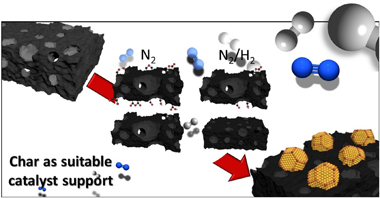
Char based metallic (Pd-Au-Ru-Pt/C) catalysts have drawn increasing research interest due to their versatility in biomass related industrial reactions. Recent studies dealing with the synthesis of char-based catalysts in one single step (one-pot) use reductant atmospheres for biomass pyrolysis. In this work, the influence of the use of a reductant N2/H2 atmosphere on the physicochemical properties of the resulting chars was evaluated in comparison with the use of an inert N2 atmosphere. Specifically, the fundamental parameter of the pyrolysis process, the temperature, was evaluated in the 500−900 °C range. Produced chars were fully characterized by N2 isotherms, ultimate CHNS analysis, X-ray Diffraction, Raman spectroscopy, Diffuse Reflectance Infrared spectroscopy, X-ray Photoelectron spectroscopy, helium Temperature Programmed Decomposition and Isoelectric Point analysis. Slow pyrolysis under reductant atmosphere favours deoxygenation reaction against dehydrogenation ones, reduces the carbon yield and results in chars with a more hydrophobic and graphitic character, higher thermal stability and weak surface functionalization. The use of intermediates temperatures (700 °C) favours the obtaining of chars with suitable physicochemical properties and good surface functionalization, which will facilitate the anchoring of the active phase on the surface, improving the metallic dispersion of the resulting one pot catalyst. This leads us to affirm that the use of reducing atmospheres at intermediate temperatures, is superior to the use of inert atmospheres for this purpose. This analysis on the impact of the use of a reductant atmosphere during slow pyrolysis of microcrystalline cellulose opens a new working path for the optimization of char-based catalysts obtained in a single stage.
Multiple pollutants removal by functionalized heterostructures based on Na-2-Mica
Pazos, MC; Bravo, LR; Ramos, SE; Osuna, FJ; Pavon, E; Alba, MD
Applied Clay Science, 196 (2020) 105749 | DOI: 10.1016/j.clay.2020.105749
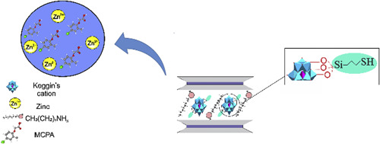
Organomica, C8-2-Mica, was obtained from a high charged synthetic mica, Na-2-Mica, by cation exchange reaction with octylammonium cations and these were used to host other bulky guest species such as polyhydroxy aluminium cations, Al(13)20. The hydrolization of 3-mercaptopropyltrimethoxysilane (MPTMS) allowed the covalent attachment with hydroxyl groups of the oligomeric cation, providing thiol groups that create specific adsorption sites, Al(13)20/SH. The structure of the adsorbents was analysed by XRD and Infrared spectroscopy and these were tested as an adsorbent for the removal of zinc and herbicide MCPA from aqueous solutions. C8-2-Mica was the best adsorbent for MCPA and thiol groups favoured the adsorption of Zn2+. Moreover, Al(13)20/SH showed excellent adsorptive properties for the simultaneous adsorption of MCPA and Zn2+.
Time-resolved operando DRIFTS-MS study of the moisture tolerance of small-pore SAPO-34 molecular sieves during CH4/CO2 separation
Romero, M; Navarro, JC; Bobadilla, LF; Dominguez, MI; Ivanova, S; Romero-Sarria, F; Centeno, MA; Odriozola, JA
Microporous and Mesoporous Materials, 298 (2020) 110071 | DOI: 10.1016/j.micromeso.2020.110071
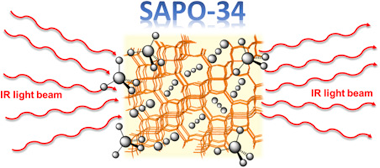
This study pretends to evaluate and understand the effect of moisture presence during CO2/CH4 separation on small-pore SAPO-34 molecular sieves. Two SAPO-34 samples with different physicochemical properties (composition, crystal size and texture) were prepared by hydrothermal synthesis using either one or a mixture of two templates. Transient operando DRIFTS-MS measurements revealed that the sample's hydrophobic character is associated to the presence of Si islands, which enhanced sample's moisture tolerance during repetitive adsorption/desorption cycles. This knowledge is fundamental to achieve the rational design of efficient SAPO-34 membranes under realistic conditions.
Positron annihilation analysis of nanopores and growth mechanism of oblique angle evaporated TiO2 and SiO2 thin films and multilayers
Garcia-Valenzuela, A; Butterling, M; Liedke, MO; Hirschmann, E; Trinh, TT; Attallah, AG; Wagner, A; Alvarez, R; Gil-Rostra, J; Rico, V; Palmero, A; Gonzalez-Elipe, AR
Microporous and Mesoporous Materials, 295 (2020) 109968 | DOI: 10.1016/j.micromeso.2019.109968
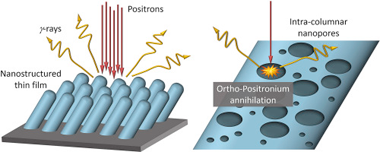
The nano-porosity embedded into the tilted and separated nanocolumns characteristic of the microstructure of evaporated thin films at oblique angles has been critically assessed by various variants of the positron annihilation spectroscopy. This technique represents a powerful tool for the analysis of porosity, defects and internal interfaces of materials, and has been applied to different as-deposited SiO2 and TiO2 thin films as well as SiO2/TiO2 multilayers prepared by electron beam evaporation at 70 and 85 zenithal angles. It is shown that, under same deposition conditions, the concentration of internal nano-pores in SiO2 is higher than in TiO2 nanocolumns, while the situation is closer to this latter in TiO2/SiO2 multilayers. These features have been compared with the predictions of a Monte Carlo simulation of the film growth and explained by considering the influence of the chemical composition on the growth mechanism and, ultimately, on the structure of the films.
Development of Ti(C,N)-based cermets with (Co,Fe,Ni)-based high entropy alloys as binder phase
de la Obra, AG; Sayagues, MJ; Chicardi, E; Gotor, FJ
Journal of Alloys and Compounds, 814 (2020) 152218 | DOI: 10.1016/j.jallcom.2019.152218
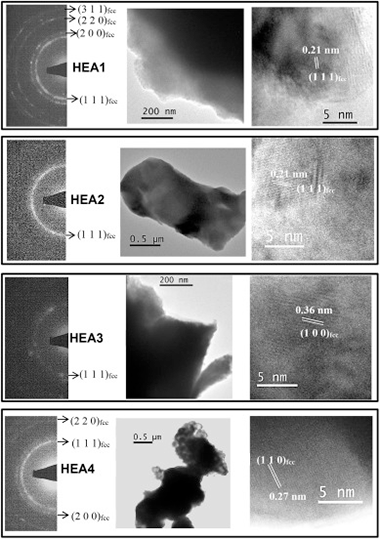
High entropy alloys have been proposed as novel binder phases in cemented carbides and cermets. Many aspects related to the stability of these alloys during the liquid phase sintering process are still unclear and were addressed in this work. Consolidated Ti(C,N)-based cermets using four different (Co,Fe,Ni)based high entropy alloys as the binder phase were obtained. The chosen alloys - CoCrCuFeNi, CoCrFeNiV, CoCrFeMnNi and CoFeMnNiV - were previously synthesized through mechanical alloying and a single alloyed solid solution phase with fcc structure and nanometric character was always obtained. The powdered alloys and the consolidated cermets were analyzed by X-ray diffraction, scanning electron microscopy, X-ray energy dispersive spectrometry and transmission electron microscopy. Differential thermal analysis was employed to determine the melting point of the four high entropy alloys that ranged between 1310 degrees C and 1375 degrees C. Although a high temperature of 1575 degrees C was required to obtain the highest cermet densification by pressureless sintering, porosity still remained in most of the cermets. Best densification was achieved when CoCrFeNiV was used as the binder phase. During liquid phase sintering, different compositional changes were observed in the ceramic and binder phases. A core-rim microstructure was observed in cermets containing V in the alloys (CoCrFeNiV and CoFeMnNiV), since this element was incorporated to the carbonitride structure during sintering. A slight Cr segregation was detected in cermets containing Cr, leading to CrTi-rich alloys in small binder regions. However, a great Cu segregation was produced when CoCrCuFeNi was used, and the formation of two different fcc alloys -a Cu-rich and a Cu-depleted- was observed. Finally, a loss of Mn was also evidenced in CoCrFeMnNi and CoFeMnNiV, probably due to its sublimation at the sintering temperature.
Mg2SiO4-MgAl2O4 directionally solidified eutectics: Hardness dependence modelled through an array of screw dislocations
Moshtaghioun, BM; Gomez-Garcia, D; Pena, JI
Journal of The European Ceramic Society, 40 (2020) 4171-4176 | DOI: 10.1016/j.jeurceramsoc.2020.05.015
Mg2SiO4-MgAl2O4 eutectic ceramics have been fabricated by means of the laser floating zone (LFZ) technique. The microstructure has revealed as an unusual one at lower growth rate, composed of broken lamellae of MgAl2O4 distributed randomly along one matrix, composed of Mg2SiO4. At higher growth rates, a cell structure with intra-cell lamella structure is dominant. Contrary to most eutectic systems, hardness is not dependent upon the inter-spacing, but it does depend on one characteristic length of lamellae: their perimeter. One simple model based upon the dislocation is proposed, which successfully accounts for such extraordinary hardness law. Accordingly, Mg2SiO4-MgAl2O4 eutectic ceramics fabricated at 50 mm/h growth rate with the smallest MgAl2O4 lamella perimeter favorably showed more elevated hardness (13.4 GPa from Vickers indentation and 15.3 GPa from nanoindentation) and strength (430 MPa) than those found in the monolithic Mg2SiO4 matrix.
Supported Porous Nanostructures Developed by Plasma Processing of Metal Phthalocyanines and Porphyrins
Obrero, JM; Filippin, AN; Alcaire, M; Sanchez-Valencia, JR; Jacob, M; Matei, C; Aparicio, FJ; Macias-Montero, M; Rojas, TC; Espinos, JP; Saghi, Z; Barranco, A; Borras, A
Frontiers in Chemistry, 8 (2020) 520 | DOI: 10.3389/fchem.2020.00520
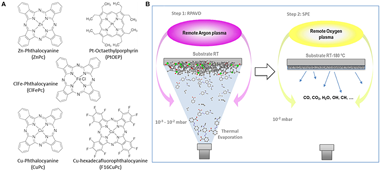
The large area scalable fabrication of supported porous metal and metal oxide nanomaterials is acknowledged as one of the greatest challenges for their eventual implementation in on-device applications. In this work, we will present a comprehensive revision and the latest results regarding the pioneering use of commercially available metal phthalocyanines and porphyrins as solid precursors for the plasma-assisted deposition of porous metal and metal oxide films and three-dimensional nanostructures (hierarchical nanowires and nanotubes). The most advanced features of this method relay on its ample general character from the point of view of the porous material composition and microstructure, mild deposition and processing temperature and energy constrictions and, finally, its straightforward compatibility with the direct deposition of the porous nanomaterials on processable substrates and device-architectures. Thus, taking advantage of the variety in the composition of commercially available metal porphyrins and phthalocyanines, we present the development of metal and metal oxides layers including Pt, CuO, Fe2O3, TiO2, and ZnO with morphologies ranging from nanoparticles to nanocolumnar films. In addition, we combine this method with the fabrication by low-pressure vapor transport of single-crystalline organic nanowires for the formation of hierarchical hybrid organic@metal/metal-oxide and @metal/metal-oxide nanotubes. We carry out a thorough characterization of the films and nanowires using SEM, TEM, FIB 3D, and electron tomography. The latest two techniques are revealed as critical for the elucidation of the inner porosity of the layers.
5-Hydroxymethyl-2-Furfural Oxidation Over Au/Ce(x)Zr(1-x)O(2)Catalysts
Megias-Sayago, C; Bonincontro, D; Lolli, A; Ivanova, S; Albonetti, S; Cavani, F; Odriozola, JA
Frontiers in Chemistry, 8 (2020) 461 | DOI: 10.3389/fchem.2020.00461

A series of gold catalysts supported on pure CeO2, ZrO2, and two different Ce-Zr mixed oxides have been prepared and tested in the 5-hydroxymethyl-2-furfural oxidation reaction. All catalysts show high catalytic activity (100% conversion) and important selectivity (27-41%) to the desired product i.e., 2,5-furandicarboxylic acid at low base concentration. Products selectivity changes with the support nature as expected, however, the observed trend cannot be related neither to gold particle size, nor to catalyst reducibility and oxygen mobility. An important relation between the FDCA selectivity and the support textural properties is observed, conducing to the general requirement for optimal pore size for this reaction.
Effect of synthesis pH on the physicochemical properties of a synthesized Bi2WO6 and the type of substrate chosen, in assessing its photo-catalytic activities
Jaramillo-Páez, C.; Navío, J.A.; Hidalgo, M.C.
Arabian Journal of Chemistry, 13 (2020) 431-443 | DOI: 10.1016/j.arabjc.2017.05.014
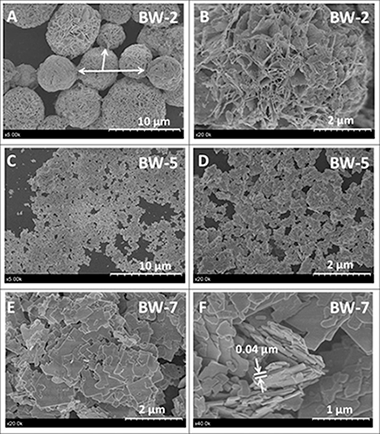
Crystalline orthorhombic Bi2WO6 powders were synthesized by a hydrothermal method from aqueous solutions of Bi(NO3)35H2O and Na2WO42H2O over a range of three selected pH values (2.0, 5.0 and 7.0), using NaOH as precipitating agent. The as-prepared catalysts were characterized by XRD, BET, FE-SEM, TEM, XPS and UV-vis spectroscopy. The effect of pH-synthesis on crystallinity, morphologies, surface area and optical absorption properties, were investigated.
Although the pH has a marked influence on morphology, the nature of the precipitating agent (NaOH or TEA) also influences the morphology and surface structure composition, as it is observed in the present work. Three different probe molecules were used to evaluate the photocatalytic properties under two illumination conditions (UV and Visible): Methyl Orange and Rhodamine B were chosen as dye substrates and Phenol as a transparent substrate. The photo-catalytic activities are strongly dependent not only on the pH used in the synthesis but also on the nature of the chosen substrate in assessing the photo-catalytic activities. Results were compared with those obtained when using TiO2(P25, Evonik) in the same experimental conditions. The photocatalytic activity of one of the synthesised samples has been evaluated by exposing a mixture of Rhodamine B and Phenol in water, to different illumination conditions. Our results provide new evidences about the issue of whether dyes are suitable substrates to assess the activity of a photo-catalyst.
Surface Modification of Rutile TiO2 with Alkaline-Earth Oxide Nanoclusters for Enhanced Oxygen Evolution
Rhatigan, S; Sukola, E; Nolan, M; Colon, G
ACS Applied Nano Materials, 3 (2020) 6017-6033 | DOI: 10.1021/acsanm.0c01237
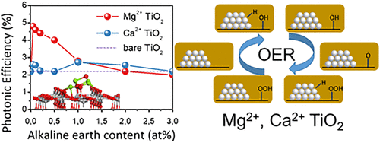
The oxygen (O-2) evolution reaction (OER) is accepted as the bottleneck in the overall water splitting and has seen intense interest. In this work, we prepared rutile TiO2 modified with nanoclusters of alkaline-earth metal oxides for the OER. Photocatalytic OER was performed over rutile TiO2 surface-modified with alkaline-earth oxide nanoclusters, namely, CaO and MgO. The O-2 evolution activity is notably enhanced for MgO-modified systems at low loadings and a combination of characterization and first-principles simulations allows interpretation of the role of the nanocluster modification in improving the photocatalytic performance of alkaline-earth-modified rutile TiO2. At such low loadings, the nanocluster modifiers would be small, and this facilitates a close correlation with theoretical models. Structural and surface characterizations of the modified systems indicate that the integrity of the rutile phase is maintained after modification. However, charge-carrier separation is strongly affected by the presence of surface nanoclusters. This improved performance is related to surface features such as higher ion dispersion and surface hydroxylation, which are also discussed with first-principles simulations. The modified systems are reducible so that Ti3+ ions will be present. Water dissociation is favorable at cluster and interfacial sites of the stoichiometric and reduced modified surfaces. Pathways to water oxidation at interfacial sites of reduced MgO-modified rutile TiO2 are identified, requiring an overpotential of 0.68 V. In contrast, CaO-modified systems required overpotentials in excess of 0.85 V for the reaction to proceed.
Structural and surface considerations on Mo/ZSM-5 systems for methane dehydroaromatization reaction
Lopez-Martin, A; Caballero, A; Colon, G
Molecular Catalysis, 486 (2020) 110787 | DOI: 10.1016/j.mcat.2020.110787
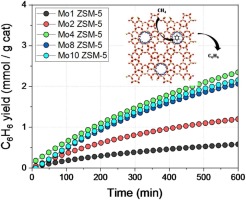
We have prepared a series of Mo/ZSM-5 systems by impregnation method with different metal loading. The optimum performance has been attained for 4% metal loading, yielding to ca. 2 mmol(benzene)/g(ca)(t) at the end of the reaction. The obtained catalysts were widely structural and surface characterized. As Mo content increases, the surface feature of the support is affected specially its mesoporosity. It has been stated the enormous complexity of Mo species present in the studied system. In situ characterization by XPS reveals different reduction and carburization behaviour depending on the Mo content.
Monolithic stirrer reactor: The selective lactose oxidation in liquid phase over Au/Al2O3 nanostructured catalysts
Regenhardt, SA; Meyer, CI; Sanz, O; Sebastian, V; Ivanova, S; Centeno, MA; Odriozola, JA; Montes, M; Marchi, AJ; Garetto, TF
Molecular Catalysis, 481 (2020) 110219 | DOI: 10.1016/j.mcat.2018.10.014
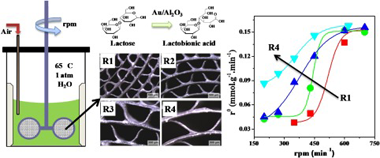
The performance of rotating metallic monolith stirrer reactor was studied for selective lactose oxidation in liquid phase at 65 degrees C, atmospheric pressure and with air as oxidant agent. The Au/Al(2)O(3)deposition on metallic substrates was performed by wash-coating, producing catalyst coating thicknesses between 5 and 20 mu m. Monoliths with different configuration (channel size between 0.36 and 1.06 mm) were used as stirrer blades in a batch reactor. Internal and external mass transfer limitations were observed during liquid phase lactose oxidation. For stirring rates equal or higher than 600 rpm there were no important external diffusional restrictions and this was also independent of the monolith configuration. Coating with thickness higher than 15 mu m presents loss of catalyst effectiveness due to internal diffusional restrictions. Excellent stability in the catalytic tests was obtained after three regeneration-reaction cycles. Regeneration was carried out at 400 degrees C in air flow. Gold particle size distribution in the monolith washcoat, determined by TEM before and after reaction, was homogeneous with a medium size of around 5 nm. This is in agreement with the very good reproducibility and stability obtained in the catalytic tests. After calcination at 500 degrees C, some sintering and a heterogeneous distribution of metal particle size was observed, accompanied by a slight loss in catalyst activity. It is concluded that metallic monolith stirrer reactors are a promising application for selective lactose oxidation in liquid phase.
Effect of support oxygen storage capacity on the catalytic performance of Rh nanoparticles for CO2 reforming of methane
Yentekakis, IV; Goula, G; Hatzisymeon, M; Betsi-Argyropoulou, I; Botzolaki, G; Kousi, K; Kondarides, DI; Taylor, MJ; Parlett, CMA; Osatiashtiani, A; Kyriakou, G; Holgado, JP; Lambert, RM
Applied Catalysis B-Environmental, 243 (2019) 490-501 | DOI: 10.1016/j.apcatb.2018.10.048
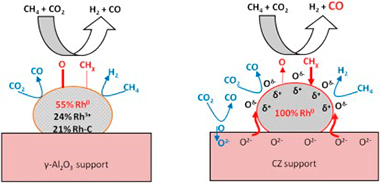
The effects of the metal oxide support on the activity, selectivity, resistance to carbon deposition and high temperature oxidative aging on the Rh-catalyzed dry reforming of methane (DRM) were investigated. Three Rh catalysts supported on oxides characterized by very different oxygen storage capacities and labilities (gamma-Al2O3, alumina-ceria-zirconia (ACZ) and ceria-zirconia (CZ)) were studied in the temperature interval 400-750 degrees C under both integral and differential reaction conditions. ACZ and CZ promoted CO2 conversion, yielding CO enriched synthesis gas. Detailed characterization of these materials, including state of the art XPS measurements obtained via sample transfer between reaction cell and spectrometer chamber, provided clear insight into the factors that determine catalytic performance. The principal Rh species detected by post reaction XPS was Rh, its relative content decreasing in the order Rh/CZ(100%) > Rh/ACZ(72%) > Fth/gamma Al2O3(55%). The catalytic activity followed the same order, demonstrating unambiguously that Rh is indeed the key active site. Moreover, the presence of CZ in the support served to maintain Rh in the metallic state and minimize carbon deposition under reaction conditions. Carbon deposition, low in all cases, increased in the order Rh/CZ < Rh/ACZ < Rh/gamma-Al2O3 consistent with a bi-functional reaction mechanism whereby backspillover of labile lattice O2- contributes to carbon oxidation, stabilization of Rh and modification of its surface chemistry; the resulting O vacancies in the support providing centers for dissociative adsorption of CO2. The lower apparent activation energy observed with CZ-containing samples suggests that CZ is a promising support component for use in low temperature DRM.
Phosphate-type supports for the design of WGS catalysts
Navarro-Jaen, S; Romero-Sarria, F; Centeno, MA; Laguna, OH; Odriozola, JA
Applied Catalysis B-Environmental, 244 (2019) 853-862 | DOI: 10.1016/j.apcatb.2018.12.022
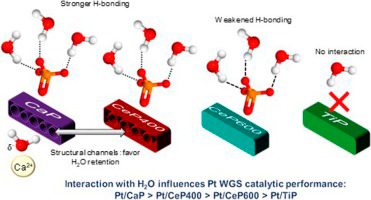
The importance of water availability during the WGS reaction has been extensively reported. Thus, the search of new supports able to interact with the water molecule is of great importance. In this work, a series of phosphate type supports containing Ce, Ca and Ti have been studied, demonstrating that water interaction with the support is closely related to the textural properties, surface composition and crystal structure of the solids. Additionally, DRIFTS results showed that different interaction mechanisms with the water molecule occur depending on the support. The system containing Ca dissociates the water molecule and interacts with it via the phosphate and Ca2+ ions. However, the Ce systems retain water in its molecular form, which interacts with the solids via hydrogen bonding with the phosphate groups. On the other hand, the Ti system experiences a loss of phosphorous, presenting a low degree of interaction with the water molecule. Additionally, the behavior of the supports with water has been successfully related to the WGS catalytic activity of the corresponding phosphate supported Pt catalysts.
3D core-multishell piezoelectric nanogenerators
A. Nicolas Filippin; Juan R.Sanchez-Valencia; Xabier Garcia-Casas; Victor Lopez-Flores; Manuel Macias-Montero; Fabian Frutos; Angel Barranco; Ana Borras
Nano Energy, 58 (2019) 476-483 | DOI: 10.1016/j.nanoen.2019.01.047
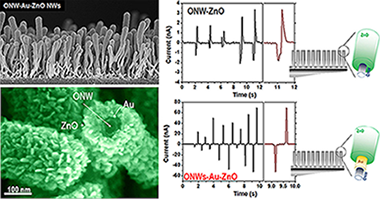
The thin film configuration presents obvious practical advantages over the 1D implementation in energy harvesting systems such as easily manufacturing and processing, and long-lasting and stable devices. However, ZnO-based piezoelectric nanogenerators (PENGs) generally rely on the exploitation of single-crystalline nanowires because of their self-orientation in the c-axis direction and ability to accommodate long deformations resulting in high piezoelectric performance. Herein, we show an innovative approach to produce PENGs by combining polycrystalline ZnO layers fabricated at room temperature by plasma-assisted deposition with supported small-molecule organic nanowires (ONWs) acting as 1D scaffolds. Such hybrid nanostructures present convoluted core-shell morphology, formed by a single-crystalline organic nanowire conformally surrounded by a poly-crystalline ZnO shell and combine the organic core mechanical properties with the ZnO layer piezoelectric response. In a step forward towards the integration of multiple functions within a single wire, we have also developed ONW-Au-ZnO nanoarchitectures including a gold shell acting as inner electrode achieving output piezo-voltages up to 170 mV. The synergistic combination of functionalities in the ONW-Au-ZnO devices promotes an enhanced performance generating piezo-currents one order of magnitude larger than the ONW-ZnO nanowires and superior to the thin film nanogenerators for equivalent and higher thicknesses.
Plasma Enabled Conformal and Damage Free Encapsulation of Fragile Molecular Matter: from Surface-Supported to On-Device Nanostructures
Alcaire, M; Aparicio, FJ; Obrero, J; Lopez-Santos, C; Garcia-Garcia, FJ; Sanchez-Valencia, JR; Frutos, F; Ostrikov, K; Borras, A; Barranco, A
Advanced Functional Materials, (2019) art. 1903535 | DOI: 10.1002/adfm.201903535
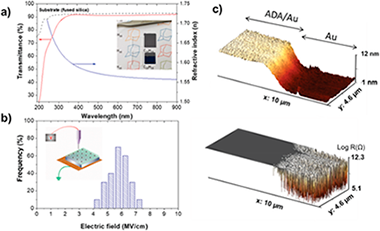
Damage-free encapsulation of molecular structures with functional nanolayers is crucial to protect nanodevices from environmental exposure. With nanoscale electronic, optoelectronic, photonic, sensing, and other nanodevices based on atomically thin and fragile organic matter shrinking in size, it becomes increasingly challenging to develop nanoencapsulation that is simultaneously conformal at atomic scale and does not damage fragile molecular networks, while delivering added device functionality. This work presents an effective, plasma-enabled, potentially universal approach to produce highly conformal multifunctional organic films to encapsulate atomically thin graphene layers and metalorganic nanowires, without affecting their molecular structure and atomic bonding. Deposition of adamantane precursor and gentle remote plasma chemical vapor deposition are synergized to assemble molecular fragments and cage-like building blocks and completely encapsulate not only the molecular structures, but also the growth substrates and device elements upon nanowire integration. The films are insulating, transparent, and conformal at sub-nanometer scale even on near-tip high-curvature areas of high-aspect-ratio nanowires. The encapsulated structures are multifunctional and provide effective electric isolation, chemical and environmental protection, and transparency in the near-UV-visible-near-infrared range. This single-step, solvent-free remote-plasma approach preserves and guides molecular building blocks thus opening new avenues for precise, atomically conformal nanofabrication of fragile nanoscale matter with multiple functionalities.
Graphene Formation Mechanism by the Electrochemical Promotion of a Ni Catalyst
Espinos, JP; Rico, VJ; Gonzalez-Cobos, J; Sanchez-Valencia, JR; Perez-Dieste, V; Escudero, C; de Lucas-Consuegra, A; Gonzalez-Elipe, AR
ACS Catalysis, 9 (2019) 11447-11454 | DOI: 10.1021/acscatal.9b03820
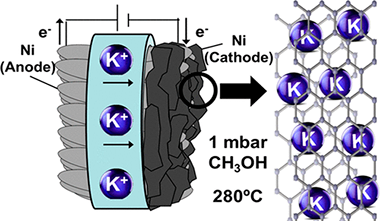
In this work, we show that multilayer graphene forms by methanol decomposition at 280 degrees C on an electrochemically promoted nickel catalyst film supported on a K-beta Al2O3 solid electrolyte. In operando near ambient pressure photoemission spectroscopy and electrochemical measurements have shown that polarizing negatively the Ni electrode induces the electrochemical reduction and migration of potassium to the nickel surface. This elemental potassium promotes the catalytic decomposition of methanol into graphene and also stabilizes the graphene formed via diffusion and direct K-C interaction. Experiments reveal that adsorbed methoxy radicals are intermediate species in this process and that, once formed, multilayer graphene remains stable after electrochemical oxidation and back migration of potassium to the solid electrolyte upon positive polarization. The reversible diffusion of ca. 100 equivalent monolayers of potassium through the carbon layers and the unprecedented low-temperature formation of graphene and other carbon forms are mechanistic pathways of high potential impact for applications where mild synthesis and operation conditions are required.
Comprehensive Experimental and Theoretical Study of the CO plus NO Reaction Catalyzed by Au/Ni Nanoparticles
Kyriakou, G; Marquez, AM; Holgado, JP; Taylor, MJ; Wheatley, AEH; Mehta, JP; Sanz, JF; Beaumont, SK; Lambert, RM
ACS Catalysis, 9 (2019) 4919-4929 | DOI: 10.1021/acscatal.8b05154
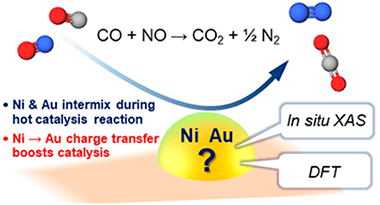
The catalytic and structural properties of five different nanoparticle catalysts with varying Au/Ni composition were studied by six different methods, including in situ X-ray absorption spectroscopy and density functional theory (DFT) calculations. The as-prepared materials contained substantial amounts of residual capping agent arising from the commonly used synthetic procedure. Thorough removal of this material by oxidation was essential for the acquisition of valid catalytic data. All catalysts were highly selective toward N-2 formation, with 50-50 Au:Ni material being best of all. In situ X-ray absorption near edge structure spectroscopy showed that although Au acted to moderate the oxidation state of Ni, there was no clear correlation between catalytic activity and nickel oxidation state. However, in situ extended X-ray absorption fine structure spectroscopy showed a good correlation between Au Ni coordination number (highest for Ni50Au50) and catalytic activity. Importantly, these measurements also demonstrated substantial and reversible Au/Ni intermixing as a function of temperature between 550 degrees C (reaction temperature) and 150 degrees C, underlining the importance of in situ methods to the correct interpretation of reaction data. DFT calculations on smooth, stepped, monometallic and bimetallic surfaces showed that N + N recombination rather than NO dissociation was always rate-determining and that the activation barrier to recombination reaction decreased with increased Au content, thus accounting for the experimental observations. Across the entire composition range, the oxidation state of Ni did not correlate with activity, in disagreement with earlier work, and theory showed that NiO itself should be catalytically inert. Au-Ni interactions were of paramount importance in promoting N + N recombination, the rate-limiting step.
The Calcium-Looping (CaCO3/CaO) process for thermochemical energy storage in Concentrating Solar Power plants
Ortiz, C; Valverde, JM; Chacartegui, R; Perez-Maqueda, LA; Gimenez, P
Renewable & Sustanaible Energy Reviews, 113 (2019) 109252 | DOI: 10.1016/j.rser.2019.109252

Energy storage based on thermochemical systems is gaining momentum as a potential alternative to molten salts in Concentrating Solar Power (CSP) plants. This work is a detailed review about the promising integration of a CaCO3/CaO based system, the so-called Calcium-Looping (CaL) process, in CSP plants with tower technology. The CaL process relies on low cost, widely available and non-toxic natural materials (such as limestone or dolomite), which are necessary conditions for the commercial expansion of any energy storage technology at large scale. A comprehensive analysis of the advantages and challenges to be faced for the process to reach a commercial scale is carried out. The review includes a deep overview of reaction mechanisms and process integration schemes proposed in the recent literature. Enhancing the multicycle CaO conversion is a major challenge of the CaL process. Many lab-scale analyses carried out show that residual effective CaO conversion is highly dependent on the process conditions and the CaO precursors used, reaching values in a wide range (0.07–0.82). The selection of the optimal operating conditions must be based on materials performance, process integration, technology and economics aspects. Global plant efficiencies over 45% (without considering solar-side losses) show the interest of the technology. Furthermore, the technological maturity and potential of the process is assessed. The direction towards which future works should be headed is discussed.
Multicycle CO2 capture activity and fluidizability of Al-based synthesized CaO sorbents
Azimi, B; Tahmasebpoor, M; Sanchez-Jimenez, PE; Perejon, A; Valverde, JM
Chemical Engineering Journal, 358 (2019) 679-690 | DOI: 10.1016/j.cej.2018.10.061
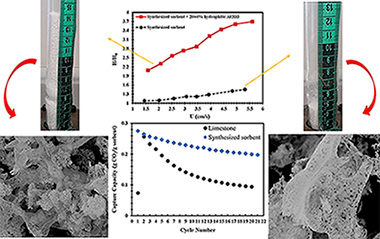
CaO-based materials have been identified as promising sorbents for highly efficient pre-combustion and post-combustion CO2 capture in fluidized beds operated at high temperatures by means of the Calcium Looping (CaL) process. However, Ca-based sorbents suffer from a decline of the capture capacity over multiple sorption/desorption cycles, mainly due to sintering, and from a markedly heterogeneous fluidization behavior due to the strength of interparticle attractive forces as compared to particle weight. The present study is focused on the development of novel synthetic CaO/Al2O3 sorbents for CO2capture with enhanced CaL performance and fluidizability by dry mixing with flow conditioner nanopowders. The influence of initial precursors on the sorbents multicycle activity at realistic CaL conditions has been investigated. The formation of a stable Ca9Al6O18 mixed-phase during the preparation of the sorbents promotes the multicycle capture capacity. The type of Ca and Al precursors, either soluble or insoluble, can significantly affect the dispersion of this stabilizer (Ca9Al6O18) in the sorbent matrix and, consequently, may affect the carbonation activity of the materials. The sorbent prepared from soluble aluminum nitrate and calcium nitrate precursors by sol-gel method exhibits a very stable multicycle capture capacity with a capture capacity around 0.2 g of CO2/g of sorbent after 21 cycles keeping a 72% of its initial capture capacity. The fluidizability of this promising sorbent was also investigated as affected by the addition of three different flow conditioners. Fluidization experiments confirmed the positive effect of using hydrophilic alumina and hydrophobic silica nanoparticles on improving the fluidizability of the synthesized sorbents.
Does shaping catalysts modify active phase sites? A comprehensive in situ FTIR spectroscopic study on the performance of a model Ru/Al2O3 catalyst for the CO methanation
Bobadilla, LF; Munoz-Murillo, A; Laguna, OH; Centeno, MA; Odriozola, JA
Chemical Engineering Journal, 357 (2019) 248-257 | DOI: 10.1016/j.cej.2018.09.166
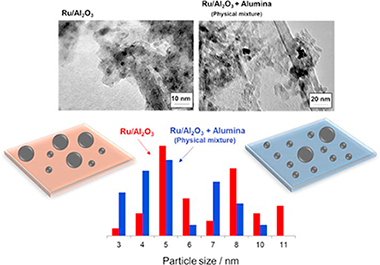
Routinely, it seems assumed that the catalytic layer coated on monoliths and microchannel reactors preserve the properties of the initial powder catalyst. However, this assumption should be reasonably demonstrated since the set of chemical and physical manipulations involved in the preparation of these catalytic devices hardly does not alter the surface of the starting catalyst powders. This work aims to evaluate the transformations that takes place in a model Ru/Al2O3 catalyst during a typical slurry preparation procedure and their impact on the catalytic performance for the CO methanation reaction and the selective methanation of CO in CO2-rich reformate gases. For this purpose, we have conducted an in situ comprehensive study by means of Fourier Transform Infrared Spectroscopy (FTIR) in which the nature of the species present on the surface of the catalyst during CO hydrogenation was analyzed. This study reveals that during the preparation of the slurry the starting Ru/Al2O3 catalyst suffers a redispersion of metallic Ru particles and more surface hydroxyls are created by the incorporation of additional alumina. These modifications have a noticeable influence in the catalytic performance and despite their importance, these aspects have been poorly considered in other studies.
Correlation of Structure and Performance of Hard Carbons as Anodes for Sodium Ion Batteries
Gomez-Martin, A; Martinez-Fernandez, J; Ruttert, M; Winter, M; Placke, T; Ramirez-Rico, J
Chemistry of Materials, 31 (2019) 7288-7299 | DOI: 10.1021/acs.chemmater.9b01768
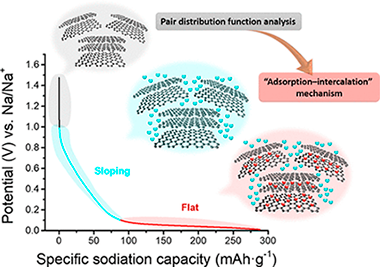
Hard carbons are the material of choice as negative electrode in sodium ion batteries. Despite being extensively studied, there is still debate regarding the mechanisms responsible for storage in low- and high-potential regions. This work presents a comprehensive approach to elucidate the involved storage mechanisms when Na ions insert into such disordered structures. Synchrotron X-ray total scattering experiments were performed to access quantitative information on atomic ordering in these materials at the nanoscale. Results prove that hard carbons undergo an atomic rearrangement as the graphene layers cross-link at intermediate temperatures (1200-1600 degrees C), resulting in an increase of the average interplanar distance up to 1400 degrees C, followed by a progressive decrease. This increase correlates with the positive trend in the reversible capacity of biomass-derived carbons when processed up to 1200-1600 degrees C due to an increased capacity at low potential (<= 0.1 V vs Na/Na+). A decrease in achievable sloping capacity with increasing heat-treatment temperature arises from larger crystalline domains and a lower concentration of defects. The observed correlation between structural parameters and electrochemical properties clearly supports that the main storage of Na ions into a hard-carbon structure is based on an adsorption-intercalation mechanism.
High-performance and low-cost macroporous calcium oxide based materials for thermochemical energy storage in concentrated solar power plants
Jimenez, PES; Perejon, A; Guerrero, MB; Valverde, JM; Ortiz, C; Maqueda, LAP
Applied Energy, 235 (2019) 543-552 | DOI: 10.1016/j.apenergy.2018.10.131
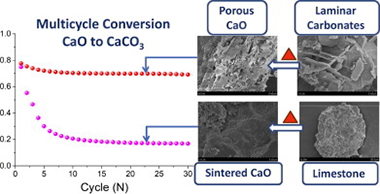
High energy density, cycling stability, low cost and scalability are the main features required for thermochemical energy storage systems to achieve a feasible integration in Concentrating Solar Power plants (CSP). While no system has been found to fully satisfy all these requirements, the reversible CaO/CaCO3 carbonation reaction (CaL) is one of the most promising since CaO natural precursors are affordable and earth-abundant. However, CaO particles progressively deactivate due to sintering-induced morphological changes during repeated carbonation and calcinations cycles. In this work, we have prepared acicular calcium and magnesium acetate precursors using a simple, cost-effective and easily scalable technique that requires just the natural minerals and acetic acid, thereby avoiding expensive reactants and environmentally unfriendly solvents. Upon thermal decomposition, these precursors yield a stable porous structure comprised of well dispersed MgO nanoparticles coating the CaO/CaCO3 grains that is resistant to pore-plugging and sintering while at the same time exhibits high long term effective conversion. Process simulations show that the employment of these materials could significantly improve the overall CSP-CaL efficiency at the industrial level.
Mechanism of Photoluminescence Intermittency in Organic-Inorganic Perovskite Nanocrystals
Galisteo-Lopez, JF; Calvo, ME; Rojas, TC; Miguez, H
ACS Applied Materials & Interfaces, 11 (4) (2019) 6344-6349 | DOI: 10.1021/acsami.8b17122
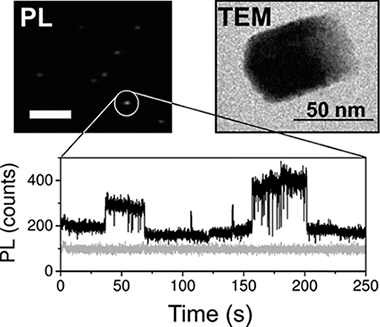
Lead halide perovskite nanocrystals have demonstrated their potential as active materials for optoelectronic applications over the past few years. Nevertheless, one issue that hampers their applicability has to do with the observation of photoluminescence intermittency, commonly referred to as "blinking", as in their inorganic counterparts. Such behavior, reported for structures well above the quantum confinement regime, has been discussed to be strongly related to the presence of charge carrier traps. In this work, we analyze the characteristics of this intermittency and explore the dependence on the surrounding atmosphere, showing evidence for the critical role played by the presence of oxygen. We discuss a possible mechanism in which a constant creation/annihilation of halide-related carrier traps takes place under light irradiation, with the dominant rate being determined by the atmosphere.
Eu3+ Luminescence in High Charge Mica: An In Situ Probe for the Encapsulation of Radioactive Waste in Geological Repositories
Martin-Rodriguez, R; Aguado, F; Alba, MD; Valiente, R; Perdigon, AC
ACS Applied Materials & Interfaces, 11 (4) (2019) 7559-7565 | DOI: 10.1021/acsami.8b20030
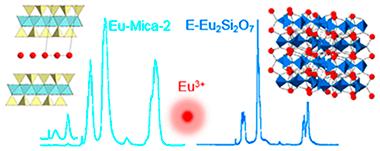
Isolation of high-level radioactive waste (HLW) in deep geological repositories (DGR) through a multibarrier concept is the most accepted approach to ensure long-term safety. Clay minerals are one of the most promising materials to be used as engineered barriers. In particular, high charge micas, as components of the engineered barrier, show superselectivity for some radioactive isotopes and a large adsorption capacity, which is almost twice that of the other low charge aluminosilicates. In addition, high charge micas are optimum candidates for decontamination of nuclear waste through two different mechanisms; namely an ion exchange reaction and a nonreversible mechanism involving the formation of new stable crystalline phases under hydrothermal conditions. In this work, we report a new in situ optical sensor based on the incorporation of Eu3+ in these high charge micas for tracking the long-term physical-chemical behavior of HLW contaminants in DRG under mild hydrothermal conditions. The incorporation of Eu3+ into the interlayer space of the mica originates a well resolved green and red luminescence, from both the 5D1 and 5D0 excited states, respectively. The formation of new crystalline phases under hydrothermal conditions involves important changes in the Eu3+ emission spectra and lifetime. The most interesting features of Eu3+ luminescence to be used as an optical sensor are (1) the presence or absence of the Eu3+ green emission from the 5D1 excited state, (2) the energy shift of the 5D0 → 7F0 transition, (3) the crystal-field splitting of the 7F1 Eu3+ level, and (4) the observed luminescence lifetimes, which are directly related to the interaction mechanisms between the lanthanide ions and the silicate network.
Highly Efficient Transparent Nanophosphor Films for Tunable White-Light-Emitting Layered Coatings
Geng, DL; Lozano, G; Miguez, H
ACS Applied Materials & Interfaces, 11 (4) (2019) 4219-4225 | DOI: 10.1021/acsami.8b17368
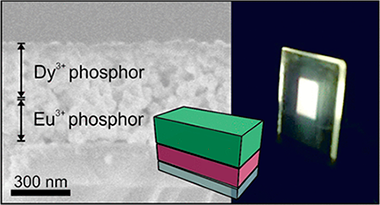
Bright luminescence in rare-earth (RE) nanocrystals, the so-called nanophosphors, is generally achieved by choosing a host that enables an effective excitation of the RE activator through charge or energy transfer. Although tungstate, molybdate, or vanadate compounds provide the aforementioned transfer, a comparative analysis of the efficiency of such emitters remains elusive. Herein, we perform a combined structural and optical analysis, which reveals that the tetragonal GdVO4 matrix gives rise to the highest efficiency among the different transparent nanophosphor films compared. Then, we demonstrate that by a sequential stacking of optical quality layers made of Eu3+- and Dy3+-doped nanocrystals, it is possible to attain highly transparent white-light-emitting coatings of tunable shade with photoluminescence quantum yields above 35%. Layering provides a precise dynamic tuning of the chromaticity based on the photoexcitation wavelength dependence of the emission of the nanophosphor ensemble without altering the chemical composition of the emitters or degrading their efficiency. The total extinction of the incoming radiation along with the high quantum yields achieved makes these thin-layered phosphors one of the most efficient transparent white converter coatings ever developed.
CuxCo3-xO4 ultra-thin film as efficient anodic catalysts for anion exchange membrane water electrolysers
Lopez-Fernandez, E; Gil-Rostra, J; Espinos, JP; Gonzalez-Elipe, AR; Yubero, F; de Lucas-Consuegra, A
Journal of Power Sources, 415 (2019) 136-144 | DOI: 10.1016/j.jpowsour.2019.01.056
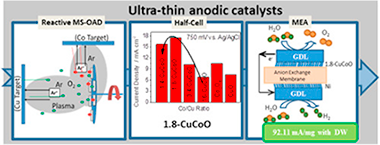
CuxCo3-xO4 ultra-thin films, deposited by magnetron sputtering at oblique angles have been used as anodic catalysts in anion exchange membrane water electrolysers. It has been demonstrated that the used deposition procedure provides porous and amorphous samples with a strict control of the total catalyst load and Co/Cu ratio. Electrocatalytic tests showed a maximum performance for the oxygen evolution reaction at Co/Cu atomic ratio around 1.8. The optimized anodic catalyst presented a long-term stability confirmed by accelerated lifetime tests together with the chemical surface analysis of the used samples. The effect of the crystallization of a single layer CuxCo3-xO4 and a multilayer (CuO/Co3O4)(n) anodic catalyst samples was also investigated. The observed loss of catalytic performance found in both cases may prove that a particular local chemical environment around the Co and Cu sites acts as an efficient catalytic site for the oxygen evolution reaction. A catalyst film with the optimum Co/Cu atomic ratio was incorporated into a Membrane Electrode Assembly, using a sputtered Ni film as cathode. Current density values up to 100 mA cm(-2) at 2.0 V were obtained in 1.0 M KOH electrolyte. Upon normalization by the amount of catalyst, this performance is one of the highest reported in literature.
Synthesis, functionalization and properties of uniform europium-doped sodium lanthanum tungstate and molybdate (NaLa(XO4)(2), X = Mo,W) probes for luminescent and X-ray computed tomography bioimaging
Laguna, M; Nunez, NO; Becerro, AI; Lozano, G; Moros, M; de la Fuente, JM; Corral, A; Balcerzyk, M; Ocana, M
Journal of Colloid and Interface Science, 554 (2019) 520-530 | DOI: 10.1016/j.jcis.2019.07.031
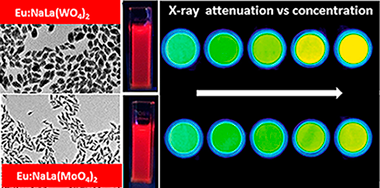
A one-pot simple procedure for the synthesis of uniform, ellipsoidal Eu3+-doped sodium lanthanum tungstate and molybdate (NaLa(XO4)(2), X = W, Mo) nanophosphors, functionalized with carboxylate groups, is described. The method is based on a homogeneous precipitation process at 120 degrees C from appropriate Na+ Ln(3+) and tungstate or molybdate precursors dissolved in ethylene glycol/water mixtures containing poly acrylic acid. A comparative study of the luminescent properties of both luminescent materials as a function of the Eu3+ doping level has been performed to find the optimum nanophosphor, whose efficiency as X-ray computed tomography contrast agent is also evaluated and compared with that of a commercial probe. Finally, the cell viability and colloidal stability in physiological pH medium of the optimum samples have also been studied to assess their suitability for biomedical applications.
Highly selective few-ppm NO gas-sensing based on necklace-like nanofibers of ZnO/CdO n-n type I heterojunction
Naderi, H; Hajati, S; Ghaedi, M; Espinos, JP
Sensors and Actuators B-Chemical, 297 (2019) 126774 | DOI: 10.1016/j.snb.2019.126774
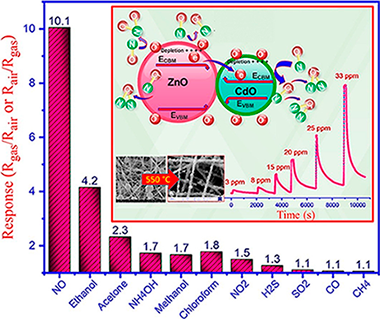
Electrospinning method followed by calcination is applied to synthesize ZnO/CdO nanofibers. Characterization is performed by X-ray diffraction (XRD), scanning electron microscopy (SEM), field emission scanning electron microscopy (FESEM), energy dispersive spectroscopy (EDS), diffuse reflectance spectroscopy (DRS), X-ray photoelectron spectroscopy (XPS), ultraviolet photoelectron spectroscopy (UPS) and reflection electron energy loss spectroscopy (REELS), which resulted in detailed analysis of the sensing material. For instance, it was found that the ZnO/CdO is n-n type I heterojunction which possesses straddling energy band gap, which could affect the mechanism of gas sensing. An electroless gold-plated interdigitated electrode with spacing 200 mu m is fabricated on alumina substrate to host the designed nanofibers being used as gas sensor. Gas-sensing activity of the heterojunction is investigated against NO, NO2, H2S, CH4, SO2 and CO in addition to VOCs such as ethanol, acetone, ammonia, methanol, and chloroform with high selectivity and response to NO gas by monitoring resistance changes. Detailed discussion on the mechanism of sensing is presented. The ZnO/CdO nanofibers are found to be highly sensitive to very low concentration range of NO gas (1.2-33 ppm) at optimal operating temperature of 215 degrees C. The influence of humidity (20-96%) on the sensor response was found to be ignorable. Additionally, good repeatability and long-term stability (45 days, every 5 days, SD = 0.7) was obtained for this sensor. Typically, short response times of 47 and 35 s are obtained versus 3 and 33 ppm of NO, respectively, making our sensor promisingly applicable for monitoring this toxic gas in polluting industries, metropolises and maybe in exhaled breath.
Flexible nanophosphor films doped with Mie resonators for enhanced out-coupling of the emission
Miranda-Munoz, JM; Geng, DL; Calvo, ME; Lozano, G; Miguez, H
Journal of Materials Chemistry C, 7 (2019) 267-274 | DOI:
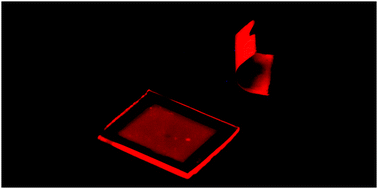
Herein, we present a general method to prepare self-standing flexible photoluminescent coatings of controlled opacity for integration into light-emitting diodes (LEDs) employing cost-effective solution-processing methods. From colloidal suspensions of nano-sized phosphors, we fabricate light-emitting transparent films that can be doped with spherical scatterers, which act as Mie resonators that trigger a controlled photoluminescence enhancement, evidenced by the reduction of the guided light along the layer. This results in an enhanced emission compared to that extracted from a bare phosphor layer. We show not only that emission is visible under ultraviolet-LED illumination for both rigid and flexible versions of the coatings, but we also prove the feasibility of the integration of these flexible conversion layers into such devices. We believe these results can contribute to develop more efficient and cost-effective illumination sources by providing efficient and easy-to-handle conversion layers susceptible to excitation by LEDs emitting at wavelengths in the near UV region.
Tamm Plasmons Directionally Enhance Rare-Earth Nanophosphor Emission
Geng, DL; Cabello-Olmo, E; Lozano, G; Miguez, H
ACS Photonics, 6 (2019) 634-641 | DOI: 10.1021/acsphotonics.8b01407
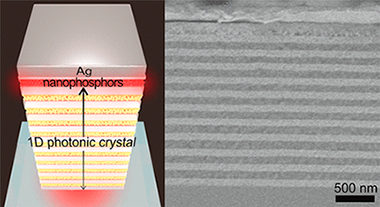
Rare-earth-based phosphors are the materials on which current solid-state lighting technology is built. However, their large crystal size impedes the tuning, optimization, or manipulation of emitted light that can be achieved by their integration in nanophotonic architectures. Herein we demonstrate a hybrid plasmonic-photonic architecture capable of both channeling in a specific direction and enhancing by eight times the emission radiated by a macroscopically wide layer of nanophosphors. In order to do so, a slab of rare-earth-based nanocrystals is inserted between a dielectric multilayer and a metal film, following a rational design that optimizes the coupling of nanophosphor emission to collective modes sustained by the metal-dielectric system. Our approach is advantageous for the optimization of solid-state lighting systems.
Casimir-Lifshitz Force Based Optical Resonators
Esteso, V; Carretero-Palacios, S; Miguez, H
Journal of Physical Chemistry Letters, 10 (2019) 5856-5860 | DOI: 10.1021/acs.jpclett.9b02030
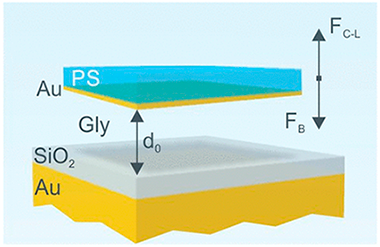
We theoretically investigate the building of optical resonators based on the levitation properties of thin films subjected to strong repulsive Casimir-Lifshitz forces when immersed in an adequate medium and confronted with a planar substrate. We propose a design in which cavities supporting high Q-factor optical modes at visible frequencies can be achieved by means of combining commonly found materials, such as silicon oxide, polystyrene or gold, with glycerol as a mediating medium. We use the balance between flotation and repulsive Casimir-Lifshitz forces in the system to accurately tune the optical cavity thickness and hence its modes. The effects of other forces, such as electrostatic, that may come into play are also considered. Our results constitute a proof of concept that may open the route to the design of photonic architectures in environments in which dispersion forces play a substantial role and could be of particular relevance for devising novel microfluidic optical resonators.
Exchange bias and two steps magnetization reversal in porous Co/CoO layer
Ovejero, JG; Godinho, V; Lacroix, B; Garcia, MA; Hernando, A; Fernandez, A
Materials & Design, 171 (2019) 107691 | DOI: 10.1016/j.matdes.2019.107691
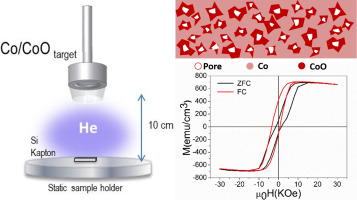
In this paper Co/CoO thick layers (hundreds of nanometers) of different porosity and oxidation degree were prepared in a magnetron sputtering deposition processby tailoring the DC sputtering power, as well as the process gas and target composition. The control of the synthesis parameters allowed the nanostructuration of the films with a singular distribution of closed pores and a controlled amount of CoO. We observed an exchange bias field of 2.8 KOe for porous Co/CoO composites, similar to Co/CoO bilayers but for coatings thicker than 300 nm. Besides, it was observed that the coating presents bistable magnetic features when cooled under zero field conditions as a result of the unusual exchange coupling.
Promoting effect of CeO2, ZrO2 and Ce/Zr mixed oxides on Co/gamma-Al2O3 catalyst for Fischer-Tropsch synthesis
Garcilaso, V; Barrientos, J; Bobadilla, LF; Laguna, OH; Boutonnet, M; Centeno, MA; Odriozola, JA
Renewable Energy, 132 (2019) 1141-1150 | DOI: 10.1016/j.renene.2018.08.080
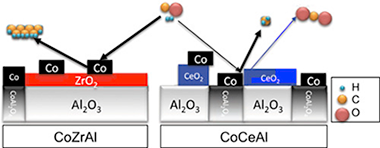
A series of cobalt-based catalysts have been synthesized using as support gamma-Al2O3 promoted by ceria/zirconia mixed oxides with a variable Ce/Zr molar ratio. The obtained catalysts demonstrated oxide promotion results in the protection of the major textural properties, especially for Zr-rich solids. Reducibility of cobalt species was enhanced by the presence of mixed oxides. The chemical composition of the oxide promoter influenced not only physicochemical properties of final catalysts but also determined their performance during the reaction. In this sense, Zr-rich systems presented a superior catalytic performance both in total conversion and in selectivity towards long chain hydrocarbons. The observed Zr-promotion effect could be explained by two significant contributions: firstly, the partial inhibition of Co-Al spinel compound formation by the presence of Zr-rich phases which enhances the availability of Co actives site and secondly, Zr-associate acidic sites promote higher hydrocarbons selectivity.
Sodium ion storage performance of magnetron sputtered WO3 thin films
Garcia-Garcia, FJ; Mosa, J; Gonzalez-Elipe, AR; Aparicio, M
Electrochimica Acta, 321 (2019) 134669 | DOI: 10.1016/j.electacta.2019.134669
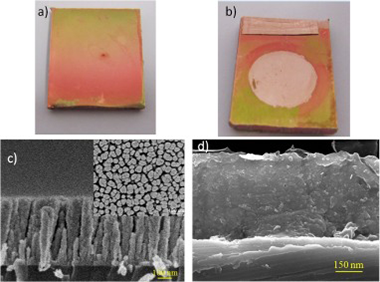
WO3 thin film electrodes were successfully prepared by magnetron sputtering (MS) deposition under an oblique angle configuration (OAD). Intercalation of Na ions in the tungsten oxide layers has been studied using electrochemical techniques. Sample characterization before and after sodium intercalation has been carried out by Raman, XPS and XRD measurements. ToF-SIMS analysis has been also performed in order to analyze the element depth profiles along the electrode thickness. Electron microscopy evaluation of the cross section confirms the porous structure of the coatings. Batteries integrating these WO3 electrodes have a discharge capacity of 120 mA h g(-1) at the initial cycles and show an adequate capacity retention upon 300 cycles. The WO3-OAD thin-films are proposed as promising electrodes for Na-ion batteries.
Controlled thermolysis of MIL-101(Fe, Cr) for synthesis of FexOy/porous carbon as negative electrode and Cr2O3/porous carbon as positive electrode of supercapacitor
Farisabadi, A; Moradi, M; Hajati, S; Kiani, MA; Espinos, JP
Applied Surface Science, 469 (2019) 192-203 | DOI: 10.1016/j.apsusc.2018.11.053
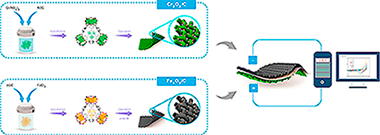
In the present study, two kinds of metal oxide/carbon nanocomposite were prepared through calcination of MIL-101(Fe, Cr). The morphological and structural properties of the specimens were investigated using X-ray diffraction, Fourier-transform infrared spectroscopy, Brunauer, Emmett, and Teller analysis, energy dispersive Xray spectroscopy, X-ray photoelectron spectroscopy and scanning electron microscopy. The electrode materials were also electrochemically investigated using cyclic voltammetry, galvanostatic charge-discharge and electrochemical impedance spectroscopy techniques in 6 M KOH electrolyte. Because of synergistic effect of metal oxides and carbon, the obtained samples showed excellent performance; in a way that Cr2O3/C and Fe Oy/C showed high specific capacitance of 420 F g(-1) and 114 F g(-1) at current density of 2 A g(-1), respectively. The Cr2O3/C electrode also displayed high rate capability even at scan rate of 1500 mV s(-1). Moreover, we successfully developed an asymmetric supercapacitor in which Cr2O3/C served as positive electrode and Fe Oy/C served as negative electrode. The asymmetric device can deliver an energy density of 9.6 W h kg(-1) and power density of 8000 W kg(-1), with 93% capacitance retention after 3000 charge-discharge cycles. These outcomes show that the MOF-derived metal oxide/carbon composite can be regarded as a promising development for advanced electrode materials for applying in supercapacitors.
Photodegradation of 2,4-dichlorophenoxyacetic acid over TiO2(B)/anatase nanobelts and Au-TiO2(B)/anatase nanobelts
Chenchana, A.; Nemamcha, A.; Moumeni, H.; Doña Rodríguez, J.M.; Araña, J.; Navío, J.A.; González Díaz, O.; Pulido Melián, E.
Applied Surface Science, 467-468 (2019) 1076-1087 | DOI: 10.1016/j.apsusc.2018.10.175
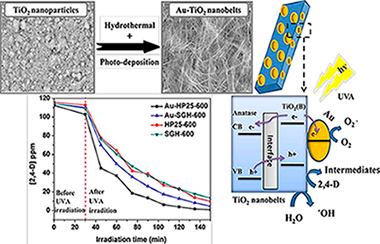
In this work, novel TiO2-based nanobelts with various phases were synthesized: biphasic TiO2(B)/anatase, pure TiO2(B) and pure anatase. These catalysts were obtained via hydrothermal reaction using two nanoparticulated TiO2 photocatalysts as precursors: Aeroxide TiO2 P25 (P25) and TiO2 synthesized via a sol-gel process (SG). In addition, the surface of the photocatalysts was modified with gold using a photodeposition method. A characterization study of the different photocatalysts was performed with X-ray diffraction analysis (XRD), UV–Vis diffuse reflectance spectra (DRS), scanning electron microscopy (SEM), X-ray photoelectron spectrum analysis (XPS) and Brunauer-Emmett-Teller measurements (BET). The photocatalytic reaction of the herbicide 2,4-dichlorophenoxyacetic acid (2,4-D) was investigated under UVA irradiation. A toxicity analysis was performed with the marine bioluminescent bacteria Vibrio fischeri. The highest 2,4-D removal efficiency of 99.2% was obtained with the biphasic Au-TiO2(TiO2(B)/anatase) nanobelts with anatase as predominant phase. Toxicity was mainly due to the intermediate 2,4-dichlorophenol (2,4-DCP) which was eliminated in 4 h. The TiO2 nanobelt phase structure is shown to have a significant effect on photocatalytic activity.
2D compositional self-patterning in magnetron sputtered thin films
Garcia-Valenzuela, A; Alvarez, R; Rico, V; Espinos, JP; Lopez-Santos, MC; Solis, J; Siegel, J; del Campo, A; Palmero, A; Gonzalez-Elipe, AR
Applied Surface Science, 480 (2019) 115-121 | DOI: 10.1016/j.apsusc.2019.02.206
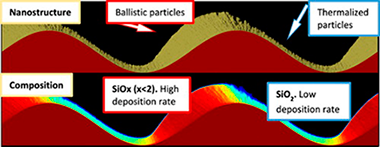
Unlike topography patterning, widely used for numerous applications and produced by means of different technologies, there are no simple procedures to achieve surface compositional patterning at nanometric scales. In this work we have developed a simple method for 2D patterning the composition of thin films. The method relies on the magnetron sputtering deposition at oblique angles onto patterned substrates made by laser induced periodic surface structures (LIPSS). The method feasibility has been demonstrated by depositing SiOx thin films onto LIPSS structures generated in Cr layers. A heterogeneous and aligned distribution of O/Si ratios (and different Sin+ chemical states) along the LIPSS structure in length scales of some hundreds nm's has been proven by angle resolved X-ray photoelectron spectroscopy and a patterned arrangement of composition monitored by atomic force microscopy-Raman analysis. The obtained results are explained by the predictions of a Monte Carlo simulation of this deposition process and open the way for the tailored one-step fabrication of surface devices with patterned compositions.
Size-tailored Ru nanoparticles deposited over gamma-Al2O3 for the CO2 methanation reaction
Navarro-Jaen, S; Navarro, JC; Bobadilla, LF; Centeno, MA; Laguna, OH; Odriozola, JA
Applied Surface Science, 483 (2019) 750-761 | DOI: 10.1016/j.apsusc.2019.03.248
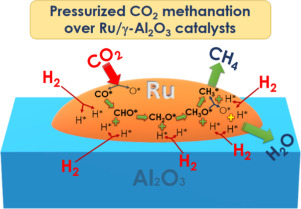
By means of the polyol method, a series of 5 wt% Ru/Al2O3 catalysts was synthesized controlling the particle size of the ruthenium species. The physico-chemical characterization demonstrated the successful particle size control of the Ru species, in such a way that higher the Ru/PVP ratio, higher the Ru particle size. Moreover, there are evidences that suggest preferential growth of the RuO2 clusters depending on the Ru/PVP ratio. Regarding the catalytic activity during the CO2 methanation, the total conversion and the CH4 yield increased with the particle size of Ru. Nevertheless, a considerable enhancement of the catalytic performance of the most active system was evidenced at 4 bar, demonstrating the improvement of the thermodynamics (superior total conversion) and kinetics (superior reaction rate) of the CO2 methanation at pressures above the atmospheric one. Finally, the in situ DRIFTS study allowed to establish that CO2 was dissociated to CO* and O* species on the metallic Ru particles, followed by the consecutive hydrogenation of CO* towards CHO*, CH2O*, CH3O*, and finally CH4 molecules, which were further desorbed from the catalyst. Thus from the mechanistic point of view, a suitable particle size of the Ru nanoparticles along with the high-pressure effects results in the enhancement of the availability of hydrogen and consequently in the formation of CHxO species that enhance the cleavage of the C-O bond, which is the rate-determining step of the overall CO2 methanation process.
SiOx by magnetron sputtered revisited: Tailoring the photonic properties of multilayers
Garcia-Valenzuela, A; Alvarez, R; Espinos, JP; Rico, V; Gil-Rostra, J; Palmero, A; Gonzalez-Elipe, AR
Applied Surface Science, 488 (2019) 791-800 | DOI: 10.1016/j.apsusc.2019.05.273
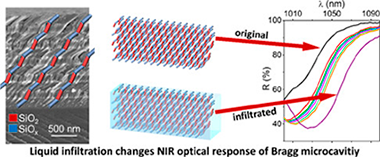
Traditionally porous silicon based photonic structures have been prepared by electrochemically etching of silicon. In this work, porous multilayers of nanocolumnar SiOx and SiO2 thin films acting as near infrared (NIR) 1D-photonic nanostructures are prepared by magnetron sputtering deposition at oblique angles (MS-OA). Simultaneous control of porosity and stoichiometry of the stacked films is achieved by adjusting the deposition angle and oxygen partial pressure according to a parametric formula. This new methodologoy is proved for the synthesis of SiOx thin films with x close to 0.4, 0.8, 1.2, 1.6 and nanostructures varying from compact (at 0 degrees deposition angle) to highly porous and nanocolumnar (at 70 degrees and 85 degrees deposition angles). The strict control of composition, structure and nanostructure provided by this technique permits a fine tuning of the absorption edge and refraction index at 1500 nm of the porous films and their manufacturing in the form of SiOx-SiO2 porous multilayers acting as near infrared (NIR) 1D-photonic structures with well-defined optofluidic responses. Liquid tunable NIR Bragg mirrors and Bragg microcavities for liquid sensing applications are presented as proof of concept of the possibilities of this MS-OA manufacturing method as an alternative to the conventional electrochemical fabrication of silicon based photonic structures.
Liquid switchable radial polarization converters made of sculptured thin films
Oliva-Ramirez, M; Rico, VJ; Gil-Rostra, J; Arteaga, O; Bertran, E; Serna, R; Gonzalez-Elip, AR; Yubero, F
Applied Surface Science, 475 (2019) 230-236 | DOI: 10.1016/j.apsusc.2018.12.200
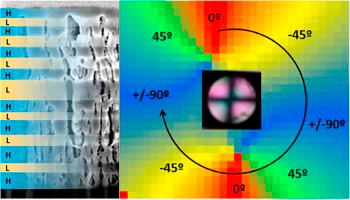
A radial polarization converter is a super-structured optical retarder that converts a conventional linearly polarized light beam into a structured beam with radial or azimuthal polarization. We present a new type of these sophisticated optical elements, which is made of porous nanostructured sculptured single thin films or multilayers prepared by physical vapor deposition at an oblique angle. They are bestowed with an axisymmetric retardation activity (with the fast axis in a radial configuration). In particular, a Bragg microcavity multilayer that exhibits a tunable transmission peak in the visible range with a retardance of up to 0.35 rad has been fabricated using this methodology. Owing to the highly porous structure of this type of thin films and multilayers, their retardance could be switched off by liquid infiltration. These results prove the possibility of developing wavelength dependent (through multilayer optical design) and switchable (through vapor condensation or liquid infiltration within the pore structure) radial polarization converters by means of oblique angle physical vapor deposition.
Coupling of WO3 with anatase TiO2 sample with high {001} facet exposition: Effect on the photocatalytic properties
Lara, M.A.; Jaramillo-Páez, C.; Navío, J.A.; Sánchez-Cid, P.; Hidalgo, M.C.
Catalysis Today, 328 (2019) 142-148 | DOI: 10.1016/j.cattod.2018.11.012
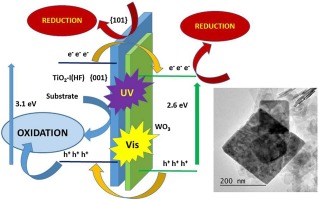
A highly faceted {001} TiO2 catalyst was hydrothermally synthesized by using Ti(IV)-isopropoxide precursor with aqueous HF addition. WO3 was synthesized by following a reported method. Coupled TiO2-WO3 samples were synthesized by adding the corresponding amount of WO3 to fluorinated TiO2 gel followed by a hydrothermal treatment. Additionally the synthesized systems were characterized by using X-ray powder diffraction (XRD), X-ray fluorescence spectrometry (XRF), field emission scanning electron microscopy (FE-SEM), transmission electron microscopy (TEM), UV–vis diffuse reflectance spectroscopy (DRS) and N2-adsorption (BET) for specific surface area determination. The photocatalytic activity of the single and coupled oxides was measured by means of three model reactions: the photo-oxidation of phenol (as a colourless substrate) and methyl orange (as a dye) and the photoreduction of Cr(VI) as K2Cr2O7. The coupling of WO3 with a highly faceted {001} TiO2 makes it possible to optimize the photocatalytic properties of the faceted material. In fact, {001} faceted TiO2 by itself presents a substantial improvement with respect to commercial TiO2(P25), as it can implement its photoactivity after the incorporation of WO3 with promising results, which can reduce the limitations of TiO2 in terms of its photoactivity, taking advantage of a higher percentage of solar radiation.
Colombian metallurgical coke as catalysts support of the direct coal liquefaction
Rico, D; Agamez, Y; Romero, E; Centeno, MA; Odriozola, JA; Diaz, JD
Fuel, 255 (2019) 115748 | DOI: 10.1016/j.fuel.2019.115748
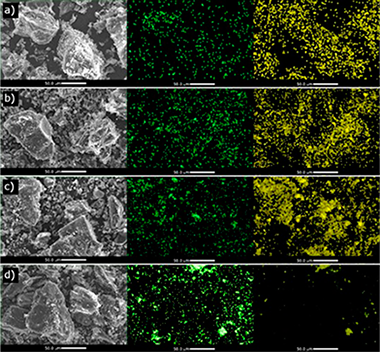
A Colombian metallurgical coke was modified in its surface chemistry and was used as support of iron sulfide catalysts for direct coal liquefaction. The modification was made by treatments with diluted oxygen and HNO3 at different conditions. Changes in surface chemistry were studied by determining the point of zero charge (PZC), the isoelectric point (IEP), thermogravimetric analysis (TGA), temperature programmed decomposition-mass spectrometry (TPD-MS), Diffuse-reflectance infrared Fourier transform spectroscopy (DRIFTS) and nitrogen adsorption at 77 K. The results show that the materials obtained have a wide range of functional groups incorporated in a different proportion and quantity. The textural parameters indicate that treatment with diluted oxygen increases the surface area and incorporates micropores while the samples treated with HNO3 maintain the textural properties of the original material. The catalysts were also characterized by Raman spectroscopy. It was found that impregnation with the iron sulfide precursor does not significantly affect the Raman characteristics of the support. Additionally, XRD analysis shows smaller pyrite crystallites in the coke enriched with oxygenated groups of phenol and lactone indicating better dispersion of the active phase. The amount of oxygen chemisorbed per gram of catalyst shows that both, oxygen and nitric acid treatments, improve the relative dispersion of the active phase. It was found that the presence of the catalysts increases the conversion and yields towards oils and gases with respect to those of the tests without catalysts. Cokes modified by dilute oxygen gaseous treatment contain surface phenol and lactone groups and present the highest yield to oils.
Combining dietary phenolic antioxidants with polyvinylpyrrolidone: transparent biopolymer films based on p-coumaric acid for controlled release
Contardi, M; Heredia-Guerrero, JA; Guzman-Puyol, S; Summa, M; Benitez, JJ; Goldoni, L; Caputo, G; Cusimano, G; Picone, P; Di Carlo, M; Bertorelli, R; Athanassioua, A; Bayer, IS
Journal of Materials Chemistry B, 7 (2019) 1384-1396 | DOI: 10.1039/c8tb03017k
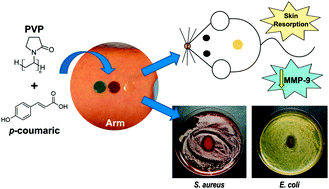
Polyvinylpyrrolidone (PVP) has probably been one of the most utilized pharmaceutical polymers with applications ranging from a blood plasma substitute to nanoparticle drug delivery, since its synthesis in 1939. It is a highly biocompatible, non-toxic and transparent film forming polymer. Although high solubility of PVP in aqueous environment is advantageous, it still poses several problems for some applications in which sustained targeting and release are needed or hydrophobic drug inclusion and delivery systems are to be designed. In this study, we demonstrate that a common dietary phenolic antioxidant, p-coumaric acid (PCA), can be combined with PVP covering a wide range of molar ratios by solution blending in ethanol, forming new transparent biomaterial films with antiseptic and antioxidant properties. PCA not only acts as an effective natural plasticizer but also establishes H-bonds with PVP increasing its resistance to water dissolution. PCA could be released in a sustained manner up to a period of 3 days depending on the PVP/ PCA molar ratio. Sustained drug delivery potential of the films was studied using methylene blue and carminic acid as model drugs, indicating that the release can be controlled. Antioxidant and remodeling properties of the films were evaluated in vitro by free radical cation scavenging assay and in vivo on a murine model, respectively. Furthermore, the material resorption of films was slower as PCA concentration increased, as observed from the in vivo full-thickness excision model. Finally, the antibacterial activity of the films against common pathogens such as Escherichia coli and Staphylococcus aureus and the effective reduction of inflammatory agents such as matrix metallopeptidases were demonstrated. All these properties suggest that these new transparent PVP/ PCA films can find a plethora of applications in pharmaceutical sciences including skin and wound care.
Anisotropic lattice expansion determined during flash sintering of BiFeO3 by in-situ energy-dispersive X-ray diffraction
Wassel, MAB; Perez-Maqueda, LA; Gil-Gonzalez, E; Charalambous, H; Perejon, A; Jha, SK; Okasinski, J; Tsakalakos, T
Scripta Materialia, 162 (2019) 286-291 | DOI: 10.1016/j.scriptamat.2018.11.028
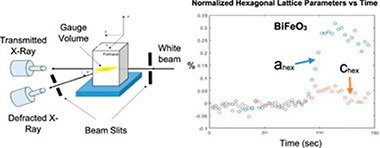
BiFeO3 has a Curie temperature (T-c) of 825 degrees C, making it difficult to sinter using conventional methods while maintaining the purity of the material, as unavoidably secondary phases appear at temperatures above T-c Flash sintering is a relatively new technique that saves time and energy compared to other sintering methods. BiFeO3 was flash sintered at 500 degrees C to achieve 90% densification. In-situ energy dispersive X-ray diffraction (EDXRD) revealed that the material did not undergo any phase transformation, having been sintered well below the Tc. Interestingly, anisotropic lattice expansion in the material was observed when the sample was exposed to the electric field.
On‐Surface Synthesis and Characterization of Acene‐Based Nanoribbons Incorporating Four‐Membered Rings
Sanchez-Sanchez, C; Dienel, T; Nicolai, A; Kharche, N; Liang, LB; Daniels, C; Meunier, V; Liu, JZ; Feng, XL; Mullen, K; Sanchez-Valencia, JR; Groning, O; Ruffieux, P; Fasel, R
Chemistry-A European Journal | DOI: 10.1002/chem.201901410
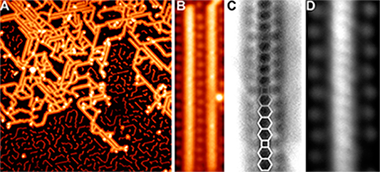
A bottom up method for the synthesis of unique tetracene-based nanoribbons, which incorporate cyclobutadiene moieties as linkers between the acene segments, is reported. These structures were achieved through the formal [2+2] cycloaddition reaction of ortho-functionalized tetracene precursor monomers. The formation mechanism and the electronic and magnetic properties of these nanoribbons were comprehensively studied by means of a multitechnique approach. Ultra-high vacuum scanning tunneling microscopy showed the occurrence of metal-coordinated nanostructures at room temperature and their evolution into nanoribbons through formal [2+2] cycloaddition at 475 K. Frequency-shift non-contact atomic force microscopy images clearly proved the presence of bridging cyclobutadiene moieties upon covalent coupling of activated tetracene molecules. Insight into the electronic and vibrational properties of the so-formed ribbons was obtained by scanning tunneling microscopy, Raman spectroscopy, and theoretical calculations. Magnetic properties were addressed from a computational point of view, allowing us to propose promising candidates to magnetic acene-based ribbons incorporating four-membered rings. The reported findings will increase the understanding and availability of new graphene-based nanoribbons with high potential in future spintronics.
High voltage vacuum-deposited CH3NH3PbI3–CH3NH3PbI3 tandem solar cells
Avila, J; Momblona, C; Boix, P; Sessolo, M; Anaya, M; Lozano, G; Vandewal, K; Miguez, H; Bolink, HJ
Energy & Environmental Science, 11 (2018) 3292-3297 | DOI: 10.1039/c8ee01936c
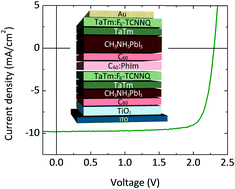
The recent success of perovskite solar cells is based on two solid pillars: the rapid progress of their power conversion efficiency and their flexibility in terms of optoelectrical properties and processing methods. That versatility makes these devices ideal candidates for multi-junction photovoltaics. We report an optically optimized double junction CH3NH3PbI3-CH3NH3PbI3 tandem solar cell where the matched short-circuit current is maximized while parasitic absorption is minimized. The use of an additive vacuum-deposition protocol allows us to reproduce calculated stack designs, which comprise several charge selective materials that ensure appropriate band alignment and charge recombination. This rationalized configuration yields an unprecedented open circuit voltage of 2.30 V. Furthermore, this tandem solar cell features efficiencies larger than 18%, higher than those of the individual sub-cells. Low photo-current values allow reducing the losses associated to the series resistance of transparent contacts, which opens the door to the realization of efficient large area modules.
Photonic structuring improves the colour purity of rare-earth nanophosphors
Geng, DL; Cabello-Olmo, E; Lozano, G; Miguez, H
Materials Horizons, 5 (2018) 661-667 | DOI: 10.1039/c8mh00123e
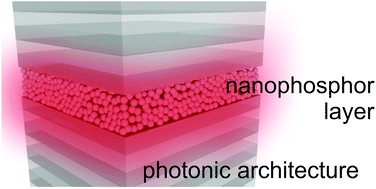
Nanophosphor integration in an optical cavity allows unprecedented control over both the chromaticity and the directionality of the emitted light, without modifying the chemical composition of the emitters or compromising their efficiency. Our approach opens a route towards the development of nanoscale photonics based solid state lighting.
Enhanced photocatalytic removal of phenol from aqueous solutions using ZnO modified with Ag
Vaiano, V.; Matarangolo, M.; Murcia, J.J.; Rojas, H.; Navío, J.A.; Hidalgo, M.C.
Applied Catalysis B-Environmental, 225 (2018) 197-206 | DOI: 10.1016/j.apcatb.2017.11.075
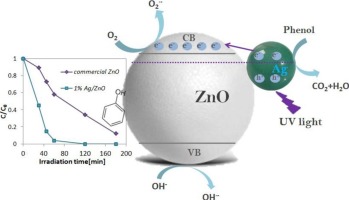
Different photocatalysts based on commercial ZnO modified by silver photodeposition were prepared in this work. The samples were characterized by X-ray fluorescence spectrometry (XRF), specific surface area (SSA), transmission electron microscopy (TEM), X-ray photoelectron spectroscopy (XPS), X-ray diffraction (XRD) and UV–vis diffuse reflectance (UV–vis DRS). XRD and XPS showed that Ag/ZnO samples are composed of metallic Ag (Ag0) and ZnO structure was identified. Furthermore, TEM analysis evidenced that the number of silver particles increased with the Ag content. At last, UV–vis DRS results revealed a reflectance band for Ag/ZnO samples, ascribed to the surface plasmon resonance (SPR) absorption of metal silver particles. Commercial ZnO and Ag/ZnO samples were evaluated in the phenol removal under UV light irradiation. It was observed an enhancement of photocatalytic phenol removal from aqueous solutions by silver addition in comparison to commercial ZnO. In particular, the phenol removal increased with the silver content from 0.14 to 0.88 wt%, after this content (i.e 1.28 wt%) the phenol degradation significantly decreased indicating that the optimal Ag content was equal to 0.88 wt%. The influence of the best photocatalyst dosage and the change of the initial phenol concentration in solution were also investigated in this work and the best photocatalytic performance was obtained by using 50 mg L−1 of phenol initial concentration and 0.15 g L−1 of photocatalyst dosage. Finally, the optimized Ag/ZnO photocatalyst was employed for the treatment of a real drinking wastewater containing phenol in which the almost total phenol removal was achieved after 180 min of UV irradiation time.
Selective CO methanation with structured RuO2/Al2O3 catalysts
Munoz-Murillo, A; Martinez, LM; Dominguez, MI; Odriozola, JA; Centeno, MA
Applied Catalysis B-Environmental, 236 (2018) 420-427 | DOI: 10.1016/j.apcatb.2018.05.020
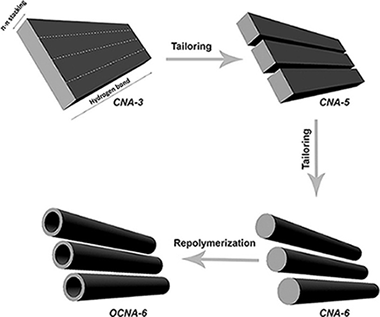
Active and selective structured RuO2/Al2O3 catalysts for CO methanation using a flow simulating CO2-rich reformate gases from WGS and PROX units (H-2 excess, CO2 presence and 300 ppm CO concentration) were prepared. Both, the RuO2/Al2O3 powder and the slurry prepared from it for its structuration by washcoating of the metallic micromonolithic structure, were also active and selective. Both the slurry (S-RuAl) and micro monoliths (M-RuAl) were able to completely and selectively methanate CO at much lower temperatures than the parent RuAI powder. The optimal working temperature in which the CO conversion is maximum and the CO2 conversion is minimized was determined to be from 149 degrees C to 239 degrees C for S-RuAl and from 165 degrees C to 232 degrees C for M-RuAl, whilst it was from 217 degrees C to 226 degrees C for RuAI powder. TPR, XRD and TEM measurements confirmed that the changes in the activity and selectivity for CO methanation among the considered catalysts can be related with modifications in the surface particle size of ruthenium and its reducibility. These were ascribed to the metallic substrate, the presence of PVA and colloidal alumina in the slurry preparation, the aqueous and acidic media and the thermal treatment used, resulting in a more active and selective catalysts than the parent powder.
Nanoporous Pt-based catalysts prepared by chemical dealloying of magnetron-sputtered Pt-Cu thin films for the catalytic combustion of hydrogen
Giarratano, F; Arzac, GM; Godinho, V; Hufschmidt, D; de Haro, MCJ; Montes, O; Fernandez, A
Applied Catalysis B-Environmental, 235 (2018) 168-176 | DOI: 10.1016/j.apcatb.2018.04.064
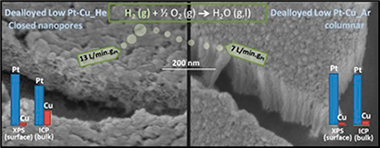
In this work, we prepared SiC-supported Pt-Cu thin films by magnetron sputtering for use as catalysts for the combustion of hydrogen under oxidizing conditions. We tested the catalysts as prepared and after chemical dealloying. A methodology is presented to fabricate catalytic thin films of a desired composition with tailored magnetron targets with lower Pt consumption. The deposition gas was changed to prepare columnar (Ar-deposited) and closed-porous (He-deposited) films to study the effect of the microstructure on the activity. The effect of composition was also studied for the columnar samples. The as-prepared Pt-Cu thin films showed significant activity only at temperatures higher than 100 °C. Dealloying permitted an increase in the activity to achieve near room-temperature activity. The dealloyed closed-porous He-deposited sample was the most active, being able to convert as much as 13.15 LH2·min−1 gPt−1 at 70 °C (Ea = 1 kJ mol−1). This sample was preferentially dealloyed on the surface, yielding an almost pure Pt shell (96% at. Pt) and a Cu-depleted interior (71% at. Pt). This compositional inhomogeneity enabled the sample to achieve enhanced activity compared to the Ar-deposited columnar sample (with similar initial composition, but uniformly dealloyed), probably due to the compressive surface lattice strain. The dealloyed closed-porous He-deposited sample was shown to be durable over five cycles.
Chemical CO2 recycling via dry and bi reforming of methane using Ni-Sn/Al2O3 and Ni-Sn/CeO2-Al2O3 catalysts
Stroud, T; Smith, TJ; Le Sache, E; Santos, JL; Centeno, MA; Arellano-Garcia, H; Odriozola, JA; Reina, TR
Applied Catalysis B-Environmental, 224 (2018) 125-135 | DOI: 10.1016/j.apcatb.2017.10.047
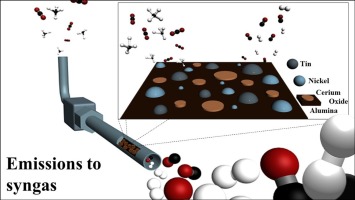
Carbon formation and sintering remain the main culprits regarding catalyst deactivation in the dry and bi-reforming of methane reactions (DRM and BRM, respectively). Nickel based catalysts (10 wt.%) supported on alumina (Al2O3) have shown no exception in this study, but can be improved by the addition of tin and ceria. The effect of two different Sn loadings on this base have been examined for the DRM reaction over 20 h, before selecting the most appropriate Sn/Ni ratio and promoting the alumina base with 20 wt.% of CeO2. This catalyst then underwent activity measurements over a range of temperatures and space velocities, before undergoing experimentation in BRM. It not only showed good levels of conversions for DRM, but exhibited stable conversions towards BRM, reaching an equilibrium H-2/CO product ratio in the process. In fact, this work reveals how multicomponent Ni catalysts can be effectively utilised to produce flexible syngas streams from CO2/CH4 mixtures as an efficient route for CO2 utilisation.
Solar pilot plant scale hydrogen generation by irradiation of Cu/TiO2 composites in presence of sacrificial electron donors
Maldonado, MI; Lopez-Martin, A; Colon, G; Peral, J; Martinez-Costa, JI; Malato, S
Applied Catalysis B-Environmental, 229 (2018) 15-23 | DOI: 10.1016/j.apcatb.2018.02.005
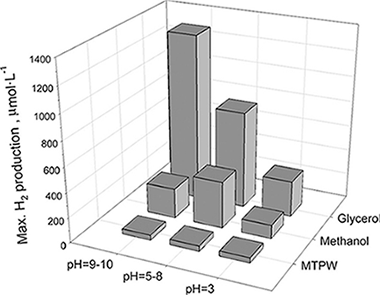
A Cu/TiO2 photocatalyst has been synthesised by reducing a Cu precursor with NaBH4 onto the surface of a sulphate pretreated TiO2 obtained by a sol-gel procedure. The catalyst, that shows a clearly defined anatase phase with high crystallinity and relatively high surface area, and contains Cu2O and CuO deposits on its surface, has been used to produce hydrogen in a solar driven pilot plant scale photocatalytic reactor. Different electron donor aqueous solutions (methanol, glycerol, and a real municipal wastewater treatment plant influent) have been tested showing similar or even higher energy efficiency than those obtained using more expensive noble metal based photocatalytic systems. The glycerol solutions have provided the best reactive environments for hydrogen generation.
A direct in situ observation of water-enhanced proton conductivity of Eu-doped ZrO2: Effect on WGS reaction
Garcia-Moncada, N; Bobadilla, LF; Poyato, R; Lopez-Cartes, C; Romero-Sarria, F; Centeno, MA; Odriozola, JA
Applied Catalysis B-Environmental, 231 (2018) 343-356 | DOI: 10.1016/j.apcatb.2018.03.001
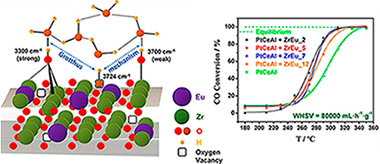
Eu-doped ZrO2 solid solutions have been synthesized in order to prepare proton conductors as water-enhancer additives for the WGS reaction. Elemental characterization has been carried out revealing homogeneous dopant distribution resulting in fluorite-type solid solutions for Eu2O3 contents up to similar to 9 mol.%. Representative samples of the Eu-doped ZrO2 series have been analysed by Impedance Spectroscopy (IS) in inert, oxygen and wet conditions. The solid solution with 5 mol.% of Eu2O3 has presented the highest conductivity values for all tested conditions indicating an optimal amount of dopant. Moreover, the presence of vapour pressure results in an increment of the conductivity at temperatures lower than 300 degrees C, meanwhile at higher temperatures the conductivity is the same than that in inert conditions. To elucidate these results, in situ DRIFTS studies were carried out. These experiments evidenced the existence of water dissociation at oxygen vacancies (band at 3724 cm(-1)) as well as the presence of physisorbed water at temperatures up to similar to 300 degrees C where the band at 5248 cm(-1) characteristic of these species disappeared. These results points to a layer model where the physisorbed water interacts with surface hydroxyls generated by dissociated water that improves the proton conductivity through Grotthuss' mechanism in the RT-300 degrees C temperature range. These samples were successfully tested in WGS reaction as additive to a typical Pt-based catalyst. The presence of the mixed oxide reveals an increase of the catalyst' activity assisted by the proton conductor, since improves the water activation step.
New concept for old reaction: Novel WGS catalyst design
Garcia-Moncada, N; Gonzalez-Castano, M; Ivanova, S; Centeno, MA; Romero-Sarria, F; Odriozola, JA
Applied Catalysis B-Environmental, 238 (2018) 1-5 | DOI: 10.1016/j.apcatb.2018.06.068
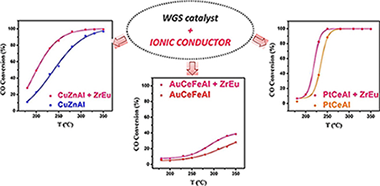
The viability of water gas shift catalytic system for mobile application passes through obligatory reactor volume reduction, achieved normally by using less charge of more efficient catalyst. Completely new concept for catalyst design is proposed: a catalytic system including classically reported WGS catalysts of different nature or active phase (Cu, Pt or Au) mechanically mixed with an ionic conductor. The influence of the later on catalyst activity is studied and discussed, more precisely its effect on the rate of the reaction-limiting step and catalysts' efficiency. It is demonstrated with this study, that the presence of an ionic conductor in contact with a WGS catalyst is essential for the water supply (dissociation and transport), thereby potentiating the water activation step, whatever the mechanism and catalyst overall performance.
CO/H-2 adsorption on a Ru/Al2O3 model catalyst for Fischer Trospch: Effect of water concentration on the surface species
Jimenez-Barrera, E; Bazin, P; Lopez-Cartes, C; Romero-Sarria, F; Daturi, M; Odriozola, JA
Applied Catalysis B-Environmental, 237 (2018) 986-995 | DOI: 10.1016/j.apcatb.2018.06.053
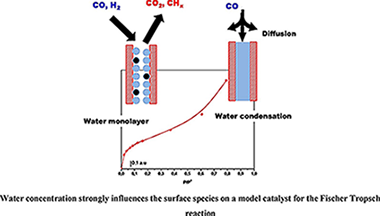
Water presence and concentration strongly influence CO conversion and CS+ selectivity in the Fischer Tropsch reaction. In this work, the influence of the water concentration was investigated using a model Ru/Al2O3 (5 wt. %) catalyst. The surface species formed after CO and H-2 adsorption in dry and wet (different water concentrations) conditions were analyzed by FTIR. Firstly, water adsorption was carried out up to complete filling of the pores and then CO was put in contact with the catalyst. The absence of adsorbed CO species in these conditions evidences that CO diffusion in water controls the access of the gas to the active sites and explains the negative effect of high water concentrations reported by some authors. Moreover, the adsorption of a mixture of CO + H-2 + H2O, being the water concentration close to that needed to have a monolayer, and a dry mixture of CO + H-2 were carried out and compared. Results evidence that water in this low concentration, is able to gasify the surface carbon species formed by CO dissociation on the metallic sites. This cleaning effect is related to the positive effect of water on CO conversion detected by some authors.
Tailoring structured WGS catalysts: Impact of multilayered concept on the water surface interactions
Gonzalez-Castano, M; Le Sache, E; Ivanova, S; Romero-Sarria, F; Centeno, MA; Odriozola, JA
Applied Catalysis B-Environmental, 222 (2018) 124-132 | DOI: 10.1016/j.apcatb.2017.10.018
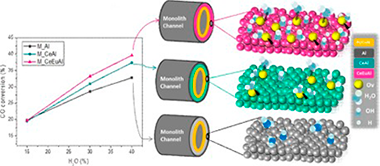
A novel multilayer approach for designing structured WGS catalyst is employed in this study as a response to the lack of new strategies in the literature. The approach proposes the use of two successive layers with different functionalities on metallic micromonolith substrate. The WGS catalyst behavior is modulated by the nature of the inner layer which determines the active species surface population by acting on the water activation step. The catalytic promotion attained by introducing inner ceria containing solids with increasing number of oxygen defects is intensely analyzed through FT-IR and H2O-TPD. Several evidences about the participation of the oxygen vacancies, as key sites, for water absorption processes are established. Besides, remarkable relationships between the water absorption strengths and the water splitting processes within their influence on the catalyst performance are also discussed.
Phase-Contact Engineering in Mono- and Bimetallic Cu-Ni Co-catalysts for Hydrogen Photocatalytic Materials
Munoz-Batista, MJ; Meira, DM; Colon, G; Kubacka, A; Fernandez-Garcia, M
Angewandte Chemie-International Edition, 57 (2018) 1199-1203 | DOI: 10.1002/anie.201709552
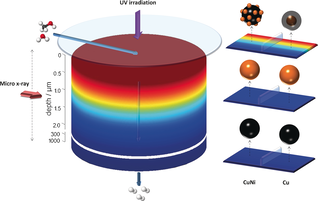
Understanding how a photocatalyst modulates its oxidation state, size, and structure during a photocatalytic reaction under operando conditions is strongly limited by the mismatch between (catalyst) volume sampled by light and, to date, the physicochemical techniques and probes employed to study them. A synchrotron micro-beam X-ray absorption spectroscopy study together with the computational simulation and analysis (at the X-ray cell) of the light-matter interaction occurring in powdered TiO2-based monometallic Cu, Ni and bimetallic CuNi catalysts for hydrogen production from renewables was carried out. The combined information unveils an unexpected key catalytic role involving the phase contact between the reduced and oxidized non-noble metal phases in all catalysts and, additionally, reveals the source of the synergistic Cu-Ni interaction in the bimetallic material. The experimental method is applicable to operando studies of a wide variety of photocatalytic materials.
Understanding the Role of the Acid Sites in 5-Hydroxymethylfurfural Oxidation to 2,5-Furandicarboxylic Acid Reaction over Gold Catalysts: Surface Investigation on CexZr1-xO2 Compounds
Megias-Sayago, C; Chakarova, K; Penkova, A; Lolli, A; Ivanova, S; Albonetti, S; Cavani, F; Odriozola, JA
ACS Catalysis, 8 (2018) 11154-11164 | DOI: 10.1021/acscatal.8b02522 DEC 2018
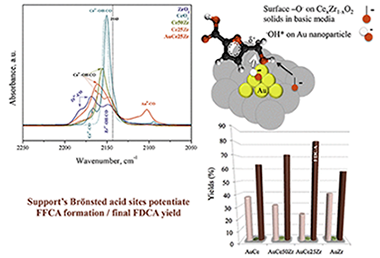
A series of CexZr1-xO2 supports with different Ce/Zr molar ratios were utilized for the preparation of gold catalyst used in the selective oxidation of 5-hydroxymethyl-2-furfural to 2,5-furandicarboxylic acid. The used method of gold deposition allows the preparation of gold particles with homogeneous size and shape distribution, a formulation very useful for studies dedicated to revealing the support participation in the reaction. The supports are characterized by Fourier transform infrared spectroscopy using CO as probe molecule, and the sample catalytic activity is thereafter correlated to the support acid site distribution. The possible participation of its Lewis/Bronsted acidity in the reaction mechanism is also proposed.
Unravelling the Role of Oxygen Vacancies in the Mechanism of the Reverse Water-Gas Shift Reaction by Operando DRIFTS and Ultraviolet-Visible Spectroscopy
Bobadilla, LF; Santos, JL; Ivanova, S; Odriozola, JA; Urakawa, A
ACS Catalysis, 8 (2018) 7455-7467 | DOI: 10.1021/acscatal.8b02121
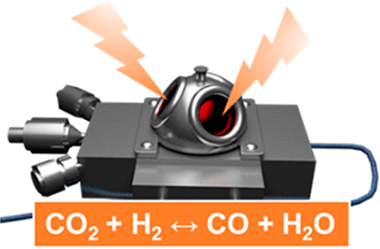
The reaction mechanism of the reverse water gas shift (RWGS) reaction was investigated using two commercial gold-based catalysts supported on Al2O3 and TiO2. The surface species formed during the reaction and reaction mechanisms were elucidated by transient and steady-state operando DRIFTS studies. It was revealed that RWGS reaction over Au/Al2O3 proceeds through the formation of formate intermediates that are reduced to CO. In the case of the Au/TiO2 catalyst, the reaction goes through a redox mechanism with the suggested formation of hydroxycarbonyl intermediates, which further decompose to CO and water. The Ti-3+ species, the surface hydroxyls, and oxygen vacancies jointly participate. The absence of carbonyl species adsorbed on gold particles during the reaction for both catalysts indicates that the reaction pathway involving dissociative adsorption of CO2 on Au particles can be discarded. To complete the study, operando ultraviolet visible spectroscopy was successfully applied to confirm the presence of Ti3+ and to understand the role of the oxygen vacancies of TiO2 support in activating CO2 and thus the subsequent RWGS reaction.
Phase-pure BiFeO3 produced by reaction flash-sintering of Bi2O3 and Fe2O3
Gil-Gonzalez, E; Perejon, A; Sanchez-Jimenez, PE; Sayagues, MJ; Raj, R; Perez-Maqueda, LA
Journal of Materials Chemistry A, 6 (2018) 5356-5366 | DOI: 10.1039/c7ta09239c
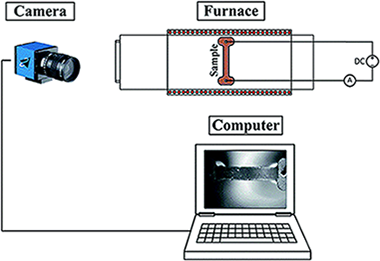
Mixed powders of Bi2O3 and Fe2O3 are shown to yield single-phase, dense nanostructured polycrystals of BiFeO3 in reaction flash sintering experiments, carried out by applying a field of 50 V cm(-1) and with the current limit set to 35 mA mm(-2). The furnace was heated at a constant rate with the reaction sintering taking place abruptly upon reaching 625 degrees C. Remarkably, an intermediate bismuth-rich phase of the oxide that forms just before reaching the flash temperature transforms, and at the same time sinters, into singlephase BiFeO3 within a few seconds after the onset of the flash. The BiFeO3 so produced is electrically insulating, a property that is critical to its applications. This one-step synthesis of single-phase polycrystals of complex oxides from their basic constituents, by reaction flash sintering, is a significant development in the processing of complex oxides, which are normally difficult to sinter by conventional methods.
Pt/CePO4 catalysts for the WGS reaction: influence of the water-supplier role of the support on the catalytic performance
Navarro-Jaen, S; Centeno, MA; Laguna, OH; Odriozola, JA
Journal of Materials Chemistry A, 6 (2018) 17001-17010 | DOI: 10.1039/c8ta04603d
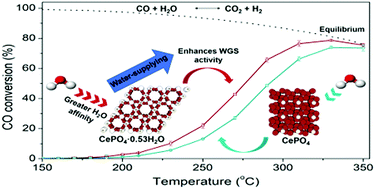
For Pt catalysts which have demonstrated great activity for the WGS reaction, the activation of water is described as the rate-limiting step. Such limitation could be overcome through the design of supports able to supply water. In this study, the hexagonal and monoclinic phases of CePO4 have been evaluated as supports for Pt WGS catalysts. The hexagonal structure presents channels containing water, absent in the monoclinic structure. The presence of these channels in the hexagonal phase increases the interaction with the water molecules, leading to an enhancement of the WGS catalytic performance. DRIFTS results showed that dissociation of water does not occur on these supports, while calculated apparent activation energies present values similar to those reported in the literature for the dissociation of water in Pt (111). These results suggest that cerium phosphates act as water suppliers, increasing the number of available species to be dissociated on the Pt surface.
Self-Assembly of the Nonplanar Fe(III) Phthalocyanine Small-Molecule: Unraveling the Impact on the Magnetic Properties of Organic Nanowires
Filippin, AN; Lopez-Flores, V; Rojas, TC; Saghi, Z; Rico, VJ; Sanchez-Valencia, JR; Espinos, JP; Zitolo, A; Viret, M; Midgley, PA; Barranco, A; Borras, A
Chemistry of Materials, 30 (2018) 879-887 | DOI: 10.1021/acs.chemmater.7b04515
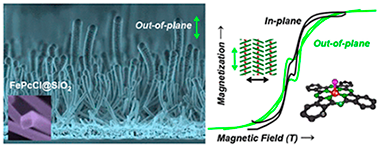
In this article we show for the first time the formation of magnetic supported organic nanowires (ONWs) driven by self-assembly of a nonplanar Fe(III) phthalocyanine chloride (FePcCl) molecule. The ONWs grow by a crystallization mechanism on roughness-tailored substrates. The growth methodology consists of a vapor deposition under low vacuum and mild temperature conditions. The structure, microstructure, and chemical composition of the FePcCl NWs are thoroughly elucidated and compared with those of Fe(II) phthalocyanine NWs by a consistent and complementary combination of advanced electron microscopies and X-ray spectroscopies. In a further step, we vertically align the NWs by conformal deposition of a SiO2 shell. Such orientation is critical to analyze the magnetic properties of the FePcCl and FePc supported NWs. A ferromagnetic behavior below 30 K with an easy axis perpendicular to the phthalocyanine plane was observed in the two cases with the FePcCl nanowires presenting a wider hysteresis. These results open the path to the fabrication of nanostructured one-dimensional small-molecule spintronic devices.
Epimerization of glucose over ionic liquid/phosphomolybdate hybrids: structure-activity relationship
Megias-Sayago, C; Alvarez, E; Ivanova, S; Odriozola, JA
Green Chemistry, 20 (2018) 1042-1049 | DOI: 10.1039/c7gc03738d
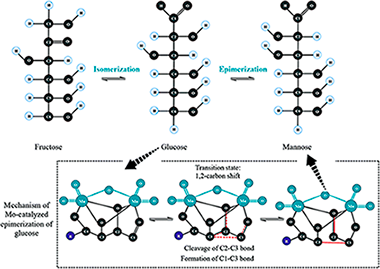
The influence of the crystal structure and chemical nature of some ionic liquid/phosphomolybdate hybrids on their catalytic activity in the epimerization of glucose was studied. A clear evidence of structure-activity relationship was found. The inorganic part of the hybrid ensured the availability of active sites for the reaction, while the organic cation part organized the structure and controled the diffusion of the reactants. This study can be used as a first approach to predict the symmetry, long range order and availability of active sites in the presented class of imidazolium based polyoxometalate hybrids.
Plant cuticle under global change: Biophysical implications
Heredia-Guerrero, JA; Guzman-Puyol, S; Benitez, JJ; Athanassiou, A; Heredia, A; Dominguez, E
Global Change Biology, 24 (2018) 2749-2751 | DOI: 10.1111/gcb.14276
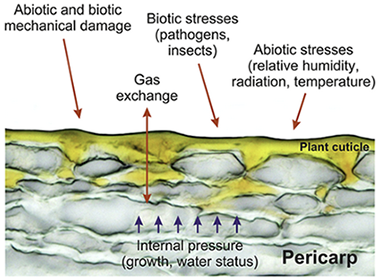
Climatic stressors due to global change induce important modifications to the chemical composition of plant cuticles and their biophysical properties.
In particular, plant cuticles can become heavier, stiffer and more inert, improving plant protection.
The climatic stressors that modify the chemical composition of plant tissues have been recently reviewed by Suseela and Tharayil (2018). In particular, the authors stated that the response of plants to global change effects (viz. increasing temperatures and frequent drought periods) can induce important modifications in plant cuticles such as an increase of the main cuticle components (cutin and polysaccharides), a preponderance of cutan, heavier wax loads, and changes in the chemical composition of waxes, mainly the accumulation of longer aliphatic compounds. In this letter, we would like to emphasize the biophysical consequences that this new scenario involves and how it would affect plant performance.
Highly Efficient and Environmentally Stable Flexible Color Converters Based on Confined CH3NH3PbBr3 Nanocrystals
Rubino, A; Anaya, M; Galisteo-Lopez, JF; Rojas, TC; Calvo, ME; Miguez, H
ACS Applied Materials & Interfaces, 10 (2018) 38334-38340 | DOI: 10.1021/acsami.8b11706
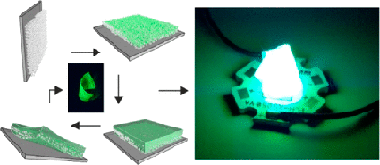
In this work, we demonstrate a synthetic route to attain methylammonium lead bromide (CH3NH3PbBr3) perovskite nanocrystals (nc-MAPbBr(3), 1.5 nm < size < 3 nm) and provide them with functionality as highly efficient flexible, transparent, environmentally stable, and adaptable color converting films. We use nanoparticle metal oxide (MOx) thin films as porous scaffolds of controlled nanopores size distribution to synthesize nc-MAPbBr(3) through the infiltration of perovskite liquid precursors. We find that the control over the reaction volume imposed by the nanoporous scaffold gives rise to a strict control of the nanocrystal size, which allows us to observe well-defined quantum confinement effects on the photo-emission, being the luminescence maximum tunable with precision between lambda = 530 nm (green) and lambda = 490 nm (blue). This hybrid nc-MAPbBr(3)/MOx structure presents high mechanical stability and permits subsequent infiltration with an elastomer to achieve a self-standing flexible film, which not only maintains the photo-emission efficiency of the nc-MAPbBr(3) unaltered but also prevents their environmental degradation. Applications as adaptable color-converting layers for light-emitting devices are envisaged and demonstrated.
Enhancing Moisture and Water Resistance in Perovskite Solar Cells by Encapsulation with Ultrathin Plasma Polymers
Idigoras, J; Aparicio, FJ; Contreras-Bemal, L; Ramos-Terron, S; Alcaire, M; Sanchez-Valencia, JR; Borras, A; Barranco, A; Anta, JA
ACS Applied Materials & Interfaces, 10 (2018) 11587-11594 | DOI: 10.1021/acsami.7b17824
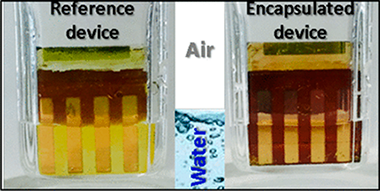
A compromise between high power conversion efficiency and long-term stability of hybrid organic inorganic metal halide perovskite solar cells is necessary for their outdoor photovoltaic application and commercialization. Herein, a method to improve the stability of perovskite solar cells under water and moisture exposure consisting of the encapsulation of the cell with an ultrathin plasma polymer is reported. The deposition of the polymer is carried out at room temperature by the remote plasma vacuum deposition of adamantane powder. This encapsulation method does not affect the photovoltaic performance of the tested devices and is virtually compatible with any device configuration independent of the chemical composition. After 30 days under ambient conditions with a relative humidity (RH) in the range of 35-60%, the absorbance of encapsulated perovskite films remains practically unaltered. The deterioration in the photovoltaic performance of the corresponding encapsulated devices also becomes significantly delayed with respect to devices without encapsulation when vented continuously with very humid air (RH > 85%). More impressively, when encapsulated solar devices were immersed in liquid water, the photovoltaic performance was not affected at least within the first 60 s. In fact, it has been possible to measure the power conversion efficiency of encapsulated devices under operation in water. The proposed method opens up a new promising strategy to develop stable photovoltaic and photocatalytic perovskite devices.
Low-cost Ca-based composites synthesized by biotemplate method for thermochemical energy storage of concentrated solar power
Benitez-Guerrero, M; Valverde, JM; Perejon, A; Sanchez-Jimenez, PE; Perez-Maquecla, LA
Applied Energy, 210 (2018) 108-116 | DOI: 10.1016/j.apenergy.2017.10.109
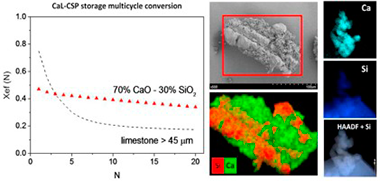
An ever more environmentally conscious society demands the use of green, sustainable and high-efficiency renewable energy resources. However, large-scale energy storage remains a challenge for a deep penetration of power produced from renewables into the grid. The Calcium-Looping (CaL) process, based on the reversible carbonation/calcination of CaO, is a promising technology for thermochemical energy storage (TCES) in Concentrated Solar Power (CSP) plants. Natural limestone to be used as CaO precursor is cheap, non-toxic and abundant. Nevertheless, recent works have shown that carbonation of CaO derived limestone at optimum conditions for TCES is limited by pore-plugging, which leads to severe deactivation for large enough particles to be employed in practice. In our work, we have synthesized inexpensive CaO/SiO2 composites by means of a biotemplate method using rice husk as support. The morphological and compositional features of the biomorphic materials synthesized help improve the CaO multicycle activity under optimum CSP storage conditions and for particles sufficiently large to be managed in practical processes.
Calcium-Looping performance of mechanically modified Al2O3-CaO composites for energy storage and CO2 capture
Benitez-Guerrero, M; Valverde, JM; Sanchez-Jimenez, PE; Perejon, A; Perez-Maqueda, LA
Chemical Engineering Journal, 334 (2018) 2343-2355 | DOI: 10.1016/j.cej.2017.11.183

This work reports the Calcium-Looping (CaL) multicycle performance under energy storage and CO2 capture conditions of different Al-composites prepared by milling mixtures of nanoalumina and natural limestone powders. The micro-and nanostructure of the composites have been analyzed by X-ray diffraction, scanning electron microscopy and high-resolution transmission electron microscopy as affected by the type of CaL conditions employed, either for energy storage in Concentrated Solar Power (CSP) plants or for post-combustion CO2 capture. Two types of calcium aluminates are formed under these diverse CaL conditions. A calcium aluminate with ratio Ca/Al < 1 (Ca4Al6O13) is formed under CaL-CSP conditions, which helps stabilize the CaO microstructure and mitigate pore-plugging. On the other hand, a crystalline phase Ca3Al2O6 is formed (Ca/Al > 1) under CaL-CO2 capture conditions presumably due to the higher calcination temperature, which withdraws from the sorbent a relatively higher amount of active Ca. Moreover, the addition of nano-alumina, and the consequent generation of calcium aluminate, affects in a diverse way the microstructure and morphology of the CaO particles as depending on the CaL application, which critically modifies the performance of the composites.
Effect of milling mechanism on the CO2 capture performance of limestone in the Calcium Looping process
Benitez-Guerrero, M; Valverde, JM; Perejon, A; Sanchez-Jimenez, PE; Perez-Maqueda, LA
Chemical Engineering Journal, 346 (2018) 549-556 | DOI: 10.1016/j.cej.2018.03.146
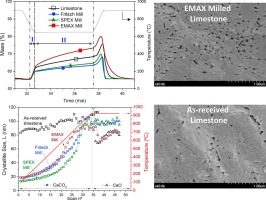
This work analyzes the relevant influence of milling on the CO2 capture performance of CaO derived from natural limestone. Diverse types of milling mechanisms produce contrasting effects on the microstructure of the CaO formed after calcination of the milled limestone samples, which affects crucially the kinetics of carbonation at conditions for CO2 capture. The capture capacity of CaO derived from limestone samples milled using either shear or impact based mills is impaired compared to as-received limestone. After calcination of the milled samples, the resulting CaO porosity is increased while crystallinity is enhanced, which hinders carbonation. Conversely, if the material is simultaneously subjected to intense impact and shear stresses, CaO porosity is promoted whereas CaO cristanillity is reduced, which enhances carbonation in both the reaction and solid-state diffusion controlled regimes.
Iron-Catalyzed Graphitic Carbon Materials from Biomass Resources as Anodes for Lithium-Ion Batteries
Gomez-Martin, A; Martinez-Fernandez, J; Ruttert, M; Heckmann, A; Winter, M; Placke, T; Ramirez-Rico, J
Chemsuschem, 11 (2018) 2776-2787 | DOI: 10.1002/cssc.201800831
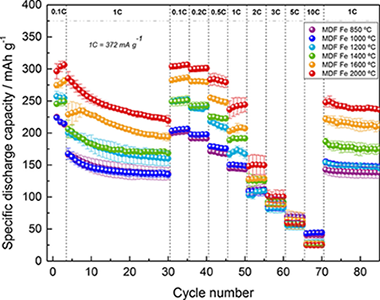
Graphitized carbon materials from biomass resources were successfully synthesized with an iron catalyst, and their electrochemical performance as anode materials for lithium-ion batteries (LIBs) was investigated. Peak pyrolysis temperatures between 850 and 2000 degrees C were covered to study the effect of crystallinity and microstructural parameters on the anodic behavior, with a focus on the first-cycle Coulombic efficiency, reversible specific capacity, and rate performance. In terms of capacity, results at the highest temperatures are comparable to those of commercially used synthetic graphite derived from a petroleum coke precursor at higher temperatures, and up to twice as much as that of uncatalyzed biomass-derived carbons. The opportunity to graphitize low-cost biomass resources at moderate temperatures through this one-step environmentally friendly process, and the positive effects on the specific capacity, make it interesting to develop more sustainable graphite-based anodes for LIBs.
High {0 0 1} faceted TiO2 nanoparticles for the valorization of oxygenated compounds present in aqueous biomass-derived feedstocks
Fernández-Arroyo, A.; Lara, M.A.; Domine, M.E.; Sayagués, M.J.; Navío, J.A.; Hidalgo, M.C.
Journal of Catalysts, 358 (2018) 266-276 | DOI: 10.1016/j.jcat.2017.12.018
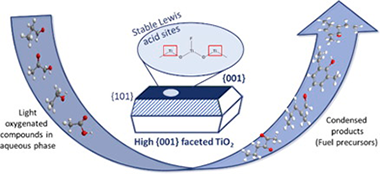
{0 0 1} faceted TiO2 catalysts are hydrothermally synthesized by using titanium(IV) isopropoxide and butoxide precursors (ISO and BUT TiO2samples) together with HF addition. Their activity and stability are evaluated in the catalytic condensation of light oxygenated organic compounds present in an aqueous model mixture simulating a real bio-refinery effluent, under moderate operation conditions. High {0 0 1} faceted TiO2 catalysts show organic products yields superior to those attained with other TiO2 samples (anatase, rutile, and P25). This enhanced catalytic activity relates to their physico-chemical and textural properties, such as high surface area (≈100 m2/g), regular morphology (platelets conformed by partially agglomerated TiO2 nanoparticles), and adequate Lewis acidity. XRD and Raman measurements evidence the unique presence of anatase crystalline phase in both ISO and BUT materials, in which the use of HF during synthesis produces the preferential growth of TiO2 crystals mainly exposing the {0 0 1} plane. This effective {0 0 1} facet exposition directly determines catalytic results. Moreover, TiO2 ISO catalyst shows outstanding stability under reaction conditions, maintaining practically unaltered their activity after several re-uses. In particular, Lewis acid sites present in TiO2 faceted materials are more stable in the presence of organic acids under aqueous environments. This opens new possibilities for the application of these materials in the valorization of light oxygenated compounds present in biomass-derived aqueous effluents.
Origin of Light-Induced Photophysical Effects in Organic Metal Halide Perovskites in the Presence of Oxygen
Anaya, M; Galisteo-Lopez, JF; Calvo, ME; Espinos, JP; Miguez, H
Journal of Physical Chemistry Letters, 9 (2018) 3891-3896 | DOI: 10.1021/acs.jpclett.8b01830
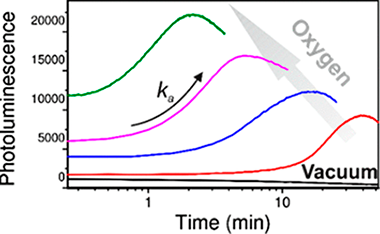
Herein we present a combined study of the evolution of both the photoluminescence (PL) and the surface chemical structure of organic metal halide perovskites as the environmental oxygen pressure rises from ultrahigh vacuum up to a few thousandths of an atmosphere. Analyzing the changes occurring at the semiconductor surface upon photoexcitation under a controlled oxygen atmosphere in an X-ray photoelectron spectroscopy (XPS) chamber, we can rationalize the rich variety of photophysical phenomena observed and provide a plausible explanation for light-induced ion migration, one of the most conspicuous and debated concomitant effects detected during photoexcitation. We find direct evidence of the formation of a superficial layer of negatively charged oxygen species capable of repelling the halide anions away from the surface and toward the bulk. The reported PL transient dynamics, the partial recovery of the initial state when photoexcitation stops, and the eventual degradation after intense exposure times can thus be rationalized.
The Role of Metal Halide Perovskites in Next-Generation Lighting Devices
Lozano, G.
Journal of Physical Chemistry Letters, 9 (2018) 3987-3997 | DOI: 10.1021/acs.jpclett.8b01417
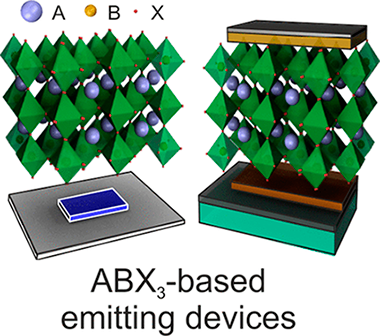
The development of smart illumination sources represents a central challenge for current technology. In this context, the quest for novel materials that enable efficient light generation is essential. Metal halide compounds with perovskite crystalline structure (ABX(3)) have gained tremendous interest in the last five years since they come as easy-to-prepare high performance semiconductors. Perovskite absorbers are driving the power-conversion-efficiencies of thin film photovoltaics to unprecedented values. Nowadays, mixed-cation, mixed-halide lead perovskite solar cells reach efficiencies consistently over 20% and promise to get close to 30% in multijunction devices when combined with silicon cells at no surcharge. Nonetheless, perovskites' fame extends further since extensive research on these novel semiconductors has also revealed their brightest side. Soon after their irruption in the photovoltaic scenario, demonstration of efficient color tunable-with high color purity-perovskite emitters has opened new avenues for light generation applications that are timely to discuss herein.
Absorption and Emission of Light in Optoelectronic Nanomaterials: The Role of the Local Optical Environment
Jimenez-Solano, Alberto; Galisteo-Lopez, Juan F.; Miguez, Hernan
Journal of Physical Chemistry Letters, 9 (2018) 2077-2084 | DOI: 10.1021/acs.jpclett.8b00848
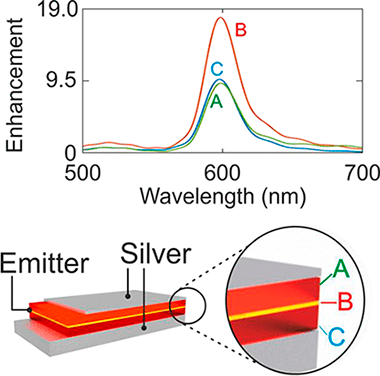
Tailoring the interaction of electromagnetic radiation with matter is central to the development of optoelectronic devices. This becomes particularly relevant for a new generation of devices offering the possibility of solution processing with competitive efficiencies as well as new functionalities. These devices, containing novel materials such as inorganic colloidal quantum dots or hybrid organic-inorganic lead halide perovskites, commonly demand thin (tens of nanometers) active layers in order to perform optimally and thus maximizing the way electromagnetic radiation interacts with these layers is essential. In this Perspective, we discuss the relevance of tailoring the optical environment of the active layer in an optoelectronic device and illustrate it with two real-world systems comprising photovoltaic cells and light emitting devices.
Unexpected Optical Blue Shift in Large Colloidal Quantum Dots by Anionic Migration and Exchange
Acebron, M; Galisteo-Lopez, JF; Lopez, C; Herrera, FC; Mizrahi, M; Requejo, FG; Palomares, FJ; Juarez, BH
Journal of Physical Chemistry Letters, 9 (2018) 3124-3130 | DOI: 10.1021/acs.jpclett.8b00741
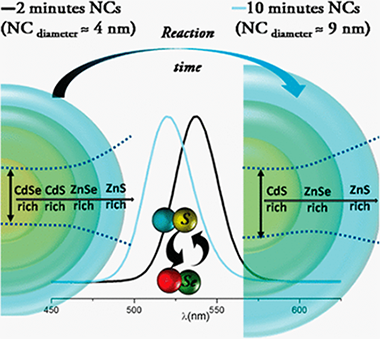
Compositional changes taking place during the synthesis of alloyed CdSeZnS nanocrystals (NCs) allow shifting of the optical features to higher energy as the NCs grow. Under certain synthetic conditions, the effect of those changes on the surface/interface chemistry competes with and dominates over the conventional quantum confinement effect in growing NCs. These changes, identified by means of complementary advanced spectroscopic techniques such as XPS (X-ray photoelectron spectroscopy) and XAS (X-ray absorption spectroscopy), are understood in the frame of an ion migration and exchange mechanism taking place during the synthesis. Control over the synthetic routes during NC growth represents an alternative tool to tune the optical properties of colloidal quantum dots, broadening the versatility of the wet chemical methods.
Dye Giant Absorption and Light Confinement Effects in Porous Bragg Microcavities
Oliva-Ramirez, M; Gil-Rostra, J; Simonsen, AC; Yubero, F; Gonzalez-Elipe, AR
ACS Photonics, 5 (2018) 984-991 | DOI: 10.1021/acsphotonics.7b01283
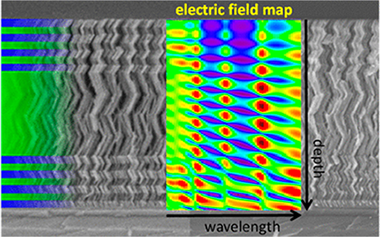
This work presents a simple experimental procedure to probe light confinement effects in photonic structures. Two types of porous 1D Bragg microcavities with two resonant peaks in the reflection gap were prepared by physical vapor deposition at oblique angle configurations and then infiltrated with dye solutions of increasing concentrations. The unusual position shift and intensity drop of the transmitted resonant peak observed when it was scanned through the dye absorption band have been accounted for by the effect of the light trapped at their optical defect layer. An experimentally observed giant absorption of the dye molecules and a strong anomalous dispersion in the refractive index of the solution are claimed as the reasons for the observed variations in the Bragg microcavity resonant feature. Determining the giant absorption of infiltrated dye solutions is proposed as a general and simple methodology to experimentally assess light trapping effects in porous photonic structures.
Flexible and Adaptable Light-Emitting Coatings for Arbitrary Metal Surfaces based on Optical Tamm Mode Coupling
Jiménez-Solano, A.; Galisteo-López, J.; Míguez, H.
Advanced Optical Materials, 6 (2018) 1700560 | DOI: 10.1002/adom.201700560
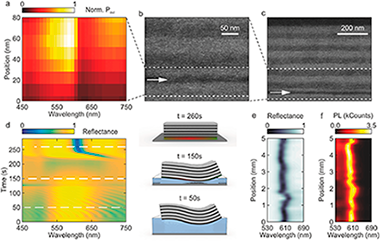
This study demonstrates a design that maximizes the power radiated into free space from a monolayer of nanoemitters embedded in a flexible distributed Bragg reflector conformably attached to a metal surface. This is achieved by positioning the light source at the precise depth within the multilayer for which optical Tamm states provide enhanced quantum yield and outcoupling efficiency, which are combined to optimize the luminous power radiated by the surface of the ensemble. This approach, based on the adhesion of flexible multilayer stacks onto metal surfaces with an arbitrary curvature, is versatile and permits the realization of spectrally narrow monodirectional or self-focusing light-emitting surfaces.
Pressure Effect on the Multicycle Activity of Natural Carbonates and a Ca/Zr Composite for Energy Storage of Concentrated Solar Power
Sarrion, B; Sanchez-Jimenez, PE; Perejon, A; Perez-Maqueda, LA; Valverde, JM
ACS Sustainable Chemistry & Engineering, 6 (2018) 7849-7858 | DOI: 10.1021/acssuschemeng.8b00981
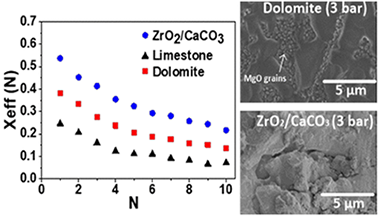
This work is focused on the use of the Calcium-Looping process (CaL) in Concentrated Solar Power (CSP) plants for Thermochemical Energy Storage (TCES). Cheap, abundant and nontoxic natural carbonate minerals, such as limestone and dolomite, can be employed in this application to store energy through the cyclic calcination/carbonation of CaCO3. In a recent work, a closed CO2 cycle has been proposed for an efficient CaL-CSP integration in which the CO2 in excess effluent from the carbonator is used to generate electricity by means of a gas turbine. Process simulations show that the thermoelectric efficiency is enhanced as the carbonator pressure and temperature are increased provided that the multicycle CaO conversion is not affected. On the other hand, the use of just one reactor for both calcination and carbonation has been suggested to reduce capital cost. However, the experimental results shown in the present work indicate that sintering is notably enhanced as the pressure in the reactor is increased. Such an adverse effect is mitigated for a ZrO2/CaCO3 composite with a low Zr content as compared to natural carbonates. These results are relevant to process simulations for better assessing the global efficiency of the CaL-CSP integration.
Sustainable Fabrication of Plant Cuticle-Like Packaging Films from Tomato Pomace Agro-Waste, Beeswax, and Alginate
Tedeschi, G; Benitez, JJ; Ceseracciu, L; Dastmalchi, K; Itin, B; Stark, RE; Heredia, A; Athanassiou, A; Heredia-Guerrero, JA
ACS Sustainable Chemistry & Engineering, 6 (2018) 14955-14966 | DOI: 10.1021/acssuschemeng.8b03450
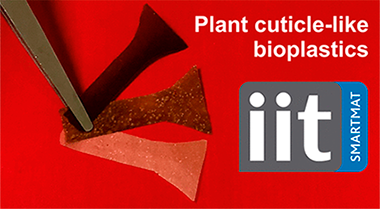
Plant cuticles have been used as models to produce hydrophobic films composed of sodium alginate, the fatty acid fraction of tomato pomace agrowaste, and beeswax. The fabrication process consisted of the blending of components in green solvents (water and ethanol) and a subsequent thermal treatment (150 degrees C, 8 h) to polymerize unsaturated and polyhydroxylated fatty acids from tomato pomace. When sodium alginate and tomato pomace fatty acids were blended, free-standing films were obtained. These films were characterized to evaluate their morphological (SEM), chemical (solid-state NMR, ATR-FTIR), mechanical (tensile tests), thermal (TGA), and hydrodynamic (water contact angle, uptake, and permeability) properties. A comparison between nonpolymerized and polymerized samples was carried out, revealing that the thermal treatment represents a sustainable route to create structured, composite networks of both components. Finally, beeswax was added to the blend with the same amounts of sodium alginate and tomato pomace fatty acids. The presence of the wax improved the hydrophobicity and the mechanical and water barrier properties as well as decreased the water uptake. These results indicate that polymerized plant cuticle-like films have valuable potential for packaging applications.
Carbonation of Limestone Derived CaO for Thermochemical Energy Storage: From Kinetics to Process Integration in Concentrating Solar Plants
Ortiz, C; Valverde, JM; Chacartegui, R; Perez-Maqueda, LA
ACS Sustainable Chemistry & Engineering, 6 (2018) 6404-6417 | DOI: 10.1021/acssuschemeng.8b00199
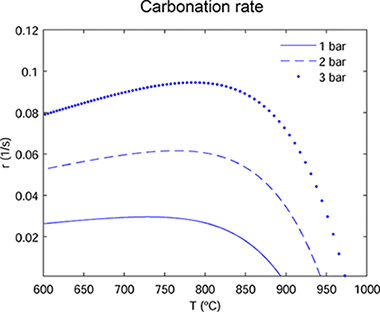
Thermochemical energy storage (TCES) is considered as a promising technology to accomplish high energy storage efficiency in concentrating solar power (CSP) plants. Among the various possibilities, the calcium-looping (CaL) process, based on the reversible calcination–carbonation of CaCO3 stands as a main candidate due to the high energy density achievable and the extremely low price, nontoxicity, and wide availability of natural CaO precursors such as limestone. The CaL process is already widely studied for CO2 capture in fossil fuel power plants or to enhance H2 production from methane reforming. Either one of these applications requires particular reaction conditions to which the sorbent performance (reaction kinetics and multicycle conversion) is extremely sensitive. Therefore, specific models based on the conditions of any particular application are needed. To get a grip on the optimum conditions for the carbonation of limestone derived CaO in the CaL-CSP integration, in the present work is pursued a multidisciplinary approach that combines theoretical modeling on reaction kinetics, lab-scale experimental tests at relevant CaL conditions for TCES, process modeling, and simulations. A new analytic equation to estimate the carbonation reaction rate as a function of CO2 partial pressure and temperature is proposed and validated with experimental data. Using the kinetics analysis, a carbonator model is proposed to assess the average carbonation degree of the solids. After that, the carbonator model is incorporated into an overall process integration scheme to address the optimum operation conditions from thermodynamic and kinetics considerations. Results from process simulations show that the highest efficiencies for the CaL-CSP integration are achieved at carbonator absolute pressures of ∼3.5–4 bar, which leads to an overall plant efficiency (net electric power to net solar thermal power) around 41% when carbonation is carried out at 950 °C under pure CO2
Revealing the substitution mechanism in Eu3+:CaMoO4 and Eu3+,Na+:CaMoO4 phosphors
Becerro, AI; Allix, M; Laguna, M; Gonzalez-Mancebo, D; Genevois, C; Caballero, A; Lozano, G; Nunez, NO; Ocana, M
Journal of Materials Chemistry C, 6 (2018) 47 | DOI: 10.1039/c8tc04595j
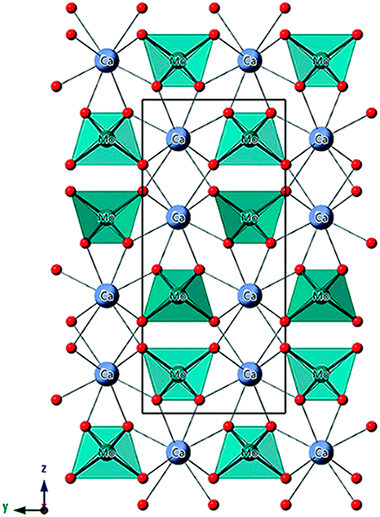
Eu3+-Doped calcium molybdate is an excellent phosphor for lighting and display devices due to the very intense pure red emission after UV excitation. It has been reported in the literature that the CaMoO4 unit cell volume expands after Eu3+ doping, in spite of the smaller Eu3+ ionic radius compared with Ca2+. Likewise, several studies found that the emission intensity of the phosphor could be improved by codoping with alkaline ions like Li+, Na+ or K+. None of these studies correlated the apparent volume expansion and luminescence enhancement with the crystal structural details. This paper analyses the aliovalent substitution mechanism and crystal structure of Eu3+:CaMoO4 and Eu3+,Na+:CaMoO4 phosphors using complementary techniques like Raman spectroscopy, EXAFS and SPD. We found that the substitution mechanism was different for both systems, with Ca site vacancies forming in the Eu3+:CaMoO4 phosphors and leading to Ca1-3xEu2xxMoO4 compositions, while the Eu3+,Na+:CaMoO4 phosphors formed Ca1-2xEuxNaxMoO4. SPD showed that the cell volume expansion observed with increasing Eu3+ content is related to the increase of the Mo-O bond distance due to the higher electronegativity of Eu3+ compared with Ca2+. Finally, it was shown that the luminescence properties, i.e. lifetime values and quantum yields (the latter reported here for the first time), do not depend on the presence of monovalent ions in the crystal structure but, exclusively, on the Eu3+ content of the phosphor. The integral and detailed analysis of the materials presented in this paper, ranging from crystal structure to luminescent properties including elemental composition, allows a full picture of the structure-property relationships that had never been addressed before for CaMoO4-based phopshors.
Copper-containing mesoporous bioactive glass promotes angiogenesis in an in vivo zebrafish model
Romero-Sanchez, LB; Mari-Beffa, M; Carrillo, P; Medina, MA; Diaz-Cuenca, A
Acta Biomaterialia, 68 (2018) 272-285 | DOI: 10.1016/j.actbio.2017.12.032
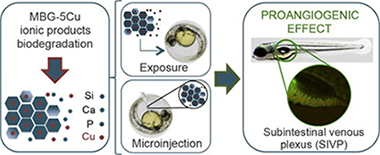
The osteogenic and angiogenic responses of organisms to the ionic products of degradation of bioactive glasses (BGs) are being intensively investigated. The promotion of angiogenesis by copper (Cu) has been known for more than three decades. This element can be incorporated to delivery carriers, such as BGs, and the materials used in biological assays. In this work, Cu-containing mesoporous bioactive glass (MBG) in the SiO2-CaO-P2O5compositional system was prepared incorporating 5% mol Cu (MBG-5Cu) by replacement of the corresponding amount of Ca. The biological effects of the ionic products of MBG biodegradation were evaluated on a well-known endothelial cell line, the bovine aorta endothelial cells (BAEC), as well as in an in vivo zebrafish (Danio rerio) embryo assay. The results suggest that ionic products of both MBG (Cu free) and MBG-5Cu materials promote angiogenesis. In vitro cell cultures show that the ionic dissolution products of these materials are not toxic and promote BAEC viability and migration. In addition, the in vivo assay indicates that both exposition and microinjection of zebrafish embryos with Cu free MBG material increase vessel number and thickness of the subintestinal venous plexus (SIVP), whereas assays using MBG-5Cu enhance this effect.
A comprehensive and in-depth analysis of the synthesis of advanced adsorbent materials
Osuna, FJ; Cota, A; Pavon, E; Alba, MD
Journal of Cleaner Production, 194 (2018) 665-672 | DOI: 10.1016/j.jclepro.2018.05.179

Na-Mica-4, a synthetic fluorophlogopite, is an attractive adsorbent. However, the synthesis at large scale demands an economically prized, feasible scalable and sustainable synthesis method, which requires a deep knowledge of the influence of each synthesis step. A set of Na-Mica-4 were synthesized by methods that had one synthesis parameter as variable. The purity, crystallinity and heteroatoms distribution were analysed thorough X-ray diffraction and nuclear magnetic resonance. The results shed a light on the main factors for the design of the final product and indicated that an environmental friendship synthesis could be possible.
Robust polarization active nanostructured 1D Bragg Microcavities as optofluidic label-free refractive index sensor
Oliva-Ramirez, M; Gil-Rostra, J; Yubero, F; Gonzalez-Elipe, AR
Sensors and Actuators B-Chemical, 256 (2018) 590-599 | DOI: 10.1016/j.snb.2017.10.060
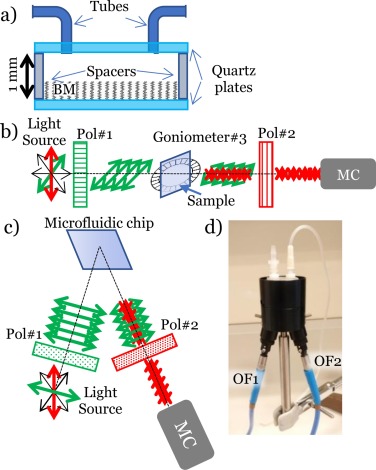
In this work we report the use of polarization active porous 1D Bragg microcavities (BM) prepared by physical vapor deposition at oblique angles for the optofluidic analysis of liquid solutions. These photonic structures consist of a series of stacked highly porous layers of two materials with different refractive indices and high birefringence. Their operational principle implies filling the pores with the analyzed liquid while monitoring with linearly polarized light the associated changes in optical response as a function of the solution refractive index. The response of both polarization active and inactive BMs as optofluidic sensors for the determination of glucose concentration in water solutions has been systematically compared. Different methods of detection, including monitoring the BM wave retarder behavior, are critically compared for both low and high glucose concentrations. Data are taken in transmission and reflection modes and different options explored to prove the incorporation of these nanostructured transducers into microfluidic systems and/or onto the tip of an optical fiber. This analysis has proven the advantages of the polarization active transducer sensors for the optofluidic analysis of liquids and their robustness even in the presence of light source instabilities or misalignments of the optical system used for detection.
On the determination of thermal degradation effects and detection techniques for thermoplastic composites obtained by automatic lamination
Martin, MI; Rodriguez-Lence, F; Guemes, A; Fernandez-Lopez, A; Perez-Maqueda, LA; Perejon, A
Composites part A-Applied science and manufacturing, 111 (2018) 23-32 | DOI: 10.1016/j.compositesa.2018.05.006
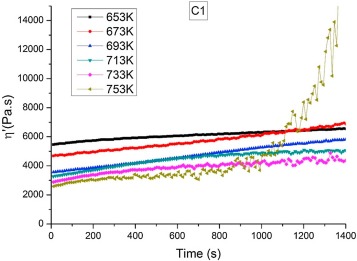
Automatic lay-up and in-situ consolidation with thermoplastic composite materials is a technology under research for its expected use in the profitable manufacturing of structural aeronautical parts. This study is devoted to analysing the possible effects of thermal degradation produced by this manufacturing technique.
Rheological measurements showed that there is negligible degradation in PEEK for the temperatures reached during the process. Thermogravimetric analysis under linear heating and constant rate conditions show that thermal degradation is a complex process with a number of overlapping steps. A general kinetic equation that describes the degradation of the material with temperature has been proposed and validated. Attenuated total reflectance Fourier transform infrared spectroscopy and X-ray photoelectron spectroscopy confirmed that there is no remarkable degradation. The use of a combination of in-situ and ex-situ experimental techniques, including kinetic modelling, not only provides reliable information about degradation but also allows setting optimal processing conditions.
Molten carbonate salts for advanced solar thermal energy power plants: Cover gas effect on fluid thermal stability
Fereres, S; Prieto, C; Gimenez-Gavarrell, P; Rodriguez, A; Sanchez-Jimenez, PE; Perez-Maqueda, LA
Solar Energy Materials and Solar Cells, 188 (2018) 119-126 | DOI: 10.1016/j.solmat.2018.08.028
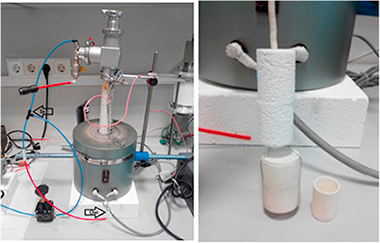
The eutectic mixture Li2CO3-Na2CO3-K2CO3 is investigated as a high temperature heat transfer fluid and storage medium alternative for molten salt solar thermal power plants. This salt has an operating temperature range of 400–700 °C, enabling the use of higher temperature/efficiency power cycles. However, this carbonate mixture is known to thermally decompose in air. This study evaluates the thermal stability of the salt mixture under different cover gases: air, nitrogen, carbon dioxide, and an 80/20 carbon dioxide/air mixture. Initial characterization is performed through thermogravimetric analysis (TGA), followed by larger scale testing in a custom-made reactor to simulate conditions closer to its practical use. The results show improved thermal stability with a CO2 atmosphere. The decomposition kinetics under different cover gases are estimated from TGA data. However, larger-scale, longer duration experiments show much slower decomposition rates compared to the classical TGA approach. These findings indicate that the main contribution to mass loss in TGA is due to vaporization rather than thermal decomposition. Thus, a proper evaluation of the molten salt´s thermal stability can only be obtained from reactor experiments where vaporization is inhibited. Very long induction periods (of the order of days) are observed, suggesting that the kinetic decomposition mechanism is a nucleation and growth type. Other considerations for future plants incorporating these high temperature salts are discussed.
Development of a novel TiNbTa material potentially suitable for bone replacement implants
Chicardi, E; Gutierrez-Gonzalez, CF; Sayagues, MJ; Garcia-Garrido, C
Materials & Design, 145 (2018) 88-96 | DOI: 10.1016/j.matdes.2018.02.042
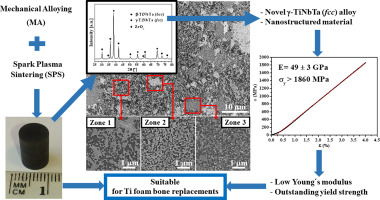
A novel (beta + gamma)-TiNbTa alloy has been developed by a combined low energy mechanical alloying (LEMA) and pulsed electric current sintering process (PECS). Microstructurally, this material presents interesting characteristics, such as a submicrometric range of particle size, a body-centered phase (beta-TiNbTa) and, mainly, a novel face-centered cubic Ti-based alloy (gamma-TiNbTa) not previously reported. Related to mechanical performance, the novel (beta + gamma)-TiNbTa shows a lower E (49 +/- 3 GPa) and an outstanding yield strength (sigma(y) 1860 MPa). This combination of original microstructure and properties makes to the (beta + gamma)-TiNbTa a novel material potentially suitable as biomaterial to fabricate bone replacement implants, avoiding the undesirable and detrimental stressshielding problem and even the usual damage on the mechanical strength of Ti-based foams biomaterials.
Role of calcium looping conditions on the performance of natural and synthetic Ca-based materials for energy storage
Sarrion, B; Perejon, A; Sanchez-Jimenez, PE; Perez-Maqueda, LA; Valverde, JM
Journal of CO2 utilization, 28 (2018) 374-384 | DOI: 10.1016/j.jcou.2018.10.018
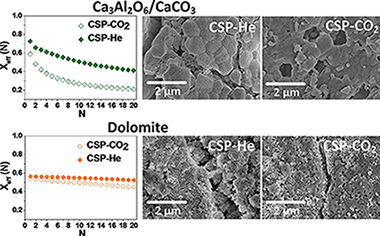
In this work, the multicycle activity of natural CaO precursors (limestone and dolomite) and Ca-based composites (Ca3Al2O6/CaCO3 and ZrO2/CaCO3 mixtures) has been studied for Thermochemical Energy Storage (TCES) in Concentrated Solar Power (CSP) plants by means of the Calcium-Looping process (CaL), using two integration schemes proposed elsewhere that differ in the calcination stages. Under CSP-He conditions, calcination for CaO regeneration is performed under pure He at low temperatures (725 degrees C) while under CPS-CO2 conditions calcination is carried out under pure CO2 at high temperatures (950 degrees C). The latter avoids the use of selective membranes to separate He from CO2 even though it requires the use of more expensive materials for solar receptors. Carbonation/calcination conditions drastically affect the multicycle CO2 uptake of the materials tested. Effective multicycle conversion is higher in CSP-He tests due to the mild conditions employed for calcination, which mitigates CaO sintering. On the other hand, the harsh calcination conditions used in CSP-CO2 tests enhance sintering of CaO derived from limestone and the Ca3Al2O6/CaCO3 composite due to the low Tammann temperature of Ca3Al2O6. CaO sintering is hindered by the presence of inert oxides with high Tammann temperatures, such as ZrO2 in the ZrO2/CaCO3 composite and MgO in dolomite. Dolomite derived CaO shows high effective conversion values along the carbonation/calcination cycles when tested under both types of conditions, as compared to limestone and the composites, which suggests that the integration scheme based on CSP-CO2 conditions would be a feasible alternative to CSP-He if natural dolomite were used as CaO precursor.
CO2 reforming of methane over Ni-Ru supported catalysts: On the nature of active sites by operando DRIFTS study
Alvarez, A; Bobadilla, LF; Garcilaso, V; Centeno, MA; Odriozola, JA
Journal of CO2 utilization, 24 (2018) 509-515 | DOI: 10.1016/j.jcou.2018.01.027
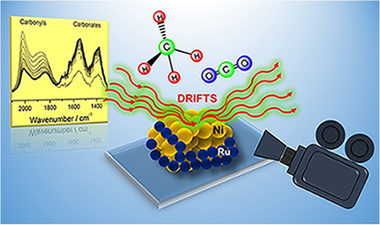
The present paper addresses the nature of the active sites of a bimetallic Ni-Ru supported catalyst on the dry reforming of methane (DRM). The structural characterization by XRD and Raman spectroscopy, along with the reducibility study (TPR-H-2) of the samples, evidenced the existence of a strong Ni-Ru interaction in the bimetallic system. We have assumed that Ru atoms block the most reactive Ni sites (step-edge sites) leaving less reactive centers for methane activation (terraces). In this way, operando DRIFTS measurements revealed that Ru decreases the catalytic activity but favors the carbon gasification and prevents the CO dissociation.
Laterally and Temporally Controlled Intracellular Staining by Light-Triggered Release of Encapsulated Fluorescent Markers
Kantner, K; Rejman, J; Kraft, KVL; Soliman, MG; Zyuzin, MV; Escudero, A; del Pino, P; Parak, WJ
Chemistry-A European Journal, 24 (2018) 2098-2102 | DOI: 10.1002/chem.201706135
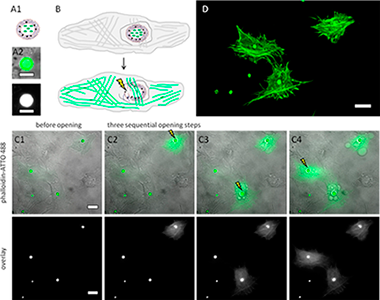
Fluorescent molecular markers were encapsulated. The capsules were additionally modified with plasmonic nanoparticles. The encapsulated markers were endocytosed by cells. Upon light stimulation the plasmonic nanoparticles generated heat, which opened the encapsulation and transiently perforated the endosomal/lysosomal membrane surrounding the capsule, thus allowing for release of the marker into the cytosol. Fluorescence labeling of different intracellular compartments was demonstrated in this way. Most important, the cells do not need to be fixed and perforated, as the molecular markers are introduced into cells by endocytosis and subsequent light-induced release. Thus this technique allows for intracellular fluorescence labeling of living cells.
Tribological properties of TiC/a-C:H nanocomposite coatings prepared via HiPIMS
Sanchez-Lopez, JC; Dominguez-Meister, S; Rojas, TC; Colasuonno, M; Bazzan, M; Patelli, A
Applied Surface Science, 440 (2018) 458-466 | DOI: 10.1016/j.apsusc.2018.01.135
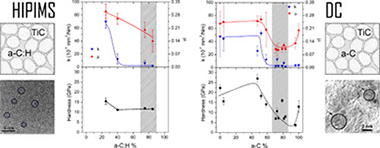
High power impulse magnetron sputtering (HiPIMS) technology has been employed to prepare TiC/a-C:H nanocomposite coatings from a titanium target in acetylene (C2H2) reactive atmospheres. Gas fluxes were varied from 1.3 to 4.4 sccm to obtain C/Ti ratios from 2 to 15 as measured by electron probe microanalysis (EPMA). X-ray diffraction and transmission electron microscopy demonstrate the presence of TiC nanocrystals embedded in an amorphous carbon-based matrix. The hardness properties decrease from 17 to 10 GPa as the carbon content increases. The tribological properties were measured using a pinon-disk tribometer in ambient air (RH = 30-40%) at 10 cm/s with 5 N of applied load against 6-mm 100Cr6 balls. The friction coefficient and the film wear rates are gradually improved from 0.3 and 7 x 10(-6) mm(3)/N m to 0.15 and 2 x 10(-7) mm(3)/N m, respectively, by increasing the C2H2 flux. To understand the tribological processes appearing at the interface and to elucidate the wear mechanism, microstructural and chemical investigations of the coatings were performed before and after the friction test. EPMA, X-ray photoelectron and electron energy-loss spectroscopies were employed to obtain an estimation of the fraction of the a-C:H phase, which can be correlated with the tribological behavior. Examination of the friction counterfaces (ball and track) by Raman microanalysis reveals an increased ordering of the amorphous carbon phase concomitant with friction reduction. The tribological results were compared with similar TiC/a-C(:H) composites prepared by the conventional direct current process.
Diverse Applications of Nanomedicine
Pelaz, Beatriz; Alexiou, Christoph; Alvarez -Puebla, Ramon A.; Alves, Frauke; Andrews, Anne M.; Ashraf, Sumaira; Balogh, Lajos P.; Ballerini, Laura; Bestetti, Alessandra; Brendel, Cornelia; Bosi, Susanna; Carril, Monica; Chan, Warren C. W.; Chen, Chunying
ACS Nano, 11 (2017) 2312-2381 | DOI: 10.1021/acsnano.6b06040
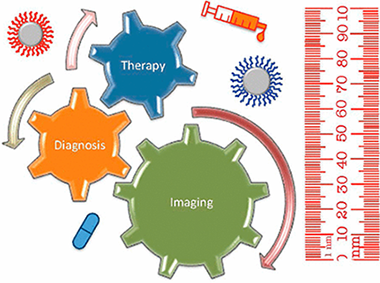
The design and use of materials in the nanoscale size range for addressing medical and health-related issues continues to receive increasing interest. Research in nanomedicine spans a multitude of areas, including drug delivery, vaccine development, antibacterial, diagnosis and imaging tools, wearable devices, implants, high-throughput screening platforms, etc. using biological, nonbiological, biomimetic, or hybrid materials. Many of these developments are starting to be translated into viable clinical products. Here, we provide an overview of recent developments in nanomedicine and highlight the current challenges and upcoming opportunities for the field and translation to the clinic.
Lead-Free Polycrystalline Ferroelectric Nanowires with Enhanced Curie Temperature
Datta, Anuja; Sanchez-Jimenez, Pedro E.; Al Orabi, Rabih Al Rahal; Calahorra, Yonatan; Ou, Canlin; Sahonta, Suman-Lata; Fornari, Marco; Kar-Narayan, Sohini
Advanced Functional Materials, 27 (2017) 1701169 | DOI: 10.1002/adfm.201701169
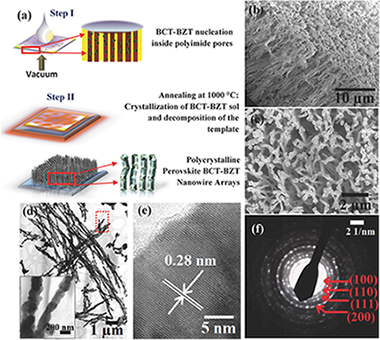
Ferroelectrics are important technological materials with wide-ranging applications in electronics, communication, health, and energy. While lead-based ferroelectrics have remained the predominant mainstay of industry for decades, environmentally friendly lead-free alternatives are limited due to relatively low Curie temperatures (T-C) and/or high cost in many cases. Efforts have been made to enhance T-C through strain engineering, often involving energy-intensive and expensive fabrication of thin epitaxial films on lattice-mismatched substrates. Here, a relatively simple and scalable sol-gel synthesis route to fabricate polycrystalline (Ba0.85Ca0.15)(Zr0.1Ti0.9)O-3 nanowires within porous templates is presented, with an observed enhancement of T-C up to similar to 300 degrees C as compared to similar to 90 degrees C in the bulk. By combining experiments and theoretical calculations, this effect is attributed to the volume reduction in the template-grown nanowires that modifies the balance between different structural instabilities. The results offer a cost-effective solution-based approach for strain-tuning in a promising lead-free ferroelectric system, thus widening their current applicability.
1-dimensional TiO2 nano-forests as photoanodes for efficient and stable perovskite solar cells fabrication
Salado, M; Oliva-Ramirez, M; Kazim, S; Gonzalez-Elipe, AR; Ahmad, S
Nano Energy, 35 (2017) 215-222 | DOI: 10.1016/j.nanoen.2017.03.034
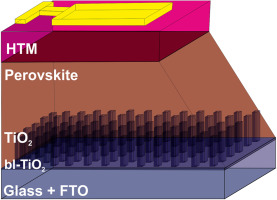
During the last years, perovskite solar cells have gained increasing interest among the photovoltaic community, in particularly after reaching performances at par with mature thin film based PV. This rapid evolution has been fostered by the compositional engineering of perovskite and new device architectures. In the present work, we report the fabrication of perovskite solar cells based on highly ordered 1-dimensional vertically oriented TiO2 nano-forests. These vertically oriented porous TiO2 photoanodes were deposited by physical vapor deposition in an oblique angle configuration, a method which is scalable to fabricate large area devices. Mixed (MA0.15FA0.85)Pb(I0.85Br0.15)3 or triple cation Cs0.05(MA0.15FA0.85)0.95Pb(I0.85Br0.15)3 based perovskites were then infiltrated into these 1-dimensional nanostructures and power conversion efficiencies of 16.8% along with improved stability was obtained. The devices fabricated using 1D-TiO2 were found to be more stable compare to the classical 3-dimensional TiO2 photoanodes prepared by wet chemistry. These 1-D photoanodes will be of interest for scaling up the technology and in other opto-electrical devices as they can be easily fabricated utilizing industrially adapted methodologies.
Biomorphic ceramics from wood-derived precursors
Ramirez-Rico, J.; Martinez-Fernandez, J.; Singh, M.
International Materials Reviews, 62 (2017) Issue 8 | DOI: 10.1080/09506608.2017.1354429
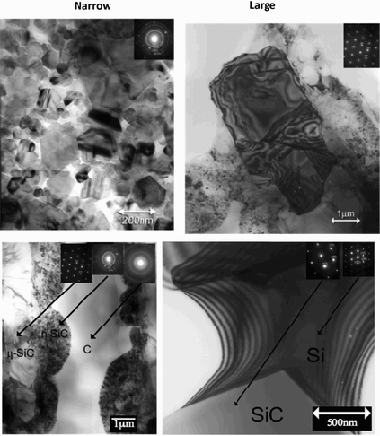
Materials development is driven by microstructural complexity and, in many cases, inspired by biological systems such as bones, shells and wood. In one approach, one selects the main microstructural features responsible for improved properties and design processes to obtain materials with such microstructures (continuous-fibre-reinforced ceramics, porous ceramics, fibrous ceramic monoliths, etc.). In a different approach, it is possible to use natural materials directly as microstructural templates. Biomorphic ceramics are produced from natural and renewable resources (wood or wood-derived products). A wide variety of SiC-based ceramics can be fabricated by infiltration of silicon or silicon alloys into cellulose-derived carbonaceous templates, providing a low-cost route to advanced ceramic materials with near-net shape potential and amenable to rapid prototyping. These materials have tailorable microstructure and properties, and behave like ceramic materials manufactured by advanced ceramic processing approaches. This review aims to be a comprehensive description of the development of bioSiC ceramics: from wood templates and their microstructure to potential applications of bioSiC materials.
Study of the E. coli elimination from urban wastewater over photocatalysts based on metallized TiO2
Murcia, JJ; Avila-Martinez, EG; Rojas, H; Navio, JA; Hidalgo, MC
Applied Catalysis B-Envionmental, 200 (2017) 469-476 | DOI: 10.1016/j.apcatb.2016.07.045
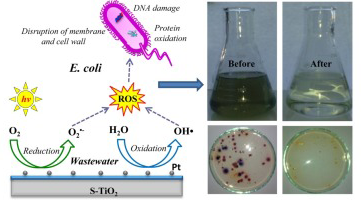
In this study, a series of photocatalysts based on TiO2 was tested in the elimination of Escherichia coli (E. coli) from urban wastewater. Firstly, TiO2 obtained by sol-gel method was modified by sulfation, and then gold or platinum nanoparticles were photodeposited on sulfated titania surface. Platinized samples were also prepared with different Pt content of 0.5 and 2 wt.%. The samples thus obtained were extensively characterized and it was found that sulfation considerably increases the S-BET value of TiO2 and promotes the anatase phase formation; it was also found that 0.5 wt.% Pt-TiO2 sample presents the lowest noble metal particle size and the best particle dispersion. All the photocatalysts synthesized have shown bactericidal effect and the results obtained by using bare and metalized TiO2 were considerably better than the results obtained with the commercial TiO2 P25 Evonic. Different light intensities were also evaluated in the photocatalytic tests and it was found that 120 W/m(2) leads to obtain the highest E. coli elimination from wastewater samples; however no total elimination of E. coli or other species of bacteria was achieved even after 5 h of photocatalytic treatment without catalyst. Total elimination of the E. coli was achieved after 3 h of photocatalytic reaction by using 120 Wim(2) of light intensity and 2 wt.% Pt-TiO2 as photocatalyst; no bacterial regrowth was observed even after 72 h.
The role of cobalt hydroxide in deactivation of thin film Co-based catalysts for sodium borohydride hydrolysis
Paladini, M; Arzac, GM; Godinho, V; Hufschmidt, D; de Haro, MCJ; Beltran, AM; Fernandez, A
Applied Catalysis B-Environmental, 210 (2017) 342-351 | DOI: 10.1016/j.apcatb.2017.04.005
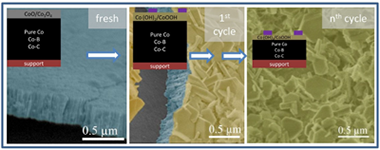
Deactivation of a Co catalyst prepared as thin film by magnetron sputtering was studied for the sodium borohydride (SB) hydrolysis reaction under different conditions. Under high SB concentration in single run experiments, the formation of a B-O passivating layer was observed after 1.5 and 24 h use. This layer was not responsible for the catalyst deactivation. Instead, a peeling-off mechanism produced the loss of cobalt. This peeling-off mechanism was further studied in cycling experiments (14 cycles) under low SB concentrations. Ex-situ study of catalyst surface after use and solid reaction products (precipitates) was performed by X-Ray photoelectron spectroscopy (XPS), transmission electron microscopy (TEM) and scanning transmission electron microscopy (STEM). The presence of cobalt hydroxide and oxyhydroxide was detected as major components on the catalyst surface after use and as precipitates in the supernatant solutions after washing. Cobalt borate, cobalt carbonate and oxycarbonate were also formed but in lesser amounts. These oxidized cobalt species were formed and further detached from the catalyst at the end of the reaction and/or during catalyst washing by decomposition of the unstable in-situ formed cobalt boride. Leaching of cobalt soluble species was negligible. Thin film mechanical detachment was also found but in a smaller extent. To study the influence of catalyst composition on deactivation processes, cycling experiments were performed with Co-B and Co-C catalysts, also prepared as thin films. We found that the deactivation mechanism proposed by us for the pure Co catalyst also occurred for a different pure Co (prepared at higher pressure) and the Co-B and Co-C samples in our experimental conditions.
Gold promoted Cu/ZnO/Al2O3 catalysts prepared from hydrotalcite precursors: Advanced materials for the WGS reaction
Santos, JL; Reina, TR; Ivanova, S; Centeno, MA; Odriozola, JA
Applied Catalysis B-Envionmental, 201 (2017) 310-317 | DOI: 10.1016/j.apcatb.2016.08.017
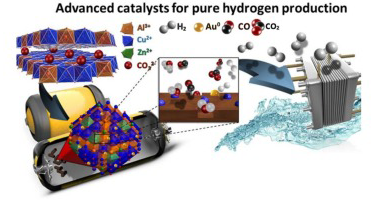
Outstanding catalysts for the water was shift reaction are reported in this work. The combination of gold nanoparticles with Cu/ZnO/Al2O3 prepared from hydrotalcite-like precursors leads to very promising systems for pure hydrogen production. Full CO conversion is reached at temperatures as low as 180 degrees C. The key point seems to be the cooperation of Au and Cu and the optimal metal-oxide contact derived from the synthesis method. The high activity of gold for low temperature CO oxidation and the suitability of copper for the WGS results in a perfect synergy. Moreover the materials developed in this work present good stability and tolerance towards start/stop cycles an indispensable requisite for a realistic application in an integrated hydrogen fuel processor.
Pt-impregnated catalysts on powdery SiC and other commercial supports for the combustion of hydrogen under oxidant conditions
Arzac, G. M.; Montes, O.; Fernandez, A.
Applied Catalysis B-Envionmental, 201 (2017) 391-399 | DOI: 10.1016/j.apcatb.2016.08.042
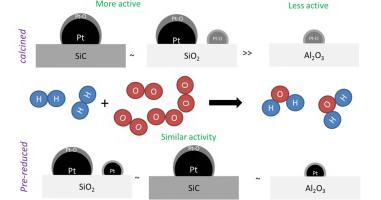
We report the study of the catalytic hydrogen combustion over Pt-impregnated powdery silicon carbide (SiC) using H2PtCl6 as precursor. The reaction was conducted in excess of oxygen. beta-SiC was selected for the study because of its thermal conductivity, mechanical properties, chemical inertness and surface area. The obtained Pt particles over SiC were medium size (average particle diameter of 5 nm for 0.5 wt% Pt). The activity of the Pt-impregnated catalyst over SiC was compared to those obtained in oxidized form over TiO2 and Al2O3 commercial supports (Pt particles very small in size, average particle diameter of 1 nm for 0.5 wt% Pt in both cases). The case of a SiO2 support was also discussed. Those Pt/SiC particles were the most active because of their higher contribution of surface Pt, indicating that partially oxidized surfaces have better activity than those totally oxidized in these conditions. SiC was modified with an acid treatment and thus bigger (average particle diameter of 7 nm for 0.5 wt% Pt) and more active Pt particles were obtained. Durability of the SiC and TiO2 supported catalysts was tested upon 5 cycles and both have shown to be durable and even more active than initially. Exposure to the oxidative reaction mixture activates the catalysts and the effect is more pronounced for the completely oxidized particles. This is due to the surface oxygen chemisorption which activates catalystsi surface.
Structuring Pt/CeO2/Al2O3 WGS catalyst: Introduction of buffer layer
Gonzalez-Castano, M; Ivanova, S; Laguna, OH; Martinez, LM; Centeno, MA; Odriozola, JA
Applied Catalysis B-Envionmental, 200 (2017) 420-427 | DOI: 10.1016/j.apcatb.2016.07.039
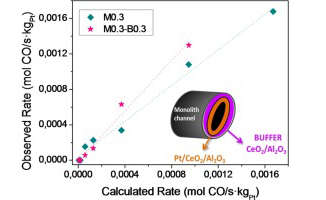
This work is devoted to the development of novel structured catalytic system for WGS reaction. The new concept is related to the presence of a pre-catalytic "buffer" layer formed by WGS-inert oxide, i.e. not involved in CO conversion, but able to increase the number of participating sites in water dissociation step during the reaction. The performance of the proposed systems appears to depend strongly on the stream composition, being its effect beneficial in highly reducing atmospheres making it ideal for cleanup application. An increment of the partial kinetic order for water species is observed and reveals the key role of the water activation for superior catalytic behavior.
Cobalt Carbide Identified as Catalytic Site for the Dehydrogenation of Ethanol to Acetaldehyde
A. Rodríguez-Gómez; J.P. Holgado; A. Caballero
ACS Catalysis, 7 (2017) 5243-5247 | DOI: 10.1021/acscatal.7b01348
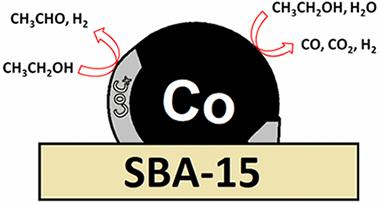
Two cobalt catalysts, Co/SBA-15 and Co/SiO2, have been studied in steam reforming of ethanol (SRE). Besides the steam reforming products, ethoxide dehydrogenation to acetaldehyde is observed as one of the main reactions. Although by hydrogen treatment cobalt is reduced to the metallic state, under SRE conditions, a phase appears that has been identified as cobalt carbide and correlates with acetaldehyde production. These findings provide insights about the catalytic sites, for SRE, in cobalt catalysts. Comparison with previous results shows that these conclusions are not translatable to other cobalt catalysts, stressing the importance of the support on the catalytic behavior of cobalt.
Critical Role of Oxygen in Silver-Catalyzed Glaser-Hay Coupling on Ag(100) under Vacuum and in Solution on Ag Particles
Orozco, N; Kyriakou, G; Beaumont, SK; Sanz, JF; Holgado, JP; Taylor, MJ; Espinos, JP; Marquez, AM; Watson, DJ; Gonzalez-Elipe, AR; Lambert, RM
ACS Catalysis, 7 (2017) 3113-3120 | DOI: 10.1021/acscatal.7b00431
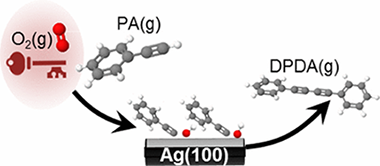
The essential role of oxygen in enabling heterogeneously catalyzed Glaser–Hay coupling of phenylacetylene on Ag(100) was elucidated by STM, laboratory and synchrotron photoemission, and DFT calculations. In the absence of coadsorbed oxygen, phenylacetylene formed well-ordered dense overlayers which, with increasing temperature, desorbed without reaction. In striking contrast, even at 120 K, the presence of oxygen led to immediate and complete disruption of the organic layer due to abstraction of acetylenic hydrogen with formation of a disordered mixed layer containing immobile adsorbed phenylacetylide. At higher temperatures phenylacetylide underwent Glaser–Hay coupling to form highly ordered domains of diphenyldiacetylene that eventually desorbed without decomposition, leaving the bare metal surface. DFT calculations showed that, while acetylenic H abstraction was otherwise an endothermic process, oxygen adatoms triggered a reaction-initiating exothermic pathway leading to OH(a) + phenylacetylide, consistent with the experimental observations. Moreover, it was found that, with a solution of phenylacetylene in nonane and in the presence of O2, Ag particles catalyzed Glaser–Hay coupling with high selectivity. Rigorous exclusion of oxygen from the reactor strongly suppressed the catalytic reaction. Interestingly, too much oxygen lowers the selectivity toward diphenyldiacetylene. Thus, vacuum studies and theoretical calculations revealed the key role of oxygen in the reaction mechanism, subsequently borne out by catalytic studies with Ag particles that confirmed the presence of oxygen as a necessary and sufficient condition for the coupling reaction to occur. The direct relevance of model studies to a mechanistic understanding of coupling reactions under conditions of practical catalysis was reaffirmed.
Materials chemistry approaches to the control of the optical features of perovskite solar cells
Calvo, Mauricio E.
Journal of Materials Chemistry A, 5 (2017) 20561-20578 | DOI: 10.1039/c7ta05666d
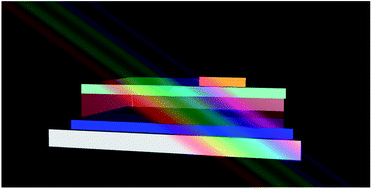
Perovskite solar cells have revolutionized the field of photovoltaics. Apart from their impressive photo-conversion efficiencies, the ease of their fabrication – principally when carried out by solution processing – has permitted addition of new functionalities to the photovoltaic cell. Some of these features are related to the optical properties. In this review, the different materials chemistry approaches that allow controlling the spectral absorption of ABX3 perovskite layers and the changes that they produce in the visual aspect of the solar cell will be covered. These modifications can be done either by playing with the composition of the precursors or by integrating different types of nanostructures. Spectral bandgap tuning, semitransparency, color and enhancement of light absorption are examples of how these modifications operate in the core of ABX3 perovskite solar cells. These optical features bring benefits in terms of photo-conversion efficiencies or else in the aesthetical integration of perovskite solar cells with architectonic elements for building integrated photovoltaics. Additionally, surface passivation approaches are covered to show its effect over the photo-conversion efficiency and stability of the cell.
Impact of moisture on efficiency-determining electronic processes in perovskite solar cells
Salado, Manuel; Contreras-Bernal, Lidia; Calio, Laura; Todinova, Anna; Lopez-Santos, Carmen; Ahmad, Shahzada; Borras, Ana; Idigoras, Jesus; Anta, Juan A.
Journal of Materials Chemistry A, 5 (2017) 10917-10927 | DOI: 10.1039/c7ta02264f
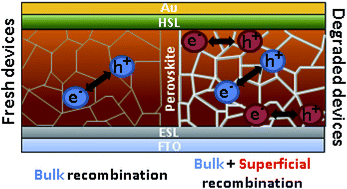
Moisture-induced degradation in perovskite solar cells was thoroughly investigated by structural (SEM, EDS, XRD and XPS) and device characterization (impedance and intensity modulated photocurrent spectroscopy) techniques. Both the influence of the perovskite composition and the nature of the hole selective material were analyzed. The degradation rate was found to be significantly slower for mixed perovskites and P3HT-based devices. However, for a fixed degradation degree (defined as a 50% drop from the initial photocurrent), all configurations show similar features in small-perturbation analysis. Thus, a new mid-frequency signal appears in the impedance response, which seems to be related to charge accumulation at the interfaces. In addition, faster recombination, with a more important surface contribution, and slower transport were clearly inferred from our results. Both features can be associated with the deterioration of the contacts and the formation of a higher number of grain boundaries.
Multicolored Emission and Lasing in DCM-Adamantane Plasma Nanocomposite Optical Films
Alcaire, M; Cerdan, L; Zamarro, FL; Aparicio, FJ; Gonzalez, JC; Ferrer, FJ; Borras, A; Espinos, JP; Barranco, A
ACS Applied Materials & Interfaces, 9 (2017) 8948-8959 | DOI: 10.1021/acsami.7b01534
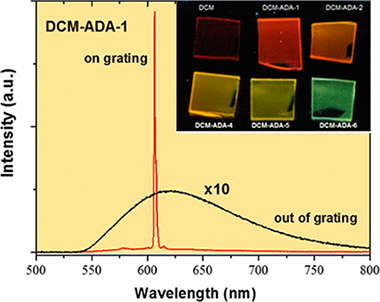
We present a low-temperature versatile protocol for the fabrication of plasma nanocomposite thin films to act as tunable emitters and optical gain media. The films are obtained by the remote plasma-assisted deposition of a 4-(dicyano-methylene)-2-methy1-6-(4-dimethylamino-styry1)-4Hpyran (DCM) laser dye alongside adamantane. The experimental parameters that determine the concentration of the dye in the films and their optical properties, including light absorption, the refractive index, and luminescence, are evaluated. Amplified spontaneous emission experiments in the DCM/adamantane nano composite waveguides show the improvement of the copolymerized nano composites' properties compared to films that were deposited with DCM as the sole precursor. Moreover, one-dimensional distributed feed-back laser emission is demonstrated and characterized in some of the nanocomposite films that are studied. These results open new paths for the optimization of the optical and lasing properties of plasma nanocomposite polymers, which can be straightforwardly integrated as active components in optoelectronic devices.
Energy-Sensitive Ion- and Cathode-Luminescent Radiation-Beam Monitors Based on Multilayer Thin-Film Designs
Gil-Rostra, Jorge; Ferrer, Francisco J.; Pedro Espinos, Juan; Gonzalez-Elipe, Agustin R.; Yubero, Francisco
ACS Applied Materials & Interfaces, 9 (2017) 16313-16320 | DOI: 10.1021/acsami.7b01175
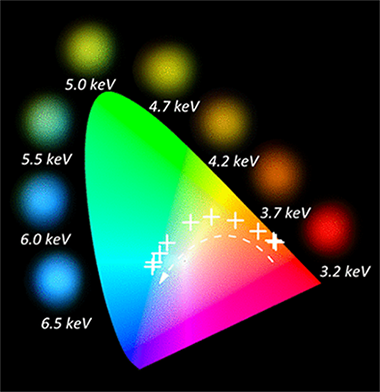
A multilayer luminescent design concept is presented to develop energy sensitive radiation-beam monitors on the basis of colorimetric analysis. Each luminescent layer within the stack consists of rare-earth-doped transparent oxides of optical quality and a characteristic luminescent emission under excitation with electron or ion beams. For a given type of particle beam (electron, protons, alpha particles, etc.), its penetration depth and therefore its energy loss at a particular buried layer within the multilayer stack depend on the energy of the initial beam. The intensity of the luminescent response of each layer is proportional to the energy deposited by the radiation beam within the layer, so characteristic color emission will be achieved if different phosphors are considered in the layers of the luminescent stack. Phosphor doping, emission efficiency, layer thickness, and multilayer structure design are key parameters relevant to achieving a broad colorimetric response. Two case examples are designed and fabricated to illustrate the capabilities of these new types of detector to evaluate the kinetic energy of either electron beams of a few kilo-electron volts or a particles of alpha few mega-electron volts.
Facile Synthesis of Hybrid Organic–Inorganic Perovskite Microcubes of Optical Quality Using Polar Antisolvents
Li, Yuelong; Galisteo-Lopez, Juan F.; Calvo, Mauricio E.; Miguez, Hernan
ACS Applied Materials & Interfaces, 9 (2017) 35505-35510 | DOI: 10.1021/acsami.7b08431

Herein, we demonstrate a synthetic approach producing highly crystalline methylammonium lead bromide perovskite (MAPbBr3) microcubes at room temperature by injecting a perovskite precursor solution into an environmentally friendly antisolvent (isopropyl alcohol). Confirmed by X-ray and electron diffraction, as well as electron microscopy, these MAPbBr3 microcubes are single crystals and have perfect cubic structure, with sizes varying between 1 and 15 μm depending on the synthesis conditions. The stoichiometry of the MAPbBr3 crystal is proven by energy-dispersive X-ray analysis. Finally, optical analysis carried out by means of laser scanning confocal microscopy evidences how the crystalline quality of the microcubes translates into a homogeneous photoluminescence throughout the cube volume.
The Oxy-CaL process: A novel CO2 capture system by integrating partial oxy-combustion with the Calcium-Looping process
Ortiz, C; Valverde, JM; Chacartegui, R; Benitez-Guerrero, M; Perejon, A; Romeo, LM
Applied Energy, 196 (2017) 1-17 | DOI: 10.1016/j.apenergy.2017.03.120
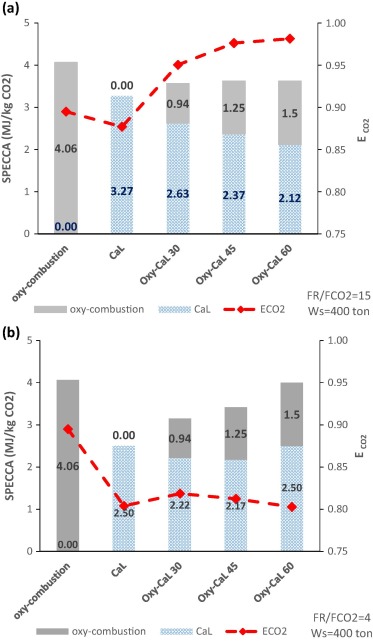
This paper proposes a novel CO2 capture technology from the integration of partial oxy-combustion and the Calcium -Looping capture process based on the multicycle carbonation/calcination of limestone derived CaO. The concentration of CO2 in the carbonator reactor is increased by means of partial oxycombustion, which enhances the multicycle CaO conversion according to thermogravimetric analysis results carried out in our work, thus improving the CO2 capture efficiency. On the other hand, energy consumption for partial oxy-combustion is substantially reduced as compared to total oxy-combustion. All in all, process simulations indicate that the integration of both processes has potential advantages mainly regarding power plant flexibility whereas the overall energy penalty is not increased. Thus, the resulting energy consumption per kilogram of CO2 avoided is kept smaller than 4 MI/kg CO2, which remains below the typical values reported for total oxy-combustion and amine based CO2 capture systems whereas CO2 capture efficiency is enhanced in comparison with the Calcium -Looping process.
Photonic Tuning of the Emission Color of Nanophosphor Films Processed at High Temperature
Geng, Dongling; Lozano, Gabriel; Calvo, Mauricio E.; Nunez, Nuria O.; Becerro, Ana I.; Ocana, Manuel; Miguez, Hernan
Advanced Optical Materials, 5 (2017) art. 1700099 | DOI: 10.1002/adom.201700099
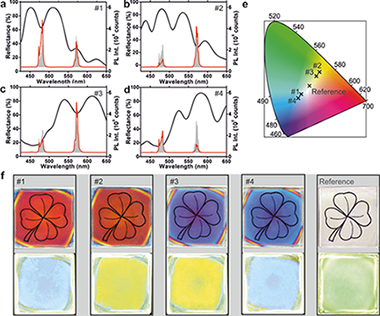
Photonics offers new possibilities to tailor the photoluminescence process in phosphor-converted light emitting diodes. Herein, it is demonstrated that the emission color of thin layers of rare-earth doped nanocrystals can be strongly modulated in tunable spectral ranges using optical resonators specifically designed to this end. GdVO4:Dy3+ nanoparticles of controlled size and shape are synthesized using a solvothermal method with which highly transparent nanophosphor thin films are prepared. This paper designs and fabricates optical multilayers, which are transparent in the UV and resonant at the frequencies where the Dy3+ ions emit, to prove that the color coordinates of this emitter can be tuned from green to blue or yellow with unprecedented precision. Key to the achievement herein reported is the careful analysis of the structural and optical properties of thin nanophosphor layers with the processing temperature in order to achieve efficient photoluminescence while preserving the transparency of the film. The results open a new path for fundamental and applied research in solid-state lighting in which photonic nanostructures allow controlling the emission properties of state-of-the-art materials without altering their structure or chemical composition.
Aperiodic Metal-Dielectric Multilayers as Highly Efficient Sunlight Reflectors
Alberto Jiménez-Solano; Miguel Anaya; Mauricio E. Calvo; Mercedes Alcon-Camas; Carlos Alcañiz; Elena Guillén; Noelia Martínez; Manuel Gallas; Thomas Preussner; Ramón Escobar-Galindo; Hernán Míguez
Advanced Optical Materials, 5 (2017) 1600833 | DOI: 10.1002/adom.201600833
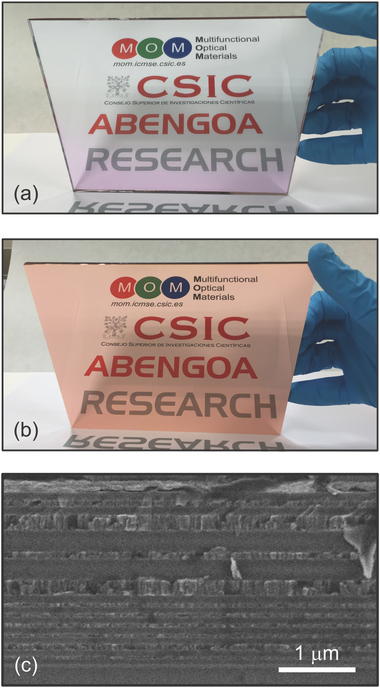
The optimum reflection of the solar spectrum at well-defined incident directions as well as its durability in time are, both, fundamental requirements of the optics of thermosolar and photovoltaic energy conversion systems. The stringent high performance needed for these applications implies that, almost exclusively, second face mirrors based on silver are employed for this purpose. Herein, the possibility to develop solar mirrors using other metals, such as copper and aluminum, is theoretically and experimentally analyzed. It is found that reflectors based on these inexpensive metals are capable of reflecting the full solar spectrum with efficiencies comparable to that of silver-based reflectors. The designs herein proposed are based on aperiodic metal-dielectric multilayers whose optimized configuration is chosen employing a code based on a genetic algorithm that allows selecting the best one among 108 tested reflectors. The use of metals with wider spectral absorption bands is compensated by the use of multilayered designs in which metal absorption is almost suppressed, as the analysis of the electric field intensity distribution demonstrates. The feasibility of the proposed mirrors is demonstrated by their actual fabrication by large area deposition techniques amenable for mass production.
Fluorescent Humidity Sensors Based on Photonic Resonators
Szendrei, K; Jimenez-Solano, A; Lozano, G; Lotsch, BV; Miguez, H
Advanced Optical Materials, 5 (2017) 1700663 | DOI: 10.1002/adom.201700663
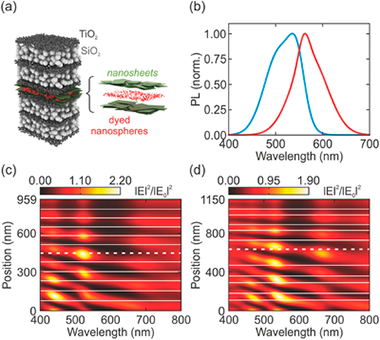
Among the different approaches to humidity sensing available, those based on fluorescent signals are gathering a great deal of attention due to their fast response and versatility of detection and design. So far, all proposals have focused on the use of luminescent probes whose emission is either triggered or inhibited by the presence of water that reacts or alters their chemical environment, hence inducing the signal change. Here, a novel concept in fluorescent humidity sensing based on combining stimuli-responsive photonic resonators with molecular fluorescent probes is introduced. The resonator is assembled from humidity-swellable antimony phosphate nanosheets embedding a planar light-emitting probe, whose emission is dramatically modified by the changes that ambient humidity causes in its photonic environment. Guided by "in silico" optical design of the resonator architecture and subsequent experimental realization, two embodiments of fluorescent photonic humidity sensors featuring turn-on and turn-off detection schemes are presented. The interplay between the luminescent properties of an emitter and its photonic environment implies a fundamental advantage as the emitters are not chemically altered during the detection process. At the same time, it paves the way toward a new generation of photonic humidity sensors which can conveniently be interfaced with common fluorescence detection schemes.
Design and Realization of a Novel Optically Disordered Material: A Demonstration of a Mie Glass
Miranda-Munoz, Jose M.; Lozano, Gabriel; Miguez, Hernan
Advanced Optical Materials, 5 (2017) art. 1700025 | DOI: 10.1002/adom.201700025
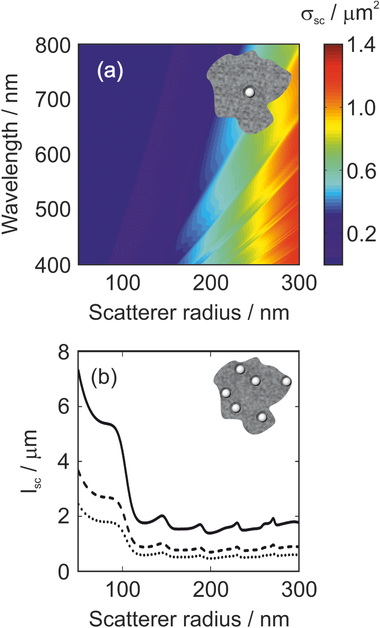
Herein, a diffusive material presenting optical disorder is introduced, which represents an example of a Mie glass. Comprising spherical crystalline TiO2 nanoparticles randomly dispersed in a mesoporous TiO2 matrix, it is proved that the scattering of light in this inhomogeneous solid can be predicted in an unprecedented manner from single-particle considerations employing Mie theory. To that aim, a study of the dependence of the key parameters employed is performed to describe light propagation in random media, i.e., the scattering mean free path and the transport mean free path, as a function of the size and concentration of the spherical inclusions based on a comparison between experimental results and analytical calculations. It is also demonstrated that Mie glasses enable enhanced fluorescence intensity due to a combined absorptance enhancement of the excitation light combined with an improved outcoupling of the emitted light. The method offers the possibility to perform a deterministic design for the realization of a light diffuser with tailor-made scattering properties.
Monitoring the Reaction Mechanism in Model Biogas Reforming by InSitu Transient and Steady-State DRIFTS Measurements
Bobadilla, LF; Garcilaso, V; Centeno, MA; Odriozola, JA
Chemsuschem, 10 (2017) 1193-1201 | DOI: 10.1002/cssc.201601379
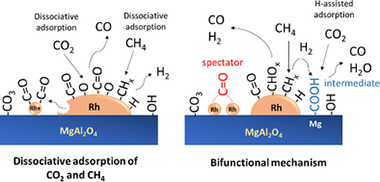
In this work, the reforming of model biogas was investigated on a Rh/MgAl2O4 catalyst. In situ transient and steady-state diffuse reflectance infrared Fourier transform spectroscopy (DRIFTS) measurements were used to gain insight into the reaction mechanism involved in the activation of CH4 and CO2. It was found that the reaction proceeds through of an initial pathway in which methane and CO2 are both dissociated on Rh metallic sites and additionally a bifunctional mechanism in which methane is activated on Rh sites and CO2 is activated on the basic sites of the support surface via a formate intermediate by H-assisted CO2 decomposition. Moreover, this plausible mechanism is able to explain why the observed apparent activation energy of CO2 is much lower than that of CH4. Our results suggest that CO2 dissociation facilitates CH4activation, because the oxygen-adsorbed species formed in the decomposition of CO2 are capable of reacting with the CHx species derived from methane decomposition.
Towards Extending Solar Cell Lifetimes: Addition of a Fluorous Cation to Triple Cation-Based Perovskite Films
Salado, M; Fernandez, MA; Holgado, JP; Kazim, S; Nazeeruddin, MK; Dyson, PJ; Ahmad, S
Chemsuschem, 10 (2017) 3846-3853 | DOI: 10.1002/cssc.201700797
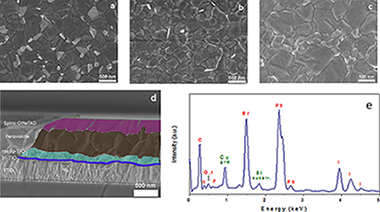
Organohalide perovskites have emerged as highly promising replacements for thin-film solar cells. However, their poor stability under ambient conditions remains problematic, hindering commercial exploitation. The addition of a fluorous-functionalized imidazolium cation during the preparation of a highly stable cesium-based mixed perovskite material Cs-0.05(MA(0.15)FA(0.85))(0.95)Pb(I0.85Br0.15)(3) (MA= methylammonium; FA= formamidinium) has been shown to influence its stability. The resulting materials, which vary according to the amount of the fluorous-functionalized imidazolium cation present during fabrication, display a prolonged tolerance to atmospheric humidity (> 100 days) along with power conversion efficiencies exceeding 16%. This work provides a general route that can be implemented in a variety of perovskites and highlights a promising way to increase perovskite solar cell stability.
High vacuum synthesis and ambient stability of bottom-up graphene nanoribbons
Fairbrother, A; Sanchez-Valencia, JR; Lauber, B; Shorubalko, I; Ruffieux, P; Hintermann, T; Fasel, R
Nanoscale, 9 (2017) 2785-2792 | DOI: 10.1039/C6NR08975E
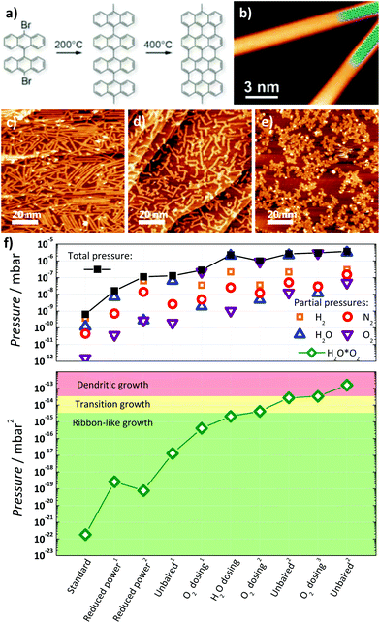
Carbon-based nanomaterials such as graphene are at a crucial point in application development, and their promising potential, which has been demonstrated at the laboratory scale, must be translated to an industrial setting for commercialization. Graphene nanoribbons in particular overcome one limitation of graphene in some electronic applications because they exhibit a sizeable bandgap. However, synthesis of bottom-up graphene nanoribbons is most commonly performed under ultra-high vacuum conditions, which are costly and difficult to maintain in a manufacturing environment. Additionally, little is known about the stability of graphene nanoribbons under ambient conditions or during transfer to technologically relevant substrates and subsequent device processing. This work addresses some of these challenges, first by synthesizing bottom-up graphene nanoribbons under easily obtained high vacuum conditions and identifying water and oxygen as the residual gases responsible for interfering with proper coupling during the polymerization step. And second, by using Raman spectroscopy to probe the stability of nanoribbons during storage under ambient conditions, after transfer to arbitrary substrates, and after fabrication of field-effect transistor devices, which shows structurally intact nanoribbons even several months after synthesis. These findings demonstrate the potential of graphene nanoribbon technologies by addressing some limitations which might arise in their commercialization.
Plasma assisted deposition of single and multistacked TiO2 hierarchical nanotube photoanodes
Filippin, AN; Sanchez-Valencia, JR; Idigoras, J; Rojas, TC; Barranco, A; Anta, JA; Borras, A
Nanoscale, 9 (2017) 8133-8141 | DOI: 10.1039/c7nr00923b
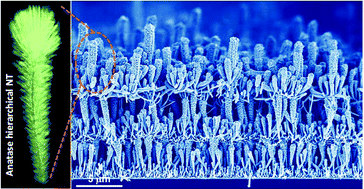
We present herein an evolved methodology for the growth of nanocrystalline hierarchical nanotubes combining physical vapor deposition of organic nanowires (ONWs) and plasma enhanced chemical vacuum deposition of anatase TiO2 layers. The ONWs act as vacuum removable 1D and 3D templates, with the whole process occurring at temperatures ranging from RT to 250 degrees C. As a result, a high density of hierarchical nanotubes with tunable diameter, length and tailored wall microstructures are formed on a variety of processable substrates as metal and metal oxide films or nanoparticles including transparent conductive oxides. The reiteration of the process leads to the development of an unprecedented 3D nanoarchitecture formed by stacking the layers of hierarchical TiO2 nanotubes. As a proof of concept, we present the superior performance of the 3D nanoarchitecture as a photoanode within an excitonic solar cell with efficiencies as high as 4.69% for a nominal thickness of the anatase layer below 2.75 mu m. Mechanical stability and straightforward implementation in devices are demonstrated at the same time. The process is extendable to other functional oxides fabricated by plasma-assisted methods with readily available applications in energy harvesting and storage, catalysis and nanosensing.
High performance novel gadolinium doped ceria/yttria stabilized zirconia/nickel layered and hybrid thin film anodes for application in solid oxide fuel cells
Garcia-Garcia, FJ; Beltran, AM; Yubero, E; Gonzalez-Elipe, AR; Lambert, RM
Journal of Power Sources, 363 (2017) 251-259 | DOI: 10.1016/j.jpowsour.2017.07.085
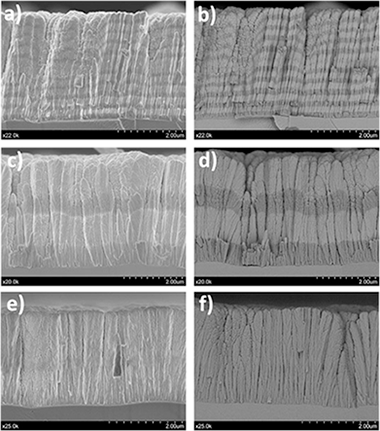
Magnetron sputtering under oblique angle deposition was used to produce Ni-containing ultra thin film anodes comprising alternating layers of,gadolinium doped ceria (GDC) and yttria stabilized zirconia (YSZ) of either 200 nm or 1000 nm thickness. The evolution of film structure from initial deposition, through calcination and final reduction was examined by XRD, SEM, TEM and TOF-SIMS. After subsequent fuel cell usage, the porous columnar architecture of the two-component layered thin film anodes was maintained and their resistance to delamination from the underlying YSZ electrolyte was superior to that of corresponding single component Ni-YSZ and Ni-GDC thin films. Moreover, the fuel cell performance of the 200 nm layered anodes compared favorably with conventional commercially available thick anodes. The observed dependence of fuel cell performance on individual layer thicknesses prompted study of equivalent but more easily fabricated hybrid anodes consisting of simultaneously deposited Ni-GDC and Ni-YSZ, which procedure resulted in exceptionally intimate mixing and interaction of the components. The hybrids exhibited very unusual and favorable I-V characteristics, along with exceptionally high power densities at high currents. Their discovery is the principal contribution of the present work.
Improving the pollutant removal efficiency of packed-bed plasma reactors incorporating ferroelectric components
Gomez-Ramirez, Ana; Montoro-Damas, Antonio M.; Rodriguez, Miguel A.; Gonzalez-Elipe, Agustin R.; Cotrino, Jose
Chemical Engineering Journal, 314 (2017) 311-319 | DOI: 10.1016/j.cej.2016.11.065
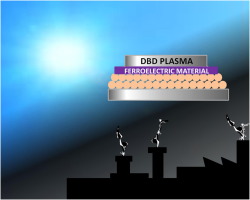
In this work we have studied the plasma removal of air contaminants such as methane, chloroform, toluene and acetone in two parallel plate packed-bed dielectric barrier discharge (DBD) reactors of different sizes. Removal and energy efficiencies have been determined as a function of the residence time of the contaminated air within the reactor, the kind of packed-bed material (ferroelectrics or classical dielectric materials), the frequency and the incorporation of a ferroelectric plate onto the active electrode together with the inter-electrode ferroelectric pellets filling the gap. Results at low frequency with the small reactor and the ferroelectric plate showed an enhancement in energy efficiency (e.g., it was multiplied by a factor of six and three for toluene and chloroform, respectively) and in removal yield (e.g., it increased from 22% to 52% for chloroform and from 15% to 21% for methane). Such enhancements have been attributed to the higher energy of plasma electrons and a lower reactor capacitance found for this plate-modified configuration. A careful analysis of reaction efficiencies and electron energy distributions for the different investigated conditions and the simulation of the electric field at the necks between ferroelectric/dielectric pellets complete the present study. Overall, the obtained results prove the critical role of the barrier architecture and operating conditions for an enhanced performance of pollution removal processes using DBD systems.
Large-Scale Storage of Concentrated Solar Power from Industrial Waste
Perejon, Antonio; Valverde, Jose Manuel; Miranda-Pizarro, Juan; Sanchez-Jimenez, Pedro E.; Perez-Maqueda, Luis A.
ACS Sustainable Chemistry & Engineering, 5 (2017) 2265-2272 | DOI: 10.1021/acssuschemeng.6b02576
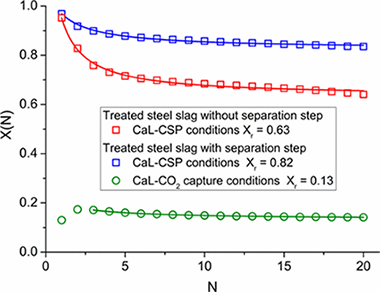
Deep penetration of renewable energies into the grid relies on the development of large-scale energy storage technologies using cheap, abundant, and nontoxic materials. Concentrated solar power (CSP) is particularly suitable to massively store thermal energy for dispatchable electricity generation. This is currently accomplished in a few demonstration plants by using molten salts albeit in a not competitive way yet. Process simulation studies indicate that thermochemical energy storage of CSP by means of the calcium looping (CaL) technology would reduce the cost of storage and increase the flexibility of energy supply provided that widely available and cheap CaO precursors with high and stable multicycle activity are used. In this work, we investigate the behavior of calcium rich steel slag at CaL conditions that would expectedly maximize the efficiency of CSP energy storage and power production. When treated with acetic acid, this nontoxic widely abundant waste yields a CaO rich solid with stable conversion near 0.8 over successive carbonation/calcination cycles at these CaL conditions
Rare earth based nanostructured materials: synthesis, functionalization, properties and bioimaging and biosensing applications
Escudero, Alberto; Becerro, Ana I.; Carrillo-Carrion, Carolina; Nunez, Nuria O.; Zyuzin, Mikhail V.; Laguna, Mariano; Gonzalez-Mancebo, Daniel; Ocana, Manuel; Parak, Wolfgang J.
Nanophotonics, 6 (2017) 881-921 | DOI: 10.1515/nanoph-2017-0007
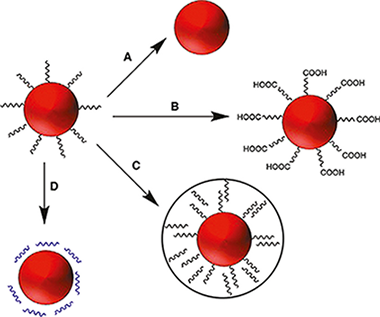
Rare earth based nanostructures constitute a type of functional materials widely used and studied in the recent literature. The purpose of this review is to provide a general and comprehensive overview of the current state of the art, with special focus on the commonly employed synthesis methods and functionalization strategies of rare earth based nanoparticles and on their different bioimaging and biosensing applications. The luminescent (including downconversion, upconversion and permanent luminescence) and magnetic properties of rare earth based nanoparticles, as well as their ability to absorb X-rays, will also be explained and connected with their luminescent, magnetic resonance and X-ray computed tomography bioimaging applications, respectively. This review is not only restricted to nanoparticles, and recent advances reported for in other nanostructures containing rare earths, such as metal organic frameworks and lanthanide complexes conjugated with biological structures, will also be commented on.
Electron injection and scaffold effects in perovskite solar cells
M. Anaya, W. Zhang, B. Clasen Hames, Y. Li, F. Fabregat-Santiago, M.E. Calvo, H.J. Snaith, H. Míguez, I. Mora-Seró
Journal of Materials Chemistry C, 5 (2017) 634-644 | DOI: 10.1039/C6TC04639H
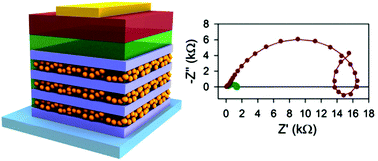
In spite of the impressive efficiencies reported for perovskite solar cells (PSCs), key aspects of their working principles, such as electron injection at the contacts or the suitability of the utilization of a specific scaffold layer, are not yet fully understood. Increasingly complex scaffolds attained by the sequential deposition of TiO2 and SiO2 mesoporous layers onto transparent conducting substrates are used to perform a systematic characterization of both the injection process at the electron selective contact and the scaffold effect in PSCs. By forcing multiple electron injection processes at a controlled sequence of perovskite–TiO2 interfaces before extraction, interfacial injection effects are magnified and hence characterized in detail. An anomalous injection behavior is observed, the fingerprint of which is the presence of significant inductive loops in the impedance spectra with a magnitude that correlates with the number of interfaces in the scaffold. Analysis of the resistive and capacitive behavior of the impedance spectra indicates that the scaffolds could hinder ion migration, with positive consequences such as lowering the recombination rate and implications for the current–potential curve hysteresis. Our results suggest that an appropriate balance between these advantageous effects and the unavoidable charge transport resistive losses introduced by the scaffolds will help in the optimization of PSC performance.
Defect chemistry and electrical properties of BiFeO3
Schrade, M; Maso, N; Perejon, A; Perez-Maqueda, LA; West, AR
Journal of Materials Chemistry C, 5 (2017) 10077-10086 | DOI: 10.1039/c7tc03345a
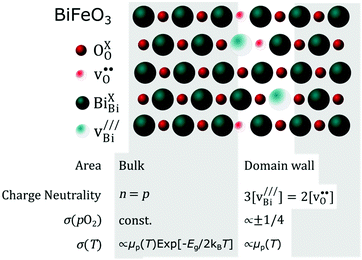
BiFeO3 attracts considerable attention for its rich functional properties, including room temperature coexistence of magnetic order and ferroelectricity and more recently, the discovery of conduction pathways along ferroelectric domain walls. Here, insights into the defect chemistry and electrical properties of BiFeO3 are obtained by in situ measurements of electrical conductivity, sigma, and Seebeck coefficient, a, of undoped, cation-stoichiometric BiFeO3 and acceptor-doped Bi1-xCaxFeO3-delta ceramics as a function of temperature and oxygen partial pressure pO(2). Bi1-xCaxFeO3-delta exhibits p-type conduction; the dependencies of s and a on pO(2) show that Ca dopants are compensated mainly by oxygen vacancies. By contrast, undoped BiFeO3 shows a simultaneous increase of s and a with increasing pO(2), indicating intrinsic behavior with electrons and holes as the main defect species in almost equal concentrations. The pO(2)-dependency of s and a cannot be described by a single point defect model but instead, is quantitatively described by a combination of intrinsic and acceptor-doped characteristics attributable to parallel conduction pathways through undoped grains and defect-containing domain walls; both contribute to the total charge transport in BiFeO3. Based on this model, we discuss the charge transport mechanism and carrier mobilities of BiFeO3 and show that several previous experimental findings can readily be explained within the proposed model.
Cholesterol biosensing with a polydopamine-modified nanostructured platinum electrode prepared by oblique angle physical vacuum deposition
Martin, M; Salazar, P; Alvarez, R; Palmero, A; Lopez-Santos, C; Gonzalez-Mora, JL; Gonzalez-Elipe, AR
Sensors and Actuators B-Chemical, 240 (2017) 37-45 | DOI: 10.1016/j.snb.2016.08.092
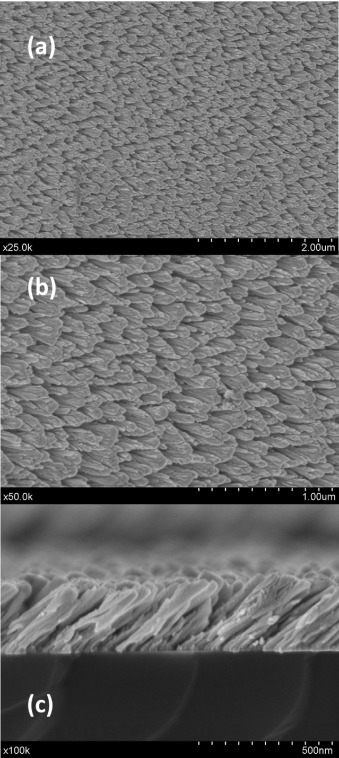
This paper reports a novel cholesterol biosensor based on nanostructured platinum (Pt) thin films prepared by Magnetron Sputtering (MS) in an oblique angle (OAD) configuration. Pt thin films were deposited onto a gold screen-printed electrode and characterized using Rutherford Back Scattering (RBS), Scanning Electron Microscopy (SEM), X-ray Diffraction (XRD), Cyclic Voltammetry (CV), X-ray Photo-electron Spectroscopy (XPS), Atomic Force Microscopy (AFM) and wetting analysis. Our results confirmed that the film is highly porous and formed by tilted nanocolumns, with an inclination of around 40 degrees and a total thickness of 280 nm. XRD and CV analysis confirmed the polycrystalline nature of the Pt thin film. Cholesterol oxidase (ChOx) was covalently immobilized using a bioinspired polymer, polydopamine (PDA), via Schiff base formation and Michael-type addition. After being immobilized, ChOx displayed apparent activation energy of 34.09 kJ mol(-1) and Michaelis constant (K-M) values of 34.09 kJ mol(-1) and 3.65 mM, respectively, confirming the high affinity between ChOx and cholesterol and the excellent ability of the PDA film for immobilizing biological material without degradation. Under optimized working conditions the developed biosensor presented a sensitivity of 14.3 mA M(-1)cm(-2) (R-2:0.999) with a linear range up to 0.5 mM and a limit of detection of 10.5 mu M (S/N= 3). Furthermore, the biosensor exhibited a fast response (<8 s), good anti-interference properties and high stability after relatively long-term storage (2 months).
Calcium-Looping performance of steel and blast furnace slags for thermochemical energy storage in concentrated solar power plants
Valverde, JM; Miranda-Pizarro, J; Perejon, A; Sanchez-Jimenez, PE; Perez-Maqueda, LA
Journal of CO2 Utilization, 22 (2017) 143-154 | DOI: 10.1016/j.jcou.2017.09.021
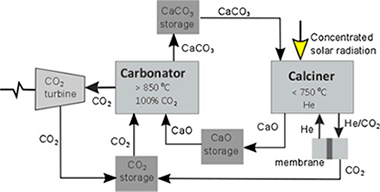
The Calcium Looping (CaL) process, based on the carbonation/calcination of CaO, has been proposed as a feasible technology for Thermochemical Energy Storage (TCES) in Concentrated Solar Power (CSP) plants. The CaL process usually employs limestone as CaO precursor for its very low cost, non-toxicity, abundance and wide geographical distribution. However, the multicycle activity of limestone derived CaO under relevant CaL conditions for TCES in CSP plants can be severely limited by pore plugging. In this work, the alternative use of calcium-rich steel and blast furnace slags after treatment with acetic acid is investigated. A main observation is that the calcination temperature to regenerate the CaO is significantly reduced as compared to limestone. Furthermore, the multicycle activity of some of the slags tested at relevant CaL conditions for TCES remains high and stable if the treated samples are subjected to filtration. This process serves to remove silica grains, which helps decrease the porosity of the CaO resulting from calcination in the mesoporous range thus mitigating pore plugging.
Deep insight into Zr/Fe combination for successful Pt/CeO2/Al2O3 WGS catalyst doping
Gonzalez-Castano, M; Ivanova, S; Ioannides, T; Centeno, MA; Odriozola, JA
Catalysis Science & Technology, 7 (2017) 1556-1564 | DOI: 10.1039/c6cy02551j
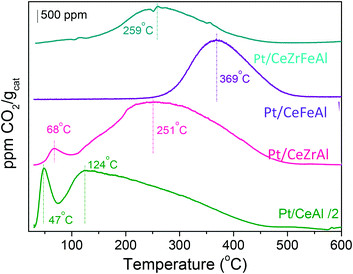
Efficient promotion of the Pt/CeO2/Al2O3 catalytic system was achieved by the addition of two different ceria promoters, Zr and Fe. From the exhaustive data analysis, the key features for enhanced catalytic performance and the roles of each doping metal are established. The combination of both doping agents manifests a synergistic effect reflected in noteworthy improvements in H2 reducibility. In addition, the catalyst's doping influences its chemisorptive properties, which is reflected in an increase of the easiness of carbonaceous species desorption, thus leading to superior catalyst resistance toward deactivation.
Strong Quantum Confinement and Fast Photoemission Activation in CH3NH3PbI3 Perovskite Nanocrystals Grown within Periodically Mesostructured Films
Miguel Anaya; Andrea Rubino; Teresa Cristina Rojas; Juan Francisco Galisteo-López; Mauricio Ernesto Calvo; Hernán Míguez
Advanced Optical Materials, 5 (2017) 1601087 | DOI: 10.1002/adom.201601087
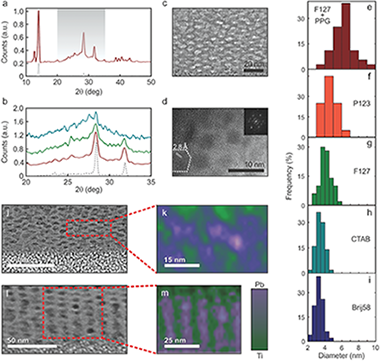
In this Communication, a synthetic route is demonstrated to obtain stabilized MAPbI3 nanocrystals embedded in thin metal oxide films that display well-defined and adjustable quantum confinement effects over a wide range of 0.34 eV. Mesostructured TiO2 and SiO2 films displaying an ordered 3D pore network are prepared by evaporation-induced self-assembly of a series of organic supramolecular templates in the presence of metal oxide precursors. The pores in the inorganic films obtained after thermal annealing are then used as nanoreactors to synthesize MAPbI3crystallites with narrow size distribution and average radius comprised between 1 and 4 nm, depending on the template of choice. Both the static and dynamic photoemission properties of the ensemble display features distinctive of the regime of strong quantum confinement. Photoemission maps demonstrate that the spectral and intensity properties of the luminescence extracted from the perovskite quantum dot loaded films are homogeneous over squared centimeters areas. At variance with their bulk counterparts, constant emission intensity is reached in time scales at least four orders of magnitude shorter.
Cutin from agro-waste as a raw material for the production of bioplastics
Heredia-Guerrero, JA; Heredia, A; Dominguez, E; Cingolani, R; Bayer, IS; Athanassiou, A; Benitez, JJ
Journal of Experimental Botany, 68 (2017) 5401-5410 | DOI: 10.1093/jxb/erx272
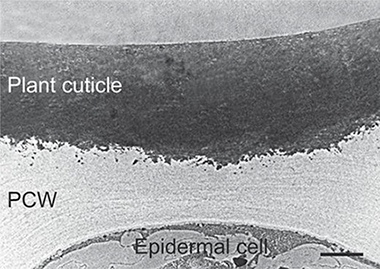
Cutin is the main component of plant cuticles constituting the framework that supports the rest of the cuticle components. This biopolymer is composed of esterified bi- and trifunctional fatty acids. Despite its ubiquity in terrestrial plants, it has been underutilized as raw material due to its insolubility and lack of melting point. However, in recent years, a few technologies have been developed to obtain cutin monomers from several agro-wastes at an industrial scale. This review is focused on the description of cutin properties, biodegradability, chemical composition, processability, abundance, and the state of art of the fabrication of cutin-based materials in order to evaluate whether this biopolymer can be considered a source for the production of renewable materials.
Perspectives on oblique angle deposition of thin films: From fundamentals to devices
Barranco, A; Borras, A; Gonzalez-Elipe, AR; Palmero, A
Progress in Materials Science, 78 (2016) 59-153 | DOI: 10.1016/j.pmatsci.2015.06.003
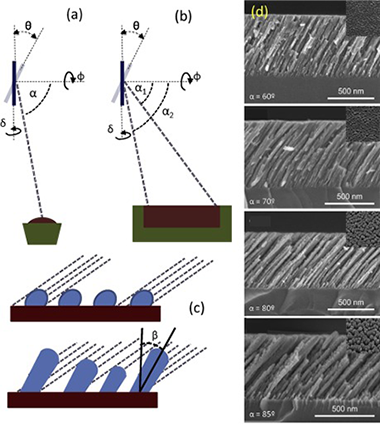
The oblique angle configuration has emerged as an invaluable tool for the deposition of nanostructured thin films. This review develops an up to date description of its principles, including the atomistic mechanisms governing film growth and nanostructuration possibilities, as well as a comprehensive description of the applications benefiting from its incorporation in actual devices. In contrast with other reviews on the subject, the electron beam assisted evaporation technique is analyzed along with other methods operating at oblique angles, including, among others, magnetron sputtering and pulsed laser or ion beam-assisted deposition techniques. To account for the existing differences between deposition in vacuum or in the presence of a plasma, mechanistic simulations are critically revised, discussing well-established paradigms such as the tangent or cosine rules, and proposing new models that explain the growth of tilted porous nanostructures. In the second part, we present an extensive description of applications wherein oblique-angle-deposited thin films are of relevance. From there, we proceed by considering the requirements of a large number of functional devices in which these films are currently being utilized (e.g., solar cells, Li batteries, electrochromic glasses, biomaterials, sensors, etc.), and subsequently describe how and why these nanostructured materials meet with these needs.
Maximized performance of dye solar cells on plastic: a combined theoretical and experimental optimization approach
Li, Yuelong; Carretero-Palacios, Sol; Yoo, Kicheon; Kim, Jong Hak; Jimenez-Solano, Alberto; Lee, Chul-Ho; Miguez, Hernan; Ko, Min Jae
Energy & Environmental Science, 9 (2016) 2061-2071 | DOI: 10.1039/C6EE00424E
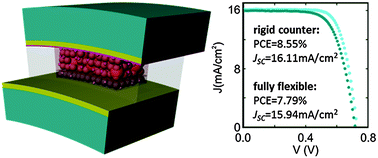
We demonstrate that a combined optimization approach based on the sequential alternation of theoretical analysis and experimental realization gives rise to plastic supported dye solar cells for which both light harvesting efficiency and electron collection are maximized. Rationalized configurations with optimized light trapping and charge extraction are realized to achieve photoanodes on plastic prepared at low temperature, showing a power conversion efficiency of 8.55% and a short circuit photocurrent of 16.11 mA cm−2, unprecedented for plastic based dye solar cell devices. Furthermore, the corresponding fully flexible designs present stable mechanical properties after several bending cycles, displaying 7.79% power conversion efficiency, an average broadband internal quantum efficiency above 90%, and a short circuit photocurrent of 15.94 mA cm−2, which is the largest reported value for bendable cells of this sort to date.
Unbroken Perovskite: Interplay of Morphology, Electro-optical Properties, and Ionic Movement
Correa-Baena, JP; Anaya, M; Lozano, G; Tress, W; Domanski, K; Saliba, M; Matsui, T; Jacobsson, TJ; Calvo, ME; Abate, A; Gratzel, M; Miguez, H; Hagfeldt, A
Advanced Materials, 28 (2016) 5031-5037 | DOI: 10.1002/adma.201600624
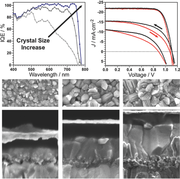
Hybrid organic-inorganic perovskite materials have risen up as leading components for light-harvesting applications. However, to date many questions are still open concerning the operation of perovskite solar cells (PSCs). A systematic analysis of the interplay among structural features, optoelectronic performance, and ionic movement behavior for FA(0.83)MA(0.17)Pb(I0.83Br0.17)(3) PSCs is presented, which yield high power conversion efficiencies up to 20.8%.
Metallic nanostructures for efficient LED lighting
Lozano, G; Rodriguez, SRK; Verschuuren, MA; Rivas, JG
Light: Science and Applications, 5 (2016) e16080 | DOI: 10.1038/lsa.2016.80
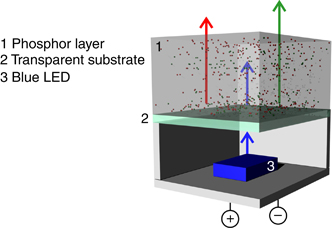
Light-emitting diodes (LEDs) are driving a shift toward energy-efficient illumination. Nonetheless, modifying the emission intensities, colors and directionalities of LEDs in specific ways remains a challenge often tackled by incorporating secondary optical components. Metallic nanostructures supporting plasmonic resonances are an interesting alternative to this approach due to their strong light-matter interaction, which facilitates control over light emission without requiring external secondary optical components. This review discusses new methods that enhance the efficiencies of LEDs using nanostructured metals. This is an emerging field that incorporates physics, materials science, device technology and industry. First, we provide a general overview of state-of-the-art LED lighting, discussing the main characteristics required of both quantum wells and color converters to efficiently generate white light. Then, we discuss the main challenges in this field as well as the potential of metallic nanostructures to circumvent them. We review several of the most relevant demonstrations of LEDs in combination with metallic nanostructures, which have resulted in light-emitting devices with improved performance. We also highlight a few recent studies in applied plasmonics that, although exploratory and eminently fundamental, may lead to new solutions in illumination.
Optofluidic Modulation of Self-Associated Nanostructural Units Forming Planar Bragg Microcavities
Oliva-Ramirez, M; Barranco, A; Loffler, M; Yubero, F; Gonzalez-Elipe, AR
ACS Nano, 10 (2016) 1256-1264 | DOI: 10.1021/acsnano.5b06625
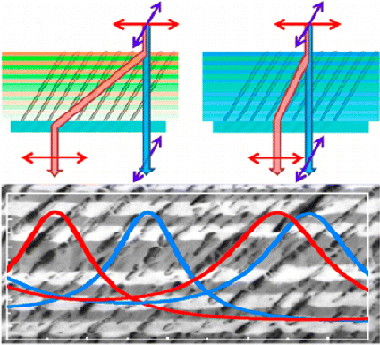
Bragg microcavities (BMs) formed by the successive stacking of nanocolumnar porous SiO2 and TiO2 layers with slanted, zigzag, chiral, and vertical configurations are prepared by physical vapor deposition at oblique angles while azimuthally varying the substrate orientation during the multilayer growth. The slanted and zigzag BMs act as wavelength-selective optical retarders when they are illuminated with linearly polarized light, while no polarization dependence is observed for the chiral and vertical cavities. This distinct optical behavior is attributed to a self-nanostructuration mechanism involving a fence-bundling association of nanocolumns as observed by focused ion beam scanning electron microscopy in the slanted and zigzag microcavities. The outstanding retarder response of the optically active BMs can be effectively modulated by dynamic infiltration of nano- and mesopores with liquids of different refraction indices acting as a switch of the polarization behavior. The unprecedented polarization and tunable optofluidic properties of these nanostructured photonic systems have been successfully simulated with a simple model that assumes a certain birefringence for the individual stacked layers and accounts for the light interference phenomena developed in the BMs. The possibilities of this type of self-arranged nanostructured and optically active BMs for liquid sensing and monitoring applications are discussed.
High-Throughput Fabrication of Resonant Metamaterials with Ultrasmall Coaxial Apertures via Atomic Layer Lithography
Yoo, D; Nguyen, NC; Martin-Moreno, L; Mohr, DA; Carretero-Palacios, S; Shaver, J; Peraire, J; Ebbesen, TW; Oh, SH
Nano Letters, 16 (2016) 2040-2046 | DOI: 10.1021/acs.nanolett.6b00024
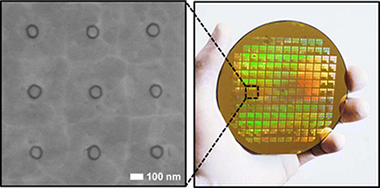
We combine atomic layer lithography and glancing angle ion polishing to create wafer-scale metamaterials composed of dense arrays of ultrasmall coaxial nanocavities in gold films. This new fabrication scheme makes it possible to shrink the diameter and increase the packing density of 2 nm-gap coaxial resonators, an extreme subwavelength structure first manufactured via atomic layer lithography, both by a factor of 100 with respect to previous studies. We demonstrate that the nonpropagating zeroth-order Fabry-Perot mode, which possesses slow light-like properties at the cutoff resonance, traps infrared light inside 2 nm gaps (gap volume similar to lambda(3)/10(6)). Notably, the annular gaps cover only 3% or less of the metal surface, while open-area normalized transmission is as high as 1700% at the epsilon-near-zero (ENZ) condition. The resulting energy accumulation alongside extraordinary optical transmission can benefit applications in nonlinear optics, optical trapping, and surface-enhanced spectroscopies. Furthermore, because the resonance wavelength is independent of the cavity length and dramatically red shifts as the gap size is reduced, large-area arrays can be constructed with lambda(resonance) >> period, making this fabrication method ideal for manufacturing resonant metamaterials.
Electrocatalytic System for the Simultaneous Hydrogen Production and Storage from Methanol
Gonzalez-Cobos, J; Rico, VJ; Gonzalez-Elipe, AR; Valverde, JL; de Lucas-Consuegra, A
ACS Catalysis, 6 (2016) 1942-1951 | DOI: 10.1021/acscatal.5b02844
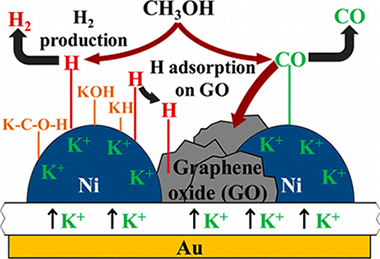
This paper reports a groundbreaking approach for simultaneous hydrogen production and storage that entails catalysis, electrochemistry, surface science, and materials synthesis. A novel electrocatalytic system is developed based on nickel nanocolumnar films of controlled microstructure prepared on K-βAl2O3 solid electrolyte supports by oblique angle physical vapor deposition. The outstanding characteristics of this system are a hydrogen storage capacity of up to 19 g of H2 (100 g of Ni)−1, which is unparalleled in the literature and the possibility of controlling its release electrochemically, under fixed mild conditions (280 °C and normal pressure). H2 is produced in situ by methanol steam re-forming on the Ni catalyst, and it spills over onto graphene oxide aggregates formed during the catalytic process, as confirmed by SEM, FTIR, and Raman spectroscopy. The proposed storage mechanism considers a synergetic contribution of both Ni and graphene oxide, promoted by K+ ions, in enhancing the hydrogen storage capacity of the system.
Stabilization of catalyst particles against sintering on oxide supports with high oxygen ion lability exemplified by Ir-catalyzed decomposition of N2O
Yentekakis, IV; Goula, G; Panagiotopoulou, P; Kampouri, S; Taylor, MJ; Kyriakou, G; Lambert, RM
Applied Catalysis B-Environmental, 192 (2016) 357-364 | DOI: 10.1016/j.apcatb.2016.04.011
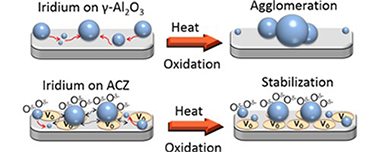
Iridium nanoparticles deposited on a variety of surfaces exhibited thermal sintering characteristics that were very strongly correlated with the lability of lattice oxygen in the supporting oxide materials. Specifically, the higher the lability of oxygen ions in the support, the greater the resistance of the nanoparticles to sintering in an oxidative environment. Thus with gamma-Al2O3 as the support, rapid and extensive sintering occurred. In striking contrast, when supported on gadolinia-ceria and alumina-ceria-zirconia composite, the Ir nanoparticles underwent negligible sintering. In keeping with this trend, the behavior found with yttria-stabilized zirconia was an intermediate between the two extremes. This resistance, or lack of resistance, to sintering is considered in terms of oxygen spillover from support to nanoparticles and discussed with respect to the alternative mechanisms of Ostwald ripening versus nanoparticle diffusion. Activity towards the decomposition of N2O, a reaction that displays pronounced sensitivity to catalyst particle size (large particles more active than small particles), was used to confirm that catalytic behavior was consistent with the independently measured sintering characteristics. It was found that the nanoparticle active phase was Ir oxide, which is metallic, possibly present as a capping layer. Moreover, observed turnover frequencies indicated that catalyst-support interactions were important in the cases of the sinter-resistant systems, an effect that may itself be linked to the phenomena that gave rise to materials with a strong resistance to nanoparticle sintering.
Cascade charge separation mechanism by ternary heterostructured BiPO4/TiO2/g-C3N4 photocatalyst
Obregon, S; Zhang, YF; Colon, G
Applied Catalysis B: Enviromental, 184 (2016) 96-103 | DOI: 10.1016/j.apcatb.2015.11.027
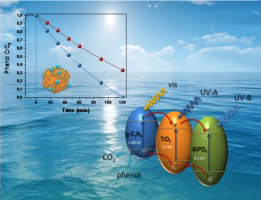
A complex ternary BiPO4/TiO2/gC(3)N(4) heterostructure has been obtained from a simple impregnation method having good photoactivities for the degradation of phenol under solar-like irradiation. From the wide structural, surface and electronic characterization, we have stated that the formation of the ternary heterojunction notably affect photoactivity of pristine TiO2. Thus, the best result for the binary system was obtained for 70 wt%TiO2-30 wt% BiPO4 system. The incorporation of gC(3)N(4) leads to a further improvement on the photocatalytic activity when it is specifically done over TiO2. By means of photoluminescence spectroscopy and reactive oxygen species formation test, we propose that the effective charge carrier separation is taking place through a cascade-driven electronic mechanism. Therefore, by choosing the adequate band-engineering tailoring an important improved photoactivity can be achieved.
O-2-assisted Water Gas Shift reaction over structured Au and Pt catalysts
Gonzalez-Castano, M; Reina, TR; Ivanova, S; Tejada, LMM; Centeno, MA; Odriozola, JA
Applied Catalysis B: Enviromental, 185 (2016) 337-343 | DOI: 10.1016/j.apcatb.2015.12.032
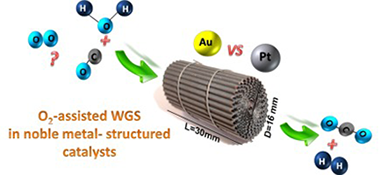
Platinum and gold structured catalysts were compared as active phases in classical and O2-assisted Water Gas Shift (WGS) reaction. Both metals were supported on iron-doped ceria mixed oxide and then, structured on metallic micromonolithic devices. As expected the WGS activity of both micromonoliths is conditioned by the nature of the noble metals being Pt the most active metal in traditional conditions. However, the addition of oxygen to the classical water gas feed turns the balance in favor of the gold based catalysts, being the presence of gold responsible for an excessive improvement of the catalytic activity.
WGS and CO-PrOx reactions using gold promoted copper-ceria catalysts: "Bulk CuO-CeO2 vs. CuO-CeO2/Al2O3 with low mixed oxide content"
Reina, TR; Ivanova, S; Laguna, OH; Centeno, MA; Odriozola, JA
Applied Catalysis B-Environmental, 197 (2016) 62-72 | DOI: 10.1016/j.apcatb.2016.03.022
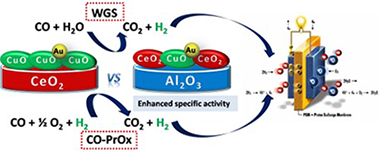
A copper-ceria bulk catalyst has been compared to a series of catalysts designed according to the as called "supported approach", corresponding to the dispersion of low content mixed copper-ceria oxide on alumina matrix. The principal characteristics of both types of catalysts are contemplated and the differences in their electronic and redox properties discussed in details. As a plus, the gold metal promotion of the catalysts is also envisaged. The advantages of the systems in the CO clean up reactions, WGS and CO-PrOx are commented. While the WGS activity appears to be ruled especially by the Cu/Ce surface to volume ratio, the CO-PrOx reaction is governed by the CuO loading. Gold addition provides benefits only at the low temperature WGS regime. Very importantly, the supported systems are always superior to the bulk configuration in terms of specific activity, a key factor from the catalyst's design perspective.
Investigation of a Pt containing washcoat on SiC foam for hydrogen combustion applications
Fernandez, A; Arzac, GM; Vogt, UF; Hosoglu, F; Borgschulte, A; de Haro, MCJ; Montes, O; Zuttel, A
Applied Catalysis B: Environmental, 180 (2016) 336-343 | DOI: 10.1016/j.apcatb.2015.06.040
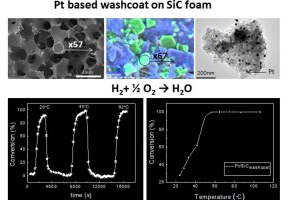
A commercial Pt based washcoat, used for catalytic methane combustion, was studied supported on a commercial SiC foam as catalytic material (Pt/SiC) for catalytic hydrogen combustion (CHC). Structural and chemical characterization was performed using Electron Microscopy, X-Ray Diffraction (XRD) and X-Ray Photoelectron Spectroscopy (XPS). The reaction was monitored following water concentration by Fourier Transform Infrared spectra (FTIR). The FTIR method was compared with H2 detection by Gas Cromatography (GC) and has shown to be adequate to study the kinetics of the CHC reaction in steady state under our experimental conditions (very lean 1% (v/v) H2/air mixtures). The catalyst is composed of 5–20 nm disperse Pt nanoparticles decorating a mixture of high surface area Al2O3 and small amounts of ceria supported on the SiC foam which also contains alumina as binder. The Pt/SiC catalytic material has demonstrated to be active enough to start up the reaction in a few seconds at room temperature. The material has been able to convert at least 18.5 Lhydrogen min−1 gPt−1 at room temperature in conditions of excess of catalyst. The Pt/SiC material was studied after use using XPS and no significant changes on Pt oxidation states were found. The material was characterized from a kinetic point of view. From the conversion-temperature plot a T50(temperature for 50% conversion) of 34 °C was obtained. Activation energy measured in our conditions was 35 ± 1 kJ mol−1.
The role of Au, Cu & CeO2 and their interactions for an enhanced WGS performance
Reina, TR; Ivanova, S; Centeno, MA; Odriozola, JA
Applied Catalysis B: Environmental, 187 (2016) 98-107 | DOI: 10.1016/j.apcatb.2016.01.031
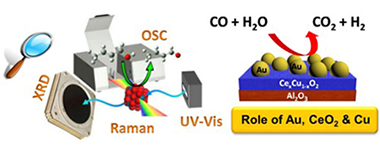
The WGS reaction over multicomponent Au/Ce1-xCuxO2/Al2O3 catalysts is studied in this work. The systems are carefully designed aiming to take advantage of every active phase included in the formulation: gold, ceria and copper. Special emphasis is given to the CeO2-CuO synergy and its influence on the displayed catalytic performance with and without gold. To this aim a meaningful correlation between the physicochemical properties of the mixed materials and their activity/stability is proposed. In general terms the developed catalysts present high activity under realistic WGS reaction conditions, with fairly good long term stability. In addition, the systems successfully withstand start-up/shut-downs situations, indispensable requisite for real applications in the field of pure hydrogen production for fuel cell goals.
Photocatalytic removal of patent blue V dye on Au-TiO2 and Pt-TiO2 catalysts
Vaiano, V; Iervolino, G; Sannino, D; Murcia, JJ; Hidalgo, MC; Ciambelli, P; Navio, JA
Applied Catalysis B: Environmental, 188 (2016) 134-146 | DOI: 10.1016/j.apcatb.2016.02.001
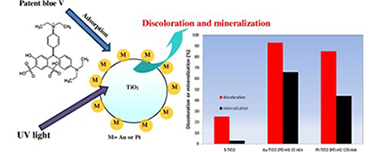
In this work it was studied the efficiency of a photocatalytic process for the removal of patent blue V. This dye is very difficult to remove by conventional treatments such as adsorption or coagulation therefore the photocatalytic process is a very interesting alternative for the removal this dye mainly because it does not require expensive oxidants and it can be carried out at mild temperatures and pressures. In this work it was tested the efficiency of Au-TiO2 and Pt-TiO2 photocatalysts in the Patent blue V removal. The Au-TiO2 catalysts were prepared by two different methods: chemical reduction and photochemical deposition; Pt-TiO2 catalysts were obtained only by photochemical deposition. In the synthesis of the catalysts prepared by photochemical deposition, it was evaluated the influence of some parameters, such as deposition time and the intensity of the light source over the physicochemical properties and photocatalytic activity of the materials obtained. An analysis of the effect of the catalyst dosage and initial patent blue V concentration over the dye degradation efficiency was also attempted.
In general, it was observed that the presence of Au or Pt on TiO2 enhances the patent blue V photodegradation; it was found that noble metal particle size and distribution on TiO2 surface are important factors influencing the dye removal. The highest dye degradation was obtained over the Au-TiO2 catalyst prepared by photochemical deposition, using high light intensity and 15 min of deposition time during the synthesis. A discoloration and a total organic carbon (TOC) removal of 93 and 67% respectively, were obtained over this material after 180 min of UV irradiation. These values are higher than that the obtained on S-TiO2 (discoloration and TOC removal of about 25% and 3%, respectively).
Three-Dimensional Optical Tomography and Correlated Elemental Analysis of Hybrid Perovskite Microstructures: An Insight into Defect-Related Lattice Distortion and Photoinduced Ion Migration
Galisteo-Lopez, JF; Li, YL; Miguez, H
Journal of Physical Chemistry Letters, 7 (2016) 5227-5234 | DOI: 10.1021/acsjpclett.6b02456
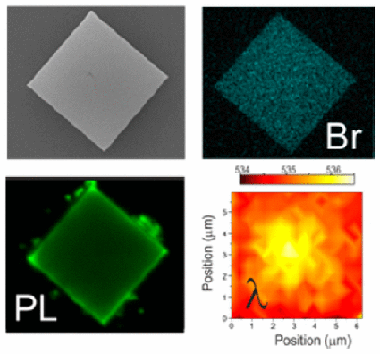
Organic lead halide perovskites have recently been proposed for applications in light-emitting devices of different sorts. More specifically, regular crystalline microstructures constitute an efficient light source and fulfill the geometrical requirements to act as resonators, giving rise to waveguiding and optical amplification. Herein we show three-dimensional laser scanning confocal tomography studies of different types of methylammonium lead bromide microstructures which have allowed us to dissect their photoemission properties with a precision of 0.036 mu m(3). This analysis shows that their spectral emission presents strong spatial variations which can be attributed to defect-related lattice distortions. It is also largely enhanced under light exposure, which triggers the migration of halide ions away from illuminated regions, eventually leading to a strongly anisotropic degradation. Our work points to the need for performing an optical quality test of individual crystallites prior to their use in optoelectronics devices and provides a means to do so.
Efficient bifacial dye-sensitized solar cells through disorder by design
Miranda-Munoz, JM; Carretero-Palacios, S; Jimenez-Solano, A; Li, YL; Lozano, G; Miguez, H
Journal of Materials Chemistry A, 4 (2016) 1953-1961 | DOI: 10.1039/C5TA10091G
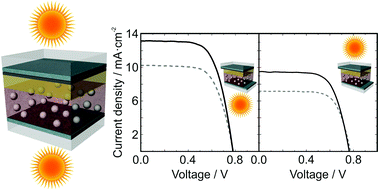
Herein we realize an optical design that optimizes the performance of bifacial solar cells without modifying any of the usually employed components. In order to do so, dielectric scatterers of controlled size and shape have been successfully integrated in the working electrodes of dye-sensitized solar cells (DSSCs), resulting in bifacial devices of outstanding performance. Power conversion efficiencies (PCEs) as high as 6.7% and 5.4% have been attained under front and rear illumination, respectively, which represent a 25% and a 33% PCE enhancement with respect to an 8 μm-thick standard solar cell electrode using platinum as the catalytic material. The remarkable bifacial character of our approach is demonstrated by the high rear/front efficiency ratio attained, around 80%, which is among the largest reported for this sort of device. The proposed optimized design is based on a Monte Carlo approach in which the multiple scattering of light within the cell is fully accounted for. We identified that the spherical shape of the scatterers is the key parameter controlling the angular distribution of the scattering, the most efficient devices being those in which the inclusions provide a narrow forward-oriented angular distribution of the scattered light.
Optical analysis of CH3NH3SnxPb1−xI3 absorbers: a roadmap for perovskite-on-perovskite tandem solar cells
Anaya, M.; Correa-Baena, J.P.; Lozano, G.; Saliba, M.; Anguita, P.; Roose, B.; Abate, A.; Steiner, U.; Gratzel, M.; Calvo, M.E.; Hagfeldt, A.; Míguez, H.
Journal lf Materials Chemistry A, 4 (2016) 11214-11221 | DOI: 10.1039/C6TA04840D
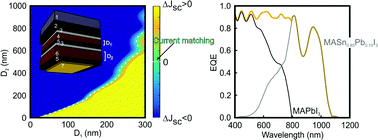
Organic–inorganic perovskite structures in which lead is substituted by tin are exceptional candidates for broadband light absorption. Herein we present a thorough analysis of the optical properties of CH3NH3SnxPb1−xI3 films, providing the field with definitive insights about the possibilities of these materials for perovskite solar cells of superior efficiency. We report a user's guide based on the first set of optical constants obtained for a series of tin/lead perovskite films, which was only possible to measure due to the preparation of optical quality thin layers. According to the Shockley–Queisser theory, CH3NH3xPb1−xI3 compounds promise a substantial enhancement of both short circuit photocurrent and power conversion efficiency in single junction solar cells. Moreover, we propose a novel tandem architecture design in which both top and bottom cells are made of perovskite absorbers. Our calculations indicate that such perovskite-on-perovskite tandem devices could reach efficiencies over 35%. Our analysis serves to establish the first roadmap for this type of cells based on actual optical characterization data. We foresee that this study will encourage the research on novel near-infrared perovskite materials for photovoltaic applications, which may have implications in the rapidly emerging field of tandem devices.
Optical sensing by integration of analyte-sensitive fluorophore to particles
Carrillo-Carrion, C; Escudero, A; Parak, WJ
TrAC Trends in Analytical Chemistry, 84 (2016) 84-85 | DOI: 10.1016/j.trac.2016.05.001
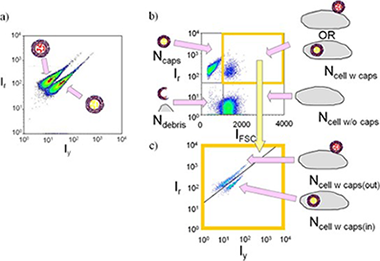
Analyte-sensitive fluorophores are a common tool in analytical chemistry. In case they are conjugated to the surface of colloidal nanoparticles new or improved applications are possible. An overview of the potential of such fluorophore-particle conjugates is given by means of several examples. First, using pH-sensitive fluorophores attached to particles are a helpful tool for investigating particle uptake by cells, as they can indicate whether particles are in the neutral slightly alkaline extracellular medium, or in acidic intracellular vesicles after endocytosis. Second, relating to lifetime-based methodologies, the fluorescence resonance energy transfer between fluorophores attached to quantum dots leads to longer lifetimes, improving their performance and expanding the possibilities of methods, such as lifetime imaging for in vivo applications. It also can be exploited for multiplexing approaches, in which the effective lifetime of the fluorophores can be tuned, allowing thus for the detection of several analytes based on temporal discrimination. Attention is focused to these three areas of application, because they are among the most reported in recent literature, and therefore of particular interest.
Growth Assisted by Glancing Angle Deposition: A New Technique to Fabricate Highly Porous Anisotropic Thin Films
Sanchez-Valencia, JR; Longtin, R; Rossell, MD; Groning, P
ACS Applied Materials & Interfaces, 8 (2016) 8686-8693 | DOI: 10.1021/acsami.6b00232
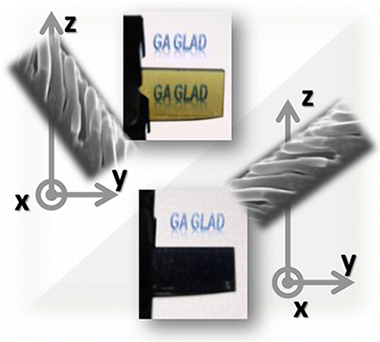
We report a new methodology based on glancing angle deposition (GLAD) of an organic molecule in combination with perpendicular growth of a second inorganic material. The resulting thin films retain a very well-defined tilted columnar microstructure characteristic of GLAD with the inorganic material embedded inside the columns. We refer to this new methodology as growth assisted by glancing angle deposition or GAGLAD, since the material of interest (here, the inorganic) grows in the form of tilted columns, though it is deposited under a nonglancing configuration. As a “proof of concept”, we have used silver and zinc oxide as the perpendicularly deposited material since they usually form ill-defined columnar microstructures at room temperature by GLAD. By means of our GAGLAD methodology, the typical tilted columnar microstructure can be developed for materials that otherwise do not form ordered structures under conventional GLAD. This simple methodology broadens significantly the range of materials where control of the microstructure can be achieved by tuning the geometrical deposition parameters. The two examples presented here, Ag/Alq3 and ZnO/Alq3, have been deposited by physical vapor deposition (PVD) and plasma enhanced chemical vapor deposition (PECVD), respectively: two different vacuum techniques that illustrate the generality of the proposed technique. The two type of hybrid samples present very interesting properties that demonstrate the potentiality of GAGLAD. On one hand, the Ag/Alq3 samples present highly optical anisotropic properties when they are analyzed with linearly polarized light. To our knowledge, these Ag/Alq3 samples present the highest angular selectivity reported in the visible range. On the other hand, ZnO/Alq3 samples are used to develop highly porous ZnO thin films by using Alq3 as sacrificial material. In this way, antireflective ZnO samples with very low refractive index and extinction coefficient have been obtained.
Electrochemical Energy Storage Applications of CVD Grown Niobium Oxide Thin Films
Fiz, Raquel; Appel, Linus; Gutierrez-Pardo, Antonio; Ramirez-Rico, Joaquin; Mathur, Sanjay
ACS Applied Materials & Interfaces, 8 (2016) 21423–21430 | DOI: 10.1021/acsami.6b03945
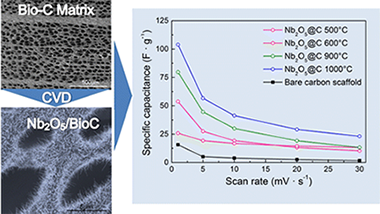
We report here on the controlled synthesis, characterization, and electrochemical properties of different polymorphs of niobium pentoxide grown by CVD of new single-source precursors. Nb2O5 films deposited at different temperatures showed systematic phase evolution from low-temperature tetragonal (TT-Nb2O5, T-Nb2O5) to high temperature monoclinic modifications (H–Nb2O5). Optimization of the precursor flux and substrate temperature enabled phase-selective growth of Nb2O5 nanorods and films on conductive mesoporous biomorphic carbon matrices (BioC). Nb2O5 thin films deposited on monolithic BioC scaffolds produced composite materials integrating the high surface area and conductivity of the carbonaceous matrix with the intrinsically high capacitance of nanostructured niobium oxide. Heterojunctions in Nb2O5/BioC composites were found to be beneficial in electrochemical capacitance. Electrochemical characterization of Nb2O5/BioC composites showed that small amounts of Nb2O5 (as low as 5%) in conjunction with BioCarbon resulted in a 7-fold increase in the electrode capacitance, from 15 to 104 F g–1, while imparting good cycling stability, making these materials ideally suited for electrochemical energy storage applications.
Laser Treatment of Nanoparticulated Metal Thin Films for Ceramic Tile Decoration
Rico, VJ; Lahoz, R; Rey-Garcia, F; Yubero, F; Espinos, JP; de la Fuente, GF; Gonzalez-Elipe, AR
Applied Materials & Interfaces, 8 (2016) 24880-24886 | DOI: 10.1021/acsami.6b07469
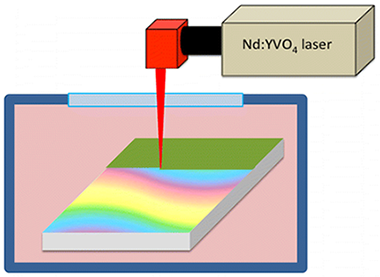
This paper presents a new method for the fabrication of metal-like decorative layers on glazed ceramic tiles. It consists of the laser treatment of Cu thin films prepared by electron-beam evaporation at glancing angles. A thin film of discontinuous Cu nanoparticles was electron-beam-evaporated in an oblique angle configuration onto ceramic tiles and an ample palette of colors obtained by laser treatment both in air and in vacuum. Scanning electron microscopy along with UV–vis–near-IR spectroscopy and time-of-flight secondary ion mass spectrometry analysis were used to characterize the differently colored layers. On the basis of these analyses, color development has been accounted for by a simple model considering surface melting phenomena and different microstructural and chemical transformations of the outmost surface layers of the samples.
Manganese Dioxide Supported on Porous Biomorphic Carbons as Hybrid Materials for Energy Storage Devices
Gutierrez-Pardo, A; Lacroix, B; Martinez-Fernandez, J; Ramirez-Rico, J
ACS Applied Materials & Interfaces, 8 (2016) 30890-30898 | DOI: 10.1021/acsami.6b09361
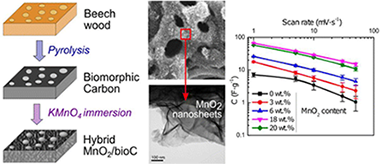
A facile and low-cost method has been employed to fabricate MnO2/C hybrid materials for use as binder-free electrodes for supercapacitor applications. Biocarbon monoliths were obtained through pyrolysis of beech wood, replicating the microstructure of the cellulosic precursor, and serve as 3D porous and conductive scaffolds for the direct growth of MnO, nanosheets by a solution method. Evaluation of the experimental results indicates that a homogeneous and uniform composite material made of a carbon matrix exhibiting ordered hierarchical porosity and MnO, nanosheets with a layered nanocrystalline structure is obtained. The tuning of the MnO2 content and crystallite size via the concentration of KMnO4 used as impregnation solution allows to obtain composites that exhibit enhanced electrochemical behavior, achieving a capacitance of 592 F g(-1) in electrodes containing 3 wt % MnO2 with an excellent cyclic stability. The electrode materials were characterized before and after electrochemical testing.
Template-Assisted Hydrothermal Growth of Aligned Zinc Oxide Nanowires for Piezoelectric Energy Harvesting Applications
Ou, C; Sanchez-Jimenez, PE; Datta, A; Boughey, FL; Whiter, RA; Sahonta, SL; Kar-Narayan, S
ACS Applied Materials & Interfaces, 8 (2016) 13678-13683 | DOI: 10.1021/acsami.6b04041
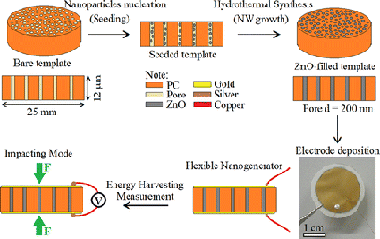
A flexible and robust piezoelectric nanogenerator (NG) based on a polymer-ceramic nanocomposite structure has been successfully fabricated via a cost-effective and scalable template assisted hydrothermal synthesis method. Vertically aligned arrays of dense and uniform zinc oxide (ZnO) nanowires (NWs) with high aspect ratio (diameter similar to 250 nm, length similar to 12 mu m) were grown within nanoporous polycarbonate (PC) templates. The energy conversion efficiency was found to be similar to 4.2%, which is comparable to previously reported values for ZnO NWs. The resulting NG is found to have excellent fatigue performance, being relatively immune to detrimental environmental factors and mechanical failure, as the constituent ZnO NWs remain embedded and protected inside the polymer matrix.
Synthesis and functionalization of monodisperse near-ultraviolet and visible excitable multifunctional Eu3+, Bi3+:REVO4 nanophosphors for bioimaging and biosensing applications
Escudero, Alberto; Carrillo-Carrion, Carolina; Zyuzin, Mikhail V.; Ashraf, Sumaira; Hartmann, Raimo; Nunez, Nuria O.; Ocana, Manuel; Parak, Wolfgang J.
Nanoscale, 8 (2016) 12221-12236 | DOI: 10.1039/C6NR03369E
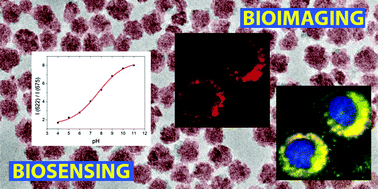
Near-ultraviolet and visible excitable Eu- and Bi-doped NPs based on rare earth vanadates (REVO4, RE = Y, Gd) have been synthesized by a facile route from appropriate RE precursors, europium and bismuth nitrate, and sodium orthovanadate, by homogeneous precipitation in an ethylene glycol/water mixture at 120 °C. The NPs can be functionalized either by a one-pot synthesis with polyacrylic acid (PAA) or by a Layer-by-Layer approach with poly(allylamine hydrochloride) (PAH) and PAA. In the first case, the particle size can also be tuned by adjusting the amount of PAA. The Eu- Bi-doped REVO4 based nanophosphors show the typical red luminescence of Eu(III), which can be excited through an energy transfer process from the vanadate anions, resulting in a much higher luminescence intensity in comparison to the direct excitation of the europium cations. The incorporation of Bi into the REVO4 structure shifts the original absorption band of the vanadate anions towards longer wavelengths, giving rise to nanophosphors with an excitation maximum at 342 nm, which can also be excited in the visible range. The suitability of such nanophosphors for bioimaging and biosensing applications, as well as their colloidal stability in different buffer media of biological interest, their cytotoxicity, their degradability at low pH, and their uptake by HeLa cells have been evaluated. Their suitability for bioimaging and biosensing applications is also demonstrated.
The Calcium-Looping technology for CO2 capture: On the important roles of energy integration and sorbent behavior
Perejon, A; Romeo, LM; Lara, Y; Lisbona, P; Martinez, A; Valverde, JM
Applied Energy, 162 (2016) 787-807 | DOI: 10.1016/j.apenergy.2015.10.121
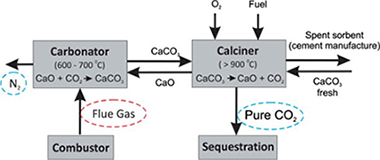
The Calcium Looping (CaL) technology, based on the multicyclic carbonation/calcination of CaO in gas-solid fluidized bed reactors at high temperature, has emerged in the last years as a potentially low cost technology for CO2 capture. In this manuscript a critical review is made on the important roles of energy integration and sorbent behavior in the process efficiency. Firstly, the strategies proposed to reduce the energy demand by internal integration are discussed as well as process modifications aimed at optimizing the overall efficiency by means of external integration. The most important benefit of the high temperature CaL cycles is the possibility of using high temperature streams that could reduce significantly the energy penalty associated to CO2 capture. The application of the CaL technology in precombustion capture systems and energy integration, and the coupling of the CaL technology with other industrial processes are also described. In particular, the CaL technology has a significant potential to be a feasible CO2 capture system for cement plants. A precise knowledge of the multicyclic CO2 capture behavior of the sorbent at the CaL conditions to be expected in practice is of great relevance in order to predict a realistic capture efficiency and energy penalty from process simulations. The second part of this manuscript will be devoted to this issue. Particular emphasis is put on the behavior of natural limestone and dolomite, which would be the only practical choices for the technology to meet its main goal of reducing CO2 capture costs. Under CaL calcination conditions for CO2 capture (necessarily implying high CO2 concentration in the calciner), dolomite seems to be a better alternative to limestone as CaO precursor. The proposed techniques of recarbonation and thermal/mechanical pretreatments to reactivate the sorbent and accelerate calcination will be the final subjects of this review.
A Full Vacuum Approach for the Fabrication of Hybrid White-Light-Emitting Thin Films and Wide-Range In Situ Tunable Luminescent Microcavities
Y. Oulad-Zian, J.R. Sánchez-Valencia, M. Oliva, J. Parra-Barranco, M. Alcaire, F.J. Aparicio, A. Mora-Boza, J.P. Espinós, F. Yubero, A.R. González-Elipe, A. Barranco, A. Borras
Advanced Optical Materials, 4 (2016) 1134 | DOI: 10.1002/adom.201670041
A wide-range in situ tunable 1D Bragg microcavity including a hybrid layer as white light emitter defect is shown by J. R. Sanchez-Valencia, A. Borras, and co-workers on page 1124. White emission is obtained by Förster resonance energy transfer between blue (1,3,5-triphenyl-2-pyrazoline) and orange (rubrene) dyes homogeneously infiltrated within the host nanocolumnar SiO2film, which is formed by glancing angle deposition. Sequential physical vapor deposition at low temperatures provides the organic dyes localization within the porous nanostructure of the defect layer.
Integration of Photonic Crystals into Flexible Dye Solar Cells: A Route toward Bendable and Adaptable Optoelectronic Devices Displaying Structural Color and Enhanced Efficiency
Li, YL; Calvo, ME; Miguez, H
Advanced Optical Materials, 4 (2016) 464-471 | DOI: 10.1002/adom.201500547
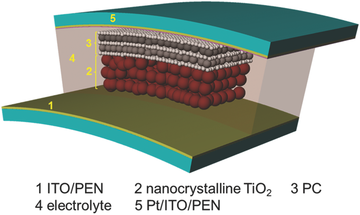
Herein is presented what is believed to be the first example of integration of photonic structures in a flexible optoelectronic device. The resulting devices may be designed to display any color in the visible range and, simultaneously, present enhanced power conversion efficiency as a consequence of the increased light harvesting caused by the colored back reflection. The achievement results from the incorporation of nanoparticle-based multilayers with photonic crystal properties that are modified to be compatible with the chemical and physical processing of flexible nanocrystalline titania electrodes of dye solar cells. The photovoltaic performance of these colored flexible cells remains unaltered after one hundred bending cycles, thus showing the high-mechanical stability of the ensemble. These devices reunite most characteristics required for building integration or for the construction of solar window panes, such as light weight, stability upon bending, adaptability, and color. This work may trigger promising applications of these highly adaptable and versatile photonic crystals in other flexible devices.
Photocatalytic hydrogen production from degradation of glucose over fluorinated and platinized TiO2 catalysts
Iervolino, G; Vaiano, V; Murcia, JJ; Rizzo, L; Ventre, G; Pepe, G; Campiglia, P; Hidalgo, MC; Navio, JA; Sannino, D
Journal of Catalysis, 339 (2016) 47-56 | DOI: 10.1016/j.jcat.2016.03.032
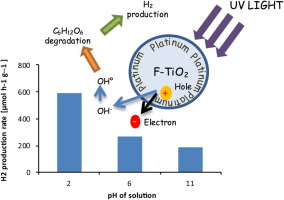
The present work reports the renewable hydrogen production by photocatalytic degradation of glucose over commercial and home prepared TiO2 modified by the simultaneous presence of fluorine and Pt (Pt-F-TiO2). The obtained materials were widely characterized by different techniques (XRD, SBF, UV-Vis DRS, XRF, SEM and TEM) and it was found that surface area, anatase/rutile ratio and the distribution and size of the platinum particles are important factors influencing the effectiveness of these materials in the H-2 production. The photocatalytic H-2 production from the glucose solution was 97 mu mol of H-2 after 3 h of irradiation on home prepared TiO2 modified by F and Pt addition, while a lower value corresponding to 31 mu mol of H-2 was obtained on commercial TiO2 modified by F and Pt, after 3 h of irradiation. The hydrogen production rate increased by decreasing the initial pH of solution reaching the highest value of about 590 mu mol h(-1) g(-1) after 3 h of irradiation time at pH = 2. Accordingly, sugar containing wastewaters from food industry has the potential for producing hydrogen by photocatalytic process while removing organics before disposal or reuse.
Synthesis, characterization and performance of robust poison resistant ultrathin film yttria stabilized zirconia nickel anodes for application in solid electrolyte fuel cells
Garcia-Garcia, FJ; Yubero, F; Espinos, JP; Gonzalez-Elipe, AR; Lambert, RM
Journal of Power Sources, 324 (2016) 679-686 | DOI: 10.1016/j.jpowsour.2016.05.124
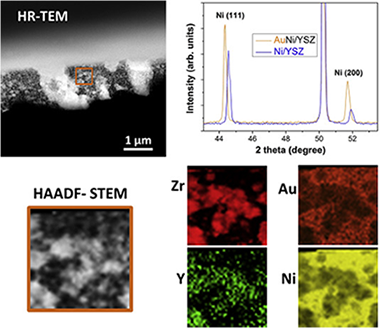
We report on the synthesis of undoped ∼5 μm YSZ-Ni porous thin films prepared by reactive pulsed DC magnetron sputtering at an oblique angle of incidence. Pre-calcination of the amorphous unmodified precursor layers followed by reduction produces a film consisting of uniformly distributed tilted columnar aggregates having extensive three-phase boundaries and favorable gas diffusion characteristics. Similarly prepared films doped with 1.2 at.% Au are also porous and contain highly dispersed gold present as Ni-Au alloy particles whose surfaces are strongly enriched with Au. With hydrogen as fuel, the performance of the undoped thin film anodes is comparable to that of 10–20 times thicker typical commercial anodes. With a 1:1 steam/carbon feed, the un-doped anode cell current rapidly falls to zero after 60 h. In striking contrast, the initial performance of the Au-doped anode is much higher and remains unaffected after 170 h. Under deliberately harsh conditions the performance of the Au-doped anodes decreases progressively, almost certainly due to carbon deposition. Even so, the cell maintains some activity after 3 days operation in dramatic contrast with the un-doped anode, which stops working after only three hours of use. The implications and possible practical application of these findings are discussed.
Isotope labelling to study molecular fragmentation during the dielectric barrier discharge wet reforming of methane
Montoro-Damas, AM; Gomez-Ramirez, A; Gonzalez-Elipe, AR; Cotrino, J
Journal of Power Sources, 325 (2016) 501-505 | DOI: 10.1016/j.jpowsour.2016.06.028
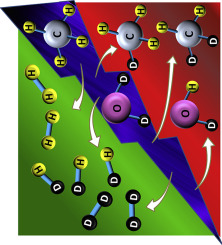
Isotope labelling is used to study the wet plasma reforming of methane in a dielectric barrier discharge reactor using D2O and CH4 as reactants. Besides the formation of CO and hydrogen as main products, different partitions of H and D atoms are found in the hydrogen (i.e., Hz, HD, D-2), methane (i.e., CH4, CH3D and CH2D2) and water (D2O, DHO) molecules detected by mass spectrometry as outlet gases of the plasma process. The effect of operating parameters such as applied current, residence time and the addition of oxygen to the reaction mixture is correlated with the H/D distribution in these molecules, the overall reaction yield and the energetic efficiency of the process. The results prove the plasma formation of intermediate excited species that rendering water and methane instead of CO and hydrogen greatly contribute to decrease the overall energy efficiency of the reforming process.
A panchromatic modification of the light absorption spectra of metal-organic frameworks
Otal, E. H.; Kim, M. L.; Calvo, M. E.; Karvonen, L.; Fabregas, I. O.; Sierra, C. A.; Hinestroza, J. P.
Chemical Communications, 52 (2016) 6665-6668 | DOI: 10.1039/c6cc02319c
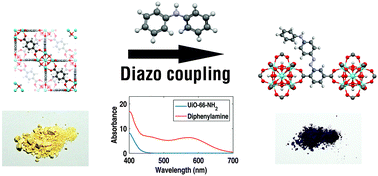
The optical absorption of UiO-66–NH2 MOF was red-shifted using a diazo-coupling reaction. The modifications performed with naphthols and aniline yielded reddish samples, and the modifications with diphenylaniline yielded dark violet ones. The photocatalytic activity of these modified MOFs was assessed for methylene blue degradation, showing a good performance relative to traditional TiO2. The degradation performance was found to correlate with the red shift of the absorption edge. These findings suggest potential applications of these materials in photocatalysis and in dye sensitized solar cells.
Intensifying glycerol steam reforming on a monolith catalyst: A reaction kinetic model
Bobadilla, LF; Blay, V; Alvarez, A; Dominguez, MI; Romero-Sarria, F; Centeno, MA; Odriozola, JA
Chemical Engineering Journal, 306 (2016) 933–941 | DOI: 10.1016/j.cej.2016.08.021
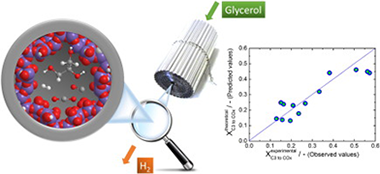
In this work, a structured monolithic catalyst has been tested under a wide range of conditions (partial pressure, residence time, temperature and time-on-stream), with the aim of modeling its kinetic behavior and assessing its economic and upscaling potential. We have developed a sequential model to help us interpret both main trends and salient features. Unexpected behavior was found for certain parameter values, which led us to consider kinetic parasitic effects such as mass or heat transfer limitations. By independently invoking these effects, a conciliatory view of the results observed could not be reached. A combined explanation may prove successful, although overfitting could not be ruled out at this point. More importantly, however, the observed salient features of this stable and selective monolith catalyst may hold potential for process intensification of glycerol steam reforming, thus contributing to a more sustainable industry.
Forced deactivation and postmortem characterization of a metallic microchannel reactor employed for the preferential oxidation of CO (PROX)
Laguna, OH; Dominguez, MI; Centeno, MA; Odriozola, JA
Chemical Engineering Journal, 302 (2016) 650-662 | DOI: 10.1016/j.cej.2016.05.104
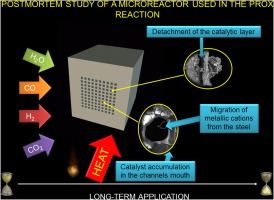
This manuscript is one of the few works presenting evidences of the effect of prolonged use of a microreactor. Our reactor has been designed for the PROX reaction. Near to 550 h of operation under different feed-streams, including CO2 and H2O, in the 100-300 degrees C temperature range, and several regeneration cycles, and a final forced deactivation during similar to 360 h resulted in the permanent loss of activity of the microreactor. This could be attributed to some phenomena whose have compromised the chemical nature of the catalyst and that of the reactor including: displacement of the coating to the mouth of the channels, detachments and cracks of the catalytic layer, migration of some elements of the metallic substrate to the surface (Fe, Cr, Y), and deposition of carbonaceous species from the reaction over the catalytic layer and/or the metallic substrate. Furthermore, sulfur compounds were detected in both inlet and outlet zones of the microreactor, coming probably from a lubricant applied over the screws that sealed the assembling of the microreactor.
This is a first approach for understanding possible effects of deactivation during long-term applications of a microreactor in the PROX reaction that could be considered as a case study useful for future designs of this kind of devices. The presented information could be extrapolated to similar reactions where thermal treatments along with highly corrosive atmospheres would be applied, in order to carry out a more appropriate design of future generations" of microreactors, with a longer useful life. For that purpose not only the adequate selection of the catalysts must be done, but also the adequate choice of the fabrication material of the reactors is needed.
Influence of temperature and time on the Eu3+ reaction with synthetic Na-Mica-n (n=2 and 4)
Garcia-Jimenez, MJ; Cota, A; Osuna, FJ; Pavon, E; Alba, MD
Chemical Engineering Journal, 284 (2016) 1174-1183 | DOI: 10.1016/j.cej.2015.09.077
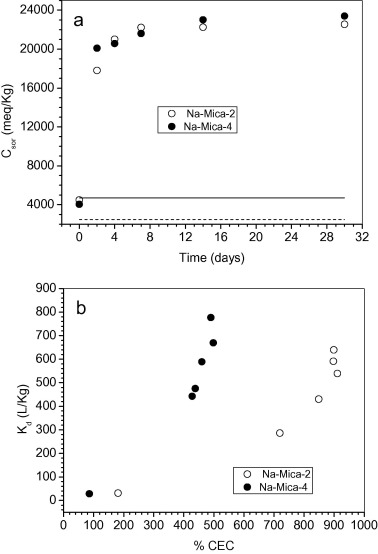
Bentonite is accepted as the best clay material for the engineered barrier of Deep Geological Repositories (DGRs). The performance of clay as the main component of the engineered barrier in the DGR has been intensively studied and the structure of the selected clay mineral play a crucial role. In this sense, a new family of synthetic swelling silicates, Na-Mica-n, with tuned layer charge (n) values between 2.0 and 4.0 per unit cell has recently been synthesized and a general synthetic method has been reported. These swelling high-charge micas could be highly valuable for the decontamination of harmful cations. The ability of these micas to immobilize Eu3+ under subcritical conditions has been probed. The adsorption was in both non-specific sites (cation exchange mechanism) and specific sites (chemical reaction or surface defects adsorption). Moreover, its adsorption capacity, under the same conditions is higher than in saponite and far superior to the bentonites.
Hot-pressing of (Ti,Mt)(C,N)-Co-Mo2C (Mt = Ta,Nb) powdered cermets synthesized by a mechanically induced self-sustaining reaction
Chicardi, E; Gotor, FJ; Medri, V; Guicciardi, S; Lascano, S; Cordoba, JM
Chemical Engineering Journal, 292 (2016) 51-61 | DOI: 10.1021/acsami.6b00232
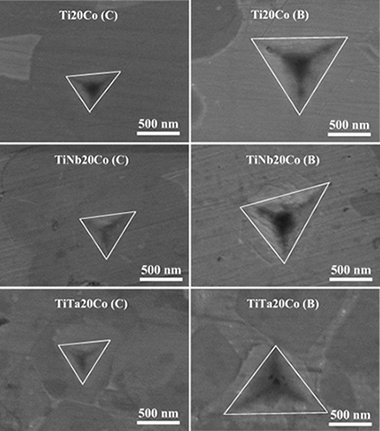
A mechanically induced self-sustaining reaction (MSR) has been successfully employed for manufacturing powdered cermets based on Ti, Ti–Ta and Ti–Nb carbonitrides using Co as the binder phase and Mo2C as the sintering additive. The powders were sintered by hot-pressing, and complete chemical, microstructural and mechanical characterizations were performed on the densified cermets. When elemental Ta, Nb and/or Mo2C were added to the initial raw mixture submitted to the MSR process, smaller ceramic grains were observed after sintering, which suggested that ceramic particle growth was hindered by the presence of Ta, Nb and/or Mo in the host titanium carbonitride structure. Nanoindentation measurements enabled the determination of the hardness of the ceramic and binder phases, and values in the range of 26–29 GPa and 14–16 GPa were found, respectively. The high hardness values of the binder were related to the formation of intermetallic phases.
Effect of TiO2-Pd and TiO2-Ag on the photocatalytic oxidation of diclofenac, isoproturon and phenol
Espino-Estevez, MR; Fernandez-Rodriguez, C; Gonzalez-Diaz, OM; Arana, J; Espinos, JP; Ortega-Mendez, JA; Dona-Rodriguez, JM
Chemical Engineering Journal, 298 (2016) 82-95 | DOI: 10.1016/j.cej.2016.04.016
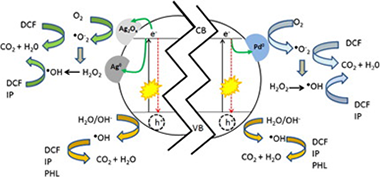
The effects of silver and palladium metals on the photocatalytic degradation of diclofenac sodium salt (DCF), isoproturon (IP) and phenol (PHL) in water over lab-made TiO2 synthesized following a sol-gel method were investigated. Silver and palladium catalysts were prepared by photodeposition at 1 wt.% of loading metal. The resulting materials were characterized through BET, XRD, TEM, SEM, XPS and DRS-UV-Vis. The photodeposition test conditions of both metals determined their final oxidation state, with reduced particles of palladium and silver as well as silver oxides found on the catalysts. The results showed that the type of metal had different effects on the photodegradation mechanism depending on the nature of the pollutants. Accordingly, the highest degradation rate for IP and DCF was obtained when using the catalyst photodeposited with palladium and for PHL the catalyst photodeposited with silver. The photodegradation intermediates of PHL, DCF and IP were also identified.
Dye-based photonic sensing systems
Aparicio, FJ; Alcaire, M; Gonzalez-Elipe, AR; Barranco, A; Holgado, M; Casquel, R; Sanza, FJ; Griol, A; Bernier, D; Dortu, F; Caceres, S; Antelius, M; Lapisa, M; Sohlstrom, H; Niklaus, F
Sensors and Actuators B: Chemical, 228 (2016) 649-657 | DOI: 10.1016/j.snb.2016.01.092
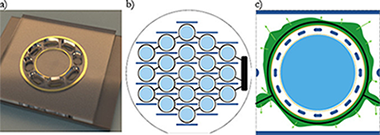
We report on dye-based photonic sensing systems which are fabricated and packaged at wafer scale. For the first time luminescent organic nanocomposite thin-films deposited by plasma technology are integrated in photonic sensing systems as active sensing elements. The realized dye-based photonic sensors include an environmental NO2 sensor and a sunlight ultraviolet light (UV) A+B sensor. The luminescent signal from the nanocomposite thin-films responds to changes in the environment and is selectively filtered by a photonic structure consisting of a Fabry-Perot cavity. The sensors are fabricated and packaged at wafer-scale, which makes the technology viable for volume manufacturing. Prototype photonic sensor systems have been tested in real-world scenarios.
Glutamate microbiosensors based on Prussian Blue modified carbon fiber electrodes for neuroscience applications: In-vitro characterization
Salazar, P; Martin, M; O'Neill, RD; Gonzalez-Mora, JL
Sensors and Actuators B: Chemical, 235 (2016) 117-125 | DOI: 10.1016/j.snb.2016.05.057
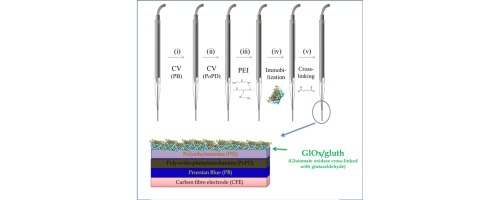
Herein we report a Prussian Blue modified carbon fiber electrode (CFE/PB) to be used in microbiosensors for glutamate monitoring in physiological applications as an alternative to the classical Pt and Pt-Ir transducers. Their low dimensions (∼250 μm CFE length and ∼10 μm diameter) are advantageous for measuring in living tissues. In addition, PB-modified microelectrodes allow the detection of enzyme-generated hydrogen peroxide at a low applied potential (∼0.0 V against SCE), contrasting the high potential used in many previous designs (∼0.7 V), decreasing the endogenous interference contributions. Moreover, the electrosynthesized polymer, poly-o-phenylenediamine (PoPD), was used to improve biosensor stability and selectivity. CFE/PB was conveniently characterized using impedance, Raman and XPS spectroscopies. Optimization of the fabrication procedure and analytical conditions is described, including activation of CFE/PB, enzyme enrichment, cross-linking, stabilization and anti-interference. A range of analytical parameters were also characterized such as sensitivity, limit of detection, linear range, and enzymatic loading. Finally, an optimized biosensor displaying a linear sensitivity of 135 ± 2 nA μM−1 cm−2 (n = 3), LOD of <2 μM, linear range up to 150 μM and effectively free of interference, is proposed as a suitable candidate for in-vivo glutamate monitoring in the central nervous system.
Reduced graphene oxide-carboxymethylcellulose layered with platinum nanoparticles/PAMAM dendrimer/magnetic nanoparticles hybrids. Application to the preparation of enzyme electrochemical biosensors
Borisova, B; Sanchez, A; Jimenez-Falcao, S; Martin, M; Salazar, P; Parrado, C; Pingarron, JM; Villalonga, R
Sensors and Actuators B-Chemical, 232 (2016) 84-90 | DOI: 10.1016/j.snb.2016.02.106
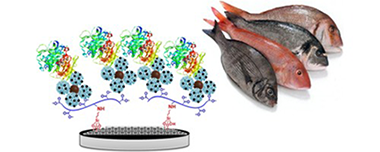
The assembly of a novel layer-by-layer biosensor architecture using hybrid nanomaterials is explored for the construction of an amperometric enzyme biosensors. The nanostructured sensing interface was prepared with poly(dopamine)-modified magnetic nanoparticles which were covalently coated with four-generation ethylenediamine core polyamidoamine G-4 dendrimers and further decorated with platinum nanoparticles. This nanohybrid was fully characterized and further layered on glassy carbon electrodes coated with a graphene oxide-carboxymethylcellulose hybrid nanomaterial through electrostatic interactions. The nanostructured surface was then employed as scaffold for the covalent immobilization of the enzyme xanthine oxidase through a glutaraldehyde-mediated cross-linking. The enzyme electrode allowed the amperometric detection of xanthine in the 50 nM-12 mu M range, with a high sensitivity of 140 mA/M cm(2) and low detection limit of 13 nM. The biosensor exhibited high reproducibility and repeatability, and was successfully tested for the quantification of xanthine in fish samples.
Nickel-copper bilayer nanoporous electrode prepared by physical vapor deposition at oblique angles for the non-enzymatic determination of glucose
Salazar, P; Rico, V; Gonzalez-Elipe, AR
Sensors and Actuators B: Chemical, 226 (2016) 436-443 | DOI: 10.1016/j.snb.2015.12.003
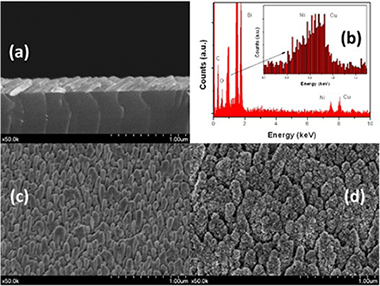
This work presents a novel bilayer Ni/Cu porous nanostructured film electrode prepared by physical vapor deposition (PVD) in an oblique angle configuration. Scanning electron microscopy (SEM) data revealed that the film, with an approximate thickness of 200 nm, is formed by tilted nanocolumns of around 50 nm of diameter and an inclination of 30° with respect to the surface normal. X ray photoelectron spectroscopy (XPS) data confirmed a bilayer configuration with Cu and Ni located at the top and bottom parts of the film, respectively. A porosity of ca. 45–35% as determined by Rutherford back scattering (RBS) offered a large exposed area and excellent diffusion properties that, combined with a very good catalytic activity, rendered these films excellent electrodes for the quantitative determination of glucose. Under optimized working conditions of detection these electrodes presented a high sensitivity of 2.53 A M−1 cm−2 (R2: 0.999), a limit of detection of 0.23 μM and a time response of ca. 2 s. The sensors did not show any loss of response during a period of 4 months. The selectivity of the sensor was checked against various interferences, including physiological compounds, different sugars and ethanol, in all cases with excellent results. The feasibility of using of this sensor for practical applications was confirmed by successfully determining the glucose content in different commercial beverages.
A hybrid silver-magnetite detector based on surface enhanced Raman scattering for differentiating organic compounds
Caro, C; Sayagues, MJ; Franco, V; Conde, A; Zaderenko, P; Gamez, F
Sensors and Actuators B: Chemical, 228 (2016) 124-133 | DOI: 10.1016/j.snb.2016.01.003
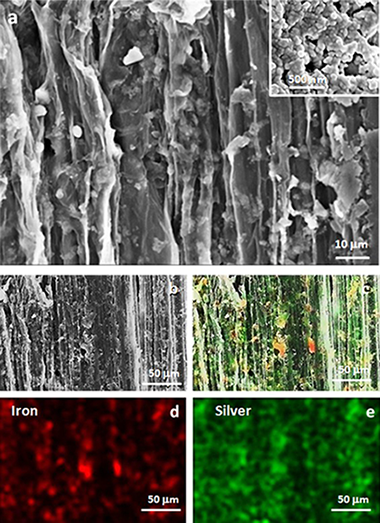
In this work a cheap detector of organic molecules is developed. It comprises a cellulose fiber doped with a mixture of magnetite and reduced silver nanoparticles, the latter ones synthesized anew. The nanoparticles and the fiber were characterized with well-established spectroscopic, microscopic and magnetic techniques, namely infrared, UV–vis spectroscopies, vibrating sample magnetometry and electronic microscopies. The so-obtained doped-fibers were tested as surface enhanced Raman spectroscopy detector in aqueous samples with a diluted mixture of two pollutant models (rhodamine 6G and picric acid), being able to differentiate between both organic compounds. Hence, the nanoparticle-impregnated fiber is proposed as a reliable preliminary qualitative and semiquantitative test of the presence of specific organic molecules in solutions. Moreover, the magnetite nanoparticles provide the detector with a saturation magnetization value that enables the separation of the fiber from the solution with the aid of a commercial magnet.
Transparent polycrystalline SrREGa3O7 melilite ceramics: potential phosphors for tuneable solid state lighting
Boyer, M; Carrion, AJF; Ory, S; Becerro, AI; Villette, S; Eliseeva, SV; Petoud, S; Aballea, P; Matzen, G; Allix, M
Journal of Materials Chemistry C, 15 (2016) 3238-3247 | DOI: 10.1039/C6TC00633G
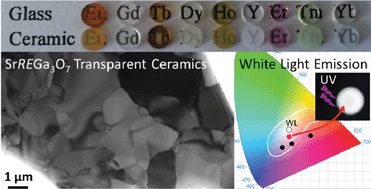
Full and congruent crystallization from glass is applied to the SrREGa3O7 melilite family (RE = Eu, Gd, Tb, Dy, Ho, Er, Tm, Yb and Y). This innovative process enables the synthesis of polycrystalline ceramics exhibiting high transparency both in the visible and near infrared regions, despite tetragonal crystal structures and micrometer scale grain sizes. Moreover, glass crystallization provides an original route to synthesize new crystalline phases which are not accessible via a classic solid state reaction, as demonstrated for SrYbGa3O7 and SrTmGa3O7. To illustrate the potential optical applications of such materials, SrGdGa3O7 transparent polycrystalline ceramics are doped with Dy3+ or Tb3+/Eu3+ in order to generate white light emission under UV excitation. It is foreseen that such transparent melilite ceramic phosphors, prepared via a cost-effective process, can be successfully used in solid state lighting devices of considerable technological interest.
Solution processed high refractive index contrast distributed Bragg reflectors
Anaya, M; Rubino, A; Calvo, ME; Miguez, H
Journal of Materials Chemistry C, 4 (2016) 4532-4537 | DOI: 10.1039/C6TC00663A
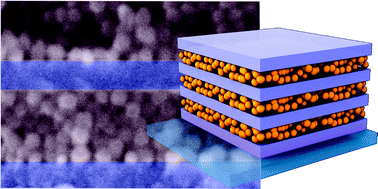
We have developed a method to alternate porous and dense dielectric films in order to build high refractive index contrast distributed Bragg reflectors (DBRs) capable of reflecting very efficiently in a targeted spectral range employing a small number of layers in the stack. Porous layers made of SiO2 nanoparticles and compact sol–gel processed TiO2 layers are sequentially deposited. The key to the preservation of porosity of every other layer during the deposition process is the use of a sacrificial layer of polystyrene that prevents the infiltration of the interstitial voids between nanoparticles with the homogeneous solution of TiO2 precursors. Our approach allows preparing a series of DBRs operating along the whole visible spectral range. Reflectance values as high as 90% are achieved from only seven layers. The particular distribution of porosity along one direction gives rise to an interesting interplay between the optical properties of the system and the vapor pressure in the surrounding atmosphere, which we foresee could be put into practice in gas sensing devices.
High temperature oxidation resistance of (Ti,Ta)(C,N)-based cermets
Chicardi, E; Cordoba, JM; Gotor, FJ
Corrosion Science, 102 (2016) 125-136 | DOI: 10.1016/j.corsci.2015.10.001
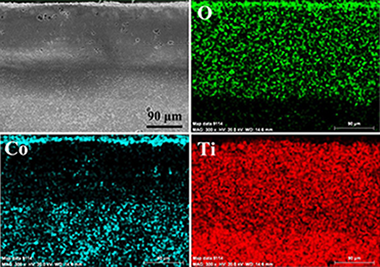
Cermets based on titanium-tantalum carbonitride were oxidized in static air between 800 degrees C and 1100 degrees C for 48 h. The thermogravimetric and microstructural study showed an outstanding reduction in the oxidation of more than 90% when the Ta content was increased. In cermets with low Ta content, the formation of a thin CoO/Co3O4 outer layer tends to disappear by reacting with the underlying rutile phase, which emerges at the surface. However, in cermets with higher Ta content, the formation of an external titanate layer, observed even at a low temperature, appears to prevent the oxygen diffusion and the oxidation progression.
Kinetics of high-temperature oxidation of (Ti,Ta)(C,N)-based cermets
Chicardi, E; Cordoba, JM; Gotor, FJ
Corrosion Science, 102 (2016) 168-177 | DOI: 10.1016/j.corsci.2015.10.006
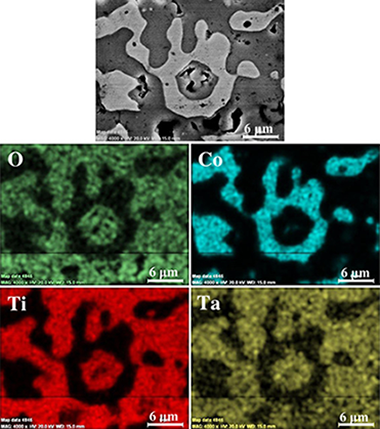
The kinetics of the high-temperature oxidation of titanium–tantalum carbonitride-based cermets with different Ti/Ta ratios was studied. Isothermal oxidation tests were conducted under static air for 48 h at temperatures between 700 °C and 1200 °C. The oxidation satisfied the parabolic kinetics, characteristic of the existence of a protective oxide layer. The apparent activation energy suggests the rate-controlling process during oxidation is the simultaneous inward and outward diffusion of oxygen and titanium, respectively, through the formed protective layer, consisting mainly of a rutile phase. A higher Ta(V) content in the rutile decreased the oxygen diffusivity due to the reduction of oxygen vacancy concentration.
Vacuum template synthesis of multifunctional nanotubes with tailored nanostructured walls
Filippin, AN; Macias-Montero, M; Saghi, Z; Idigoras, J; Burdet, P; Barranco, A; Midgley, P; Anta, JA; Borras, A
Scientific Reports, 5 (2016) 20637 | DOI: 10.1038/srep20637
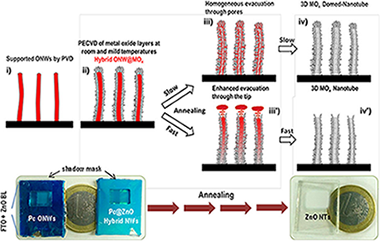
A three-step vacuum procedure for the fabrication of vertical TiO2 and ZnO nanotubes with three dimensional walls is presented. The method combines physical vapor deposition of small-molecules, plasma enhanced chemical vapor deposition of inorganic functional thin films and layers and a post-annealing process in vacuum in order to remove the organic template. As a result, an ample variety of inorganic nanotubes are made with tunable length, hole dimensions and shapes and tailored wall composition, microstructure, porosity and structure. The fabrication of multishell nanotubes combining different semiconducting oxides and metal nanoparticles is as well explored. This method provides a feasible and reproducible route for the fabrication of high density arrays of vertically alligned nanotubes on processable substrates. The emptying mechanism and microstructure of the nanotubes have been elucidated through SEM, STEM, HAADF-STEM tomography and energy dispersive X-ray spectroscopy. In this article, as a proof of concept, it is presented the straightforward integration of ZnO nanotubes as photoanode in a photovoltaic cell and as a photonic oxygen gas sensor.
Highly Efficient Perovskite Solar Cells with Tunable Structural Color
W. Zhang, M. Anaya, G. Lozano, M.E. Calvo, M.B. Johnston, H. Míguez, H.J. Snaith
Nano Letters, 15 (2015) 1698-1702 | DOI: 10.1021/nl504349z
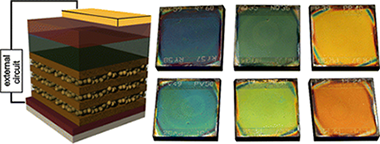
The performance of perovskite solar cells has been progressing over the past few years and efficiency is likely to continue to increase. However, a negative aspect for the integration of perovskite solar cells in the built environment is that the color gamut available in these materials is very limited and does not cover the green-to-blue region of the visible spectrum, which has been a big selling point for organic photovoltaics. Here, we integrate a porous photonic crystal (PC) scaffold within the photoactive layer of an opaque perovskite solar cell following a bottom-up approach employing inexpensive and scalable liquid processing techniques. The photovoltaic devices presented herein show high efficiency with tunable color across the visible spectrum. This now imbues the perovskite solar cells with highly desirable properties for cladding in the built environment and encourages design of sustainable colorful buildings and iridescent electric vehicles as future power generation sources.
Sonogashira Cross-Coupling and Homocoupling on a Silver Surface: Chlorobenzene and Phenylacetylene on Ag(100)
Sanchez-Sanchez, C; Orozco, N; Holgado, JP; Beaumont, SK; Kyriakou, G; Watson, DJ; Gonzalez-Elipe, AR; Feria, L; Sanz, JF; Lambert, RM
Journal of the American Chemical Society, 137 (2015) 940-947 | DOI: 10.1021/ja5115584
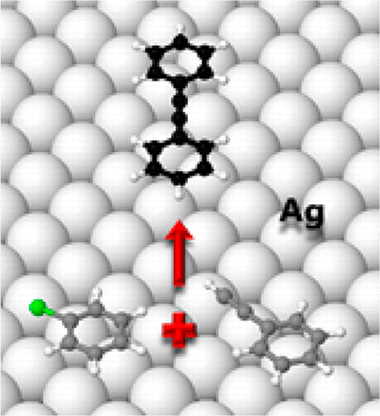
Scanning tunneling microscopy, temperature-programmed reaction, near-edge X-ray absorption fine structure spectroscopy, and density functional theory calculations were used to study the adsorption and reactions of phenylacetylene and chlorobenzene on Ag(100). In the absence of solvent molecules and additives, these molecules underwent homocoupling and Sonogashira cross-coupling in an unambiguously heterogeneous mode. Of particular interest is the use of silver, previously unexplored, and chlorobenzene—normally regarded as relatively inert in such reactions. Both molecules adopt an essentially flat-lying conformation for which the observed and calculated adsorption energies are in reasonable agreement. Their magnitudes indicate that in both cases adsorption is predominantly due to dispersion forces for which interaction nevertheless leads to chemical activation and reaction. Both adsorbates exhibited pronounced island formation, thought to limit chemical activity under the conditions used and posited to occur at island boundaries, as was indeed observed in the case of phenylacetylene. The implications of these findings for the development of practical catalytic systems are considered.
Theory and Practice: Bulk Synthesis of C3B and its H2- and Li-Storage Capacity
King, TC; Matthews, PD; Glass, H; Cormack, JA; Holgado, JP; Leskes, M; Griffin, JM; Scherman, OA; Barker, PD; Grey, CP; Dutton, SE; Lambert, RM; Tustin, G; Alavi, A; Wright, DS
Angewandte Chemie International Edition, 54 (2015) 5919-5923 | DOI: 10.1002/anie.201412200
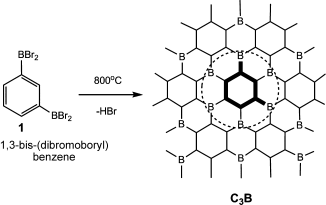
Previous theoretical studies of C3B have suggested that boron-doped graphite is a promising H2- and Li-storage material, with large maximum capacities. These characteristics could lead to exciting applications as a lightweight H2-storage material for automotive engines and as an anode in a new generation of batteries. However, for these applications to be realized a synthetic route to bulk C3B must be developed. Here we show the thermolysis of a single-source precursor (1,3-(BBr2)2C6H4) to produce graphitic C3B, thus allowing the characteristics of this elusive material to be tested for the first time. C3B was found to be compositionally uniform but turbostratically disordered. Contrary to theoretical expectations, the H2- and Li-storage capacities are lower than anticipated, results that can partially be explained by the disordered nature of the material. This work suggests that to model the properties of graphitic materials more realistically, the possibility of disorder must be considered.
Environmental Effects on the Photophysics of Organic-Inorganic Halide Perovskites
Galisteo-Lopez, JF; Anaya, M; Calvo, ME; Miguez, H
Journal of Physical Chemistry Letters, 6 (2015) 2200-2205 | DOI: 10.1021/acs.jpclett.5b00785
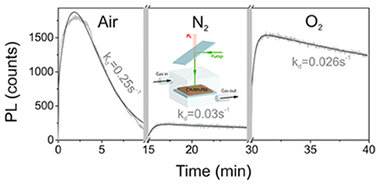
The photophysical properties of films of organic-inorganic lead halide perovskites under different ambient conditions are herein reported. We demonstrate that their luminescent properties are determined by the interplay between photoinduced activation and darkening processes, which strongly depend on the atmosphere surrounding the samples. We have isolated oxygen and moisture as the key elements in each process, activation and darkening, both of which involve the interaction with photogenerated carriers. These findings show that environmental factors play a key role in the performance of lead halide perovskites as efficient luminescent materials.
Optical Description of Mesostructured Organic-Inorganic Halide Perovskite Solar Cells
Anaya, M; Lozano, G; Calvo, ME; Zhang, W; Johnston, MB; Snaith, HJ; Miguez, H
Journal of Physical Chemistry Letters, 6 (2015) 48-53 | DOI: 10.1021/jz502351s
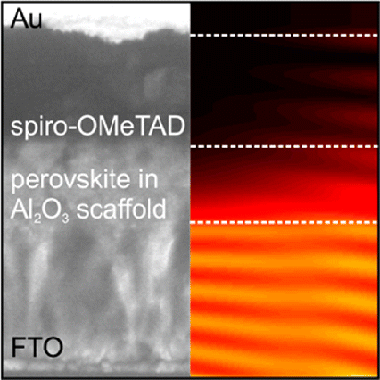
Herein we describe both theoretically and experimentally the optical response of solution-processed organic–inorganic halide perovskite solar cells based on mesostructured scaffolds. We develop a rigorous theoretical model using a method based on the propagation of waves in layered media, which allows visualizing the way in which light is spatially distributed across the device and serves to quantify the fraction of light absorbed by each medium comprising the cell. The discrimination between productive and parasitic absorption yields an accurate determination of the internal quantum efficiency. State-of-the-art devices integrating mesoporous scaffolds infiltrated with perovskite are manufactured and characterized to support the calculations. This combined experimental and theoretical analysis provides a rational understanding of the optical behavior of perovskite cells and can be beneficial for the judicious design of devices with improved performance. Notably, our model justifies the presence of a solid perovskite capping layer in all of the highest efficiency perovskite solar cells based on thinner mesoporous scaffolds.
Cu–TiO2 systems for the photocatalytic H2 production: Influence of structural and surface support features
Obregon, S; Munoz-Batista, MJ; Fernandez-Garcia, M; Kubacka, A; Colon, G
Applied Catalysis B: Environmental, 179 (2015) 468-478 | DOI: 10.1016/j.apcatb.2015.05.043
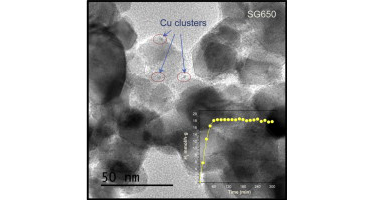
The influence of different TiO2 supports on the Cu active species has been studied. It was found that the photocatalytic H2 evolution is highly affected by the structural and electronic features of surface Cu species. Thus, metal dispersion and oxidation state appears strongly conditioned by the structural and surface properties of the TiO2 support. We have examined three TiO2 supports prepared by different synthetic methods; sol–gel, hydrothermal and microemulsion. In addition, we have induced structural and surface modifications by sulfate pretreatment over freshly prepared TiO2 precursors and subsequent calcination. Notably different copper dispersion and oxidation state is obtained by using these different TiO2 supports. From the wide structural and surface analysis of the catalysts we are able to propose that the occurrence of highly disperse Cu2+ species, the sample surface area as well as the crystallinity of the TiO2 support are directly related to the photocatalytic activity for H2 production reaction.
Synergy between gold and oxygen vacancies in gold supported on Zr-doped ceria catalysts for the CO oxidation
Laguna, OH; Perez, A; Centeno, MA; Odriozola, JA
Applied Catalysis B-Environmental, 176 (2015) 385-395 | DOI: 10.1016/j.apcatb.2015.04.019
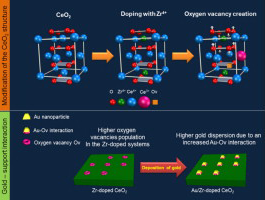
The CO oxidation activity of 1 wt.% gold catalysts prepared by deposition-precipitation on a series of ceria doped with Zr supports was studied. The supports (10, 25 and 50 Zr at.%) were synthesized by a pseudo sol-gel method through the thermal decomposition of the corresponding metallic propionates. All the prepared solids were characterized by means of XRF, BET, XRD, Raman spectroscopy, SEM, and H-2-TPR. Solid solution was obtained in all mixed systems, while the segregation of different Ce-Zr oxides was observed for the solid with the 50 Zr at.%. The oxygen vacancies population and the amount of easier reducible Ce4+ species in the solids increase with the Zr content. No major textural or structural modifications were detected after gold deposition, although a strong Au-support interaction was generated. Such interaction is strongly influenced by the nucleation of gold deposits on the oxygen vacancies and consequently the amount of Zr inserted in the ceria network also determines the dispersion of gold. The presence of gold eases the surface reduction at lower temperatures, and as higher the amount of Zr in the gold catalysts, higher the CO conversion at low temperatures, probably due to the enhancement of the electronic transfer at the surface of the catalysts.
Evolution of H-2 photoproduction with Cu content on CuOx-TiO2 composite catalysts prepared by a microemulsion method
Kubacka, A; Munoz-Batista, MJ; Fernandez-Garcia, M; Obregon, S; Colon, G
Applied Catalysis B: Environmental, 163 (2015) 214-222 | DOI: 10.1016/j.apcatb.2014.08.005
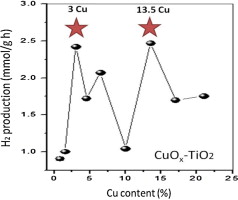
Copper oxides in contact with anatase correspond to promising materials with high activity in the photo-production of hydrogen by aqueous reforming of alcohols. By a single pot microemulsion method we obtained a series of Cu-Ti composite systems with controlled copper content in the 0-25 wt.% range. The scanning of such a wide range of composition led to the discovery of two well differentiated maxima in the photo-reaction performance. These maxima present rather high and relatively similar reaction rates and photonic efficiencies but are ascribed to the presence of different copper species. A multi-technique analysis of the materials indicates that the maxima obtained comes from optimizing different steps of the reaction; while the first would be connected with a positive effect on anatase charge handling performance the second seems exclusively related to electron capture by surface copper species.
Synthesis and application of layered titanates in the photocatalytic degradation of phenol
Ivanova, S; Penkova, A; Hidalgo, MD; Navio, JA; Romero-Sarria, F; Centeno, MA; Odriozola, JA
Applied Catalysis B: Environmental, 163 (2015) 23-29 | DOI: 10.1016/j.apcatb.2014.07.048
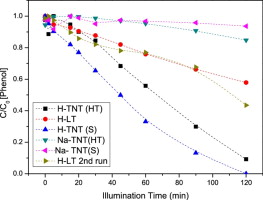
This study proposes a direct synthetic route to single titanate sheets through the mild and versatile conditions of the “chimie douce”. The stages of the production include the complexation of the titanium alkoxide precursor by benzoic acid, the formation of titanium oxo-clusters and their controlled transformation into single sheet titanates during the hydrolysis stage. The resulted material appears to be an excellent precursor for self-organized TiO2 nanotubes formation which presents an excellent activity as photocatalyst in the photo-degradation of phenol.
Study of the phenol photocatalytic degradation over TiO2 modified by sulfation, fluorination, and platinum nanoparticles photodeposition
Murcia, JJ; Hidalgo, MC; Navio, JA; Arana, J; Dona-Rodriguez, JM
Applied Catalysis B: Environmental, 179 (2015) 305-312 | DOI: 10.1016/j.apcatb.2015.05.040
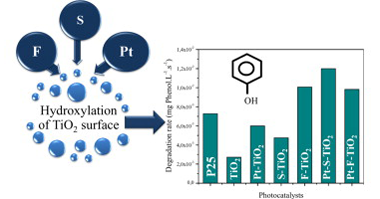
In this work, titanium dioxide has been modified by sulfation, fluorination and simultaneous Pt nanoparticles deposition; the influence of these treatments on the photocatalytic activity of this oxide has been studied. A complete characterization study was carried out and it was observed that sulfation, fluorination and metallization were important factors influencing the TiO2 properties. The photocatalytic activity of the materials prepared was evaluated in the phenol degradation and it was found that TiO2fluorination significantly increased the phenol photodegradation rate, compared with bare TiO2, sulfated TiO2 or the commercial TiO2 Degussa P25. It was also found that Pt photodeposition on sulphated TiO2 notably increased the photocatalytic activity of this oxide, while Pt on fluorinated TiO2 did not modify significantly the phenol photodegradation rate.
Fine Tuning the Emission Properties of Nanoemitters in Multilayered Structures by Deterministic Control of their Local Photonic Environment
Alberto Jiménez-Solano, Juan Francisco Galisteo-López and Hernán Míguez
Small, 11 (2015) 2727-2732 | DOI: 10.1002/smll.201402898
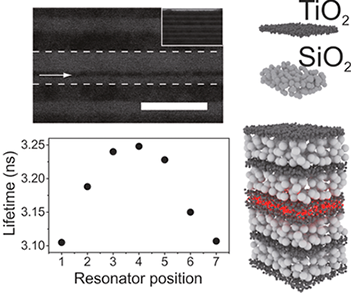
Deterministic control on the dynamics of organic nanoemitters is achieved through precise control of its photonic environment. Resonators are fabricated by a combination of spin- and dip-coating techniques, which allows placement of the emitters at different positions within the sample, thus acting as a probe of the local density of states.
Nanocolumnar 1-dimensional TiO2 photoanodes deposited by PVD-OAD for perovskite solar cell fabrication
Javier Ramos, F.; Oliva-Ramirez, Manuel; Nazeeruddin, Mohammad Khaja; Graetzel, Michael; Gonzalez-Elipe, Agustin R.; Ahmad, Shahzada
Journal of Materials Chemistry A, 3 (2015) 13291-13298 | DOI: 10.1039/c5ta02238j
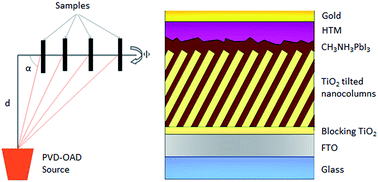
Perovskite solar cells have attracted increasing interest among the photovoltaic community in the last few years owing to their unique properties and high efficiency. In the present work, we report the fabrication of perovskite solar cells based on highly ordered 1-dimensional porous TiO2 photoanodes, which are uniform on a large area. These nanocolumnar porous TiO2 photoanodes were deposited by physical vapor deposition in an oblique angle configuration (PVD-OAD) by varying the zenithal angle between the target and the substrate normal. Perovskite infiltration into these 1-dimensional nanocolumnar structures was homogeneous through the entire thickness of the porous layer as revealed by secondary ion mass spectroscopy studies. The fabricated solar cells, with an optimized thickness of the photoanode and with industrially accepted methods, will pave the way for easy implementation on a large scale.
Full solution processed mesostructured optical resonators integrating colloidal semiconductor quantum dots
Calvo, ME; Hidalgo, N; Schierholz, R; Kovacs, A; Fernandez, A; Bellino, MG; Soler-Illia, GJAA; Miguez, H
Nanoscale, 7 (2015) 16583-16589 | DOI: 10.1039/C5NR03977K
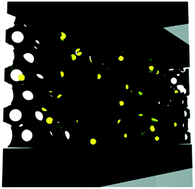
Herein we show a solution based synthetic pathway to obtain a resonant optical cavity with embedded colloidal semiconductor quantum dots (CSQDs). The optical cavity pore network, surrounded by two dense Bragg mirrors, was designed ad hoc to selectively host the quantum dots, while uncontrolled infiltration of those in the rest of the layered structure was prevented. Coupling between the optical resonant modes of the host and the natural emission of the embedded nanoparticles gives rise to the fine tuning of the luminescence spectrum extracted from the ensemble. Our approach overcomes, without the need for an encapsulating agent and exclusively by solution processing, the difficulties that arise from the low thermal and chemical stability of the CSQDs. It opens the route to achieving precise control over their location and hence over the spectral properties of light emitted by these widely employed nanomaterials. Furthermore, as the porosity of the cavity is preserved after infiltration, the system remains responsive to environmental changes, which provides an added value to the proposed structure.
Sunlight Absorption Engineering for Thermophotovoltaics: Contributions from the Optical Design
Miguez, H
ChemSusChem, 8 (2015) 786-788 | DOI: 10.1002/cssc.201403361
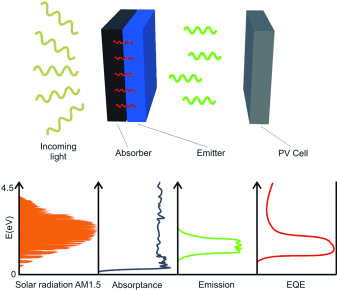
Nowadays, solar thermophotovoltaic systems constitute a platform in which sophisticated optical material designs are put into practice with the aim of achieving the long sought after dream of developing an efficient energy conversion device based on this concept. Recent advances demonstrate that higher efficiencies are at reach using photonic nanostructures amenable to mass production and scale-up.
Design and realization of transparent solar modules based on luminescent solar concentrators integrating nanostructured photonic crystals
Jimenez-Solano, A; Delgado-Sanchez, JM; Calvo, ME; Miranda-Munoz, JM; Lozano, G; Sancho, D; Sanchez-Cortezon, E; Miguez, H
Progress in Photovoltaics, 23 (2015) 1785-1792 | DOI: 10.1002/pip.2621
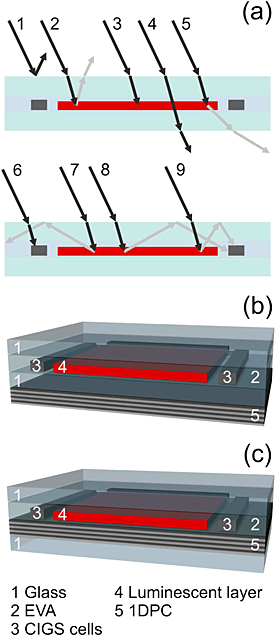
Herein, we present a prototype of a photovoltaic module that combines a luminescent solar concentrator integrating one-dimensional photonic crystals and in-plane CuInGaSe2 (CIGS) solar cells. Highly uniform and wide-area nanostructured multilayers with photonic crystal properties were deposited by a cost-efficient and scalable liquid processing amenable to large-scale fabrication. Their role is to both maximize light absorption in the targeted spectral range, determined by the fluorophore employed, and minimize losses caused by emission at angles within the escape cone of the planar concentrator. From a structural perspective, the porous nature of the layers facilitates the integration with the thermoplastic polymers typically used to encapsulate and seal these modules. Judicious design of the module geometry, as well as of the optical properties of the dielectric mirrors employed, allows optimizing light guiding and hence photovoltaic performance while preserving a great deal of transparency. Optimized in-plane designs like the one herein proposed are of relevance for building integrated photovoltaics, as ease of fabrication, long-term stability and improved performance are simultaneously achieved.
H-2 oxidation as criterion for PrOx catalyst selection: Examples based on Au-Co-O-x-supported systems
Reina, TR; Megias-Sayago, C; Florez, AP; Ivanova, S; Centeno, MA; Odriozola, JA
Journal of Catalysis, 326 (2015) 161-171 | DOI: 10.1016/j.jcat.2015.03.015
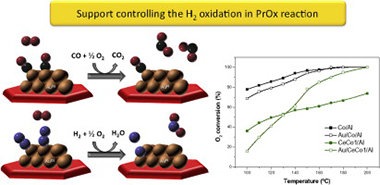
A new approach for understanding PrOx reaction over gold catalysts is proposed in this work. The competition between H-2 and CO oxidation has been studied over a series of Au/MOx/Al2O3 (M = Ce and Co) catalysts in simulated post-reforming gas stream, containing H2O and CO2 for H-2 cleanup goals. The catalysts' behavior is correlated to their oxygen storage capacity, redox behavior, and oxidation ability. The estimation of the reaction rates reveals that in these solids the H-2 combustion, the selectivity limiting factor in the PrOx process, is mainly controlled by the support and not by the gold presence. The possible use of the hydrogen oxidation reaction as a catalyst selection criterion is discussed.
Fabrication of Optical Multi layer Devices from Porous Silicon Coatings with Closed Porosity by Magnetron Sputtering
Caballero-Hernandez, Jaime; Godinho, Vanda; Lacroix, Bertrand; Jimenez de Haro, Maria C.; Jamon, Damien; Fernandez, Asuncion
ACS Applied Materials & Interfaces, 7 (2015) 13880-13897 | DOI: 10.1021/acsami.5b02356
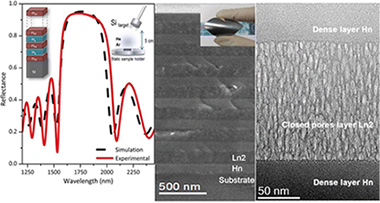
The fabrication of single-material photonic-multilayer devices is explored using a new methodology to produce porous silicon layers by magnetron sputtering. Our bottom-up methodology produces highly stable amorphous porous silicon films with a controlled refractive index using magnetron sputtering and incorporating a large amount of deposition gas inside the closed pores. The influence of the substrate bias on the formation of the closed porosity was explored here for the first time when He was used as the deposition gas. We successfully simulated, designed, and characterized Bragg reflectors and an optical microcavity that integrates these porous layers. The sharp interfaces between the dense and porous layers combined with the adequate control of the refractive index and thickness allowed for excellent agreement between the simulation and the experiments. The versatility of the magnetron sputtering technique allowed for the preparation of these structures for a wide range of substrates such as polymers while also taking advantage of the oblique angle deposition to prepare Bragg reflectors with a controlled lateral gradient in the stop band wavelengths.
Laser Treatment of Ag@ZnO Nanorods as Long-Life-Span SERS Surfaces
Macias-Montero, M; Pelaez, RJ; Rico, VJ; Saghi, Z; Midgley, P; Afonso, CN; Gonzalez-Elipe, AR; Borras, A
ACS Applied Materials & Interfaces, 7 (2015) 2331-2339 | DOI: 10.1021/am506622x
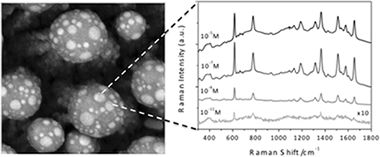
UV nanosecond laser pulses have been used to produce a unique surface nanostructuration of Ag@ZnO supported nanorods (NRs). The NRs were fabricated by plasma enhanced chemical vapor deposition (PECVD) at low temperature applying a silver layer as promoter. The irradiation of these structures with single nanosecond pulses of an ArF laser produces the melting and reshaping of the end of the NRs that aggregate in the form of bundles terminated by melted ZnO spherical particles. Well-defined silver nanoparticles (NPs), formed by phase separation at the surface of these melted ZnO particles, give rise to a broad plasmonic response consistent with their anisotropic shape. Surface enhanced Raman scattering (SERS) in the as-prepared Ag@ZnO NRs arrays was proved by using a Rhodamine 6G (Rh6G) chromophore as standard analyte. The surface modifications induced by laser treatment improve the stability of this system as SERS substrate while preserving its activity.
Self-lubricity of WSex nanocomposite coatings
S. Dominguez-Meister; M. Conte; A. Igartua; T.C. Rojas; J.C. Sánchez-López
ACS Applied Materials & Interfaces, 7 (2015) 7979-7986 | DOI: 10.1021/am508939s
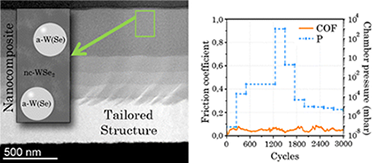
Transition metal chalcogenides with lamellar structure are known for their use in tribological applications although limited to vacuum due to their easy degradation in the presence of oxygen and/or moisture. Here we present a tailored WSex coating with low friction (0.07) and low wear rates (3 × 10–7 mm3 Nm–1) even in ambient air. To understand the low friction behavior and lower chemical reactivity a tribological study is carried out in a high-vacuum tribometer under variable pressure (atmospheric pressure to 1 × 10–8 mbar). A detailed investigation of the film nanostructure and composition by advanced transmission electron microscopy techniques with nanoscale resolution determined that the topmost layer is formed by nanocrystals of WSe2 embedded in an amorphous matrix richer in W, a-W(Se). After the friction test, an increased crystalline order and orientation of WSe2 lamellas along the sliding direction were observed in the interfacial region. On the basis of high angle annular dark field, scanning transmission electron microscopy, and energy dispersive X-ray analysis, the release of W atoms from the interstitial basal planes of the a-W(Se) phase is proposed. These W atoms reaching the surface, play a sacrificial role preventing the lubricant WSe2 phase from oxidation. The increase of the WSe2 crystalline order and the buffer effect of W capturing oxygen atoms would explain the enhanced chemical and tribological response of this designed nanocomposite material.
Anisotropic In-Plane Conductivity and Dichroic Gold Plasmon Resonance in Plasma-Assisted ITO Thin Films e-Beam-Evaporated at Oblique Angles
Parra-Barranco, Julian; Garcia-Garcia, Francisco J.; Rico, Victor; Borras, Ana; Lopez-Santos, Carmen; Frutos, Fabian; Barranco, Angel; Gonzalez-Elipe, Agustin R.
ACS Applied Materials & Interfaces, 7 (2015) 10993-11001 | DOI: 10.1021/acsami.5b02197
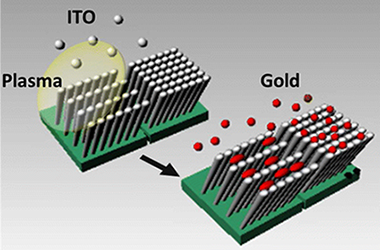
ITO thin films have been prepared by electron beam evaporation at oblique angles (OA), directly and while assisting their growth with a downstream plasma. The films microstructure, characterized by scanning electron microscopy, atomic force microscopy, and glancing incidence small-angle X-ray scattering, consisted of tilted and separated nanostructures. In the plasma assisted films, the tilting angle decreased and the nanocolumns became associated in the form of bundles along the direction perpendicular to the flux of evaporated material. The annealed films presented different in-depth and sheet resistivity as confirmed by scanning conductivity measurements taken for the individual nanocolumns. In addition, for the plasma-assisted thin films, two different sheet resistance values were determined by measuring along the nanocolumn bundles or the perpendicular to it. This in-plane anisotropy induces the electrochemical deposition of elongated gold nanostructures. The obtained Au-ITO composite thin films were characterized by anisotropic plasmon resonance absorption and a dichroic behavior when examined with linearly polarized light.
Effect of catalytic graphitization on the electrochemical behavior of wood derived carbons for use in supercapacitors
Gutierrez-Pardo, A; Ramirez-Rico, J; Cabezas-Rodriguez, R; Martinez-Fernandez, J
Journal of Power Sources, 278 (2015) 18-26 | DOI: 10.1016/j.jpowsour.2014.12.030
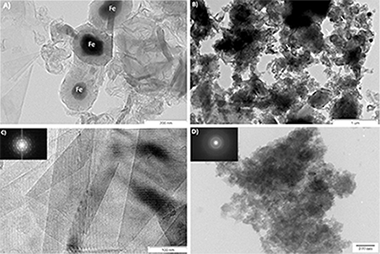
Porous graphitic carbons were successfully obtained from wood precursors through pyrolysis using a transition metal as catalyst. Once the catalyst is removed, the resulting material mimics the microstructure of the wood and presents high surface area, open and interconnected porosity and large pore volume, high crystallinity and good electrical conductivity, making these carbons interesting for electrochemical devices. Carbons obtained were studied as electrodes for supercapacitors in half cell experiments, obtaining high capacitance values in a basic media (up to 133 F g−1 at current densities of 20 mA g−1 and 35 F g−1 at current densities of 1 A g−1). Long-cycling experiments showed excellent stability of the electrodes with no reduction of the initial capacitance values after 1000 cycles in voltammetry.
Plasma reforming of methane in a tunable ferroelectric packed-bed dielectric barrier discharge reactor
Montoro-Damas, AM; Brey, JJ; Rodriguez, MA; Gonzalez-Elipe, AR; Cotrino, J
Journal of Power Sources, 296 (2015) 268-275 | DOI: 10.1016/j.jpowsour.2015.07.038
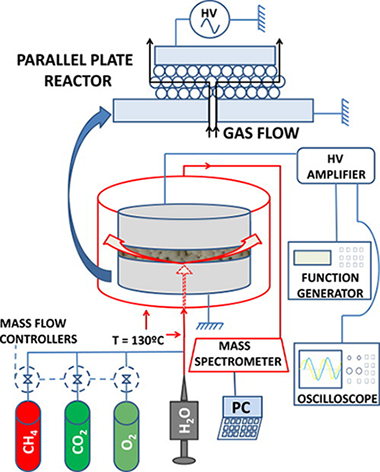
In a tunable circular parallel plate dielectric barrier discharge reactor with pellets of a ferroelectric material separating the electrodes we investigate the plasma reforming of methane trying to maximize both the reaction yield and the energetic efficiency of the process. The geometrical configuration of the reactor (gap between electrodes, active electrode area) and the ferroelectric pellet size have been systematically varied to determine their influence on the process efficiency. The comparison between wet (with H2O as reactant), oxidative (with O2), and dry (with CO2) reforming reactions reveals a higher efficiency for the former with CO + H2 as main reaction products. The maximum energetic efficiency EE, defined as the produced number of litres of H2 per kWh, found for optimized working conditions at low-level applied power is higher than the up to date best-known results. A comprehensive discussion of the influence of the different parameters affecting the reaction yield is carried out.
Nanocolumnar coatings with selective behavior towards osteoblast and Staphylococcus aureus proliferation
Izquierdo-Barba, Isabel; Miguel Garcia-Martin, Jose; Alvarez, Rafael; Palmero, Alberto; Esteban, Jaime; Perez-Jorge, Concepcion; Arcos, Daniel; Vallet-Regi, Maria
Acta Biomaterialia, 15 (2015) 20-28 | DOI: 10.1016/j.actbio.2014.12.023
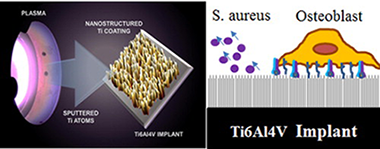
Bacterial colonization and biofilm formation on orthopedic implants is one of the worst scenarios in orthopedic surgery, in terms of both patient prognosis and healthcare costs. Tailoring the surfaces of implants at the nanoscale to actively promote bone bonding while avoiding bacterial colonization represents an interesting challenge to achieving better clinical outcomes. Herein, a Ti6Al4V alloy of medical grade has been coated with Ti nanostructures employing the glancing angle deposition technique by magnetron sputtering. The resulting surfaces have a high density of nanocolumnar structures, which exhibit strongly impaired bacterial adhesion that inhibits biofilm formation, while osteoblasts exhibit good cell response with similar behavior to the initial substrates. These results are discussed on the basis of a "lotus leaf effect" induced by the surface nanostructures and the different sizes and biological characteristics of osteoblasts and Staphylococcus aureus.
Biocompatible Films with Tailored Spectral Response for Prevention of DNA Damage in Skin Cells
Nunez-Lozano, R; Pimentel, B; Castro-Smirnov, JR; Calvo, ME; Miguez, H; de la Cueva-Mendez, G
Advanced Healthcare Materials, 4 (2015) 1944-1948 | DOI: 10.1002/adhm.201500223
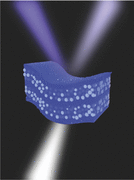
A hybrid nanostructured organic–inorganic biocompatible film capable of efficiently blocking a preselected range of ultraviolet light is designed to match the genotoxic action spectrum of human epithelial cells. This stack protects cultured human skin cells from UV-induced DNA lesions. As the shielding mechanism relies exclusively on reflection, the secondary effects due to absorption harmful radiation are prevented
Ca-looping for postcombustion CO2 capture: A comparative analysis on the performances of dolomite and limestone
Valverde, JM; Sanchez-Jimenez, PE; Perez-Maqueda, LA
Applied Energy, 138 (2015) 202-215 | DOI: 10.1016/j.apenergy.2014.10.087
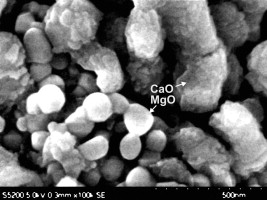
The low cost and wide availability of natural limestone (CaCO3) is at the basis of the industrial competitiveness of the Ca-looping (CaL) technology for postcombustion CO2 capture as already demonstrated by similar to 1 Mw(t) scale pilot projects. A major focus of studies oriented towards further improving the efficiency of the CaL technology is how to prevent the gradual loss of capture capacity of limestone derived CaO as the number of carbonation/calcination cycles is increased. Natural dolomite (MgCa(CO3)(2)) has been proposed as an alternative sorbent precursor to limestone. Yet, carbonation of MgO is not thermodynamically favorable at CaL conditions, which may hinder the capture performance of dolomite. In the work described in this paper we carried out a thermogravimetric analysis on the multicyclic capture performance of natural dolomite under realistic regeneration conditions necessarily implying high calcination temperature, high CO2 concentration and fast transitions between the carbonation and calcination stages. Our study demonstrates that the sorbent derived from dolomite has a greater capture capacity as compared to limestone. SEM analysis shows that MgO grains in the decomposed dolomite are resistant to sintering under severe calcination conditions and segregate from CaO acting as a thermally stable support which mitigates the multicyclic loss of CaO conversion. Moreover, full decomposition of dolomite is achieved at significantly lower calcination temperatures as compared to limestone, which would help improving further the industrial competitiveness of the technology.
An Optically Controlled Microscale Elevator Using Plasmonic Janus Particles
Nedev, S; Carretero-Palacios, S; Kuhler, P; Lohmuller, T; Urban, AS; Anderson, LJE; Feldmann, J
ACS Photonics, 2 (2015) 491-496 | DOI: 10.1021/ph500371z
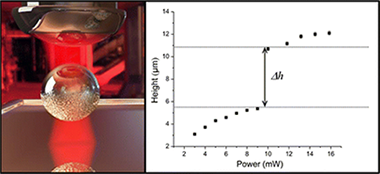
In this article, we report how Janus particles, composed of a silica sphere with a gold half-shell, can be not only stably trapped by optical tweezers but also displaced controllably along the axis of the laser beam through a complex interplay between optical and thermal forces. Scattering forces orient the asymmetric particle, while strong absorption on the metal side induces a thermal gradient, resulting in particle motion. An increase in the laser power leads to an upward motion of the particle, while a decrease leads to a downward motion. We study this reversible axial displacement, including a hysteretic jump in the particle position that is a result of the complex pattern of a tightly focused laser beam structure above the focal plane. As a first application we simultaneously trap a spherical gold nanoparticle and show that we can control the distance between the two particles inside the trap. This photonic micron-scale “elevator” is a promising tool for thermal force studies, remote sensing, and optical and thermal micromanipulation experiments.
Water splitting performance of Er3+-doped YVO4 prepared from a layered K3V5O14 precursor
Obregon, S; Colon, G
Chemical Engineering Journal, 262 (2015) 29-33 | DOI: 10.1016/j.cej.2014.09.073
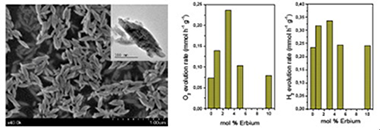
Erbium-doped YVO4 have been synthesized by means of a simple solution method having good photo activities under UV-like excitation for the water splitting half reactions. From the structural and morphological characterization it has been stated that the presence of Er3+ induces the promotion of luminescence. Moreover the incorporation of erbium clearly affects to the morphology YVO4 leading to 200 nm size well-defined spindle-like particles. The improved photocatalytic performance might be associated to a better electron–hole separation mechanism, probably due to the slight increase of band-gap value. The obtained photoactivities for H2 and O2 evolution reactions make this material a promising candidate for water splitting reactions.
Toughening of complete solid solution cermets by graphite addition
Chicardi, E; Torres, Y; Sayagues, MJ; Medri, V; Melandri, C; Cordoba, JM; Gotor, FJ
Chemical Engineering Journal, 267 (2015) 297-305 | DOI: 10.1016/j.cej.2015.01.022
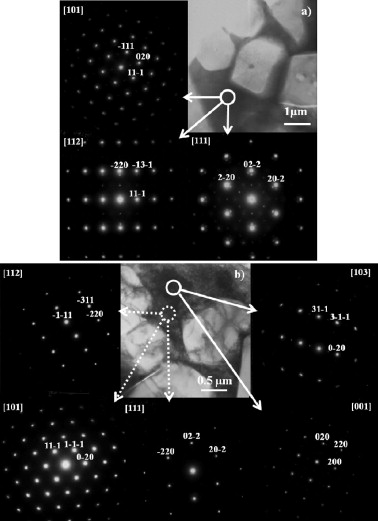
(Ti0.95Ta0.05)(C0.5N0.5)-Co complete solid solution cermets (CSCs) were developed by a mechanochemical synthesis process and a pressureless sintering method. The effect of different percentages of graphite used as a sintering additive on the nature of the binder phase and the mechanical properties of the cermets was investigated. Microstructural and mechanical characterisations were carried out by X-ray diffraction, optical microscopy, scanning electron microscopy, transmission electron microscopy, energy-dispersive X-ray spectroscopy, Vickers hardness, indentation fracture toughness and nanoindentation. The addition of graphite modified the carbon activity during sintering, reducing the dissolution of carbonitride ceramic particles into the molten binder. The amount of Ti and Ta remaining in the binder after sintering gradually decreased as the amount of graphite added increased, which induced a change in the nature of the binder phase. When no graphite was added, the binder consisted of the brittle TixTa1−xCo2 intermetallic phase. With the increase in the amount of graphite added, the formation of more ductile phases, such as TixTa1−xCo3 and α-Co, was observed, causing a significant improvement in the toughness of the cermets.
Uranium immobilization by FEBEX bentonite and steel barriers in hydrothermal conditions
Villa-Alfageme, M; Hurtado, S; El Mrabet, S; Pazos, MC; Castro, MA; Alba, MD
Chemical Engineering Journal, 269 (2015) 279-287 | DOI: 10.1016/j.cej.2015.01.134
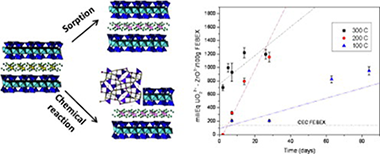
FEBEX clay is considered a reference material in engineered barriers for safe storage of nuclear waste and uranium is a minor component of high-level radioactive waste (HLRW) and a main component of the spent nuclear fuel (SNF). Here, the kinetics of reaction of uranium with FEBEX was investigated in addition to the uranium immobilisation ability and the structural analysis of the reaction products. Hydrothermal treatments were accomplished with UO22+ and tetravalent actinide simulator ZrO2+, also present in HLRW. The quantification of the reaction was performed through gamma spectrometry of uranium. Two mechanisms for UO22+ retention by FEBEX were detected: adsorption and formation of stable and insoluble new phases. The structural analyses performed using ZrO2+, confirmed the uranium adsorption and the presence of new phases, ZrO2 and Zr(SiO4), that emphasise the existence of a chemical reaction with the bentonite. The analysis of the velocity of reaction uranium-clay minerals revealed temperature dependence. An exponential fitting suggested that the removal of uranium from solution at temperatures over 200 °C could be completed in less than a year. For lower temperatures, several years are needed. Milliequivalents of UO22+ immobilised by the clay depended on temperature and time and were over cation exchange capacity (CEC) of FEBEX even at 100 °C (reaching 600% of CEC). The reaction with steel, also temperature dependent, was finally analysed. At 200 °C 40–70% of uranium reacted with steel. But only 30–15% reacted at 300 °C and 100 °C. The reactions provide a stable immobilisation mechanism for uranium even when its sorption and swelling capacities fail. Our experiments will be of particular interest for very deep borehole disposals were higher temperatures and pressures are expected.
Microreactors technology for hydrogen purification: Effect of the catalytic layer thickness on CuOx/CeO2-coated microchannel reactors for the PROX reaction
Laguna, O. H.; Castano, M. Gonzalez; Centeno, M. A.; Odriozola, J. A.
Chemical Engineering Journal, 271 (2015) 45-52 | DOI: 10.1016/j.cej.2015.04.023
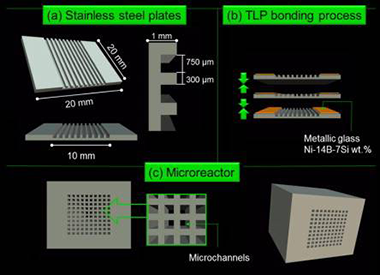
Two blocks of microreactors composed by 100 microchannels and coated, respectively, with 150 and 300 mg of a CuOx/CeO2 catalyst, were prepared and tested in the preferential oxidation of CO in presence of H2 (PROX). The deposition of different amount of catalyst resulted in different catalytic layer thicknesses thus modifying the catalytic performances of the microreactor. The evaluation of the main reaction variables (the space velocity, the O2-to-CO ratio and the presence of H2O and/or CO2 in the stream) was performed over both microreactors and compared to that of the parent powder catalyst. The least loaded microreactor, with a coating thickness around 10 μm, presented the highest CO conversion and selectivity levels at temperatures below 160 °C. This result evidences (i) the improvement of the catalytic performances got by the structuration of the powder catalyst and (ii) the importance of the selection of the adequate thickness of the catalytic layer on the microreactor, which have not to exceed and optimal value. An adequate coating thickness allows minimizing the mass and heat transport limitations, thus resulting in the enhancement of the catalytic performance during the PROX reaction.
Enhancement of stability and photoactivity of TiO2 coatings on annular glass reactors to remove emerging pollutants from waters
Espino-Estevez, MR; Fernandez-Rodriguez, C; Gonzalez-Diaz, OM; Navio, JA; Fernandez-Hevia, D; Dona-Rodriguez, JM
Chemical Engineering Journal, 279 (2015) 488-497 | DOI: 10.1016/j.cej.2015.05.038
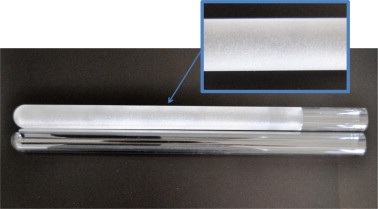
TiO2 coatings of highly photoactive lab-made titania were prepared on the outer wall of the inner tube of a glass tubular reactor by dip-coating method. The effect of decreasing the size of the aggregates to improve adhesion and photoactivity of the coatings to degrade phenol, diclofenac and isoproturon was also investigated. Chemical disaggregation of the TiO2 particles resulted in a lower aggregate size, between 0.1 and 1 μm, than mechanical disaggregation, between 1 and 10 μm. The results of the adhesion tape test showed that either milling of aggregate material with a planetary mill or chemical stabilization of the particles were necessary to obtain TiO2 coatings on glass tube with acceptable quality to be used in water treatment applications. SEM images showed that coatings prepared after milling the TiO2 suspension were more homogeneous without surface aggregates. The degree of adhesion of the coatings after increasing the roughness of the support by abrasive blasting was also evaluated. Adhesion to the substrate was slightly lower when using the modified support. The photoactivity results showed that the coatings prepared after wet milling of catalyst during 30 min and after chemical disaggregation were more efficient in terms of degradation and mineralization when using phenol as model molecule. Subsequent studies with two emerging pollutants, diclofenac and isoproturon, also showed enhanced efficiency of these coatings. The reusability of the TiO2 coatings was also evaluated and a promising photocatalytic performance was observed with a very low variation of the decay rate after five consecutive usages.
Electrochemical activation of an oblique angle deposited Cu catalyst film for H-2 production
Gonzalez-Cobos, J; Rico, VJ; Gonzalez-Elipe, AR; Valverde, JL; de Lucas-Consuegra, A
Catalysis Science & Technology, 5 (2015) 2203-2214 | DOI: 10.1039/c4cy01524j
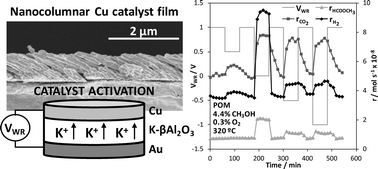
A novel Cu catalyst film was prepared by oblique angle physical vapour deposition (OAD) on a K-βAl2O3 solid electrolyte (alkaline ionic conductor) for catalytic/electrocatalytic purposes. This technique allowed us to obtain a highly porous and electrically conductive Cu catalyst electrode which was tested in the partial oxidation of methanol (POM) reaction for H2 production and its catalytic activity was in situ enhanced via electrochemical promotion of catalysis (EPOC). The electropromotional effect was reversible and reproducible, and allowed us to increase both hydrogen and methyl formate production rates by almost three times under optimal promotion conditions (320 °C, 2.2 × 10−7 mol of K+ transferred). The observed promotional effect was attributed to a decrease in the Cu catalyst work function as a consequence of the controlled migration of electropositive K+ ions which favoured the chemisorption of electron acceptor molecules (O2) at the expense of the electron donor ones (CH3OH). Under the reaction conditions these ions formed some kinds of potassium surface compounds as demonstrated by SEM, EDX and XPS post-reaction characterization analyses. The obtained results demonstrate the interest of the used catalyst-electrode preparation technique for the electrochemical activation of non-noble metal catalyst films.
Ultra-fast and energy-efficient sintering of ceramics by electric current concentration
Zapata-Solvas, E; Gomez-Garcia, D; Dominguez-Rodriguez, A; Todd, RI
Scientific Reports, 5 (2015) art n. 8513 | DOI: 10.1038/srep08513
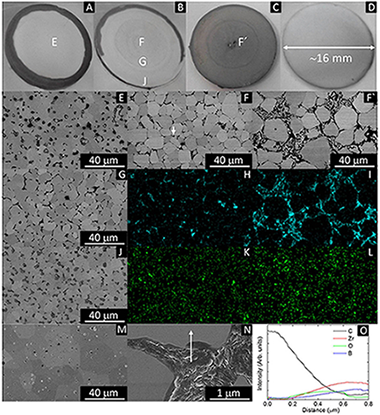
Electric current activated/assisted sintering (ECAS) techniques, such as electrical discharge sintering (EDS) or resistive sintering (RS), have been intensively investigated for longer than 50 years. In this work, a novel system including an electrically insulated graphite die for Spark Plasma Sintering (SPS) is described, which allows the sintering of any refractory ceramic material in less than 1 minute starting from room temperature with heating rates higher than 2000°C/min and an energy consumption up to 100 times lower than with SPS. The system alternates or combines direct resistive sintering (DRS) and indirect resistive sintering (IRS). Electrical insulation of the die has been achieved through the insertion of a film made of alumina fibers between the graphite die and the graphite punches, which are protected from the alumina fiber film by a graphite foil. This system localized the electric current directly through the sample (conductive materials) as in DRS and EDS, or through the thin graphite foil (non-conductive materials) as in IRS, and is the first system capable of being used under EDS or RS conditions independently combining current concentration/localization phenomena.
Adaptable Ultraviolet Reflecting Polymeric Multilayer Coatings of High Refractive Index Contrast
Smirnov, JRC; Ito, M; Calvo, ME; Lopez-Lopez, C; Jimenez-Solano, A; Galisteo-Lopez, JF; Zavala-Rivera, P; Tanaka, K; Sivaniah, E; Miguez, H
Advanced Optical Materials, 3 (2015) 1633-1639 | DOI: 10.1002/adom.201500209
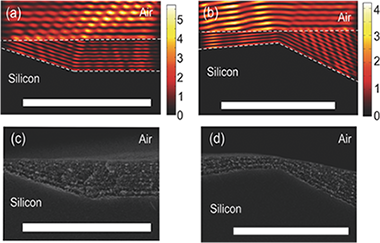
A synthetic route is demonstrated to build purely polymeric nanostructured multilayer coatings, adaptable to arbitrary surfaces, and capable of efficiently blocking by reflection a targeted and tunable ultraviolet (UV) range. Reflection properties are determined by optical interference between UV light beams reflected at the interfaces between polystyrene layers of different porosity and hence refractive index. As no dopant absorber intervenes in the shielding effect, polymer degradation effects are prevented. Alternated porosity results from the modulation of photochemical effects at the few tens of nanometers length scale, combined with the collective osmotic shock induced during the processing of the precursor diblock copolymer film. Experimental evidence of the application of this method to coat rough surfaces with smooth and conformal UV protecting films is provided.
Flexible Distributed Bragg Reflectors from Nanocolumnar Templates
Calvo, ME; Gonzalez-Garcia, L; Parra-Barranco, J; Barranco, A; Jimenez-Solano, A; Gonzalez-Elipe, AR; Miguez, H
Advanced Optical Materials, 3 (2015) 171-175 | DOI: 10.1002/adom.201400338

A flexible distributed Bragg reflector is made by the infiltration of a nanocolumnar array with polydimethyl siloxane oligomers. The high optical reflectance displayed by the final material is a direct consequence of the high refractive index contrast of the columnar layers whereas the structural stability is due to the polymer properties.
Dye sensitized solar cells as optically random photovoltaic media
Galvez, FE; Barnes, PRF; Halme, J; Miguez, H
Energy & Environmental Science, 6 (2014) 1260-1266 | DOI: 10.1039/C3EE42587H
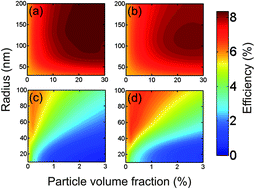
In order to enhance optical absorption, light trapping by multiple scattering is commonly achieved in dye sensitized solar cells by adding particles of a different sort. Herein we propose a theoretical method to find the structural parameters (particle number density and size) that optimize the conversion efficiency of electrodes of different thicknesses containing spherical inclusions of diverse composition. Our work provides a theoretical framework in which the response of solar cells containing diffuse scattering particles can be rationalized. Optical simulations are performed by combining a Monte Carlo approach with Mie theory, in which the angular distribution of scattered light is accounted for. Several types of scattering centers, such as anatase, gold and silver particles, as well as cavities, are considered and their effect compared. Estimates of photovoltaic performance, insight into the physical mechanisms responsible for the observed enhancements, and guidelines to improve the cell design are provided. We discuss the results in terms of light transport in weakly disordered optical media and find that the observed variations between the optimum scattering configurations attained for different electrode thicknesses can be understood as the result of the randomization of the light propagation direction at different depths within the active layer. A primary conclusion of our study is that photovoltaic performance is optimised when the scattering properties of the film are adjusted so that the distance over which incident photons are randomized is comparable to the thickness of the film. This simple relationship could also be used as a design rule to attain the optimum optical design in other photovoltaic materials.
Low Temperature Production of Formaldehyde from Carbon Dioxide and Ethane by Plasma-Assisted Catalysis in a Ferroelectrically Moderated Dielectric Barrier Discharge Reactor
Gomez-Ramirez, A; Rico, VJ; Cotrino, J; Gonzalez-Elipe, A; Lambert, RM
ACS Catalysis, 4 (2014) 402-408 | DOI: 10.1021/cs4008528
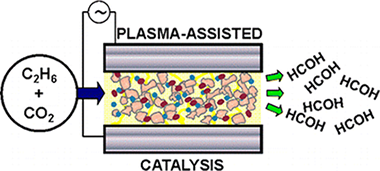
Plasma-assisted catalysis of the reaction between CO2 and C2H6 in a single-pass, ferroelectrically moderated dielectric barrier discharge reactor has been studied at near ambient temperature as a function of physicochemical and electrical reaction variables. The presence of small amounts of a vanadia/alumina catalyst dispersed on the BaTiO3 ferroelectric markedly enhanced the production of formaldehyde, the focus of this work. A maximum HCOH selectivity of 11.4% (defined with respect to the number of ethane carbon atoms consumed) at 100% ethane conversion was achieved, the other products being CO, H2O, H2, CH4 and a small amount of C3H8. N2O was also an effective partial oxidant (HCOH selectivity 8.9%) whereas use of O2 led to complete combustion, behavior that may be rationalized in terms of the electron impact excitation cross sections of the three oxidants. Control experiments with the coproducts CH4 and C3H8 showed that these species were not intermediates in HCOH formation from C2H6. Analysis of reactor performance as a function of discharge characteristics revealed that formaldehyde formation was strongly favored at low frequencies where the zero-current fraction of the duty cycle was greatest, the implication being that plasma processes also acted to destroy previously formed products. A tentative reaction mechanism is proposed that accounts for the broad features of formaldehyde production.
Active Site Considerations on the Photocatalytic H-2 Evolution Performance of Cu-Doped TiO2 Obtained by Different Doping Methods
Valero, JM; Obregon, S; Colon, G
ACS Catalysis, 4 (2014) 3320-3329 | DOI: 10.1021/cs500865y
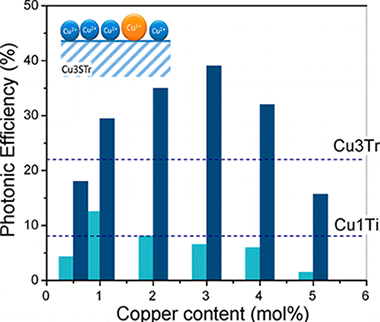
A photocatalytic H2 evolution reaction was performed over copper doped TiO2. The influence of sulfate pretreatment over fresh TiO2 support and the Cu doping method has been evaluated. Wide structural and surface characterization of catalysts was carried out in order to establish a correlation between the effect of sulfuric acid treatment and the further Cu-TiO2photocatalytic properties. Notably a different copper dispersion and oxidation state is obtained by different metal decoration methods. From the structural and surface analysis of the catalysts we have stated that the occurrence of highly disperse and reducible Cu2+ species is directly related to the photocatalytic activity for the H2 production reaction. Highly active materials have been obtained from a chemical reduction method leading to 18 mmol·h–1·g–1for 3 mol % copper loading.
Biomechanical properties of the tomato (Solanum lycopersicum) fruit cuticle during development are modulated by changes in the relative amounts of its components
Espana, L; Heredia-Guerrero, JA; Segado, P; Benitez, JJ; Heredia, A; Dominguez, E
New Phytologist, 202 (3) (2014) 790-802 | DOI: 10.1111/nph.12727
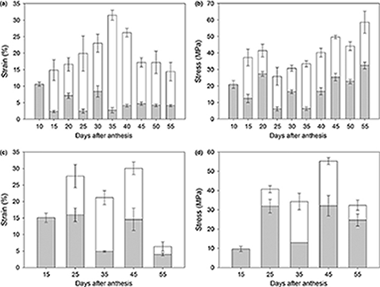
Keywords:
attenuated total reflectance–Fourier transform infrared (ATR-FTIR);biomechanics;cuticle;cutin;flavonoids;tomato (Solanum lycopersicum) fruit
Summary
- In this study, growth-dependent changes in the mechanical properties of the tomato (Solanum lycopersicum) cuticle during fruit development were investigated in two cultivars with different patterns of cuticle growth and accumulation.
- The mechanical properties were determined in uniaxial tensile tests using strips of isolated cuticles. Changes in the functional groups of the cuticle chemical components were analysed by attenuated total reflectance–Fourier transform infrared (ATR-FTIR).
- The early stages of fruit growth are characterized by an elastic cuticle, and viscoelastic behaviour only appeared at the beginning of cell enlargement. Changes in the cutin:polysaccharide ratio during development affected the strength required to achieve viscoelastic deformation. The increase in stiffness and decrease in extensibility during ripening, related to flavonoid accumulation, were accompanied by an increase in cutin depolymerization as a result of a reduction in the overall number of ester bonds.
- Quantitative changes in cuticle components influence the elastic/viscoelastic behaviour of the cuticle. The cutin:polysaccharide ratio modulates the stress required to permanently deform the cuticle and allow cell enlargement. Flavonoids stiffen the elastic phase and reduce permanent viscoelastic deformation. Ripening is accompanied by a chemical cleavage of cutin ester bonds. An infrared (IR) band related to phenolic accumulation can be used to monitor changes in the cutin esterification index.
Could an efficient WGS catalyst be useful in the CO-PrOx reaction?
Reina, TR; Papadopoulou, E; Palma, S; Ivanova, S; Centeno, MA; Ioannides, T; Odriozola, JA
Applied Catalysis B: Environmental, 150-151 (2014) 554-563 | DOI: 10.1016/j.apcatb.2014.01.001
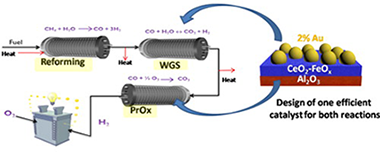
This work presents an evaluation of a high performance series of water gas shift (WGS) catalysts in the preferential CO oxidation reaction (PrOx) in order to examine the applicability of the same catalyst for both processes as a first step for coupling both reactions in a single process. Gold based catalysts are applied in an extensive study of the CO-PrOx reaction parameters, such as λ, WHSV, CO concentration and [H2O]/[CO2] ratio in order to obtain the best activity/selectivity balance. CO and H2 oxidation reactions were treated separately in order to establish the degree of CO/H2 oxidation competition. Additionally the catalysts behavior in the CO-PrOx parallel reactions such a WGS and RWGS have been also carried out to analyze their effect on product composition.
Excellent photocatalytic activity of Yb3+, Er3+ co-doped BiVO4 photocatalyst
Obregon, S.; Colon, G.
Applied Catalysis B: Environmental, 152-153 (2014) 328-334 | DOI: 10.1016/j.apcatb.2014.01.054
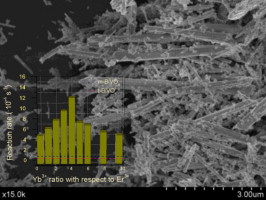
Ytterbium-Erbium co-doped BiVO4 have been synthesized by means of a surfactant free hydrothermal method having good photoactivities under sun-like excitation for the degradation of Methylene Blue and O2 evolution reactions. From the structural and morphological characterization it has been stated that the presence of Yb3+ and Er3+ induces the stabilization of the tetragonal phase probably due to its substitutional incorporation in the BiVO4 lattice. The occurrence of the Yb3+,Er3+ co-doped monoclinic-tetragonal BiVO4 heterostructure induces the higher photocatalytic activities. The best photocatalytic performance was attained for the sample with 1:4 Er3+:Yb3+ ratio. The observed NIR photoactivity clearly denotes the occurrence of an up-conversion mechanism involved in the overall photocatalytic process.
Heterostructured Er3+ doped BiVO4 with exceptional photocatalytic performance by cooperative electronic and luminescence sensitization mechanism
Obregon, S; Colon, G
Applied Catalysis B: Environmental, 158-159 (2014) 242-249 | DOI: 10.1016/j.apcatb.2014.04.029
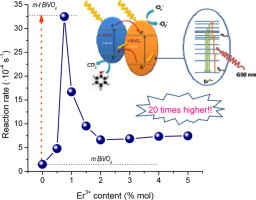
Er-BiVO4 has been synthesized by means of mw-assisted hydrothermal method having good photoactivity under sun-like excitation. It is stated that the precursor addition sequence plays a critical role which determine the further structural feature of BiVO4. From the structural and morphological characterization, it can be demonstrated that the presence of Er3+ would induce the stabilization of the tetragonal phase probably due to the formation of tetragonal-ErVO4 seeds previous to BiVO4 formation. The best photocatalytic performance is attained for the sample with 0.75 at% Er3+ content. At this dopant loading a mixture of tetragonal and monoclinic phase (70% tetragonal) is obtained. The dramatic increase in the photocatalytic activity for 0.75 at% Er-BiVO4 is related to the occurrence of such heterostructure. For this system, the MB degradation rate constant appears drastically higher as bare m-BiVO4. Furthermore, activities of photocatalysts for visible-light-driven O2 evolution have been evaluated, demonstrating that the photocatalytic activity of this Er-doped system (O2 evolution rate, 1014 μmol g−1 h−1) is 20 times as that of undoped m-BiVO4 (O2 evolution rate, 54 μmol g−1 h−1). From the obtained results, the cooperative conjunction of electronic and luminescence mechanism involved in the reaction is proposed to be the origin of the enhanced photocatalytic efficiencies of such systems.
Supported Co catalysts prepared as thin films by magnetron sputtering for sodium borohydride and ammonia borane hydrolysis
Paladini, M; Arzac, GM; Godinho, V; De Haro, MCJ; Fernandez, A
Applied Catalysis B: Environmental, 158-159 (2014) 400-409 | DOI: 10.1016/j.apcatb.2014.04.047
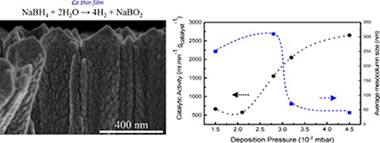
Supported Co catalysts were prepared for sodium borohydride and ammonia borane hydrolysis by magnetron sputtering for the first time under different conditions. Ni foam was selected as support. Deposition conditions (time, pressure, and power) were varied to improve catalytic activity. A decrease in deposition power from 200 to 50 W, leads to a decrease in crystallite and column size and a higher activity of catalysts. The increase in deposition pressure from 1.5 × 10−2 to 4.5 × 10−2 mbar produces same effect but in this case the enhancement in activity is higher because amorphous materials were obtained. The highest activity for SB hydrolysis was 2650 ml min−1 gcat−1 for the 50 W Co 4.5 (4 h) sample (Ea = 60 ± 2 kJ mol−1). For AB hydrolysis activity for the 50 W Co 3.2 (4 h) sample was similar. Durability of the thin films was tested for both reactions upon cycling (14 cycles). Diluted acid washing was effective to recover the activity for sodium borohydride reaction but not for ammonia borane hydrolysis. The strong Co–NH3 interactions explain the non-efficiency of the acid washing.
Production of hydrogen by water photo-splitting over commercial and synthesised Au/TiO2 catalysts
Mendez, JAO; Lopez, CR; Melian, EP; Diaz, OG; Rodriguez, JMD; Hevia, DF; Macias, M
Applied Catalysis B: Environmental, 147 (2014) 439-452 | DOI: 10.1016/j.apcatb.2013.09.029
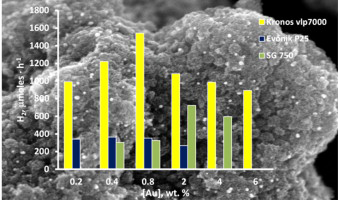
H2 production from methanol/water photo-splitting was compared using various commercial photocatalysts (Evonik P25 (P25), Hombikat UV-100 (HB) and Kronos vlp7000 (KR)) and others synthesised with a sol–gel-hydrothermal (HT) process and a sol–gel method followed by calcination (SG400 and SG750). All photocatalysts had been surface modified with Au at different concentrations, from 0.2 to 6.0 wt.%, using the photodeposition method. A complete characterisation study of the different photocatalysts was performed (BET, XRD, TEM, SEM-EDX, FTIR, UV–vis Reflectance Diffuse Spectra and aggregate size). The experiments were conducted for 3.5 h using 1 g L−1 of photocatalyst with methanol (25 vol.%) as sacrificial agent. In addition to H2 generation, production of the main intermediates, formaldehyde and formic acid, and of CO2 was also evaluated. The commercial photocatalyst KR at 0.8 wt.% Au had the highest H2 production of all the photocatalysts studied with 1542.9 μmol h−1. Of the photocatalysts synthesised by our group, SG750 at Au loading of 2.0 wt.% gave the highest H2 production of 723.1 μmol h−1. The SG750 photocatalyst at Au loading of 2.0 wt.% also had the highest H2 production yield per unit of surface area at 45.5 μmol g h−1 m−2.
Improved H2 production of Pt-TiO2/g-C3N4-MnOx composites by an efficient handling of photogenerated charge pairs
Obregon, S; Colon, G
Applied Catalysis B: Environmental, 144 (2014) 775-782 | DOI: 10.1016/j.apcatb.2013.07.034
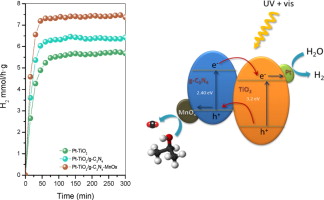
Pt-TiO2/g-C3N4-MnOx hybrid structures are synthesized by means of a simple impregnation method of Pt-TiO2 and g-C3N4-MnOx. From the wide structural and surface characterization we have stated that TiO2/g-C3N4 composites are formed by an effective covering of g-C3N4 by TiO2. The modification of composite by Pt and/or MnOx leads to improved photoactivities for phenol degradation reaction. Moreover, enhanced photoactivities have been obtained for composites systems for H2 evolution reaction. The notably photocatalytic performance obtained was related with the efficient separation of charge pairs in this hybrid heterostructure.
Effect of gold on a NiLaO3 perovskite catalyst for methane steam reforming
Palma, S; Bobadilla, LF; Corrales, A; Ivanova, S; Romero-Sarria, F; Centeno, MA; Odriozola, JA
Applied Catalysis B: Environmental, 144 (2014) 846-854 | DOI: 10.1016/j.apcatb.2013.07.055
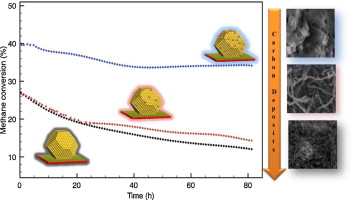
The effect of gold addition to a supported Ni SRM catalyst has been studied in this work in order to determine the influence of gold on both the amount and type of carbon species formed during the reaction. The structure of the support, a mixed La–Al perovskite, determines the catalyst reducibility and Ni particle size. Gold addition affects the metal particle size increasing metal dispersion on increasing the gold content. Therefore, although gold blocks step Ni sites, the more active sites for Csingle bondH activation, and increases electron density on nickel, the higher dispersion results in an apparently higher activity upon gold addition. Moreover, gold addition increases the catalyst stability by decreasing the rate of growth of carbon nanotubes.
Correlation study between photo-degradation and surface adsorption properties of phenol and methyl orange on TiO2 Vs platinum-supported TiO2
Murcia, JJ; Hidalgo, MC; Navio, JA; Arana, J; Dona-Rodriguez, JM
Applied Catalysis B: Environmental, 150-151 (2014) 107-115 | DOI: 10.1016/j.apcatb.2013.12.010
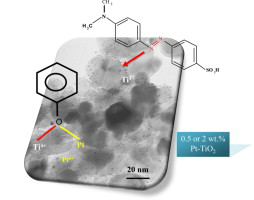
Adsorption of phenol and methyl orange on the surface of TiO2 and Pt–TiO2 photocatalysts was investigated by FT-IR spectroscopy. It was found that platinum plays an important role in the adsorption properties of the studied substrates on TiO2. Platinum deposits modified the phenol-photocatalyst interaction providing new adsorption sites on TiO2 surface. On Pt–TiO2 photocatalysts, phenol mainly interacts via formation of adsorbed phenolates species. It was also found that the adsorption of methyl orange on titania and Pt–TiO2 photocatalysts occurs via interaction of the azo group with surface Ti4+. Pt photodeposition significantly increases the TiO2 photoreactivity in phenol and methyl orange photo-degradation; however, this increase depends on the properties of the Pt deposits. Moreover, it was observed that platinum content is the main factor determining the substrate-photocatalyst interaction and therefore the Pt–TiO2 photocatalytic performance.
In situ XAS study of an improved natural phosphate catalyst for hydrogen production by reforming of methane
Abba, MO; Gonzalez-DelaCruz, VM; Colon, G; Sebti, S; Caballero, A
Applied Catalysis B: Environmental, 150-151 (2014) 459-465 | DOI: 10.1016/j.apcatb.2013.12.031
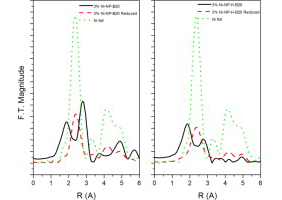
Some nickel catalysts supported on natural phosphate (NP) have been tested for the dry methane reforming reaction. Although the original impregnated 15%Ni/NP catalyst has no activity at all, the modification of the support by mechano-chemical and/or acid treatment strongly improved the catalytic performance, yielding a series of very active and stable catalysts. The chemical and physical characterization by X-ray diffraction (XRD), temperature programmed reduction (TPR), in situ X-ray absorption spectroscopy (XAS) and other techniques have shown that these treatments mainly modify the interaction between the nickel phase and the support surface. The nickel ions occupy calcium position in the surface of the phosphate phase, which stabilizes and improves the dispersion of nickel species. The final reduced catalysts present a much better dispersed metallic phase interacting with the NP surface, which has been identified as responsible for the observed outstanding catalytic performances.
Tailor-made directional emission in nanoimprinted plasmonic-based light-emitting devices
Lozano, G; Grzela, G; Verschuuren, MA; Ramezani, M; Rivas, JG
Nanoscale, 6 (2014) 9223-9229 | DOI: 10.1039/c4nr01391c
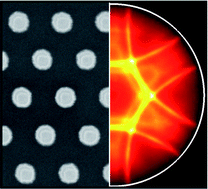
We demonstrate an enhanced and tailor-made directional emission of light-emitting devices using nanoimprinted hexagonal arrays of aluminum nanoparticles. Fourier microscopy reveals that the, luminescence of the device is not only determined by the material properties of the organic dye molecules but is also strongly influenced by the coherent scattering resulting from periodically arranged metal nanoparticles. Emitters can couple to lattice-induced hybrid plasmonic-photonic modes sustained by plasmonic arrays. Such modes enhance the spatial coherence of an emitting layer, allowing the efficient beaming of the emission along narrow angular and spectral ranges. We show that tailoring the separation of the nanoparticles in the array yields an accurate angular distribution of the emission. This combination of large-area metal nanostructures fabricated by nanoimprint lithography and light-emitting devices is beneficial for the design and optimization of solid-state lighting systems.
Shape-defined nanodimers by tailored heterometallic epitaxy
Garcia-Negrete, Carlos A; Rojas, Teresa C; Knappett, Benjamin R; Jefferson, David A; Wheatley, Andrew E H; Fernandez, Asuncion
Nanoscale, 6 (2014) 11090-11097 | DOI: 10.1039/C4NR01815J
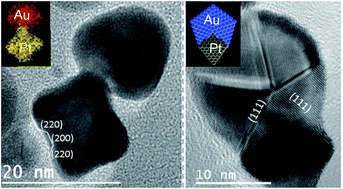
The systematic construction of heterogeneous nanoparticles composed of two distinct metal domains (Au and Pt) and exhibiting a broad range of morphologically defined shapes is reported. It is demonstrated that careful Au overgrowth on Pt nanocrystal seeds with shapes mainly corresponding to cubeoctahedra, octahedra and octapods can lead to heterometallic systems whose intrinsic structures result from specific epitaxial relationships such as {111} + {111}, {200} + {200} and {220} + {220}. Comprehensive analysis shows also that nanoparticles grown from octahedral seeds can be seen as comprising of four Au tetrahedral subunits and one Pt octahedral unit in a cyclic arrangement that is similar to the corresponding one in decahedral gold nanoparticles. However, in the present case, the multi-component system is characterized by a broken five-fold rotational symmetry about the [011] axis. This set of bimetallic dimers could provide new platforms for fuel cell catalysts and plasmonic devices.
Pt vs. Au in water-gas shift reaction
Castano, MG; Reina, TR; Ivanova, S; Centeno, MA; Odriozola, JA
Journal of Catalysis, 314 (2014) 1-9 | DOI: 10.1016/j.jcat.2014.03.014
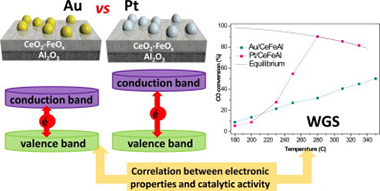
This work presents a comparison of the gold- and platinum-based catalysts behavior in the water–gas shift (WGS) reaction. The influence of the support, e.g., its composition and electronic properties, studied in detail by means of UV–Vis spectroscopy, of the metal nature and dispersion and of the stream composition has been evaluated. The catalytic performance of the samples is directly correlated with the electronic properties modification as a function of metal and/or support. Both metals present high activity in the selected reaction although in a different operation temperature window.
Direct evidence of Lowenstein's rule violation in swelling high-charge micas
Pavon, E; Osuna, FJ; Alba, MD; Delevoye, L
Chemical Communications, 53 (2014) 6984-6986 | DOI: 10.1039/C4CC01632G
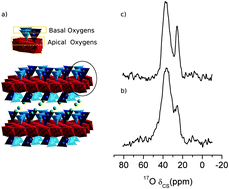
The structure of high-charged micas, Na-n-micas (n = 2 and 4), a family of synthetic silicates with a wide range of applications, was investigated through the use of 17O solid-state NMR at natural abundance in order to preserve quantitative spectral information. The use of a very high-field and highly sensitive probehead, together with 17O NMR literature data allowed for the detection of an isolated signal at 26 ppm, assigned partially to AlOAl, as evidence of the violation of Lowenstein's rule for Na-4-mica.
Bending Induced Self-Organized Switchable Gratings on Polymeric Substrates
Parra-Barranco, J; Oliva-Ramirez, M; Gonzalez-Garcia, L; Alcaire, M; Macias-Montero, M; Borras, A; Frutos, F; Gonzalez-Elipe, AR; Barranco, A
ACS Applied Materials & Interfaces, 6 (2014) 11924-11931 | DOI: 10.1021/am5037687
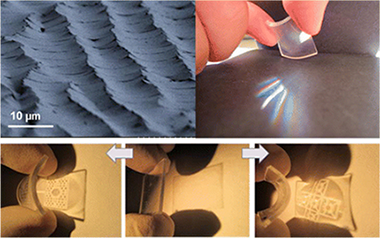
We present a straightforward procedure of self-surface patterning with potential applications as large area gratings, invisible labeling, optomechanical transducers, or smart windows. The methodology is based in the formation of parallel micrometric crack patterns when polydimethylsiloxane foils coated with tilted nanocolumnar SiO2 thin films are manually bent. The SiO2 thin films are grown by glancing angle deposition at room temperature. The results indicate that crack spacing is controlled by the film nanostructure independently of the film thickness and bending curvature. They also show that the in-plane microstructural anisotropy of the SiO2 films due to column association perpendicular to the growth direction determines the anisotropic formation of parallel cracks along two main axes. These self-organized patterned foils are completely transparent and work as customized reversible diffraction gratings under mechanical activation.
Ceramic Barrier Layers for Flexible Thin Film Solar Cells on Metallic Substrates: A Laboratory Scale Study for Process Optimization and Barrier Layer Properties
Delgado-Sanchez, JM; Guilera, N; Francesch, L; Alba, MD; Lopez, L; Sanchez, E
ACS Applied Materials & Interfaces, 6 (2014) 18543-18549 | DOI: 10.1021/am504923z

Flexible thin film solar cells are an alternative to both utility-scale and building integrated photovoltaic installations. The fabrication of these devices over electrically conducting low-cost foils requires the deposition of dielectric barrier layers to flatten the substrate surface, provide electrical isolation between the substrate and the device, and avoid the diffusion of metal impurities during the relatively high temperatures required to deposit the rest of the solar cell device layers. The typical roughness of low-cost stainless-steel foils is in the hundred-nanometer range, which is comparable or larger than the thin film layers comprising the device and this may result in electrical shunts that decrease solar cell performance. This manuscript assesses the properties of different single-layer and bilayer structures containing ceramics inks formulations based on Al2O3, AlN, or Si3N4 nanoparticles and deposited over stainless-steel foils using a rotogravure printing process. The best control of the substrate roughness was achieved for bilayers of Al2O3 or AlN with mixed particle size, which reduced the roughness and prevented the diffusion of metals impurities but AlN bilayers exhibited as well the best electrical insulation properties.
A General Perspective of the Characterization and Quantification of Nanoparticles: Imaging, Spectroscopic, and Separation Techniques
Lapresta-Fernandez, A; Salinas-Castillo, A; de la Llana, SA; Costa-Fernandez, JM; Dominguez-Meister, S; Cecchini, R; Capitan-Vallvey, LF; Moreno-Bondi, MC; Marco, MP; Sanchez-Lopez, JC; Anderson, IS
Critical Reviews in Solid State and Materials Sciences, 39 (2014) 423-458 | DOI: 10.1080/10408436.2014.899890
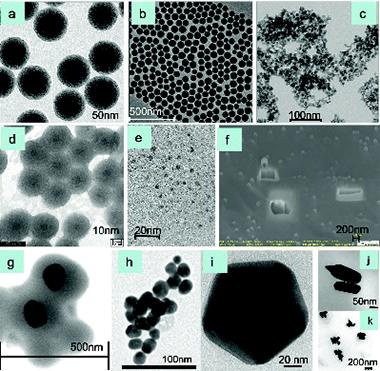
This article gives an overview of the different techniques used to identify, characterize, and quantify engineered nanoparticles (ENPs). The state-of-the-art of the field is summarized, and the different characterization techniques have been grouped according to the information they can provide. In addition, some selected applications are highlighted for each technique. The classification of the techniques has been carried out according to the main physical and chemical properties of the nanoparticles such as morphology, size, polydispersity characteristics, structural information, and elemental composition. Microscopy techniques including optical, electron and X-ray microscopy, and separation techniques with and without hyphenated detection systems are discussed. For each of these groups, a brief description of the techniques, specific features, and concepts, as well as several examples, are described.
Chemical and electrical properties of LSM cathodes prepared by mechanosynthesis
Moriche, R.; Marrero-López, D.; Gotor, F.J.; Sayagués, M.J.
Journal of Power Sources, 252 (2014) 43-50 | DOI: 10.1016/j.jpowsour.2013.11.093
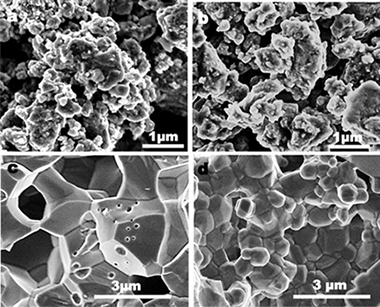
Mechanosynthesis of La1−xSrxMnO3 (x = 0, 0.25, 0.5, 0.75 and 1) was carried out at room temperature from stoichiometric mixtures of La2O3, Mn2O3 and SrO, obtaining monophasic powders with the perovskite structure. Physical properties of these materials and their chemical compatibility with the electrolyte yttria stabilized zirconia (YSZ), which depend strongly on the La/Sr ratio, were evaluated to corroborate availability to be implemented as cathode material in solid oxide fuel cells (SOFCs). Electrical conductivity values in air ranged between 100 and 400 S cm−1 in the temperature range of 25–850 °C. Samples presented low reactivity with YSZ in the working temperature range (600–1000 °C) maintaining the grain size small enough to preserve the catalytic activity for oxygen reduction.
Impregnation of carbon black for the examination of colloids using TEM
Gontard, LC; Knappett, BR; Wheatley, AEH; Chang, SLY; Fernandez, A
Carbon, 76 (2014) 464-468 | DOI: 10.1016/j.carbon.2014.05.006
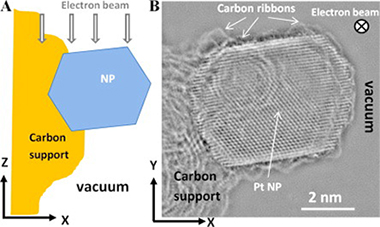
Nanoparticles are frequently synthesised as colloids, dispersed in solvents such as water, hexane or ethanol. For their characterisation by transmission electron microscopy (TEM), a drop of colloid is typically deposited on a carbon support and the solvent allowed to evaporate. However, this method of supporting the nanoparticles reduces the visibility of fine atomic details, particularly for carbonaceous species, due to interference from the 2-dimensional carbon support at most viewing angles. We propose here the impregnation of a 3 dimensional carbon black matrix that has been previously deposited on a carbon film as an alternative means of supporting colloidal nanoparticles, and show examples of the application of this method to advanced TEM techniques in the analysis of monometallic, core@shell and hybrid nanoparticles with carbon-based shells.
Nanoparticles represent one of the most studied structures in nanotechnology and nanoscience because of the wide range of applications arising from their unique optical, physical and chemical properties [1]. Often they have core@shell structures, or are coated with organic molecules. Nanoparticle functionality is largely affected by the specific configuration of the outer surface atoms. For example, in heterogeneous catalysis activity and selectivity are mostly determined by the type of atomic defects present at the surface of metallic nanoparticles, and in the field of biomedicine the surface coating of hybrid (inorganic core@organic shell) nanoparticles regulates their stability, solubility and targeting.
Nanoparticles are frequently synthesised using solution techniques that yield colloids, i.e., a solid–liquid mixture containing solid particles that are dispersed to various degrees in a liquid medium; most frequently water, ethanol or hexane. Colloid characterisation generally employs a variety of techniques to establish understanding and control over nanoparticle synthesis and properties. Electron microscopy in transmission mode (TEM) and in scanning transmission mode (STEM) are widely used for particle characterisation, and advances in these techniques mean that it is now routinely possible to resolve single atoms at the surfaces of nanoparticles using aberration-corrected microscopes, to elucidate the three-dimensional shapes of nanoparticles using electron tomography, and to enhance the contrast in very low density materials (e.g., carbonaceous materials) using electron holography [2] and [3]. However, the significant potential of these (S)TEM techniques is ultimately limited by the sample and the techniques available for sample preparation.
Typically, examination by (S)TEM requires that a nanoparticulate sample be prepared by depositing a drop of colloid on a thin, electron-transparent support. It is usual that an amorphous carbon film, silicon nitride film or graphene layers deposited on a copper grid constitute the support [4]. Crucially, these sample preparation techniques suffer from the major limitation that the contrast from the support often shadows atomic details at the particle surface. Moreover, it has been established that the thinnest supports can degrade under electron-beam irradiation, affecting particle stability [5], and also that hydrocarbon contamination can be an issue [6]. The most widely used commercially available TEM support is holey carbon, which comprises of a perforated carbon thin film. In this case, sample preparation aims to locate at least some of the nanoparticles of interest at the edges of the perforations. However, the concave nature of the holes means that solvent contaminants tend to accumulate preferentially at these sites. Moreover, if the TEM sample holder is tilted a particle attached to the edge of a hole is very likely to be shadowed by the carbon film. Taken together, these drawbacks significantly limit the application of techniques such as electron tomography [6].
We propose here a method of circumventing some of these fundamental problems by developing a technique for mounting nanoparticulate samples using a carbon matrix that is inspired by the way samples used in electrocatalysis are prepared [7]. Fig. 1 shows an image of a typical Pt-based electrocatalyst supported on carbon black as used in proton-electron membrane fuels cells, and which consists of Pt nanoparticles formed by calcination of a carbon black impregnated with a solution of salt precursor. Carbon black is a low-grade form of graphite, which is composed of nanocrystallites and no long-range order [8]. In Fig. 1 the carbon black is Vulcan XC-72R, which is widely used as a catalyst support in fuel cells because it provides high electrical conductivity, good reactant gas access, adequate water handling and good corrosion resistance, whilst allowing high dispersion of the particles. In electrocatalyst samples it is common to find particles, like the 5 nm Pt particle shown in Fig. 1, attached strongly to the surface of the support and viewed edge-on against a vacuum so as to provide optimal conditions for high-resolution TEM (HRTEM). Fig. 1B is a quantitative phase image of a Pt particle obtained from a defocus series of 20 images at intervals of 5 nm acquired in a FEGTEM JEOL 2020 at 200 kV with spherical aberration of −30 μm and applying the exit-wave restoration technique [2]. The contrast between details of the particle finestructure is very high compared to conventional HRTEM images, and details such as the presence of monoatomic carbon ribbons surrounding the particle can be seen.
Effect of the type of acid used in the synthesis of titania–silica mixed oxides on their photocatalytic properties
Llano, B; Hidalgo, MC; Rios, LA; Navio, JA
Applied Catalysis B: Environmental, 150-151 (2014) 389-395 | DOI: 10.1016/j.apcatb.2013.12.039
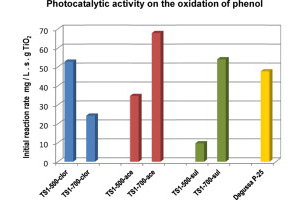
TiO2–SiO2 mixed oxides were synthesized by the sol–gel technique using three different acids, i.e., acetic, sulfuric, or chlorhydric acid. Their photocatalytic behavior was evaluated on the phenol oxidation in liquid phase and correlated with the characterization results. It was found that the kind of acid used during the preparation strongly influences the phase composition and stability of the TiO2 phases incorporated in the silica structure as well as the photocatalytic activity. In all cases, silica introduced a dispersive effect that stabilized the TiO2 crystalline phases upon calcination at 700 °C. SO42− and CH3COO− ions stabilized the anatase phase at high calcination temperatures (700 °C) leading to samples with the highest photoactivities. Cl− ions induced the formation of traces of rutile and brookite resulting in a lower photoactivity. The highest photoactivity was achieved with the catalyst synthesized with acetic acid and calcined at 700 °C (TS1-700-ace). The photocatalytic performance of this material was even better than that obtained with the commercial catalyst Degussa P-25.
Nanosilica supported CaO: A regenerable and mechanically hard CO2 sorbent at Ca-looping conditions
Sanchez-Jimenez, PE; Perez-Maqueda, LA; Valverde, JM
Applied Energy, 118 (2014) 92-99 | DOI: 10.1016/j.apenergy.2013.12.024
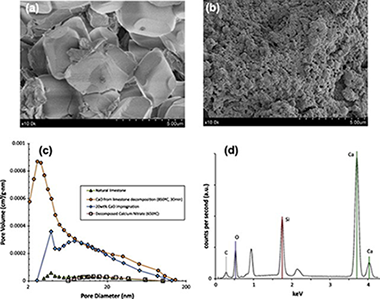
This work presents a CO2 sorbent that may be synthesized from low-cost and widely available materials following a simple method basically consisting of impregnation of a nanostructured silica support with a saturated solution of calcium nitrate. In a first impregnation stage, the use of a stoichiometric CaO/SiO2 ratio serves to produce a calcium silicate matrix after calcination. This calcium silicate matrix acts as a thermally stable and mechanically hard support for CaO deposited on it by further impregnation. The CaO-impregnated sorbent exhibits a stable CaO conversion at Ca-looping conditions whose value depends on the CaO wt% deposited on the calcium silicate matrix, which can be increased by successive reimpregnations. A 10 wt% CaO impregnated sorbent reaches a stable conversion above 0.6 whereas the stable conversion of a 30 wt% CaO impregnated sorbent is around 0.3, which is much larger than the residual conversion of CaO derived from natural limestone (between 0.07 and 0.08). Moreover, particle size distribution measurements of samples predispersed in a liquid and subjected to high energy ultrasonic waves indicate that the CaO-impregnated sorbent has a relatively high mechanical strength as compared to limestone derived CaO.
Calcium-looping for post-combustion CO2 capture. On the adverse effect of sorbent regeneration under CO2
Valverde, JM; Sanchez-Jimenez, PE; Perez-Maqueda, LA
Applied Energy, 126 (2014) 161-171 | DOI: 10.1016/j.apenergy.2014.03.081
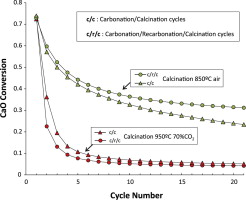
The multicyclic carbonation/calcination (c/c) of CaO solid particles at high temperature is at the basis of the recently emerged Calcium-looping (CaL) technology, which has been shown to be potentially suitable for achieving high and sustainable post-combustion CO2 capture efficiency. Despite the success of pilot plant projects at the MWth scale, a matter of concern for scaling-up the CaL technology to a commercial level (to the GWth scale) is that the CaO carbonation reactivity can be recovered only partially when the sorbent is regenerated by calcination at high temperatures (around 950 °C) as required by the CO2 high concentration in the calciner. In order to reactivate the sorbent, a novel CaL concept has been proposed wherein a recarbonator reactor operated at high temperature/high CO2 concentration leads to further carbonation of the solids before entering into the calciner for regeneration. Multicyclic thermogravimetric analysis (TGA) tests demonstrate the feasibility of recarbonation to reactivate the sorbent regenerated at high calcination temperatures yet at unrealistically low CO2 partial pressure mainly because of technical limitations concerning low heating/cooling rates. We report results from multicyclic c/c and carbonation/recarbonation/calcination (c/r/c) TGA tests at high heating/coling rates and in which the sorbent is regenerated in a dry atmosphere at high CO2 partial pressure. It is shown that at these conditions there is a drastic drop of CaO conversion to a very small residual value in just a few cycles. Moreover, the introduction of a recarbonation stage has actually an adverse effect. Arguably, CaCO3 decomposition in a CO2 rich atmosphere is ruled by CO2 dynamic adsorption/desorption in reactive CaO (1 1 1) surfaces as suggested by theoretical studies, which would preclude the growth of the regenerated CaO crystal structure along these reactive surfaces, and this effect would be intensified by recarbonation. Nevertheless, the presence of H2O in the calciner, which is also adsorbed/desorbed dynamically in CaO reactive planes, would shield CO2 adsorption/desorption thus mitigating the deeply detrimental effect of CO2 on the carbonation reactivity of the regenerated CaO structure. Oxy-combustion, which produces a significant amount of H2O, is currently used in pilot-scale plants to raise the temperature in the calciner. Auxiliary techniques are being explored to help heating the partially carbonated solids since oxyxombustion represents an important penalty to the CaL technology. Our study suggests that steam injection would be necessary in a dry calciner environment to avoid a sharp loss of CaO conversion if the sorbent is regenerated at high CO2 partial pressure.
Role of precalcination and regeneration conditions on postcombustion CO2 capture in the Ca-looping technology
Valverde, JM; Sanchez-Jimenez, PE; Perez-Maqueda, LA
Applied Energy, 136 (2014) 347-356 | DOI: 10.1016/j.apenergy.2014.09.052
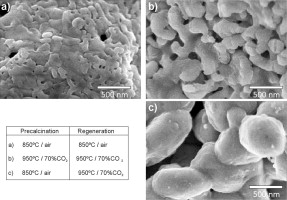
The Ca-looping (CaL) technology is already recognized as a potentially viable method to capture CO2 from postcombustion gas in coal fired power plants. In this process, CO2 is chemisorbed by CaO solid particles derived from precalcination of cheap and widely available natural limestone. The partially carbonated solids are regenerated by calcination under high CO2 concentration. Novel CaL concepts are proposed to further improve the efficiency of the technology such as the introduction of a recarbonation reactor in between the carbonation and calcination stages to mitigate the progressive deactivation of the regenerated CaO. Process simulations aimed at retrieving optimum design parameters and operating conditions to scale-up the technology yield results critically dependent on the multicyclic sorbent performance. Nevertheless, technical limitations usually preclude lab-scale tests from mimicking realistic CaL conditions necessarily involving high CO2 concentration for sorbent regeneration and quick transitions between carbonation and calcination. In this work, a lab-scale experimental analysis is reported on the CaO multicyclic conversion at CaL conditions closely resembling those to be expected in practice. The results presented evidence a relevant role of precalcination conditions. Precalcination in air leads to a strongly adverse effect on the activity of the sorbent regenerated under high CO2 concentration, which is further hindered if a recarbonation stage is introduced. On the other hand, sorbent deactivation is mitigated if precalcination is carried out at conditions similar to those used for sorbent regeneration. In this case, recarbonation helps lessening the loss of multicyclic conversion, which is further enhanced by the synergistic combination with heat pretreatment. Moreover, the present study shows that the kinetics of carbonation is strongly dependent on precalcination and regeneration conditions. The diffusion controlled carbonation phase and recarbonation are intensified if the sorbent is precalcined and regenerated under high CO2 concentration whereas the reaction controlled carbonation phase is notably hampered.
Improved O-2 evolution from a water splitting reaction over Er3+ and Y3+ co-doped tetragonal BiVO4
Obregon, S; Colon, G
Catalysis Science & Technology, 4 (2014) 2042-2050 | DOI: 10.1039/C4CY00050A
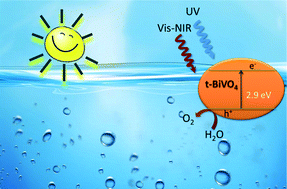
Erbium–yttrium co-doped BiVO4 with a tetragonal structure is synthesized by means of a surfactant free hydrothermal method. The studied photocatalyst shows good photoactivity under sun-like excitation for the degradation of methylene blue (MB) and for O2 evolution. From structural and morphological characterization, it has been stated that the presence of lanthanides induces the stabilization of the tetragonal phase. This is probably due to the substitutional occupation that occurs in the BiVO4 lattice. The photocatalytic performance under visible-NIR radiation clearly evidences the occurrence of an up-conversion process involved in the overall photo-electronic mechanism. The tetragonal phase Er0.0075,Y0.03–Bi0.9625VO4 system gives the highest O2 evolution rate (425 μmol g−1 h−1) under sun-like excitation, being 8 times higher than that attained for m-BiVO4 (53 μmol g−1 h−1).
Relevant Influence of Limestone Crystallinity on CO2 Capture in The Ca-Looping Technology at Realistic Calcination Conditions
Valverde, JM; Sanchez-Jimenez, PE; Perez-Maqueda, LA
Environmental Science & Technology, 48 (2014) 9882-9889 | DOI: 10.1021/es5014505
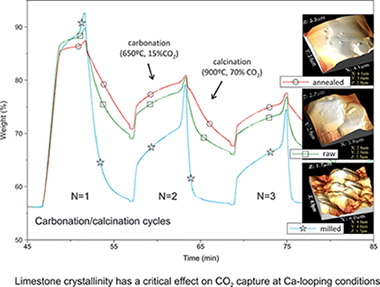
We analyze the role of limestone crystallinity on its CO2 capture performance when subjected to carbonation/calcination cycles at conditions mimicking the Ca-looping (CaL) technology for postcombustion CO2 capture. The behavior of raw and pretreated limestones (milled and thermally annealed) is investigated by means of thermogravimetric analysis (TGA) tests under realistic sorbent regeneration conditions, which necessarily involve high CO2 partial pressure in the calciner and quick heating rates. The pretreatments applied lead to contrasting effects on the solid crystal structure and, therefore, on its resistance to solid-state diffusion. Our results show that decarbonation at high CO2 partial pressure is notably promoted by decreasing solid crystallinity. CaO regeneration is fully achieved under high CO2 partial pressure at 900 °C in short residence times for the milled limestone whereas complete regeneration for raw limestone requires a minimum calcination temperature of about 950 °C. Such a reduction of the calcination temperature and the consequent mitigation of multicyclic capture capacity decay would serve to enhance the efficiency of the CaL technology. On the other hand, the results of our study suggest that the use of highly crystalline limestones would be detrimental since excessively high calcination temperatures should be required to attain full decarbonation at realistic conditions.
Role of crystal structure on CO2 capture by limestone derived CaO subjected to carbonation/recarbonation/calcination cycles at Ca-looping conditions
Valverde, JM; Sanchez-Jimenez, PE; Perez-Maqueda, LA; Quintanilla, MAS; Perez-Vaquero, J
Applied Energy, 125 (2014) 264-275 | DOI: 10.1016/j.apenergy.2014.03.065
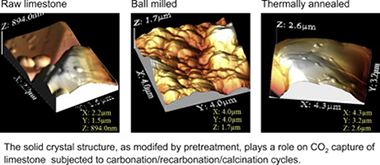
Large scale pilot plants are currently demonstrating the feasibility of the Calcium-looping (CaL) technology built on the multicyclic calcination/carbonation of natural limestone for post-combustion and precombustion CO2 capture. Yet, limestone derived CaO exhibits a drop of conversion when subjected to multiple carbonation/calcination cycles, which lessens the efficiency of the technology. In this paper we analyze a novel CaL concept recently proposed to mitigate this drawback based on the introduction of an intermediate stage wherein carbonation is intensified at high temperature and high CO2 partial pressure. It is shown that carbonation in this stage is mainly driven by solid-state diffusion, which is determined by the solid's crystal structure. Accordingly, a reduction of crystallinity by ball milling, which favors diffusion, serves to promote recarbonation. Conversely, thermal annealing, which enhances crystallinity, hinders recarbonation. An initial fast phase has been identified in the recarbonation stage along which the rate of carbonation is also a function of the crystal structure indicating a relevant role of surface diffusion. This is consistent with a recently proposed mechanism for nucleation of CaCO3 on the CaO surface in islands with a critical size determined by surface diffusion. A further issue analyzed has been the effects of pretreatment and cycling on the mechanical strength of the material, whose fragility hampers the CaL process efficiency. Particle size distribution of samples dispersed in a liquid and subjected to high energy ultrasonic irradiation indicate that milling promotes friability whereas thermal annealing enhances the resistance of the particles to fragmentation even though pretreatment effects become blurred after cycling. Our study demonstrates that recarbonation conditions and crystal-structure controlled diffusion are important parameters to be considered in order to assess the efficiency of CO2 capture in the novel CaL concept.
Hallmarks of mechanochemistry: from nanoparticles to technology
Balaz, P; Achimovicova, M; Balaz, M; Billik, P; Cherkezova-Zheleva, Z; Criado, JM; Delogu, F; Dutkova, E; Gaffet, E; Gotor, FJ; Kumar, R; Mitov, I; Rojac, T; Senna, M; Streletskii, A; Wieczorek-Ciurowa, K
Chemical Society Reviews, 42 (2013) 7571-7637 | DOI: 10.1039/C3CS35468G
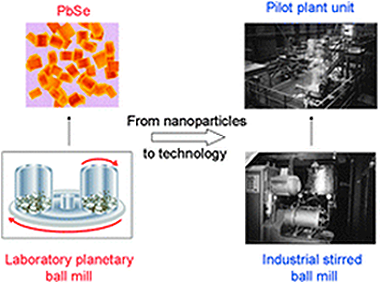
The aim of this review article on recent developments of mechanochemistry (nowadays established as a part of chemistry) is to provide a comprehensive overview of advances achieved in the field of atomistic processes, phase transformations, simple and multicomponent nanosystems and peculiarities of mechanochemical reactions. Industrial aspects with successful penetration into fields like materials engineering, heterogeneous catalysis and extractive metallurgy are also reviewed. The hallmarks of mechanochemistry include influencing reactivity of solids by the presence of solid-state defects, interphases and relaxation phenomena, enabling processes to take place under non-equilibrium conditions, creating a well-crystallized core of nanoparticles with disordered near-surface shell regions and performing simple dry time-convenient one-step syntheses. Underlying these hallmarks are technological consequences like preparing new nanomaterials with the desired properties or producing these materials in a reproducible way with high yield and under simple and easy operating conditions. The last but not least hallmark is enabling work under environmentally friendly and essentially waste-free conditions (822 references).
Tuning Dichroic Plasmon Resonance Modes of Gold Nanoparticles in Optical Thin Films
Gonzalez-Garcia, L; Parra-Barranco, J; Sanchez-Valencia, JR; Ferrer, J; Garcia-Gutierrez, MC; Barranco, A; Gonzalez-Elipe, AR
Advanced Functional Materials, 23 (2013) 1655-1663 | DOI: 10.1002/adfm.201201900
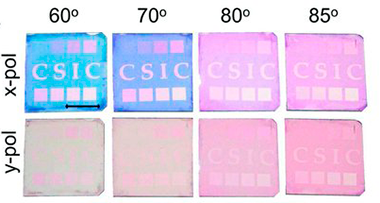
A simple method is presented to tune the gold surface plasmon resonance (SPR) modes by growing anisotropic nanoparticles into transparent SiO2 thin films prepared by glancing angle deposition. In this type of composite film, the anisotropy of the gold nanoparticles, proved by gracing incidence small angle X-ray scattering, is determined by the tilted nanocolumnar structure of the SiO2 host and yields a strong film dichroism evidenced by a change from an intense colored to a nearly transparent aspect depending on light polarization and/or sample orientation. The formation in these films of lithographic non-dichroic SPR patterns by nanosecond laser writing demonstrates the potentialities of this procedure to develop novel optical encryption or anti-counterfeiting structures either at micrometer- or macroscales.
Angular response of photonic crystal based dye sensitized solar cells
López López, C.; Colodrero, S.; Calvo, M.E. and Míguez, H.
Energy & Environmental Science, 6 (2013) 1260-1266 | DOI: 10.1039/C3EE23609A
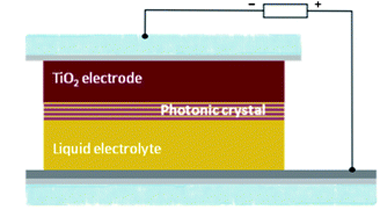
Herein we report an experimental analysis of the performance of photonic crystal based dye solar cells (PC-DSCs) as the incident light angle moves away from the normal with respect to the cell surface. Nanoparticle multilayers operating at different wavelength ranges were coupled to the working electrode of a dye solar cell for this study. The interplay between optical and photovoltaic properties with the incident light angle is discussed. We demonstrate that an efficiency enhancement is attained for PC-DSCs at all angles measured, and that rational design of the photonic crystal back mirror leads to a reduction of the photocurrent losses related to the tilt angle of the cell, usually labeled as cosine losses. Angular variations of the cell transparency are also reported and discussed. These angular properties are relevant to the application of these solar devices in building integrated photovoltaics as potential window modules.
Tuning of Cell–Biomaterial Anchorage for Tissue Regeneration
Leal-Egana, Aldo; Diaz-Cuenca, Aranzazu; Boccaccini, Aldo R
Advanced Materials, 25 (2013) 4049-4057 | DOI: 10.1002/adma.201301227
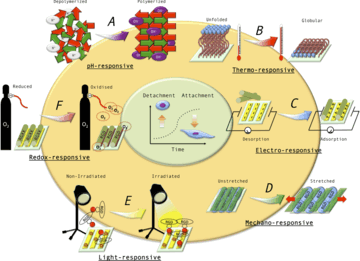
Which mechanisms mediate cell attachment to biomaterials? What role does the surface charge or wettability play on cell–material anchorage? What are the currently investigated strategies to modify cell–matrix adherence spatiotemporally? Considering the development of scaffolds made of biocompatible materials to temporarily replace the structure and/or function of the extracellular matrix, focus is given to the analysis of the specific (i.e., cell adhesive peptide sequences) and unspecific (i.e., surface charge, wettability) mechanisms mediating cell-matrix interactions. Furthermore, because natural tissue regeneration is characterized by the dynamic attachment/detachment of different cell populations, the design of advanced scaffolds for tissue engineering, based in the spatiotemporal tuning of cell–matrix anchorage is discussed.
Resonant Photocurrent Generation in Dye-Sensitized Periodically Nanostructured Photoconductors by Optical Field Confinement Effects
Anaya, M; Calvo, ME; Luque-Raigon, JM; Miguez, H
Journal of the American Chemical Society, 135 (2013) 7803-7806 | DOI: 10.1021/ja401096k
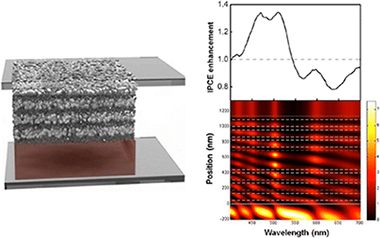
Herein we show experimental evidence of resonant photocurrent generation in dye-sensitized periodically nanostructured photoconductors, which is achieved by spectral matching of the sensitizer absorption band to different types of localized photon modes present in either periodic or broken symmetry structures. Results are explained in terms of the calculated spatial distribution of the electric field intensity within the configurations under analysis.
Selective UV Reflecting Mirrors Based on Nanoparticle Multilayers
Smirnov, JRC; Calvo, ME; Miguez, H
Advanced Functional Materials, 23 (2013) 2805-2811 | DOI: 10.1002/adfm.201202587
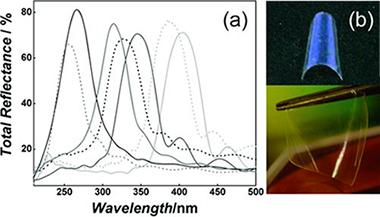
A new type of nanostructured selective ultraviolet (UV) reflecting mirror is presented. Periodic porous multilayers with photonic crystal properties are built by spin-coating-assisted layer-by-layer deposition of colloidal suspensions of nanoparticles of ZrO2 and SiO2 (electronic band gap at λ < 220 nm). These optical filters are designed to block well-defined wavelength ranges of the UVA, UVB, and UVC regions of the electromagnetic spectrum while preserving transparency in the visible. The shielding against those spectral regions arises exclusively from optical interference phenomena and depends only on the number of stacked layers and the refractive index contrast between them. In addition, it is shown that the accessible pore network of the as-deposited multilayer allows preparing thin, flexible, self-standing, transferable, and adaptable selective UV filters by polymer infiltration, without significantly losing reflectance intensity, i.e., preserving the dielectric contrast. These films offer a degree of protection comparable to that of traditional ones, without any foreseeable unwanted secondary effects, such as photodegradation, increase of local temperature or, as is the case for organic absorbers, generation of free radicals, all of which are caused by light absorption.
Vertically Aligned Hybrid Core/Shell Semiconductor Nanowires for Photonics Applications
Macias-Montero, M; Filippin, AN; Saghi, Z; Aparicio, FJ; Barranco, A; Espinos, JP; Frutos, F; Gonzalez-Elipe, AR; Borras, A
Advanced Functional Materiales, 23 (2013) 5981-5989 | DOI: 10.1002/adfm.201301120
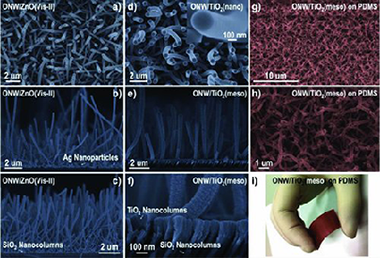
A family of 1D organic/inorganic core/shell materials formed by an inner organic nanowire (ONW) conformally covered with an inorganic wide band gap semiconductor (ZnO or TiO2) layer is presented. The developed procedure is a two-steps vacuum methodology involving the formation of supported single crystal small-molecule nanowires by physical vapor deposition and plasma enhance chemical vapor deposition (PECVD) of the inorganic shell. Critical characteristics of the last technique are the possibilities of low temperature and remote configuration deposition. Additionally, an initial step has to be included in order to create nucleation centers for the growth of the ONWs. The procedure and its general character in terms of the variability in organic core and inorganic shells composition and the applicability of the technique to different substrates are presented. The formation of the inorganic shell with no damage of the organic core single-crystalline structure is demonstrated by high resolution transmission electron microscopy. The vertical alignment of the hybrid nanostructure is achieved thanks to the interaction of the 1D organic nanostructured surfaces and the glow discharge during the deposition of the inorganic shell by PECVD. The optical properties of these core/shell NWs are studied by fluorescence spectroscopy and microscopy, and their application as nanoscale waveguides in the 550–750 nm range addressed.
Perfectly Transparent Sr3Al2O6 Polycrystalline Ceramic Elaborated from Glass Crystallization
Alahrache, S; Al Saghir, K; Chenu, S; Veron, E; Meneses, DD; Becerro, AI; Ocana, M; Moretti, F; Patton, G; Dujardin, C; Cusso, F; Guin, JP; Nivard, M; Sangleboeuf, JC; Matzen, G; Allix, M
Chemistry of Materials, 25 (2013) 4017-4024 | DOI: 10.1021/cm401953d
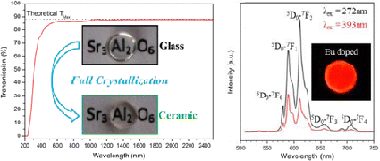
The highly visible and infrared (up to 6 mu m) transparent Sr3Al2O6 polycrystalline ceramic was obtained by full crystallization of the corresponding glass composition. The glass synthesis and the direct congruent crystallization processes are described, and the material transparency is discussed in light of its microstructure. This new transparent ceramic exhibits a high density (i.e., complete absence of porosity) and micrometer-scale crystallites with very thin grain boundaries. These microstructural characteristics, inherent to the preparation method, minimize light scattering and demonstrate the advantages of this synthesis route compared to the high-pressure process used for the few reported transparent polycrystalline materials. This Sr3Al2O6 ceramic shows a H = 10.5 GPa hardness, a E-r = 150 GPa reduced elasticity modulus, and a 9.6 x 10(-6) K-1 thermal expansion coefficient. Such a transparent strontium aluminate ceramic opens the way to a wide range of applications, especially photonics when doped by various doping agents. As examples, the luminescence of Sr3Al2O6:Eu3+ and Sr3Al2O6:Er3+, which show strong emissions in the visible and infrared ranges, respectively, is presented. Moreover, the Sr3Al2O6:Ce3+ material was found to exhibit scintillation properties under X-ray excitation. Interestingly, the analogous Sr3Ga2O6 transparent polycrystalline ceramic material could equally be prepared using the same elaboration method, although its hygroscopicity prevents the preservation of its high transparency under normal conditions. The establishment of the key factors for the transparency of this economical and innovative synthesis method should enable the prediction of new classes of technologically relevant transparent ceramics.
Competing Misfit Relaxation Mechanisms in Epitaxial Correlated Oxides
Sandiumenge, F; Santiso, J; Balcells, L; Konstantinovic, Z; Roqueta, J; Pomar, A; Espinos, JP; Martinez, B
Physical Review Letters, 110 (2013) 107206 | DOI: 10.1103/PhysRevLett.110.107206
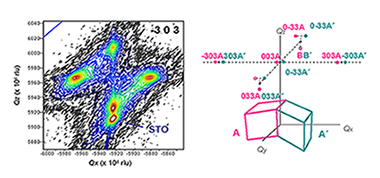
Strain engineering of functional properties in epitaxial thin films of strongly correlated oxides exhibiting octahedral-framework structures is hindered by the lack of adequate misfit relaxation models. Here we present unreported experimental evidence of a four-stage hierarchical development of octahedral-framework perturbations resulting from a progressive imbalance between electronic, elastic, and octahedral tilting energies in La0.7Sr0.3MnO3 epitaxial thin films grown on SrTiO3 substrates. Electronic softening of the Mn-O bonds near the substrate leads to the formation of an interfacial layer clamped to the substrate with strongly degraded magnetotransport properties, i.e., the so-called dead layer, while rigid octahedral tilts become relevant at advanced growth stages without significant effects on charge transport and magnetic ordering.
Promotional effect of the base metal on bimetallic Au-Ni/CeO2 catalysts prepared from core-shell nanoparticles
Holgado, JP; Ternero, F; Gonzalez-delaCruz, VM; Caballero, A
ACS Catalysis, 3 (2013) 2169-2180 | DOI: 10.1021/cs400293b
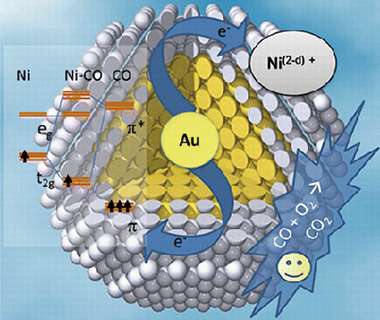
A set of three catalysts (a Au–Ni bimetallic and their corresponding Au and Ni monometallics) has been prepared by impregnation of previously prepared suspensions of monodisperse metallic particles to ensure the precise control of their physicochemical characteristics (size and composition). The Au–Ni/CeO2 bimetallic catalysts present better reactivity toward CO oxidation than monometallic Au/CeO2 and Ni/CeO2 prepared under identical conditions. “operando-like” characterization of Ni and Au atoms into the bimetallic particles using, among other techniques, ambient-pressure photoelectron spectroscopy and diffuse reflectance infrared Fourier transform spectroscopy has allowed us to determine that under oxidative conditions the samples present a Au@NiO core–shell distribution, where Ni surface atoms are affected by an electronic effect from inner Au atoms.
Characterisation of Co@Fe3O4 core@shell nanoparticles using advanced electron microscopy
Knappett, BR; Abdulkin, P; Ringe, E; Jefferson, DA; Lozano-Perez, S; Rojas, TC; Fernandez, A; Wheatley, AEH
Nanoscale, 5 (2013) 5765-5772 | DOI: 10.1039/C3NR33789H
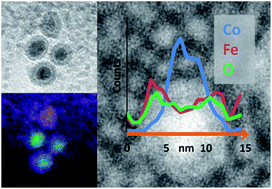
Cobalt nanoparticles were synthesised via the thermal decomposition of Co2(CO)8 and were coated in iron oxide using Fe(CO)5. While previous work focused on the subsequent thermal alloying of these nanoparticles, this study fully elucidates their composition and core@shell structure. State-of-the-art electron microscopy and statistical data processing enabled chemical mapping of individual particles through the acquisition of energy-filtered transmission electron microscopy (EFTEM) images and detailed electron energy loss spectroscopy (EELS) analysis. Multivariate statistical analysis (MSA) has been used to greatly improve the quality of elemental mapping data from core@shell nanoparticles. Results from a combination of spatially resolved microanalysis reveal the shell as Fe3O4 and show that the core is composed of oxidatively stable metallic Co. For the first time, a region of lower atom density between the particle core and shell has been observed and identified as a trapped carbon residue attributable to the organic capping agents present in the initial Co nanoparticle synthesis.
High temperature plasticity in yttria stabilised tetragonal zirconia polycrystals (Y-TZP)
Dominguez-Rodriguez, A; Gomez-Garcia, D; Wakai, F
International Materials Reviews, 58 (2013) 399-417 | DOI: 10.1179/1743280413Y.0000000018
The literature data on the superplastic deformation of high purity yttria stabilised tetragonal zirconia polycrystals is reviewed in detail. It is shown that, based on the existence of a threshold stress, the single mechanism of grain boundary sliding (GBS) accommodated by diffusional processes can explain the superplasticity of these materials over all the ranges of temperature, stress, grain size, and surrounding atmosphere that have been studied. The origin of the threshold stress and its quantitative dependence on temperature and grain size is explained in terms of the segregation of yttrium atoms at the grain boundaries. A new model for GBS accommodated by lattice or grain-boundary diffusion is presented which can explain the transition of the stress exponent from 2 to 1.
A single-source route to bulk samples of C3N and the co-evolution of graphitic carbon microspheres
King, TC; Matthews, PD; Holgado, JP; Jefferson, DA; Lambert, RM; Alavi, A; Wright, DS
Carbon, 64 (2013) 6-10 | DOI: 10.1016/j.carbon.2013.04.043
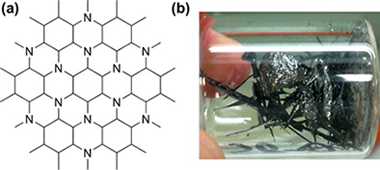
The thermolysis of commercially available m-phenylenediamine (1,3-(NH2)2C6H4) at 800 °C under a static vacuum in a sealed quartz tube provides the first bulk synthesis of C3N, whose properties have only been predicted theoretically previously. Hollow carbon microspheres (CMSs) which do not contain significant nitrogen doping (1–3 μm diameter) are co-produced in the reaction and readily separated from the C3N flakes. The separate C3N flakes and CMSs have been characterized by electron microscopy, X-ray spectroscopy and X-ray diffraction. These studies show that the samples of C3N and CMSs both possess multi-layered turbostratic graphitic structures. A new mechanism for the template-free assembly of CMSs is proposed on the basis of electron microscopy that involves bubble evolution from a static carbonized layer.
High-performance Er3+–TiO2 system: Dual up-conversion and electronic role of the lanthanide
Obregon, S; Kubacka, A; Fernandez-Garcia, M; Colon, G
Journal of Catalysis, 299 (2013) 298-306 | DOI: 10.1016/j.jcat.2012.12.021
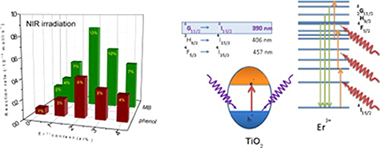
Erbium-doped TiO2 materials are synthesized by means of a surfactant-free hydrothermal method having good photoactivities for the liquid-phase degradation of phenol and MB and the gas phase of toluene. From the structural and morphological characterization, it has been stated that the presence of Er3+ induces a progressive anatase cell expansion due to its incorporation in the TiO2 lattice. The best photocatalytic performance was attained for the samples with 2 at% of Er3+ irrespective of the chemical degradation reaction essayed. From activity and optical studies under different irradiation excitation conditions, a dual-type mechanism is proposed to be at the origin of the photocatalytic activity enhancement. On one hand, the improvement observed under UV irradiation occurs by the effective charge separation promoted by Er3+ species which would act as electron scavenger. Besides, the up-conversion luminescence process of Er3+ allows profiting the NIR range of the lamp and transferring energy in the UV range to the TiO2. The dual action of Er ions located at anatase networks will open up a wide roadway for the developing of an integral solar active photocatalyst.
Erbium doped TiO2–Bi2WO6 heterostructure with improved photocatalytic activity under sun-like irradiation
Obregon, S; Colon, G
Applied Catalysis B: Environmental, 140-141 (2013) 299-305 | DOI: 10.1016/j.apcatb.2013.04.014

Erbium doped TiO2–Bi2WO6 have been synthesized by means of a surfactant free hydrothermal method having good photoactivities under sun-like excitation for the degradation of Rhodamine B. From the structural and morphological characterization it has been stated that the presence of Er3+ induces a progressive russelite cell contraction due to its incorporation in the Bi2WO6 lattice in substitutional sites. The best photocatalytic performance was attained for the samples with 1 at% of Er. From the study of the photocatalytic activity under different irradiation conditions it can be inferred that Er3+ presence induces a significant improvement of the photoactivity in the UV range. The evolution of band-gap values seems to be similarly related with the reaction rate progression. Thus, the higher band-gap values in lower Er doped systems would be the cause of a better electron hole separation under UV irradiation.
In situ FT-IR study of the adsorption and photocatalytic oxidation of ethanol over sulfated and metallized TiO2
Murcia, JJ; Hidalgo, MC; Navio, JA; Arana, J; Dona-Rodriguez, JM
Applied Catalysis B: Environmental, 142-143 (2013) 205-213 | DOI: 10.1016/j.apcatb.2013.05.022
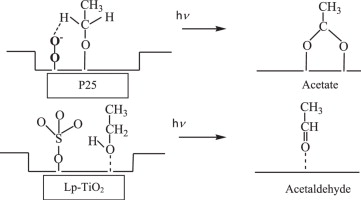
TiO2 Degussa P25, TiO2 prepared by sol–gel submitted to sulfation pre-treatment and some metallized catalysts obtained by photodeposition of Au or Pt over the sulfated TiO2, were evaluated in the reaction of ethanol photo-oxidation. FT-IR spectroscopy was used to investigate the surface features of the photocatalysts, identifying adsorbed species and following the evolution of intermediate products in the ethanol photo-oxidation reaction. Nature of surface acidity in terms of Brönsted and Lewis centers was also studied.
Results showed that sulfation pre-treatment and metallization were important factors influencing the selectivity. Acetaldehyde was the main oxidation product on sulfated TiO2; in the case of P25 also acetates production was observed. The photodeposition of metals had a detrimental effect on the selectivity to acetaldehyde; on metallized catalysts the formation of stable secondary intermediates was detected.
Based on these findings, a reaction pathway for the ethanol photo-oxidation over the different photocatalysts, via acetaldehyde or via acetate formation is proposed.
Liquids Analysis with Optofluidic Bragg Microcavities
Oliva-Ramirez, M; Gonzalez-Garcia, L; Parra-Barranco, J; Yubero, F; Barranco, A; Gonzalez-Elipe, AR
ACS Applied Materials & Interfaces, 5 (2013) 6743-650 | DOI: 10.1021/am401685r
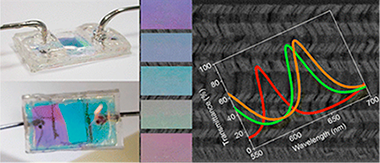
Porous Bragg microcavities formed by stacking a series of porous nanocolumnar layers with alternate low (SiO2) and high (TiO2) refractive index materials have been prepared by physical vapor deposition at glancing angles (GLAD). By strictly controlling the porosity and refractive index of the individual films, as well as the relative orientation of the nanocolumns from one layer to the next, very porous and nondispersive high optical quality microcavities have been manufactured. These photonic structures have been implemented into responsive devices to characterize liquids, mixtures of liquids, or solutions flowing through them. The large displacements observed in the optical spectral features (Bragg reflector gap and resonant peak) of the photonic structures have been quantitatively correlated by optical modeling with the refractive index of the circulating liquids. Experiments carried out with different glucose and NaCl solutions and mixtures of water plus glycerol illustrate the potentialities of these materials to serve as optofluidic devices to determine the concentration of solutions or the proportion of two phases in a liquid mixture.
Preferential oxidation of CO in excess H2 over CuO/CeO2 catalysts: Characterization and performance as a function of the exposed face present in the CeO2 support
Gamarra, D; Camara, AL; Monte, M; Rasmussen, SB; Chinchilla, LE; Hungria, AB; Munuera, G; Gyorffy, N; Schay, Z; Corberan, VC; Conesa, JC; Martinez-Arias, A
Applied Catalysis B: Environmental, 130-131 (2013) 224-238 | DOI: 10.1016/j.apcatb.2012.11.008
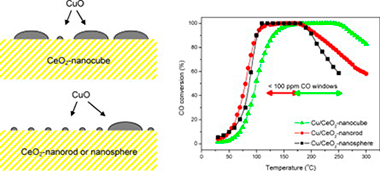
A series of oxidised copper-cerium nanostructured catalysts prepared by impregnation of copper over ceria supports synthesized by different methods (hydrothermal with varying preparation parameters, microemulsion/precipitation), in order to achieve different specific morphologies (nanocubes, nanorods and nanospheres), have been examined with respect to their catalytic properties for preferential oxidation of CO in excess H2 (CO-PROX). The catalysts have been characterized in detail by XRD, Raman, SBET measurement, HREM, XPS, TPR and EPR, which allows establishing a model of structural characteristics of the catalysts. The characterization results have been correlated with analysis of CO-PROX catalytic properties by means of catalytic activity measurements complemented by operando-DRIFTS. Structural dependence of the CO oxidation reaction on the dispersed copper oxide entities as a function of the exposed face present at the surface of the different ceria supports is revealed. An important overall enhancement of the CO-PROX performance is detected for the sample supported on ceria nanocubes which is proposed to be a consequence of the interaction between copper oxide and (1 0 0) faces of the ceria support.
Multiple Zeolite Structures from One Ionic Liquid Template
Blanes, JMM; Szyja, BM; Romero-Sarria, F; Centeno, MA; Hensen, EJM; Odriozola, JA; Ivanova, S
Chemistry-A European Journal, 19 (2013) 2122-2130 | DOI: 10.1002/chem.201202556
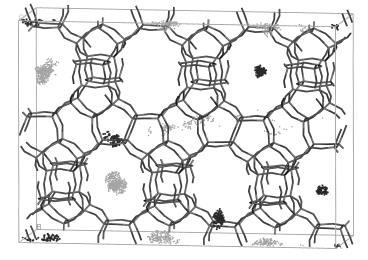
This study reports the use of 1-butyl-3-methyl imidazolium methanesulfonate ionic liquid as a template in the synthesis of zeolites. It is found that the silicon source determines the formation of beta (BEA), mordenite framework inverted (MFI), or analcime (ANA) zeolites. Depending on this source, different preorganized complexes are obtained that drive the formation of the different zeolite structures. In the presence of ethanol, the ionic liquid form preorganized complexes that drive the formation of MFI. In its absence, BEA is obtained. Whereas, the large amount of sodium present when using sodium metasilicate leads to ANA formation. A molecular simulation study of the relative stability of the template-framework system and location of the template provides further insight into the mechanism of synthesis.
Constant rate thermal analysis for enhancing the long-term CO2 capture of CaO at Ca-looping conditions
Valverde, JM; Sanchez-Jimenez, PE; Perejon, A; Perez-Maqueda, LA
Applied Energy, 108 (2013) 108-120 | DOI: 10.1016/j.apenergy.2013.03.013
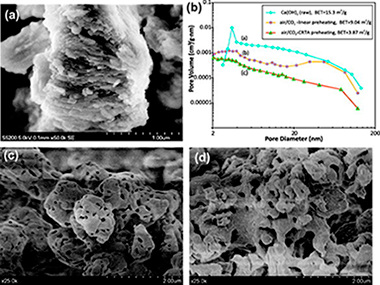
Experimental results are reported on the (Ca-looping) multicyclic CO2 capture of CaO and nanosilica/CaO composites derived from Ca(OH)2 and nanosilica/Ca(OH)2 dry mixtures subjected in situ to linear and constant rate thermal analysis (CRTA) preheating programs in either air or air/CO2 atmospheres. By means of CRTA preheating the rates of the reactions taking place during pretreatment are kept at a constant and small value along the entire process. In agreement with a pore skeleton model, previously proposed in the literature for explaining the behavior of natural limestones thermally pretreated, our results suggest that air/CO2-CRTA pretreatment yields a thermally stable hard skeleton of poorly reactive CaO on which a soft skeleton of reactive CaO would be supported. The sorbent subjected to this preheating program exhibits a reactivation in the very first carbonation/calcination cycles, after which CaO conversion decays slowly with the cycle number. In contrast, linearly or air-CRTA preheated sorbents show a significant decrease of CaO conversion within the first cycles. In the latter case, CaO multicyclic conversion fits well to a model where it is assumed that the progressive reduction of surface area as the number of carbonation/calcination cycles is increased obeys to sintering of the preheated sorbent skeleton as it is subjected to repeated calcinations during cycling. In the former case, CaO conversion data conforms to the prediction by a model in which the loss of surface area is mainly due to sintering of a nascent CaO soft skeleton regenerated in the diffusive carbonation phase, which is enhanced by the air/CO2-CRTA pretreatment. As regards the effect of nanosilica, the results indicate that it slows down CaO sintering during pretreatment, which hinders the development of a stable CaO skeleton thus hampering reactivation and stabilization of conversion. On the other hand, as CaO sintering is also lessened during looping calcination, nanosilica is useful to increase the absolute values of CaO conversion.
Colored and Transparent Oxide Thin Films Prepared by Magnetron Sputtering: The Glass Blower Approach
Gil-Rostra, J; Chaboy, J; Yubero, F; Vilajoana, A; Gonzalez-Elipe, AR
ACS Applied Materials & Interfaces, 5 (2013) 1967-1976 | DOI: 10.1021/am302778h

This work describes the reactive magnetron sputtering processing at room temperature of several mixed oxide MxSiyOz thin films (M: Fe, Ni, Co, Mo, W, Cu) intended for optical, coloring, and aesthetic applications. Specific colors can be selected by adjusting the plasma gas composition and the Si–M ratio in the magnetron target. The microstructure and chemistry of the films are characterized by a large variety of techniques including X-ray photoemission spectroscopy, X-ray absorption spectroscopy (XAS), and infrared spectroscopy, while their optical properties are characterized by UV–vis transmission and reflection analysis. Particularly, XAS analysis of the M cations in the amorphous thin films has provided valuable information about their chemical state and local structure. It is concluded that the M cations are randomly distributed within the SiO2 matrix and that both the M concentration and its chemical state are the key parameters to control the final color of the films.
Advanced nanoarchitectures for solar photocatalytic applications
Kubacka, A; Fernandez-Garcia, M; Colon, G
Chemical Reviews, 112 (2012) 1555-1614 | DOI: 10.1021/cr100454n
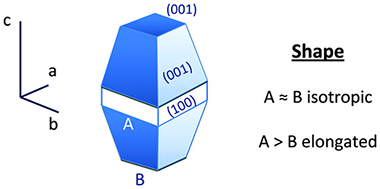
Advanced nanostructured materials that demonstrate useful activity under solar excitation in fields concerned with the elimination of pollutants, partial oxidation and the valorization of chemical compounds, water splitting and CO 2 reduction processes, are discussed. Point defects present in nanoparticulated anatase present both 5-fold- and 6-fold-coordinated titanium atoms, as well as 2-fold- and 3-fold-coordinated oxygens. The requirement of using sunlight as the excitation source for the degradation reaction demands, as a principal requirement, the modification of the electronic characteristics of a UV absorber system such as anatase-TiO 2. Some reports also indicate the need for large doping concentrations for N-doping in specific cases where notable changes in the valence band onset are subsequently observed. The effect of cetyltrimethylammonium bromide (CTAB) on the crystallization is reported by Yin et al. They showed that the presence of CTAB induces the appearance of BiOBr during the synthesis at 80°C using an aqueous method.
Collective osmotic shock in ordered materials
Paul Zavala-Rivera, Kevin Channon, Vincent Nguyen, Easan Sivaniah, Dinesh Kabra, Richard H. Friend, S. K. Nataraj, Shaheen A. Al-Muhtaseb, Alexander Hexemer, Mauricio E. Calvo & Hernan Miguez
Nature Materials, 11 (2012) 53–57 | DOI: 10.1038/nmat3179
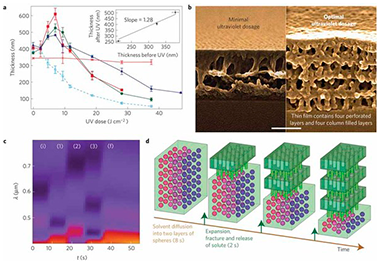
Osmotic shock in a vesicle or cell is the stress build-up and subsequent rupture of the phospholipid membrane that occurs when a relatively high concentration of salt is unable to cross the membrane and instead an inflow of water alleviates the salt concentration gradient. This is a well-known failure mechanism for cells and vesicles (for example, hypotonic shock) and metal alloys (for example, hydrogen embrittlement). We propose the concept of collective osmotic shock, whereby a coordinated explosive fracture resulting from multiplexing the singular effects of osmotic shock at discrete sites within an ordered material results in regular bicontinuous structures. The concept is demonstrated here using self-assembled block copolymer micelles, yet it is applicable to organized heterogeneous materials where a minority component can be selectively degraded and solvated whilst ensconced in a matrix capable of plastic deformation. We discuss the application of these self-supported, perforated multilayer materials in photonics, nanofiltration and optoelectronics.
Introducing structural colour in DSCs by using photonic crystals: interplay between conversion efficiency and optical properties
Colonna, D; Colodrero, S; Lindstrom, H; Di Carlo, A; Miguez, H
Energy & Environmental Science, 5 (2012) 8238-8243 | DOI: 10.1039/c2ee02658a
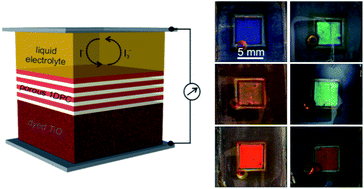
Herein we analyze experimentally the effect that introducing highly reflecting photonic crystals, operating at different spectral ranges, has on the conversion efficiency of dye sensitized solar cells. The interplay between structural colour and cell performance is discussed on the basis of the modified spectral response of the photogenerated current observed and the optical characterization of the cells. We demonstrate that, with the approach herein discussed, it is possible to achieve relatively high efficiencies using thin electrodes while preserving transparency. At the same time, the appearance of the device can be controllably modified, which is of relevance for their potential application in building integrated photovoltaics (BIPV) as window modules.
Efficient Transparent Thin Dye Solar Cells Based on Highly Porous 1D Photonic Crystals
Colodrero, S; Forneli, A; Lopez-Lopez, C; Pelleja, L; Miguez, H; Palomares, E
Advanced Functional Materials, 22 (2012) 1303-1310 | DOI: 10.1002/adfm.201102159
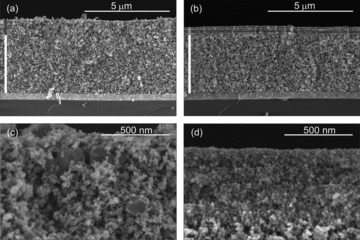
A working electrode design based on a highly porous 1D photonic crystal structure that opens the path towards high photocurrents in thin, transparent, dye-sensitized solar cells is presented. By enlarging the average pore size with respect to previous photonic crystal designs, the new working electrode not only increases the device photocurrent, as predicted by theoretical models, but also allows the observation of an unprecedented boost of the cell photovoltage, which can be attributed to structural modifications caused during the integration of the photonic crystal. These synergic effects yield conversion efficiencies of around 3.5% by using just 2 mu m thick electrodes, with enhancements between 100% and 150% with respect to reference cells of the same thickness.
Evidence of upconversion luminescence contribution to the improved photoactivity of erbium doped TiO2 systems
Obregon, S; Colon, G
Chemical Communications, 48 (2012) 7865-7867 | DOI: 10.1039/C2CC33391K
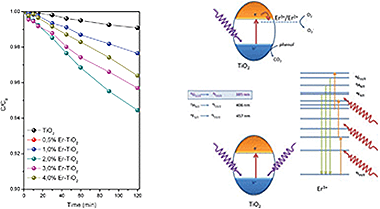
Er3+–TiO2 synthesized by a surfactant free hydrothermal method exhibits good photoactivities under sun-like excitation for the degradation of phenol. The presence of Er3+ does not affect the structural and morphological features of the TiO2 significantly. The best photocatalytic performance was attained for the samples with 2 wt% of Er. Different photocatalytic runs indicated that the incorporation of the Er3+ cation would be responsible for the enhanced photocatalytic activity, which participates in different mechanisms under UV and NIR excitation.
Self-assembly at room temperature of thermally stable discrete and extended oligomers of polycyclic aromatics on Ag(100): induced dipoles and cooperative effects
Papageorgiou, AC; Alavi, A; Lambert, RM
Chemical Communications, 48 (2012) 3394-3396 | DOI: 10.1039/c2cc17728e
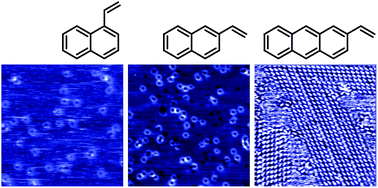
Thermally stable nanoarchitectures are realized on the Ag(100) surface by self-assembly of asymmetrically substituted arenes. The process is instigated by adsorption-induced molecule → surface charge transfer that gives rise to in-plane dipole moments. Observation and calculation indicate that cooperative interactions further enhance the stability of these polarizable systems.
Nanoecotoxicity effects of engineered silver and gold nanoparticles in aquatic organisms
Lapresta-Fernandez, A; Fernandez, A; Blasco, J
TrAC Trends in Analytical Chemistry, 32 (2012) 40-59 | DOI: 10.1016/j.trac.2011.09.007
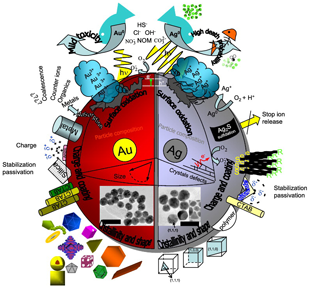
Engineered nanoparticles (ENPs) are increasingly being incorporated into commercial products. A better understanding is required of their environmental impacts in aquatic ecosystems.
This review deals with the ecotoxicity effects of silver and gold ENPs (AgNPs and AuNPs) in aquatic organisms, and considers the means by which these ENPs enter aquatic environments, their aggregation status and their toxicity. Since ENPs are transported horizontally and vertically in the water column, we discuss certain factors (e.g., salinity and the presence of natural organic materials), as they cause variations in the degree of aggregation, size range and ENP toxicity. We pay special attention to oxidative stress induced in organisms by ENPs.
We describe some of the main analytical methods used to determine reactive oxygen species, antioxidant enzyme activity, DNA damage, protein modifications, lipid peroxidation and relevant metabolic activities. We offer an overview of the mechanisms of action of AgNPs and AuNPs and the ways that relevant environmental factors can affect their speciation, agglomeration or aggregation, and ultimately their bio-availability to aquatic organisms.
Finally, we discuss similarities and differences in the adverse effects of ENPs in freshwater and salt-water systems.
Public concern over ecotoxicology risks from nanomaterials: Pressing need for research-based information
Lapresta-Fernandez, A; Fernandez, A; Blasco, J
Environment International, 39 (2012) 148-149 | DOI: 10.1016/j.envint.2011.10.012
[No abstract available]
Enhanced diffusion through porous nanoparticle optical multilayers
Lopez-Lopez, C; Colodrero, S; Raga, SR; Lindstrom, H; Fabregat-Santiago, F; Bisquert, J; Miguez, H
Journal of Materials Chemistry, 22 (2012) 1751-1757 | DOI: 10.1039/c1jm15202e
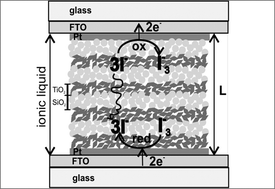
Herein we demonstrate improved mass transport through nano-particle one-dimensional photonic crystals of enhanced porosity. Analysis is made by impedance spectroscopy using iodine and ionic liquid based electrolytes and shows that newly created large pores and increased porosity improve the diffusion of species through the photonic crystal. This achievement is based on the use of a polymeric porogen (polyethylene glycol), which is mixed with the precursor suspensions used for the deposition of nanoparticle TiO2 and SiO2 layers and then eliminated to generate a more open interconnected void network, as confirmed by specular reflectance porosimetry. A compromise between pore size and optical quality of these periodic structures is found.
Weakly Interacting Molecular Layer of Spinning C60 Molecules on TiO2 (110) Surfaces
Sanchez-Sanchez, C; Lanzilotto, V; Gonzalez, C; Verdini, A; de Andres, PL; Floreano, L; Lopez, MF; Martin-Gago, JA
Chemistry-A European Journal, 18 (2012) 7382-7387 | DOI: 10.1002/chem.201200627
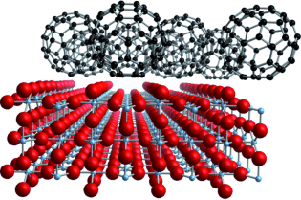
The adsorption of C60, a typical acceptor organic molecule, on a TiO2 (110) surface has been investigated by a multitechnique combination, including van der Waals density functional calculations. It is shown that the adsorbed molecules form a weakly interacting molecular layer, which sits on the fivefold-coordinated Ti that is confined between the prominent bridging oxygen rows (see figure).
Hydrothermal synthesis of BiVO4: Structural and morphological influence on the photocatalytic activity
Obregon, S; Caballero, A; Colon, G
Applied Catalysis B-Environmental, 117 (2012) 59-66 | DOI: 10.1016/j.apcatb.2011.12.037
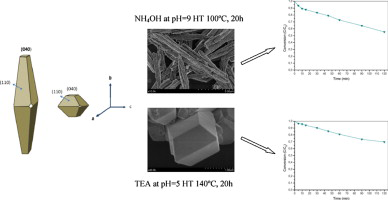
BiVO 4 hierarchical heterostructures are synthesized by means of a surfactant free hydrothermal method having good photoactivities for the degradation of methylene blue under UV-vis irradiation. From the structural and morphological characterization it has been stated that BiVO 4 present the monoclinic crystalline phase with different morphologies depending on the pH value, type of precipitating agent and hydrothermal temperature and treatment time. The best photocatalytic performance was attained for the samples with needle-like morphology.
Effect of the active metals on the selective H-2 production in glycerol steam reforming
Araque, M; Martinez, LM; Vargas, JC; Centeno, MA; Roger, AC
Applied Catalysis B-Environmental, 125 (2012) 556-566 | DOI: 10.1016/j.apcatb.2012.06.028
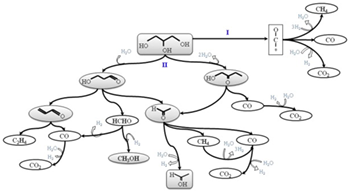
The production of hydrogen by glycerol steam reforming was studied using CeZr(Co, CoRh) catalysts. The effect of Co and Rh presence on the properties of the mixed oxides and the effect on the catalytic behavior were considered. The catalysts were characterized before and after testing by XRD, Raman, TPR, H 2-TPD, TPD-TPO and HRTEM. It was observed that the presence of Co allowed the selective H 2 production related with the presence of a metallic phase at the beginning of the reaction. The presence of Rh favored even more the H 2 production and also increased the stability of the catalyst. For CeZrCoRh, the presence of both metals enhanced the catalyst reduction capacity, a characteristic that significantly improved the catalytic behavior for glycerol steam reforming. The selective H 2 production was related to the capacity of the catalyst to activate H 2O under the reaction conditions. The progressive loss of this capacity decreases the production of H 2, and glycerol decomposition is actually favored over glycerol steam reforming. According to the initial distribution of products, and its evolution with time on stream, two main reaction pathways were proposed.
Effect of deposition of silver on structural characteristics and photoactivity of TiO2-based photocatalysts
Melian, EP; Diaz, OG; Rodriguez, JMD; Colon, G; Navio, JA; Macias, M; Pena, JP
Applied Catalysis B-Environmental, 127 (2012) 112-120 | DOI: 10.1016/j.apcatb.2012.08.007
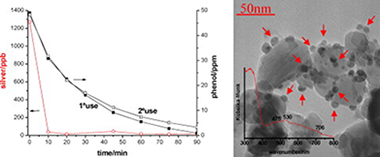
The homemade bare TiO2 photocatalyst obtained in a previous work was modified with nanosized silver particles by liquid impregnation and photodeposition methods to obtain different noble metal loadings (0.3–1 at.%). Characterization of the synthesized photocatalysts was carried out by the BET method, XPS, TEM, SEM-EDX, XRD and diffuse reflectance measurements. Photocatalytic activity of these silver-deposited TiO2 nanoparticles was tested by photocatalytic degradation of phenol as a reference model representing phenolic pollutants. The noble metal content on the TiO2 surface affected the efficiency of the photocatalytic process, and the photocatalytic activity of noble metal-modified TiO2 was considerably better than that of bare TiO2. Phenol decomposition rate was higher with TiO2 modified by the liquid impregnation method than with TiO2 modified by the photodeposition method.
Insights towards the influence of Pt features on the photocatalytic activity improvement of TiO2 by platinisation
Murcia, JJ; Navio, JA; Hidalgo, MC
Applied Catalysis B-Environmental, 126 (2012) 76-85 | DOI: 10.1016/j.apcatb.2012.07.013
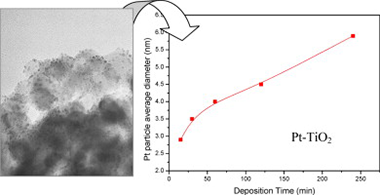
The influence of Pt features, such as particle size, dispersion, oxidation state and amount of metal, on the improvement of the photoactivity of TiO2 for phenol and methyl orange degradation was studied.
The size of Pt deposits was precisely controlled by changing deposition time under medium light intensity during the photodeposition, with sizes ranging from 3 to 6 nm. Pt oxidation state was also strongly dependent on the photodeposition time.
Photocatalytic activity results showed that the fraction of metallic platinum (Pt0) was the crucial factor for the improvement of the activity. When the fraction of Pt0 was similar, metal deposit size became the dominant parameter influencing the activity.
The influence of the substrate to be degraded (phenol or methyl orange) was also studied.
Influence of the shape of Ni catalysts in the glycerol steam reforming
Bobadilla, L. F.; Alvarez, A.; Dominguez, M. I.; Romero-Sarria, F.; Centeno, M. A.; Montes, M.; Odriozola, J. A.
Applied Catalysis B-Environmental, 123-124 (2012) 379-390 | DOI: 10.1016/j.apcatb.2012.05.004
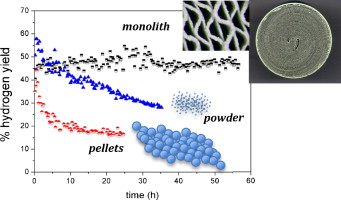
Biomass is an alternative to replace the use of fossil fuels. Glycerol, a byproduct in the biodiesel production, can be used for obtaining hydrogen. The most efficient method for obtaining hydrogen from glycerol is the steam reforming (SR). So far all the published papers report the use of conventional catalyst. In this paper, a structured catalyst has been prepared and compared with the conventional ones (powder and spherical pellets). Results show that the structured catalyst (monolith) is more stable as formation of coke was not observed.
Selective photooxidation of alcohols as test reaction for photocatalytic activity
Lopez-Tenllado, F. J.; Marinas, A.; Urbano, F. J.; Colmenares, J. C.; Hidalgo, M. C.; Marinas, J. M.; Moreno, J. M.
Applied Catalysis B-Environmental, 128 (2012) 150-158 | DOI: 10.1016/j.apcatb.2012.02.015
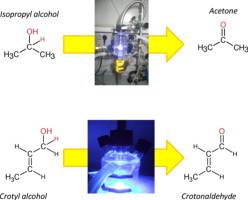
Twenty-four different titania-based systems synthesized through the sol–gel process varying the precursor (titanium isopropoxide or tetrachloride) and/or the ageing conditions (magnetic stirring, ultrasounds, microwave or reflux) were tested for liquid-phase selective photooxidation of 2-butenol (crotyl alcohol) to 2-butenal (crotonaldehyde) and gas-phase selective photooxidation of 2-propanol to acetone. To the best of our knowledge, the former process is suggested for the first time as test reaction for photocatalytic activity. Interestingly, both test reactions (despite having very different reactant/catalyst ratio and contact times) showed quite similar results in terms of influence of the precursor (titanium isopropoxide leading to better results than titanium tetrachloride) and the metals (the presence of iron, palladium or zinc being detrimental to activity whereas zirconium and especially gold improved the results as compared to pure titania). To our mind, these results give validity to both processes as test reactions for a fast screening of catalysts for photocatalytic tranformations. Finally, some gold-containing solids even improved photocatalytic activity of Degussa P25.
Cu-modified cryptomelane oxide as active catalyst for CO oxidation reactions
Hernandez, Willinton Y.; Centeno, Miguel A.; Ivanova, Svetlana; Eloy, Pierre; Gaigneaux, Eric M.; Odriozola, Jose A.
Applied Catalysis B-Environmental, 123-124 (2012) 27-35 | DOI: 10.1016/j.apcatb.2012.04.024
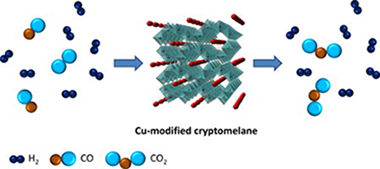
Manganese oxide octahedral molecular sieves (cryptomelane structure) were synthesized by a solvent-free method and tested in the total oxidation of CO (TOX), and preferential oxidation of CO in presence of hydrogen (PROX). The influence of Cu in the cryptomelane structure was evaluated by several characterization techniques such as: X-ray fluorescence (XRF), thermogravimetric analysis (TGA), hydrogen temperature programmed reduction (TPR-H2) and X-ray photoelectron spectroscopy (XPS). The Cu-modified manganese oxide material (OMS-Cu) showed very high catalytic activity for CO oxidation in comparison to the bare manganese oxide octahedral molecular sieve (OMS). The improved catalytic activity observed in OMS-Cu catalyst was associated to a high lattice oxygen mobility and availability due to the formation of Cusingle bondMnsingle bondO bridges. In addition, under PROX reaction conditions the catalytic activity considerably decreases in the presence of 10% (v/v) CO2 in the feed while the same amount of water provokes an improvement in the CO conversion and O2 selectivity.
New insights into the synergistic effect in bimetallic-boron catalysts for hydrogen generation: The Co–Ru–B system as a case study
Arzac, G. M.; Rojas, T. C.; Fernandez, A.
Applied Catalysis B-Environmental, 128 (2012) 39-47 | DOI: 10.1016/j.apcatb.2012.02.013
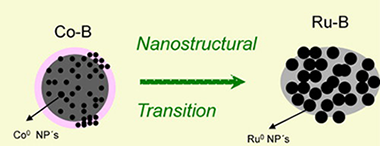
Catalysed sodium borohydride hydrolysis is a high-potential method to produce hydrogen for portable applications. Co–B catalysts are the most chosen because they are easily prepared, cheap and efficient. The addition of small amounts of Ru produces a significant enhancement in catalytic activity.
In the present work a series of Co–Ru–B catalysts with variable Ru content was prepared, isolated and characterized. The comprehension of the synergistic effect was achieved trough the incorporation of the nanostructural dimension to the study of surface and bulk chemical states of the involved atoms along the series. It was found that up to 70% (of total metal) atomic content of Ru the catalysts can be considered isostructural to the single Co–B catalyst in the nanoscale. A structural transition occurs in the case of the pure Ru–B material to produce a boron deficient material with higher nanoparticle size. This structural transition together with Co segregation and Ru dispersion play a key role when explaining a [OH−] dependent effect.
The inexistence of borate layers in Ru rich catalysts is suggestive in the research for non deactivating catalysts.
LaNiO3 as a precursor of Ni/La2O3 for CO2 reforming of CH4: Effect of the presence of an amorphous NiO phase
Rosa Pereñiguez , Victor M. Gonzalez-delaCruz, Alfonso Caballero, Juan P. Holgado,
Applied Catalysis B-Environmental, 123-124 (2012) 324-32 | DOI: 10.1016/j.apcatb.2012.04.044
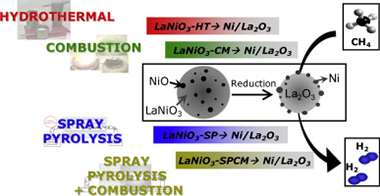
The objective of the present work has been the study of the physico-chemical and catalytic properties of Ni/La2O3 catalysts obtained by reduction of four LaNiO3 samples prepared by different methods. The LaNiO3 precursors as well as the resulting Ni/La2O3 catalysts, were characterized by scanning electron microscopy (SEM), X-ray diffraction (XRD), X-ray absorption spectroscopy (XAS), temperature programmed reduction and oxidation (TPR, TPO). The catalytic performances of these systems for dry reforming of methane (DRM) were also tested. These samples show different physico-chemical properties resulting from the synthesis method used. The XAS and TPR measurements show that in all four LaNiO3 samples there is, in addition of the crystalline LaNiO3 rhombohedrical phase, a significant amount of an amorphous NiO phase, not detectable by XRD but evidenced by XAS. The amount of this NiO amorphous phase seems to play, together with some other microstructural parameters, an important role in the performance of the Ni/La2O3 samples for the DRM reaction.
Enhancement of Fast CO2 Capture by a Nano-SiO2/CaO Composite at Ca-Looping Conditions
Valverde, JM; Perejon, A; Perez-Maqueda, LA
Environmental Science and Technology, 46 (2012) 6401-6408 | DOI: 10.1021/es3002426
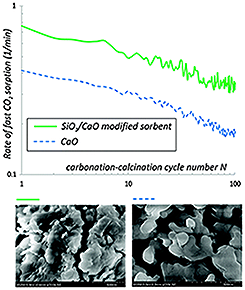
In this paper we show the performance of a new CO 2 sorbent consisting of a dry physical mixture of a Ca-based sorbent and a SiO 2 nanostructured powder. Thermo-gravimetric analysis (TGA) performed at conditions close to the Ca-looping process demonstrate that the rate of CO 2 capture by the mixture is enhanced during the fast carbonation stage of practical interest in applications. Moreover, the residual capture capacity of the mixture is increased. SEM/EDX, physisorption, and XRD analyses indicate that there is a relevant interaction between the nanostructured SiO 2 skeleton and CaO at high temperatures, which serves to improve the efficiency of the transfer of CO 2 to small reactive pores as well as the stability of the sorbent pore structure.
Influence of Vanadium or Cobalt Oxides on the CO Oxidation Behavior of Au/MOx/CeO2-Al2O3 Systems
Reina, TR; Moreno, AA; Ivanova, S; Odriozola, JA; Centeno, MA
Chemcatchem, 4 (2012) 512-520 | DOI: 10.1002/cctc.201100373
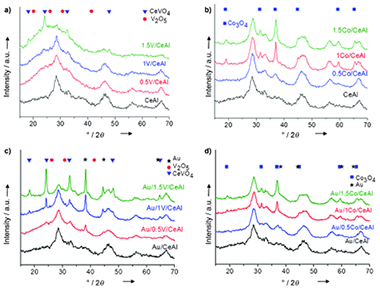
A series of V2O5- and Co3O4-modified ceria/alumina supports and their corresponding gold catalysts were synthesized and their catalytic activities evaluated in the CO oxidation reaction. V2O5-doped solids demonstrated a poor capacity to abate CO, even lower than that of the original ceria/alumina support, owing to the formation of CeVO4. XRD, Raman spectroscopy, and H2-temperature programmed reduction studies confirmed the presence of this stoichiometric compound, in which cerium was present as Ce3+ and its redox properties were avoided. Co3O4-doped supports showed a high activity in CO oxidation at subambient temperatures. The vanadium oxide-doped gold catalysts were not efficient because of gold particle agglomeration and CeVO4 formation. However, the gold–cobalt oxide–ceria/alumina catalysts demonstrated a high capacity to abate CO at and below room temperature. Total conversion was achieved at −70 °C. The calculated apparent activation energy values revealed a theoretical optimum loading of a half-monolayer.
Nanoporous silica microparticle interaction with toll-like receptor agonists in macrophages
Cejudo-Guillen, M; Ramiro-Gutierrez, M L; Labrador-Garrido, A; Diaz-Cuenca, A; Pozo, D
Acta Biomaterialia, 8 (2012) 4295-4303 | DOI: 10.1016/j.actbio.2012.07.026
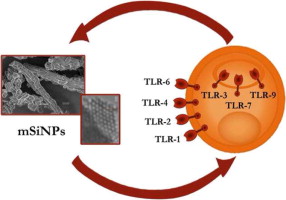
Nanoporous silica microparticles (NSiO2-MP) are considered to be potential drug delivery systems and scaffolding platforms in tissue engineering. However, few biocompatibility studies regarding NSiO2-MP interaction with the immune system have been reported. Toll-like receptors (TLR) are involved in host defence as well as autoimmune and inflammatory diseases. The results show that NSiO2-MP up to 100 μg ml−1 do not affect macrophage cell viability after 24 h cell culture. Moreover, NSiO2-MP do not compromise the cell viability of TLR-activated Raw 264.7 cells, for either cell surface TLR (TLR1/TLR2/TLR4/TLR6) or endocytic compartment TLR (TLR3/TLR7/TLR9). Furthermore, Raw 264.7 cells do not respond to NSiO2-MP exposure in terms of IL-6 or IL-10 secretion. NSiO2-MP co-treatment in the presence of TLR ligands does not impair or enhance the secretion of the pro-inflammatory cytokine IL-6 or the regulatory cytokine IL-10. Thus, NSiO2-MP do not affect macrophage polarization towards a pro-inflammatory or immunosuppressive status, representing added value in terms of biocompatibility compared with other SiO2-based micro- and nanoparticles.
Electrochromic Behavior of WxSiyOz Thin Films Prepared by Reactive Magnetron Sputtering at Normal and Glancing Angles
Gil-Rostra, J; Cano, M; Pedrosa, JM; Ferrer, FJ; Garcia-Garcia, F; Yubero, F; Gonzalez-Elipe, AR
ACS Applied Materials & Interfaces, 4 (2012) 628-638 | DOI: 10.1021/am2014629
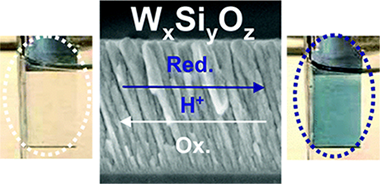
This work reports the synthesis at room temperature of transparent and colored WxSiyOz thin films by magnetron sputtering (MS) from a single cathode. The films were characterized by a large set of techniques including X-ray photoelectron spectroscopy (XPS), Rutherford backscattering spectrometry (RBS), Fourier transform infrared (FT-IR), and Raman spectroscopies. Their optical properties were determined by the analysis of the transmission and reflection spectra. It was found that both the relative amount of tungsten in the W–Si MS target and the ratio O2/Ar in the plasma gas were critical parameters to control the blue coloration of the films. The long-term stability of the color, attributed to the formation of a high concentration of W5+ and W4+ species, has been related with the formation of W–O–Si bond linkages in an amorphous network. At normal geometry (i.e., substrate surface parallel to the target) the films were rather compact, whereas they were very porous and had less tungsten content when deposited in a glancing angle configuration. In this case, they presented outstanding electrochromic properties characterized by a fast response, a high coloration, a complete reversibility after more than one thousand cycles and a relatively very low refractive index in the bleached state.
Selective Dichroic Patterning by Nanosecond Laser Treatment of Ag Nanostripes
Sanchez-Valencia, JR; Toudert, J; Borras, A; Barranco, A; Lahoz, R; de la Fuente, GF; Frutos, F; Gonzalez-Elipe, AR
Advanced Materials, 23 (2011) 848-853 | DOI: 10.1002/adma.201003933
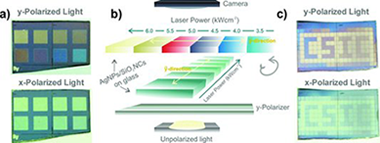
A simple route for the fabrication of dichroic optical structures based on Ag nanoparticles deposited onto SiO2 nanocolumns is presented. The strict control of the optical response is achieved after infrared laser treatment of the supported nanoparticles with a commercial nanosecond pulsed laser. Preliminary examples of the utilization of the laser-treated AgNPs/SiO2 nanocolumn system for optical recoding and encryption are shown.
Interplay of Resonant Cavity Modes with Localized Surface Plasmons: Optical Absorption Properties of Bragg Stacks Integrating Gold Nanoparticles
Olalla Sánchez-Sobrado, Gabriel Lozano, Mauricio E. Calvo, Ana Sánchez-Iglesias, Luis M. Liz-Marzán, Hernán Míguez
Advanced Materials, 23 (2011) 2108-2112 | DOI: 10.1002/adma.201004401
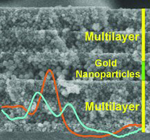
A procedure to prepare porous photonic crystal resonators containing gold nanoparticles is reported. The optical absorption of the ensemble, resulting from the excitation of the localized surface plasmon of the metallic beads, is finely tuned by a gradual shift of the cavity mode. This is achieved by infiltration of the void network with different guest compounds.
Transparent Nanometric Organic Luminescent Films as UV-Active Components in Photonic Structures
Aparicio, FJ; Holgado, M; Borras, A; Blaszczyk-Lezak, I; Griol, A; Barrios, CA; Casquel, R; Sanza, FJ; Sohlstrom, H; Antelius, M; Gonzalez-Elipe, AR; Barranco, A
Advanced Materials, 23 (2011) 761-765 | DOI: 10.1002/adma.201003088
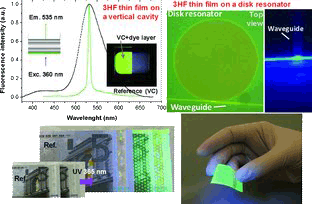
A new kind of visible-blind organic thin-film material, consisting of a polymeric matrix with a high concentration of embedded 3-hydroxyflavone (3HF) dye molecules, that absorbs UV light and emits green light is presented. The thin films can be grown on sensitive substrates, including flexible polymers and paper. Their suitability as photonic active components photonic devices is demonstrated.
Aligned TiO(2) nanocolumnar layers prepared by PVD-GLAD for transparent dye sensitized solar cells
Gonzalez-Garcia, L; Gonzalez-Valls, I; Lira-Cantu, M; Barranco, A; Gonzalez-Elipe, AR
Energy and Environmental Science, 4 (2011) 3426-3435 | DOI: 10.1039/C0EE00489H
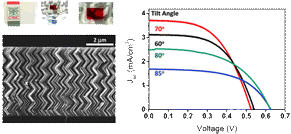
Transparent thin film electrodes made of vertically aligned nanocolumns of TiO2 with well-controlled oblique angles were grown by physical vapor deposition at glancing incidence (PVD-GLAD). For an electrode thickness of 500 nm, we report a 40% variation on solar cell efficiency (from 0.6% to 1.04%) when the deposition angle was modified between 60° and 85°. Transparent thicker films with higher surface area deposited at the optimal angle of 70° were grown with a zigzag morphology which confers high mechanical strength to the thin films. Using this topology, the application of an electrode thickness of 3 m in a DSC resulted in a power conversion efficiency of 2.78% maintaining electrode transparency.
Porous one dimensional photonic crystals: novel multifunctional materials for environmental and energy applications
Mauricio E. Calvo, Silvia Colodrero, Nuria Hidalgo, Gabriel Lozano, Carmen López-López, Olalla Sánchez-Sobrado and Hernán Míguez
Energy and Environmental Science, 4 (2011) 4800-4812 | DOI: 10.1039/C1EE02081A
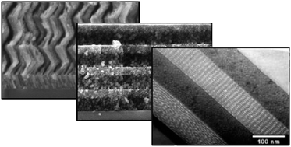
In recent times, several synthetic pathways have been developed to create multilayered materials of diverse composition that combine accessible porosity and optical properties of structural origin, i.e., not related to absorption. These materials possess a refractive index that varies periodically along one direction, which gives rise to optical diffraction effects characteristic of Bragg stacks or one-dimensional photonic crystals (1DPCs). The technological potential of such porous optical materials has been demonstrated in various fields related to energy and environmental sciences, such as detection and recognition of targeted biological or chemical species, photovoltaics, or radiation shielding. In all cases, improved performance is achieved as a result of the added functionality porosity brings. In this review, a unified picture of this emerging field is provided.
Porous supramolecularly templated optical resonators built in 1D photonic crystals
Hidalgo, N., Calvo, M.E., Bellino, M.G., Soler-Illia, G.J.A.A., Míguez, H.
Advanced Functional Materials, 21 (2011) 2534-2540 | DOI: 10.1002/adfm.201002486
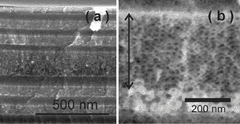
A synthetic route to attain photonic multilayers that presents controlled porosity only at the middle-layer level is shown. The spectral resonance associated with this porous layer shows strong sensitivity to the presence of vapors adsorbed or condensed within the void network, providing a potentially relevant material for gas detection. The importance of the interplay between pore and probe-molecule diameters is studied and its implications in size-selective detection are discussed. Controlled porosity: Photonic multilayers that presents controlled porosity only at the middle-layer level are herein introduced. The optical response of the ensemble shows strong sensitivity to the presence of vapors adsorbed or condensed within the void network, providing a potentially relevant material for gas detection.
The biophysical design of plant cuticles: an overview
Dominguez, E; Heredia-Guerrero, JA; Heredia, A
New Phytologist, 189 (2011) 938-949 | DOI: 10.1111/j.1469-8137.2010.03553.x
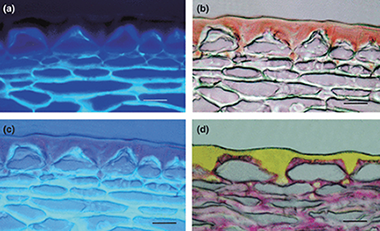
The outer surfaces of epidermal cell walls are impregnated with an extracellular matrix called the cuticle. This composite matrix provides several functions at the interface level that enable plants to thrive in different habitats and withstand adverse environmental conditions. The lipid polymer cutin, which is the main constituent of the plant cuticle, has some unique biophysical properties resulting from its composition and structure. This review summarizes the progress made towards understanding the biophysical significance of this biopolymer with special focus on its structural, thermal, biomechanical, and hydric properties and relationships. The physiological relevance of such biophysical properties is discussed in light of existing knowledge on the plant cuticle.
Surface-functionalized fluorescent silica nanoparticles for the detection of ATP
Moro, AJ; Schmidt, J; Doussineau, T; Lapresta-Fernandez, A; Wegener, J; Mohr, GJ
Chemical Communications, 47 (2011) 6066-6068 | DOI: 10.1039/C1CC10419E
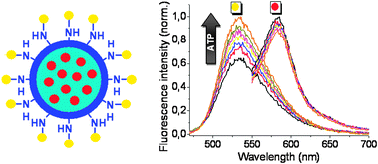
The design of two-dyed fluorescent silica nanoparticles for ATP detection is presented. The indicator dye possesses a dipicolyl-amine (DPA) unit complexed with Zn(ii) as a receptor function for ATP while a rhodamine derivative is used as the reference dye. The nanoparticles were fully characterized regarding analytical performance, morphology and cytocompatibility.
Enhanced gas sensing performance of TiO2 functionalized magneto-optical SPR sensors
M.G. Manera, G. Montagna, E. Ferreiro-Vila, L. González-García, J.R. Sánchez-Valencia, A.R. González-Elipe, A.Cebollada, J.M. Garcia-Martin, A. Garcia-Martin, G. Armelles and R. Rella
Journal of Materials Chemistry, 21 (2011) 16049-16056 | DOI: 10.1039/c1jm11937k
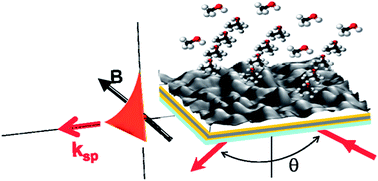
Porous TiO2 thin films deposited by glancing angle deposition are used as sensing layers to monitor their sensing capabilities towards Volatile Organic Compounds both in a standard Surface Plasmon Resonance (SPR) sensor and in Magneto-Optical Surface Plasmon Resonance (MO-SPR) configuration in order to compare their sensing performances. Here our results on the enhanced sensing capability of these TiO2 functionalized MO-SPR sensors with Au/Co/Au transducers with respect to traditional SPR gas sensors are presented.
Effect of thermal treatments on the catalytic behaviour in the CO preferential oxidation of a CuO-CeO2-ZrO2 catalyst with a flower-like morphology
Moretti, E; Storaro, L; Talon, A; Lenarda, M; Riello, P; Frattini, R; de Yuso, MDM; Jimenez-Lopez, A; Rodriguez-Castellon, E; Ternero, F; Caballero, A; Holgado, JP
Applied Catalysis B-Environmental, 102 (2011) 627-637 | DOI: 10.1016/j.apcatb.2011.01.004
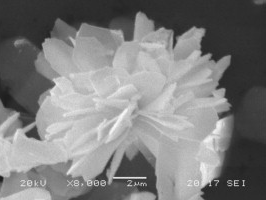
A Ce–Zr–Cu oxide system with a flower-like morphology was prepared by a slow co-precipitation method in the absence of any structure directing agent. Four portions of the oxide were thermally treated at four different temperatures (350 °C, 450 °C, 550 °C, 650 °C). The resulting materials samples were characterized by quantitative XRD, adsorption–desorption of N2 at-196 °C, SEM and TEM microscopy, –H2-TPR, XPS and Operando-XANES. All samples were tested in the preferential CO oxidation (CO-PROX) in the 40–190 °C temperature range. Thermal treatments were found to induce slight structural changes without altering the starting morphology of the samples. The samples treated at higher temperature 550–650 °C showed a quite interesting CO-PROX activity and selectivity in a temperature range suitable for a practical use within the FEMFC technology.
Fe-doped ceria solids synthesized by the microemulsion method for CO oxidation reactions
O.H. Laguna, M.A. Centeno, M. Boutonnet, J.A. Odriozola
Applied Catalysis B: Environmental, 106 (2011) 621-629 | DOI: 10.1016/j.apcatb.2011.06.025
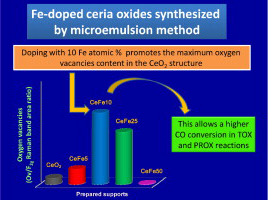
A series of Ce-Fe mixed oxides as well as the pure oxides were synthesized by the microemulsions method. The solid solution formation was established for all the Fe-doped systems and only a hardly noticeable segregation of α-Fe2O3 was appreciated for the solid with the maximum iron content (50at.% Fe). The oxygen exchange is improved for all the Fe-doped systems; however the 10at.% Fe appears as the optimal iron content for achieving the maximum oxygen vacancies concentration and the higher reducibility efficiency. The CO oxidation (TOX, PROX) is especially achieved for the solids with the lower iron contents but with a superior oxygen vacancies proportion. These Ce-Fe systems prepared from microemulsions are very attractive to be considered as supports for depositing active phases capable of enhancing oxygen exchange ability of the whole system, allowing higher CO oxidation abilities.
CO oxidation at low temperature on Au/CePO4: Mechanistic aspects
Romero-Sarria, F., Domínguez, M.I., Centeno, M.A., Odriozola, J.A.
Applied Catalysis B: Environmental, 107 (2011), 268-273 | DOI: 10.1016/j.apcatb.2011.07.022
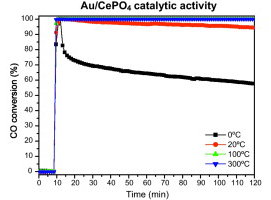
This work reports the synthesis and characterization of a cerium phosphate supported gold catalyst as well as its catalytic activity for the oxidation of CO. A precipitation method in the presence of an organic modifier followed by a hydrothermal treatment was used for the support synthesis, resulting in high surface area nanometric particles. Gold/cerium phosphate catalyst with a 1% (w/w) nominal gold content was characterized using XRF, XRD, N2 adsorption-desorption measurements, TEM and DRIFTS-MS. The catalyst shows good catalytic activity at low temperature. The activity is related to the generation of oxygen vacancies in the support caused by the elimination of structural oxygen. In situ studies revealed that the reaction of the oxygen vacancies with gaseous oxygen resulted in the formation of peroxo species. These species are responsible for the activity detected at room temperature in both the catalyst and the support. Moreover, the presence of carbonate and hydrogen carbonate acting as reaction intermediates have been observed.
Tuning from blue to magenta the up-converted emissions of YF3:Tm3+/Yb3+ nanocrystals
Quintanilla, M; Nunez, NO; Cantelar, E; Ocana, M; Cusso, F
Nanoscale, 3 (2011) 1046-1052 | DOI: 10.1039/c0nr00676a
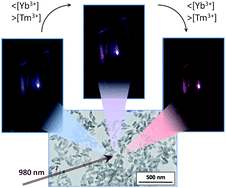
Monodisperse YF3:Tm3+/Yb3+ nanocrystals have been synthesized to explore the visible up-converting properties under near infrared (975 nm) excitation. It has been found that the nanoparticles exhibit intense red up-converted emissions, in addition to the characteristic UV and blue Tm3+-bands. It is demonstrated that, by carefully selecting Tm3+ and Yb3+ contents, the relative intensity of the different emissions can be changed producing an overall emission colour that can be tuned from blue to magenta.
Soft plasma processing of organic nanowires: a route for the fabrication of 1D organic heterostructures and the template synthesis of inorganic 1D nanostructures
Maria Alcaire, Juan R. Sanchez-Valencia, Francisco J. Aparicio, Zineb Saghi, Juan C. Gonzalez-Gonzalez, Angel Barranco, Youssef Oulad Zian, Agustin R. Gonzalez-Elipe, Paul Midgley, Juan P. Espinos, Pierangelo Groening and Ana Borras
Nanoscale, 3 (2011) 4554-4559 | DOI: 10.1039/C1NR11001B
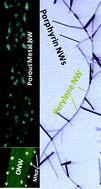
Hierarchical (branched) and hybrid metal-NPs/organic supported NWs are fabricated through controlled plasma processing of metalloporphyrin, metallophthalocyanine and perylene nanowires. The procedure is also applied for the development of a general template route for the synthesis of supported metal and metal oxide nanowires.
Compositional and Quantitative Microtextural Characterization of Historic Paintings by Micro-X-ray Diffraction and Raman Microscopy
Julia Romero-Pastor, Adrian Duran, Alejandro Basilio Rodríguez-Navarro, René Van Grieken, Carolina Cardell
Analytical Chemistry, 83 (2011) 8420-8428 | DOI: 10.1021/ac201159e

This work shows the benefits of characterizing historic paintings via compositional and microtextural data from micro-X-ray diffraction (μ-XRD) combined with molecular information acquired with Raman microscopy (RM) along depth profiles in paint stratigraphies. The novel approach was applied to identify inorganic and organic components from paintings placed at the 14th century Islamic University—Madrasah Yusufiyya—in Granada (Spain), the only Islamic University still standing from the time of Al-Andalus (Islamic Spain). The use of μ-XRD to obtain quantitative microtextural information of crystalline phases provided by two-dimensional diffraction patterns to recognize pigments nature and manufacture, and decay processes in complex paint cross sections, has not been reported yet. A simple Nasrid (14th century) palette made of gypsum, vermilion, and azurite mixed with glue was identified in polychromed stuccos. Here also a Christian intervention was found via the use of smalt, barite, hematite, Brunswick green and gold; oil was the binding media employed. On mural paintings and wood ceilings, more complex palettes dated to the 19th century were found, made of gypsum, anhydrite, barite, dolomite, calcite, lead white, hematite, minium, synthetic ultramarine blue, and black carbon. The identified binders were glue, egg yolk, and oil.
Modifying the Size of Nickel Metallic Particles by H2/CO Treatment in Ni/ZrO2 Methane Dry Reforming Catalysts
Gonzalez-Delacruz, VM; Pereñiguez, R; Ternero, F; Holgado, JP; Caballero, A
ACS Catalysis, 1 (2011) 82-88 | DOI: 10.1021/cs100116m
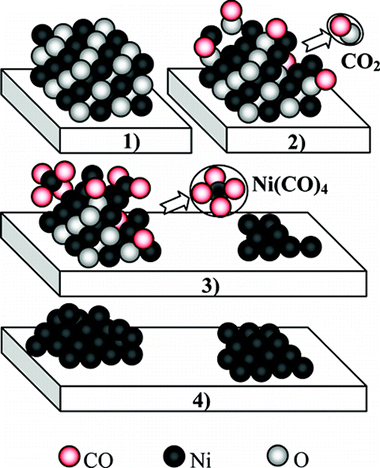
The effect of a reduction process with CO or H-2 on the Size of nickel particles in Ni/ZrO2 dry methane reforming catalysts have been studied by means of in situ X-ray Spectroscopy (XAS) and Diffuse Reflectance FTIR Spectroscopy (DRIFTS). Our results clearly indicate that a high temperature treatment with CO increases the dispersion of the nickel metallic phase. XAS results have shown a lower coordination number of Ni in the sample treated with CO than that reduced with H-2. From the DRIFTS results, it can he established that, under the CO treatment, the formation of Ni(CO)(4) complexes corrodes the nickel particles, decreasing their size. The formation of these gas molecules occurs without measurable losses of nickel from the catalyst which maintains the same nickel content after the hydrogen or the CO treatment at high temperature:Therefore, this airborne nickel compound, by colliding with the zirconia surface, must deposit the nickel metal metal atoms around onto the support. This behavior is evidence of an important interaction b etween nickel and zirconia surface as unlike other supports there is no losses of nickel during the dispersion process on zirconia. Although different effects of CO on nickel catalysts have been previously described, we have found for the first time several experimental evidences demonstrating the whole redispersion phenomenon.
Boron Compounds as Stabilizers of a Complex Microstructure in a Co-B-based Catalyst for NaBH4 Hydrolysis
Arzac, G.M., Rojas, T.C., Fernández, A.
ChemCatChem, 3 (2011) 1305-1313 | DOI: 10.1002/cctc.201100101
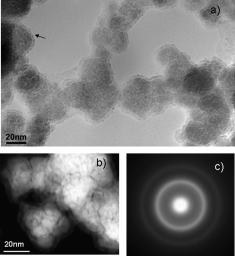
Co-B-based materials are widely used as catalysts for hydrogen generation through sodium borohydride self-decomposition. In the mid 1990s, the aqueous and organic chemistry involved in Co-B synthesis and handling was studied. Nevertheless, the exact microstructure of these catalysts has remained unsolved. Herein we present an exhaustive study which shows a new and complete microstructural view of a Co-B-based material together with the chemistry of the cobalt and boron involved. By using nanoscale-resolution microscopy and spectroscopy techniques, we have elucidated the role of boron compounds as stabilizers in a complex microstructure, which also explains its high catalytic performance and long-term stability. The catalyst is proposed to be made up of 1-3nm hcp Co0 nanoparticles embedded in amorphous CoxB (x=1, 2, 3), CoxOy, Co(BO2)2, and B2O3 phases alternatively or all together. All of these amorphous phases protect the nanocrystalline metallic core from growth and oxidation.
Structural elucidation of Β-(Y,Sc)2Si2O 7: Combined use of 89Y MAS NMR and powder diffraction
Allix, M., Alba, M.D., Florian, P., Fernandez-Carrion, A.J., Suchomel, M.R., Escudero, A., Suard, E., Becerro, A.I.
Journal of Applied Crystallography, 44 (2011) 846-852 | DOI: 10.1107/S0021889811021303
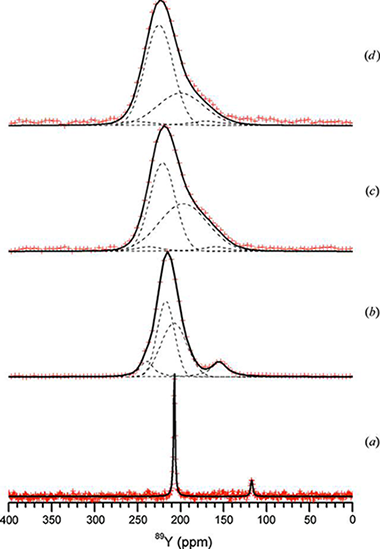
Although the structures of pure Sc2Si2O7 and Β-Y2Si 2O7 have been described in the literature using the C2/m space group, 29Si magic angle spinning (MAS) NMR measurements of the intermediate members of the Sc2Si2O7-Β- Y2Si2O7 system indicate a lowering of the symmetry to the C2 space group. Indeed, these compositions exhibit a unique Si crystallographic site and an Si-O-Si angle lower than 180°, incompatible with the C2/m space group. C2 is the only possible alternative. Space group Cm can be discarded with regard to its two different Si sites per unit cell. Moreover, 89Y MAS NMR data have revealed the existence of two different Y sites in the structure of the intermediate members of the Sc 2Si2O7-Β-Y2Si2O 7 system, confirming the lowering of the symmetry to the C2 space group. The viability of the C2 model has therefore been tested and confirmed by refinement of synchrotron and neutron powder diffraction data for the different members of the system. The structural evolutions across the Sc 2Si2O7-Β-Y2Si2O 7 system are discussed.
Room-Temperature Reaction of Oxygen with Gold: An In situ Ambient-Pressure X-ray Photoelectron Spectroscopy Investigation
Jiang, P; Porsgaard, S; Borondics, F; Kober, M; Caballero, A; Bluhm, H; Besenbacher, F; Salmeron, M
Journal of the American Chemical Society, 132 (2010) 2858-2859 | DOI: 10.1021/ja909987j
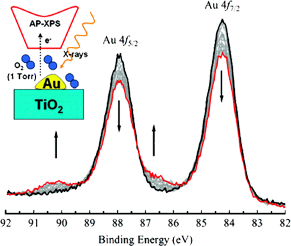
The interaction of O-2 with gold foil and gold nanoparticles grown by thermal deposition on TiO2(110) was studied by in situ ambient pressure X-ray photoelectron spectroscopy at room temperature. No spontaneous dissociation of O-2 was observed either on Au foil or oil Au nanoparticles up to 1 Torr of O-2. X-ray irradiation, however, is very effective in promoting gold oxidation on both surfaces in the presence of O-2. Our results help reconcile recent conflicting experimental observations regarding the activation of molecular oxygen, which is a crucial issue in Au catalyzed oxidation reactions.
Gallium Arsenide Infiltration of Nanoporous Multi layers: A Route to High-Dielectric-Contrast One-Dimensional Photonic Crystals
Sanchez-Sobrado, O; Thomas, K; Povey, I; Pemble, ME; Miguez, H
Small, 6 (2010) 1283-1287 | DOI: 10.1002/smll.200902190
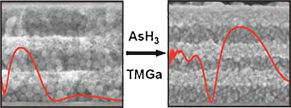
Periodic multilayers of wide photonic bandgap and high reflectance in the visible and near infrared regions are fabricated. Optical properties show that reflectance intensities close to 90% are reached for stacks of only six layers, as well as gap-to-midgap ratios of 50%. The optical response of the hybrid ensemble can be accurately tuned through the number of infiltration cycles performed.
Flexible, Adhesive, and Biocompatible Bragg Mirrors Based on Polydimethylsiloxane Infiltrated Nanoparticle Multilayers
Calvo, ME, Miguez, H
Chemistry of Materials, 22 (2010) 3909-3915 | DOI: 10.1021/cm1001016
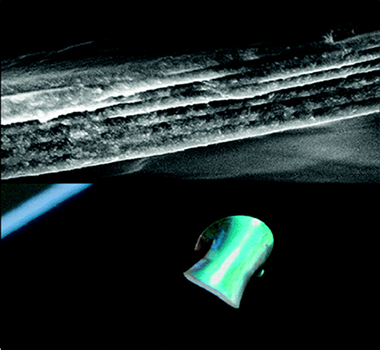
Herein we present a series of self-standing, flexible, and biocompatible optical interference filters obtained through infiltration and polymerization of an elastomer (polydimethylsiloxane) in a porous Bragg mirror prepared by alternating deposition of layers of TiO2 and SiO2 nanoparticles. The method proposed yields the uniform filling of the nanopores of the multilayer by the polymer, which allows lifting off the hybrid structure as long as the ensemble is cooled to temperatures below the glass transition of the polymer. This multifunctional material combines the optical properties of the periodic nanoporous multilayer and the structural and physicochemical characteristics of polydimethylsiloxane. Experimental demonstrations of their potential use as flexible and adhesive UV-protecting filters, as well as of light, highly-efficient conformal back reflectors to enhance the efficiency of photovoltaic devices are provided.
Conformal Growth of Organic Luminescent Planar Defects within Artificial Opals
Aparicio, FJ; Lozano, G; Blaszczyk-Lezak, I; Barranco, A; Miguez, H
Chemistry of Materials, 22 (2010) 379-385 | DOI: 10.1021/cm902819x
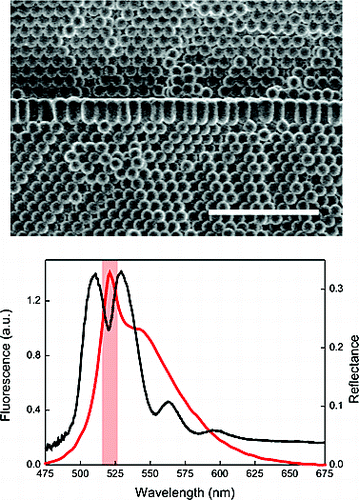
Herein, we present the result of combining, for the first time, the techniques of colloidal self-assembly and plasma-enhanced chemical vapor deposition to create a novel, high-quality, purely Organic active photonic crystal structure of controlled optical properties. We show a fast. reliable, and accurate procedure to introduce two-dimensional luminescent organic defect layers within artificial polystyrene opals via a versatile room-temperature remote plasma deposition process. This method is gentle enough to allow highly coil formal growth on polystyrene microspheres without altering their morphology or the ordered arrangement that they form. The luminescent organic layer behaves both as all optical dopant, causing the opening of transmission windows within the forbidden frequency interval of the lattice, and as an optically active material, whose emission call be tailored by the photonic environment.
Quantitative Characterization of Multicomponent Polymers by Sample-Controlled Thermal Analysis
Sanchez-Jimenez, PE; Perez-Maqueda, LA; Crespo-Amoros, JE; Lopez, J; Perejon, A; Criado, JM
Analytical Chemistry, 82 (2010) 8875-8880 | DOI: 10.1021/ac101651g
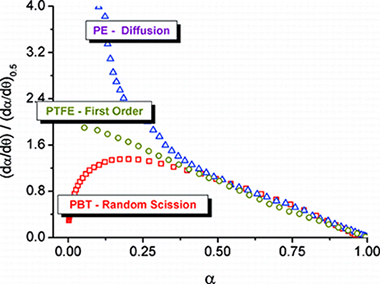
This paper explores the potential of sample-controlled thermal analysis (SCTA) in order to perform compositional analysis of multicomponent polymeric materials by means of thermogravimetric experiments. In SCTA experiments, the response of the sample to the temperature determines the evolution of the temperature by means of a feedback system; thus, what is controlled is not the temperature time profile, as in conventional analysis, but rather the evolution of the reaction rate with time. The higher resolving power provided by the technique has been used for determining the composition of polymer blends composed of polyvinyl chloride (PVC) and different commercial plasticizers, a system where the individual components have very similar thermal stabilities, thereby rendering useless thermogravimetric experiments run under conventional conditions. Different SCTA procedures, such as constant rate thermal analysis (CRTA), which has received special attention, and high-resolution and stepwise isothermal analysis have been tested, and the results obtained have been compared with linear heating rate technique. It has been proven that CRTA can be used to effectively determine the exact composition of the blend.
Excitation transfer mechanism along the visible to the Near-IR in rhodamine J-heteroaggregates
Sanchez-Valencia, JR; Toudert, J; Gonzalez-Garcia, L; Gonzalez-Elipe, AR; Barranco, A
Chemical Communications, 46 (2010) 4372-4374 | DOI: 10.1039/c0cc00087f
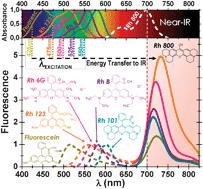
An enhanced fluorescent emission of the dye Rhodamine 800 in the Near-IR is observed in the presence of other xanthene dye molecules (RhX) when they are hosted in different matrices due to the formation of a new type of fluorescent J-heteroaggregates.
This enhanced emission of the acceptor occurs despite the low spectral overlapping and the low quantum yield of Rh800.
In situ spectroscopic detection of SMSI effect in a Ni/CeO2 system: hydrogen-induced burial and dig out of metallic nickel
Caballero, A; Holgado, JP; Gonzalez-delaCruz, VM; Habas, SE; Herranz, T; Salmeron, M
Chemical Communications, 46 (2010) 1097-1099 | DOI: 10.1039/b920803h
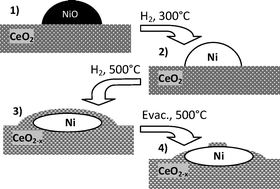
In situ APPES technique demonstrates that the strong metal support interaction effect (SMSI) in the Ni-ceria system is associated with the decoration and burial of metallic particles by the partially reduced support, a phenomenon reversible by evacuation at high temperature of the previously absorbed hydrogen.
Sunlight highly photoactive Bi2WO6-TiO2 heterostructures for rhodamine B degradation
Colon, G; Lopez, SM; Hidalgo, MC; Navio, JA
Chemical Communications, 46 (2010) 4809-4811 | DOI: 10.1039/c0cc00058b
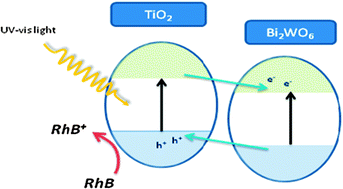
Highly efficient Bi2WO6-TiO2 heterostructures are synthesized by means of a hydrothermal method; they have high photoactivity for the degradation of rhodamine B under sunlike irradiation. An interesting synergetic effect between TiO2 and Bi2WO6 leads to an improved charge carrier separation mechanism, causing the excellent photocatalytic performance.
Gold supported on metal-doped ceria catalysts (M = Zr, Zn and Fe) for the preferential oxidation of CO (PROX)
Laguna, OH; Sarria, FR; Centeno, MA; Odriozola, JA
Journal of Catalysis, 276 (2010) 360-370 | DOI: 10.1016/j.jcat.2010.09.027
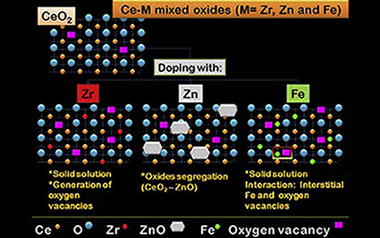
A series of ceria oxides doped with 10 mol % of Zr Zn and Fe have been prepared by a pseudo sol-gel method throughout the thermal decomposition of the corresponding metallic propionates With these supports 1 wt % gold catalysts were prepared by the deposition-precipitation method All the solids were characterized by means of XRF N-2 adsorption XRD Raman spectroscopy and SEM techniques and their catalytic activity toward preferential oxidation of CO (PROX) reaction tested The results showed solid solution when doping with Zr and Fe and ZnO surface segregation in the case of Zn We demonstrate that gold dispersion depends on not only the oxygen vacancy concentration but also the nature of the doping agent Finally the catalytic activity was highly promoted by gold in all cases being the doped gold catalysts more active than Au/CeO2 at low temperature.
Improved Non-Covalent Biofunctionalization of Multi-Walled Carbon Nanotubes Using Carbohydrate Amphiphiles with a Butterfly-Like Polyaromatic Tail
Assali, M; Leal, MP; Fernandez, I; Romero-Gomez, P; Baati, R; Khiar, N
Nano Research, 3 (2010) 764-778 | DOI: 10.1007/s12274-010-0044-2
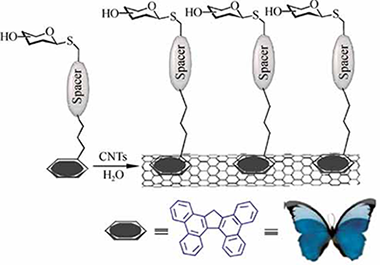
We have developed an efficient strategy for the non-covalent functionalization of multi-walled carbon nanotubes (MWCNTs) which allows a biomimetic presentation of carbohydrates on their surface by pi-pi stacking interactions. The strategy is based on the use of sugar-based amphiphiles functionalized with tetrabenzo[a,c,g,i] fluorene (Tbf), a polyaromatic compound with a topology that resembles a butterfly with open wings. The new carbohydrate-tethered Tbf amphiphiles have been synthesized in a straightforward manner using click chemistry. The reported method has been developed in order to improve the rather low ability of pyrene-based systems to exfoliate MWCNTs in water. By means of thermogravimetric analysis (TGA), ultraviolet (UV), infrared (IR), and fluorescence spectroscopies the interaction between MWCNTs and the Tbf group has been found to be stronger than those involving pyrene-based amphiphilic carbohydrates. The resulting aggregates with a multivalent sugar exposition on their surface are able to engage in specific ligand-lectin interactions similar to glycoconjugates on a cell membrane.
Fabrication of ordered crystalline zirconium nanoporous membranes by an one-step procedure
Marquez, F; Morant, C; Pirota, KR; Borras, A; Sanz, JM; Elizalde, E
Nano Today, 4 (2009) 21-26 | DOI: 10.1016/j.nantod.2008.10.012
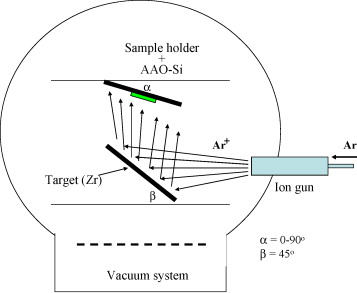
Crystalline porous zirconium membranes were obtained by physical vapor deposition on AAO templates at room temperature. These membranes were found to have similar hexagonal nanohole arrays as the template and high crystallinity. The pore size of the synthesized metallic membranes could be controlled during the synthesis through appropriate parameters in the experimental procedure.
Porous One-Dimensional Photonic Crystals Improve the Power-Conversion Efficiency of Dye-Sensitized Solar Cells
Colodrero, S; Mihi, A; Haggman, L; Ocana, M; Boschloo, G; Hagfeldt, A; Miguez, H
Advanced Materials, 21 (2009) 764-770 | DOI: 10.1002/adma.200703115
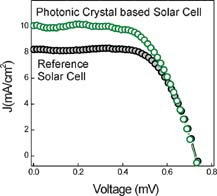
A device for solar-energy conversion was introduced in which a porous and highly reflecting 1D photonic crystal (1D PC) was coupled to a dye-sensitized nanocrystals anatase (NC-TiO2) electrode. The results show that the transparency of the PC-based dye-sensitized solar cells (DSSC) in the visible range of the electromagnetic spectrum is very similar to that of the reference cell. The multilayer whose photonic bandgap has a larger overlap with the absorption band of the ruthenium dye, gives rise to a larger enhancement of the photocurrent. It is also seen that the porous 0.5μm thick PC, whose deleterious effect is compensated by the large increment in photocurrent. The spectral photoelectric response of the cell clearly shows the effect that coupling to a PC has on the current photogenerated in the dye-sensitized electrode.
Mesostructured Thin Films as Responsive Optical Coatings of Photonic Crystals
Hidalgo, N; Calvo, ME; Miguez, H
Small, 5 (2009) 2309-2315 | DOI: 10.1002/smll.200900411
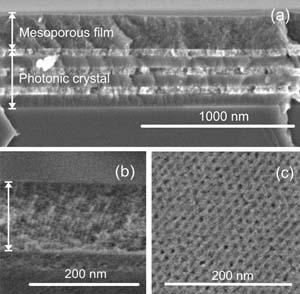
A synthetic route is presented to attain high-optical-quality multilayered structures that residtfront coupling ordered n7esoporous tilaniuni oxide thin films to the surface of a dense one-dimensional photonic crystal. Such architectures present spectrally well-defined photon resonant modes localized in the outer coating that finely respond to physicochemically induced modifications of its pore volume. The potential of these porous coatings in detection of environmental changes through variations of the photonic response of the ensemble is demonstrated by performing isothermal optical reflectance measurements under controlled vapor-pressure conditions.
Hybrid catalytic-DBD plasma reactor for the production of hydrogen and preferential CO oxidation (CO-PROX) at reduced temperatures
Rico, VJ; Hueso, JL; Cotrino, J; Gallardo, V; Sarmiento, B; Brey, JJ; Gonzalez-Elipe, AR
Chemical Communications, 41 (2009) 6192-6194 | DOI: 10.1039/b909488a
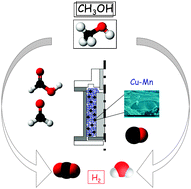
Dielectric Barrier Discharges (DBD) operated at atmospheric pressure and working at reduced temperatures (T < 115 °C) and a copper–manganese oxide catalyst are combined for the direct decomposition and the steam reforming of methanol (SRM) for hydrogen production and for the preferential oxidation of CO (CO-PROX)
Self-Assembling of Er2O3-TiO2 Mixed Oxide Nanoplatelets by a Template-Free Solvothermal Route
Julian-Lopez, B; Martos, M; Ulldemolins, N; Odriozola, JA; Cordoncillo, E; Escribano, P
Chemistry-A European Journal, 15 (2009) 12426-12434 | DOI: 10.1002/chem.200901423
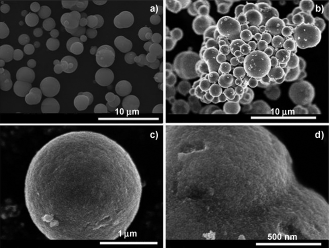
An easy solvothermal route has been developed to synthesize the first mesoporous Er2O3-TiO2 mixed oxide spherical particles composed of crystalline nanoplatelets, with high surface area and narrow pore size distribution. This synthetic strategy allows the preparation of materials at low temperature with interesting textural properties without the use of surfactants, as well as the control of particle size and shape. TEM and Raman analysis confirm the formation of nanocrystalline Er2O 3-TiO2 mixed oxide. Mesoscopic ordered porosity is reached through the thermal decomposition of organic moieties during the synthetic process, thus leading to a template-free methodology that can be extended to other nanostructured materials. High specific surface areas (up to 313 m 2g-1) and narrow pore size distributions are achieved in comparison to the micrometric material synthesized by the traditional sol-gel route. This study opens new perspectives in the development, by solvothermal methodologies, of multifunctional materials for advanced applications by improving the classical pyrochlore properties (magnetization, heat capacity, catalysis, conductivity, etc.). In particular, since catalytic reactions take place on the surface of catalysts, the high surface area of these materials makes them promising candidates for catalysts. Furthermore, their spherical morphology makes them appropriate for advanced technologies in, for instance, ceramic inkjet printers.
FTIR study of photocatalytic degradation of 2-propanol in gas phase with different TiO2 catalysts
Arana, J; Alonso, AP; Rodriguez, JMD; Colon, G; Navio, JA; Pena, JP
Applied Catalysis B-Environmental, 89 (2009) 204-213 | DOI: 10.1016/j.apcatb.2008.11.027
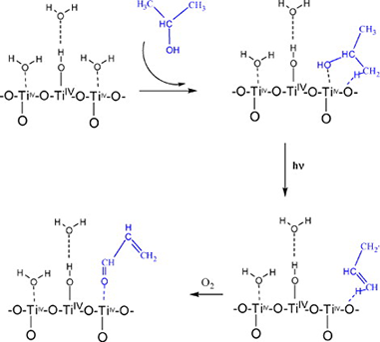
The photocatalytic efficiency of different TiO 2 catalysts in the degradation of 2-propanol in gas phase has been studied. The obtained efficiencies have been compared considering the distribution of rutile-anatase phases, surface area, particle size, distribution of surface hydroxyl groups and Brönsted or Lewis acid centres. The catalysts used were Degussa-P25 (TiO 2-P25), Hombikat, Millennium, Kemira and s/g-TiO 2, a catalyst prepared by a sol-gel method. The best photocatalytic behaviours have been obtained with those catalysts with higher surface area and the presence of only anatase phase (Hombikat and Millennium). A progressive deactivation of TiO 2-P25 and s/g-TiO 2 has been observed during the photocatalytic process. FTIR studies indicated that degradation mechanisms depended on the catalyst employed. Deactivation processes observed in TiO 2-P25 have been correlated with the formation of carboxylates.
Ionic liquid templated TiO2 nanoparticles as a support in gold environmental catalysis
Avellaneda, RS; Ivanova, S; Sanz, O; Romero-Sarria, F; Centeno, MA; Odriozola, JA
Applied Catalysis B-Environmental, 93 (2009) 140-148 | DOI: 10.1016/j.apcatb.2009.09.023
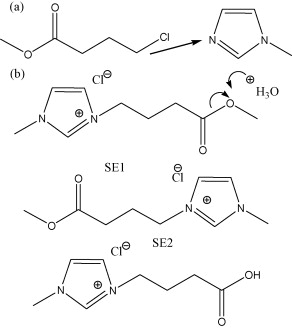
This work presents the synthesis of a nanostructured titania support and its subsequent utilization for the gold particles deposition and application in the reaction of the CO oxidation. A functionalized ionic liquid has been used as a templating agent for the titanium oxide synthesis resulting in a high specific surface nanostructured titania anatase. The as prepared support was then used for gold nanoparticles deposition without ionic liquid removal in order to study the possible role of the latter in the stabilization of the gold particles. The presence of ionic liquid in the catalysts results in an unusual catalytic behaviour—strong dependence on the presence of CO and changed kinetics and rate of oxidation.
Gold/hydroxyapatite catalysts: Synthesis, characterization and catalytic activity to CO oxidation
Dominguez, MI; Romero-Sarria, F; Centeno, MA; Odriozola, JA
Applied Catalysis B-Environmental, 87 (2009) 245-251 | DOI: 10.1016/j.apcatb.2008.09.016
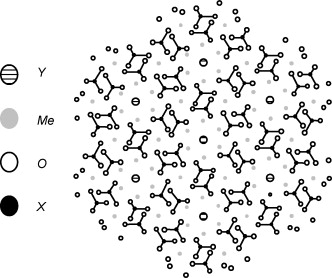
This work reports the synthesis, characterization and catalytic activity for CO oxidation of gold catalysts supported on calcium hydroxyapatite. On both, the hydroxyapatite support and the gold-supported hydroxyapatite catalyst, the CO conversion shows a peak near 100% of conversion at room temperature. The generation of structural vacancies by interaction of CO with the solid provokes the formation of peroxide species in the presence of gaseous oxygen, which seems to be responsible of this high conversion of CO at room temperature. Moreover, the influence of the pre-treatment temperature on the activity has been observed and related with the elimination of carbonate species and the generation of structural defects in the apatite structure, which are able to modify the gold oxidation state.
Influence of sulfur on the structural, surface properties and photocatalytic activity of sulfated TiO2
Colon, G; Hidalgo, MC; Navio, JA; Kubacka, A; Fernandez-Garcia, M
Applied Catalysis B-Environmental, 90 (2009) 633-641 | DOI: 10.1016/j.apcatb.2009.04.026
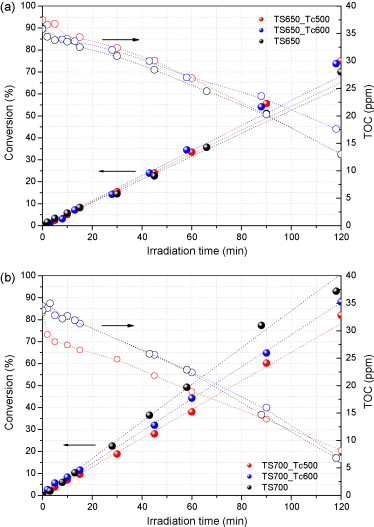
TiO2 materials were prepared by sol–gel method and then impregnated with sulfuric acid and calcined using different temperatures and atmosphere (air and nitrogen). Systematic variation of these two experimental parameters makes possible to modulate the amount of surface sulfur from the impregnation procedure. The best photocatalyst for liquid phenol degradation was obtained after calcination at 700 °C in air, while gas toluene degradation optimum performance is obtained by calcination at 700 °C in nitrogen from 500 °C. Structural analysis of these materials by XRD, micro-Raman spectroscopy and FE-SEM shows that once calcined at 700 °C the material was a well-crystallized, high surface area anatase structure in all cases. The surface characterization by FTIR and XPS confirms the presence of a higher amount of sulfur species and acidic OH groups in samples partially calcined in nitrogen, and a low XPS O/Ti-atomic ratio with the O 1s peak shifted to higher binding energies (1.8 vs. 2 ± 0.1 and 530.4 eV vs. 529.8 eV, respectively, against the reference materials) for samples calcined at 700 °C, temperature at which most of sulfate species have been evolved. The paper presents an attempt to correlate the contribution of the observed structural defects within the anatase sub-surface layers and surface acidity to the different photoactivity behaviour exhibited for phenol liquid phase and toluene gas phase photodegradation.
Manganese and iron oxides as combustion catalysts of volatile organic compounds
Duran, FG; Barbero, BP; Cadus, LE; Rojas, C; Centeno, MA; Odriozola, JA
Applied Catalysis B-Environmental, 92 (2009) 194-201 | DOI: 10.1016/j.apcatb.2009.07.010
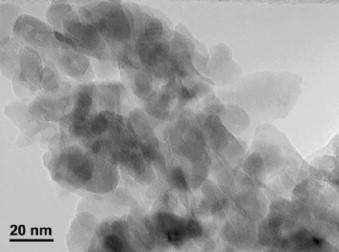
FeMn mixed oxides were prepared by the citrate method with Fe:Mn atomic ratio equal to 1:1, 1:3 and 3:1. The sample was characterized by means of specific surface area measurements, X-ray diffractometry (XRD), temperature programmed desorption of oxygen (O2-DTP), temperature programmed reduction (TPR), X-ray fluorescence (XRF), transmission electron microscopy (TEM and SAED) and high resolution TEM (HREM). The characterization results demonstrated the formation of a Mn2O3–Fe2O3 solid solution. The catalytic performance in ethanol, ethyl acetate and toluene total oxidation on these samples was better than on Fe2O3 and Mn2O3 pure oxides.
Photoconducting Bragg Mirrors based on TiO2 Nanoparticle Multilayers
Calvo, ME; Colodrero, S; Rojas, TC; Anta, JA; Ocana, M; Miguez, H
Advanced Functional Materials, 18 (2008) 2708-2715 | DOI: 10.1002/adfm.200800039
A synthetic route to building photoconducting films of TiO2 nanoparticles that display bright structural color is presented. The color arises as a result of the periodic modulation of the refractive index, which is achieved by controlling the degree of porosity of each alternate layer through the particle size distribution of the precursor suspensions. The suspensions are cast in the shape of a film by spin-coating, which allows tailoring of the lattice parameter of the periodic multilayer, thus tuning the Bragg peak spectral position (i.e., its color) over the entire visible region. Photoelectrochemical measurements show that the Bragg mirrors are conductive and distort the photocurrent response as a result of the interplay between photon and electron transport.
Self-assembled polyhydroxy fatty acids vesicles: a mechanism for plant cutin synthesis
Heredia-Guerrero, JA; Benitez, JJ; Heredia, A
Bioessays, 30 (2008) 273-277 | DOI: 10.1002/bies.20716
Despite its biological importance, the mechanism of formation of cutin, the polymeric matrix of plant cuticles, has not yet been fully clarified. Here, for the first time, we show the participation in the process of lipid vesicles formed by the self-assembly of endogenous polyhydroxy fatty acids. The accumulation and fusion of these vesicles (cutinsomes) at the outer part of epidermal cell wall is proposed as the mechanism for early cuticle formation.
Reactivity of lanthanum substituted cobaltites toward carbon particles
Hueso, JL; Caballero, A; Ocana, M; Gonzalez-Elipe, AR
Journal of Catalysis, 257 (2008) 334-344 | DOI: 10.1016/j.jcat.2008.05.012
This work reports on the reactivity toward carbon of a La0.5Sr0.5CoO3-delta perovskite prepared by spray pyrolysis. It is shown that this perovskite presents a moderate activity for the thermal oxidation of carbon, producing a decrease in its temperature of combustion of ca. 150 degrees C and a significant increase in the selectivity toward CO2. Different experiments were carried out with electron energy loss spectroscopy (EELS) and X-ray photoemission spectroscopy (XPS) for the perovskite and its physical mixture with a high-surface area carbon material. In the physical mixture, the cobalt at the surface was partially reduced to Co2+ even at room temperature. XPS demonstrated a species of oxygen with low electron density at the catalyst surface. This species seemed to play a significant role in the oxidation processes at the perovskite surface. A model is proposed to account for the changes exhibited by the catalyst during its reaction with carbon.
Morphology changes induced by strong metal-support interaction on a Ni-ceria catalytic system
Gonzalez-DelaCruz, VM; Holgado, JP; Pereniguez, R; Caballero, A
Journal of Catalysis, 257 (2008) 307-314 | DOI: 10.1016/j.jcat.2008.05.009
The state of the nickel in a Ni/CeO2 catalyst during hydrogen reduction, steam and dry reforming of methane, have been studied by means of in situ XAS spectroscopy. The catalyst was prepared by a combustion method and, after calcination, very small (about 10 nm) and homogeneous cubic particles of NiO are formed. Once reduced in hydrogen at high temperature (750 °C), the catalyst is active in both steam and dry reforming reactions of methane, but much more stable for the dry reforming reaction. In situ XAS analysis reveals that under reaction conditions at high temperature, the nickel remains completely reduced to Ni(0). However, under strongly reducing conditions (hydrogen or dry reforming at 750 °C), the Ni K-edge X-ray absorption spectrum undergoes unexpected modifications that, according to the parameters obtained by fitting analysis, come from changes in the size and morphology of nickel particles, which are now flattened and strongly stabilized on the partially reduced ceria surface. These morphology changes reflect a kind of strong metal–support interaction (SMSI), and could account for the higher stability observed for the dry reforming reaction. The flattened particles are not stable after cooling down to room temperature in hydrogen, while the coke deposited during the dry reforming reaction seems to block the particles, which partially remain even after cooling down to room temperature.
icms




